Aviation in Early Los Angeles
| Historical Photos of Aviation in L.A. |
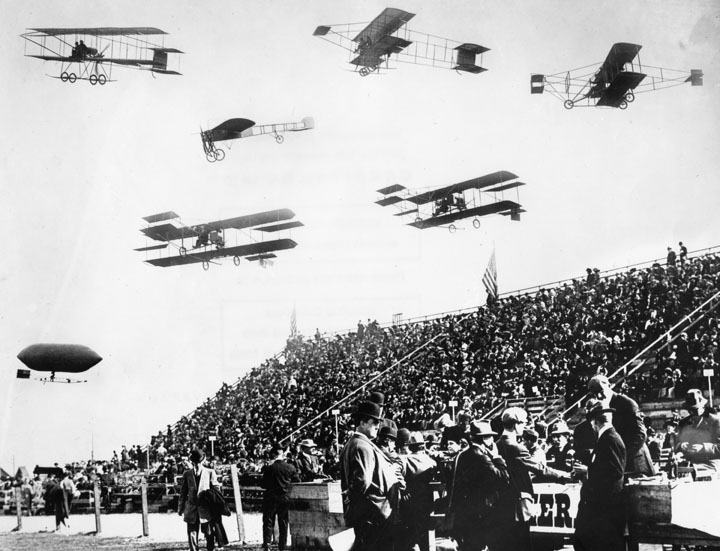 |
|
| (1910)* - Composite photograph of early-model biplanes, a monoplane, and a dirigible passing by bleachers filled with spectators at the 1910 Dominguez Field Air Meet. |
Historical Notes The Los Angeles International Air Meet (January 10 to January 20, 1910) was among the earliest airshows in the world and the first major airshow in the United States. It was held in Los Angeles County, California at Dominguez Field in present day Carson, California. Spectator turnout numbered approximately 254,000 over 11 days of ticket sales. The Los Angeles Times called it "one of the greatest public events in the history of the West”.*^ |
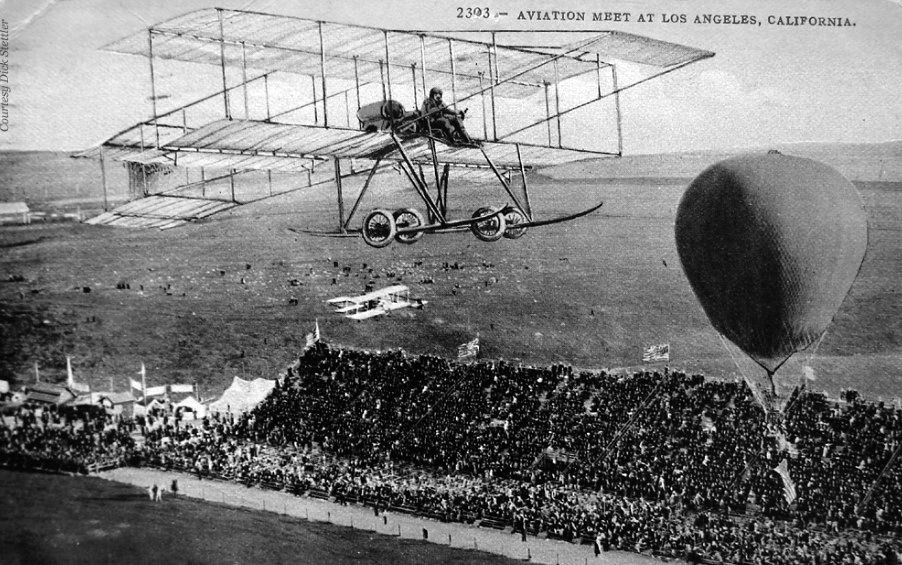 |
|
| (1910)*##^ – Postcard view of the Los Angeles International Air Meet in Dominguez Hills. |
Historical Notes Following the Reims International Air Meet of 1909 (France) enthusiasm for aviation began to increase in the United States. At an aviation meet in St. Louis fellow enthusiasts discussed the possibility of holding an air meet in Los Angeles. This group, which included Charles Willard, Roy Knabenshue, and Glenn Curtiss, followed through on the proposed project and sent Dick Ferris to Los Angeles to make the preliminary contacts and finalize the plans for the proposed Air Meet. After arriving in Los Angeles Ferris met with various contacts and an International Air Meet was proposed which would include Louis Paulhan-a renowned French aviator. The location was selected, Dominguez Field, which was part of one of the original Spanish land grants-The Rancho San Pedro. - Peter Bergen^* This site, Dominguez Hill Field, has been designated California Historical Landmark No. 718. Click HERE to see more of California Historical Landmarks in LA. |
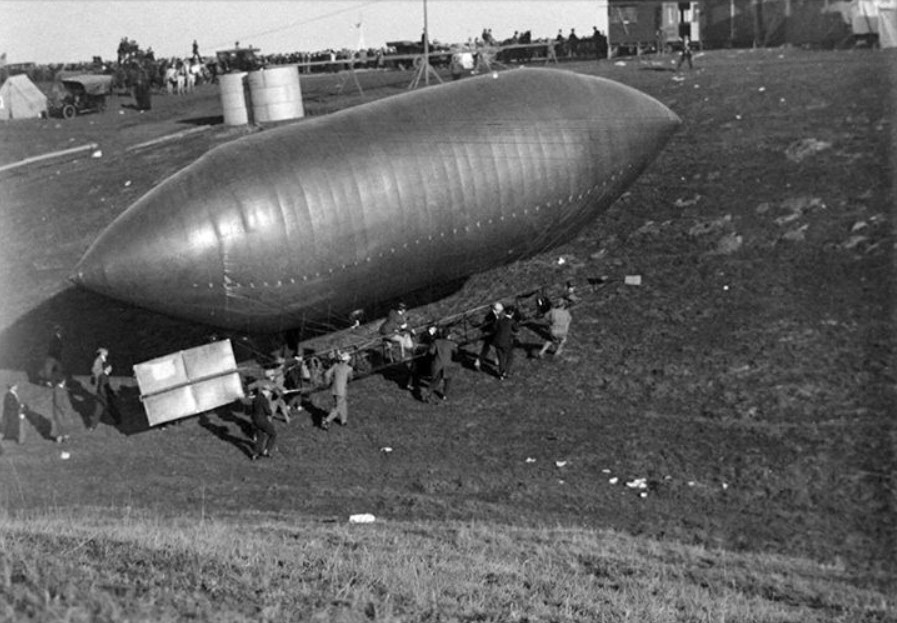 |
|
| (1910)*** - A crew moving a dirigible at the Los Angeles International Air Meet at Dominguez Field. |
Historical Notes A dirigible (or airship) is a type of aerostat or "lighter-than-air aircraft" that can be steered and propelled through the air using rudders and propellers or other thrust mechanisms. Unlike aerodynamic aircraft such as fixed-wing aircraft and helicopters, which produce lift by moving a wing through the air, aerostatic aircraft stay aloft by having a large "envelope" filled with a gas which is less dense than the surrounding atmosphere.*^ |
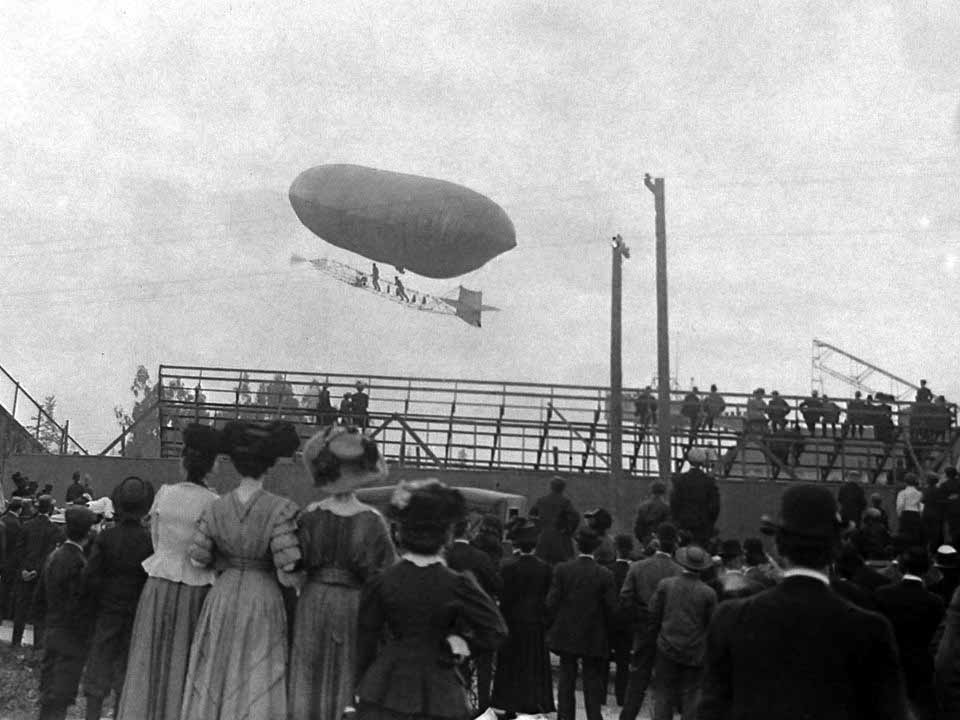 |
|
| (1910)^*^# – Spectators watch as a two-man dirigible flies over the stands at the International Air Meet. |
Historical Notes The first lifting gas used by dirigibles was hydrogen, although this had well-known concerns over its flammability. Helium was rare in most parts of the world, but large amounts were discovered in the USA. This meant that this non-flammable gas was rarely used for airships outside of the USA. All modern airships, since the 1960s, use helium.*^ |
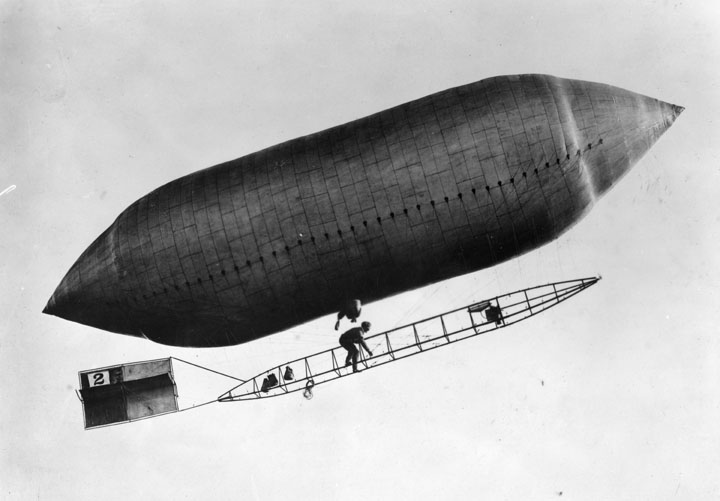 |
|
| (1910)* - Lincoln Beachey is seen flying an airship; the number "2" can be seen on the rudder. |
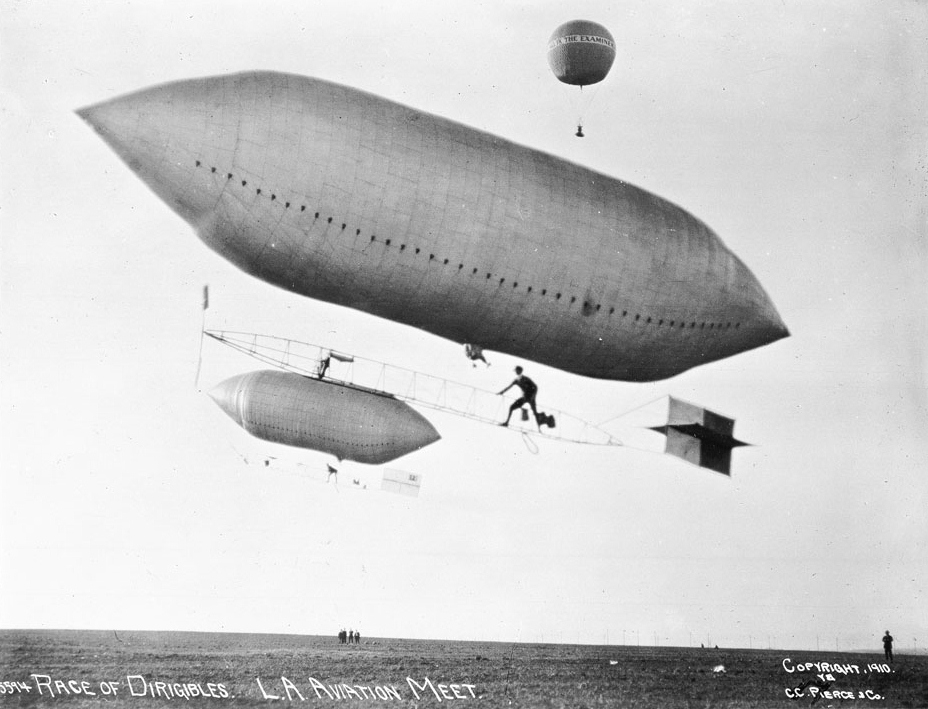 |
|
| (1910)^* - Photograph of dirigible race in the Dominguez Air Meet, Dominguez Field, Los Angeles, 1910. Two football-shaped zeppelins race across the skies, flying at low altitude. Each of them has single pilots. The pilots stand on a skeletal structure consisting of metal bars that is attached to the balloon with wires. Spectators (or judges) stand below on the plain field watching the zeppelins race. Further in the sky is a balloon with the phrase "all in the Examiner." |
 |
|
| (1910)* - Hamm's (otherwise unidentified) balloon in front of the grand stand of the 1st Aviation Meet. On the ground are three concentric rectangles serving as take-off and landing area. |
Historical Notes There were two International Aviation Meets held at Dominguez Field, Los Angeles. The first ran from Jan. 10-20, 1910; the second from Dec. 24-30, 1910-Jan. 1 and 3, 1911.* |
_1910.jpg) |
|
| (1910)^*^# – Close-up view of a gas-filled balloon in flight at the Los Angeles International Air Meet at Dominguez Field. |
Historical Notes Between the mid-1860s to 1960s – Gas balloons dominated the hot-air balloon until a modern burner was developed to heat air.*^ |
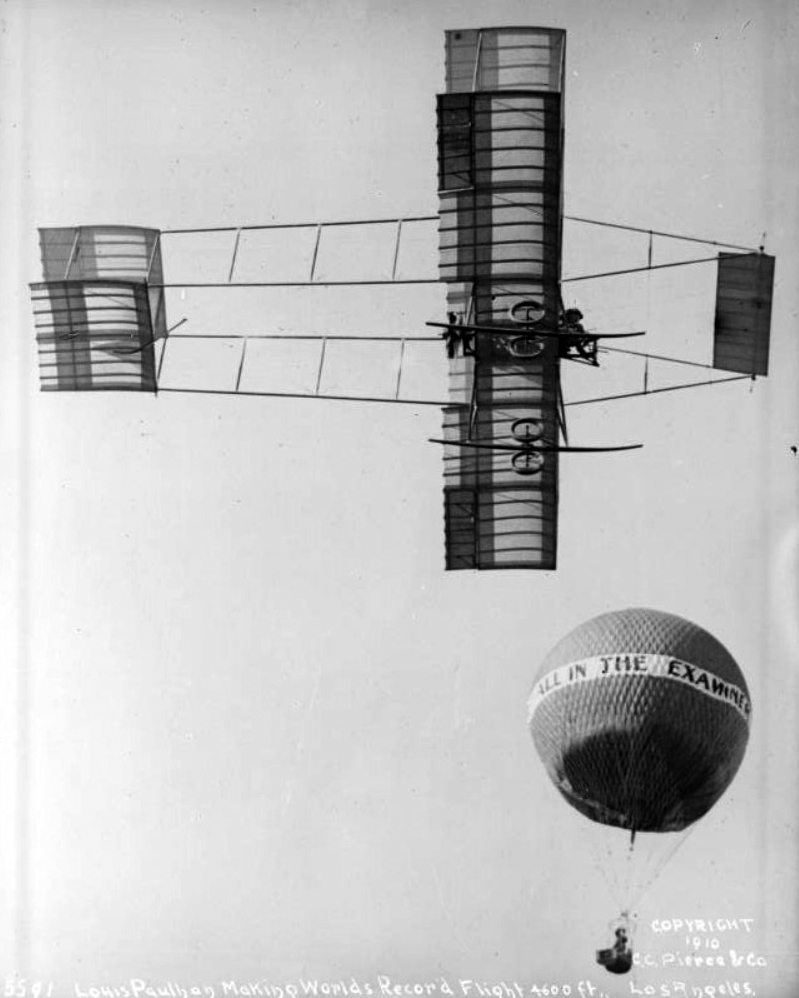 |
|
| (1910)^* - Photograph of Louis Paulhan flying near a gas-filled balloon in his Henry Farman biplane, during his record-breaking flight (4600 ft.) at Dominguez Field, January 12, 1910. Paulhan is sitting at the center of the front wings in this primitive biplane. His biplane passes a nearby balloon with one person piloting it. The advertisement painted on the balloon reads: "All in the Examiner". |
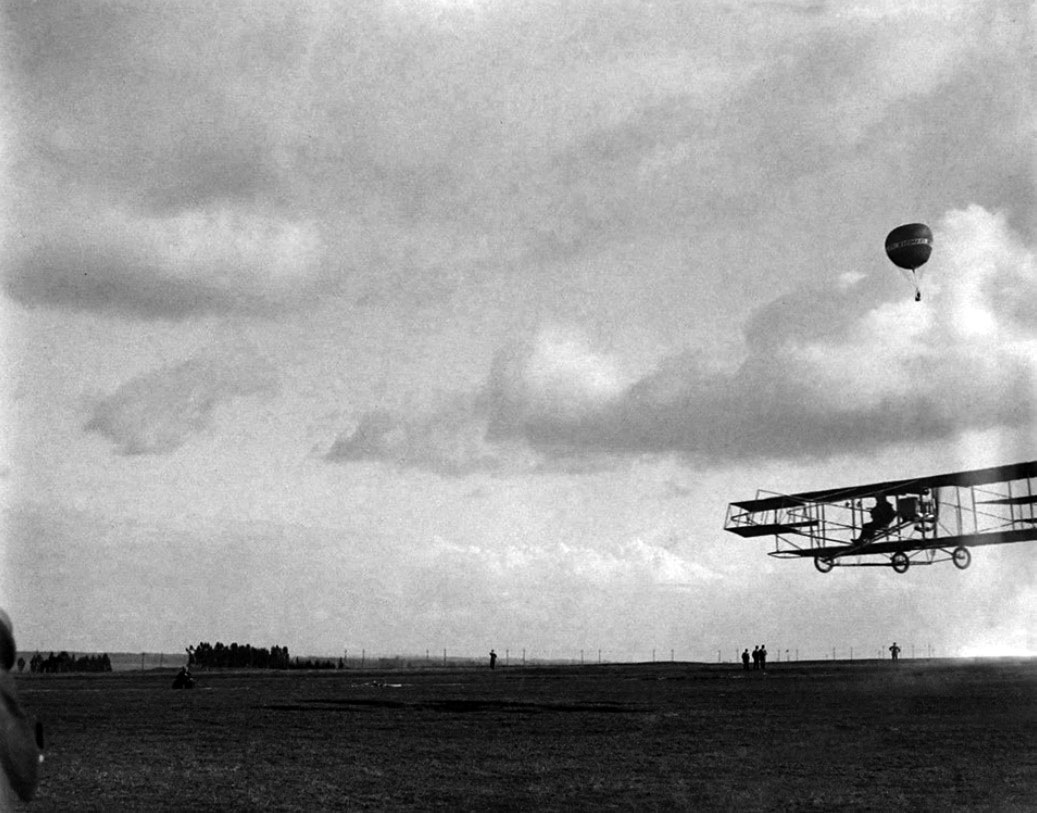 |
|
| (1910)^*^# - View showing a bi-plane flying close to the ground while a balloon at a higher elevation is seen in the distance. |
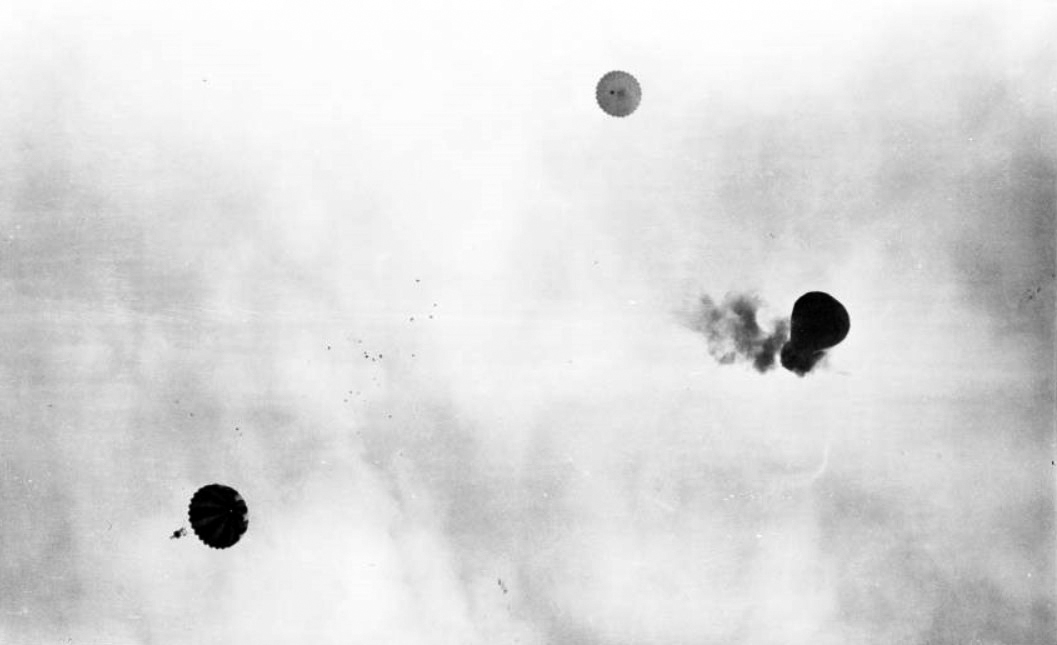 |
|
| (1910)^* - Photograph of two parachutists dropping from a balloon at the Dominguez Hills Air Meet. The balloon appears to be on fire with smoke coming from its basket. |
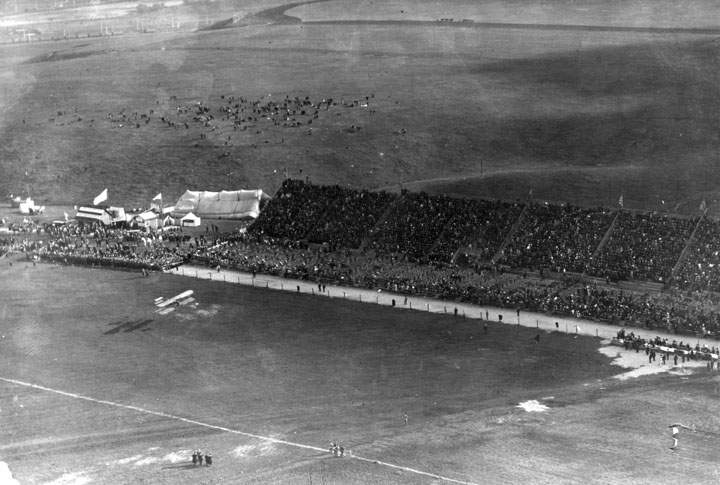 |
|
| (1910)* - Thousands watch a biplane in low flight over Dominguez Field. |
Historical Notes An estimated 254,000 tickets were sold, and gate receipts were roughly $137,500. During the time the meet was running, streetcars ran to Dominguez Fields every 2 minutes from the Pacific Electric station in Los Angeles. The great crowd turn-out, averaging more than 20,000 spectators per day, made it possible to return $1.25 to "the subscribers to the aviation fund for every dollar advanced". Probably not the only future-notable person to see the show, 9-year-old Florence Leontine Lowe, later better known as "Pancho" Barnes, was brought by her grandfather, aviation pioneer Thaddeus S. C. Lowe. It was here that she was inspired to begin her own later career in aviation.*^ |
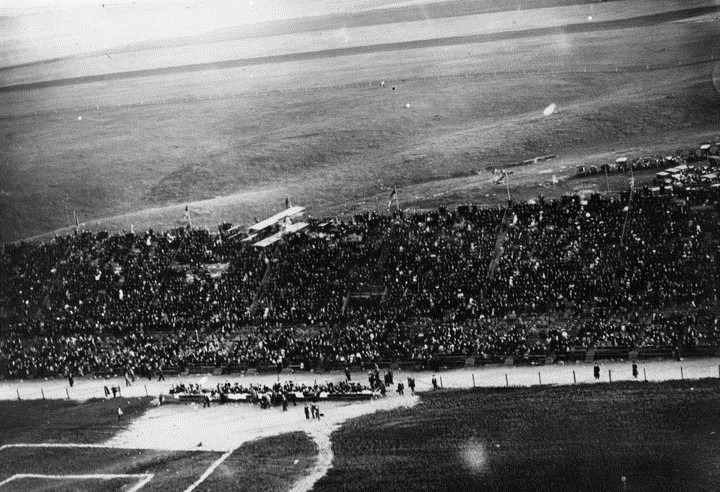 |
|
| (1910)* - Aerial view of Dominguez Field with biplane flying low over a large crowd of spectators. Note the extent of open space in the background behind the stands. |
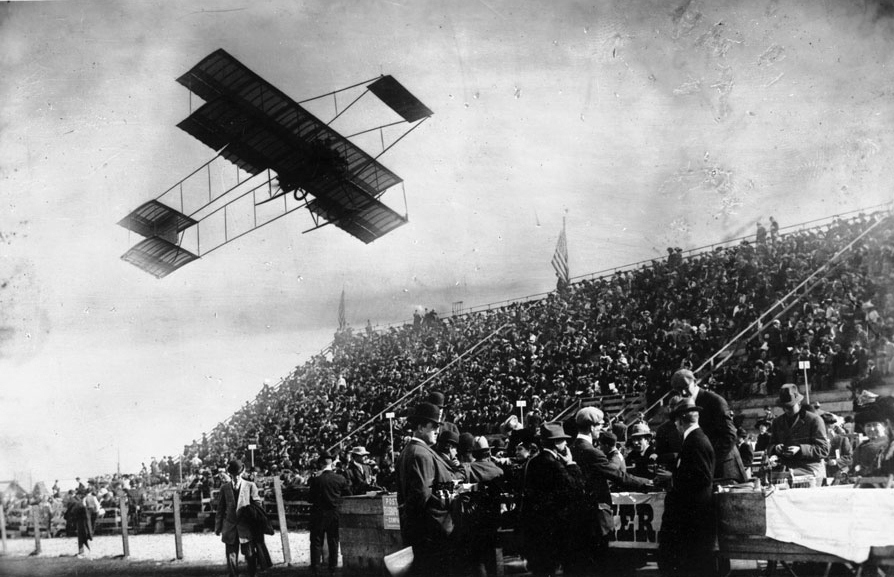 |
|
| (1910)^* - Photograph of aviator Louis Paulhan making his record flight at the Dominguez Hills Air Meet, 1910. Paulhan's Farman airplane is climbing at low altitude at left. It is a biplane with a biplanar tail and a canard fore plane. There is no real fuselage, and the aircraft is held together with wooden beams. A large crowd is gathered and is seated in bleachers at right. There is an American flag hanging at the top of the grandstands. A small group of people is standing around at table in the foreground at right. |
Historical Notes Over the ten-day period of the air meet spectators were thrilled by the performances of aviators Louis Paulhan, Glenn Curtiss, Charles Willard, and others. Paulhan was the 'star attraction' at the air meet. Invited by the organizers to participate, Paulhan brought with him to the event two Bleriot Monoplanes, Two Farman Biplanes, and an entourage, which included his wife and black poodle dog.^* |
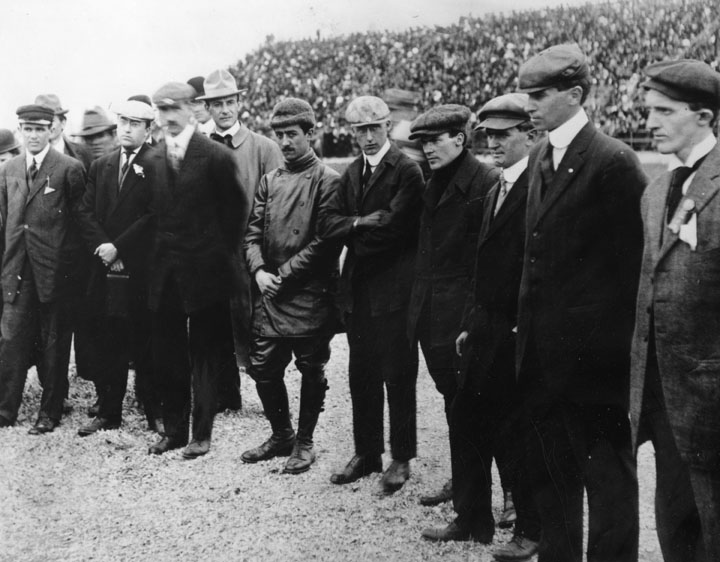 |
|
| (1910)* - Nine famous aviators at Dominguez Field. From left to right: 1. Hilary Beachey; 2. Col. Johnson (FH or FR); 3. Glenn H. Curtiss; 4. Louis Paulhan; 5. Charles F. Willard; 6. Didier Masson; 7. Lincoln Beachey; 8. Roy Knabenshue; 9. Charles K. Hamilton. |
Historical Notes The 1910 Air Meet drew many famous aviators, most of whom were American. Glenn Curtiss, American aviation pioneer and founder of the Curtiss Aeroplane and Motor Company was the most famous. Other participants included Roy Knabenshue, Charles Willard, Lincoln Beachey and Charles K. Hamilton, Howard Warfield Gill, and Clifford B. Harmon, many of whom are listed among the Early Birds of Aviation. French aviators at the event included Louis Paulhan and Didier Masson. The Wright brothers did not take part in the event, but were there with their lawyers in an attempt to prevent Paulhan and Curtiss from flying. The Wrights claimed that the ailerons on their aircraft infringed patents. Notwithstanding their allegations, Paulhan and Curtiss still made flights. As part of the larger Wright brothers' patent cases, the Wrights actually won monetary damages in U.S. courts for Paulhan's public performances that day.*^ |
 |
|
| (1910)^* - Elmer Cooke at the controls of a Curtiss biplane at the Dominguez Hills Air Meet. Cooke is at center and is facing the right. He is holding a control wheel in front of him and his other hand is reaching for another control. He is wearing a heavy jacket and gloves, as well as a hat with ear covers and goggles. His plane is a biplane with canvas-covered wings and the engine is mounted directly behind the pilot. There are two men holding a long rod attached to the plane at left, and another biplane is visible in the distance at right. |
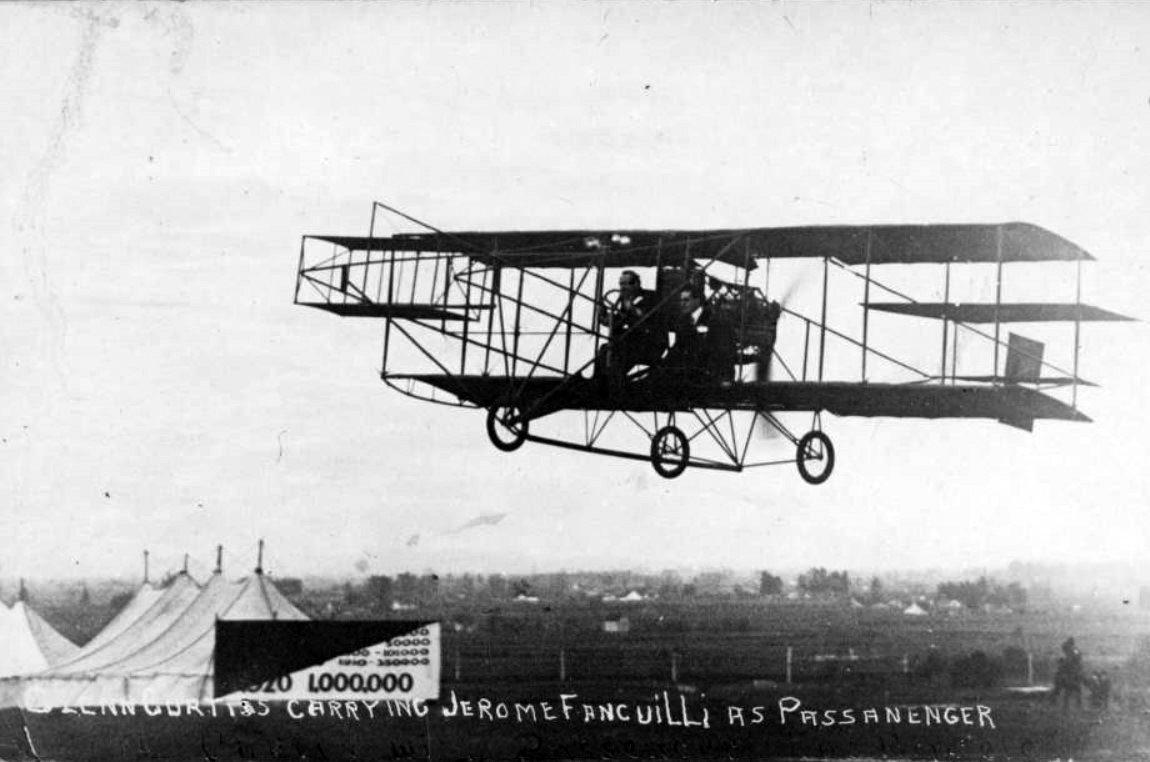 |
|
| (1910)^* - View showing Glenn Curtiss carrying Jerome Fancuilli as passenger at the Dominguez Air Show. At center, Glenn Curtiss is seen gripping a round steering wheel and piloting a simple biplane. To the right, Jerome Fancuilli sits on the frame of the plane as it moves through the air. Below the plane in the foreground, several lightly-colored tents and a banner are visible. |
Historical Notes Glenn Curtiss was an aviation pioneer and a founder of the U.S. aircraft industry. He began his career as a bicycle racer and builder before moving on to motorcycles. As early as 1904, he began to manufacture engines for airships. In 1908 Curtiss joined the Aerial Experiment Association (AEA), a pioneering research group, founded by Alexander Graham Bell at Beinn Bhreagh, Nova Scotia to build flying machines. Curtiss made the first officially witnessed flight in North America, won a race at the world's first international air meet in France, and made the first long-distance flight in the United States. His contributions in designing and building aircraft led to the formation of the Curtiss Aeroplane and Motor Company, now part of Curtiss-Wright Corporation. His company built aircraft for the U.S. Army and Navy, and, during the years leading up to World War I, his experiments with seaplanes led to advances in naval aviation.*^ |
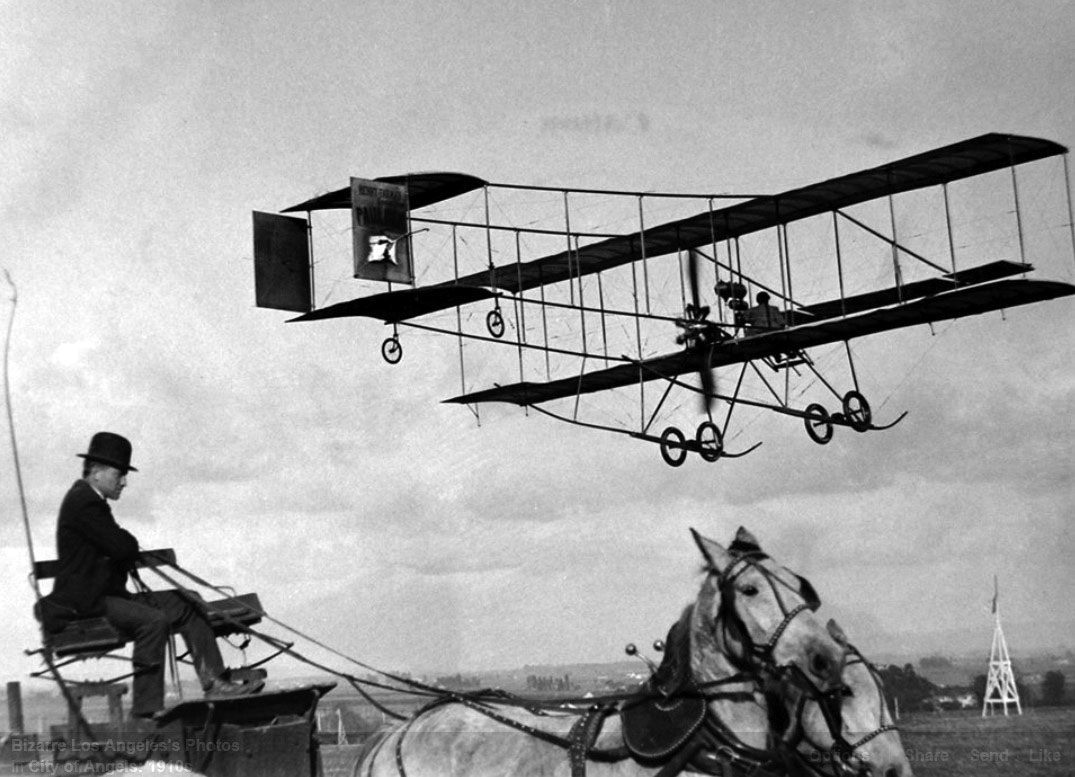 |
|
| (1910)^*^# – French Aviator Louis Paulhan flies over while a man in a horse-drawn wagon watches. |
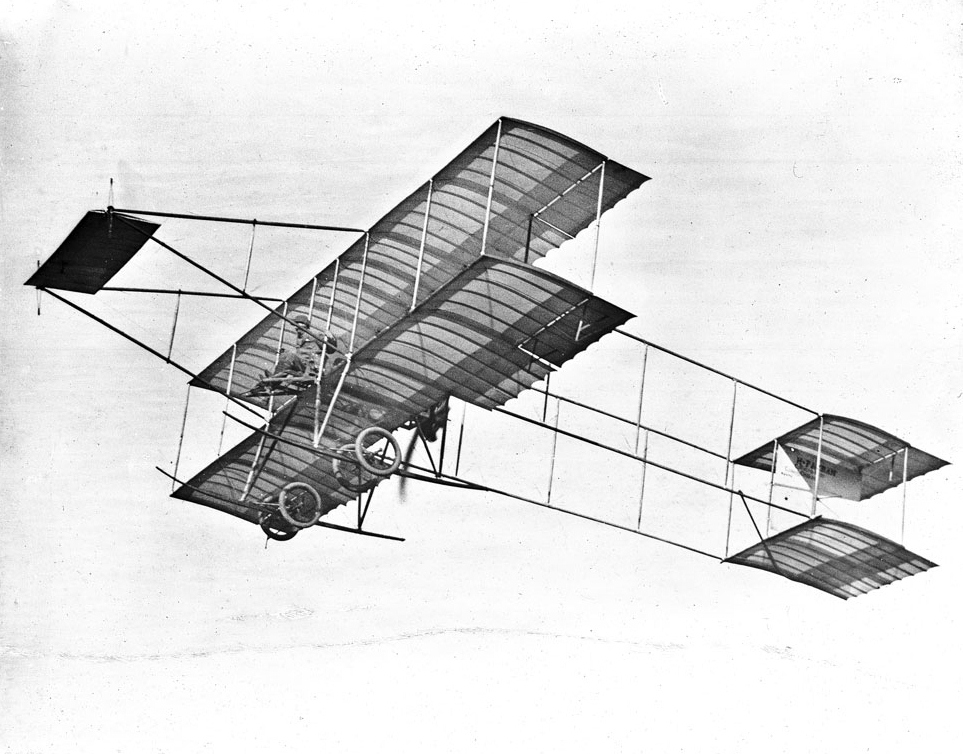 |
|
| (1910)^* - Louis Paulhan making his record flight, flying at 4,600 feet, in his Henry Farman biplane, Dominguez Field, Los Angeles, January 12, 1910. Paulhan is sitting at the center of the front wings in this primitive biplane. He holds onto the nearest supporting bar as he pilots the airplane. The nose is triangular shaped with a wing (or flap) in the center of the nose. A propeller spins just below the wings and between the two pairs of landing wheels. The rear of the plan consists of two square wings with a flap that runs perpendicular to the wings. |
Historical Notes At the air meet Louis Paulhan set a new altitude record (4164 ft.), endurance record (64 miles in 1 hr. 49 mins. 40 secs.), and won $14,000 in prize money. Glenn Curtiss won two events-fastest speeds with a passenger (55 mph) and quickest start (6 2/5 secs. covering 98 ft.). Curtiss took home $6500 in prize money. Charles Willard was credited with the most accurate takeoff and landing skills for which he receive a prize totaling $250.^* |
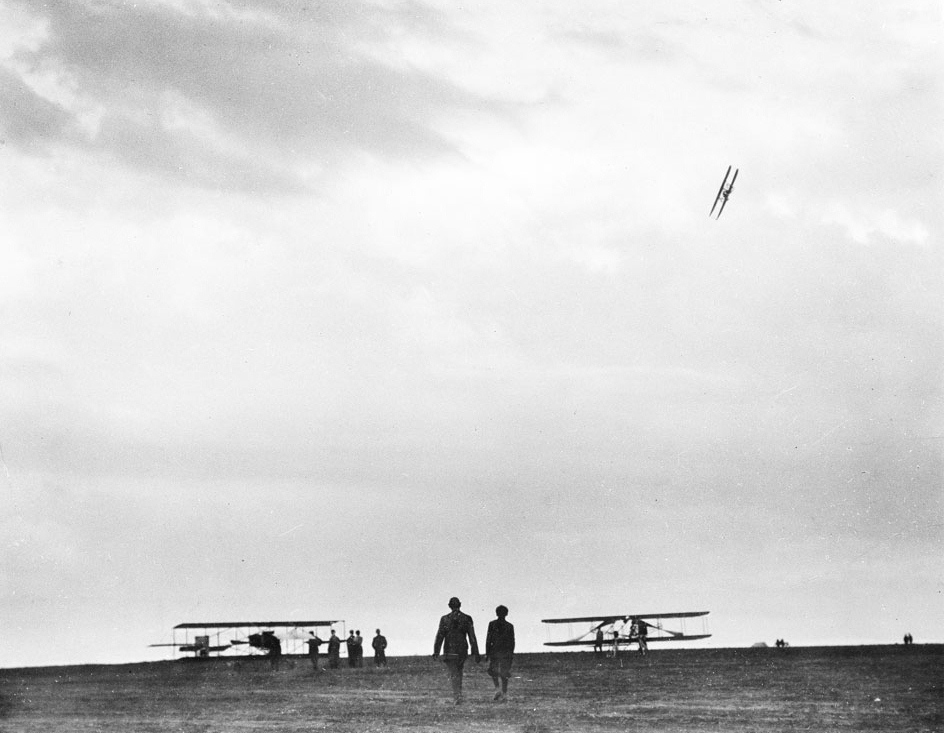 |
|
| (1910)^* - View of the airfield at the Dominguez Hills Airmeet. W.R. Brookins is shown airborne in his Wright Model A biplane, which is visible in the right sky as it executes a turn. Two other biplanes are visible on the ground. A group of five people can be seen standing around the plane on the left, while a lone pilot stands near the plane on the right. In the foreground at the center of the picture, two people are walking towards the grounded planes. On the horizon, two more small groups of people can be seen. |
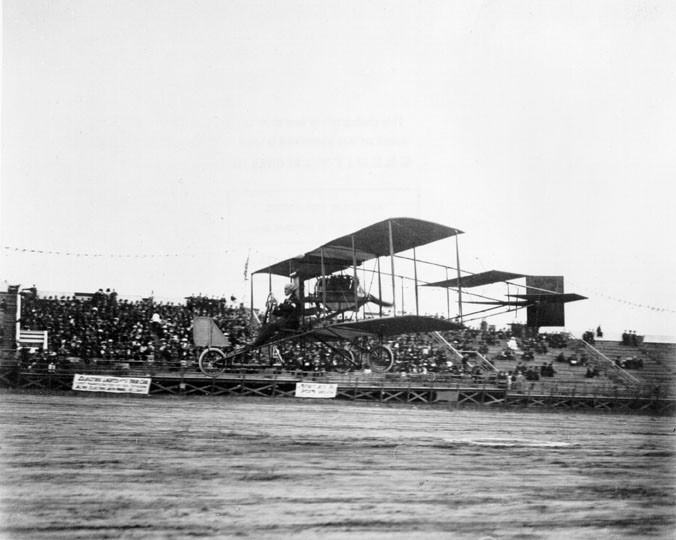 |
|
| (1910)* - Lincoln Beachy landing a biplane on Dominguez Field. |
 |
|
| (1910)^* - Louis Paulhan flying with a passenger (Mrs. Dick Ferris?) in his Henry Farman biplane, at the Dominguez Field Air Meet, Los Angeles, January 1910. |
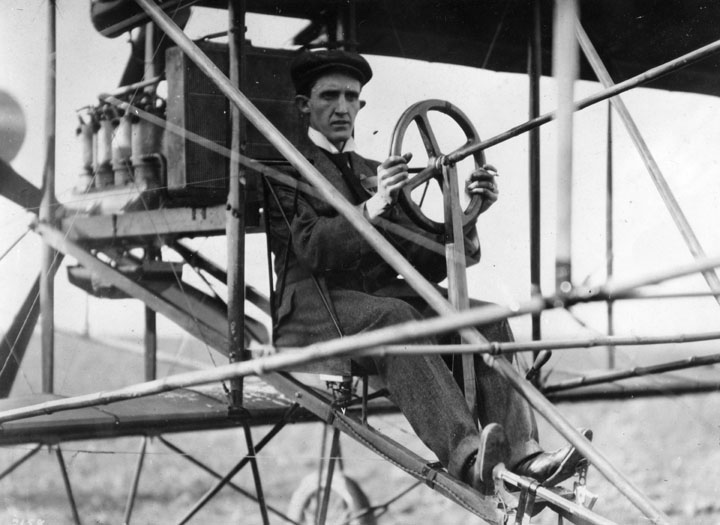 |
|
| (1910)* - Charles K. Hamilton at the controls of a plane on the ground. |
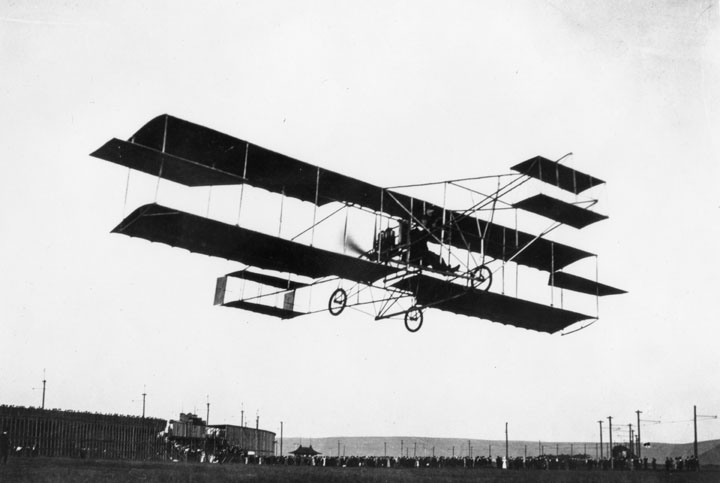 |
|
| (1910)* - Biplane in flight low above the ground, possibly during take-off. |
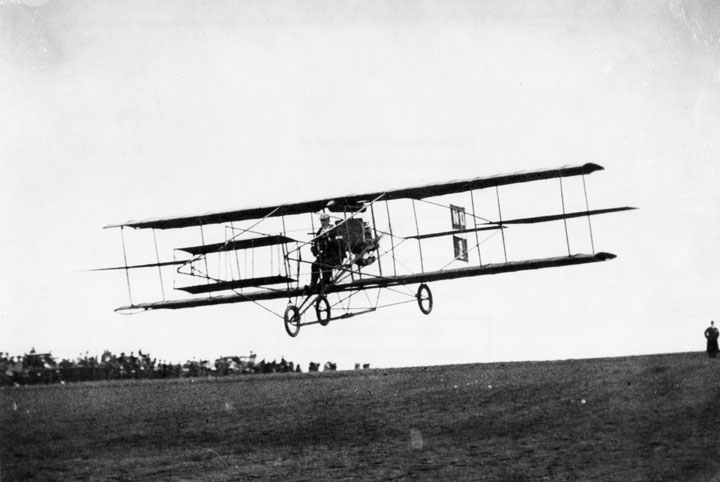 |
|
| (1910)* - Charles F. Willard in a Curtiss aircraft "Golden Flyer" during landing at the 1st Meet, January, 1910. Aircraft had 4 cylinders, 22-25 hp and a speed of 40 mph. |
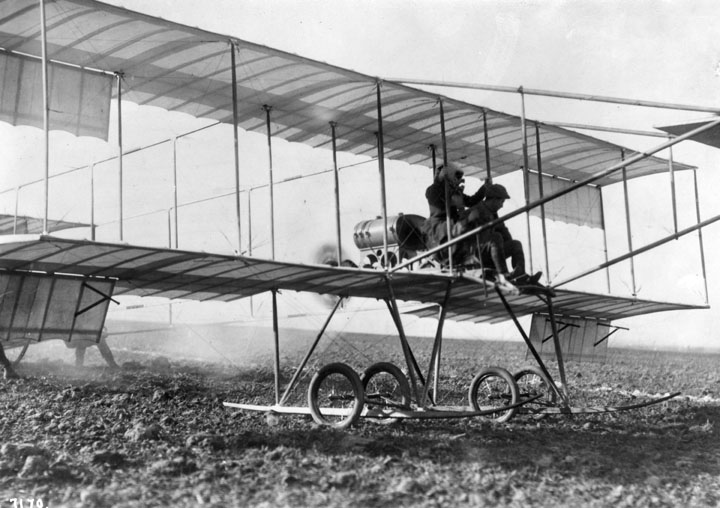 |
|
| (1910)* - Louis Paulhan and his wife are shown during take-off in their Farman biplane during the 1st Meet in January, 1910. |
Historical Notes Paulhan gave William Randolph Hearst his first experience of flight. However, William Boeing, who had been enthused by the new invention of the airplane, was unable to get a ride on any aircraft at the air meet. While attending the first American Air Meet in Los Angeles, Boeing asked nearly every aviator for a ride, but no one said yes except Louis Paulhan. For three days Boeing waited, but on the 4th day he discovered Paulhan had already left the meet. Possibly, one of the biggest missed opportunities in Paulhan's life was the ride he never gave Boeing.*^ |
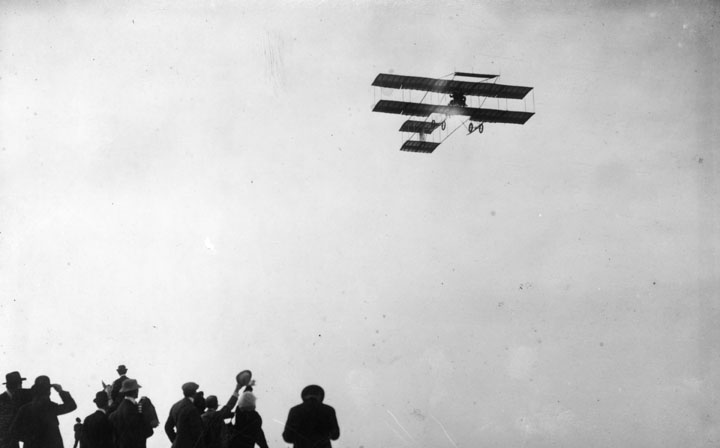 |
|
| (1910)* - Louis Paulhan and his wife are shown in flight in their Farman biplane. |
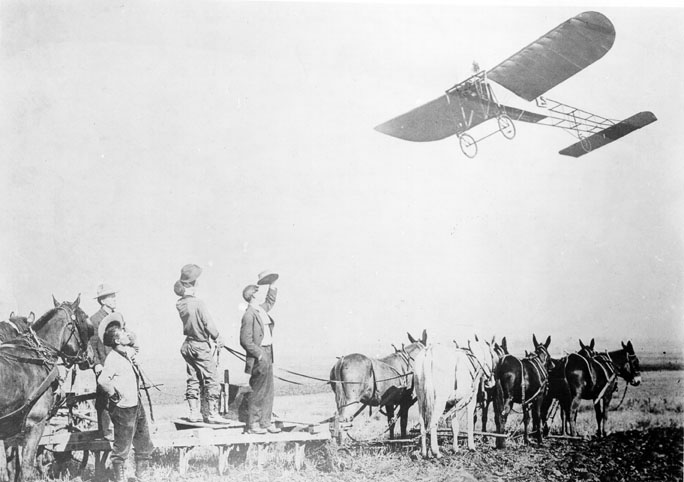 |
|
| (1910)* - Spectators watch as Louis Paulhan flies a Bleriot monoplane at the nation's first Air Meet. |
Historical Notes Gaining attention as the aeroplane used in the first crossing of the English Channel, in 1909, the Bleriot Monoplane became one of the earliest single wing designs to be favored by early aviators. Two of the monoplanes were brought across the Atlantic to the 1910 Air Meet by pilot Louis Paulhan and performed admirably at the event.^##* |
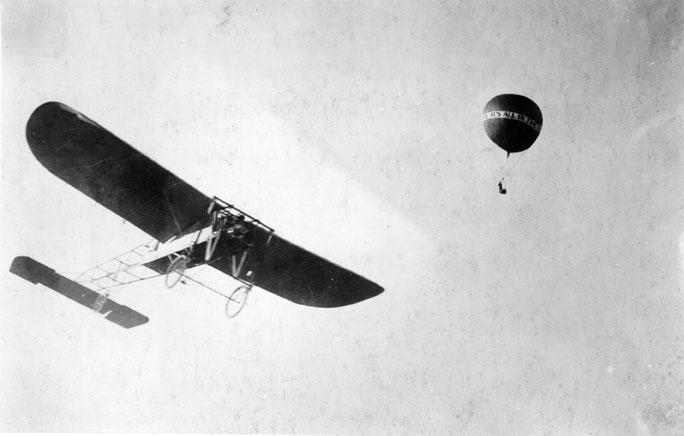 |
|
| (1910)* - A monoplane and a balloon are seen against the sky. |
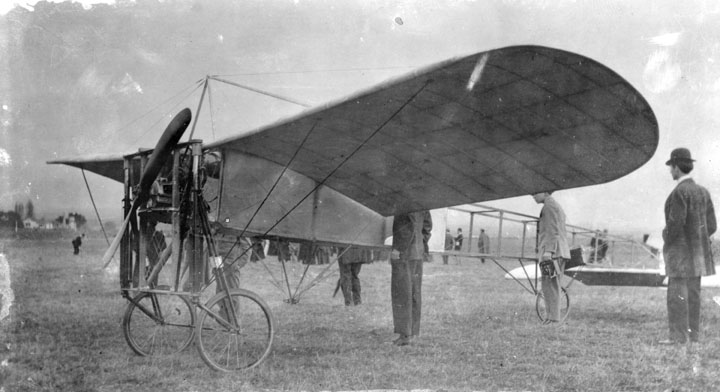 |
|
| (1910)* - Side view of a monoplane. Men are gathered around, gazing at the plane, including one holding a camera. |
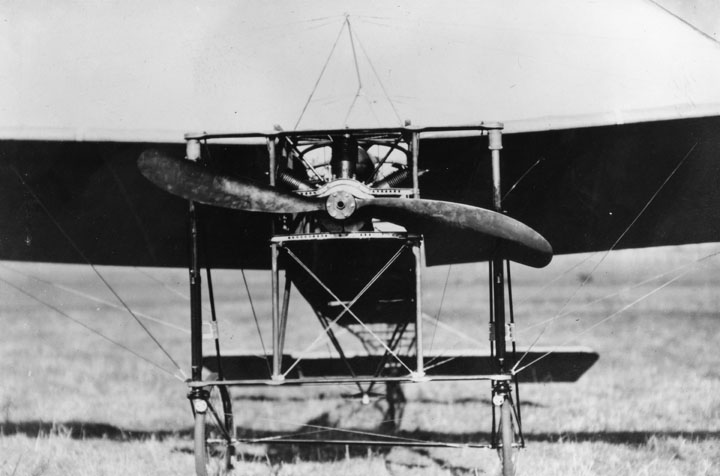 |
|
| (1910)* - A close-up of the propellor and front end of a French monoplane on the Dominguez Airfield. |
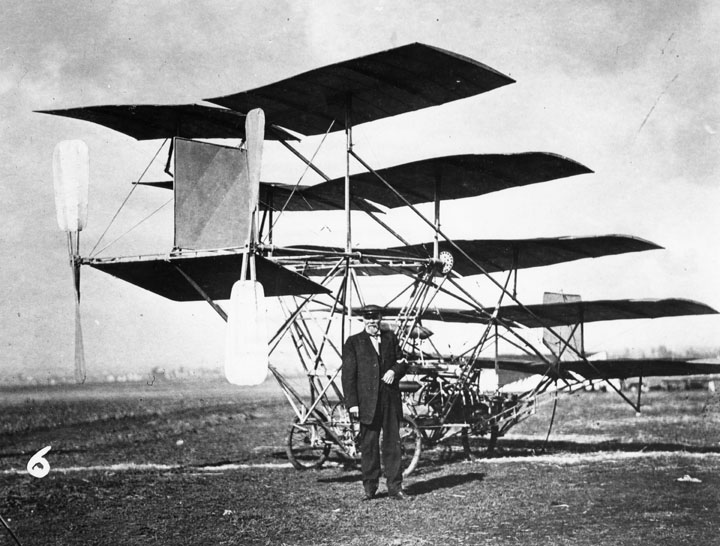 |
|
| (1910)* - Professor J.S. Zerbe stands in front of his multiplane, an 8 cylinder, aircooled airplane, with 5 planes and 2 props. |
Historical Notes One of the more unusual planes seen at the Dominguez Air Show was Los Angeles resident Jerome Slough Zerbe's so-called "Multi-plane," a construction which boasted five separate "planes" of wings attached to an elaborate chassis. Unfortunately for Zerbe, his creation hit a hole in the field and collapsed during take-off, ruining several of the wings and making filght impossible.*^ |
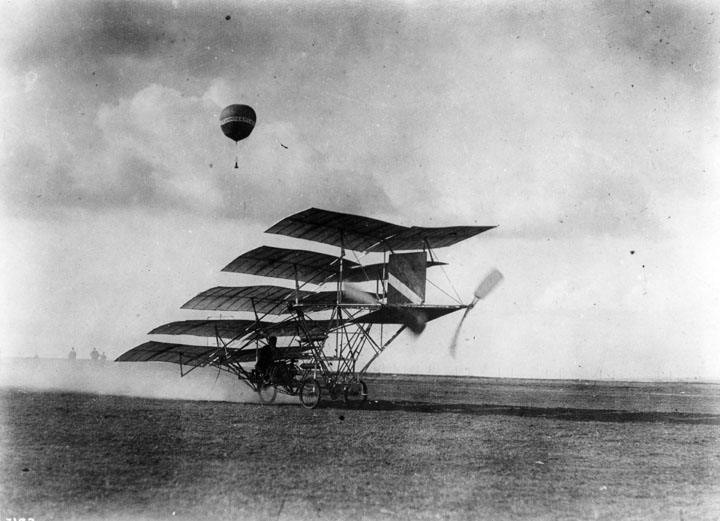 |
|
| (1910)* - Professor Zerbe's multiplane is attempting to take-off on Dominguez Field, with a gas-filled balloon in flight in the background. |
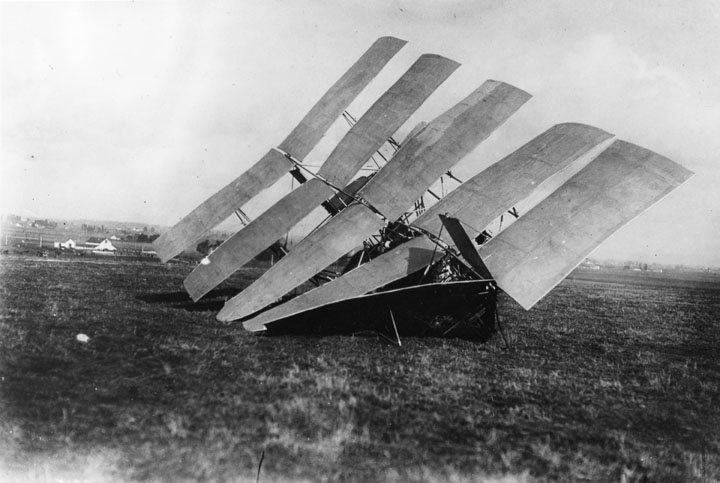 |
|
| (1910)* - This photograph depicts the aftermath of Zerbe's multiplane crash just after it hit a hole on the runway during its take-off attempt. |
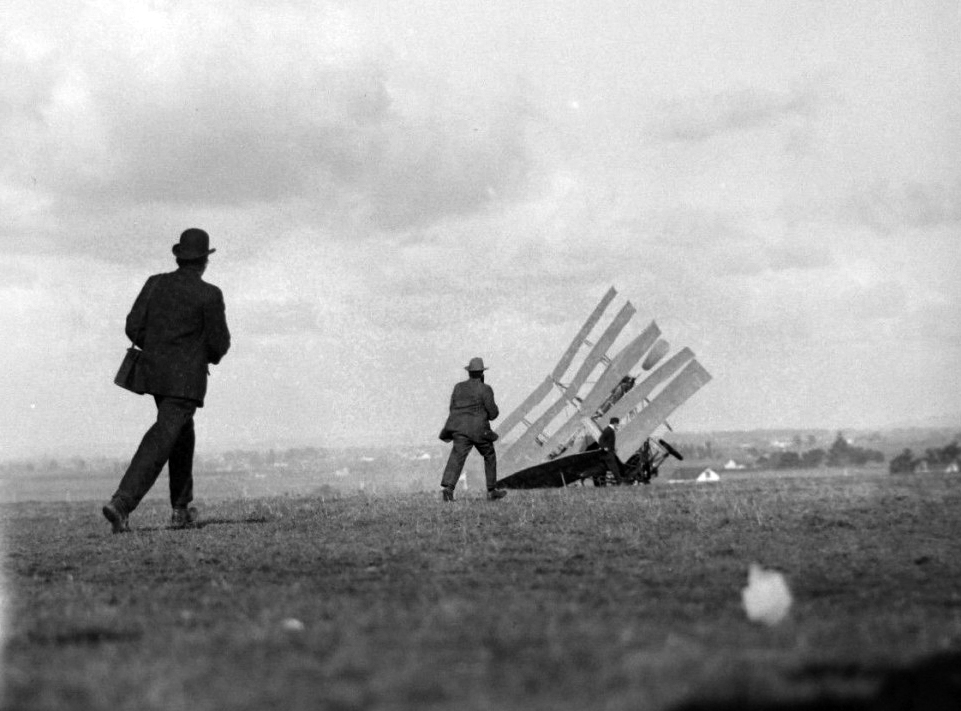 |
|
| (1910)^*# - View showing two men running toward the “multiplane” after its crash. |
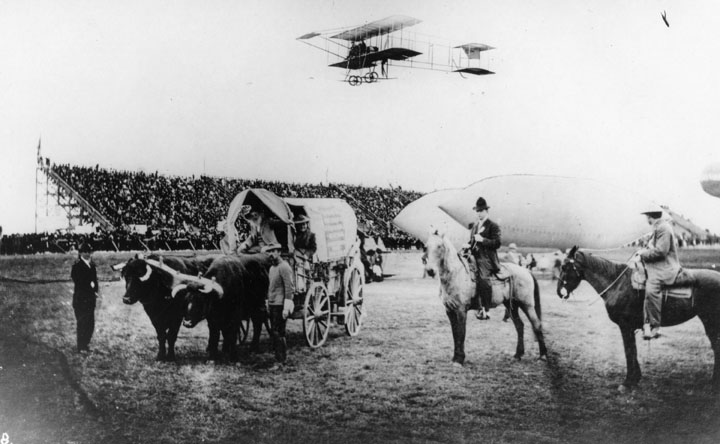 |
|
| (1910)* - Five different modes of transportation are shown: airplane, balloon, blimp, horseback riding and a team of oxen pulling a wagon. All this in front of a large audience at the first U.S. International Air Meet. |
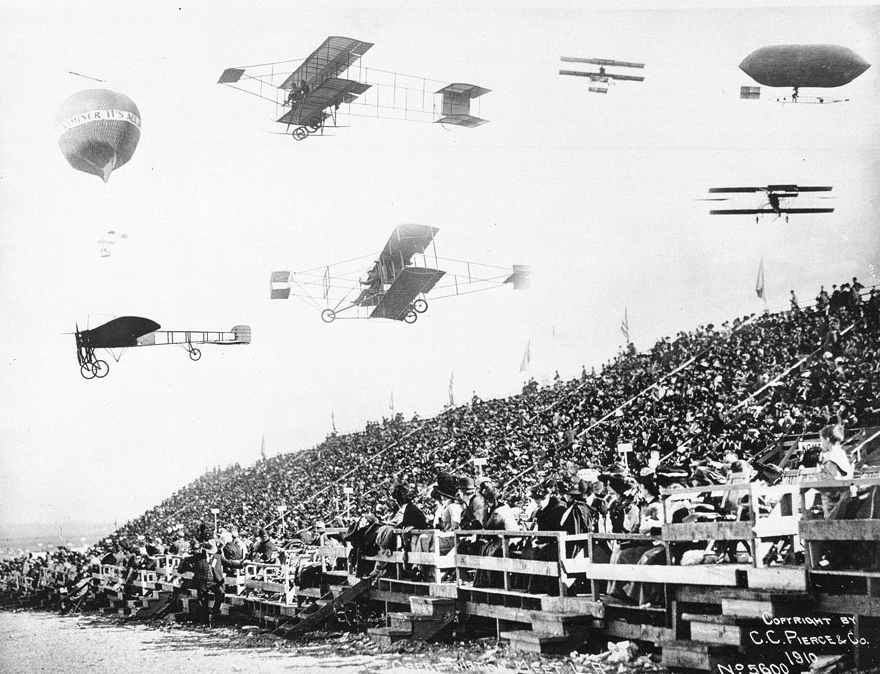 |
|
| (1910)^* - Another composite photograph of early-model biplanes, a monoplane, a gas-filled balloon, and a dirigible (also gas-filled) hovering above or flying by bleachers filled with spectators at the 1910 Dominguez Field Air Meet, January 1910. Most of the spectators have their head turned to the right, including people who are seated beyond the planes that are passing overhead. "All in the Examiner" is an advertisement that is painted on the balloon (at left). Flags are placed at intervals at the top of the bleachers. Caption reads: "Great Aviation Meet, L.A.". |
Historical Notes Attendance at the air meet reached and surpassed all expectations. During the ten-day period of the air meet an estimated 226,000 spectators converged on Dominguez Field. Gate receipts for the event equaled over $137,500. The air meet was considered a phenomenal success and helped to alleviate a perceived economic drought in the Los Angeles area.^* |
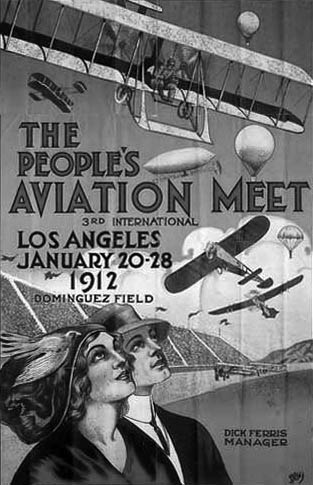 |
(1912)+^^ - Poster for the 3rd International People's Aviation Meet at Dominguez Field.
|
Historical Notes The 1912 Los Angeles International Aviation Meet was held on Dominguez Mesa, and was known as "The People's Aviation Meet." It was the third aviation meet held in Los Angeles, California. Lincoln Beachey was one of the star aviators at the meet which also featured Charles Willard, Blanche Stuart Scott, Phil Parmelee, Cliff Turpin, Glenn Martin, Howard Gill, and Farnum Fish, among others. |
Women in Aviation
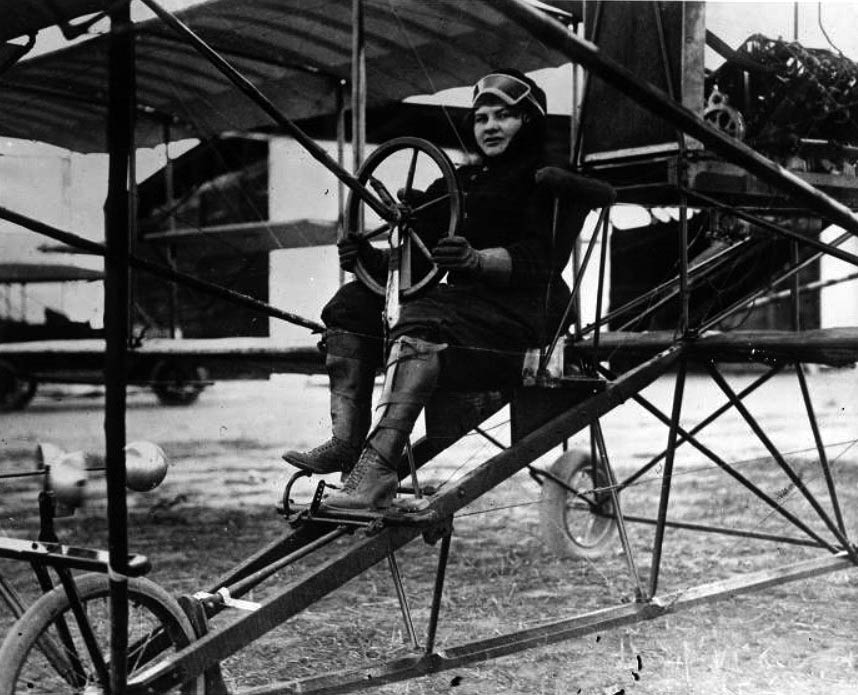 |
|
| (ca. 1912)#* - Blanche Scott, first American woman to fly, Dominguez Field. |
Historical Notes Blanche Stuart Scott (April 8, 1885 – January 12, 1970) is credited by the Early Birds of Aviation as the first woman to pilot and solo in an airplane in the U.S. (1910). She then went on to become a professional pilot, making her debut on October 24, 1910, as a member of the Curtiss exhibition flying team at an air meet in Fort Wayne, Indiana. This made her the first woman to fly at a public event in America.+^# |
.jpg) |
(ca. 1912)+^# - Blanch Scott ready to fly in her stylish outfit. Wow!
|
Historical Notes In 1911 Scott became the first woman in the U.S. to fly long distance when she flew 60 miles (non-stop from Mineola, New York. In 1912 she contracted to fly for Glenn Martin+ and became the first female test pilot when she flew Martin prototypes before the final blueprints for the aircraft had been made.+^# + Glenn Martin was an airplane designer, founding his own company which later evolved into Lockheed Martin). |
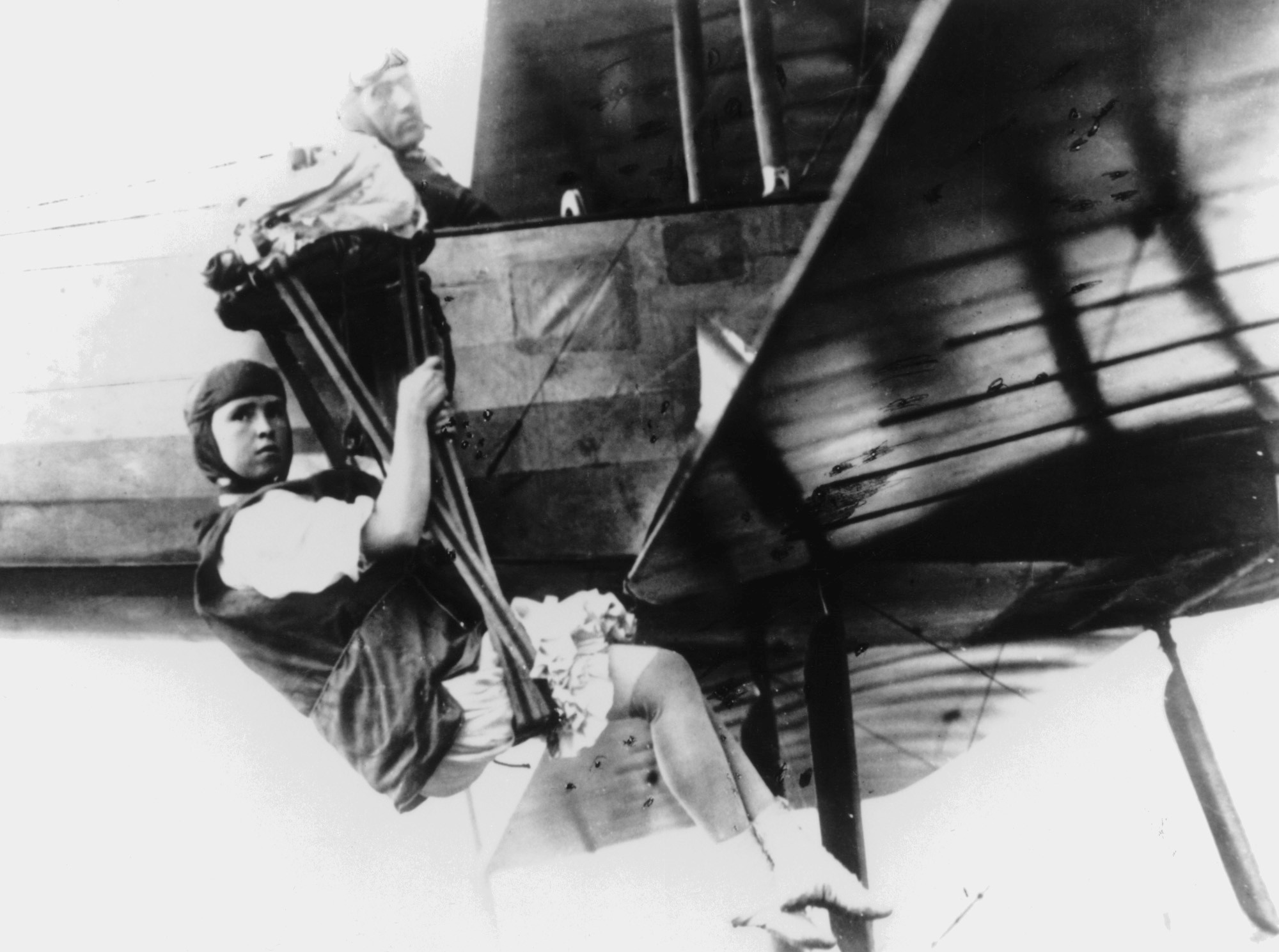 |
|
| (ca. 1913)+# - View showing 'Tiny' Broadwick as she prepares to parachute out of a plane. |
Historical Notes Georgia Ann Thompson Broadwick was an American pioneering parachutist. She was nicknamed 'Tiny', as she weighed only 85 pounds and was 5 feet tall. At the age of 15 she saw Charles Broadwick's World Famous Aeronauts parachute from a hot air balloon and decided to join the travelling troupe. She later became Broadwick's adopted daughter. Although she would eventually make her jumps from an airplane, in her earlier career she was jumping from balloons. Billed as "the doll girl," Tiny began performing aerial skydives and stunts while wearing a "life preserver" designed by her adopted father. On December 28, 1908, Tiny made her very first jump out of a hot air balloon. The skydiving family traveled around and performed at fairs, carnivals, and parks. Among her many other achievements, she was the first woman to parachute from an airplane, which she accomplished on June 21, 1913, over Los Angeles, with aviator Glenn L. Martin as the pilot. These early jumps included a well-publicized jump on January 9, 1914, from a plane built and piloted by Martin, 1,000 feet over Griffith Park in Los Angeles, California. She was also the first woman to parachute into water.*^ |
Santa Monica
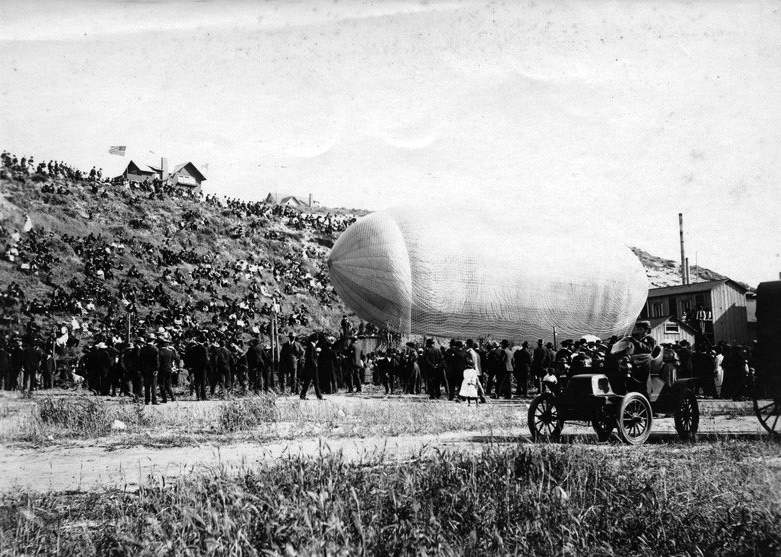 |
|
| (1905)^**^ – View showing Thomas Baldwin’s dirigible in Santa Monica surrounded by a large number of spectators. The hillside is also covered with people waiting to see the airship’s flight. |
Historical Notes Thomas Scott Baldwin was a pioneer balloonist and U.S. Army major during World War I. He was the first American to descend from a balloon by parachute. In 1900, Baldwin created a motorized balloon. He used a motorcycle engine built by Glenn Hammond Curtiss and an aerodynamic cigar-shaped, hydrogen filled, balloon. He created the dirigible "California Arrow", which underwent the first controlled circular flight in America on August 3, 1904. The aircraft was piloted by Roy Knabenshue at the 1904 Louisiana Purchase Exposition in St. Louis. The Army Signal Corps paid him $10,000 for a dirigible that could be used for sustained and controlled navigation. Baldwin created a dirigible that was 95 feet long and powered by a new, more powerful Curtiss engine. The Army bought it and designated its first dirigible "SC-I" (Signal Corps Dirigible Number 1). Baldwin picked up the sobriquet: "Father of the American Dirigible." He received the Aero Club of America's first balloon pilot certificate.*^ |
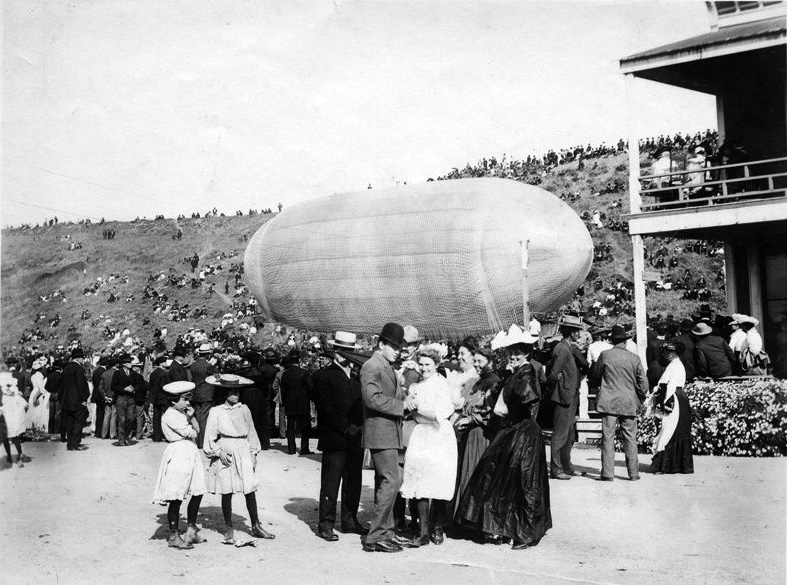 |
|
| (1905)^**^ - Young ladies surround a man (Baldwin?) in a light colored suit with a top hat in front of the Baldwin Airship. |
Historical Notes In 1914 Baldwin built the U.S. Navy's first successful dirigible, the DN-I. He began training airplane pilots and managed the Curtiss School at Newport News, Virginia. One of his students was Billy Mitchell, who would later become an advocate of American military air power. When the United States entered the World War I, Baldwin volunteered his services to the United States Army. He was commissioned a captain in the Aviation Section, U. S. Signal Corps and appointed Chief of Army Balloon Inspection and Production. Consequently, he personally inspected every lighter-than-air craft built for and used by the Army during the war. He was promoted to the rank of major during the war. After the war, he joined the Goodyear Tire and Rubber Company in Akron, Ohio, as a designer and manufacturer of their airships. |
* * * * * |
Dirigible Flights at the Raymond Hotel
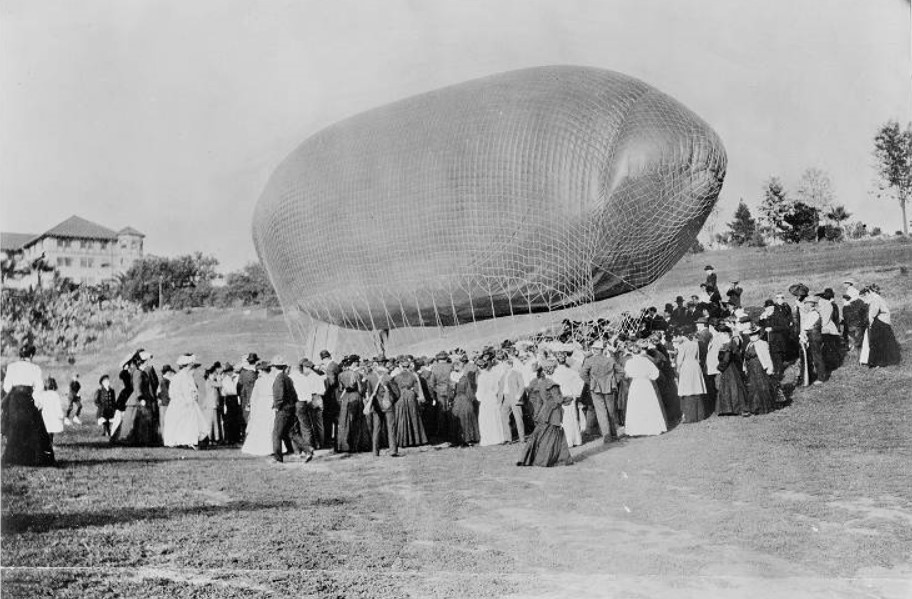 |
|
| (1905)* - View of Roy Knabenshue landing his dirigible on the Raymond Hotel grounds, surrounded by a large crowd of people. |
Historical Notes CA. Roy Knabenshue made outstanding contributions to aviation as an aeronaut making balloon flights. He was among the first to pilot a steerable balloon, one of the pilots of the first successful American dirigible, a builder and exhibitor of dirigibles of his own design, manager of the Wright Brothers’ Exhibition Team, and a leading builder of observation balloons during World War I. |
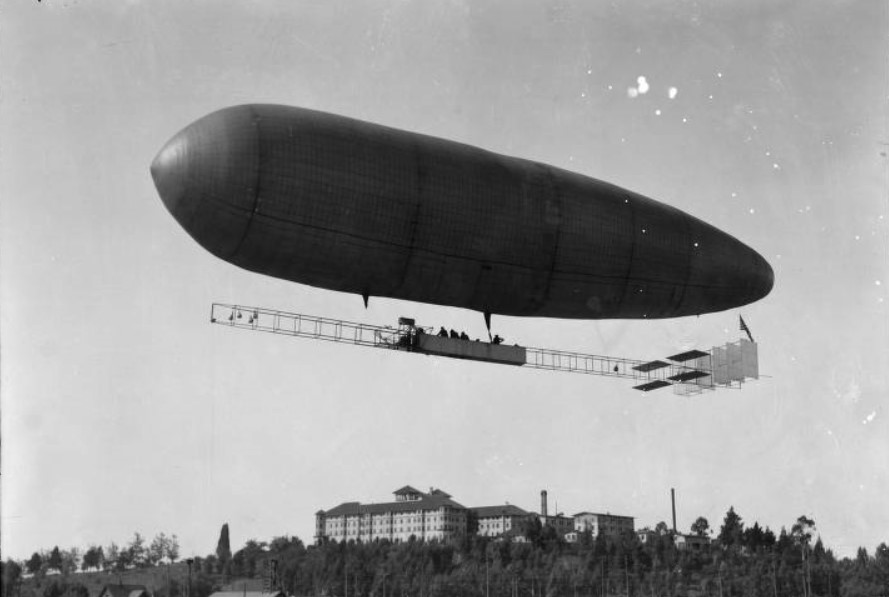 |
|
| (1913)* - A view showing Roy Knabenshue flying his new multi-passenger dirigible with the Raymond Hotel in the background. There are people in the undercarriage which runs the length of the airship. |
Historical Notes Roy Knabenshue was the first to make a dirigible balloon flight over the skyscrapers of New York back in 1905, one year after his original lighter-than- air powered flight at the St. Louis Exposition. After several years of barnstorming and a stretch as general manager for the Wright Brothers, he went west and built a 13-passenger airship in Pasadena for passenger flights. |
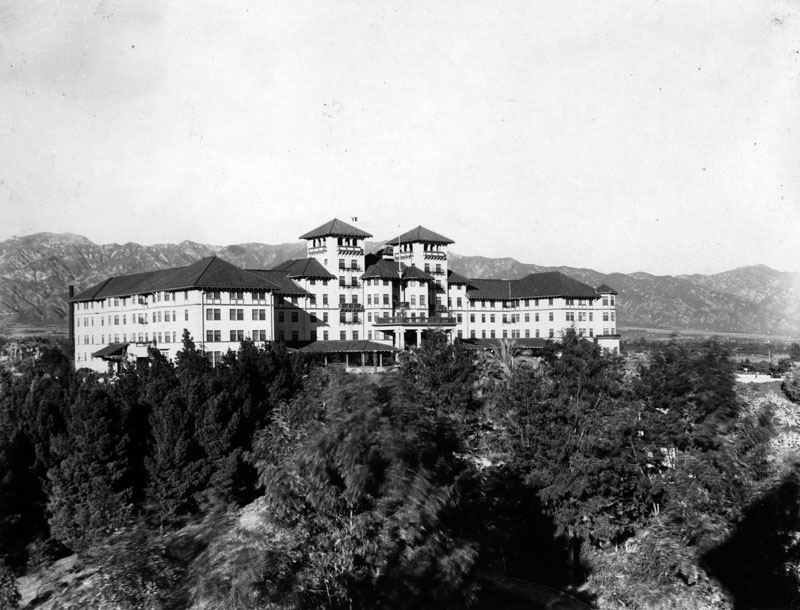 |
|
| (ca. 1910s)* - View of the second Raymond Hotel looking across the grounds at the western facade, the main entrance to the hotel. In the background are the San Gabriel Mountains. |
Historical Notes Located atop Bacon Hill, renamed Raymond Hill, which lies between Pasadena and South Pasadena, the first Raymond Hotel burned down in 1895 and was replaced by a second in 1903.* Click HERE to see more in Early Views of Pasadena. |
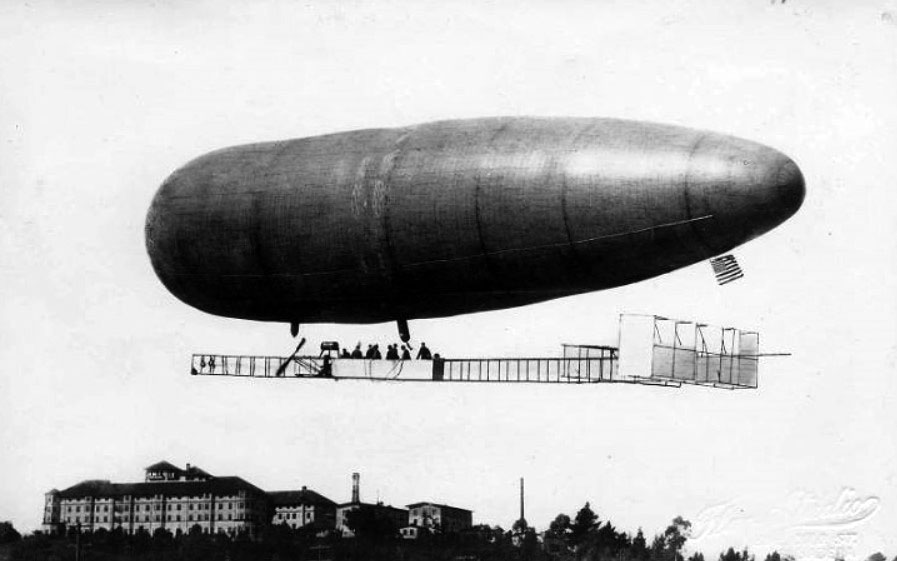 |
|
| (1913)* - Roy Knabenshue flying his 13-passenger dirigible over the Raymond Hotel. He offered aerial tours of the City of Pasadena. |
Historical Notes Click HERE to see more in Aviation in Early L.A. |
* * * * * |
Burdett Airport
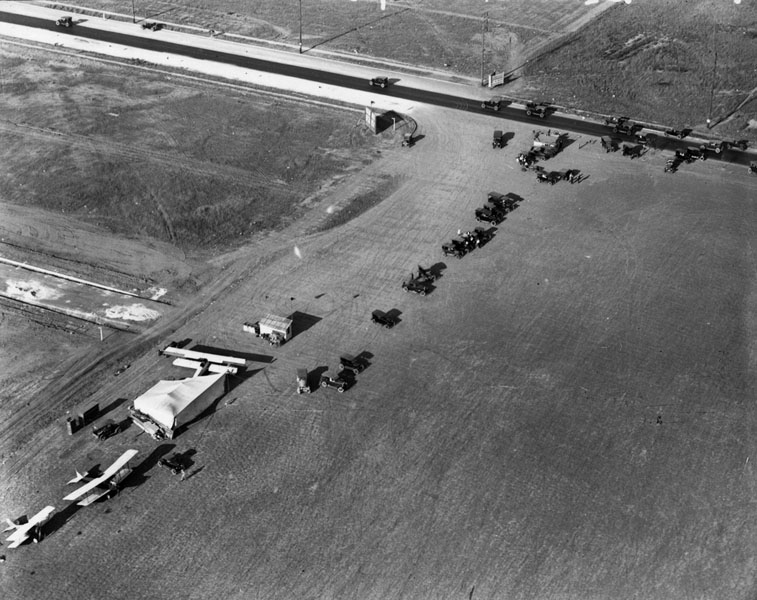 |
|
| (1925)* - Aerial view of Burdett Airport, located at 9401 S. Western Avenue at the intersection of 94th Street and Western Avenue in what is now Inglewood. |
Historical Notes Commercial enterprises in early aviation began to develop after World War I when veteran aviators left the military and saw a future in air travel. Burdett Fuller was a naval reserve flyer who started a flying school and passenger service that grew into an active operation known as Burdett Airport and Burdett Airline located off Western Avenue at 94th Street in Southwestern Los Angeles. Fuller began his airline in 1919 with war surplus Jennys and opened his Burdett Airport in 1922. An historic aviation venture involving Burdett Fuller and Jack Frye was known as the "13 Black Cats" a stunt team working for the pioneer movie industry in the early 1920s. Jack Frye was one of the pilots. They were based at Burdett Airport, reportedly the first private airport in Western United States. *#* |
Black Cats
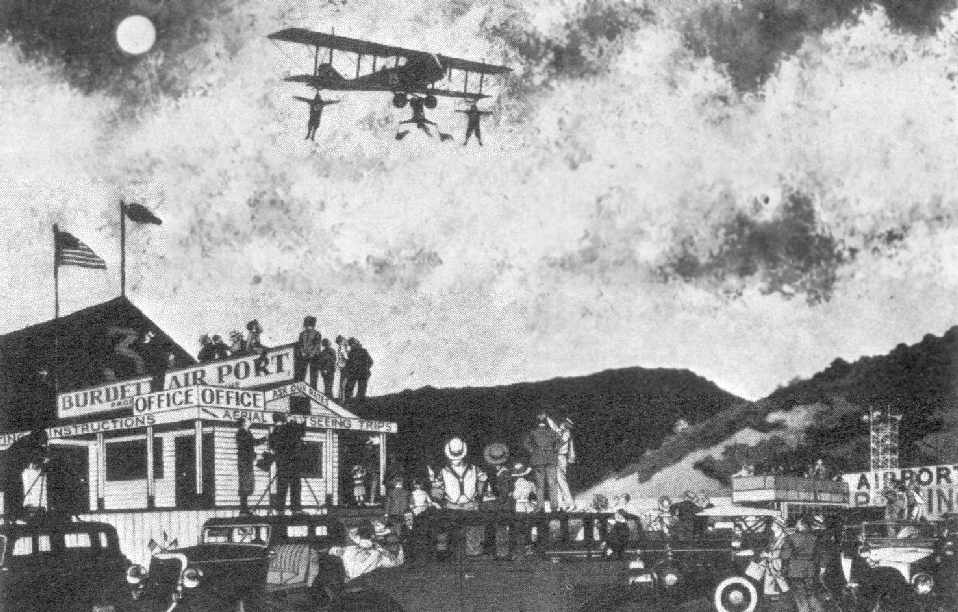 |
|
| (1920s)*# - An illustration of a performance of the "13 Black Cats" at the Burdett Airport. |
Historical Notes The Black Cats were involved with motion pictures and received lots of publicity in the 1920's. Footage of the Black Cats doing their various stunts appeared in many early movies.*^ |
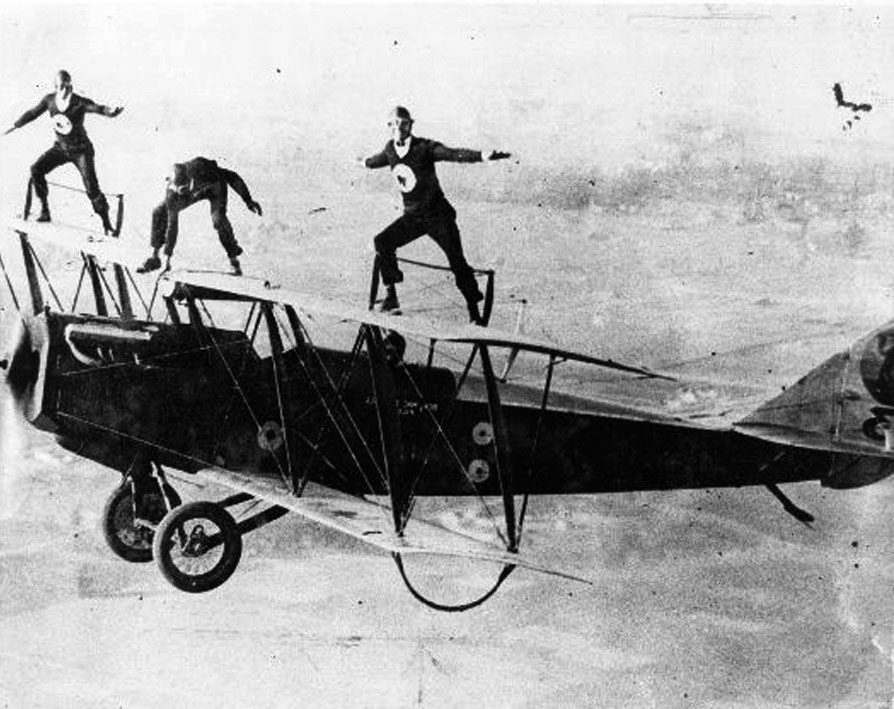 |
|
| (1920s)^# - Three members of the Flying Black Cats stand on the top wing of a bi-plane in flight. |
Historical Notes Their business card says it all, "If a Black Cat can't do it - It can't be done." Their show included motorcycle and car stunts, but their real prowess was in the air, including wing walking with no parachutes, mid-air leaps from one plane to another, flying behind a plane on a tow line, and more. ^# |
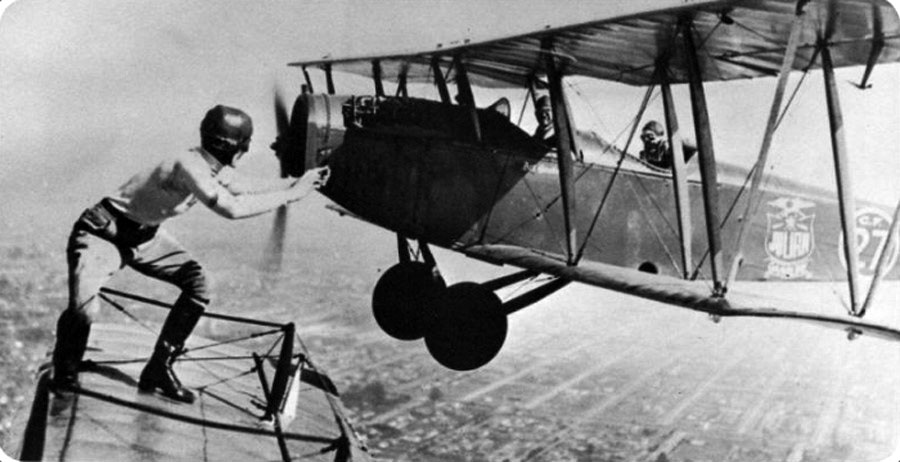 |
|
| (1920s)^# - Flying Black Cats stuntman about to make a mid-air leap from one plane to another without a parachute. |
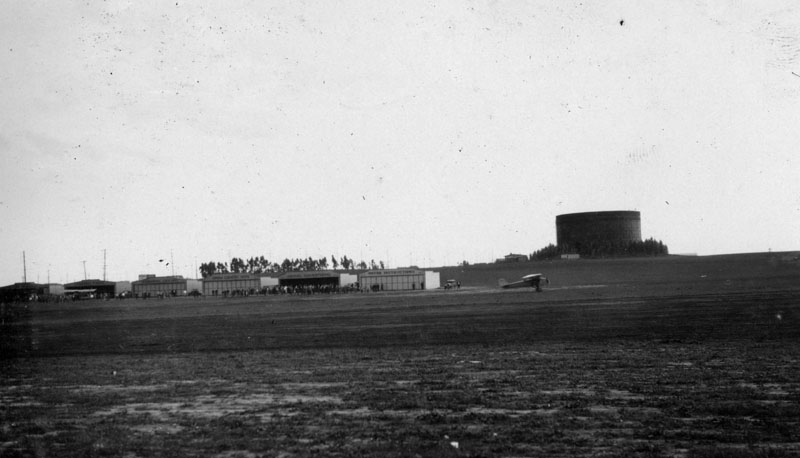 |
|
| (1928)* - View of a large crowd standing near hangars as a plane takes off at Burdett Field. |
Historical Notes The Burdett School of Aviation was established in 1925 by Burdett Fuller and partner Jack Frye to create a base for Burdett Airlines. Eventually Fuller sold the field to Jack Frye, who founded Aero Corp, which later became TWA. Charles Dycer bought the field from Jack Frye in the late 1920s, renaming thge field Dycer Airport.* |
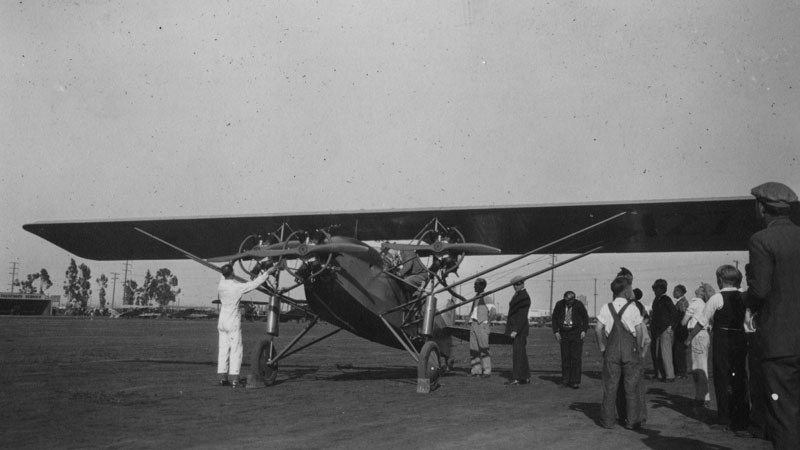 |
|
| (1928)* - A Siemens tri-motor (one at the propeller; one on each side) Brown Mercury plane at Burdett Field. |
Historical Notes Designed by Larry Brown and built in 1927 by the Brown Mercury Aircraft Co. of Los Angeles, the craft was of conventional construction with a wire-graced welded steel tube fuselage, welded steel tube tail surfaces, and a wooden wing, all of which were covered in fabric. The market for this type of plane was small and although reports indicate that it was a good flying machine, production of the aircraft was discontinued during the Great Depression.* |
DeMille Field No. 1 (Melrose and Fairfax)
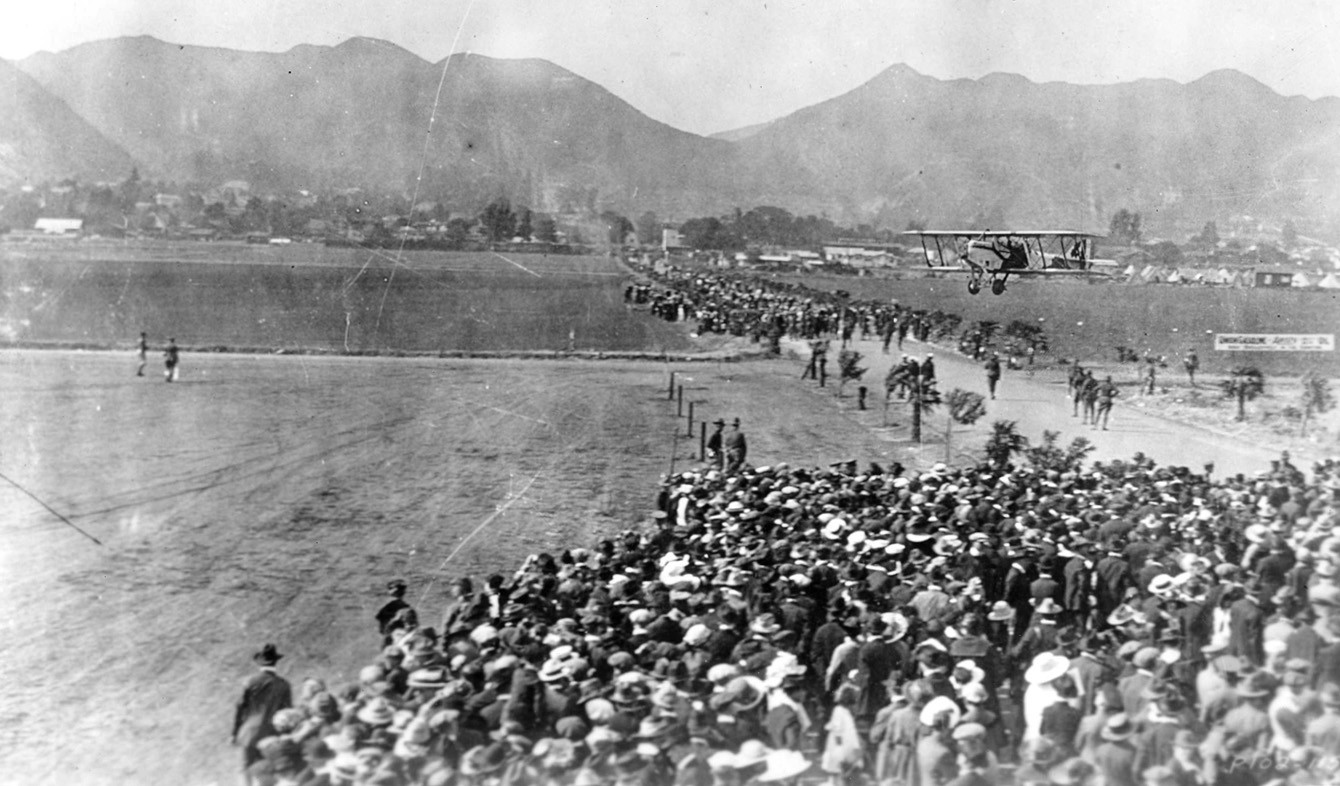 |
|
| (ca. 1919)^ - Crowds of people watch as a bi-plane lands near the southwest corner of Melrose Ave and Crescent Ave (later Fairfax Ave). The view is looking north toward the Hollywood Hills. |
Historical Notes In the late 1910’s prominent members of the Hollywood community were bitten by the flying bug, the most notable being the famed director Cecil B. DeMille and Sydney Chaplin, the older half-brother of Charlie Chaplin. Although business competitors, they pioneered what would become the modern airline industry by offering the first scheduled commercial flights in the world. DeMille, a founder of the Academy of Motion Picture Arts and Sciences, was the most commercially successful director of his time. His credits ranged from the Squaw Man to the Greatest Show on Earth and the Ten Commandments. In 1918 DeMille founded the Mercury Aviation Company and built his first airfield, DeMille Field No. 1, across from the present location of Fairfax High School. |
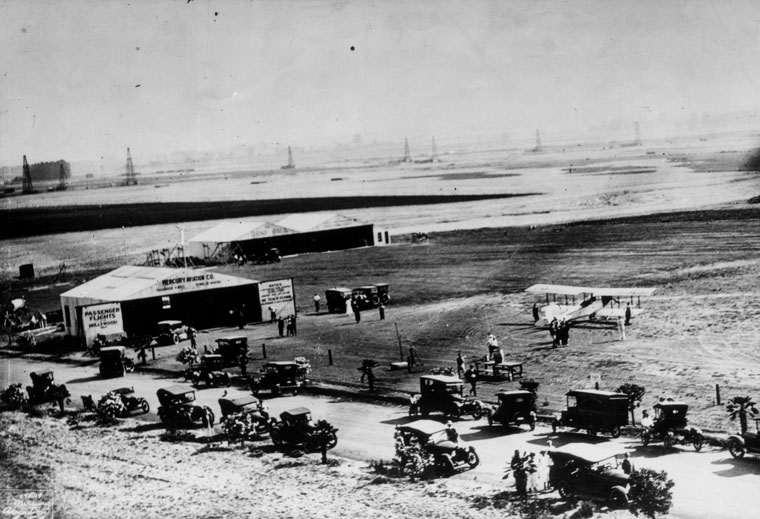 |
|
| (ca. 1919)* - View looking southwest showing cars parked along Crescent Ave (later Fairfax Ave) just south of Melrose Ave with the Demille Airfield seen at right. Note the oil wells in the distance. |
Historical Notes In 1919, DeMille would build a second airfield, DeMille Field No.2, and move his enterprise from the field seen above to a new location near the northwest corner of Wilshire Boulevard and Fairfax Avenue (which was then known as Crescent Avenue). |
DeMille Field No. 2 (Wilshire and Fairfax - later Rogers Airport)
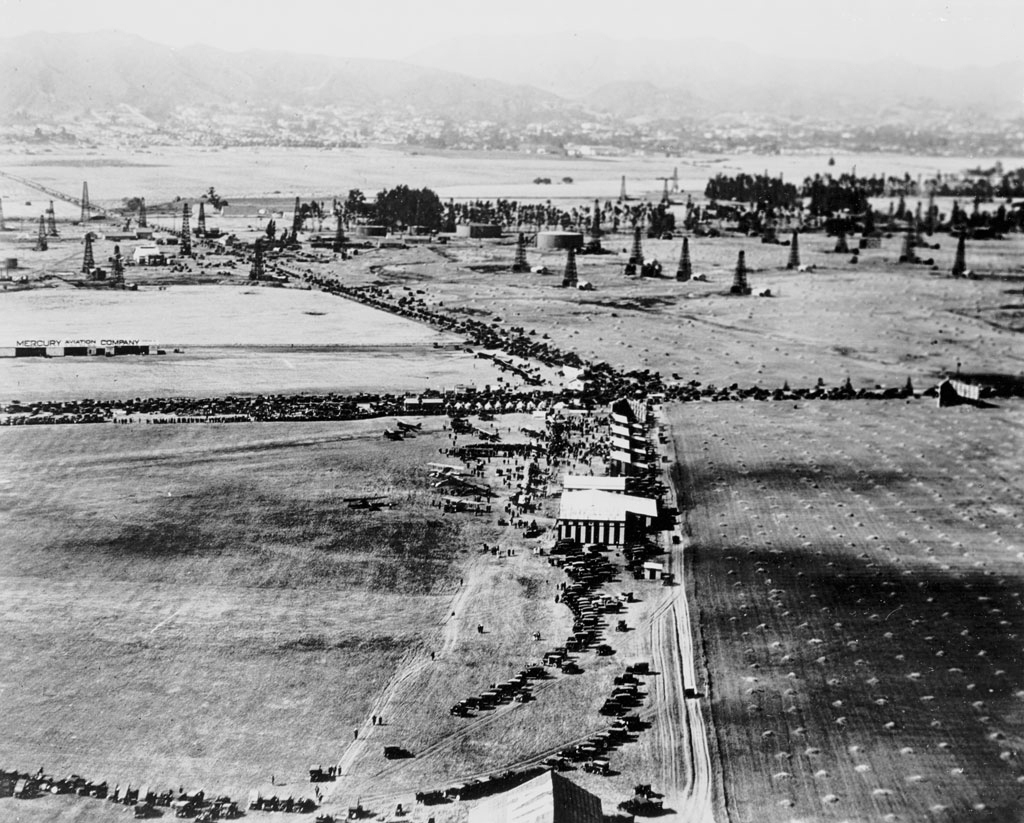 |
|
| (ca. 1920)^* - Aerial view of the intersection of Wilshire Boulevard and Fairfax Avenue looking north during an aviation fair. Automobiles are parked off the roads at the fringes of the open fields that skirt them. Oil fields are visible along with mountains in the background, while at center, people crowd around a collection of airplanes that are situated next to small vendor booths. In a field in the left background (left-center), a building shows a sign which reads "Mercury Aviation Company" (part of DeMille Field No. 2). Chaplin Airfield is seen across Wilshire Boulevard at lower-left. |
Historical Notes In 1919, Cecil B. DeMille built his second airfield (DeMille Field No. 2) on the northwest corner of Wilshire Boulevard and Fairfax Avenue (which was then known as Crescent Avenue). DeMille's first airfield was located on the southwest corner of Melrose and Crescent avenues. Cecil B. DeMille founded the Mercury Aviation Company (aka Mercury Air Lines ) in 1919. Mercury was the first American airlines to carry air freight and passengers commercially on regularly scheduled runs. It scheduled service to Santa Catalina Island and San Diego, later San Francisco, with Junker-Larsen JL-6 monoplanes. Inaugurated five months before KLM began operations in Europe.^^ Mercury’s competitor in the air travel business was across the street at Chaplin Airfield, which was founded in 1919 by Sydney Chaplin. Chaplin was a stage performer and silent film actor before becoming his far more famous sibling’s business manager. |
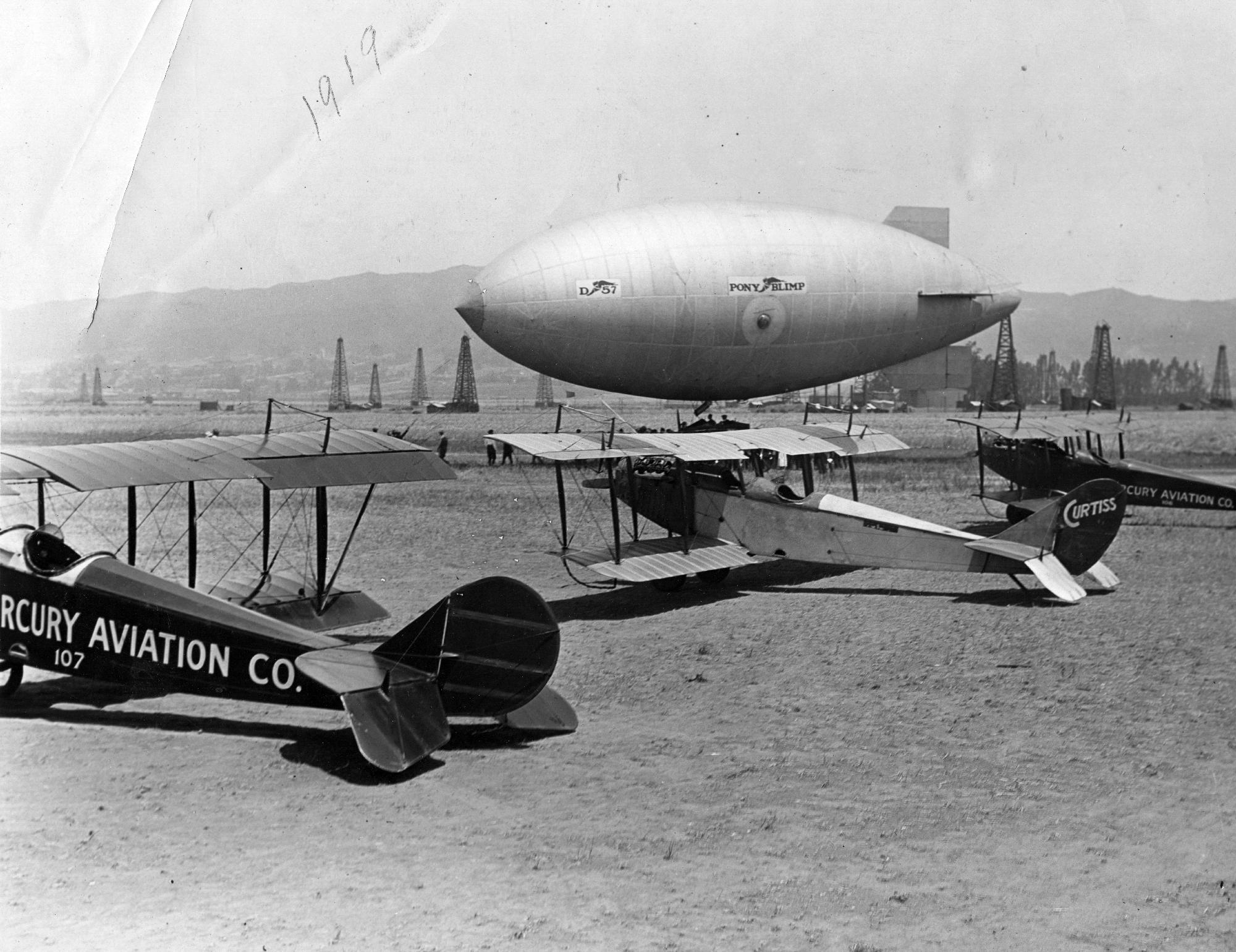 |
|
| (ca. 1920)^*# - View looking northeast showing DeMille Airfield No. 2 at Fairfax and Wilshire (NW corner). Three planes sit on the field in the foreground while a blimp hovers just beyond them. One of the planes has "Mercury Aviation Co." written on its side. Oil derricks belonging to the Gilmore family are seen in the background. |
Historical Notes Cecil B. DeMille had already pioneered one Los Angeles industry, and in 1920 he was on the cusp of launching another: as president of the newly formed Mercury Aviation Company, DeMille was pursuing the ambitious goal of inaugurating regularly scheduled airline service between Los Angeles and other West Coast cities. Mercury’s headquarters: a barley field at the northwest corner of Wilshire and Fairfax (then Crescent Ave.) where the company had cleared a primitive runway, built a hangar, and opened a filling station that refueled airplanes on one side and automobiles on the other. The aerodrome doubled as a shooting location for aviation stunts, but the real stars here were Mercury’s fleet of Junkers-Larsen monoplanes. Built of lightweight corrugated aluminum, the planes could soar to altitudes of 20,000 feet, propelled by a single 185-horsepower engine. And thanks to a sealed cabin, passengers could fly without goggles and other special gear. ##* |
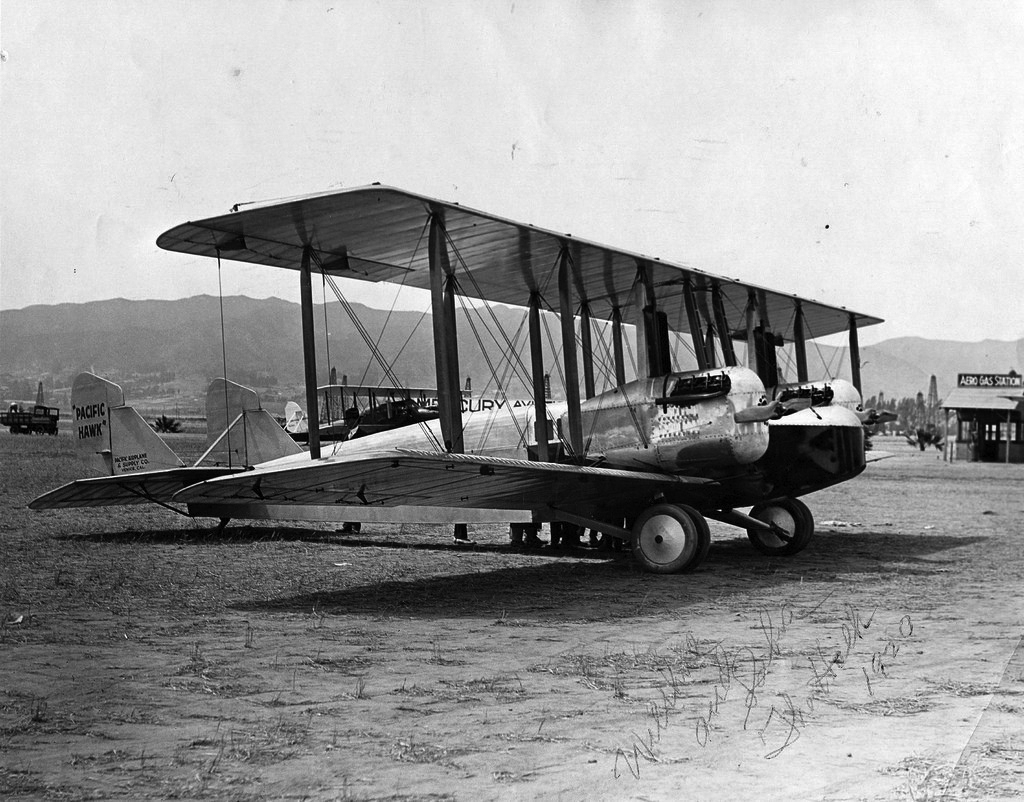 |
|
| (1920)^*# - View showing one of Mercury Aviation's Junker-Larson airplanes at DeMille Airffield No. 2. |
Historical Notes Built of lightweight corrugated aluminum, the planes could soar to altitudes of 20,000 feet, propelled by a single 185-horsepower engine. And thanks to a sealed cabin, passengers could fly without goggles and other special gear. In the two years or so it was in operation, Mercury transported over 25,000 passengers without a single injury – but flying was expensive and still too much of a novelty to be fully embraced by the traveling public. The Mercury Aviation Company proved to be unprofitable and DeMille shut down the airline by 1922. |
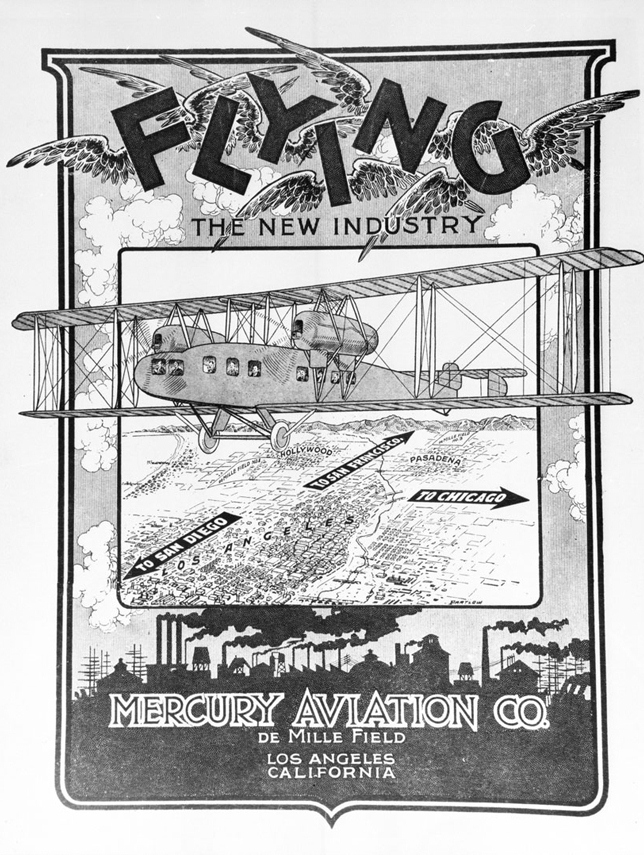 |
|
| (ca. 1922)^* - Photograph of an advertisement for Mercury Aviation Company, located at DeMille Field. |
Historical Notes A bi-plane with people looking out the windows is depicted centrally. Above are the words, "Flying", in large block letters with wings atached and the words "The New Industry". Below, a map features Los Angeles with arrows pointing three different directions, each with one of the following locations, San Diego, San Francisco, and Chicago. Further below is what appears to be a silhouette of an industrial city with smoke stacks, powerlines, and oil derricks, with the words "Mercury Avation Co., De Mille Field, Los Angeles, California". Photoprint reads: "As illustrated in the picture, DeMille operated three fields in the LA area. #2 (not shown) was north of the Wilshire/Fairfax intersection. At the time (early 1920s), DeMille was the largest aviation operator in the LA area and his thoughts began to turn toward the establishment of a scheduled airline to San Francisco and San Diego".^* |
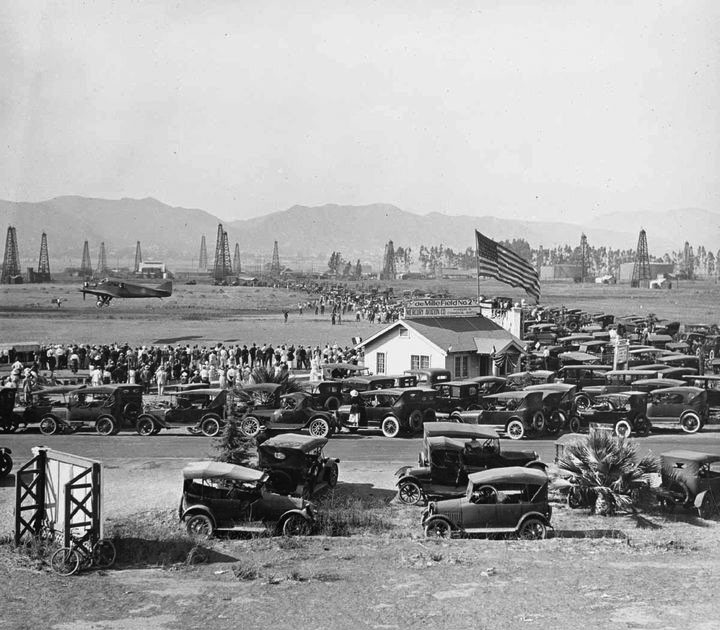 |
|
| (ca. 1920)^ - Parking lot is full as crowds attend air show at DeMille Field No. 2. The sign on top of the structure with the large American Flag reads: DeMille Field No. 2. View is looking northeast near the NW corner of Wilshire and Fairfax. |
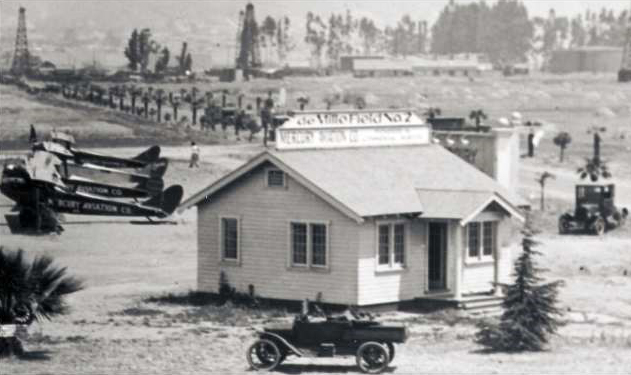 |
|
| (ca. 1920)* - Closer view of the main office at DeMille Field No. 2 located near the northwest corner of Wilshire and Crescent (Fairfax). The airfield was home to Mercury Aviation Co. |
Historical Notes The Mercury Aviation Company proved to be unprofitable and DeMille shut down the airline by 1922. He sold his airfield to Emery H. Rogers, owner of Rogers Aircraft Inc. |
 |
|
| (1922)^* - View of Rogers Airport (previously DeMille Field No. 2) looking west toward the general office and hangars with a large billboard sign that reads: "Rogers Airport. The Center of West Coast America. Fly City and Cross Country Flights. Instruction". The small clapboard building at the left edge of the image bears a sign reading "General Offices. Rogers Aircraft Inc." Two men stand on the building's steps, one of whom may be Jim Webster, the airport manager. Two airplanes sit at center, in the open land behind the sign, while the hangar sits in the left background. |
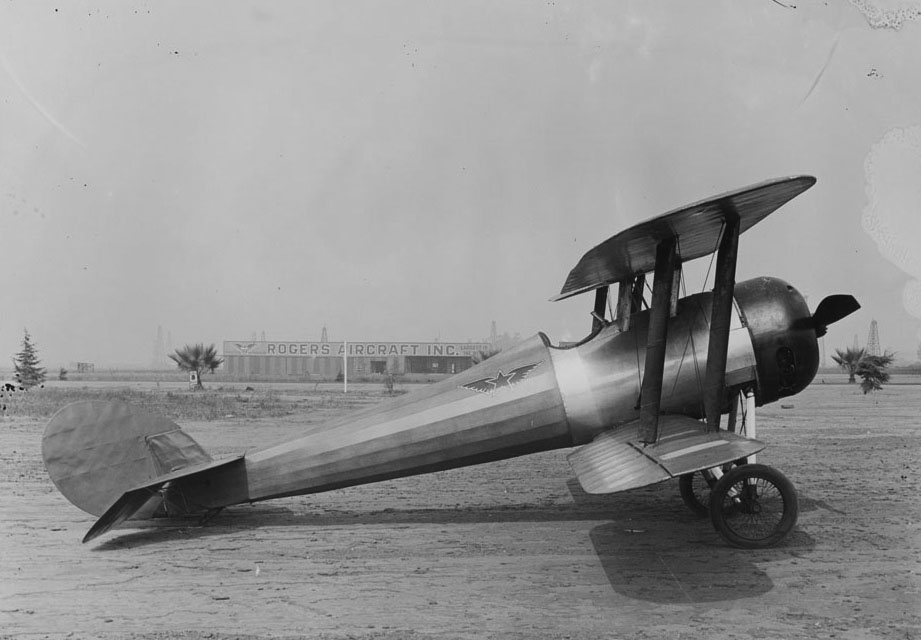 |
|
| (ca. 1922)^* - Airplane parked at Rogers Airport with Rogers Aircraft Incorporated building in the background. |
Historical Notes By 1931 Rogers Field had disappeared from street maps. Land was becoming too valuable and the area would see a surge in development. The old Rogers Field would soon become the western end of the Miracle Mile. |
Chaplin Airfiled (later Rogers Airport)
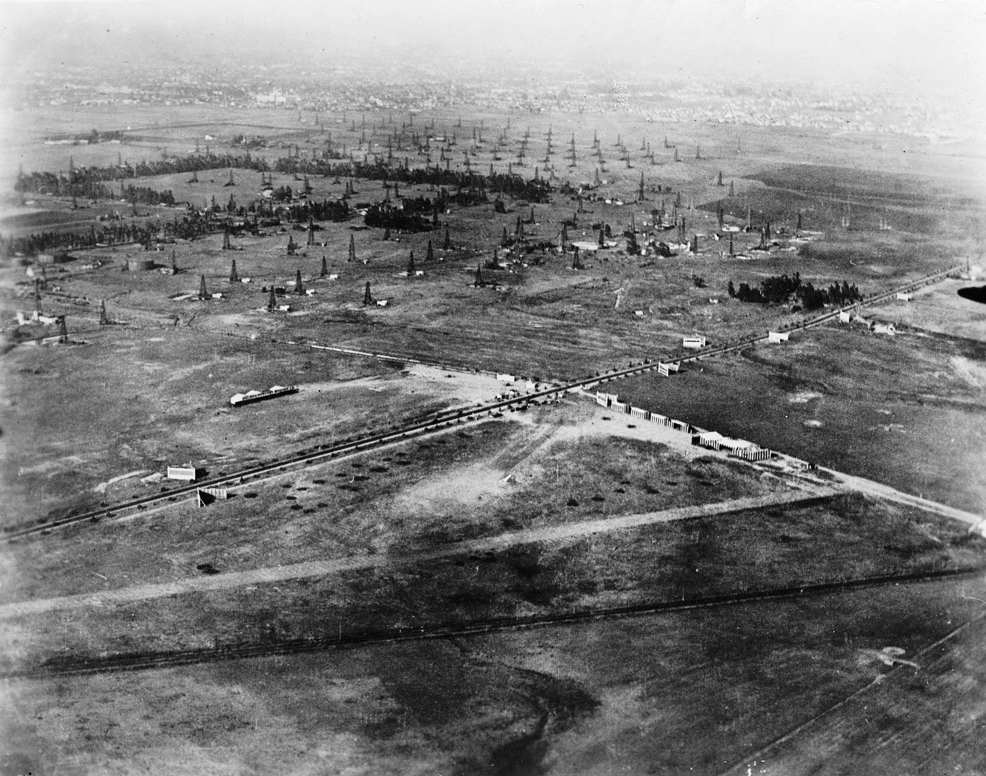 |
|
| (1920)* - Aerial view of Crescent Avenue (now Fairfax) and Wilshire Boulevard in 1920 showing undeveloped land with many oil derricks. In the lower part of the photograph is Chaplin Airport. The tree-lined street is Wilshire. The diagonal line at the bottom is actually railroad tracks that would later become San Vicente Bouelvard. |
Historical Notes Chaplin Airfield was located on leased property that is now bounded by Wilshire Boulevard, Fairfax Avenue, and San Vincente Boulevard. The Syd Chaplin Aircraft Corporation advertised that it “maintained a fleet of newest Curtis one and two-passenger aeroplanes, large shops with complete equipment and hangars for our own ships as well as those belonging to business firms and individuals.” Syd Chaplin was the brother of famed actor Charlie Chaplin. |
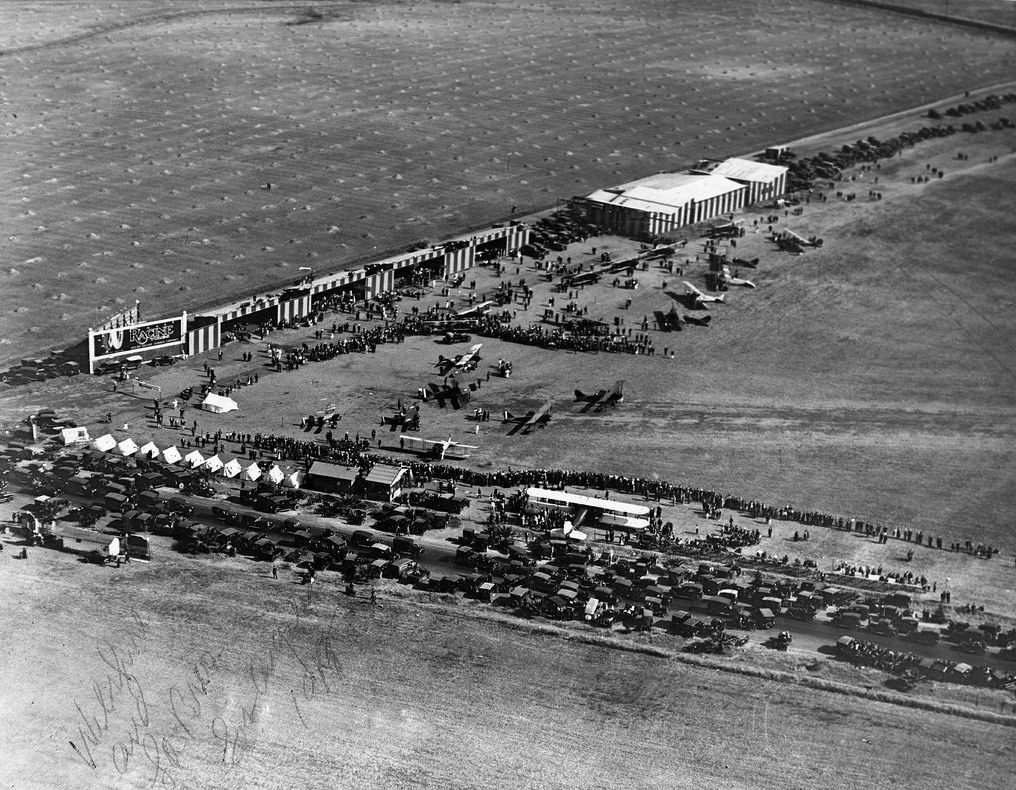 |
|
| (1919)^* - Aerial view looking southeast showing crowds of people at Sid Chaplin's airport at the southwest corner of Wilshire Boulevard and Crescent Avenue (now Fairfax Avenue). Dozens of cars are parked in rows in the foreground, with several airplanes parked behind them in the more open field. A vendor tent is visible farther up the image, near more parked cars. A billboard to the left reads "Racine Tires". |
Historical Notes The Chaplin Aircraft Company offered observation flights for $10 and round-trip flights to San Diego for $150 (at a time when the average wage was $1,200 per/year). Obviously, the cost of air travel was very steep and Chaplin’s enterprise had a brief life span. Around 1920 Chaplin sold out to Emory H. Rogers, a business partner, who renamed it Rogers Field. |
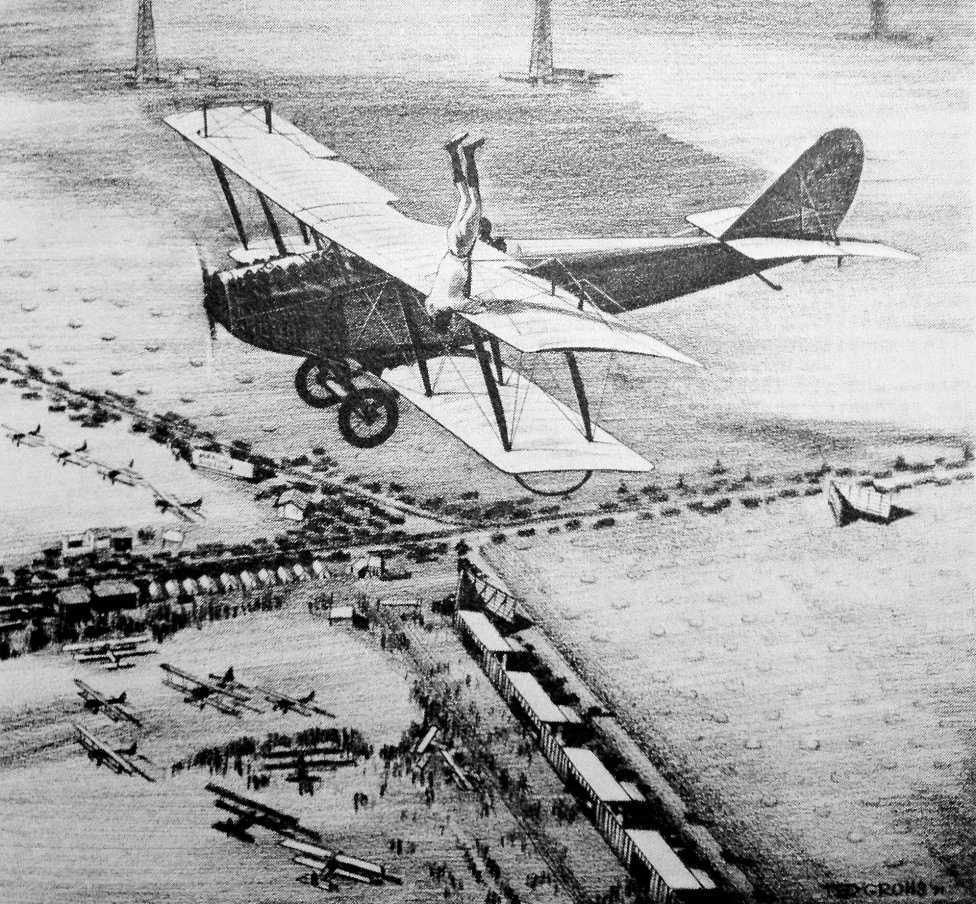 |
|
| (n.d.)*# - An undated painting by Ted Grohs of Omar Locklear during a headstand on the wing of a Jenny above the De Mille & Chaplin Airports on Wilshire Boulevard & Crescent Avenue (now Fairfax Avenue). DeMille Airport is located on the NW corner (center-left) and Chaplin Airpot is on the SW corner (lower-left). |
Historical Notes Chaplin Airport (also known as Chaplin Airdrome) became Rogers Airport circa 1920. |
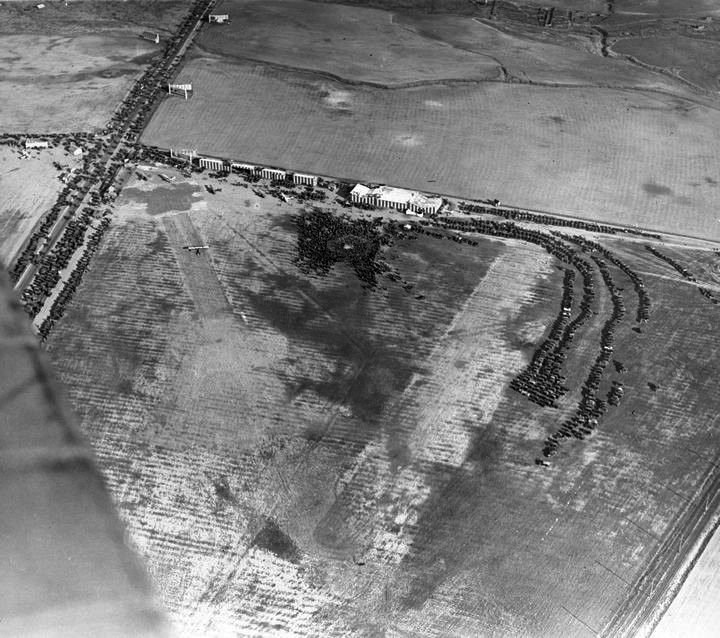 |
|
| (ca. 1922)^ – Aerial view looking down at the Chaplin Airdrome with the intersection of Crescent Ave (later renamed Fairfax Ave) and Wilshire Blvd. |
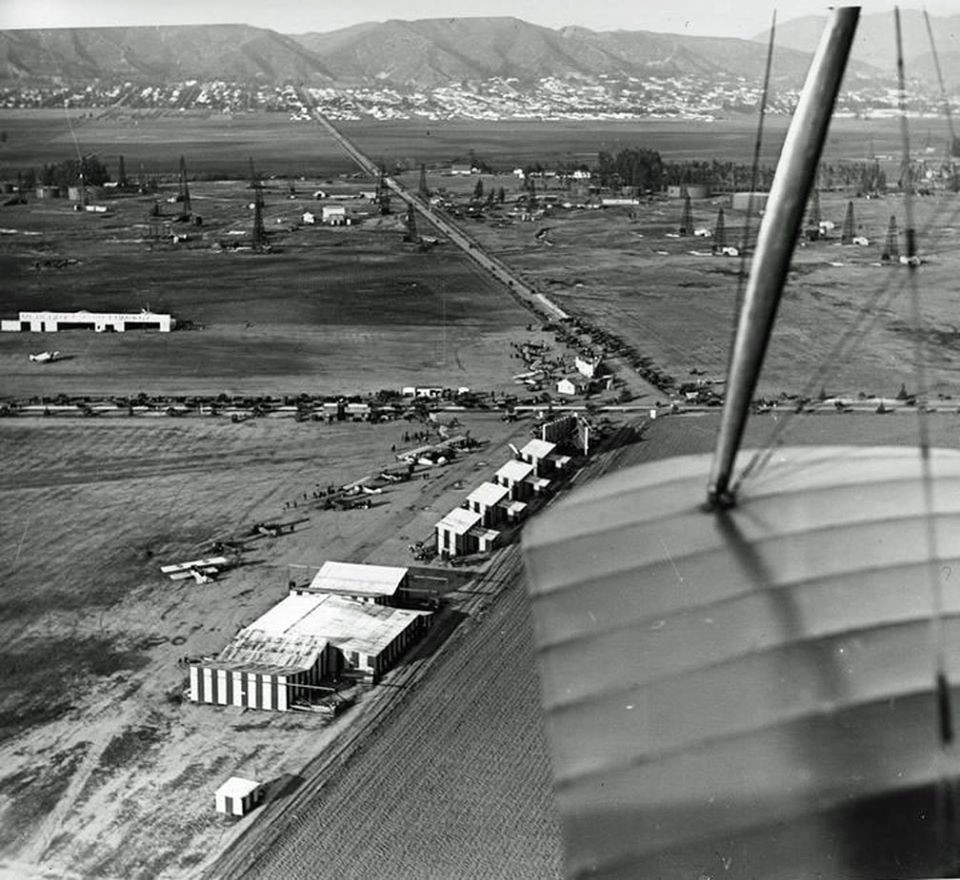 |
|
| (ca. 1922)^ - View looking north over the wing of a bi-plane showing the intersection of Crescent Ave (Fairfax) and Wilshire Blvd. A crowded airfield (now Rogers Airfield) is seen below. In the distance oil derricks are seen at Fairfax Avenue where 6th Street is located today. In the far background, at the foothills, can be seen a built-up Hollywood. |
Historical Notes By 1922 both Chaplin Airfield (S/W corner) and De Mille Field No. 2 (N/W corner) would be owned by Emery H. Rogers, owner of Rogers Aircraft Inc. They would be part of Rogers Airfield which straddled Wislhire Boulevard west of Farifax Avenue. |
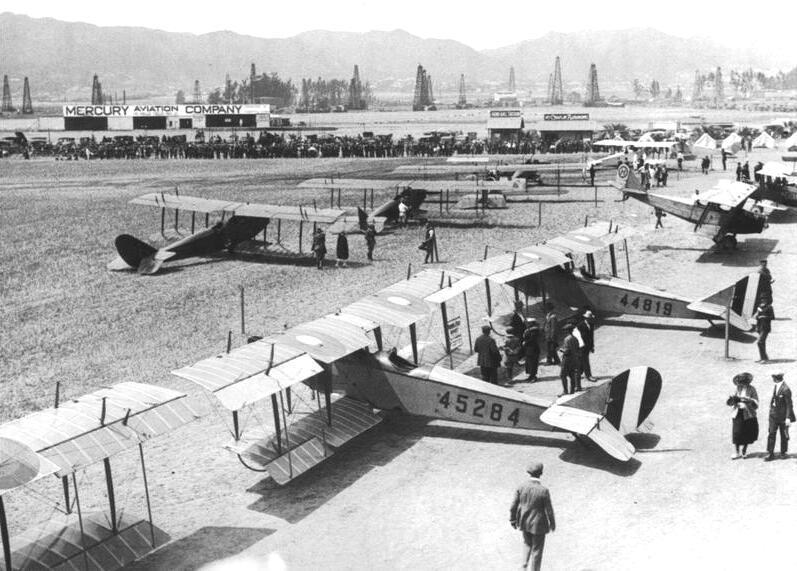 |
|
| (ca. 1922)^ - Ground view of Rogers Airfield (previously Chaplin Field) on the southwest corner of Fairfax and Wilshire. The Mercury Aviation Company sign can be seen on a hangar on the north side of Wilshire Boulevard at the DeMille Airfield No. 2., which would also become part of Rogers Airfield in 1922. |
Historical Notes Rogers Field was touted as the largest airfield in the west and continued in operation for about ten years. Rogers offered free use of the field to the City of Los Angeles as a municipal airport, but the surrounding real estate was rapidly becoming too valuable. |
 |
|
| (1922)*# - View looking west over Wilshire Boulevard at Crescent Avenue (later Fairfax Ave). Rogers Airfield can be seen straddling Wilshire Blvd at center of photo. Crescent Ave (later Fairfax Ave) runs horizontally at bottom. The diagonal line (upper-left) are railroad tracks (today, San Vicente Boulevard). |
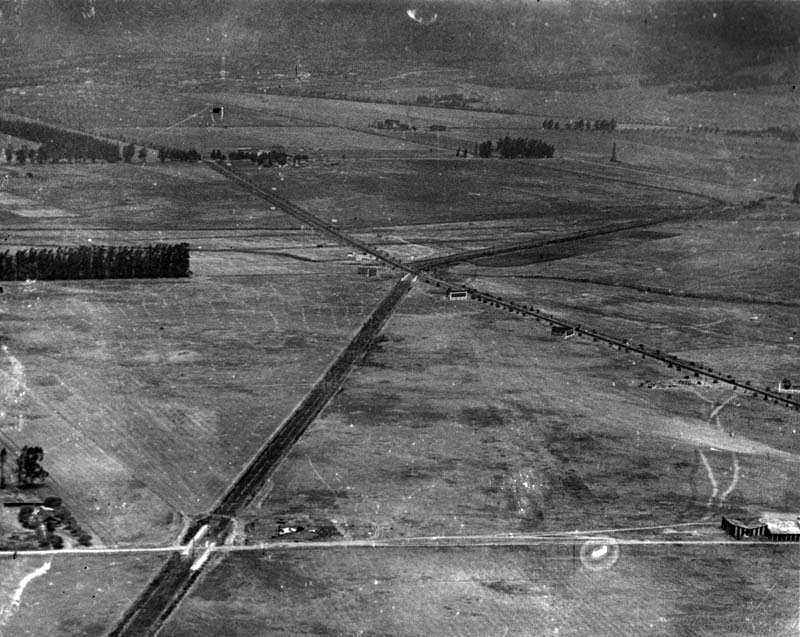 |
|
| (1922)* - Aerial view of Carthay Center, looking west across field of the first Rogers Airport at Wilshire Boulevard and Fairfax Avenue (lower right of photo). Wilshire Boulevard is the tree-lined street seen in the center of the image. The diagonal line running from lower left to upper right is the San Vicente line of the Pacific Electric Railway, later to become San Vicente Boulevard. |
Historical Notes In 1922, J. Harvey McCarthy developed an upscale residential district along the San Vicente Boulevard line of the Pacific Electric Railway, bounded by Wilshire Blvd. on the north, Fairfax Avenue on the east, Olympic Blvd. on the south and Schumacher Drive on the west. McCarthy originally named the district Carthay Center (Carthay being a derivative of the developer's last name). The areas to the south of Olympic Boulevard remained undeveloped until 1933, when developer Spyros George Ponty built several hundred homes in two districts later named "South Carthay" and "Carthay Square." *^ |
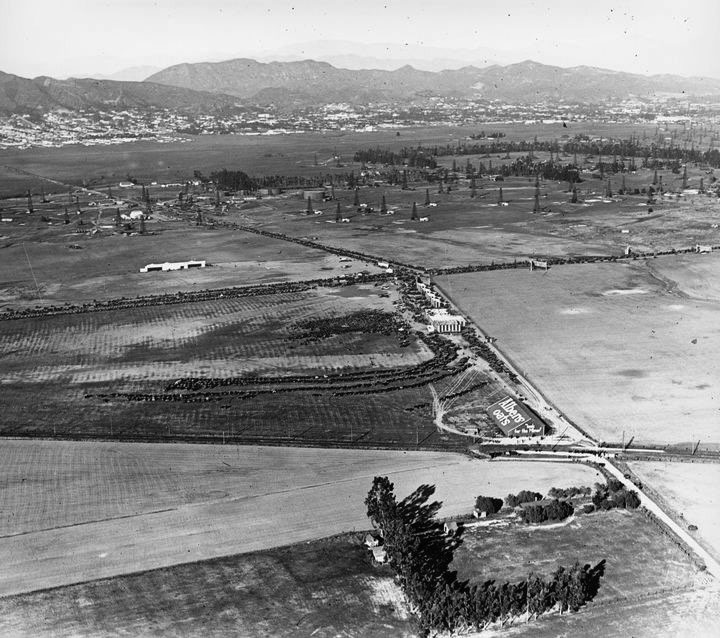 |
|
| (ca. 1922)^ - View looking north shows numerous cars parked on a lot (center of photo) near the Rogers Airfield as well as along Wilshire Blvd. and Crescent Ave (Fairfax). Large sign on building in the lower-right center at the intersection of Fairfax and the San Vicente line of the Pacific Electric Railway reads: Albers Oats. |
Arcadia Balloon School - Ross Field
.jpg) |
|
| (ca. 1918)^* - Photograph of a large airship being held down by men, perhaps at a military "balloon school" in Arcadia, ca.1918. Hovering several feet above the ground, the airship tilts toward the left slightly. Below it to the right, several people hold onto a rope connected to the ship, anchoring it. Behind the people are a series of barrack-like buildings. Beyond this, an arborous area can be seen, followed by the mountains in the distance. |
Historical Notes Opened in 1918, the Arcadia Balloon School was built to train U.S. Army balloon observation troops for World War I. Before any graduates arrived in Europe, the war ended.^^# |
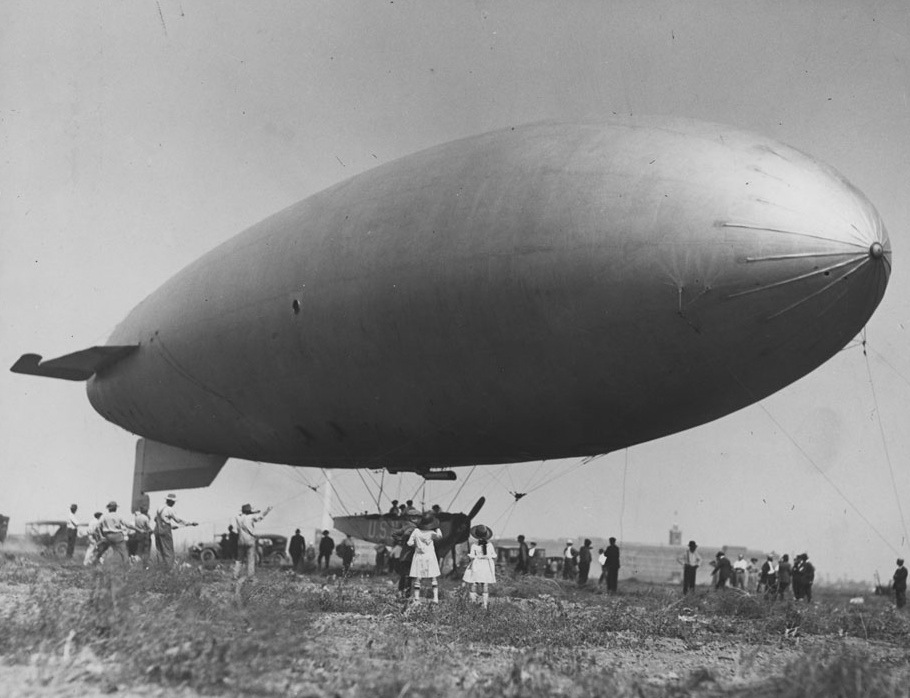 |
|
| (ca. 1918)^* - View of a large airship being held down by cables as spectators surround it at a "balloon school" in Arcadia. The aircraft hovers slightly above the ground, pointing right, with several passengers on board. A crowd of spectators gathers around the craft, and two young girls in light-colored dresses and bonnets stand in the foreground. Several men on the left pull a cable to keep the ship on the ground. A structure is visible in the distance, while the foreground is composed of a grassy field. The background is neutral. |
Historical Notes In November 1918, the base was renamed Ross Field, honoring Lt. Cleo J. Ross of the U.S. Army 8th Balloon Company, killed in action in France. U.S. Army balloon operations continued at Ross Field for a few years, but by the mid-1920s, the base was closed. Today it’s the site of Arcadia County Park and Golf Course.^^# |
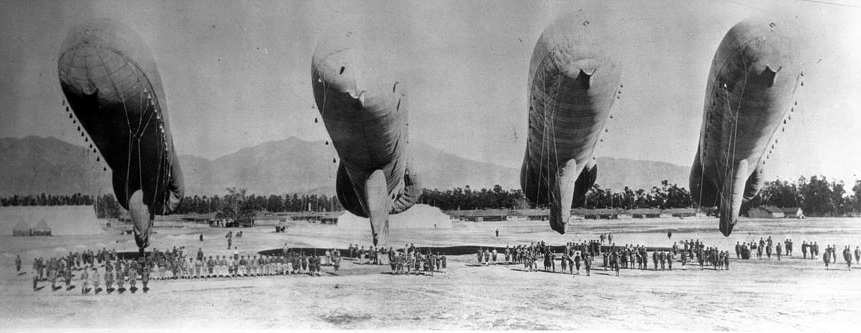 |
|
| (ca. 1918)^* - Panoramic view showing four dirigibles at the balloon school in Arcadia. The four large airships are floating low to the ground and are tethered down by large ropes. Uniformed soldiers can be seen on the ground beneath the large balloons. In the background, a line of tall trees stretches across the image, while tall mountains can be seen further in the distance. |
 |
|
| (1921)^^# - Three U.S. Army balloons prepare for launch from Ross Field. |
Brand Field (Glendale)
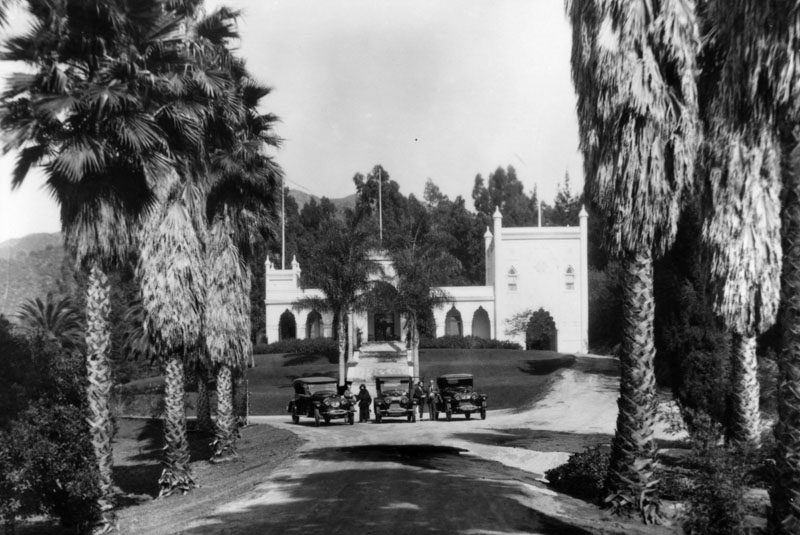 |
|
| (ca. 1920)* - View of El Miradero and estate grounds, once home to Leslie C. Brand. Three vehicles are seen parked next to one another where the driveway and path to the front door meet. Brand built an airfield on his property to fly in guests for his elaborate partys. |
Historical Notes Born in Missouri in 1859, Leslie Coombs Brand became the sole provider for his family at age 11. In 1886, Brand came to California to take advantage of its first boom period. Brand was a major figure in the settlement and economic growth of the Glendale area. He had purchased land on the lower slopes of Mount Verdugo overlooking the city, and in 1904 built an imposing residence that became known as Brand Castle (aka El Miradero), which today houses the Brand Library. He also built his own private airfield.*^ |
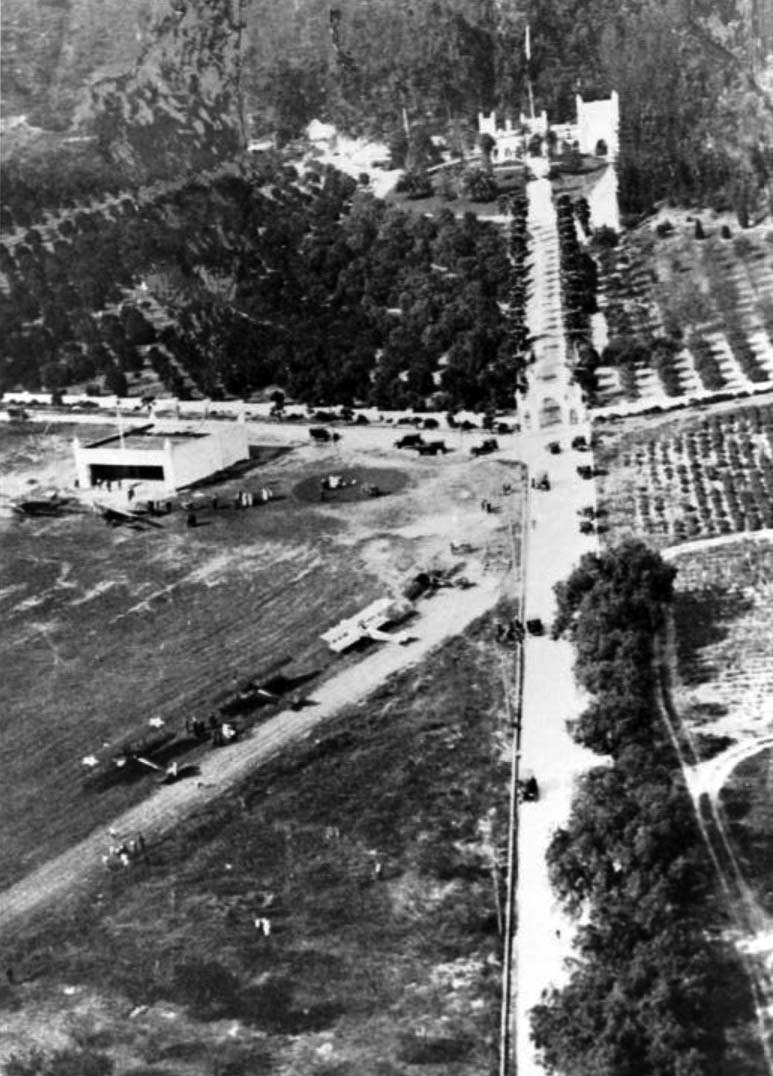 |
|
| (1921)^ - An aerial view of L. C. Brand's airfield in front of his home, El Miradero in Glendale. The airplanes took off downhill toward Kenneth Road. |
Historical Notes Brand established a grassy, well-manicured airfield in front of the mansion. The airfield consisted of a 1,200' rolled dirt runway, with a white hangar at one end and a putting green on the other. The hangar matched the architectural style of the mansion - with turrets atop each of the 4 corners.*# |
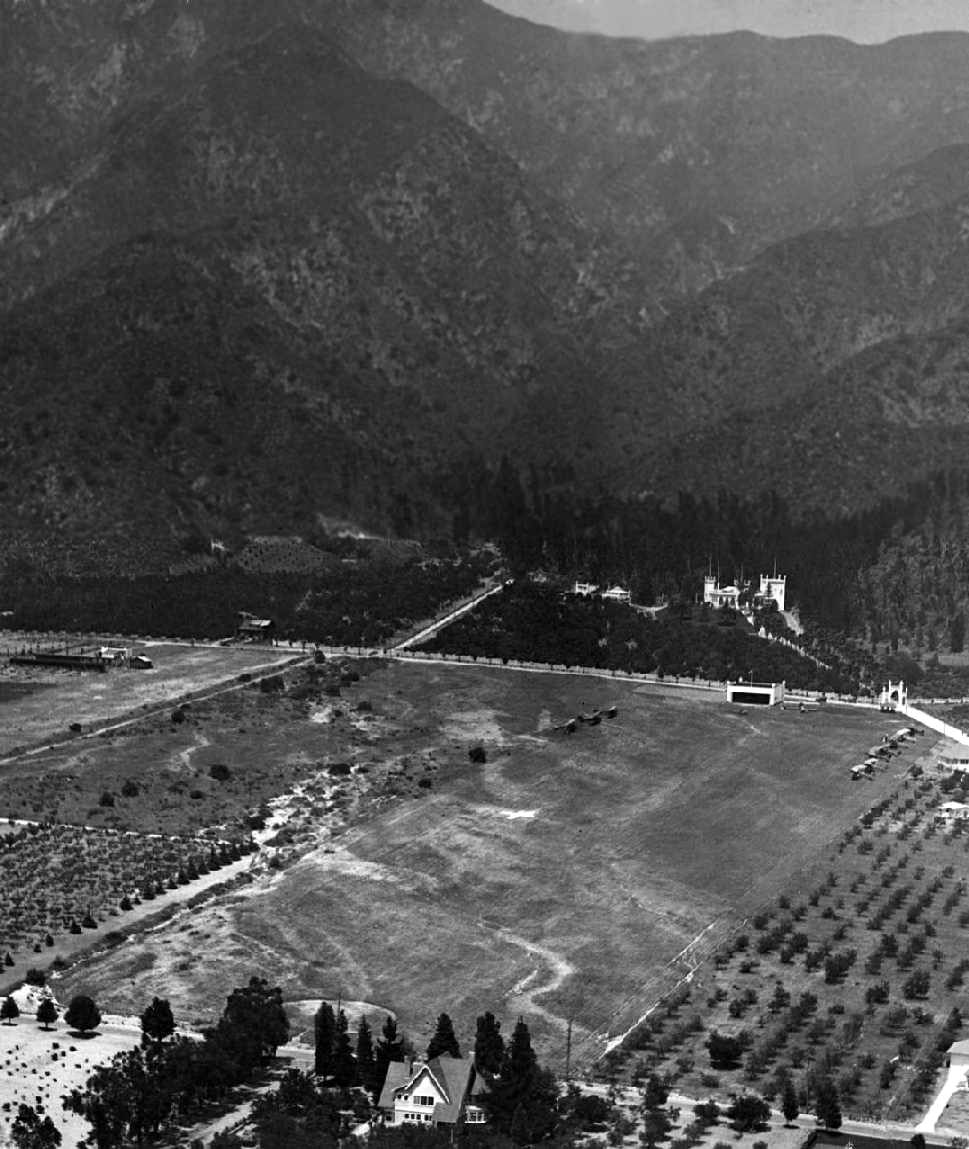 |
|
| 1923)*# – Aerial view looking north at Brand Field, showing the hangar and 10 aircraft on the field, and the mansion across the street. Note the steep terrain – obviously takeoffs to the north wouldn't be advisable. |
Historical Notes Only 3 aircraft are known to have been actually based at Brand Field. However, Brand apparently bought many war surplus Jennies, some to tinker with and fly as a sport, although most languished in storage buildings.*# |
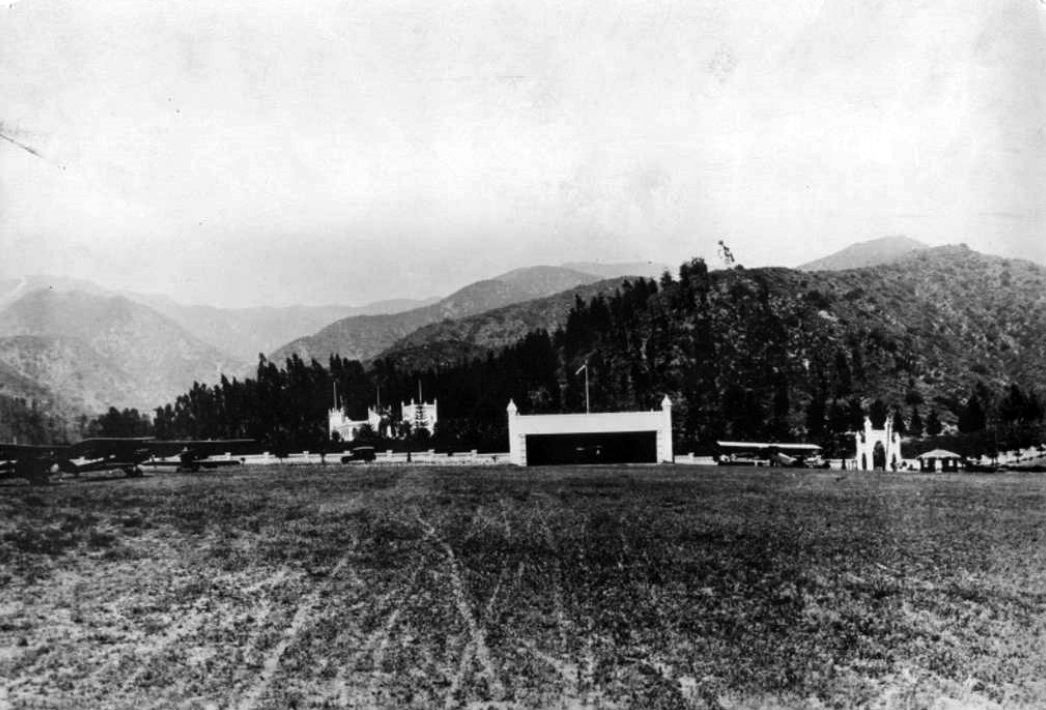 |
|
| (ca. 1920s)^**^ – View of Brand Airfield from ground level. Both the Moorish-style mansion and hangar can be seen in the distance. |
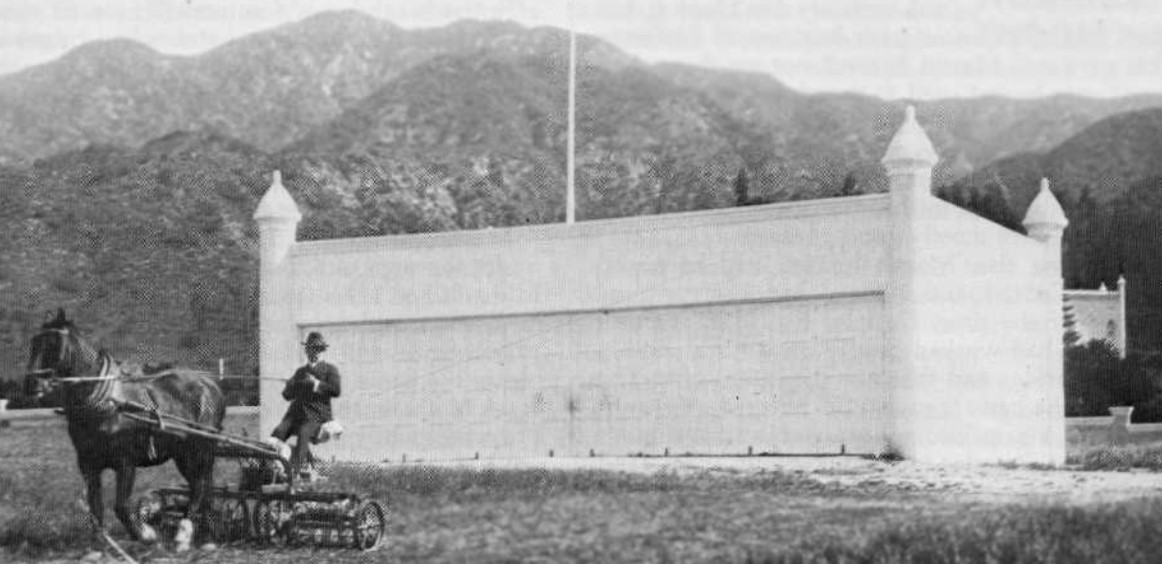 |
|
| (ca. 1920s)*# – View of millionaire Leslie C. Brand mowing the lawn in front of the Moorish-style hangar at his private Airfield. |
Historical Notes Brand built his first hangar in 1916 and put together a fleet of planes, and held fly-in parties. The only requirement was that guests had to arrive in their own planes and bring passengers.*^ |
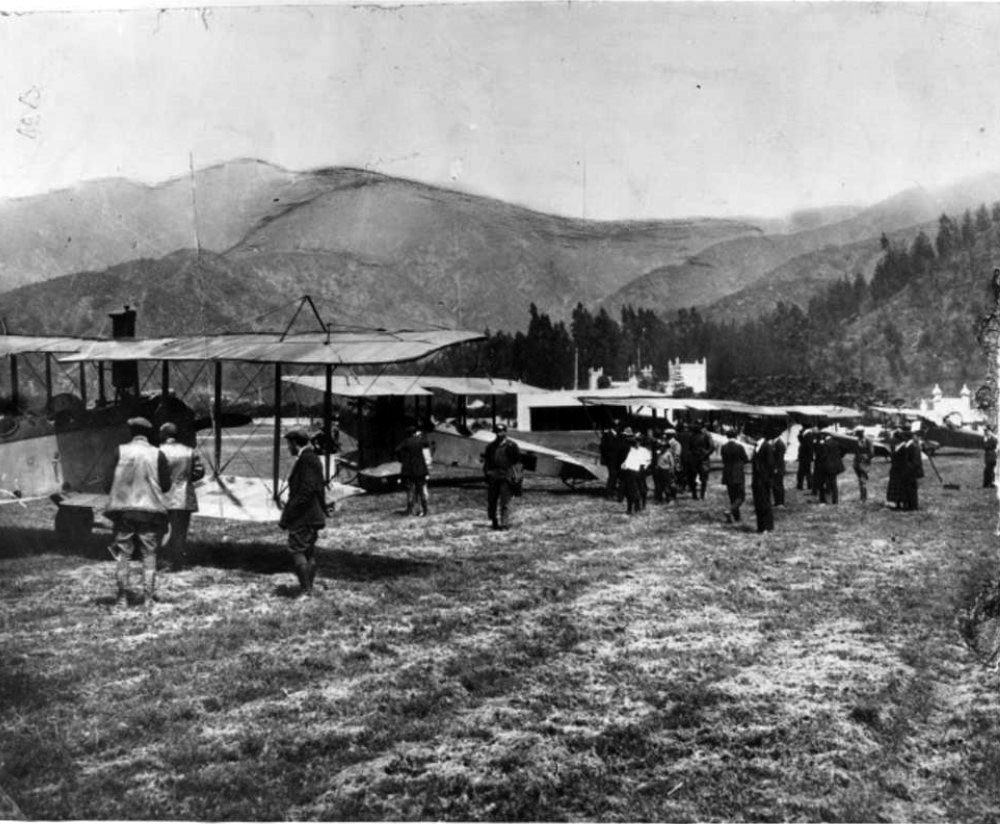 |
|
| (1921)^**^ – Several airplanes and guests arriving at Brand's fly-in luncheon party on April 1, 1921. El Miradero Mansion is seen in the background. |
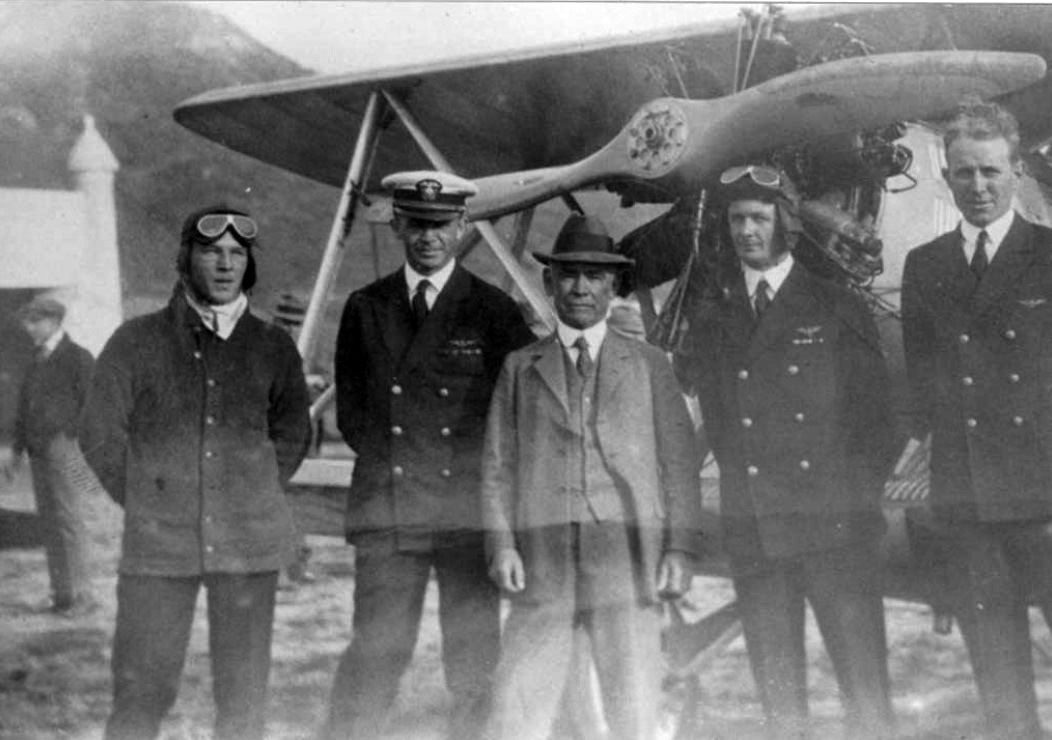 |
|
| (1921)^**^ – View of Leslie C. Brand and pilots at fly-in party. |
Historical Notes Leslie C. Brand helped develop the city of Glendale. Together with Henry E. Huntington, he brought Pacific Electric to the town to develop it. The 'Brand Library' section of the Glendale Public Library is named in his honor. Brand Boulevard in Glendale is also named in his honor.*^ |
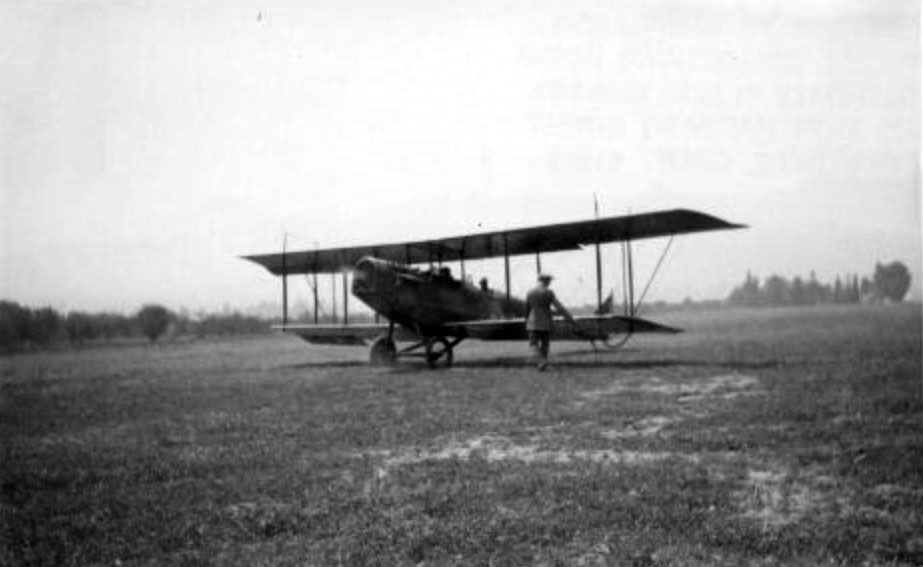 |
|
| (1921)^**^ – View of Leslie C. Brand is his plane preparing to take off at Brand Airfield. |
Historical Notes Brand Field was no longer depicted on a 1931 street map, but “Brand Park” was depicted, so the airfield may have ceased operation by that point.*# |
Vail Field (Montebello)
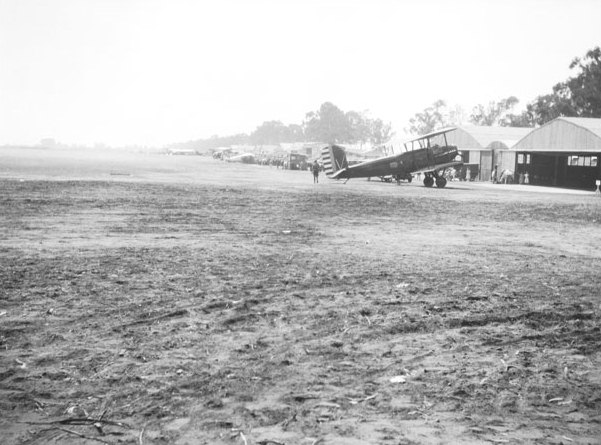 |
|
| (1926)^#* - Typically for its day, Vail Field featured unpaved runways. Unlike many of the smaller airfields, it did have hangars for storing planes, and it was used for some commercial flights. The hangars were basically gambrel-roofed barns with an open end. The smoothly curved Quonset roof seen on many hangars did not come about until World War II. |
Historical Notes Vail Field was historically important as one of the first airmail contractors. Western Air Express, had its origins there. Western Air Express was incorporated during 1926 by Los Angeles entrepreneurs for the purpose of bidding on airmail contracts to be awarded under the 1925 Kelly Air Mail Act which provided for the transfer of airmail routes from the Post Office's Aerial Mail Service to private carriers.*^ |
 |
|
| (1926)^* - Photograph of pilots readying an aircraft for the first air mail flight by Western Air Express, April 17, 1926. A line of four identical Douglass M-2 biplanes starts at center and extends into the distance at left. In front of the foremost plane, a group of men is standing near a pile of large mail sacks, and still more people are standing in front of a large mail truck at right. The truck is an early-model vehicle with a cargo area enclosed with wire. The ground is covered with rough grass. |
Historical Notes Western Air Express initially purchased six Santa Monica-built Douglas M-2 mail planes. They also purchased land to build the airport from some well-known cattle ranchers, the Vail brothers.*^ |
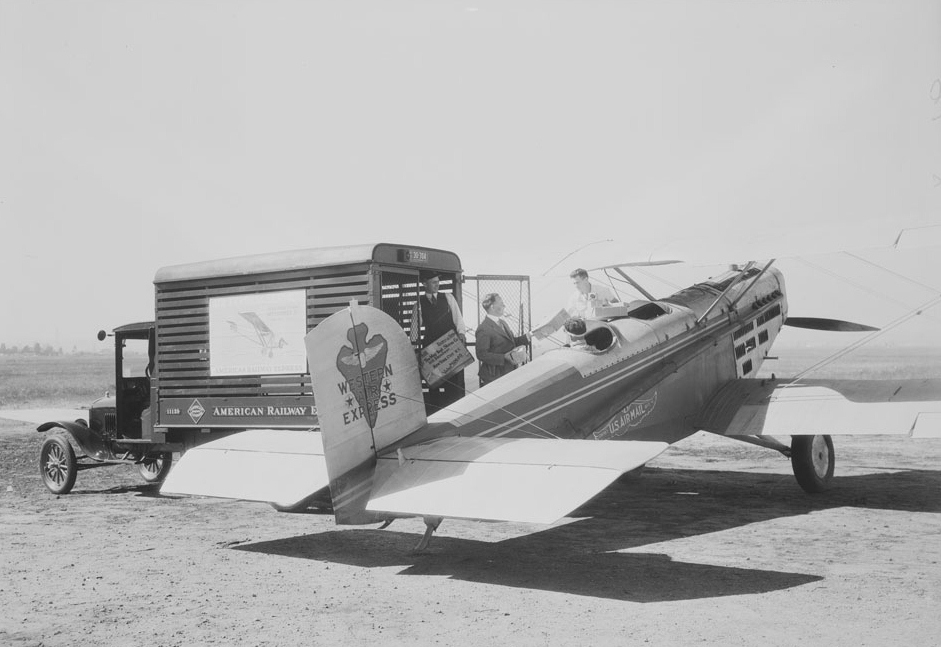 |
|
| (1927)^* - Photograph of the Inauguration of the Air Express Service of the American Railway Express Company at Vail Field, August 31, 1927. Two men in suits stand at the back of the truck at center with packages to be transferred to the pilot, Maurice Graham. The small plane stands at right with "Western Air Express" printed on its back side. The air field lies in the background. |
* * * * * |
Venice Aero Police
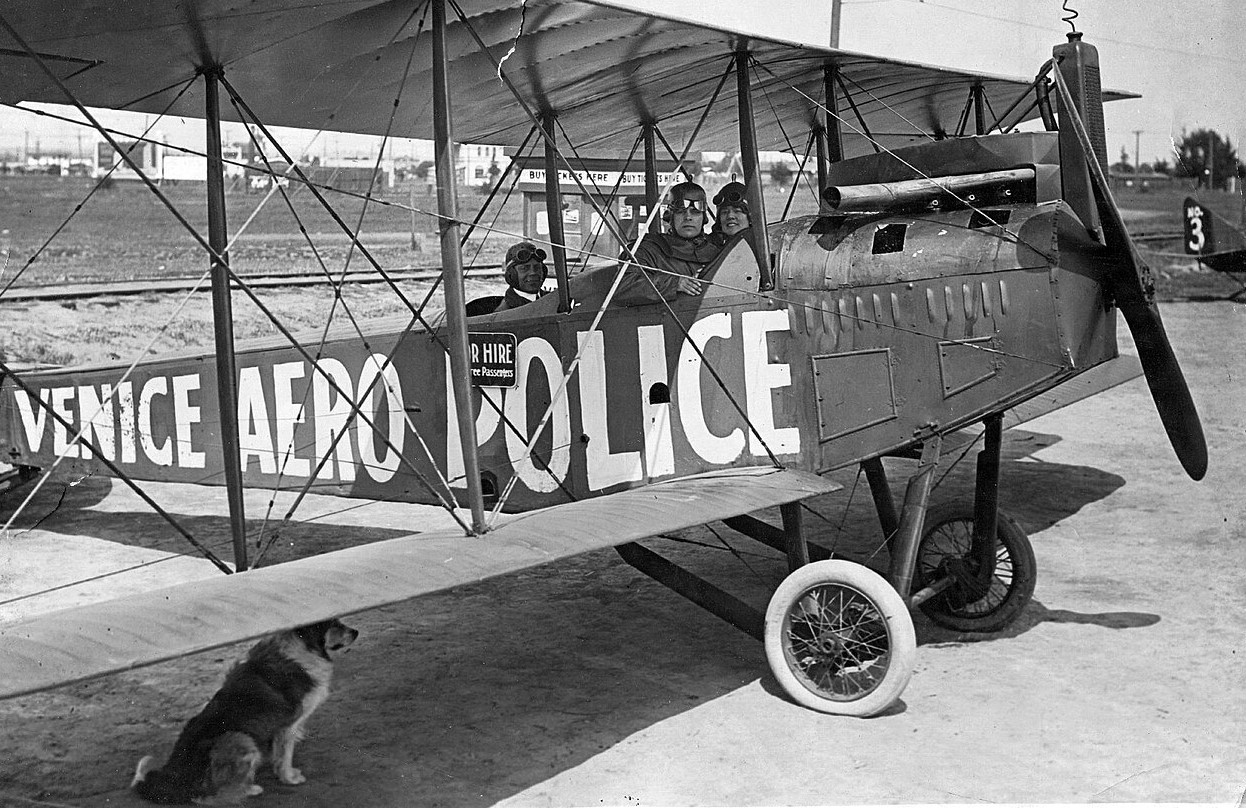 |
|
| (1919)* – A view of a four-seat biplane with Venice Aero Police markings at Ince Airfield in Venice, California. Otto “Swede” Meyerhofer is at the controls, with two passengers onboard. Note the dog under the wing. Photo courtesy of the San Diego Air and Space Museum via Wikipedia. |
Historical Notes On April 3, 1919, Venice, California, launched the first aerial police force in the United States by inducting aviator Otto Meyerhofer. His 100 MPH biplane prominently displayed the words "Venice Aero Police" on its side. Meyerhofer's primary duties included tracking fleeing automobile bandits and locating boats in distress from the air, allowing for quick and efficient responses. Initially known as Ince Field, the airport was established in the early 1900s by Thomas Ince as a base for stunt pilots and movie work. It was renamed Delay Field in 1920 after aviator B.H. DeLay took over its operations. The airport closed in 1923 due to its short runway and lack of expansion space, being surrounded by residential neighborhoods. Larger airports nearby, such as Santa Monica's Clover Field and Los Angeles' Mines Field (now LAX), met the region’s aviation needs. Later that year, the land where Delay Field once stood was subdivided. The Venice Aero Police initiative was revolutionary, marking one of the first instances of aerial law enforcement worldwide. Although the program was short-lived, it set a precedent for the use of aircraft in policing. Today, modern law enforcement agencies globally use helicopters and other aircraft for surveillance, search and rescue, and rapid response, building on the legacy of early efforts like those in Venice. Note: The City of Venice was annexed by the City of Los Angeles on February 23, 1925. |
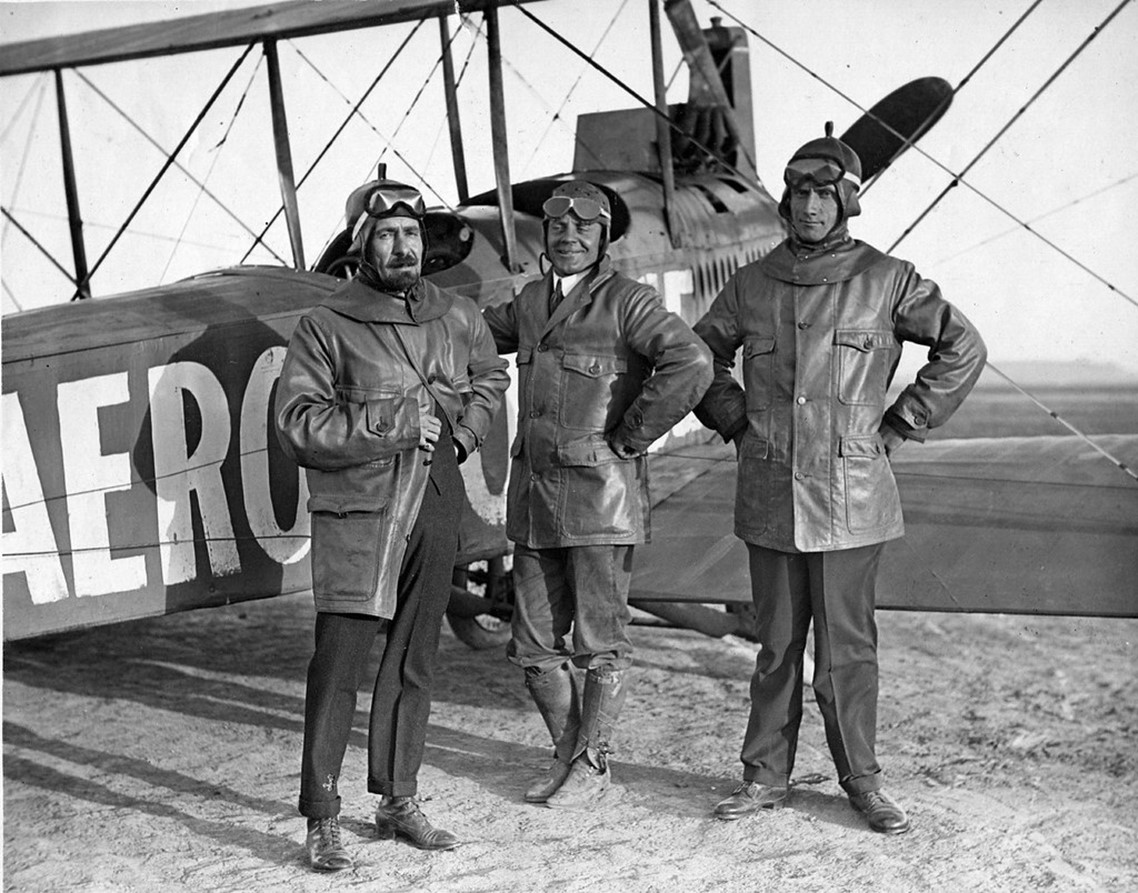 |
|
| (1919)* - Venice Aero Police with Deputy Meyerhofer in the middle. Photo courtesy of the San Diego Air and Space Museum |
Historical Notes Otto "Swede" Meyerhofer, a pioneering figure in early aviation law enforcement, was the first member of Venice, California's Aero Police, established in 1919. Sworn in on April 3, 1919, Meyerhofer's duties included chasing speeders, investigating smuggling, enforcing fishing regulations, and assisting in rescues. He piloted an 8-cylinder biplane marked "VENICE AERO POLICE," based at Ince Field, and though the unit served as a publicity tool for Venice, its effectiveness was limited by a lack of radio communication. Despite expansion to three more pilots by 1922, the Aero Police ended in 1923 when the airfield was sold and Venice was incorporated into Los Angeles in 1925. While it captured public imagination, its impact on crime-fighting was minimal, and Meyerhofer tragically died after being injured by a plane propeller. |
* * * * * |
Charles Lindbergh
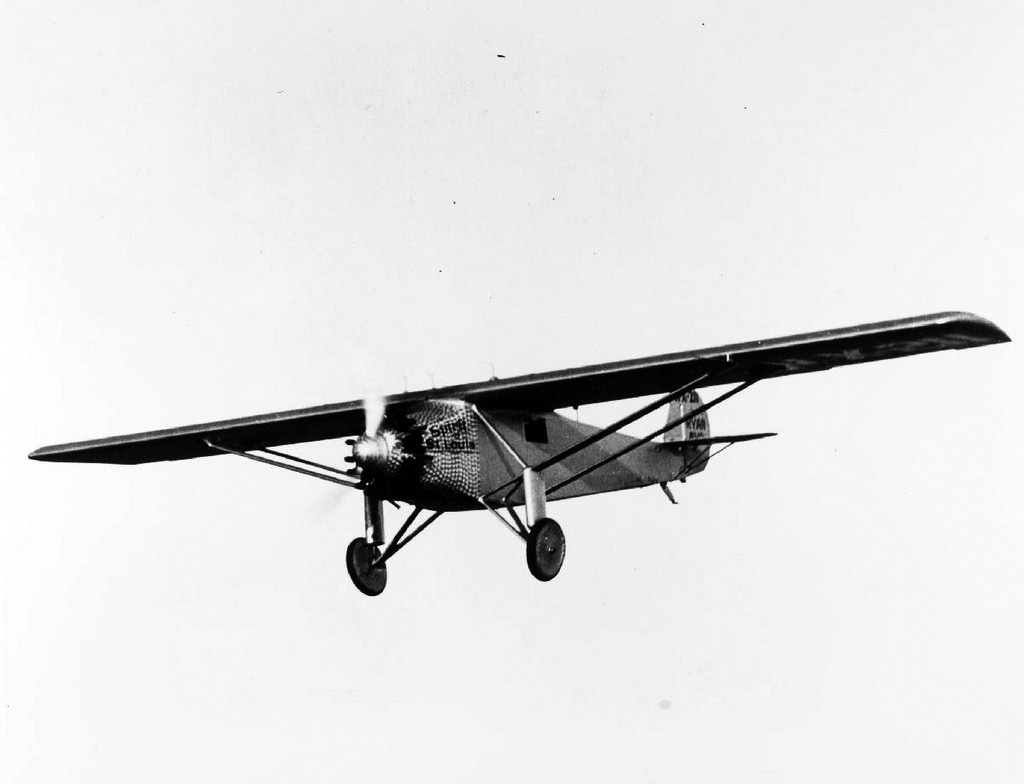 |
|
| (1927)* - Charles Lindbergh flying the Spirit of St. Louis on his tour of the U.S., September 1927. |
Historical Notes CIn 1927, Charles Lindbergh landed The Spirit of St. Louis at the Vail Field while on a nationwide tour following his transatlantic flight (May 21, 1927). The Spirit of St. Louis was powered by a Wright Whirlwind J-5C 223-hp radial engine, and had a 46-foot wingspan. |
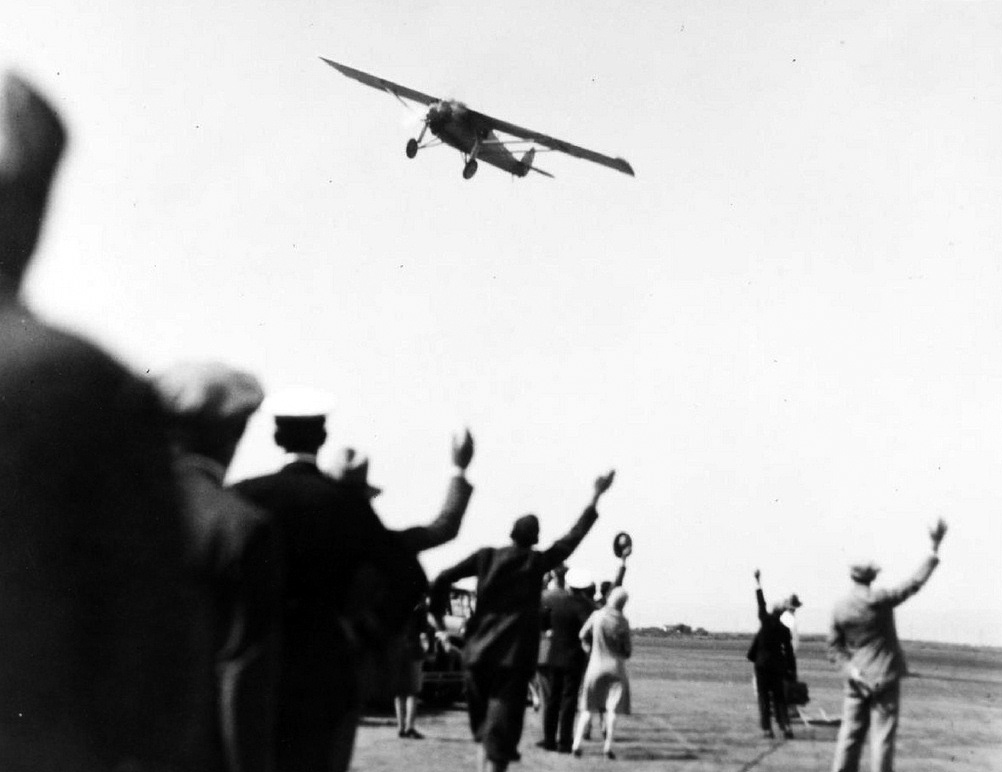 |
|
| (1927)* - Charles Lindbergh in his Spirit of Saint Louis preparing to land as spectators waive. |
Historical Notes On June 1st, 1927, the U.S Post Office issued a commemorative 10-cent "Lindbergh Air Mail" stamp depicting the Spirit over a map of its flight from New York to Paris, and which was also the first stamp issued by the post office that bore the name of a living person. |
 |
|
| (1927)* – The Spirit of St. Louis comes to a rest at Vail Field, Montebello. Charles Lindbergh and Spirit of St. Louis visited Vail Field (near East Los Angeles, Commerce, and Montebello). |
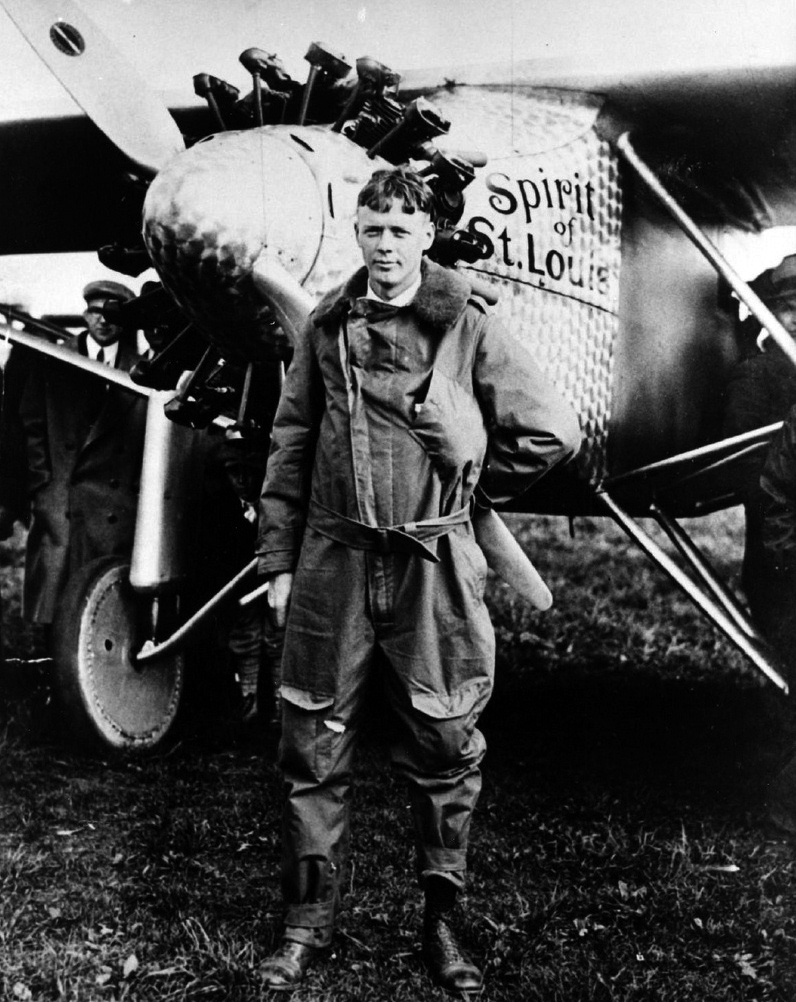 |
|
| (1927)* - Charles Lindbergh in front of the Spirit of St. Louis. |
Historical Notes Charles Augustus Lindbergh (1902-1974), an Army reserve officer and U.S. Air Mail pilot gained instant world fame when on May 21, 1927, he flew solo on a non-stop flight from Roosevelt Field on Long Island to Le Bourget Field in Paris in the single-seat, single-engine monoplane named the "Spirit of St. Louis". Because of this historic exploit, Lindbergh - nicknamed "Lucky Lindy" and "The Lone Eagle", was awarded the Medal of Honor, the nation's highest military decoration. In his later years, Charles Lindbergh became a prize-winning author, international explorer, inventor, and active environmentalist. Lindbergh's New York-to-Paris flight made him an instant celebrity and media star. In winning the Orteig Prize, Lindbergh stirred the public's imagination. He wrote: "I was astonished at the effect my successful landing in France had on the nations of the world. It was like a match lighting a bonfire." |
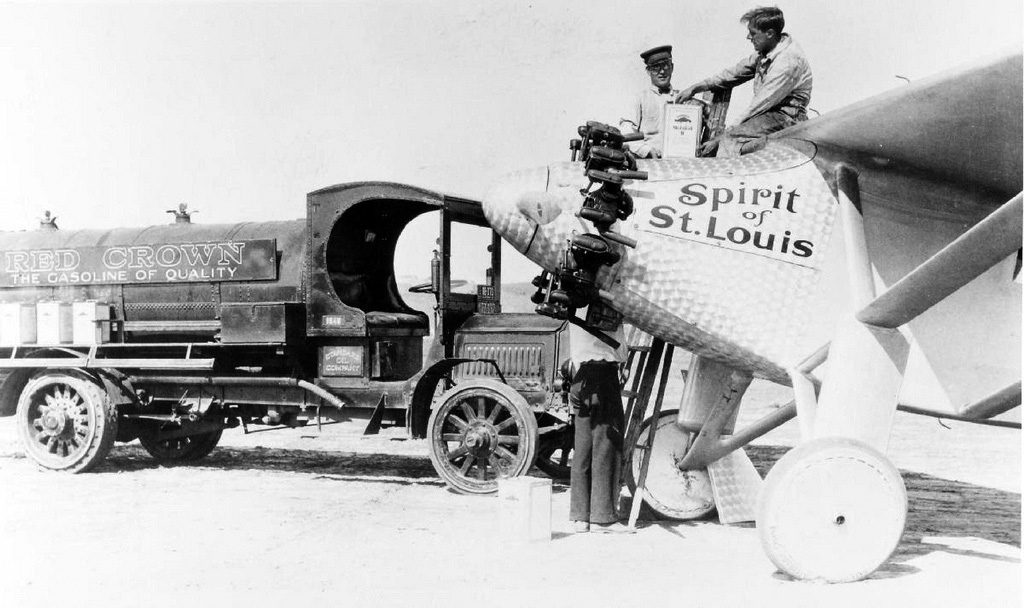 |
|
| (1927)* - Three men are in the process of fueling the Spirit of St. Louis. |
Historical Notes The Spirit of St. Louis had a fuel capacity of 450 U.S. gallons or 2,385 pounds which was necessary in order to have the range to make the transatlantic non-stop flight. The large main fuel tank was placed in the forward section of the fuselage, in front of the pilot, which improved the center of gravity. While locating fuel tanks at the front reduced the risk of the pilot's being crushed to death in the event of a crash, this design decision also meant that there could be no front windshield, and that forward visibility would be limited to side windows only. A periscope was installed to provide a forward view, as a precaution against hitting ship masts, trees, or structures while flying at low altitude. Lindbergh also used special navigation instruments such as the Earth Inductor Compass as its main instrument, allowing Lindbergh to navigate while taking account of the magnetic declination of the earth. |
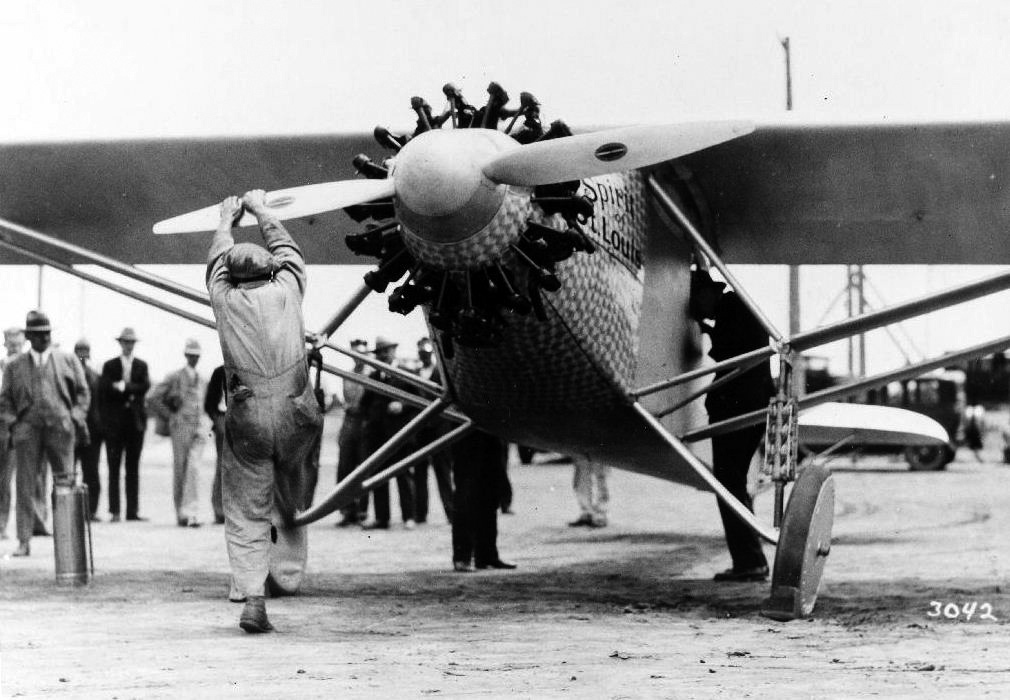 |
|
| (1927)* - Mechanic priming propeller of the Spirit of St. Louis as Charles Lindbergh prepares to take off to continue his goodwill tour. |
Historical Notes After his historic May 1st, 1927 transatlantic flight, Lindbergh flew the Spirit on promotional and goodwill tours across the United States and Latin America for over 10 months. |
 |
|
| (1926)* - Typically for its day, Vail Field featured unpaved runways. Unlike many of the smaller airfields, it did have hangars for storing planes, and it was used for some commercial flights. The hangars were basically gambrel-roofed barns with an open end. The smoothly curved Quonset roof seen on many hangars did not come about until World War II. |
Historical Notes Vail Field was historically important as one of the first airmail contractors. Western Air Express, had its origins there. Western Air Express was incorporated during 1926 by Los Angeles entrepreneurs for the purpose of bidding on airmail contracts to be awarded under the 1925 Kelly Air Mail Act which provided for the transfer of airmail routes from the Post Office's Aerial Mail Service to private carriers. |
 |
|
| (1926)* - Photograph of pilots readying an aircraft for the first air mail flight by Western Air Express, April 17, 1926. A line of four identical Douglass M-2 biplanes starts at center and extends into the distance at left. In front of the foremost plane, a group of men is standing near a pile of large mail sacks, and still more people are standing in front of a large mail truck at right. The truck is an early-model vehicle with a cargo area enclosed with wire. The ground is covered with rough grass. |
Historical Notes Western Air Express initially purchased six Santa Monica-built Douglas M-2 mail planes. They also purchased land to build the airport from some well-known cattle ranchers, the Vail brothers. |
 |
|
| (1927)* - Photograph of the Inauguration of the Air Express Service of the American Railway Express Company at Vail Field, August 31, 1927. Two men in suits stand at the back of the truck at center with packages to be transferred to the pilot, Maurice Graham. The small plane stands at right with "Western Air Express" printed on its back side. The air field lies in the background. |
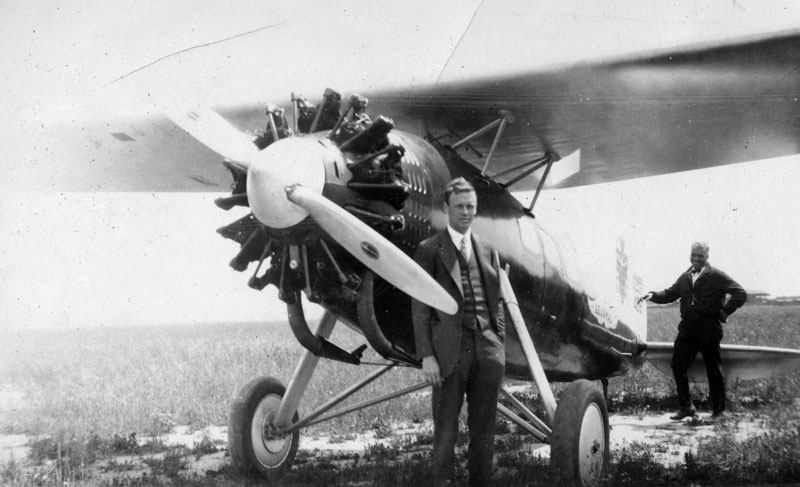 |
|
| (1928)* - Charles Lindbergh and an unidentified man stand next to a Lockheed Air Express at Vail Field in Montebello. |
Historical Notes The plane as seen above was the second aircraft designed and created by the Lockheed Aircraft Company after its founding in 1927. The design of the Air Express was based on the original fuselage of the Lockheed Vega, but the wing was raised to a parasol configuration above the fuselage and the cockpit was moved to behind the wing. Only seven Air Express planes were built. |
 |
|
| (1928)* - Lone Eagle CM-1 first flight at Vail Field Los Angeles, people gathered around. |
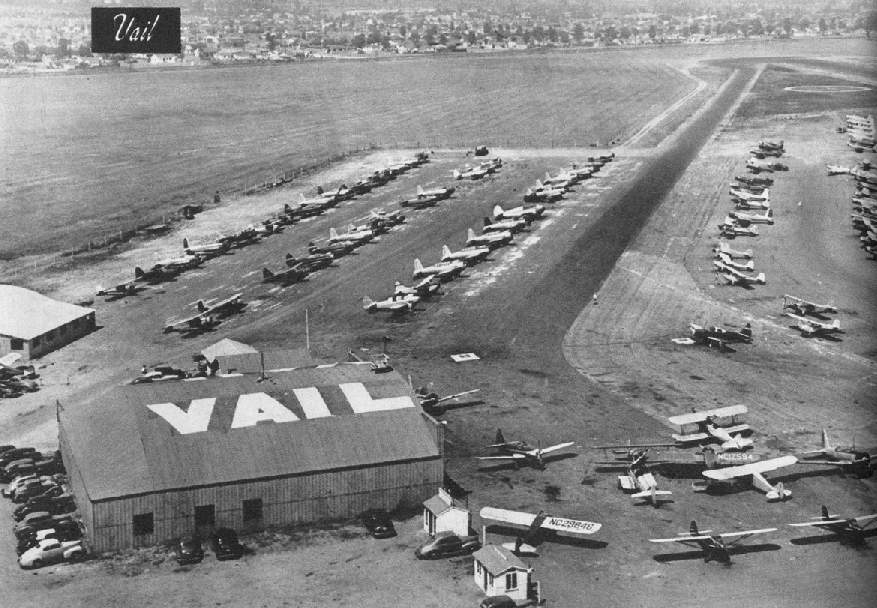 |
|
| (1947)* - Photo of Vail Airfield by Don Downie. The original caption reads, "Twenty-one A&E mechanics service the 220 planes based on this busiest airport in LA County. Seven miles east of the city, the port has a single 3,200' oiled runway no tower - and an air traffic problem. Tie-down is $15 monthly. Nearest transportation is 1/2 mile." |
Historical Notes Montebello’s Vail Field gave way to more lucrative uses as large tracts of open land became attractive as real estate investments. It was evidently closed at some point between 1950-53, as a 1953 aerial photo showed that Garfield Avenue had been extended through the property, with the runway and hangars having been cleared and replaced by new streets. |
* * * * * |
Alhambra Airfield
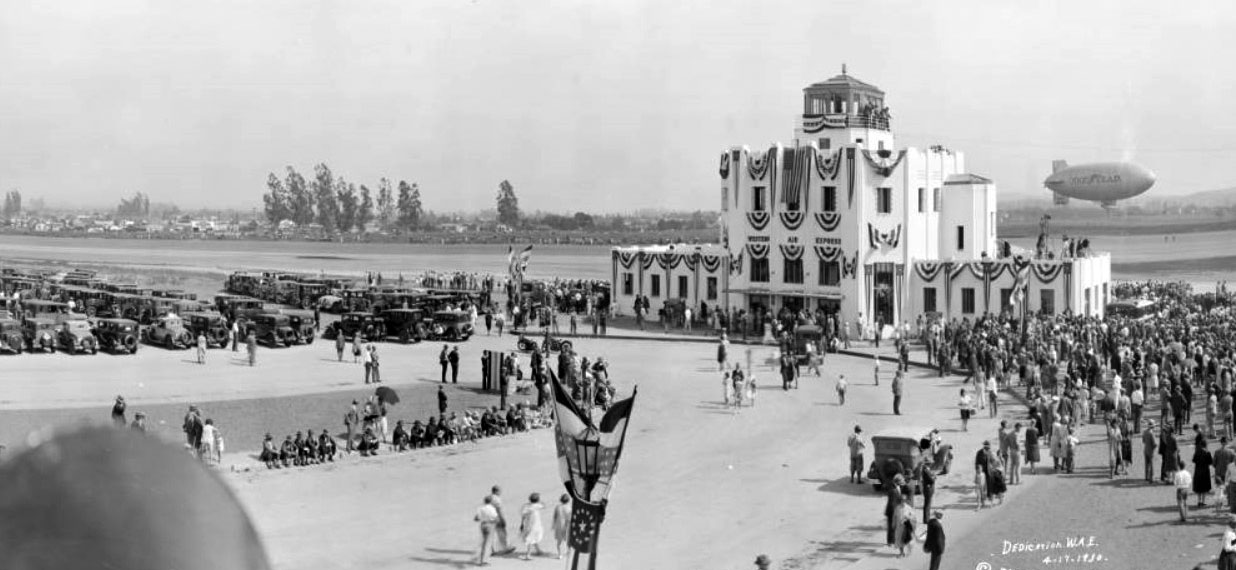 |
|
| (1930)* - Panoramic (left frame) view showing the dedication ceremonies of the new Western Air Express terminal at Alhambra Field on April 17, 1930. The Good Year blimp is in the background. |
Historical Notes The Alhambra Airport opened in April 1930, located south of Valley Blvd. between New Avenue and Almansor Street. Western Air (the forerunner of Western Airlines) built the terminal, the passenger terminal, and the largest airplane hanger in the world at that time. Western Air Express relocated from Vail Field to Alhambra Airport. |
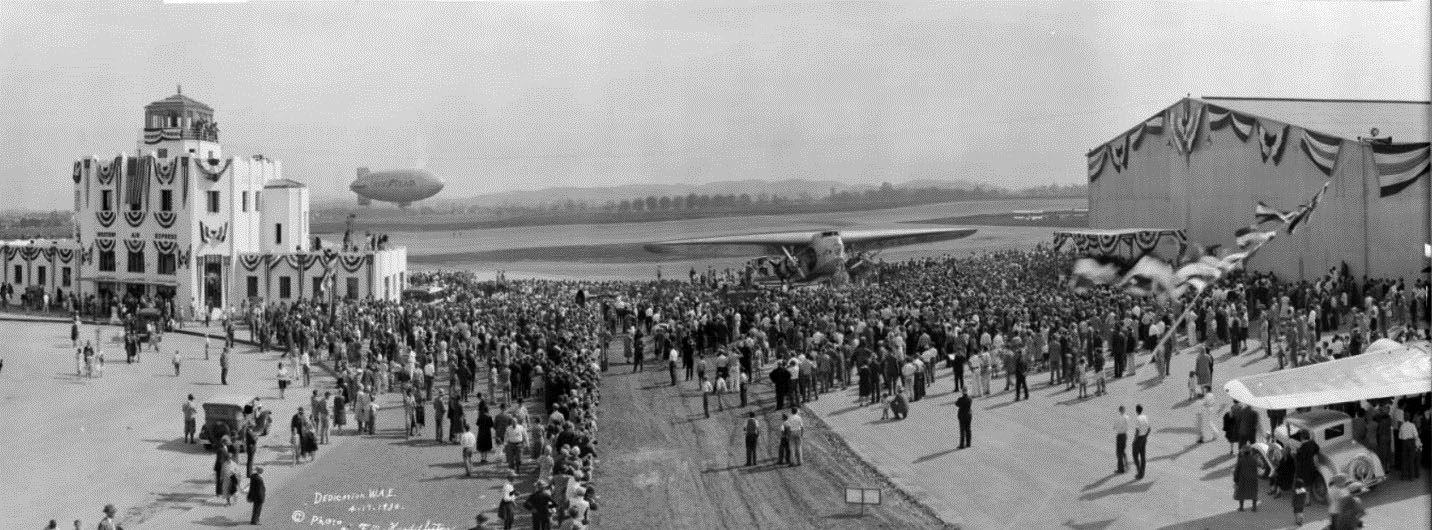 |
|
| (1930)* - Panoramic (right frame) view showing a crowd of about 10,000 at the dedication of Western Air Express terminal at Alhambra Field. The crowd is centered around the new 12-passenger Fokker transport plane just purchased by Western Air Express (later Western Airlines). The Good Year blimp can be seen in the background. Photo Date: April 17, 1930 |
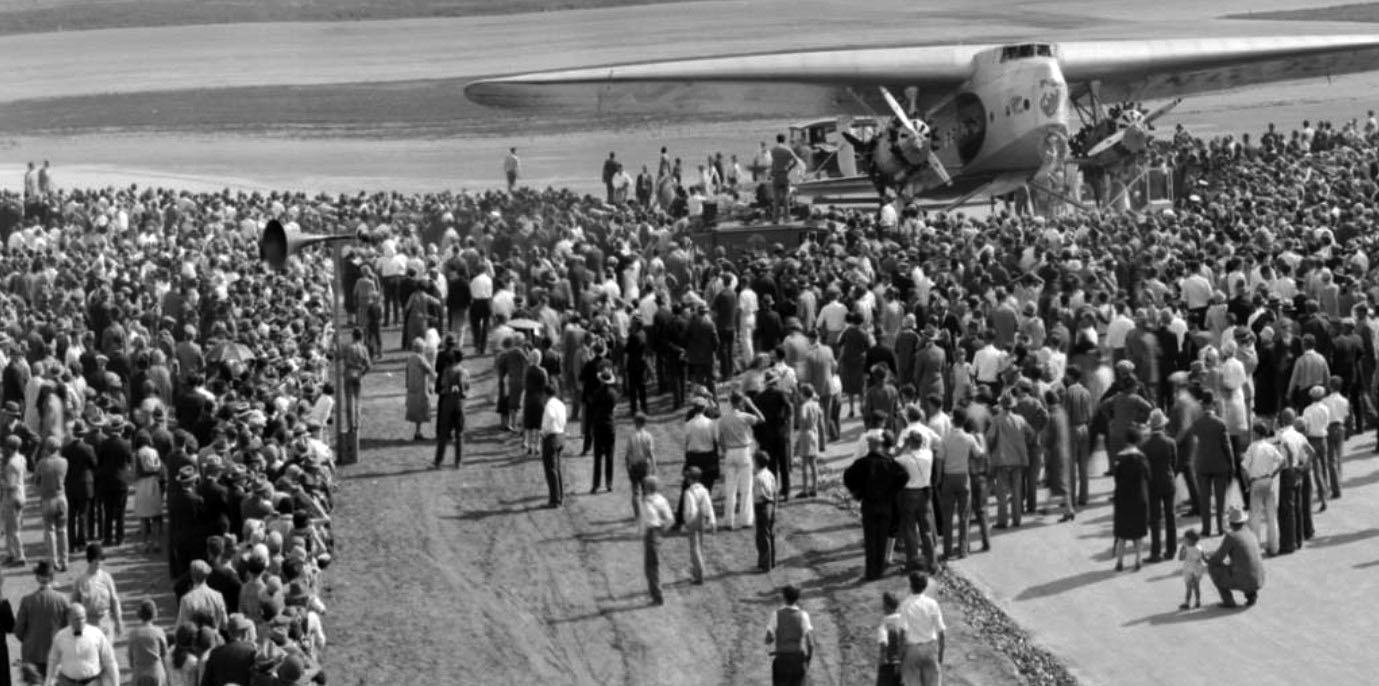 |
|
| (1930)* – Close-up view showing thousands of people around a Fokker F-32 aircraft at the Western Air Express terminal dedication. |
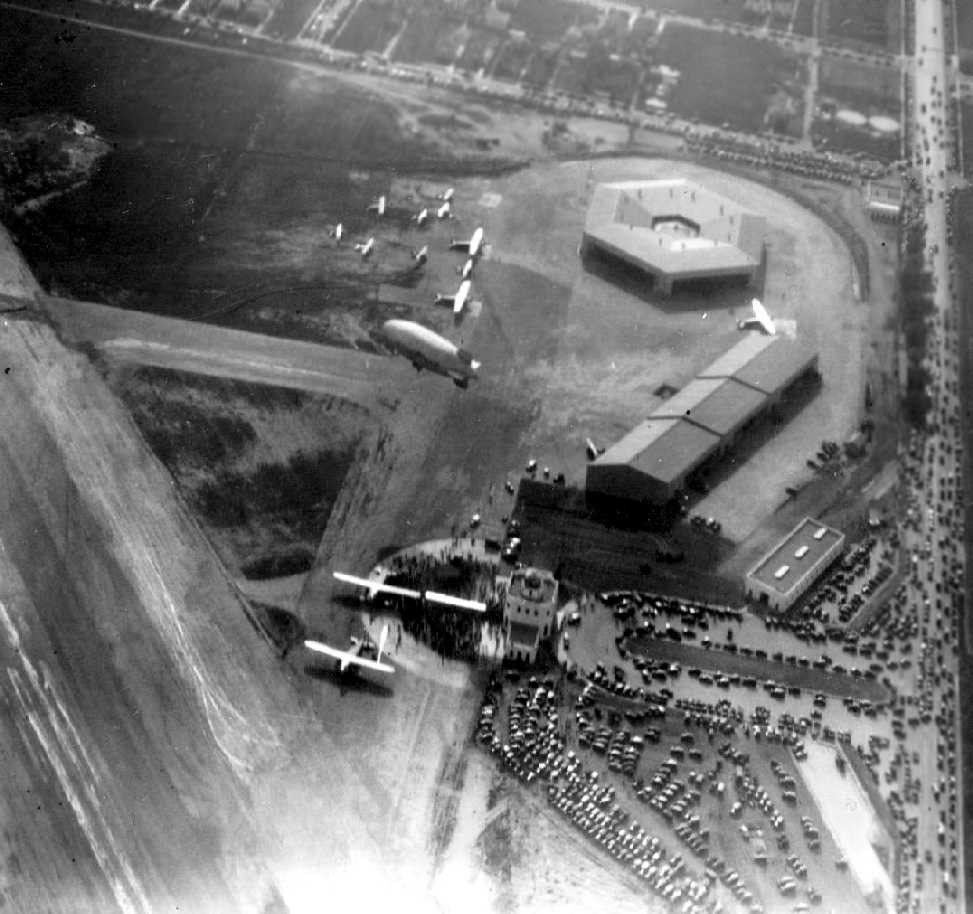 |
|
| (1930)* - Aerial view looking down at the Alhambra Airport during its opening dedication. The Good Year blimp is visible overflying the field at a lower altitude. Two large hangars are seen in the upper-right. One is hexagonal in shape. |
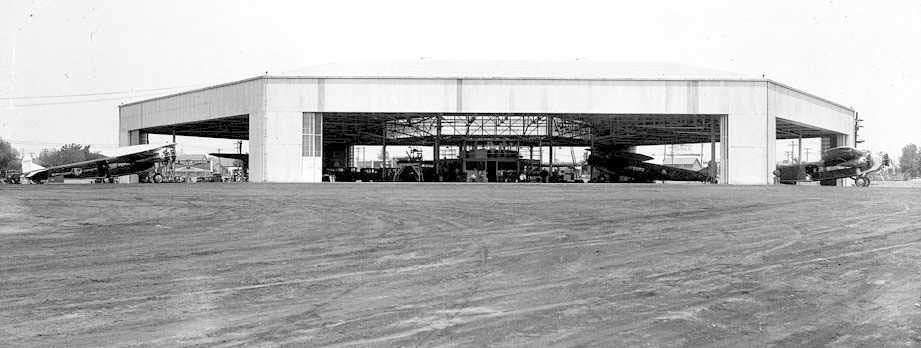 |
|
| (ca. 1930)* - View of Alhambra Airport’s Hexagonal hangar with four Tri-Motors outside and in. |
Historical Notes Western Air Express operated a fleet of six 12-passenger Fokker transports. Their large maintenance hangar was shaped like a hexagon, and had doors on each face so that all six aircraft could be worked on simultaneously, a unique feature. |
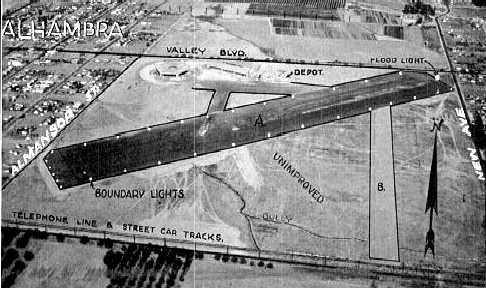 |
|
| (ca. 1930)* - Aerial annotated view of the Alhambra Airport looking north. The airfield configuration was a 2,700' oiled northeast-southwest runway, with 2 hangars in the northeast corner. |
Historical Notes The airport continued in operation until 1943 when the 157 acre property was put up for sale. The city of Alhambra took over the property the following year. In 1945, Harlow Aircraft Company purchased the airport from Western for $350,000 where they manufactured small airplanes. In 1946, Harlow sold off to real estate developers who subdivided the property, bringing an end to the airport. Western Air Express moved its operations to the Grand Central Air Terminal in Glendale. Western Air Express later became Western Airlines, ceasing to exist following its 1987 merger with Delta Air Lines. |
* * * * * |
Fokker F-10 Trimotor
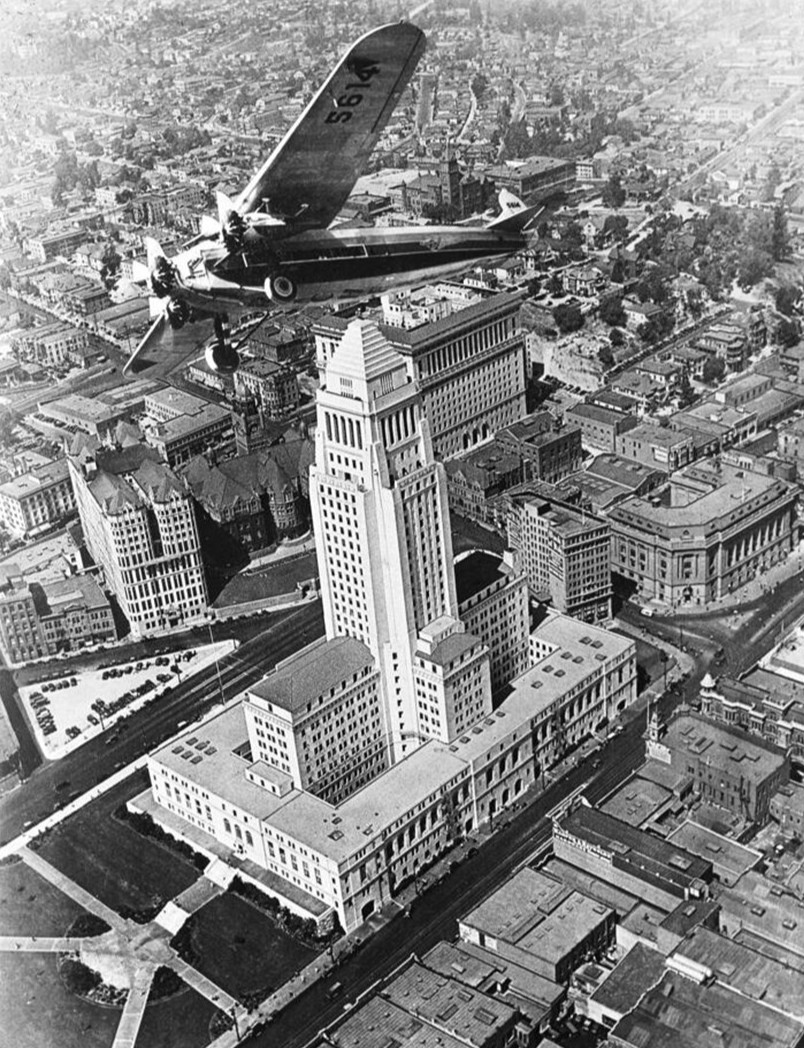 |
|
| (1929)* – Then and now views of the Los Angeles Civic Center taken from nearly the same vantage point above City Hall. Photo comparison by Jack Feldman. |
Historical Notes The Fokker F-10 Trimotor was among the most advanced airliners of its time and represented the optimism of aviation’s “Golden Age.” Built by the Fokker Aircraft Corporation of America, it was an enlarged version of the earlier F.VII, designed by Dutch aviation pioneer Anthony Fokker. The F-10 featured a metal-tube fuselage covered with fabric and wooden wings with internal plywood structures. Powered by three Wright J-6 Whirlwind radial engines, it could carry up to 12 passengers at speeds approaching 120 mph—fast for its day. Western Air Express, a Los Angeles–based carrier and forerunner of TWA, operated the F-10 on early West Coast passenger and mail routes, linking Los Angeles with San Francisco and other cities. The aircraft’s triple-engine configuration provided a reassuring margin of safety at a time when engine reliability was still a concern. The 1929 photograph, showing the F-10 banking dramatically over the newly completed Los Angeles City Hall, captured the spirit of progress that defined the era—symbolizing both the rise of air travel and the city’s emergence as a major urban center. Within two years, however, the tragic 1931 crash of a TWA F-10 near Bazaar, Kansas, which claimed the life of Notre Dame football coach Knute Rockne, exposed the vulnerability of its wooden wing structure and hastened the transition to all-metal aircraft designs. Even so, the Fokker Trimotor remains a landmark in commercial aviation, bridging the gap between pioneering mail planes and the modern airliners that would soon follow. |
* * * * * |
Fokker F-32
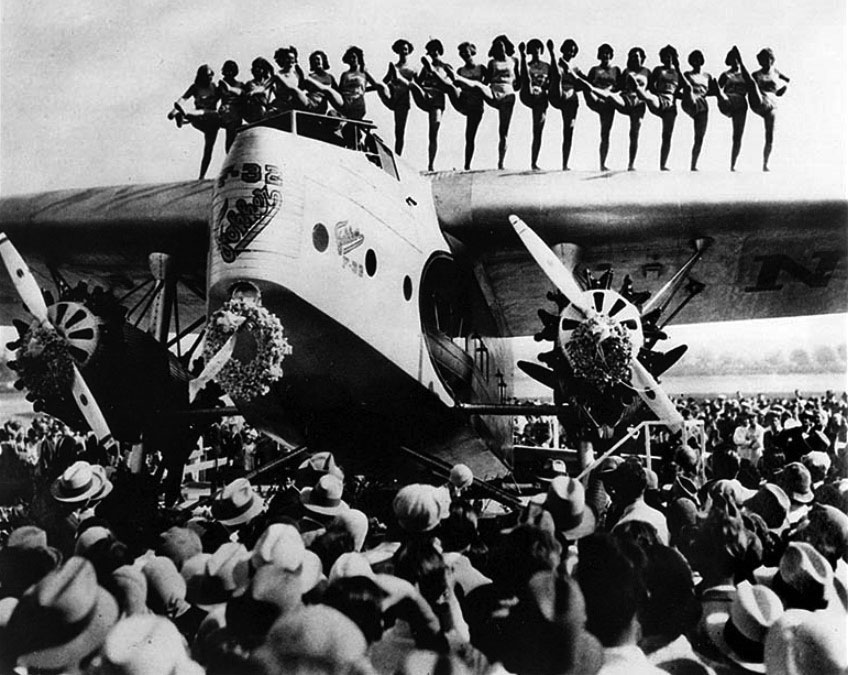 |
|
| (1930)* - View showing a chorus line on the wing of the big Fokker F-32 having their kicks. |
Historical Notes Following the success of the smaller three-engine Fokker F-10, the Fokker F-32 represented a bold step forward in commercial aviation—it was the first American-built, four-engine passenger transport, larger, more powerful, and far more luxurious than its predecessor. In 1930, Western Air Express (WAE) used the Fokker F-32 to inaugurate the first four-engine transport service. To promote this event, a unique and memorable publicity stunt was organized involving the Fanchon & Marco Fanchonettes, a famous chorus line of dancers. Eighteen of these dancers performed on the wing of the F-32, creating a striking visual spectacle that was captured in photographs and widely publicized. This event was part of a broader promotional effort to highlight the advanced design and capabilities of the F-32, which included luxurious fittings and a spacious cabin. The Fanchonettes’ performance on the wing of the F-32 was emblematic of the era’s blend of aviation innovation and entertainment, aiming to capture public interest and demonstrate the aircraft’s stability and size. Despite such promotional efforts, the F-32 faced commercial challenges and only a few units were built. |
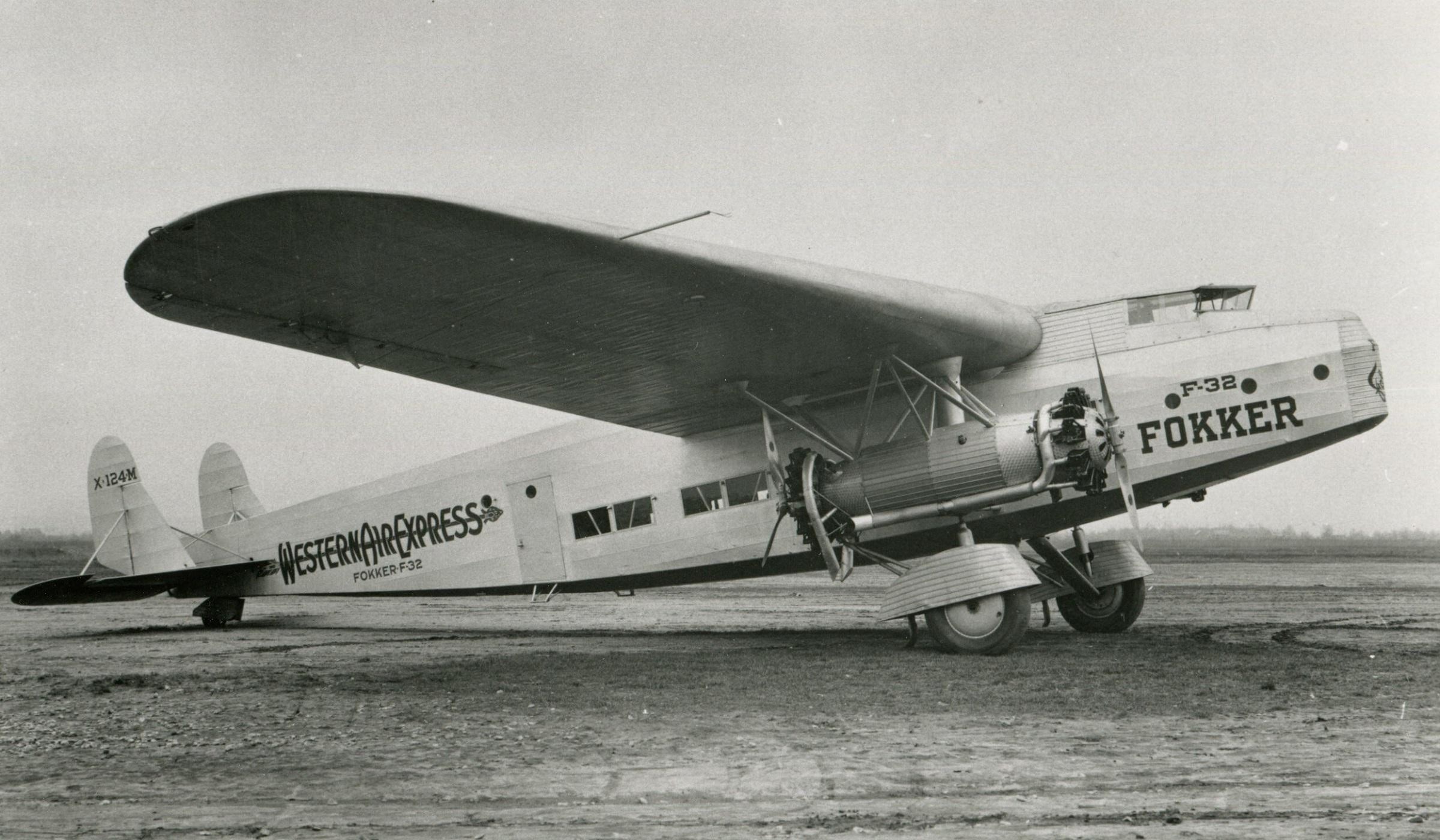 |
|
| (1930)* - Side view of the short-lived Fokker F-32, flown by Western Air Express. |
Historical Notes The Fokker F-32 was produced at Fokker’s Teterboro, New Jersey, plant in 1929. It was notable for being the first four-engine Fokker design and the last Fokker aircraft developed in the United States before the company folded during the Great Depression. Only ten aircraft were built. Although impressive in scale, the design suffered from high operating costs and mechanical inefficiencies caused by its unusual back-to-back engine arrangement—one engine facing forward and the other aft on each wing nacelle. The rear engines, operating in the turbulent airflow of the front propellers, were prone to overheating and performance loss. The first F-32 crashed on November 27, 1929, during a demonstration of a three-engine takeoff from Roosevelt Field on Long Island, New York, witnessed by poet Ogden Nash. Western Air Express and Universal Air Lines each ordered five aircraft, but Universal canceled its order and WAE only accepted two before the economic downturn made operation unfeasible. |
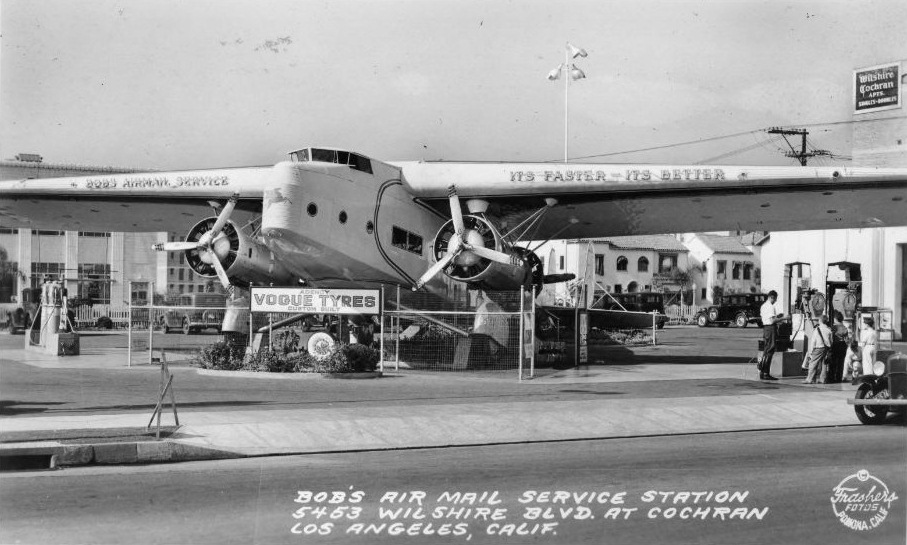 |
|
| (1936)* - The Fokker F-32 repurposed as a gas station. You could gas up your car beneath the wings of a grounded Fokker aircraft at Bob’s Air Mail Service Station on the n/w corner of Wilshire Boulevard and Cochran Avenue. |
Historical Notes After their brief service life, the two Fokker F-32 aircraft used by Western Air Express found an unusual second life. One of these aircraft was repurposed as a gas station on Wilshire Boulevard in Los Angeles. The plane was painted in Mobilgas colors, and fuel pumps were placed under its broad wings. This unique setup, known as Bob’s Air Mail Service Station, became a local attraction—its forward engines were occasionally started for show, thrilling motorists and passersby along Wilshire’s bustling Miracle Mile. Click HERE to see more Early Views of LA Gas Stations. |
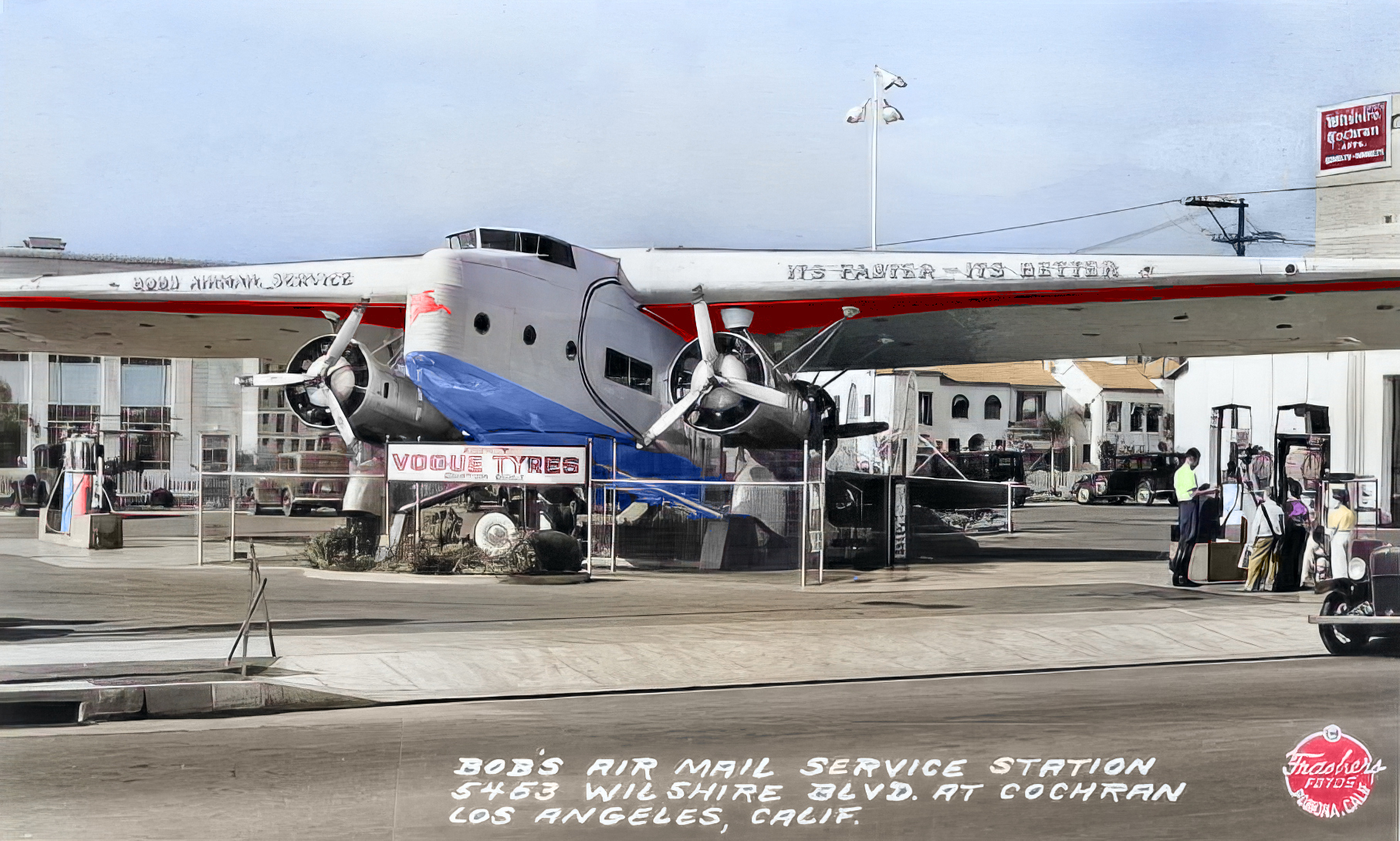 |
|
| (1936)*- The Fokker F-32 repurposed as a gas station. You could gas up your car beneath the wings of a grounded Fokker aircraft at Bob’s Air Mail Service Station on the n/w corner of Wilshire Boulevard and Cochran Avenue. Image enhancement and colorization by Richard Holoff |
Historical Notes The colorized version by Richard Holoff vividly restores the look of this whimsical chapter in Los Angeles history, capturing the metallic sheen of the F-32’s fuselage and the red Pegasus emblem of Mobilgas under the Southern California sun. In color, the aircraft-turned-service station feels even more surreal—a striking symbol of how quickly aviation’s great experiments could transform from marvels of progress to roadside curiosities. Click HERE to see more Early Views of LA Gas Stations. |
* * * * * |
Hamilton Cove Airport (Catalina)
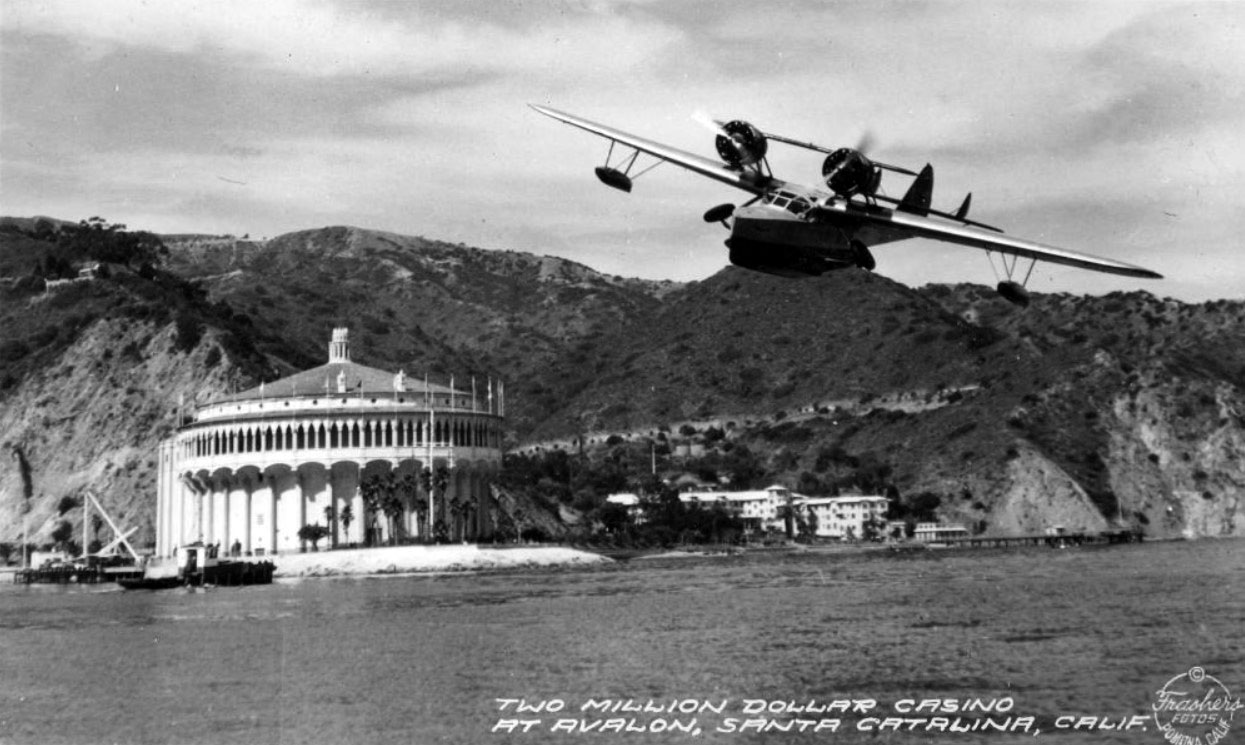 |
|
| (1930s)* - Postcard view showing a seaplane arriving with tourists at Avalon Bay in front of the “Two Million Dollar” Catalina Casino. The Casino was commissioned by William Wrigley Jr. in 1929 to commemorate the 10th anniversary of his purchase of Catalina Island. Remarkably, it did cost $2 million—a sum considered extravagant at the time. |
Historical Notes Seaplanes were another popular and more expensive option of tansportation to Catalina Island. Charlie Chaplin’s half-brother Syd began the first seaplane service to Catalina in 1919. It operated only for a couple of summers, but other firms moved in to operate the service until 1931. In that year, the island’s owner, Phillip K. Wrigley, began the Wilmington-Catalina Airline, Ltd. through his Santa Catalina Island Company. |
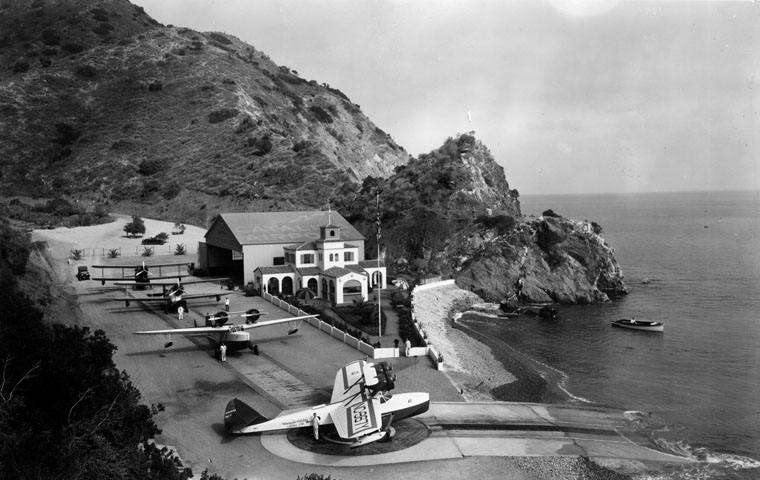 |
|
| (ca. 1931)* - Scenic view of Catalina Airport on Santa Catalina Island. Four planes are parked on a small runway, with three men, each standing by a plane. One man points to writing on the plane which reads, "Wilmington-Catalina Airline, Ltd." |
Historical Notes Catalina Airport at Hamilton Cove: Officially known as the Hamilton Cove Seaplane Base, it operated from 1922 to 1947 and served as Catalina Island’s primary air transportation hub during the 1930s. Located just north of Avalon, the base allowed amphibious seaplanes to land offshore and taxi up a ramp for passenger access. It was once described as “the smallest airport with the longest landing field (the Pacific) in the world." Philip Wrigley (son of William Wrigley, Jr.) helped design a unique airport at Hamilton Cove, the second cove north of Avalon. This airport was designed to accommodate the Douglas Dolphin amphibian planes of the Wilmington-Catalina Air Line, Ltd., a Wrigley-operated firm. The twin engine Dolphins landed just offshore and would taxi up a ramp to a large turntable mechanism. The airplane would then be rotated until it was facing the water and ready for a trip back to the mainland. A small Spanish-style terminal building welcomed residents, business people and tourists to Catalina. |
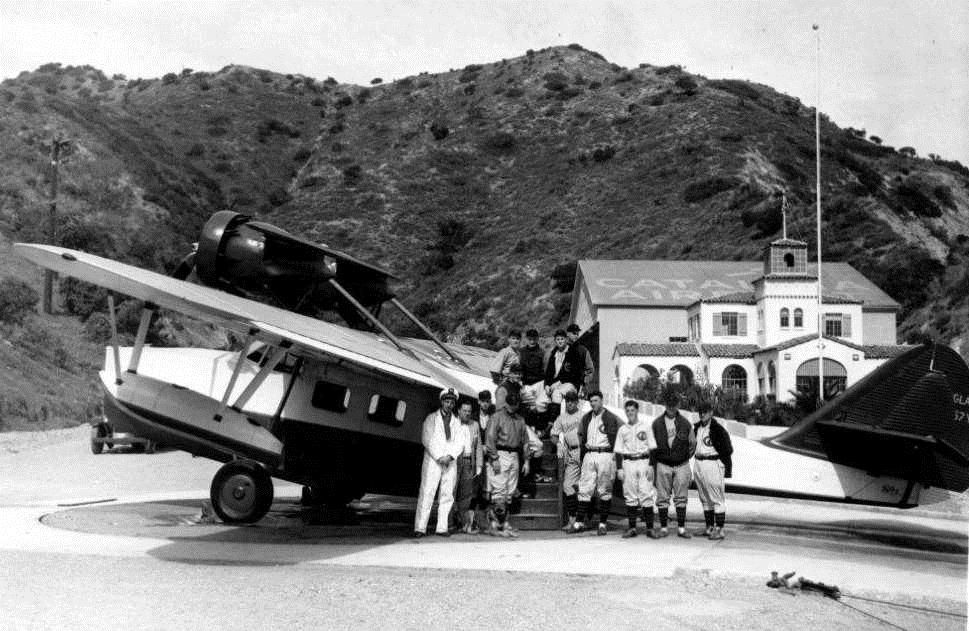 |
|
| (ca. 1931)* - William Wrigley's Chicago Cubs at the Hamilton Cove Airport. |
Historical Notes William Wrigley, Jr. played an instrumental role in the history of Catalina Island. He bought controlling interest in the Santa Catalina Island Company in 1919 and with the company he received the island for free. Wrigley improved the island with public utilities, new steamships, a hotel, the Casino building, and extensive plantings of trees, shrubs and flowers. In 1921 Wrigley moved the Spring Training site of his professional ball club, the Chicago Cubs, to Catalina. That same year, he also purchased the Los Angeles Angels who he would build another Wrigley Field for in South Los Angeles (1925). Click HERE to see more in Baseball in Early L.A. |
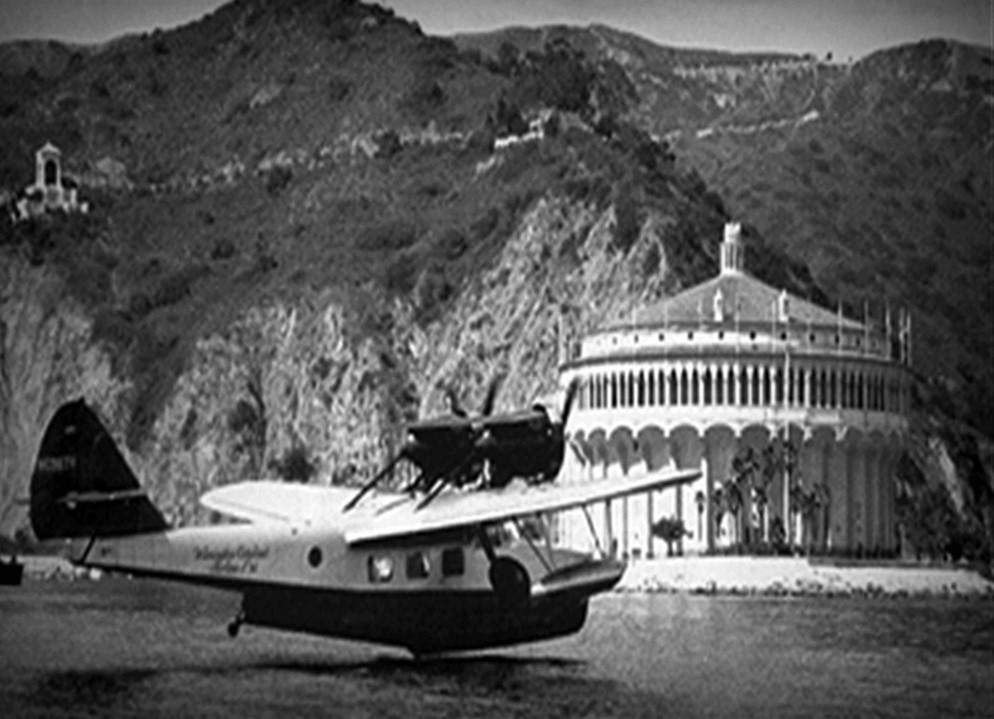 |
|
| (1931)* - Seaplane landing near the new "Two Million Dollar Casino" in Avalon. |
Historical Notes Aircraft desinger Donald Douglas designed the main seaplane used by Wilmington-Catalina Airline, the Douglas Dolphin. The twin-engined seaplane was the first of his planes to be used as a commercial passenger airliner. Its interior was well-appointed and could comfortably seat 10 passengers for the princely fee of $5.00 for a one-way trip in 1938. |
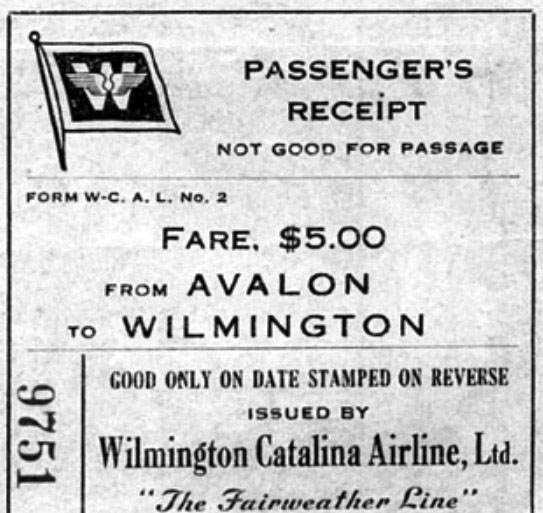 |
|
| (ca. 1938)* - Passenger receipt for a one way seaplane trip from Avalon to Wilmington on Wilmington Calalina Airline, Ltd. "The Fairweather Line". Fare - $5.00 |
Historical Notes In August 1940, plans that had been made to expand aviation operations on the island to include land-based airplanes started to become a reality when construction began for an airport located on the island’s interior. The Airport in the Sky was completed in 1941, the airline operation was renamed Catalina Air Transport and the future looked bright. Until December 7, 1941, when everything changed. Within a couple of weeks after the Pearl Harbor attack, the steamships were stopped from transporting passengers, and by September 1942, no civilian planes were allowed to land, effectively shutting down the entire island. It had become a closely patrolled federal military zone. Eventually, several military outposts were established there to conduct training for the duration of the war. The Airport in the Sky was shuttered, though it would reopen as a full-service general aviation facility in 1946. |
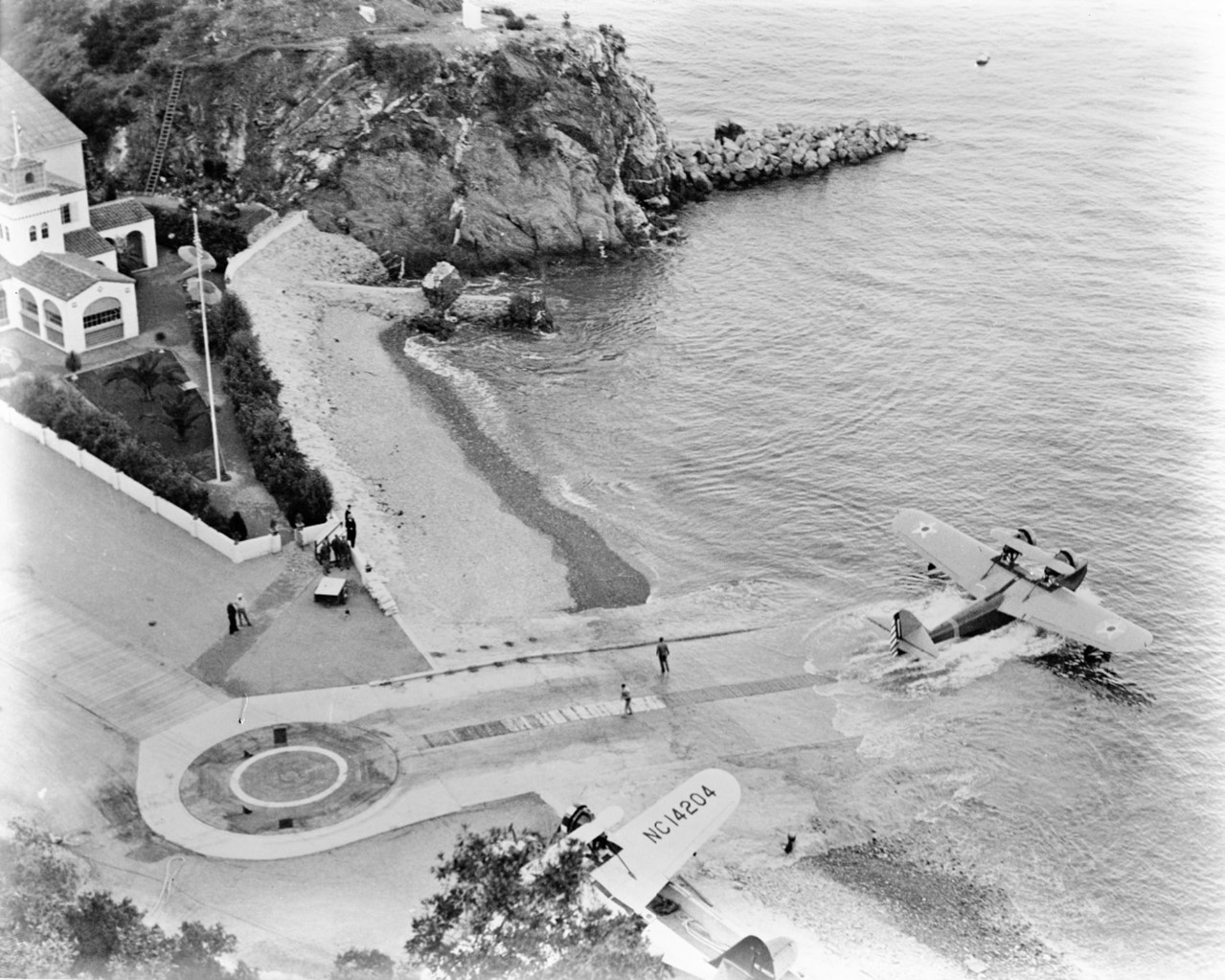 |
|
| (1942)* - A seaplane departs from Hamilton Cove Airport in Catalina. |
Historical Notes Click HERE to see more in Early Views of Catalina |
* * * * * |
Early Aviation
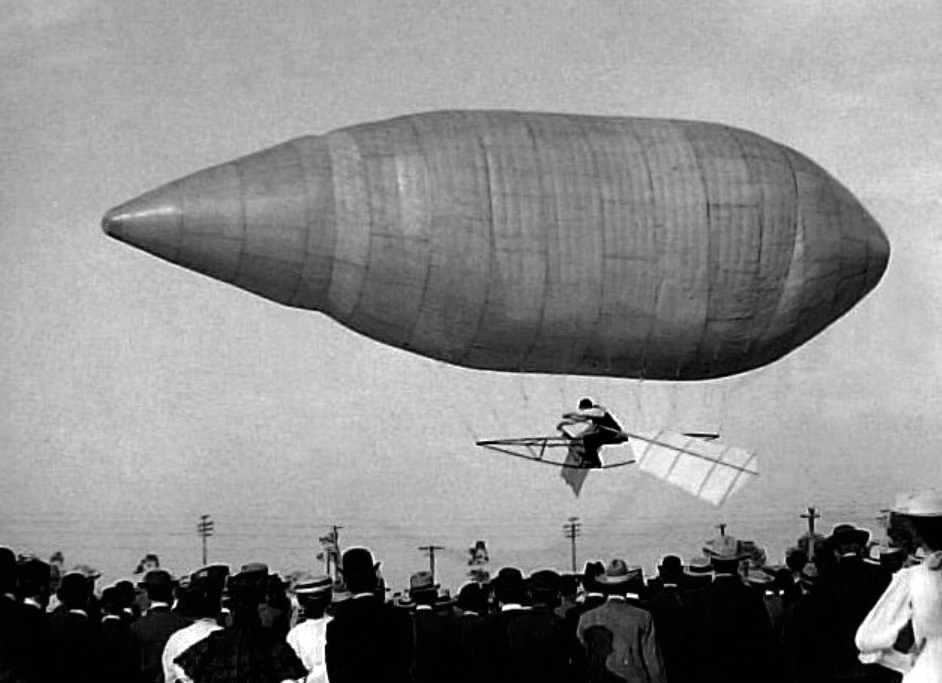 |
|
| (1905)* – View showing an airship (also dirigible) at Chutes Park, Los Angeles, built by Alva L. Reynolds. Demonstrated on September 10, 1905 by George D. Frisbie. |
Historical Notes Propelled by two air-oars, the aeronaut – seated on a 10 feet long by 3 feet wide gondola – “rowed” the neutral-buoyancy airship through the air. |
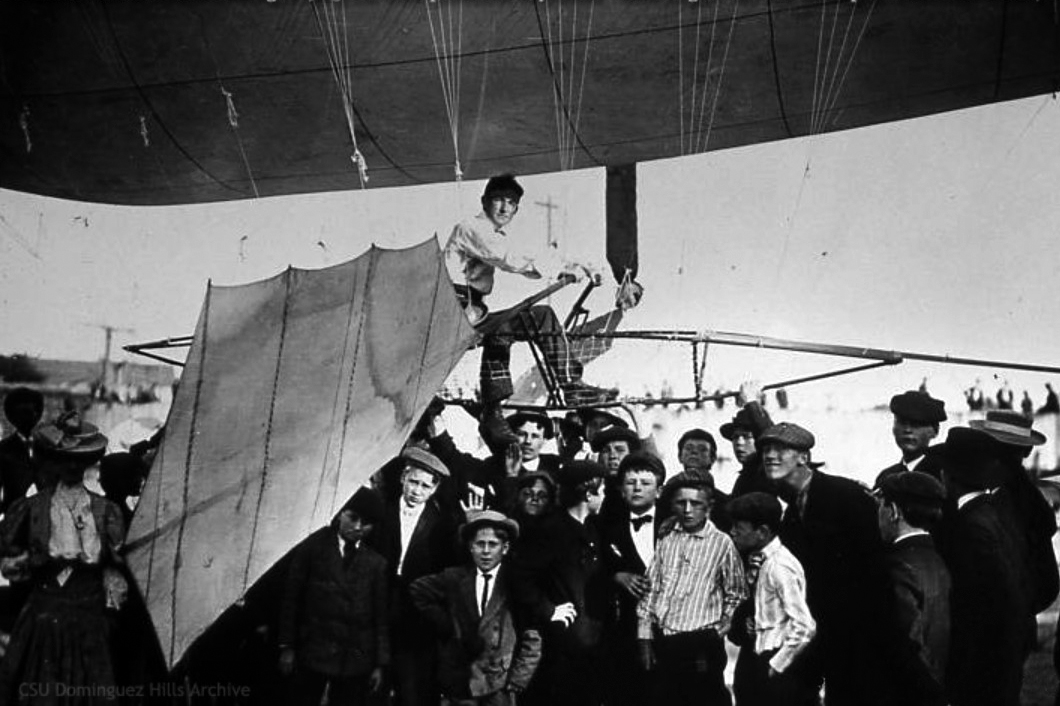 |
|
| (1905)* – View showing an unidentified aeronaut rowing a man-powered Reynolds “Man Angel” air-oar airship at Redondo Beach, California. |
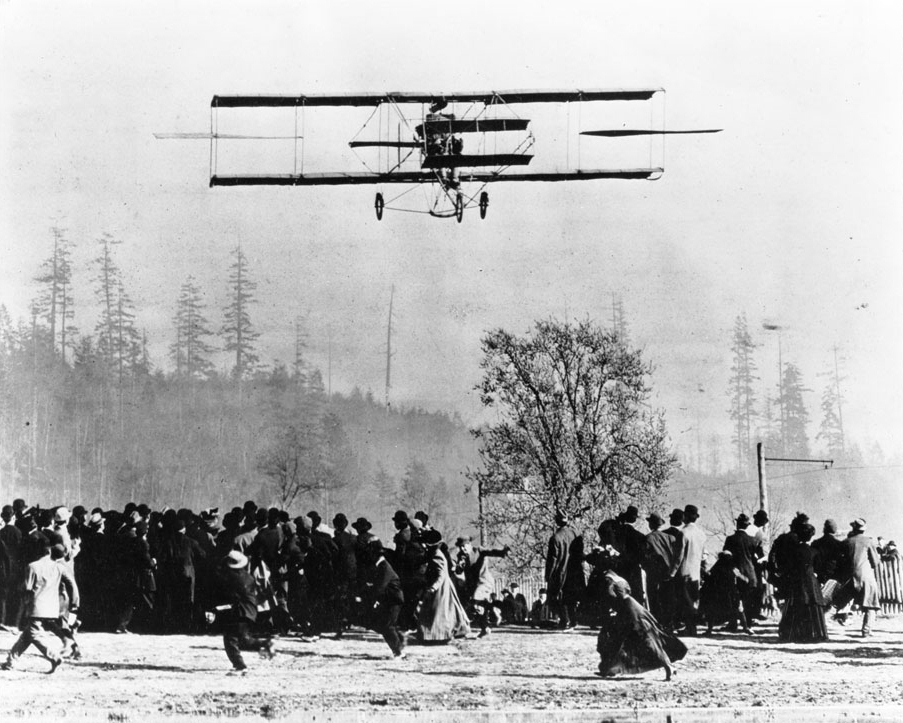 |
|
| (Early 1900s)* - A crowd of people looking up as a bi-plane flies overhead. It appears that some people are running to take cover....or just moving quickly to get a better view. |
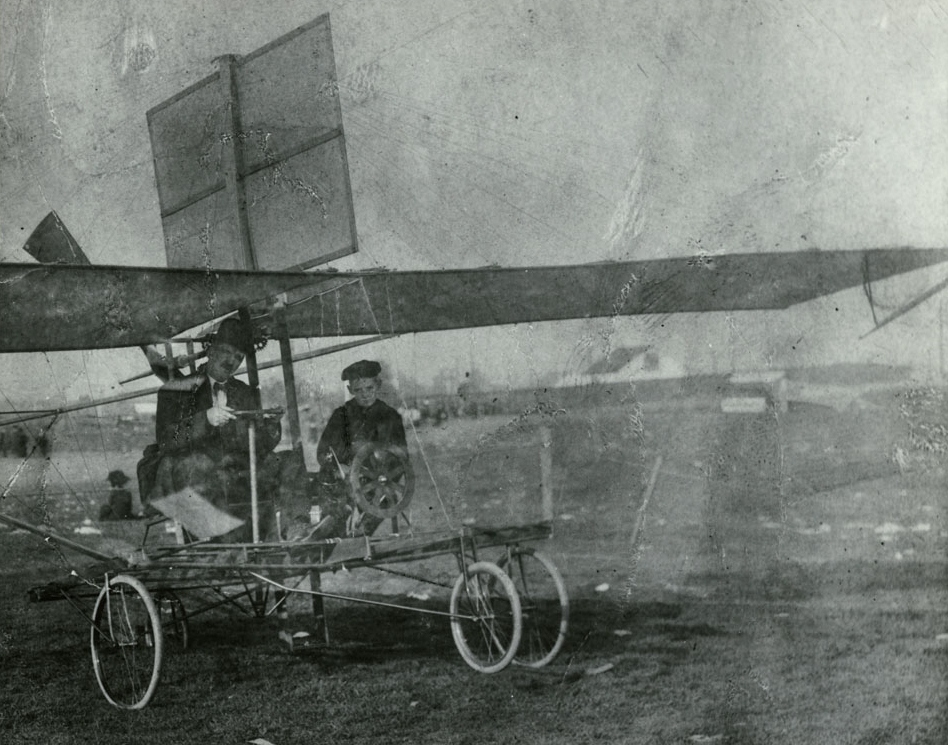 |
|
| (ca. 1910)* - Photograph of a man and a small child sitting in a Skoglund Monoplane. To the left, a man and a small child are seen sitting in a crudely made plane on a grassy field. The man is seen wearing formal attire and a small round hat. To his right, the young boy is seen wearing a darkly-colored cloak and a small cap. The man is seen gripping a small, round wheel that extends into the frame of the plane below. Next to the boy, a small wheel and bell are also visible. Above the man, the flat, rectangular wings of the plane are clearly visible. Also, a thin plane perpendicular to the wings is seen above the wings. Behind the wings, a part of a single propeller is visible. Below the man and child, four thin tires are seen balancing the plane's crude frame. In the extreme background, additional people and a building are barely visible. Description on back of the photo print reads: "Ed Davenport and father. 1467 Hehner St (?) Eagle Rock". |
Historical Notes The Skoglund monoplane was a simple aircraft with a crude tricycle undercarriage that had a relatively wide simple wheel track. It had some kind of roller blind ailerons on the wing tips that appeared to be controlled from the cockpit. Skoglund made extra money by allowing spectators to sit in his airplane and charged them a fee for the pictures such as the one seen above. |
 |
|
| (1909)* - The first pig to fly. |
Historical Notes The phrase "when pigs fly" is a well-known adynaton, a figure of speech used to describe something that is impossible. However, this notion was humorously challenged on November 4, 1909, when John Moore-Brabazon, an English aviation pioneer, made a historic flight with a piglet named Icarus II. This event took place at the Isle of Sheppey in Kent, England. Moore-Brabazon attached a small wastepaper basket to the wing strut of his Short Brothers biplane and placed the piglet inside. The flight, which covered a 3.5-mile round trip over the Thames Estuary, was intended as a whimsical demonstration to prove that "pigs can fly" and to overturn the proverbial impossibility. Despite initial squeals, the piglet remained calm during the flight, which was reported in newspapers and became a local sensation. This flight is often considered the first cargo flight on UK soil and the first flight of any livestock in a powered vehicle. John Moore-Brabazon's contributions to aviation did not end there. He was the first Englishman to fly a powered aircraft on British soil and later became the first person to qualify for a UK pilot's license. His career included significant achievements in aerial photography and reconnaissance during World War I and contributions to civil aviation planning post-World War II. The piglet, Icarus II, was spared from slaughter and kept as a pet by its owner, becoming a local celebrity. This event remains a charming anecdote in the history of aviation, illustrating how a playful act can capture public imagination and challenge long-held beliefs. |
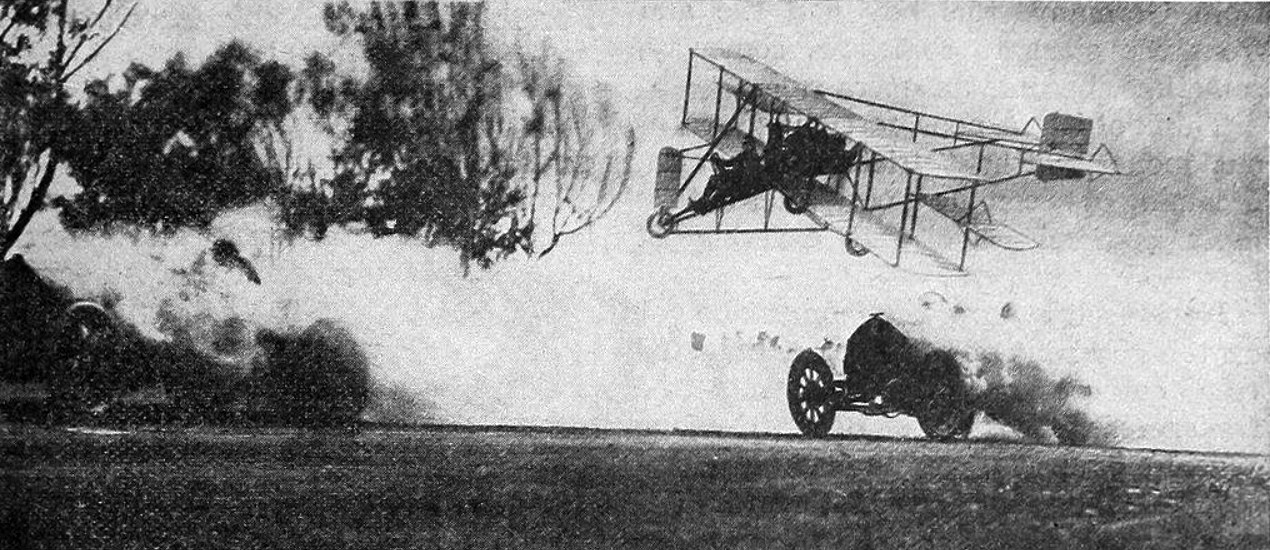 |
|
| (1913)* - Two cars racing, partly obscured by clouds of dust, with aviator Glenn Martin piloting biplane above serving as race referee. This photograph appears on page 415 of Popular Electricity magazine, Vol. VI, no. 1, May, 1913; the Owensmouth Road Race is covered in the Los Angeles Times, March, 1913. |
Historical Notes The Owensmouth Road Race in 1913 featured a unique promotional element: an airplane. Aviator Glenn Martin piloted a biplane and served as the race referee, a detail confirmed by a 1913 publication stating, "Martin referees car race in air." The scene, with two cars racing through clouds of dust and Martin flying above, epitomized the race's promotional activities. This use of an airplane to oversee and promote the race was part of a broader spectacle designed to showcase the modernity and infrastructure of the newly established town of Owensmouth. Held on March 27, 1913, the race was a significant event in the early history of Owensmouth, now known as Canoga Park. It was part of efforts to promote the town, founded on March 30, 1912, and featured prominent auto racing pioneer Barney Oldfield, receiving extensive coverage from the Los Angeles Times. Owensmouth was created during a period of rapid development in the San Fernando Valley, spurred by improved transportation options like electric railways and automobiles, and the anticipation of water from the Owens Valley. Initially part of a large tract of land owned by Isaac N. Van Nuys, it was sold to the Los Angeles Suburban Homes Company in 1909. This syndicate included influential figures such as Harry Chandler and Harrison Gray Otis of the Los Angeles Times, and developer Hobart Whitley. The Owensmouth Road Race was among many promotional activities organized to attract attention and settlers to the area. The event included a free barbecue, an air show, and live music, culminating in a race between a biplane and a Fiat sports car. These efforts were part of a broader strategy to transform the San Fernando Valley from agricultural land into a suburban area. |
 |
|
| (1913)* - Roy Knabenshue flying his 13-passenger dirigible over the Raymond Hotel. He offered aerial tours of the City of Pasadena. |
Historical Notes Roy Knabenshue was the first to make a dirigible balloon flight over the skyscrapers of New York back in 1905, one year after his original lighter-than- air powered flight at the St. Louis Exposition. After several years of barnstorming and a stretch as general manager for the Wright Brothers, he went west and built a 13-passenger airship in Pasadena for passenger flights. Click HERE to see more of Drigible Flights at the Raymond Hotel. |
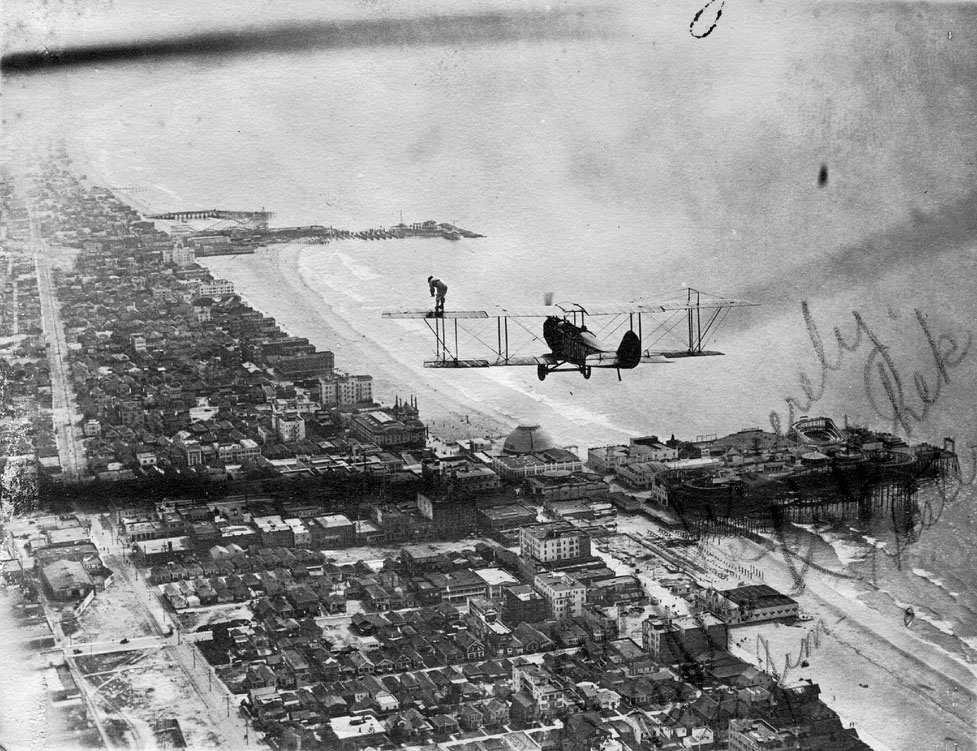 |
|
| (1918)* - Walking over Santa Monica. Aerial view of a bi-plane flying over Santa Monica. A woman is standing on the wing looking down. Ocean Park Pier with its amusement park appears just below the plane and Venice Pier is seen in the distance. Click HERE to see more in Early Southern California Amusement Parks. |
Historical Notes The above photo was taken August 14th, 1918. The wing walker was the fabulous and seriously talented Babe Kalishek. The Curtiss JN is piloted by the early ace aviator Jim Hester. |
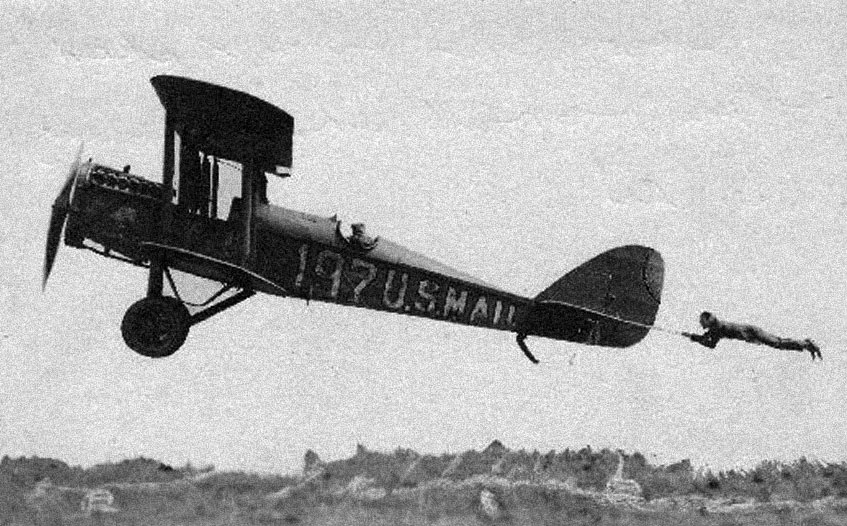 |
|
| (1924)* - Stuntman of the Flying Black Cats flys behind a plane on a tow line. |
Historical Notes Roy Knabenshue was the first to make a dirigible balloon flight over the skyscrapers of New York back in 1905, one year after his original lighter-than- air powered flight at the St. Louis Exposition. After several years of barnstorming and a stretch as general manager for the Wright Brothers, he went west and built a 13-passenger airship in Pasadena for passenger flights. Click HERE to see more of Drigible Flights at the Raymond Hotel. |
 |
|
| (1920s)* - It could have been a whole lot worse! Black Cats stunt plane tangles up with a tree. Miraculously, the pilot looks alright. |
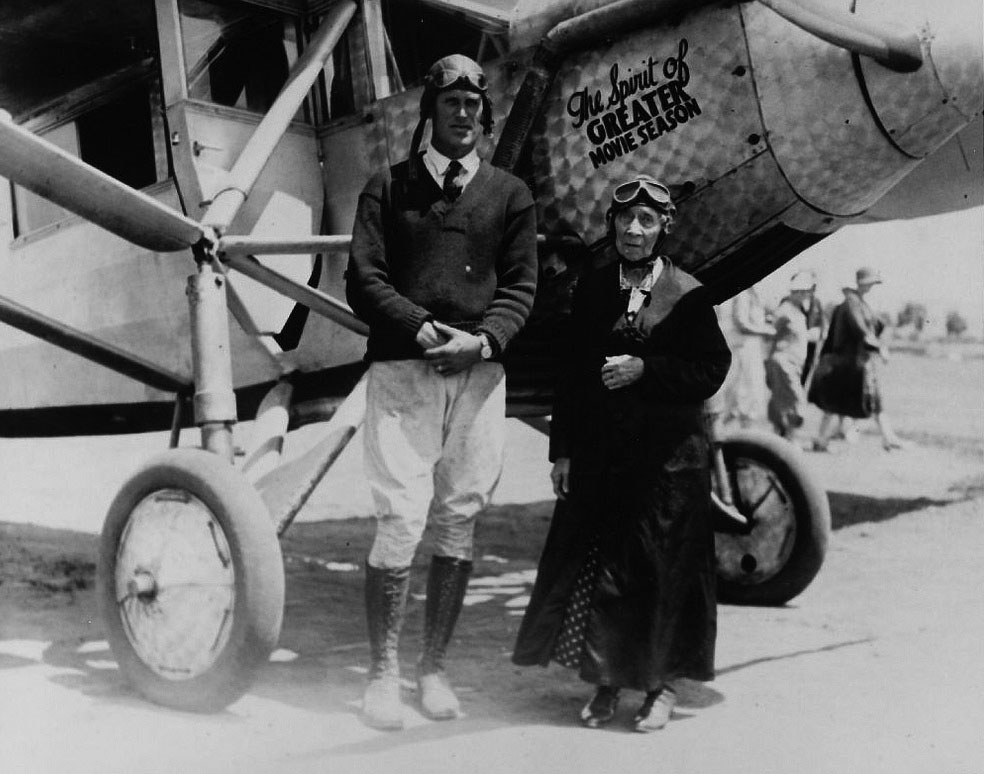 |
|
| (1927)* - You're never too old to fly! |
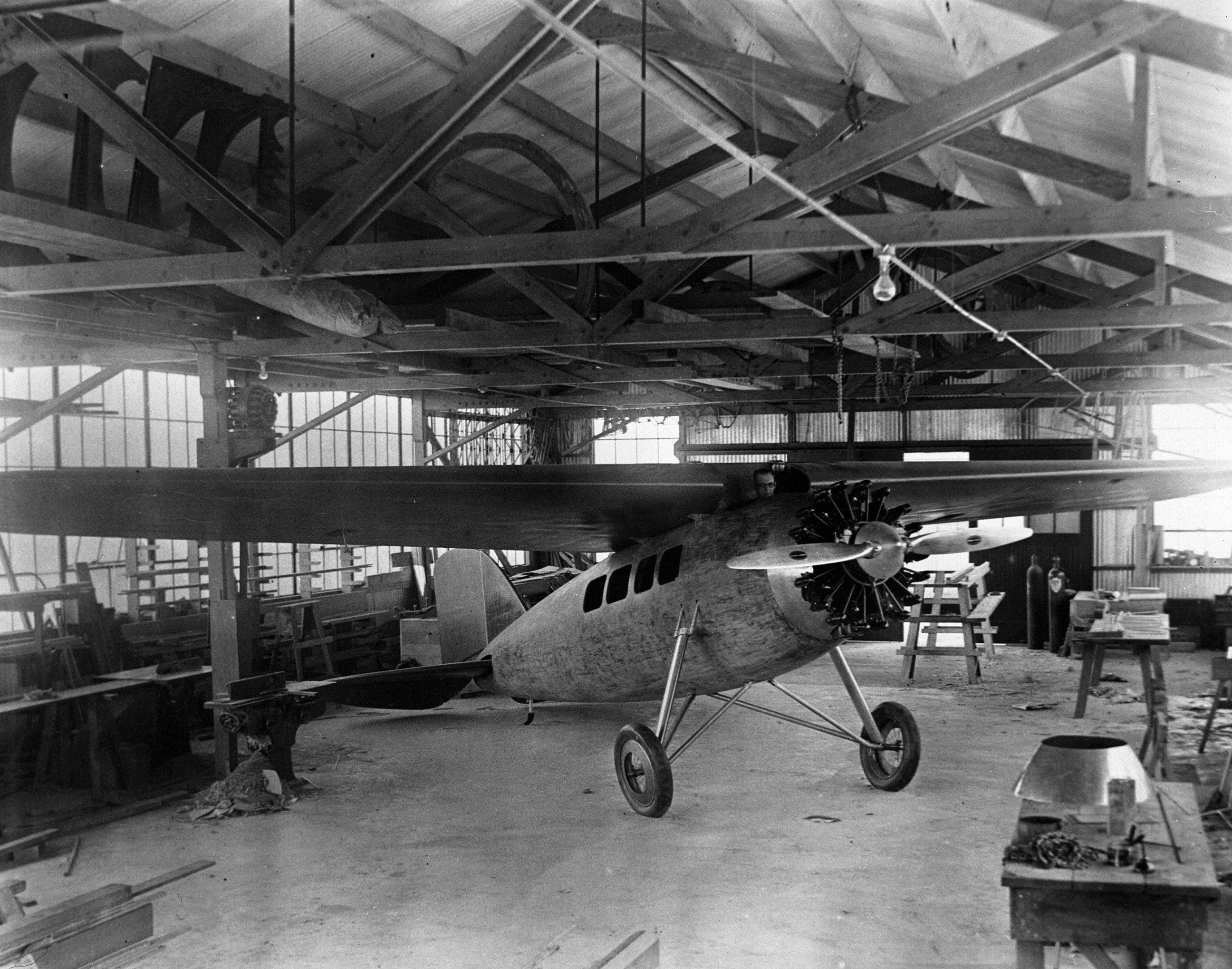 |
|
| (1927)* - The first Vega 1, NX913, Golden Eagle, nears completion at the Lockheed Aircraft Company, Hollywood. |
Historical Notes Twenty-eight Vega 1 airplanes were built by Lockheed Aircraft Company at the factory on Sycamore Street in Hollywood before production of the improved Lockheed Vega 5 began in 1928 and the company moved to its new location at Burbank, California. |
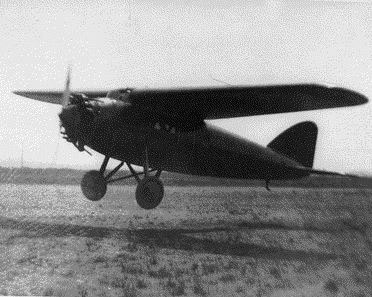 |
(1927)* – On July 4, 1927 the first Lockheed Aircraft Company Vega 1, NX913, Golden Eagle, made its maiden flight with test pilot Edward Antoine (Eddie) Bellande at Rogers Airport (The airport was at the present location of Wilshire Boulevard and Fairfax Avenue). |
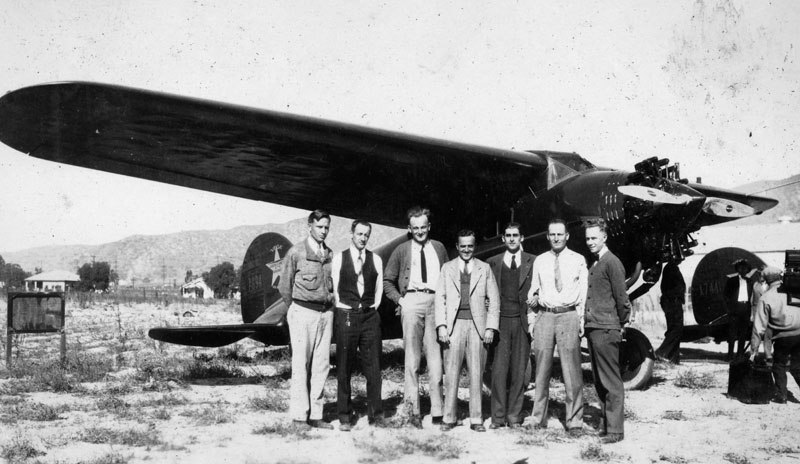 |
|
| (1928)* - Seven men, identified as the "old gang", stand next to a plane at the Lockheed plant in Hollywood. From left to right: Frank Crane, Jimmy Gerschler, Dan Egger, Jerry Vultee, Dick Von Hake and Vard Wallace. |
Historical Notes COriginally called the Alco Hydro-Aeroplane Company, Lockheed was founded in 1912 by brothers Malcolm and Allan Loughead. Its next incarnation was Loughead Aircraft Manufacturing Company and was located in Santa Barbara. In 1926, following the failure of Loughead, Allan Loughead formed the Lockheed Aircraft Company in Hollywood. The Great Depression greatly changed the aircraft industry and in 1934, Robert E. Gross was named chairman of the new company, the Lockheed Corporation, which had relocated to Union Airport (Bob Hope Airport) in Burbank, California. |
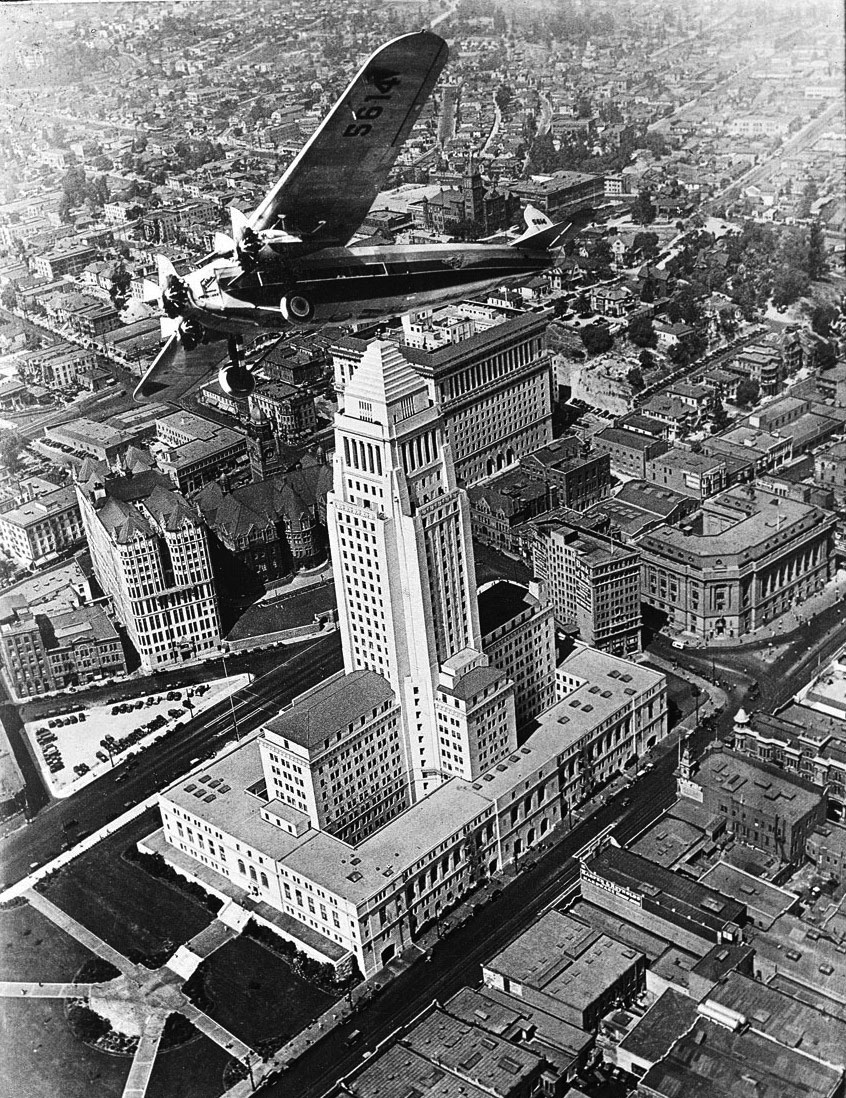 |
|
| (ca. 1929)* - View of a Fokker F.10 buzzing over City Hall circa 1929. |
Historical Notes The Fokker F.10 was first used by Richfield Oil (they had 2 F.10's) and later by Northern Airlines. It was destroyed on June 25th 1930 due to a hangar fire at Chicago. |
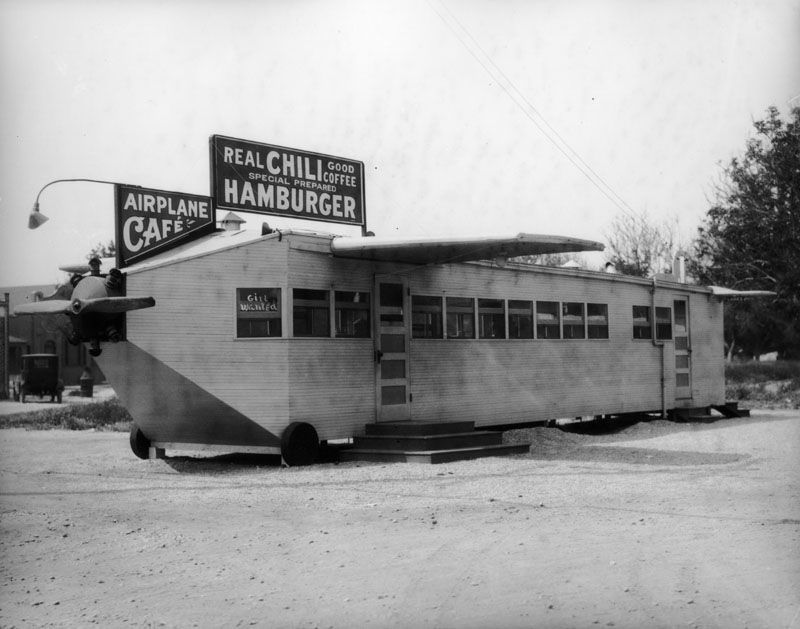 |
|
| (ca. 1924)* - View of the Airplane Café, a restaurant in the shape of a plane, complete with wings and a propeller. The structure has wheels, but rests on raised slabs of wood. The sign on roof reads: REAL CHILI - GOOD COFFEE - SPECIAL PREPARED HAMBURGER. |
Historical Notes In the 1920s, as the automobile was becoming the default way to get around the Southland, buildings and structures in the area became more unique, often resembling the merchandise or services they hawked. These “hey-you-can’t miss-me!” buildings (referred to as Novelty or Programmatic Architecture) were made to pull automobile drivers right off the road. |
.jpg) |
|
| (ca. 1924)* - Front end view of the Airplane Cafe (address unknown). The sign in the window reads: “Girl Wanted”. |
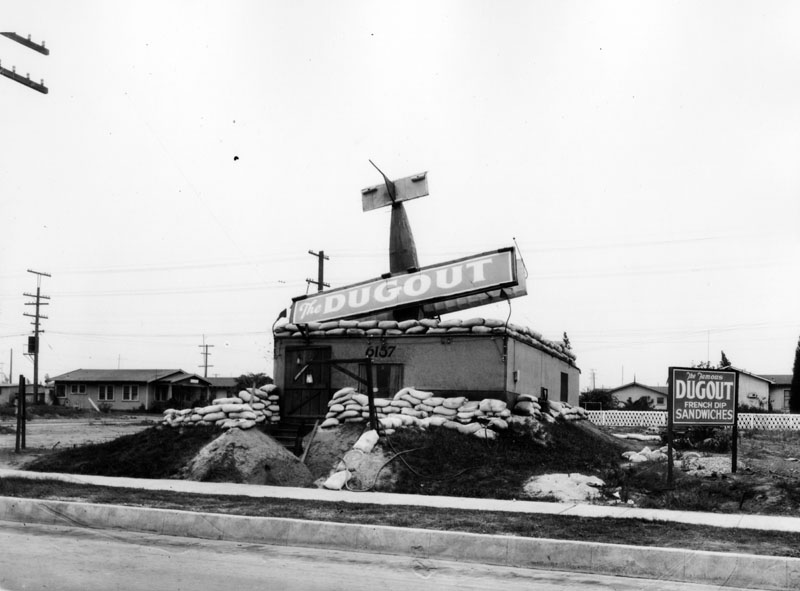 |
|
| (1929)* - "The Dugout" sandwich stand, which is surrounded by sandbags and has a plane crashed into its roof, located at 6157 E. Whittier Blvd. A sign outside reads: "The famous Dugout French dip sandwiches". |
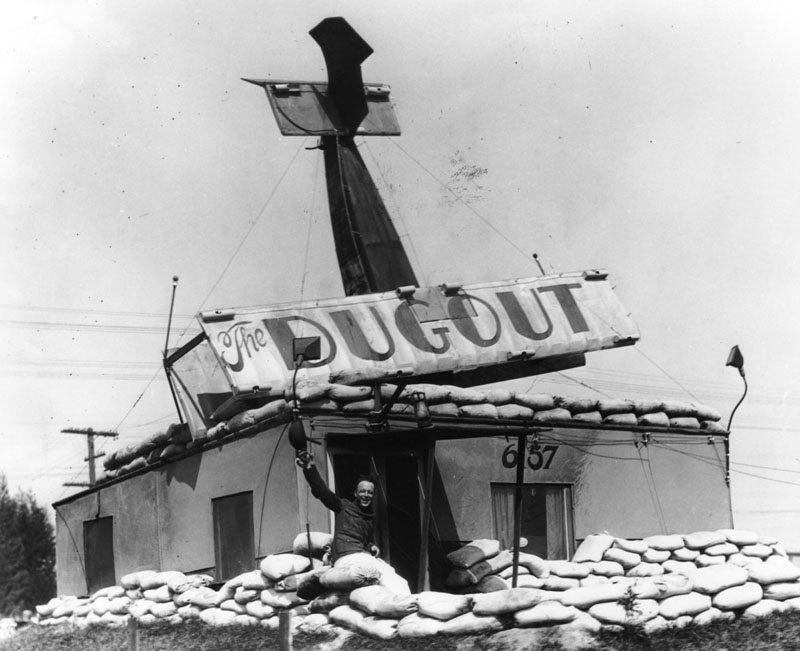 |
|
| (1920s)* - Close-up view of "The Dugout" showing a man in a soldier's uniform waving from behind sandbags in front of the restaurant. |
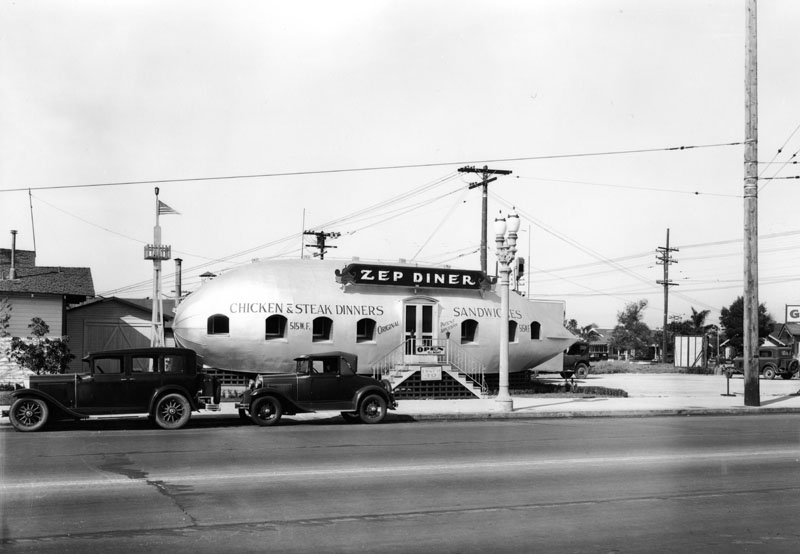 |
|
| (1931)* - View of Zep Diner, located at 515 W. Florence Ave, near Figueroa St. A sign hanging from the stairs advertises lunch for .40 cents. The Zep was open “all night” and was the “Home of the Hinden Burger”. The location is now a McDonald’s parking lot. |
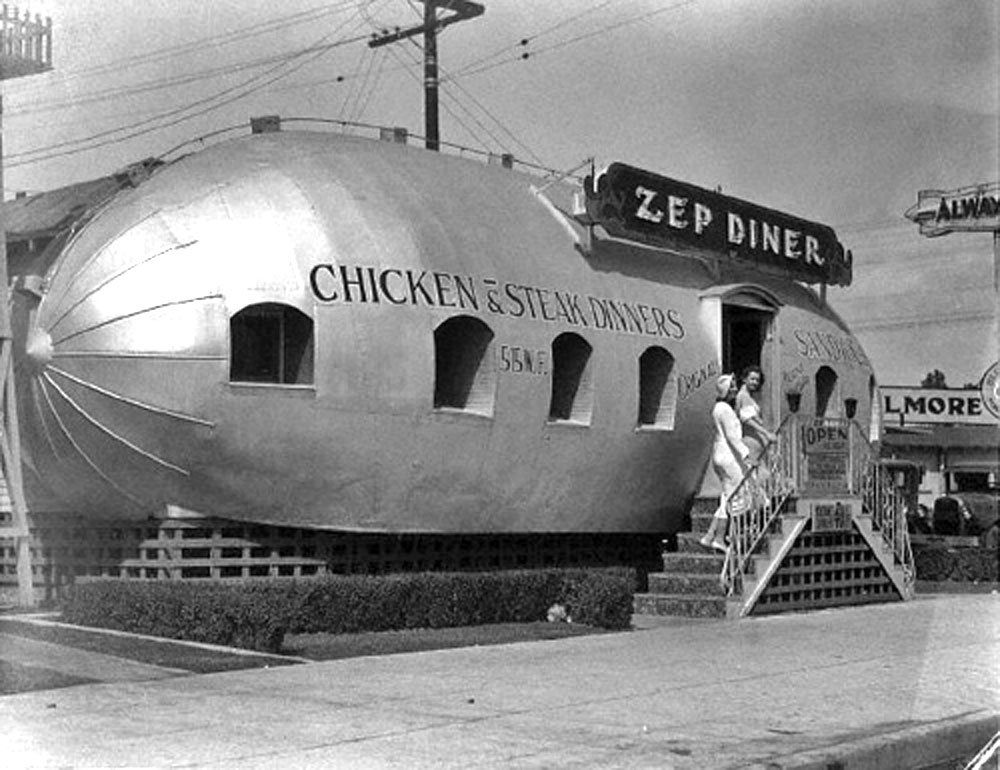 |
|
| (1931)#^^ - View of two women standing on the stairway leading to the entrance of Zen Diner. |
Historical Notes Click HERE to see more examples of Programmatic Architecture. |
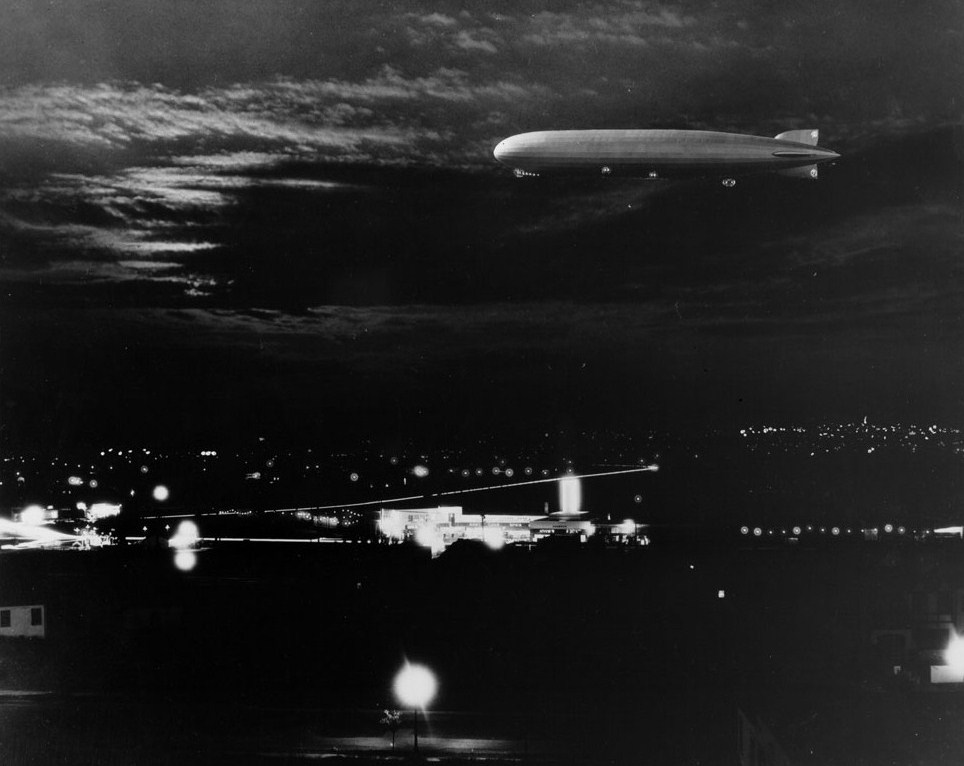 |
|
| (1929)^* - Graf Zeppelin over Leimert Park area of Los Angeles, August 1929. |
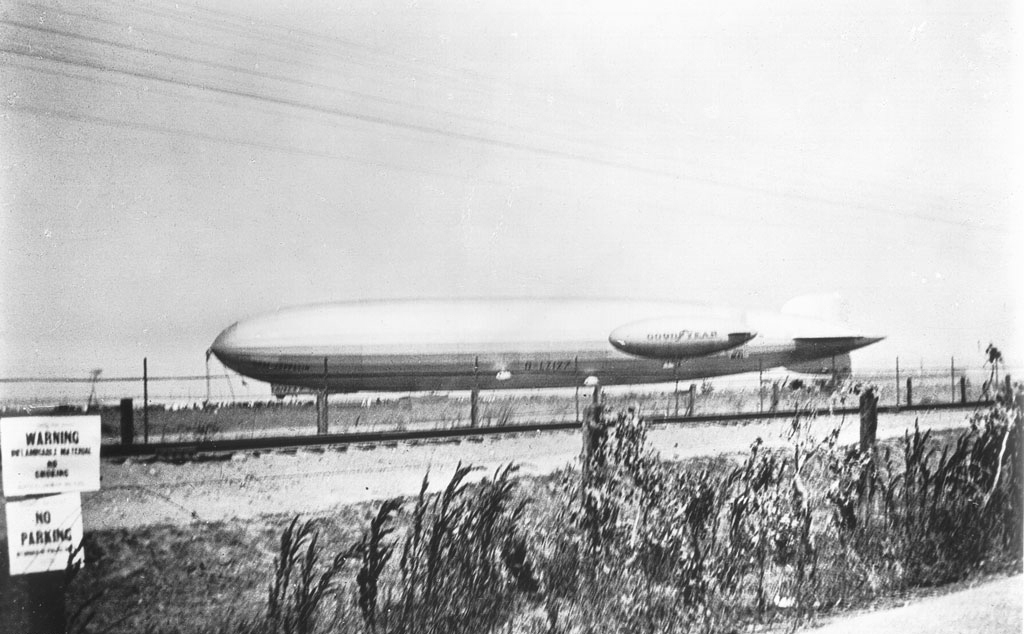 |
|
| (1929)^* - Photograph of the Graf Zeppelin and the small Goodyear pony blimp floating (or parked?) next to each other, 1929. The Graf Zeppelin is about ten times the size of the Goodyear blimp. Both the blimps are on the other side of the fence in the foreground. Several warning signs are posted up including a no-parking sign. |
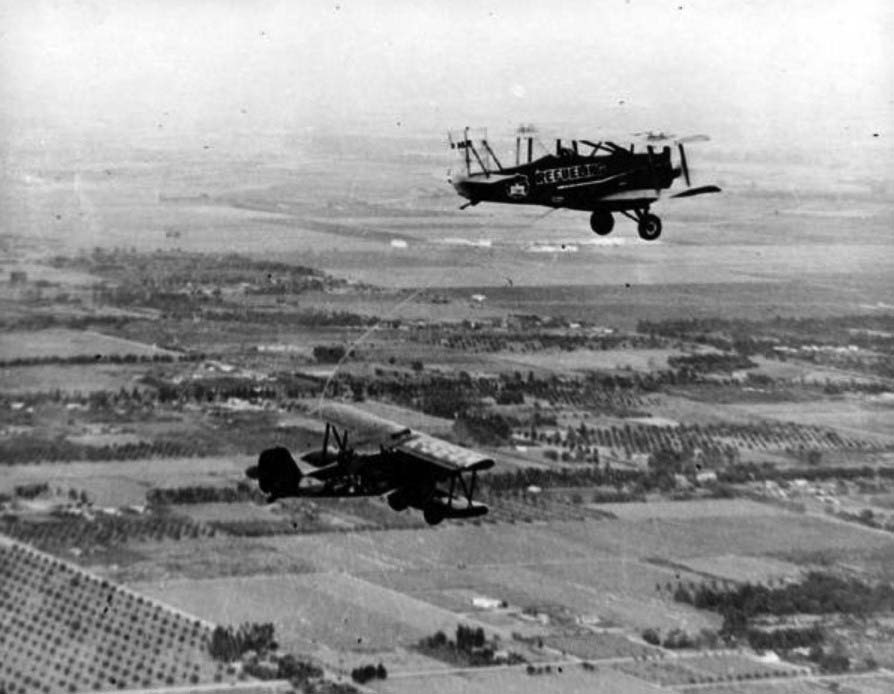 |
|
| (1929)^ - Biplane Sunbeam gets refueled in flight during the first women's endurance record on Nov. 12, 1929. Aircraft piloted by Elinor Smith, with Bobbi Trout as copilot. |
Historical Notes On January 2, 1929, Evelyn "Bobbi" Trout flew out of Van Nuys Airport (Metropolitan, San Fernando Valley) and into aviation history, an historic flight that lasted 12 hours, 11 minutes, set the first women's record for an all-night flight and flew the aviatrix into the pantheon of aviation pioneers. Trout went on to set more world records, many of them from Van Nuys Airport.^ |
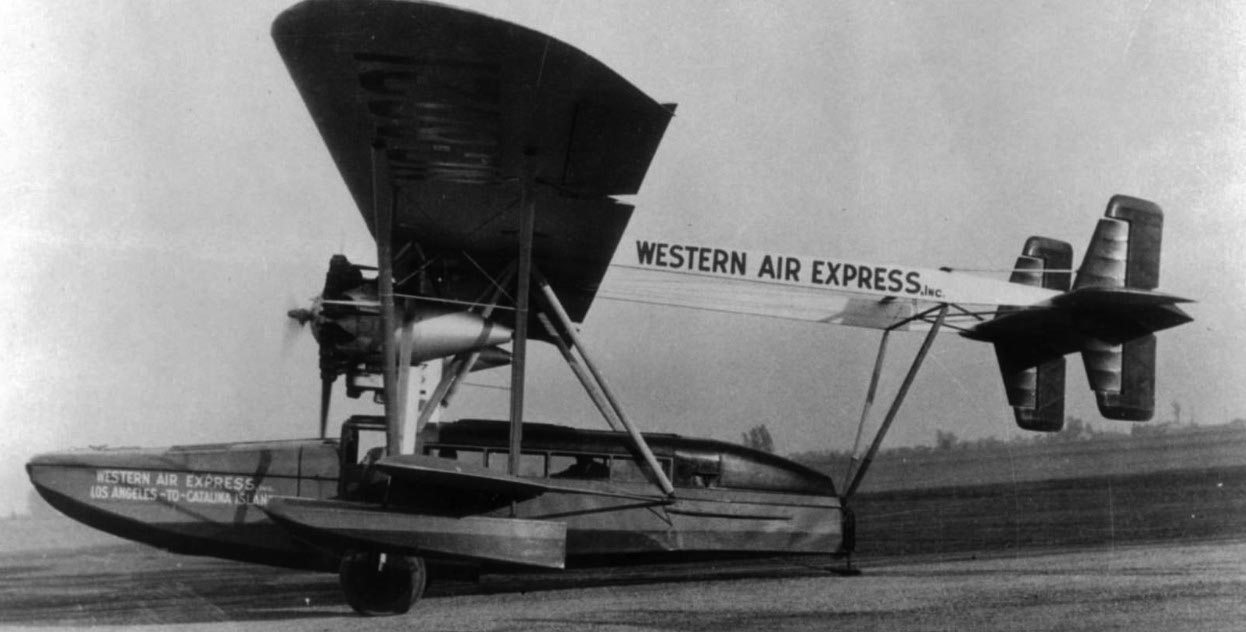 |
|
| (1930)#^ - View of a Western Air Express Sikorsky S-38A amphibious airplane, with lettering: "Western Air Express Inc., Los Angeles to Catalina Island." |
Historical Notes Upon acquiring Pacific Marine Airways, the first thing Corliss Moseley, COO of Western did was to augment the existing motley equipment by ordering a new Sikorsky S-38 amphibian. In 1931, Western Air Express’ contract to provide service to Catalina Island was not renewed by the Wrigley family (owners of the island) and the line and its assets were sold off to Wilmington-Catalina Airlines. ##+ The Sikorsky S-38 was an American twin-engined 8-seat sesquiplane amphibious aircraft. It was sometimes called "The Explorer's Air Yacht" and was Sikorsky's first widely produced amphibious flying boat which in addition to serving successfully for Pan American Airways and the U.S. Army, also had numerous private owners who received notoriety for their exploits. A total of 101 aircraft were built.*^ |
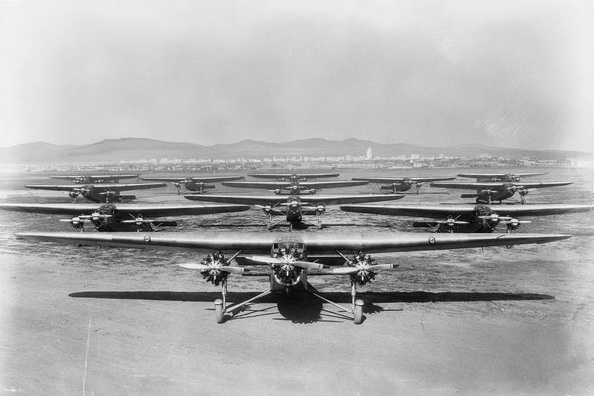 |
|
| (1929)^*# - View of the Maddux Airlines fleet at Mines Field. |
Historical Notes By mid 1929, Jack Maddux had 16 Tri-motors (the largest fleet of Fords in service) and two smaller planes which he used for private charter. Business was booming but the risks were great and he was unable to obtain an airmail contract from the government. To get the government's support, Jack merged the airline with Transcontinental Air Transport on November 16, 1929. It occurred just fifteen days after the October 29, 1929 stock market crash. At first, they called the new venture TAT-Maddux. Eight months later on July 19, 1930, TAT-Maddux merged with another local West Coast air carrier, competitor Western Air Express. The Maddux name was discarded at this time and the carriers actually did fly under their own names even though they were then associated. Jack did win a seat on the corporate board but he did not, apparently, have a major say in the new airline's operation, which became known as Trans Continental and Western Airlines (T&WA). Eventually, T&WA became Trans World Airlines.^ Among the famous aviators who were involved with Maddux were Charles Lindbergh and Amelia Earhart. Maddux also had a publicity department that advertised the celebrities who flew with the airline. These included Will Rogers, who rode on the inaugural flight, and Hollywood actors Arthur Edmund Carewe and Dolores del Río.*^ |
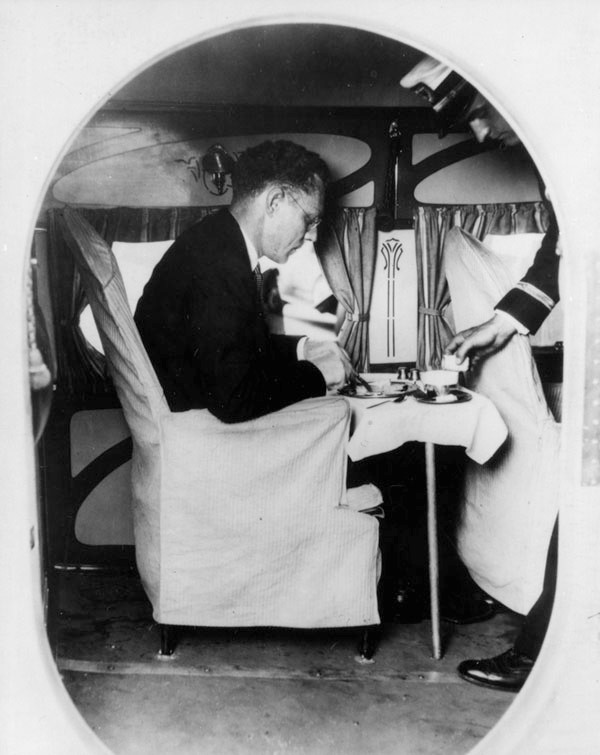 |
|
| (ca. 1929)* - Interior view of Maddux Airlines, showing a passenger eating a meal. |
Historical Notes Aviation circles on the web note two "Maddux Air" crashes, one in 1929, and another in 1930. There were others involving TAT and T&WA later. Crashes in those early days were not uncommon. Flying was new and the safety technology was virtually nonexistent then.^ |
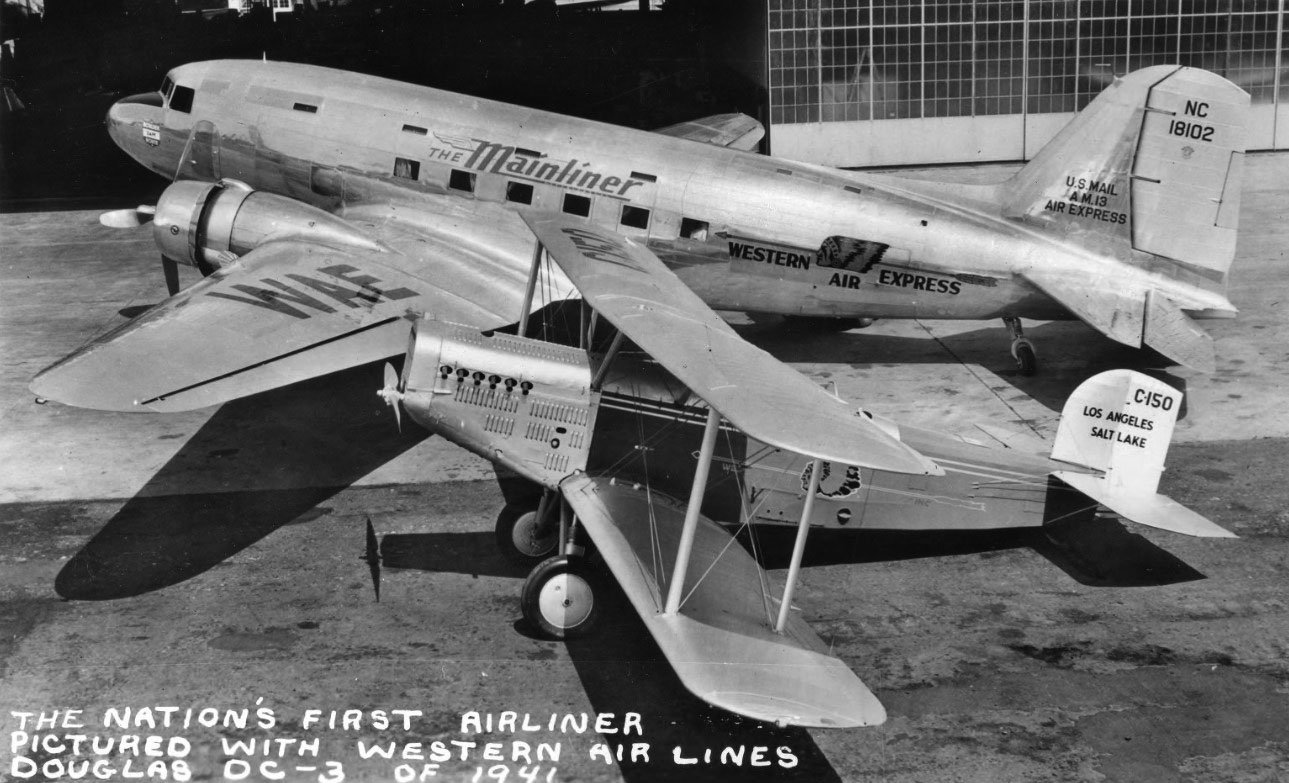 |
|
| (1941)***^ – Nation's First Airliner Pictured with Western Airlines Douglas DC-3 of 1941. |
Historical Notes The Douglas DC-3 was a fixed-wing propeller-driven airliner with tailwheel-type landing gear. Its cruise speed (207 mph) and range (1,500 mi) revolutionized air transport in the 1930s and 1940s. Its lasting effect on the airline industry and World War II makes it one of the most significant transport aircraft ever made. The DC-3 was a twin-engine metal monoplane, developed as a larger, improved 14-bed sleeper version of the Douglas DC-2. It had many exceptional qualities compared to previous aircraft. It was fast, had a good range and could operate from short runways. It was reliable and easy to maintain and carried passengers in greater comfort. Before the war, it pioneered many air travel routes. It was able to cross the continental United States, making transcontinental flights and worldwide flights possible, and is considered the first airliner that could make money by carrying passengers alone.*^ |
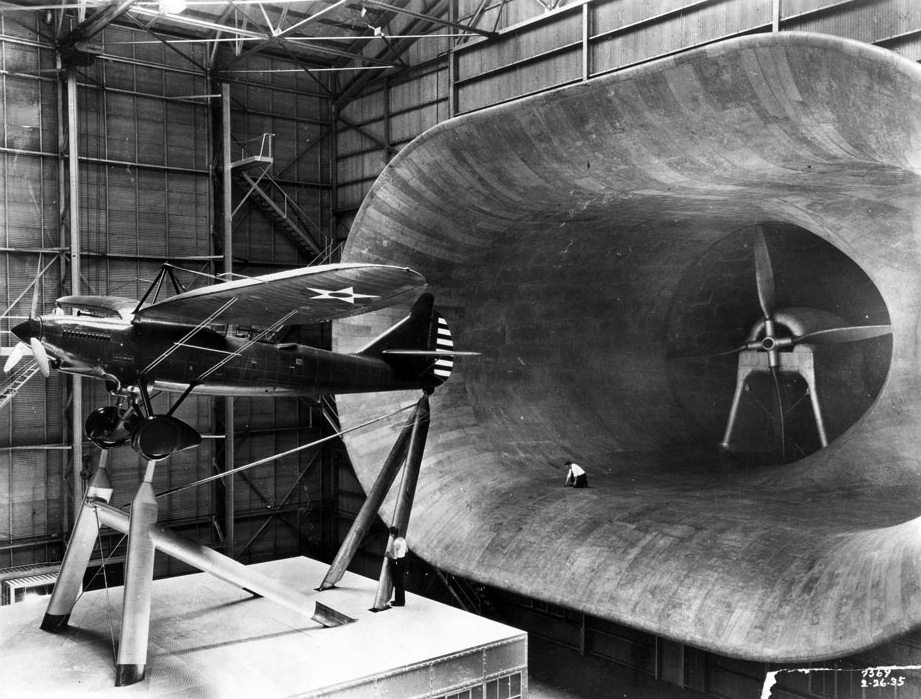 |
|
| (ca. 1930)^* - Photograph of aircraft next to large-scale wind tunnel. To the left, a large darkly-colored aircraft is visible. The aircraft is seen supported from its tires and tail by four immense metal poles on a platform. A man is seen standing next to a single pole beneath the plane. To the right of the plane in the background, an enormous wind tunnel is visible. The interior of the tunnel appears smooth, and the edges of the tunnel point concave outwards. A large steel propeller sits at the end of the tunnel. A man is also seen kneeling within the tunnel. In the extreme background, metallic structures and stairwells are visible. |
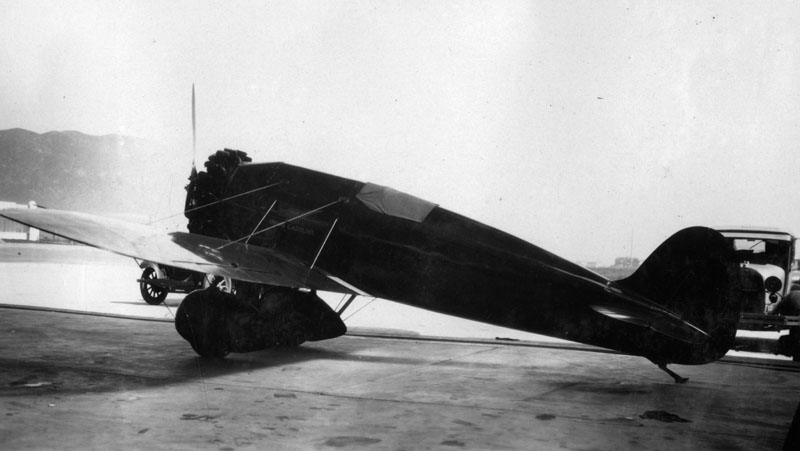 |
|
| (1931)* - A Travel Air "Mystery Ship" belonging to Florence Lowe "Pancho" Barnes (1901-1975) shown at Union Airport (Bob Hope Airport) in Burbank. |
Historical Notes In 1929, the first sleek little black and red Model-R mono-plane was flown to Cleveland from Wichita just before the National Air Races and was immediately placed in a hangar and covered with a canvas tarp. This secrecy of the plane's identity resulted in it being nicknamed the "Mystery Ship." "Pancho" Barnes, grand-daughter of Thaddeus S. C. Lowe of Mount Lowe fame, was a pioneer of women's aviation and the owner of the celebrated Happy Bottom Riding Club located in the Antelope Valley. After her death, her Mystery Ship shown here was stored in a hangar at Mojave Airport, but was later sold to a private collector and is currently in the United Kingdom waiting to be restored.* |
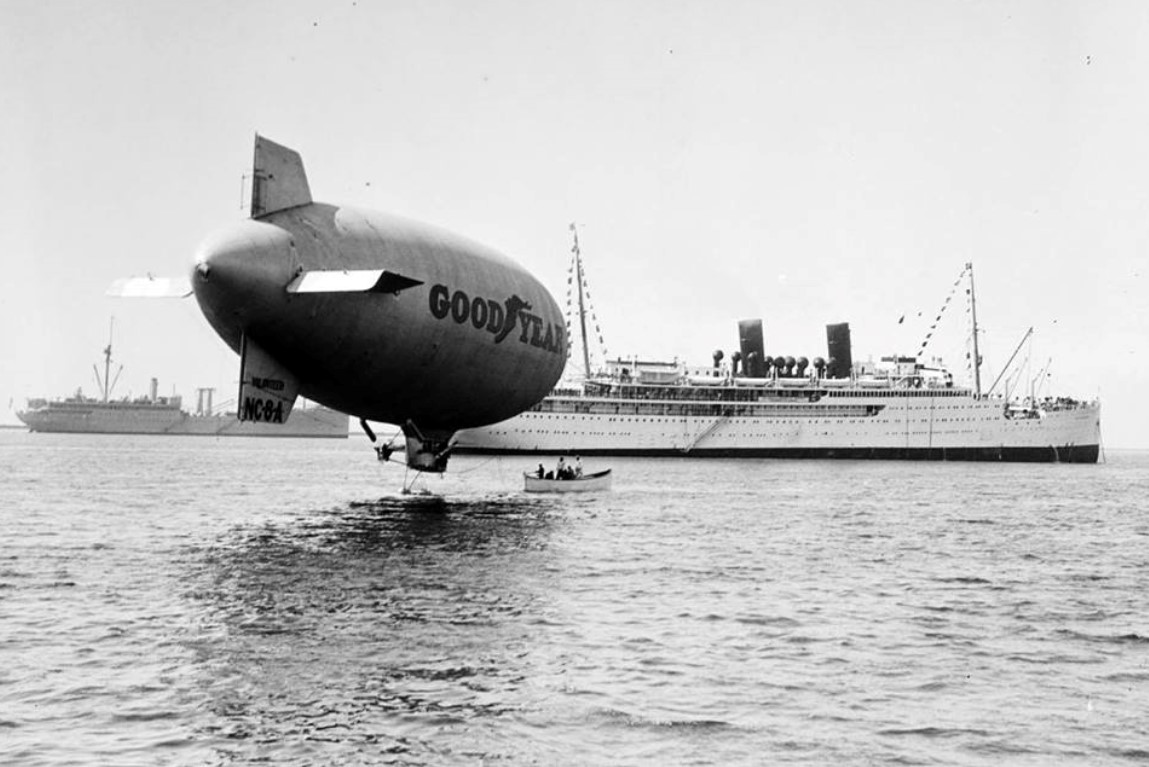 |
|
| (1931)^* - Transferring mail from an ocean liner to the Goodyear Blimp in the Los Angeles Harbor. |
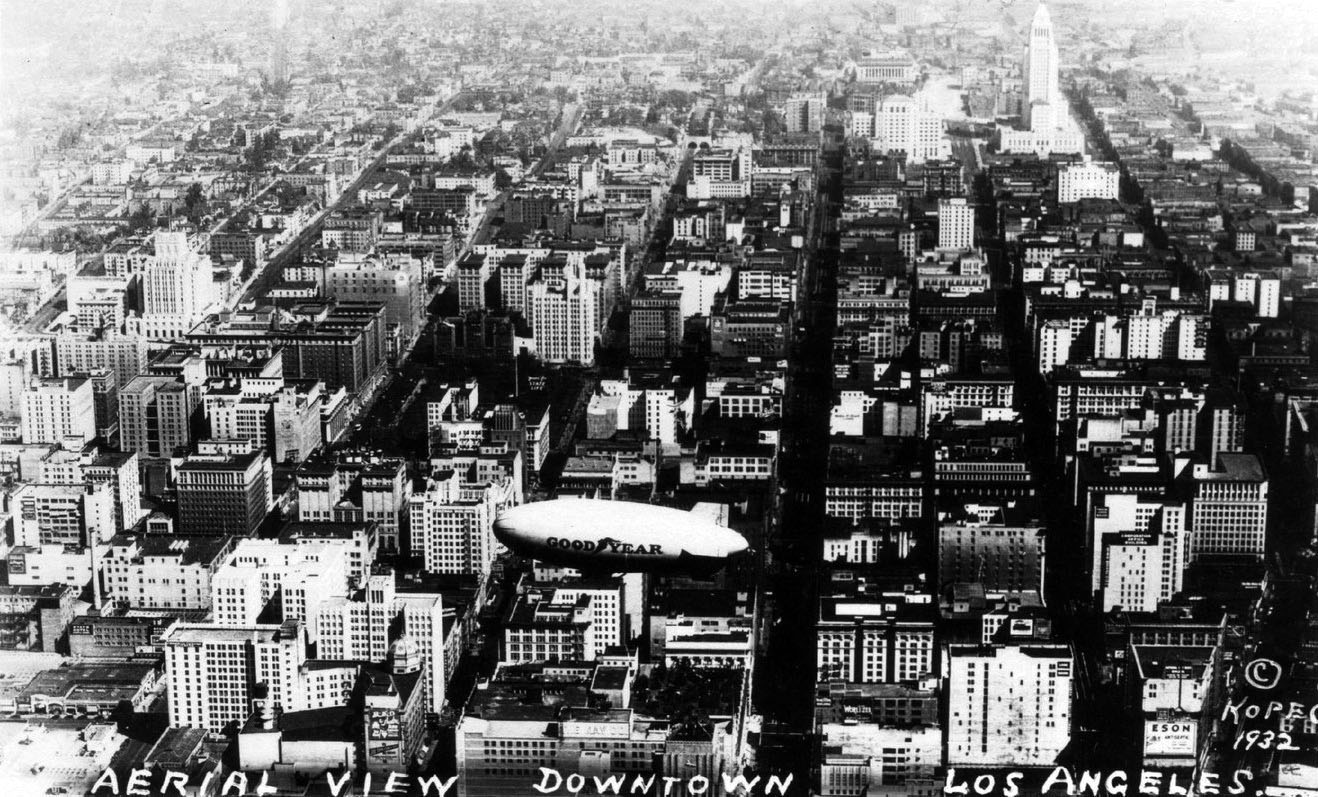 |
|
| (1932)^*# - Aerial view looking north up Broadway. The Goodyear blimp is hovering over downtown Los Angeles and City Hall is seen in the distance. |
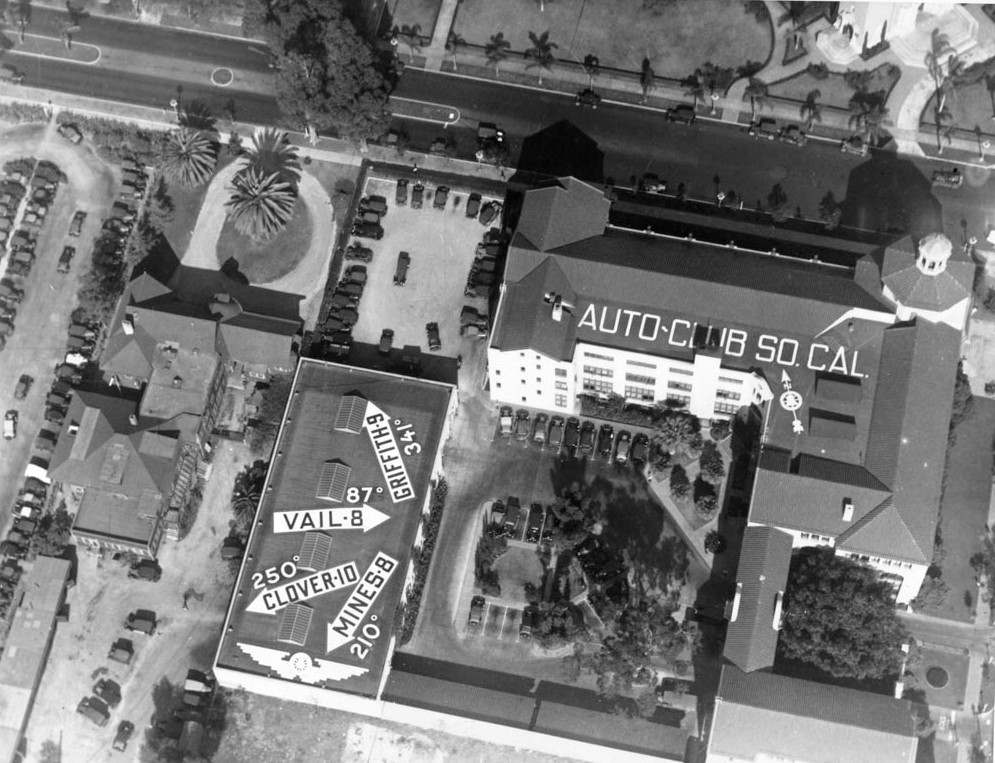 |
|
| (ca. 1930s)^* - Aerial view directly over the Automobile Club of Southern California building on Figueroa St. in Los Angeles. Signs are painted on the building's roof indicating direction and distances to nearest airports. |
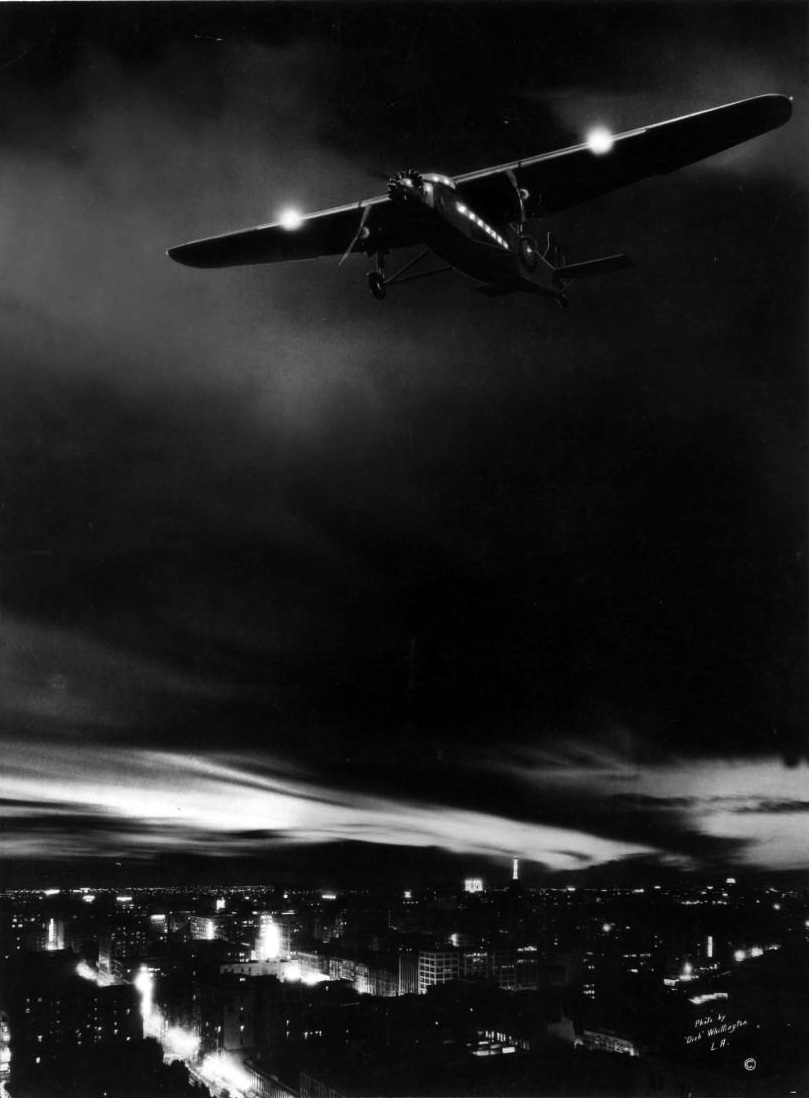 |
|
| (ca. 1935)^* - Composite photo of a small commercial airliner flying at night over the city. Photo by “Dick” Whittington. |
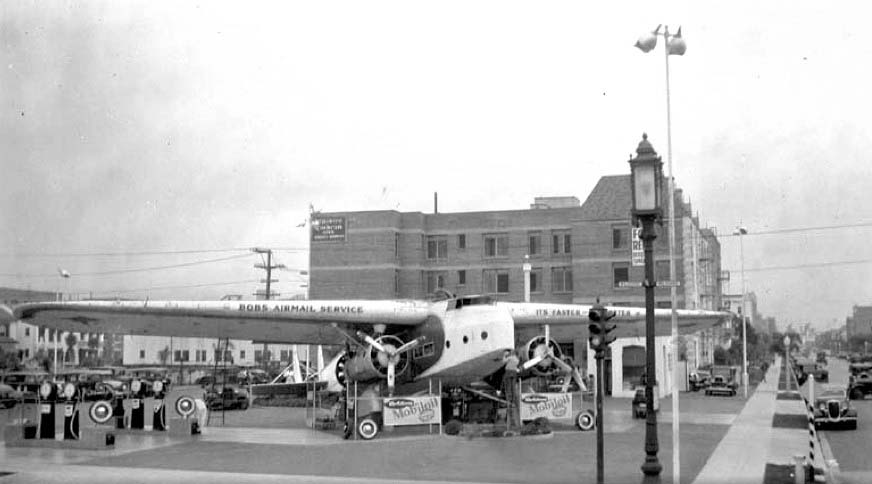 |
|
| (1935)^**^ – View looking east on Wilshire Boulevard at Cochran Avenue. An airplane (Fokker F-32) seems to be parked on the corner lot. Sign on the wings reads: BOB'S AIRMAIL SERVICE |
Historical Notes Bob’s Air Mail Service utilized a real twin-prop airplane to top its station, with the wings serving as canopies to shade its General Petroleum pumps. The plane was one of two Fokker F-32 aircraft operated by Western Air Express, circa 1930-31. The four engine F-32 was a design failure due to overheating of the two pusher engines and was only briefly in commercial service. |
 |
|
| (1936)^*^ - You could gas up your car beneath the wings of a grounded airplane at Bob’s Air Mail Service Station on the n/w corner of Wilshire Blvd. and Cochran Ave. |
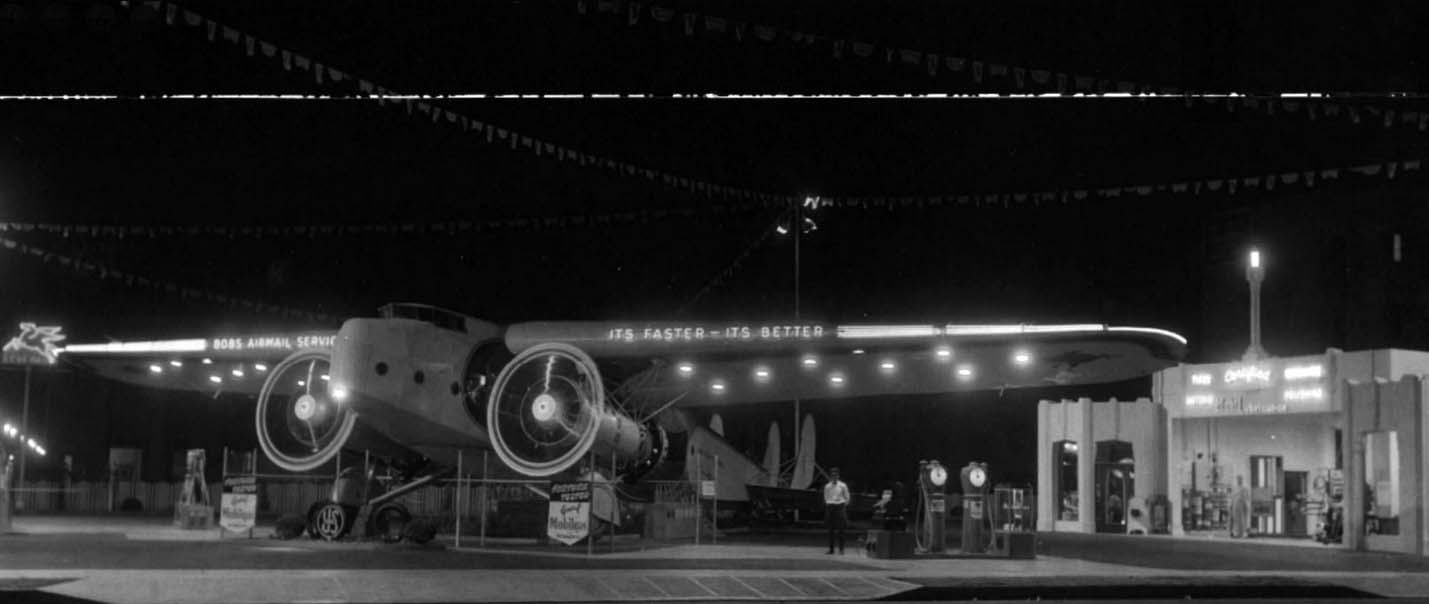 |
|
| (ca. 1938)#^ – Night view showing a man standing in between a Fokker F-32 aircraft with spinning propellers and the gas pumps at Bob's Airmail Service on Wilshire. |
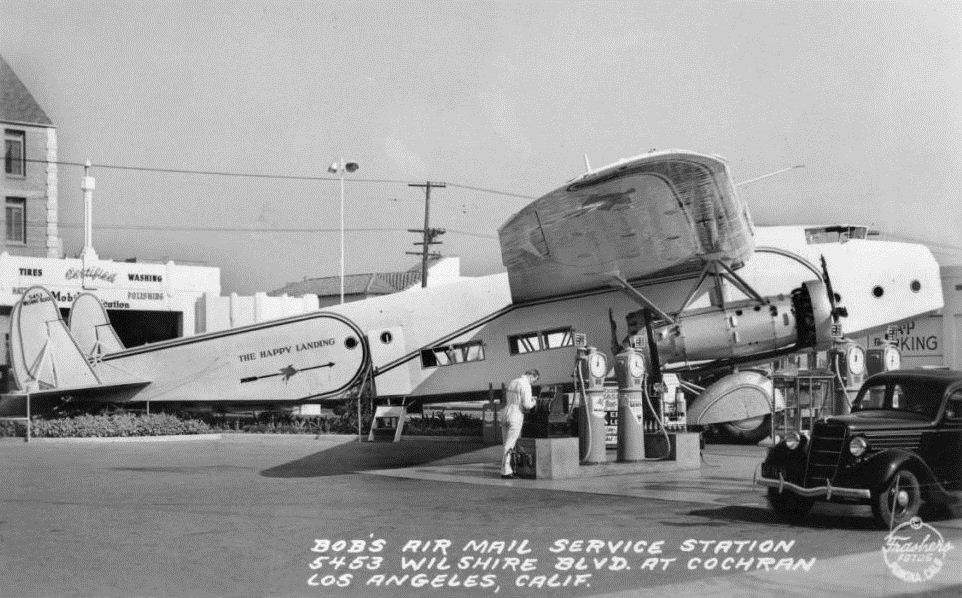 |
|
| (1936)***^ - Another view of Bob's Airmail Service Station at 5453 Wilshire Boulevard. |
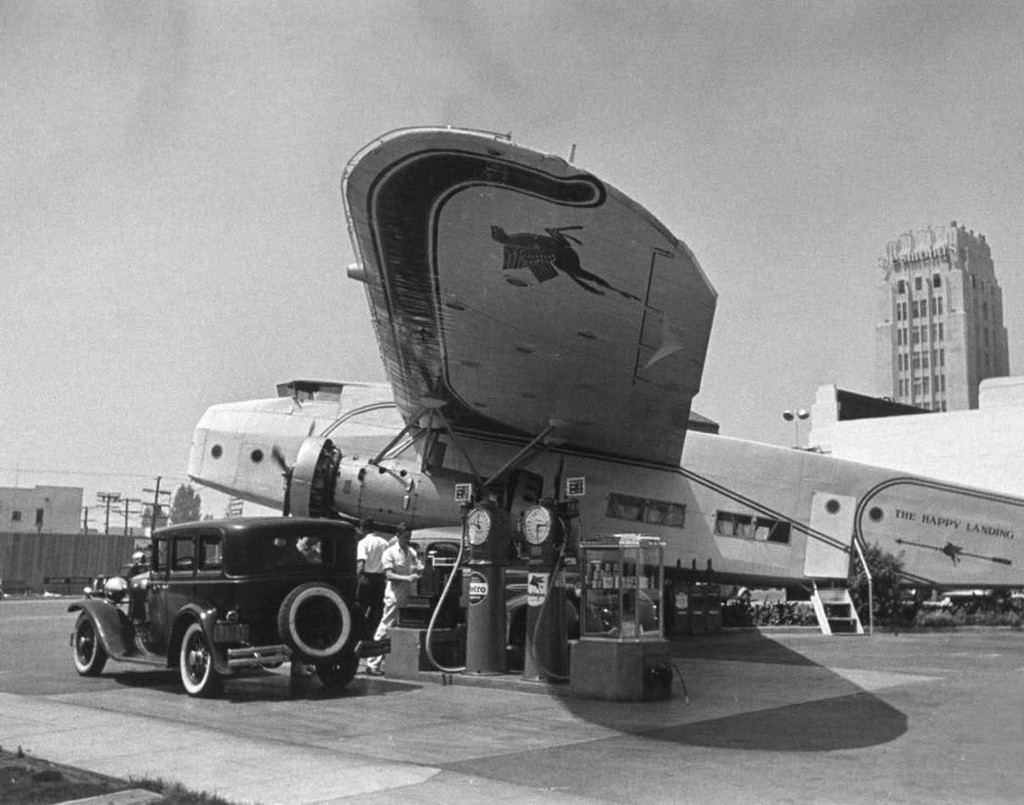 |
|
| (ca. 1936)^*# - Bob's Airmail Service Station on Wilshire. It almost appears as if the plane's propellers are moving. In the background can be seen the Wilshire Tower with the name Desmonds just visible on the top. Click HERE to see more Early Views of LA Gas Stations. |
Flying Wing
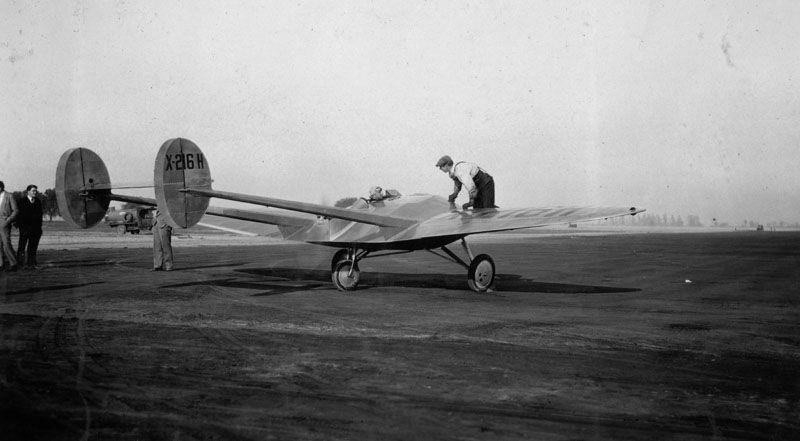 |
|
| (1929)* - The Northrop "Flight Wing" X-216H at United Airport (Bob Hope Airport) in Burbank |
Historical Notes Jack Northrop, who designed the plane, felt that going with an all-wing aircraft would significantly increase overall performance. By 1929 he had produced the X-216H which, while it still used a small twin-boom tail, included a more refined wing and became the first successful example of an all-wing plane.* |
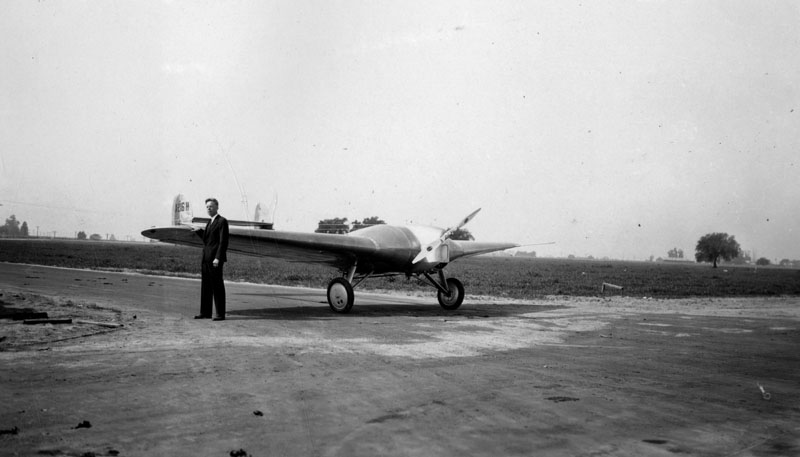 |
|
| (1930)* - Jack Northrop stands next to his "Flight Wing" X-216H at United Airport in Burbank. |
Historical Notes John Knudsen "Jack" Northrop (1895-1981) was an American aircraft industrialist and designer, who founded the Northrop Corporation in 1939.*^ |
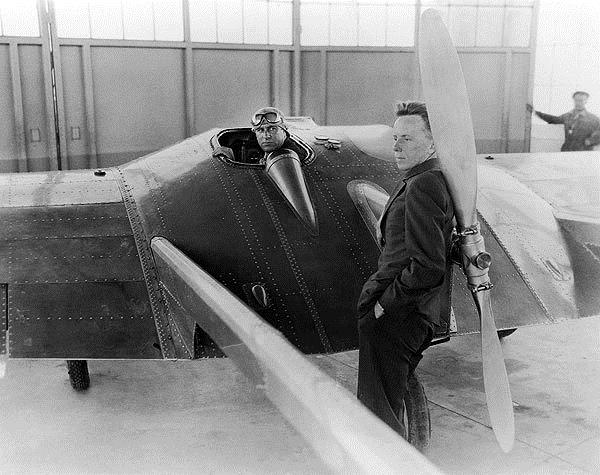 |
|
| (1929) - Northrop Aircraft Co. founder Jack Northrop, right, and pilot Edward Bellande in 1929 with the original "flying wing," a design that evolved into the B-2 stealth bomber decades later |
Historical Notes Jack Northrop's career began in 1916 as a draftsman for Loughead Aircraft Manufacturing Company. He joined the Douglas Aircraft Company in 1923, where in time he became a project engineer. In 1927 he rejoined Lockheed, where he was a chief engineer on the Lockheed Vega transport. He left in 1929 to found Avion Corporation, which he sold in 1930. Two years later he founded the Northrop Corporation. This firm became a subsidiary of Douglas Aircraft in 1939, so he co-founded a second company named Northrop.*^ |
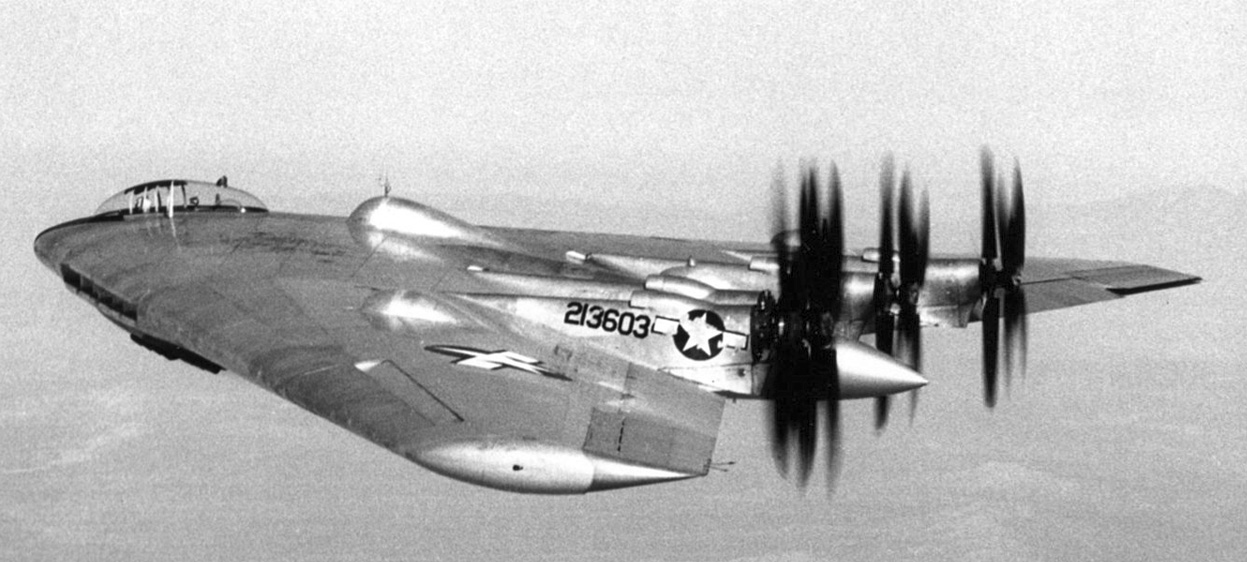 |
|
| (1946)#** - Northrop's Flying Wing Bomber known as the XB-35 in flight in 1946. The XB-35 was an experimental heavy bomber developed for the U.S. Army Air Force during World War II. |
Historical Notes The Northrop XB-35 and YB-35 were experimental heavy bomber aircraft developed by the Northrop Corporation for the United States Army Air Forces during and shortly after World War II. The airplane used the radical and potentially very efficient flying wing design, in which the tail section and fuselage are eliminated and all payload is carried in a thick wing. Only prototype and pre-production aircraft were built, although interest remained strong enough to warrant further development of the design as a jet bomber, under the designation YB-49.*^ |
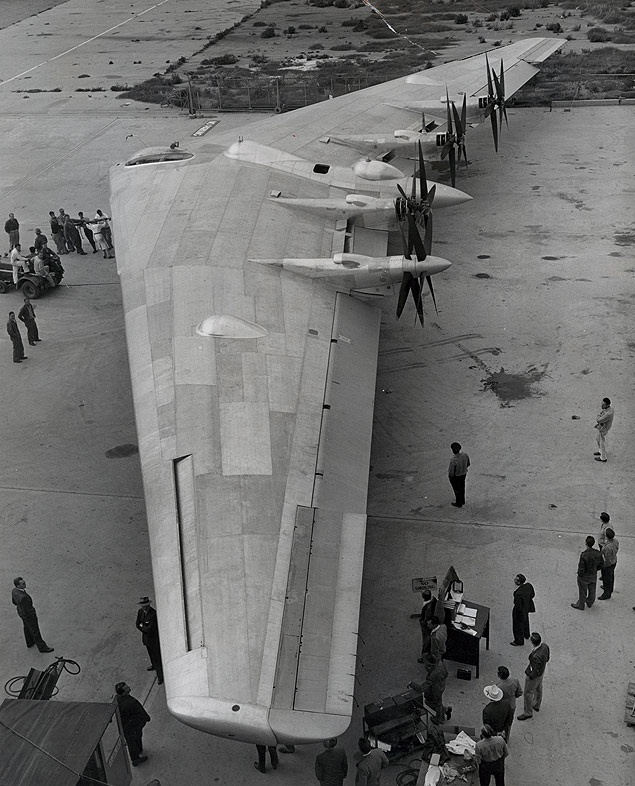 |
|
| (1946)*** - View of the YB-35 prototype, considered to be the "Grandpa" of the B-2 Bomber. It was designed by Jack Northrop and had its first flight on June 25, 1946. |
 |
|
| (1947)** - Head on view of Northrop Flying Wing (YB-49) powered by eight jet engines. Photo taken on aircraft's introduction to the public and media. This photo, a panorama made with three prints, was published in the Sep. 30, 1947 Los Angeles Times |
Historical Notes The Northrop YB-49 was a prototype jet-powered heavy bomber aircraft developed by Northrop shortly after World War II. Intended for service with the U.S. Air Force, the YB-49 featured a flying wing design. It was a jet-powered development of the earlier, piston-engined Northrop XB-35 and YB-35; the two YB-49s actually built were both converted YB-35 test aircraft.^#^ |
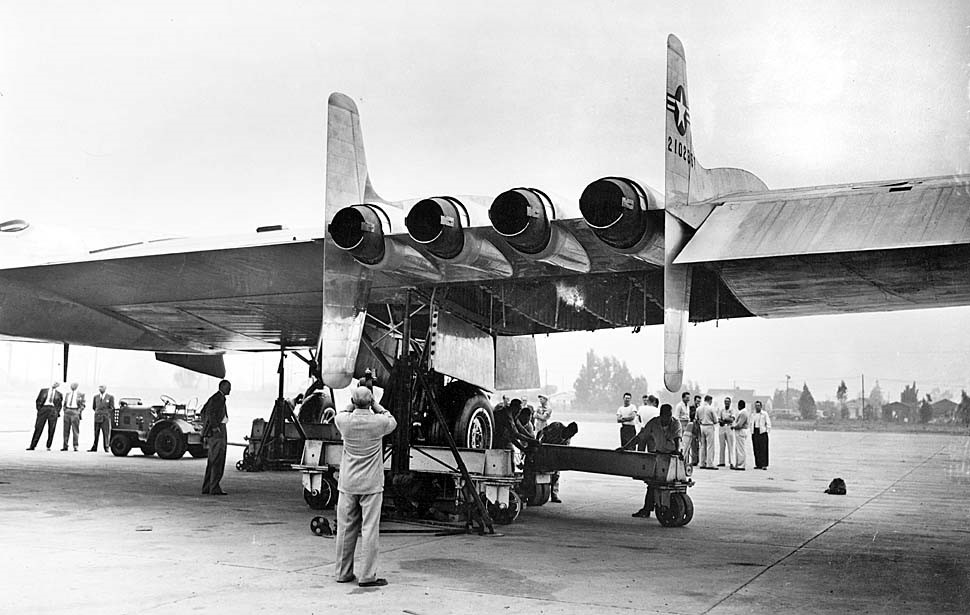 |
|
| (1947)** - Visitors take a close-up look at the Northrop YB-49 Flying Wing during its unveiling. |
Historical Notes The jet engines are mounted in fours, with the black-mouthed exhaust ports jutting from the training edge like stub-barreled cannon. And flanking both engine banks are four vertical fins, or air separators, to give the giant air ship the same directional stability afforded by the whirling propellers of the original Flying Wing. |
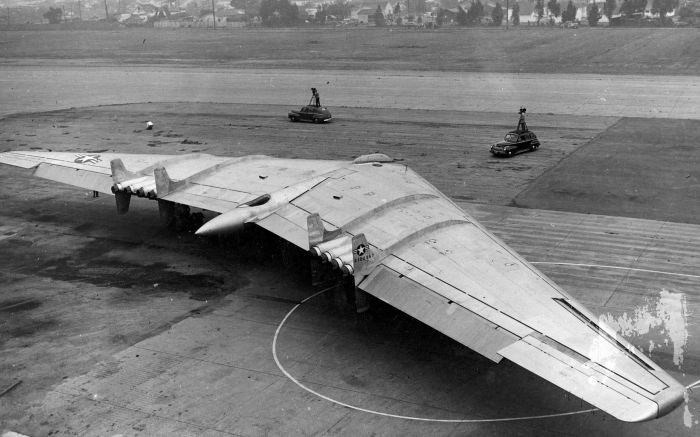 |
|
| (1947)^#^ - Two camera crews with photographers standing on top of their cars take photos during the unveiling of the new Northrop YB-49 Bomber. |
Historical Notes Patterned after the conventionally powered B-35 Flying Wing, the huge silver boomerang was powered with eight J-35 turbo-jet engines developing (in thrust) the equivalent of 32,000 h.p. at a sea level 375 m.p.h. |
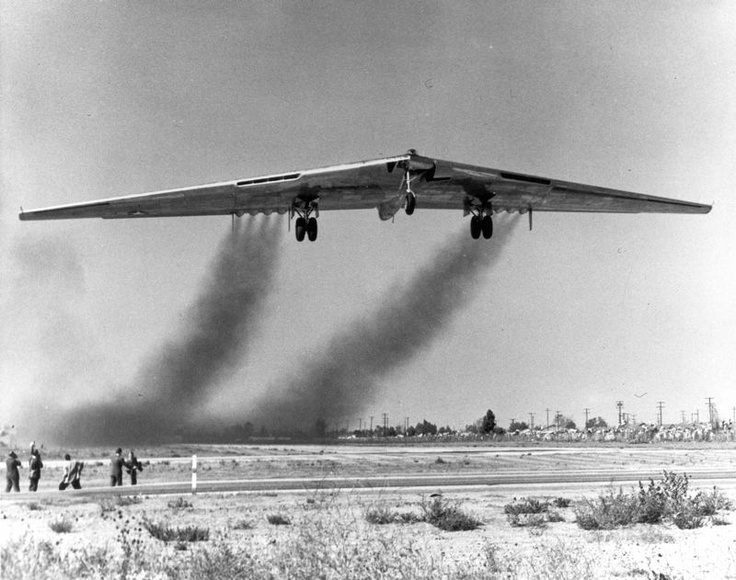 |
|
| (1947)*** - YB-49 Flying wing, a heavy bomber prototype, takes to the air for the first time in 1947. |
Historical Notes The YB-49 never entered production, being passed over in favor of the more conventional Convair B-36 Peacemaker piston-driven design. Design work performed in the development of the YB-35 and YB-49 nonetheless proved to be valuable to Northrop in the eventual development of the current day B-2 Spirit strategic bomber which first entered operational service in the 1990s.^#^ |
_1947.jpg) |
|
| (1947)^#^ - A Northrop YB-49 Bomber on its test flight over the desert. |
Historical Notes Paramount Studios' 1953 film, The War of the Worlds incorporates Northrop color footage of a YB-49 test flight, originally used in Paramount's Popular Science theatrical shorts of the era; in the George Pal film the Flying Wing is used to drop an atomic bomb on the invading Martians.^#^ |
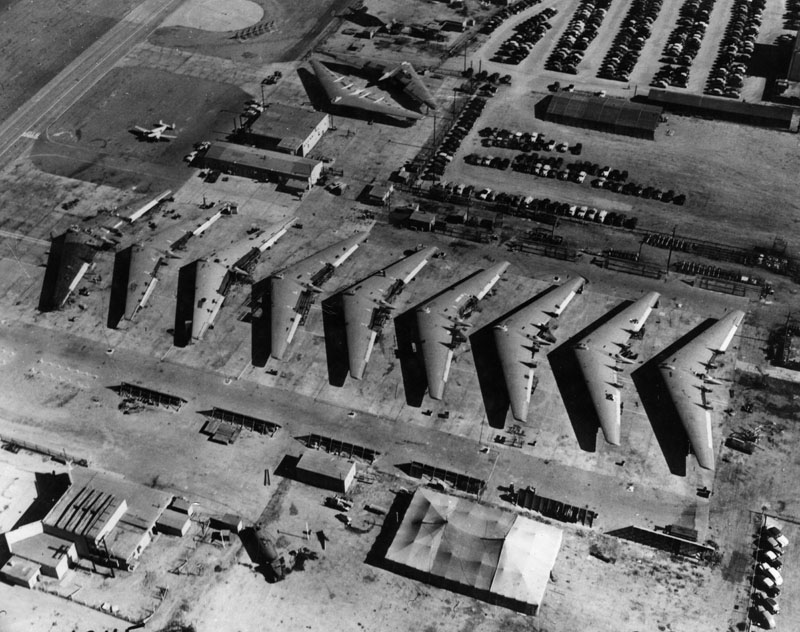 |
|
| (1949)* - Aerial view of Flying Wing planes, the Northrop XB-35, at the Northrop plant in Hawthorne. |
Historical Notes In the end, the program was terminated due to its technical difficulties, the obsolescence of its reciprocating propeller engines, and the program being far behind schedule and over budget. Another contributing factor to the program's failure was the tendency of Northrop to become engaged in many experimental programs, which spread its small engineering staff far too wide. While the competing propeller-driven B-36 was obsolete by that time and had just as many or even more development problems, the Air Force needed a very long range, post-war atomic bomber to counter the perceived Soviet threat. It had more faith that the B-36's "teething" problems could be overcome, compared to those of the new and radical "Flying Wing", the unofficial name that was later associated with all the Northrop "all-wing" designs.*^ |
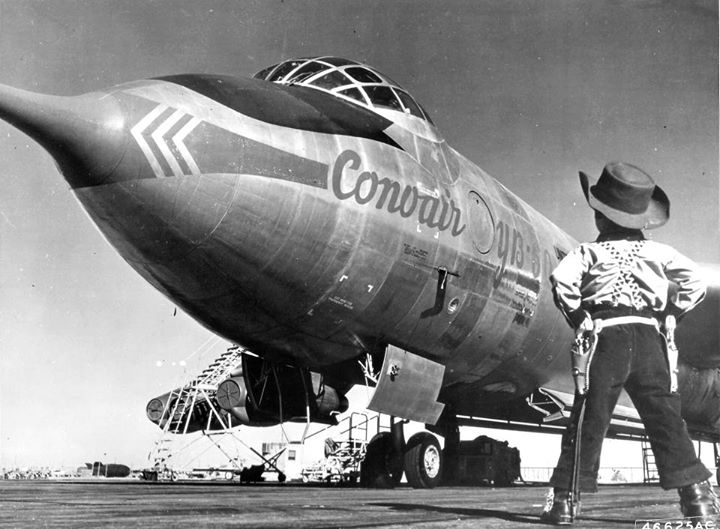 |
|
| (1953)^## - A young “cowboy”, the son of a member of the Air Force Flight Test Center, Edwards Air Force Base, California, looks over the Convair built YB-60 during its visit at Edwards from the Fort Worth, Texas, plant. |
Historical Notes The YB60 was a jet-powered prototype version of the Convair B-36 Peacemaker. Both planes – being integral to the defense of America during The Cold War – were designed to carry nuclear weapons. While the B-36 enjoyed a fairly long career (1946 to 1959), the YB60 never got past experimental stage.^## |
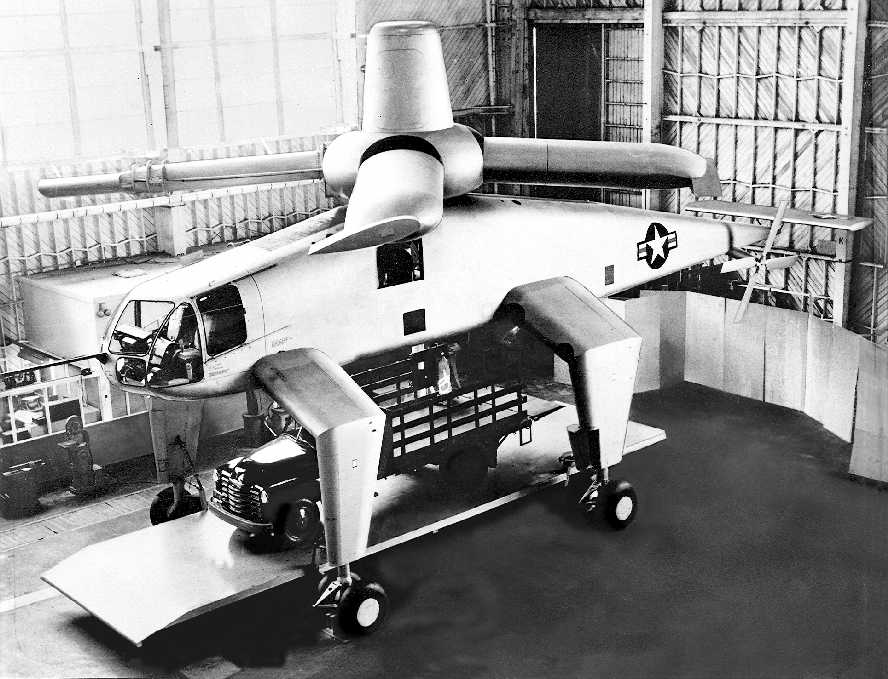 |
|
| (ca. 1954)*# - View of the full-size mockup of the massive Hughes XH-28 helicopter, pictured inside the former Spruce Goose assembly hangar at Hughes Culver City, shown straddling a cargo platform carrying a truck. |
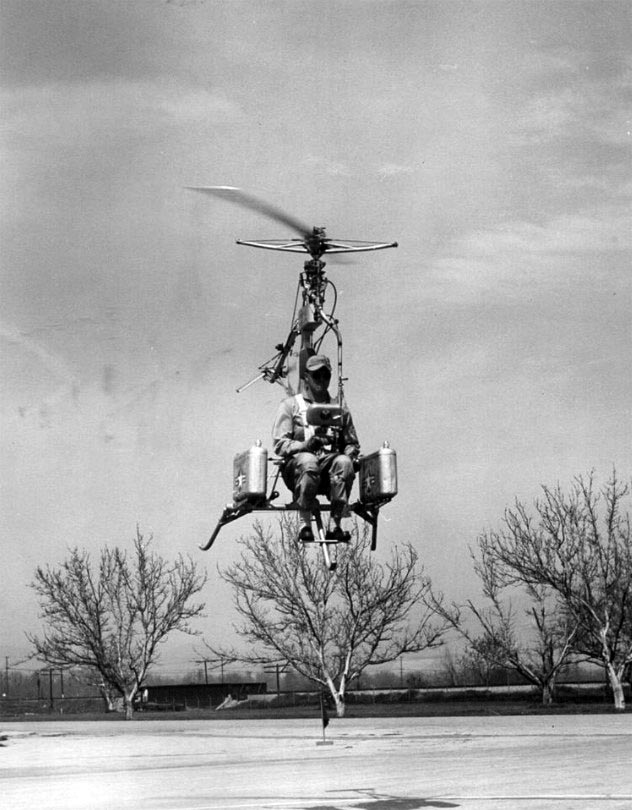 |
|
| (1950s)#^^* – View of a one-man helicopter! This unique “go-anywhere vehicle” made by Rotor-craft for military personnel, made demonstration flights back in the 1950s at Van Nuys Airport. |
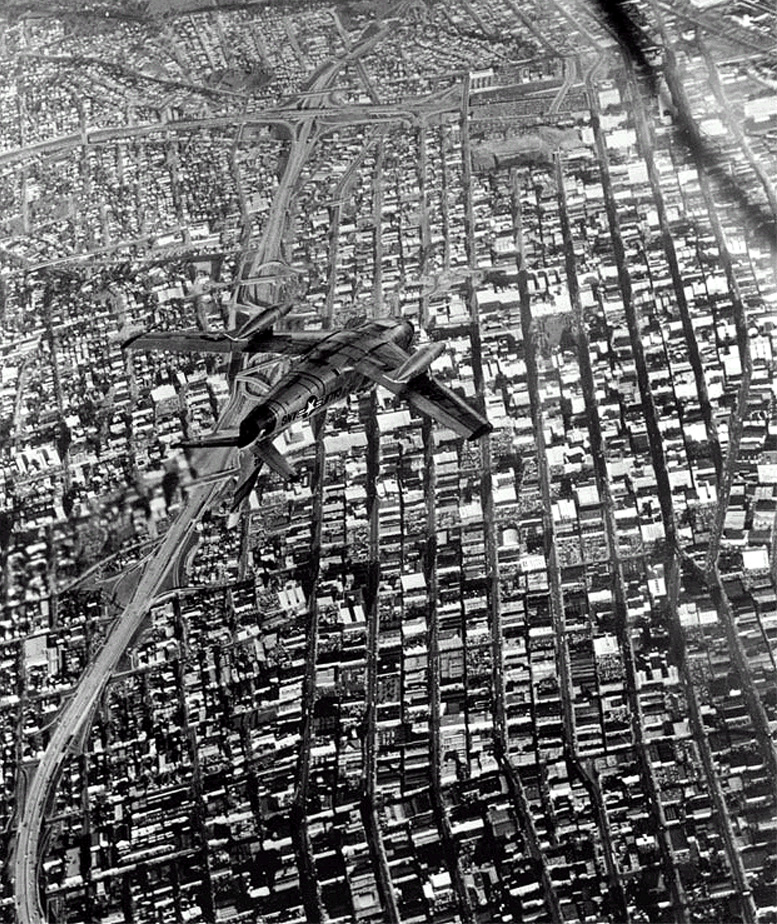 |
|
| (1954)* - Aerial view looking north of an upside down Air Force fighter plane flying over downtown Los Angeles. City Hall can faintly be seen in the upper right corner of the photo. |
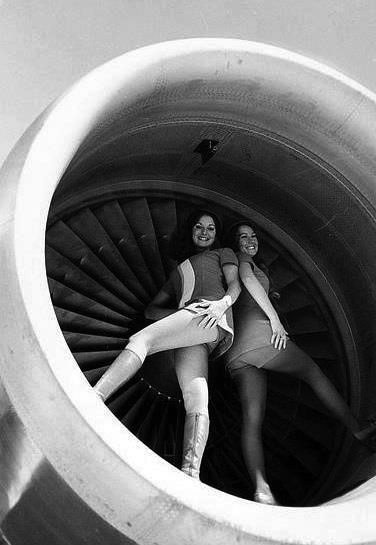 |
(ca. 1968)^.^ - Hot Engine Accessories. Stewardesses from Pacific Southwest Airlines pose in front of an L-1011 TriStar engine to promote their new uniforms of cotton-candy pink, tangelo red, and pumpkin orange; designed to match the colored stripes of PSA's "Smiling Aircrafts". |
|
Historical Notes The first stewardesses were actually nurses hired to make passengers feel safer. Women who wanted to be “sky girls” had to meet strict requirements. In addition to being single, they had to be under 25 years of age, under 5-feet-5 and under 116 pounds. Not only did they tend to passengers, they were also expected to haul luggage, fuel the plane and help pilots push the plane into the hanger after flights. "Stewardess" was replaced with the term: "flight attendant" in the 70s.* |
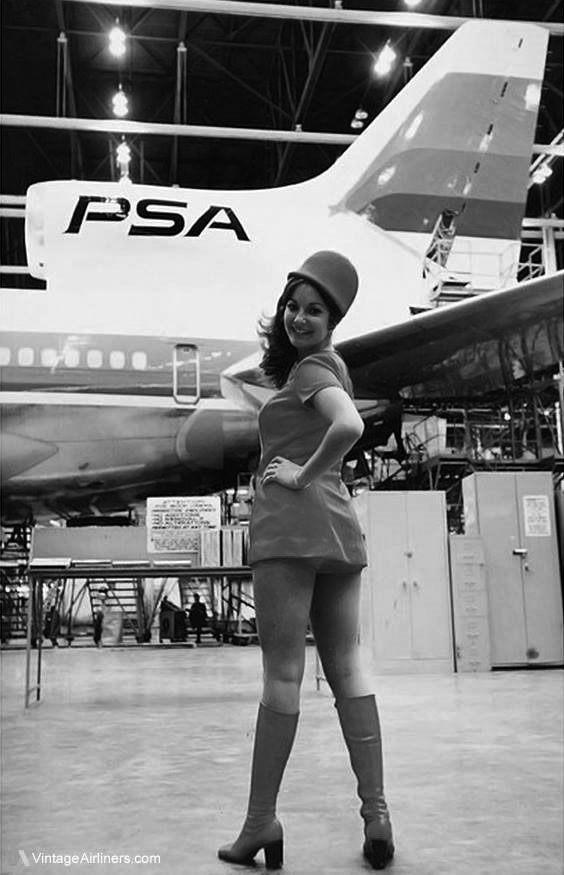 |
(ca. 1968)* - Stewardess from Pacific Southwest Airlines poses in front of an L-1011 TriStar to promote the company’s new uniforms. “That’s a very nice L-1011 in the background…” |
|
Historical Notes Between 1968 and 1984, Lockheed manufactured a total of 250 TriStars. The aircraft's sales were hampered by two years of delays due to developmental and financial problems at Rolls-Royce, the sole manufacturer of the TriStar's engines. After production ended, Lockheed withdrew from the commercial aircraft business due to its below-target sales. |
* * * * * |
Glendale Airport (Grand Central Airport)
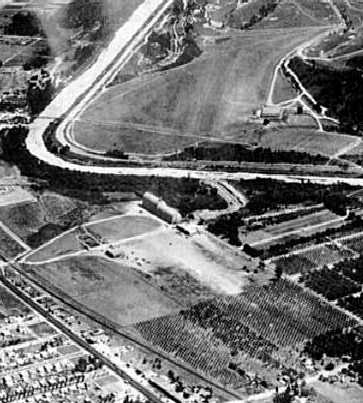 |
(1927)*# – Aerial view looking southeast showing the Glendale Airport field in an early configuration with a smaller border (bottom of photo). Note the peach orchard forming the northern border at lower-right. The Slate Aircraft Corporation dirigible hangar is visible on the south side of the field (center) and Griffith Park Airport is visible across the river.
|
Historical Notes In 1922—with prompting from the Aero Club of California, returning World War I pilots and local aviation enthusiasts who wanted to get in on the exciting new world of flying—the Glendale Chamber of Commerce purchased 33 acres adjacent to the Southern Pacific Railroad tracks, directly across the river from the Griffith Airdrome. They cleared a 1,200-ft. runway for the Glendale Municipal Airport. It opened in March 1923. Soon after clearing the field, objections were raised for the City’s plans, and a bond issue was unsuccessful, so citizen supporters, led by Dr. Thomas Young, got together to form the Glendale Airport Association. This group bought the City out, and Glendale finally had an official airport. The first hangar built at Glendale Airport was for the Kinner Airplane & Motor Corporation. Bert Kinner built Amelia Earhart’s first airplane, the Kinner Airster, in 1923. He also manufactured the first government-certified aircraft engine in 1928. |
.jpg) |
|
| (1927)*# – View showing three biplanes and one monoplane in front of the Wilson Aero Corporation hangar, with the Slate Aircraft Corporation dirigible hangar also visible on the left. |
Historical Notes The concept for this airport probably began with Leslie Coombs Brand (1859–1925), a major figure in the settlement and economic growth of the Glendale area. He had purchased land on the lower slopes of Mount Verdugo overlooking the city, and in 1904 built an imposing residence that became known as Brand Castle (which today houses the Brand Library). Just across the mostly dry Los Angeles River he could see the Griffith Park Aerodrome's grass field, built in 1912. Just three years later he decided to build his own grass airstrip below his mansion (Brand Field). He built his first hangar in 1916 and put together a fleet of planes, and held fly-in parties. The only requirement was that guests had to arrive in their own planes and bring passengers. |
* * * * * |
Slate Dirigible
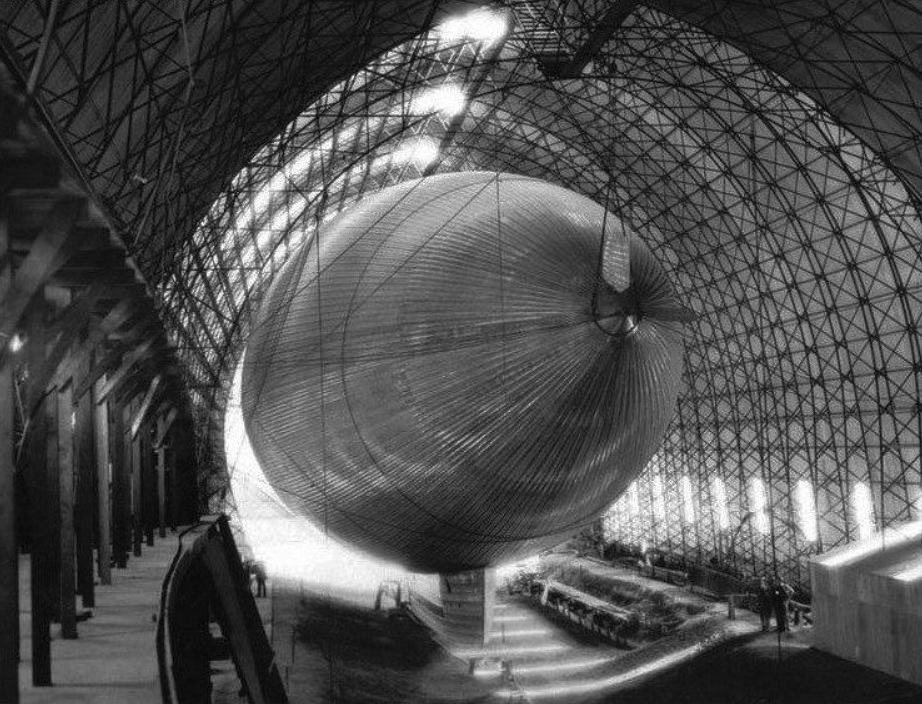 |
|
| (1928)* - The Slate Dirigible is docked in its hanagar at Glendale Airport. At the time, this was the largest built metal hangar in the United States. |
Historical Notes In 1925, Thomas Slate leased space adjacent to the south side of the Glendale Airport for the construction of an all-metal dirigible, a very novel (but ultimately unsuccessful) design. The dirigible was made out of duralumin & was filled with hydrogen. It was forecast to have a cruising speed of 80 mph and would accommodate 40 passengers and 5 crew. The dirigible was to be powered by oil and driven by steam-turbine, using one rotary blower, which would create a vacuum, instead of traditional propellers. Slate also constructed a metal hangar, the largest built in the United States at the time.* |
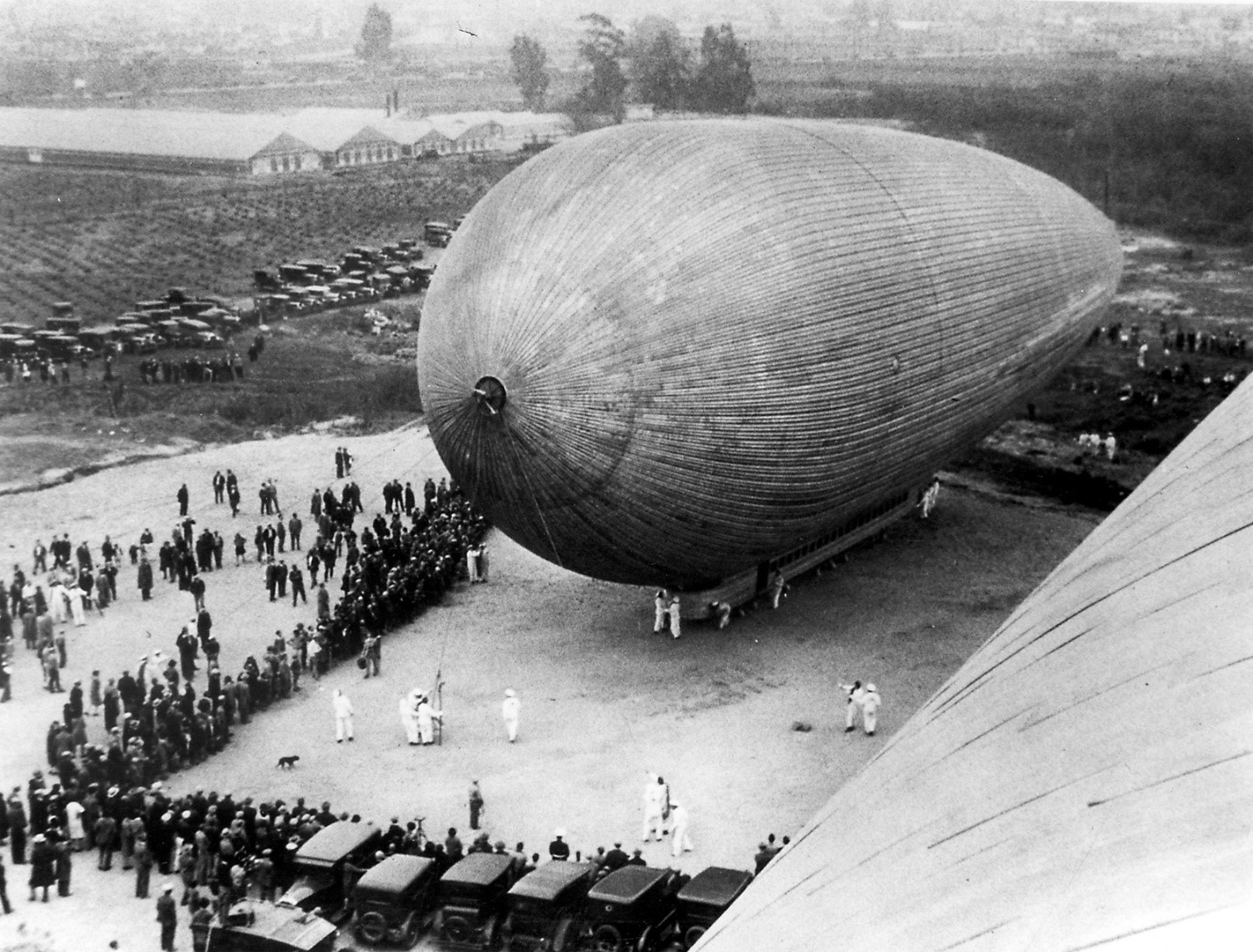 |
|
| (1929)*– Large crowd surrounds a Slate Dirigible at Glendale Airport. |
Historical Notes Dec. 19, 1929- Thomas Benton-Slate was an entrepreneur who invented dry-ice. This day in the suburb of Glendale, he attempted to fly the first all metal dirigible, the City of Glendale. He brought it out two days ago and it immediately began to pop rivets in the heat and fall apart. So he brought it in for repairs. This day he tried one more time, but the sun’s heat expanded the shell, causing rivets to pop again, followed by a metallic explosion and escaping gas. He had it dragged back into the hanger and forgot about it. * |
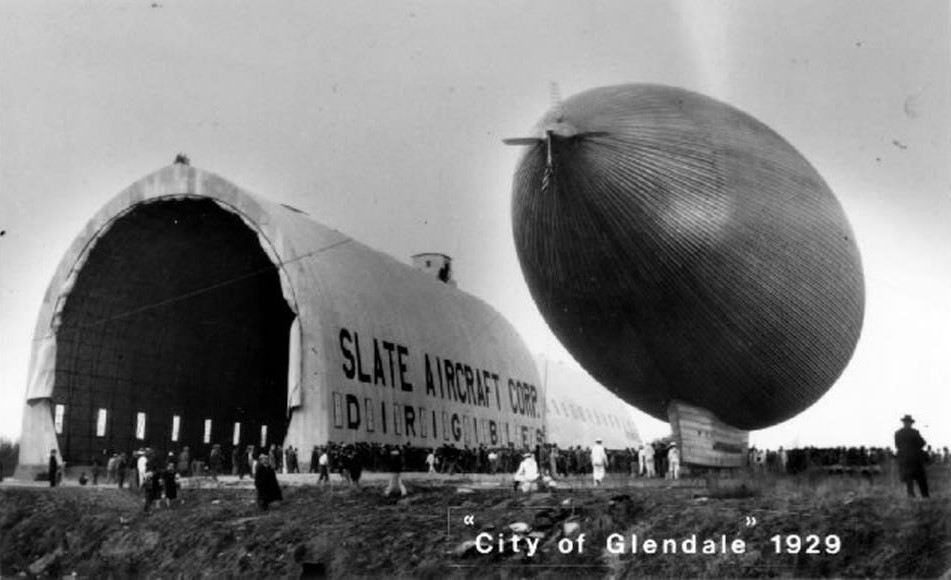 |
|
| (1929)* - Thomas Benton-Slate’s dirigible outside its hangar. |
* * * * * |
Glendale Airport (Grand Municpal Airpot)
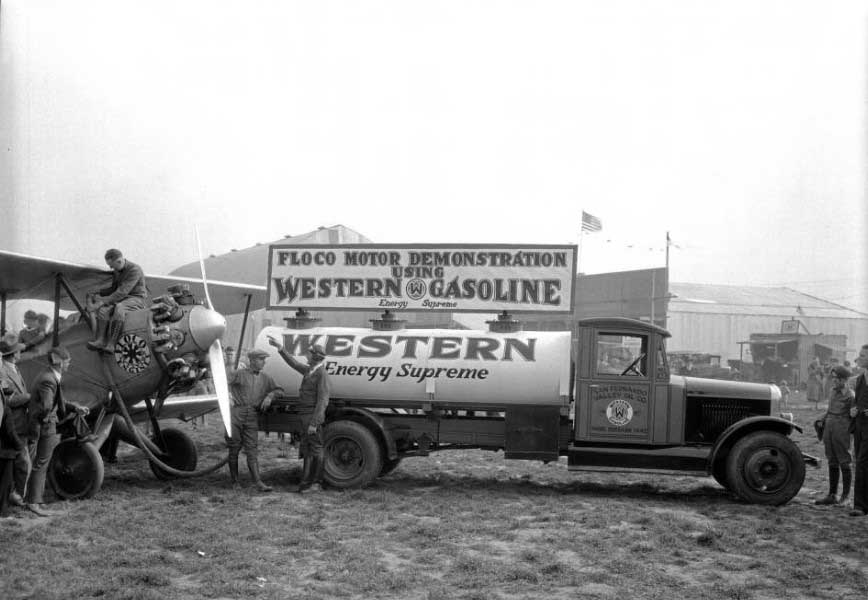 |
|
| (1928)#* - Men refuel a biplane at the Glendale Airport. A sign on the top of the fuel truck reads "Floco motor demonstration using Western Gasoline : energy supreme". The truck has the business's name, San Fernando Valley Oil Co., painted on the side of the cab. Photo by "Dick" Whittington |
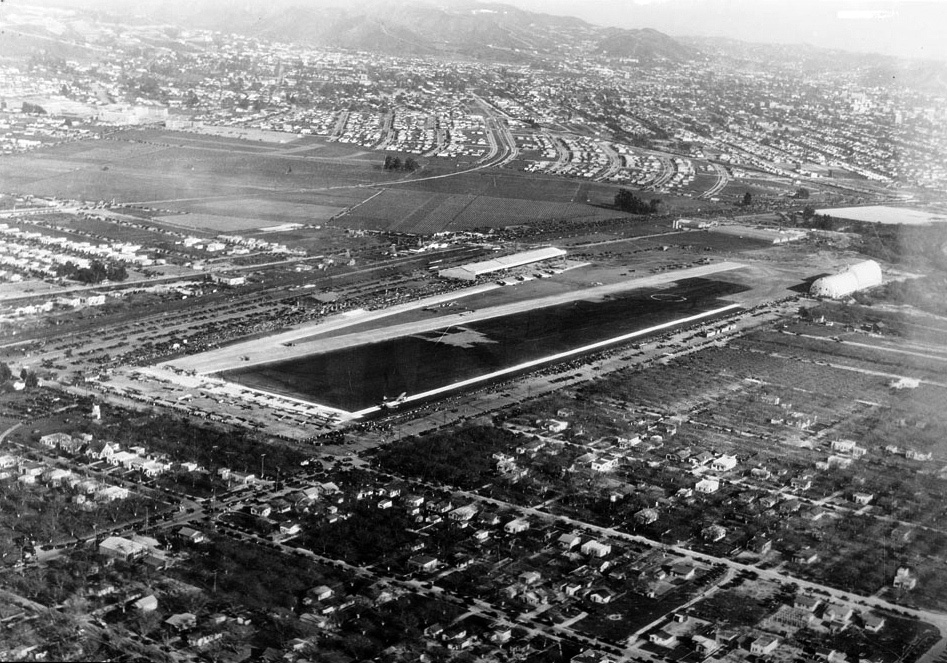 |
|
| (1929)^* - Aerial view of Grand Central Air Terminal, Glendale, 1929. The airfield can be seen at center and a single runway is visible. Hundreds of cars can be seen parked near the runway at left, and planes are visible on the taxiways. Closely spaced houses can be seen in the foreground and in the background. |
Historical Notes The Glendale Municipal Airport was renamed "Grand Central Air Terminal" (GCAT) when it was purchased by other venture capitalists, who expanded it to 175 acres. On February 22, 1929 a terminal with a control tower had been built, and was opened to much fanfare. Designed by Henry L. Gogerty, the intention was to construct an air terminal along the lines of a classic railroad terminal. It combined a style consisting of Spanish Colonial Revival with Zig-zag Moderne influences (Art Deco). GCAT became a major airport of entry to Los Angeles and provided the first paved runway west of the Rocky Mountains. Within a year, the entire enterprise was sold to a group calling itself the Curtiss-Wright Flying Service, managed by Major Corliss C. Moseley, a co-founder of the future Western Airlines. It became the city's largest employer. |
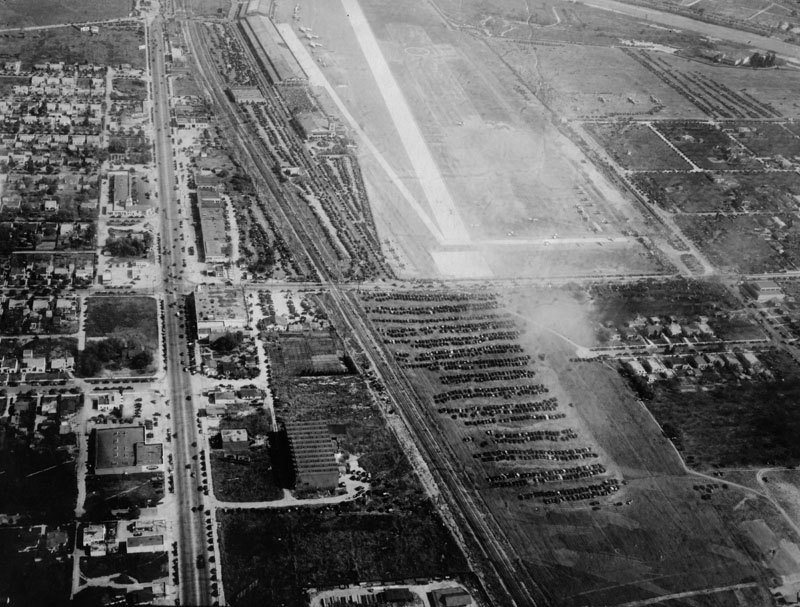 |
|
| (ca. 1929)* - Aerial view of Grand Central Aiport in Glendale on U.S. Army Air Force Day. Planes are parked in front of hangers and on the field. A large number of cars are parked on a field below the airport. A crowd stands between the Grand Central Air Terminal building and the hangars. |
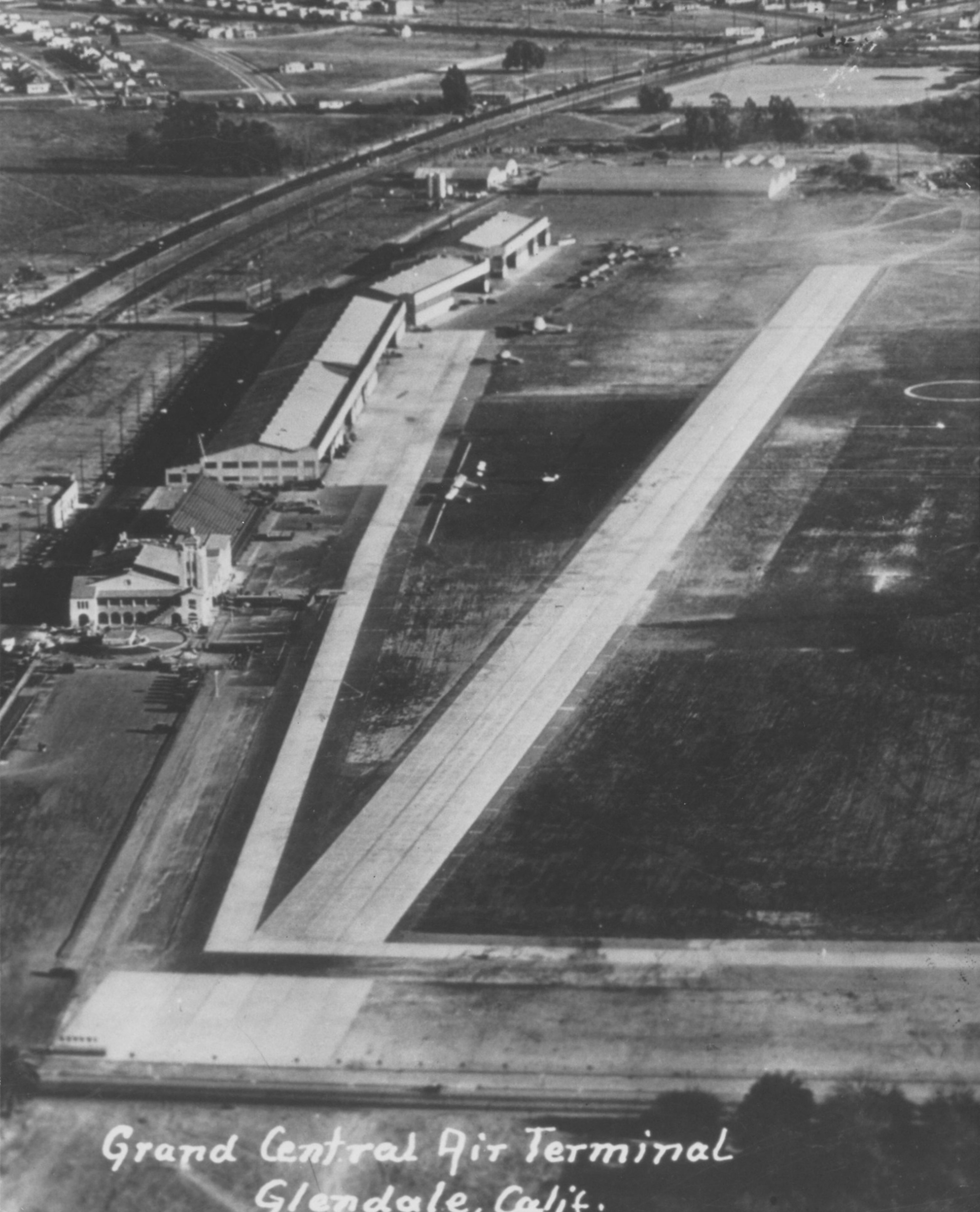 |
|
| (ca. 1930)* - Close-up arial showing Grand Central Aiport and Terminal. |
.jpg) |
|
| (ca. 1930s)^* - Birdseye view of a crowd along the runway at the Grand Central Air Terminal in Glendale. The runway goes from the foreground at right to the background at left. A large crowd of people can be seen around the entire periphery of the runway. It appears that they're waiting to see an air show. |
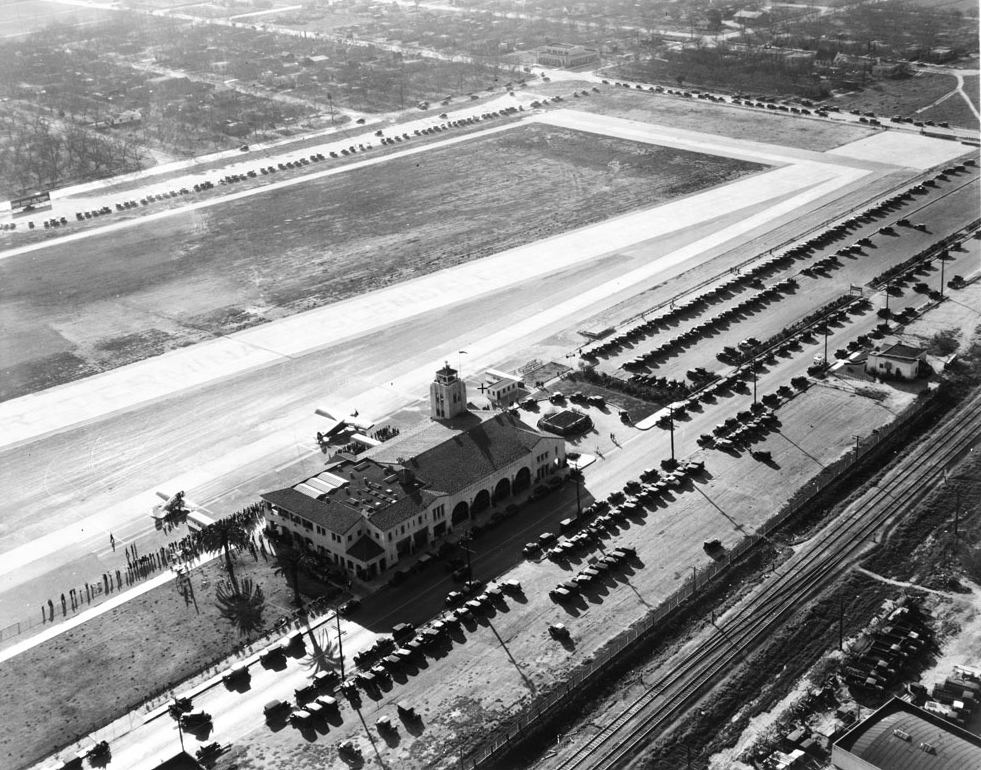 |
|
| (1932)^* - Aerial view of Grand Central Airport in Glendale, February 28, 1932. The terminal is at center and is a large, rectangular, mission-style structure. A tall control tower sticks up from the upper right corner. Two small aircraft are parked directly in front of the terminal, and hundreds of automobiles are parked in a lot behind the terminal. Many people are lined up near the aircraft. The runway is at center and borders a large dirt field. In the distance at left, a neatly arranged neighborhood is visible, while railroad tracks can be seen in the foreground at right. |
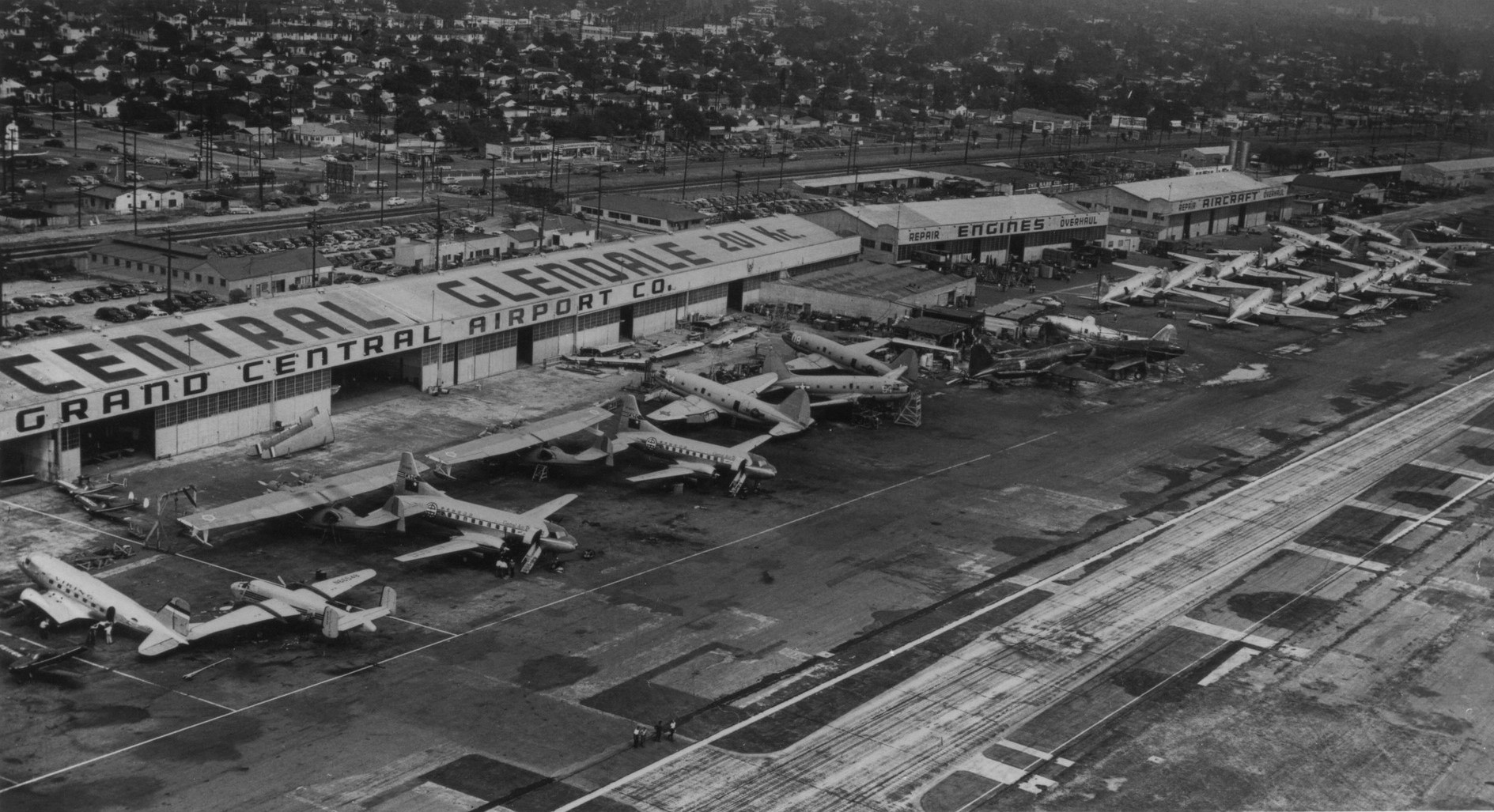 |
|
| (ca. 1940s)* - Glendale Central Air Terminal with passenger planes |
Historical Notes In 1947 the runway was cut back to 3,800' (southeast of Sonora Ave) due to pressure from local government. The airport was returned to private use, renamed Grand Central Airport, ceased to be profitable, and was closed in 1959 to make way for the development of the Grand Central Business Park, which today houses corporate offices of the Walt Disney Company as well as the headquarters for Walt Disney Imagineering. For a number of years the Southwest corner was used as a commercial helicopter base. That space is now occupied by the DreamWorks Animation SKG production company. The city of Glendale retains some interest in aviation, for it is part owner of the Bob Hope Airport (formerly "Burbank-Glendale-Pasadena Airport"). |
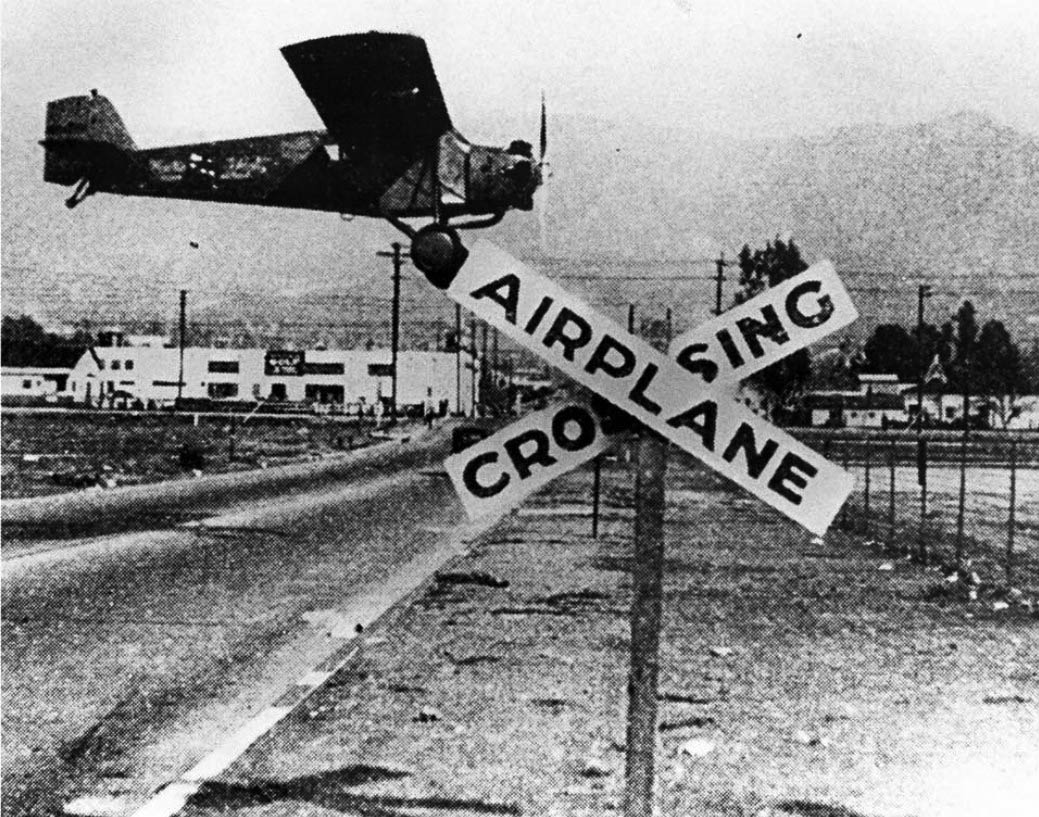 |
|
| (1930)*- Airplane Crossing sign at Grand Central Airport in Glendale. |
* * * * * |
Grand Central Terminal
 |
|
| (ca. 1930)* – Postcard view showing the Administration Building at the Grand Central Airport in Glendale. A small airplane numbered NC-8413 is in front of the building. |
Historical Notes The Grand Central Airport Terminal was designed by Henry L. Gogerty in 1928 blending the Spanish Colonial Revival style with Art Deco influences. The Airport first began its service between Los Angeles and New York, and it played a vital role as the premier airport in Southern California. The building represents the simple concept of early airport terminal design, and it is listed on the Glendale Register of Historic Resources. The airplane shown in this image was a Ford 4-AT Tri-motor owned by the Maddux Air Lines, which carried 12 passengers from San Diego to Los Angeles during its inaugural flight in California. |
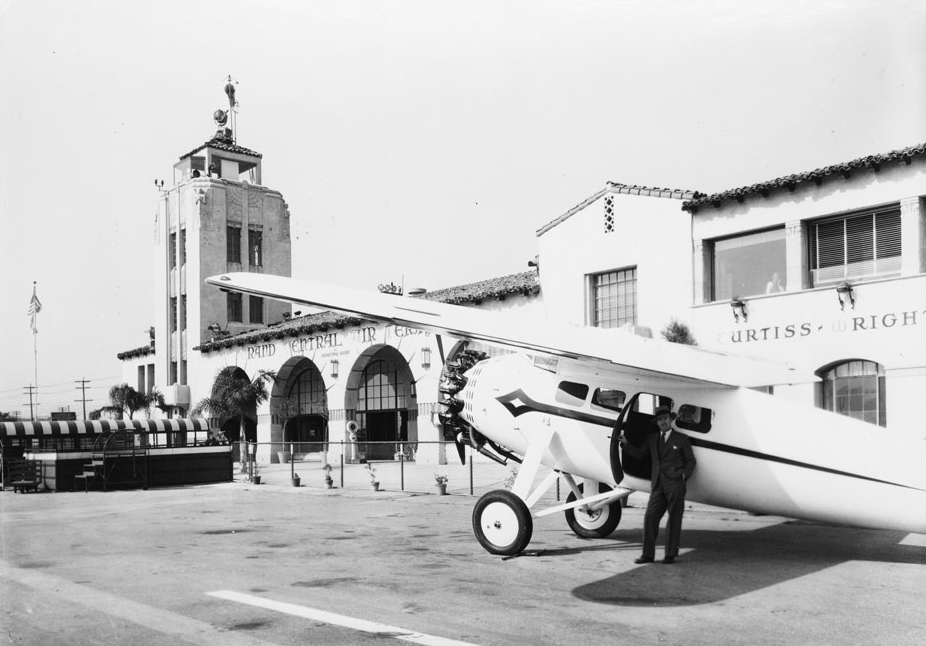 |
|
| (ca. 1930s)^* - Photograph of a radial-engine airplane outside the Grand Central Airport. The high-wing monoplane can be seen in the foreground at right, and a man in a suit is visible near an open door under the wing. The Spanish-style air terminal can be seen in the background. It is a two-story structure with a terracotta tile roof. In the background at left, a tall rectangular control tower is visible. Legible signs include "Grand Central Air Terminal" and "Curtiss-Wright". |
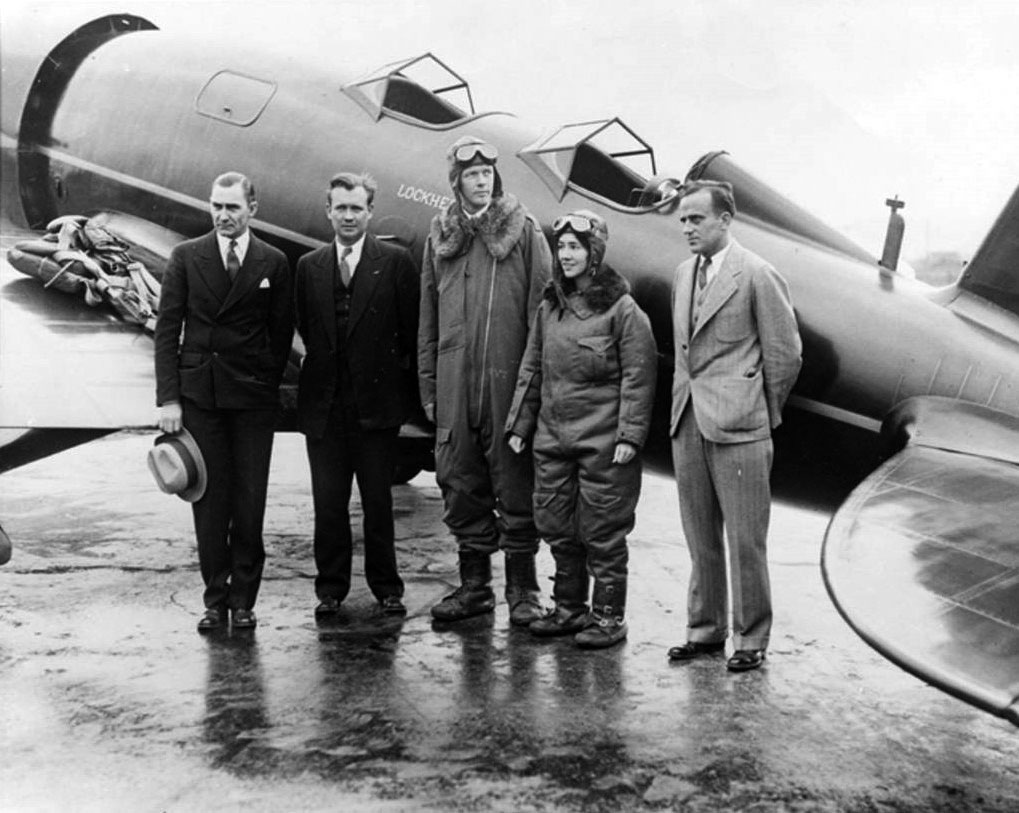 |
|
| (1930)^ – View of Charles A. Lindbergh and his co-pilot/navigator, Anne Lindbergh beside their Sirius, built according to the specifications of Lindbergh, by Lockheed. |
Historical Notes On Easter, 1930, Colonel Lindbergh and his wife, Anne, took off from Glendale (Calif.), bundled up in their bulky, electrically heated flying suits, to test the advantages of weather at high altitudes, and to set new transcontinental records. The sliding canopies, covering both formerly open cockpits, were suggested by Mrs. Lindbergh, who set a women's record for coast to coast flights on this first Lockheed Sirius. The sliding canopies were later put into common use. While the ship was being built, Lindbergh, shy of publicity, was secluded from hero-worshippers in the Hamilton Propeller Shop at the Burbank Field. He seemed happy and relaxed working quietly along with the mechanics. Some who were there have left stories of their admiration for this warm, friendly man, a perfectionist, interested in everything concerning his plane. They fondly told how he politely by-passed invitations from Very Important People, and went to lunch day after day with the crew. On occasions, Mrs. Lindbergh waited for her husband to finish his work in their car, parked in the shade of the hangar. The working crew would bring her sandwiches and cold drinks from the lunchroom nearby. The photograph was probably taken in Glendale, but it is a Lockheed plane, made in Burbank.^ |
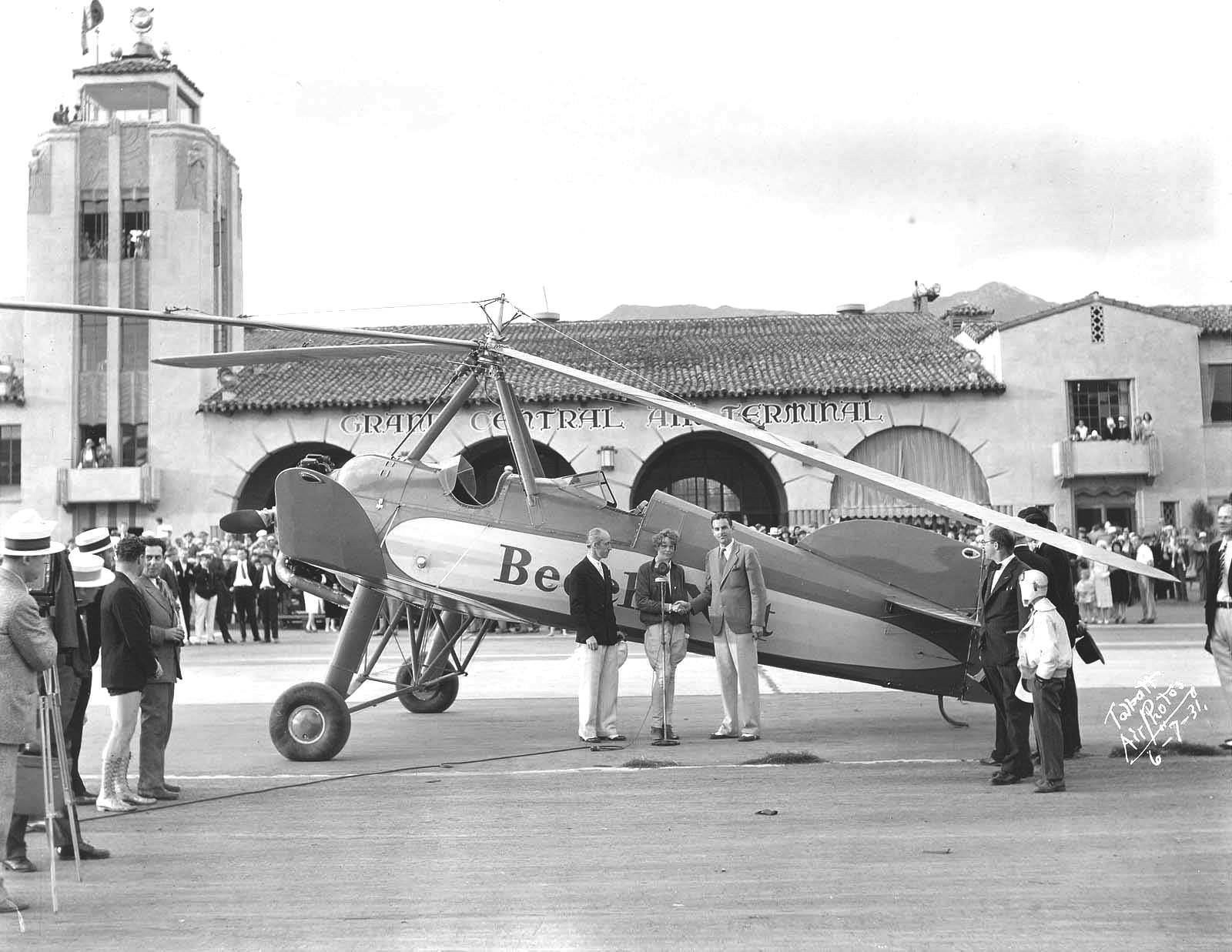 |
|
| (1931)** - Amelia Earhart with the Beech-Nut Pitcairn PCA-2 Autogiro at Glendale Grand Central Air Terminal on June 7, 1931. Earhart arrived from PA on what she thought was the first transcontinental Autogiro flight only to discover that John M. "Johnny" Miller had beaten her by 9 days. |
Historical Notes The PCA-2 was the first rotary-wing aircraft to achieve type certification in the United States and was used in a number of high-profile activities including a landing on the White House lawn and the first flight across the United States in a rotorcraft. This latter feat was attempted by Amelia Earhart, flying for the Beech-Nut food company, but was actually accomplished by John M Miller who completed his flight nine days before Earhart on 28 May 1931, in his PCA-2 named Missing Link. Learning of Miller's achievement upon her arrival in California, Earhart set out to turn her flight into a round-trip record by flying east again, but abandoned the attempt after three crashes. Earhart set an altitude record in a PCA-2 on 8 April 1931 with a height of 18,415 ft. This record was broken in another PCA-2 by Lewis Yancey who flew to 21,500 ft on 25 September 1932. ^ |
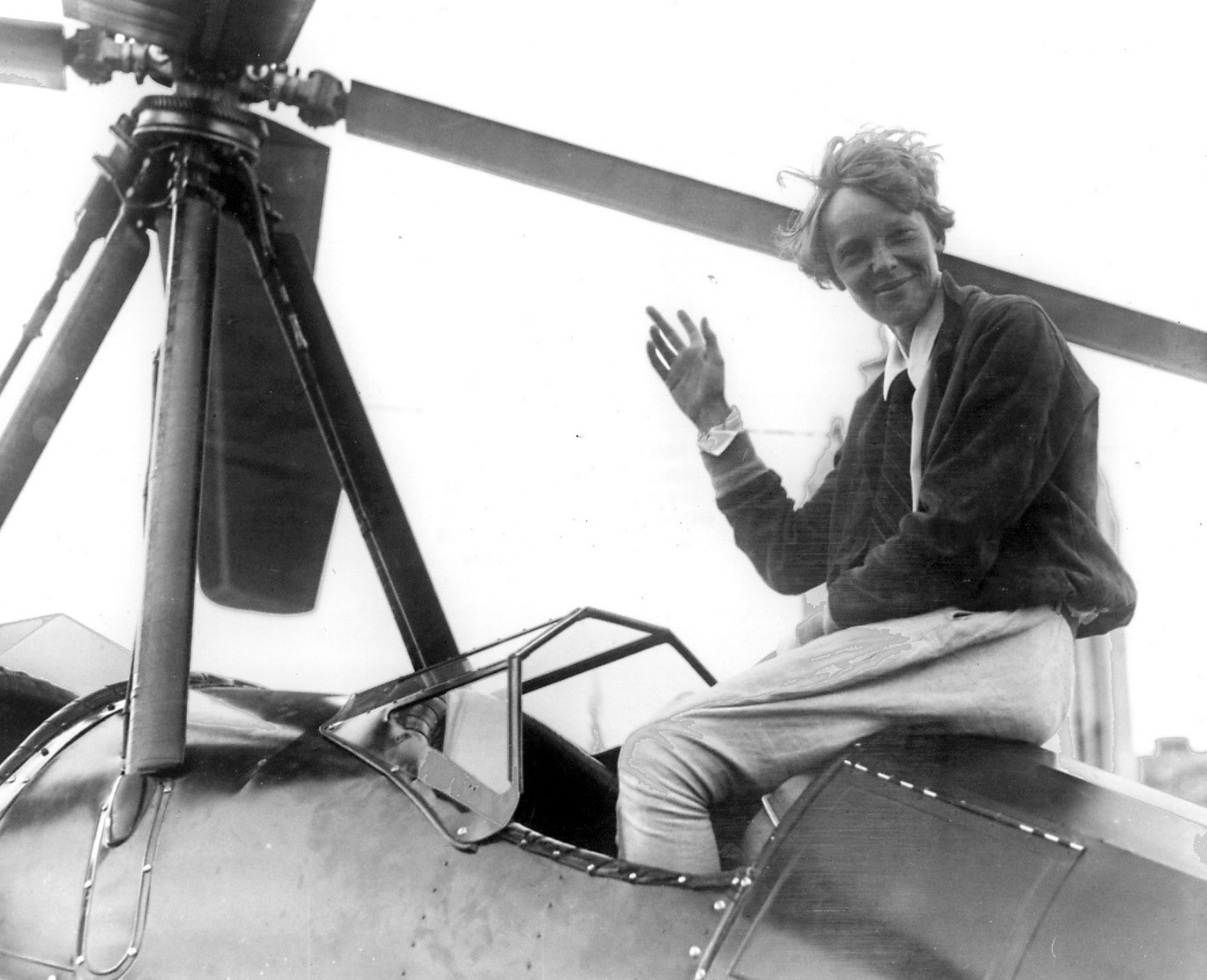 |
|
| (1931)+## - Amelia Earhart is seen sitting on plane mounted with a horizontal propeller (Pitcairn PCA-2 Autogiro) at Grand Central Airport. |
Historical Notes Amelia Earhart became famous when she was the first female aviator to fly solo across the Atlantic Ocean in 1928, so it was newsworthy when she landed an autogiro (which is kind of like a helicopter) at Grand Central Air Terminal, Glendale on June 7, 1931. At the time she was attempting the first transcontinental autogiro flight from Newark, NJ to Los Angeles, and landed at about 5 p.m. to replenish her gas supply. At the time, Grand Central was a busy and important airport, and due to its eye-pleasing design and proximity to the movie studios, was often used in the movies. |
 |
|
| (ca. 1931)^*# - Plane being refueled by a tank truck labeled Union Motor Oil, at Grand Central Airport. |
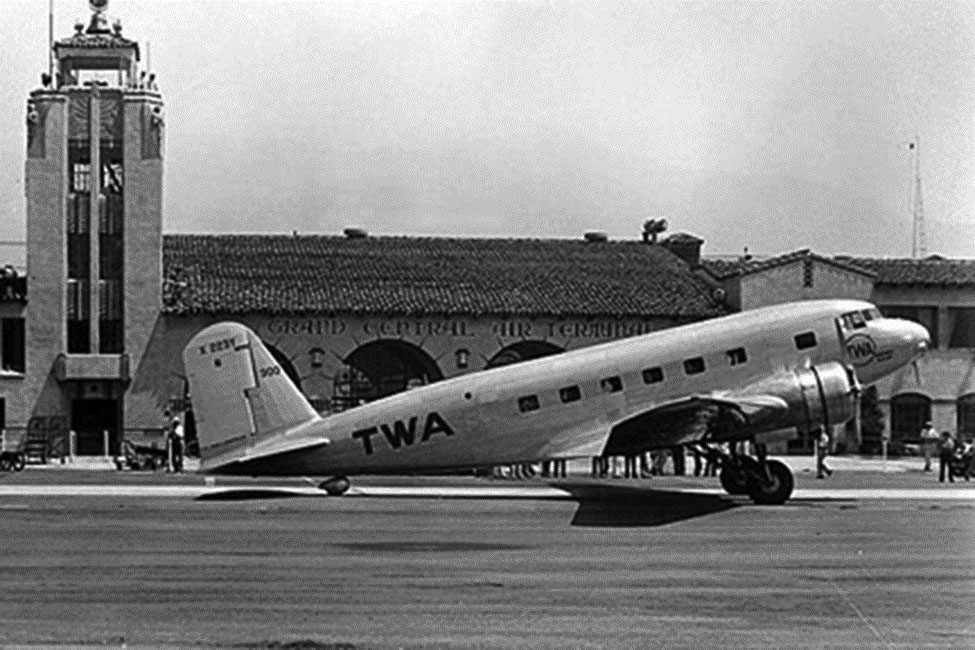 |
|
| (1933)^.^ – View showing the 12-passenger DC-1, Douglas Commercial Model No. 1, at Grand Central Air Terminal. |
Historical Notes The DC-1 was specifically designed for TWA. Its inaugural flight was on July 1, 1933, but it was nearly the last when both engines quit during the climb out. After modifications, the new plane met all of TWA’s requirements, most importantly of which was to be able to fly with only one of the two engines. TWA placed an immediate order for 25 Douglas airliners, but with more refinements as the DC-2. |
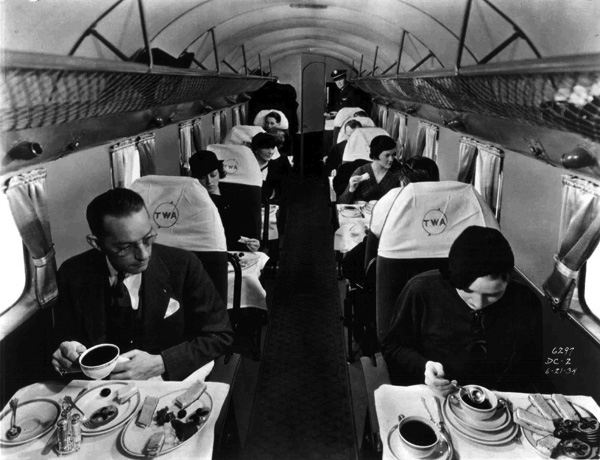 |
|
| (1933)* – View showing showing passengers dining in a TWA DC-2, (refined DC-1). |
Historical Notes The DC-2 was increased in size with a wider diameter fuselage to allow for the taller passengers to stand in the cabin. Its length was increased by two feet to allow for an extra row of seats that increased total seating to 14. There were other improvements as well. The payload was increased, the service ceiling was increased, the speed was increased and even in-flight movies were introduced. The DC-2 was now the most luxurious airliner in the world. Only four months after the Model 247 entered service, the first DC-2 was handed over to TWA. It flew in record time between Los Angeles and New York. TWA advertised Coast-to-Coast service in a 200 mph luxury airliner called the Sky Chief. Transcontinental flights consisted of four legs from New York (Newark) to Chicago, Kansas City, Albuquerque and Los Angeles. Flights left at 4:00 p.m. and arrived at 7:00 a.m. the next day. |
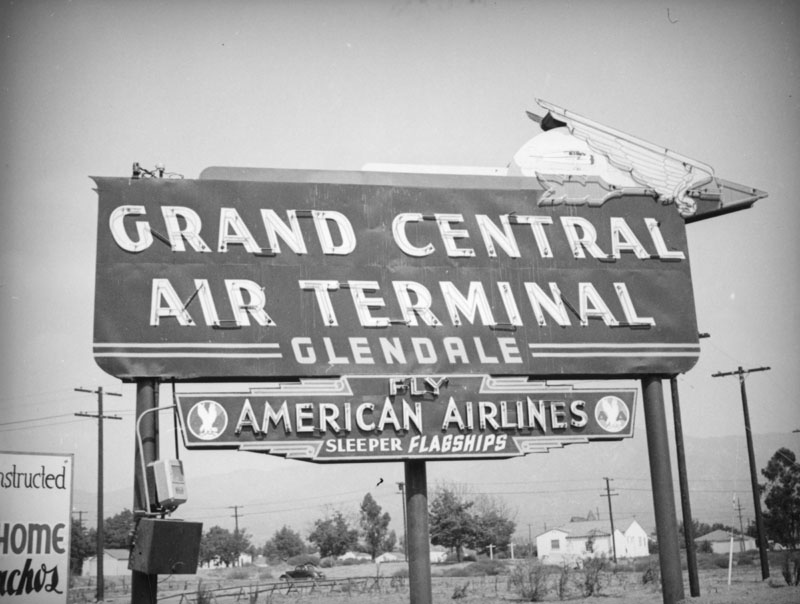 |
|
| (ca. 1937)* - A wing and arrow top this neon sign for the Grand Central Air Terminal, located at 1310 Air Way in Glendale. A smaller sign hangs below encouraging one to fly the American Airlines Sleeper Flagships. A log fence and telephone lines separate the neighboring Spanish style ranch houses from the field surrounding the sign. A painted sign advertising the new development of "Ranchos" is cut off in the foreground. |
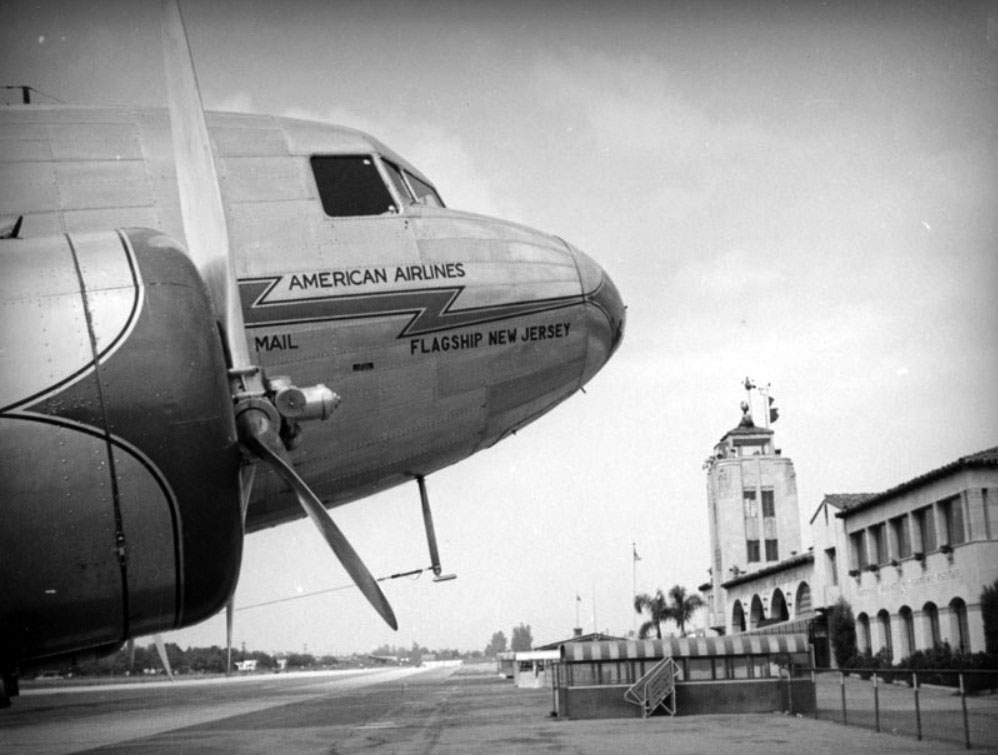 |
|
| (1937)* - View of an American Airlines DST (Douglas Sleeper Transport - an early version of a DC-3) prop plane carrying mail on the landing at the Grand Central Air Terminal, located at 1310 Air Way in Glendale. |
Historical Notes The Grand Central Air Terminal was designed by Henry L. Gogerty in 1928 in the Spanish Colonial Revival style with zig-zag moderne elements. The terminal is a City of Glendale registered landmark.* |
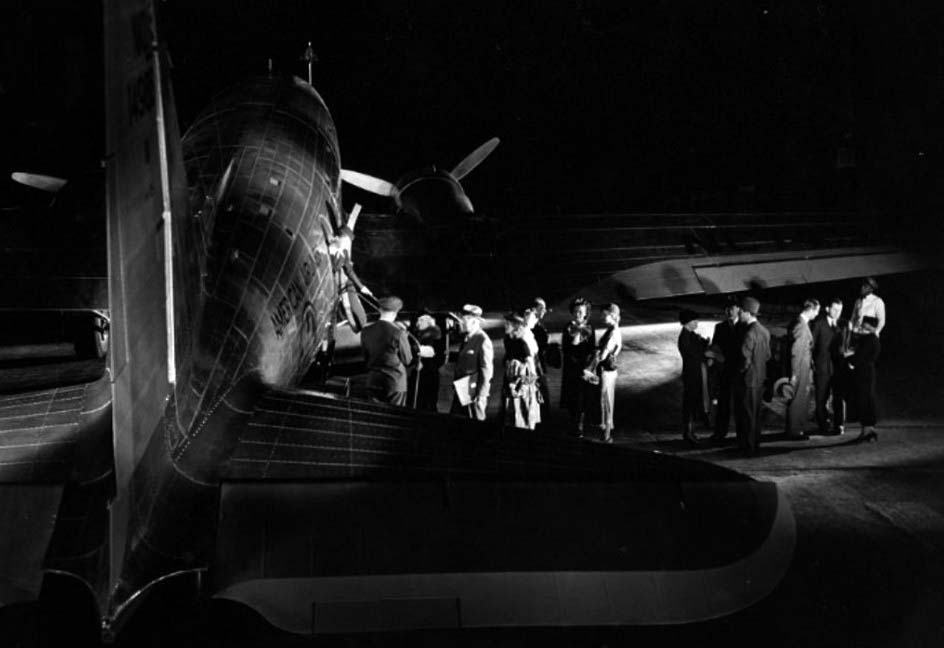 |
|
| (ca. 1940)#^ - Night departure of a DC-3, Grand Central Air Terminal, Glendale. Hagley Digital Archives |
Historical Notes The DC-3 was a twin-engine metal monoplane, developed as a larger, improved 14 bed sleeper version of the Douglas DC-2. It had many exceptional qualities compared to previous aircraft. It was fast, had a good range and could operate from short runways. Its construction was all-metal. It was reliable, easy to maintain and carried passengers in greater comfort. Before the war it pioneered many air travel routes. It was able to cross the continental United States, making transcontinental flights and worldwide flights possible, and is considered to be the first airliner that could make money by carrying passengers alone.*^ |
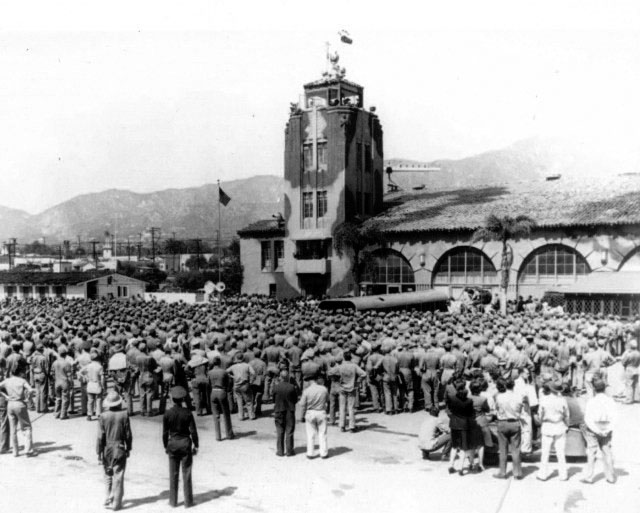 |
|
| (1942)^.^ – View showing hundreds of recruits gathered to hear Air Marshall W. A. Bishop speak in front of the Grand Central Air Terminal during WWII. Note that the tower has already been painted with camouflage. |
Historical Notes When Pearl Harbor was attacked on December 7, 1941, Grand Central Airport (like all other west coast airports) was immediately closed to private aviation. (The remaining airlines had already moved to Burbank.) The government moved in, heavily camouflaged the place, and converted it into an important defense base for Los Angeles. In 1942 the runway, which originally ended at Sonora Avenue, was extended North to Western Avenue, giving it a 5,000' length to accommodate large airplanes and future jet aircraft. After the war, geographic constraints hindered the airport’s ability to accommodate new—and larger—commercial aircraft. |
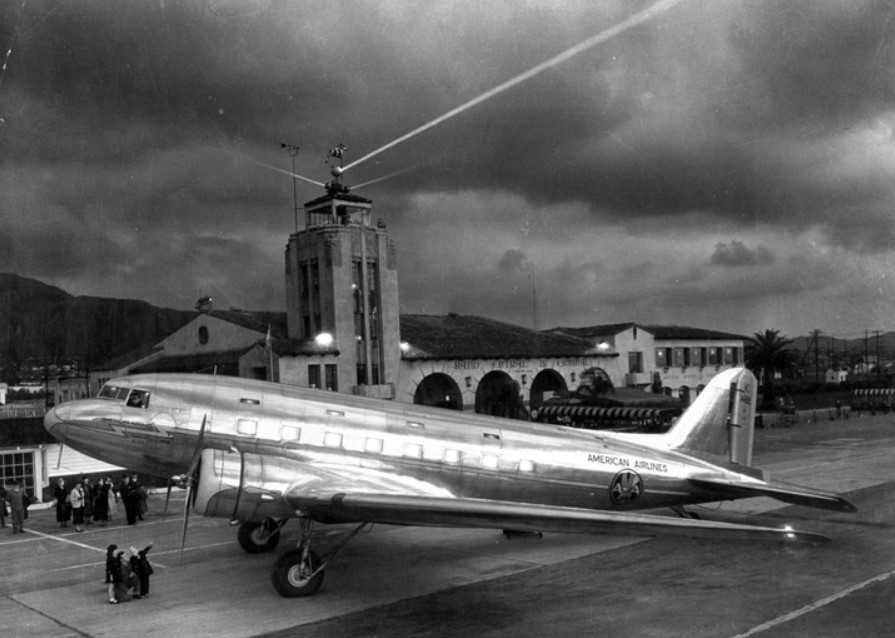 |
|
| (1940s)^*^ - A shining DC-3 parked in front of the Grand Central Airport terminal as night falls. |
Historical Notes In 1947 the runway was cut back to 3,800' (southeast of Sonora Ave) due to pressure from local government. The airport was returned to private use, renamed Grand Central Airport, ceased to be profitable, and would eventually be closed in 1959. The closed airport was then used as a private heliport for the Los Angeles Police Department's fleet of police helicopters, some Bell 47's ("recips") and some Bell 206's ("Jet Rangers"), until the hew LAPD Hooper Heliport opened on top of the Piper Tech Building in downtown Los Angeles in 1983. The runways were torn out and replaced by a street named Grand Central Avenue. Over 70 new “tilt up” manufacturing buildings were constructed under the direction of the Grand Central Industrial Centre. The redeveloped airport property was eventually purchased by the Prudential Insurance Company and leased out as an investment. When Walt Disney was developing Disneyland in the early 1950s, he wanted a place away from the main studio where he could work on new ideas undisturbed. He rented an industrial building at 1401 Flower St. on the old airport property. WED (Walter E. Disney) Enterprises also rented the old terminal building during the busy years of Epcot and Disney World development. Dreamworks was created in 1994, and their new buildings soon appeared on part of the old airport land just down the street from Disney’s leased building. The Disney Corporation soon purchased the remaining land from the airport and have announced a 15-year plan to turn it into a corporate “creative campus” behind security gates. Disney has stated their intention to rework the old terminal by the year 2015 to its original look. Much of the original metal work, railings and lights have been stripped away over the years, but the Disney representative feels that their company can easily reproduce replacement pieces. There are also two original hangars left—one very modified into a cold storage facility and the other is now used by Disney Imagineering for special effects mock-ups.+## |
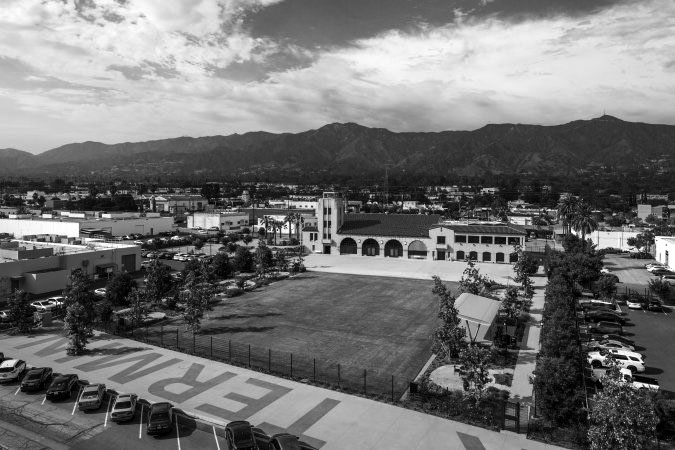 |
|
| (2017)^ - View showing the Grand Central Air Terminal as it appears today. Photo by Paul Turang, Los Angeles Conservancy |
Historical Notes The Grand Central Air Terminal remained untouched until 2012, when its current owner embarked on a project to transform the airport for new uses. The project team rehabilitated the entire property, including the airport concourse, runway, and taxiway. They completely restored the building’s exterior and significant interior spaces. The team thoroughly researched and meticulously restored, or recreated, missing or degraded character-defining features, such as light fixtures and decorative tile.* |
* * * * * |
Metropolitan to Van Nuys Airport
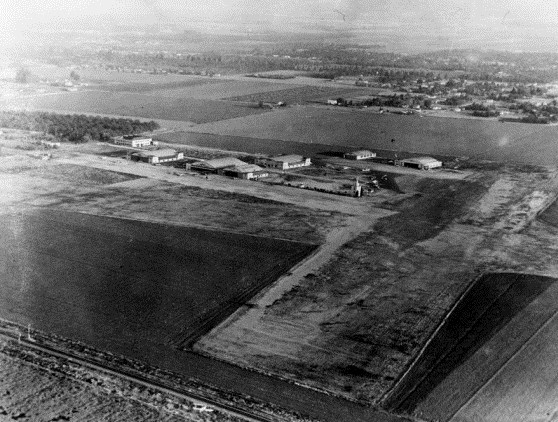 |
|
| (1930)^ - Aerial view of Van Nuys Airport when it was known as Metropolitan Airport. |
Historical Notes Los Angeles Metropolitan Airport opened in 1928 and was spread over 80 acres amid the trees and farmland. In 1929, Hollywood discovered the airport. Howard Hughes, Hoot Gibson, Cecil B. DeMille, Gene Autry and Wallace Beery were among the growing number of stars flying at the new airport. The airport continued to expand and grow with three factories, six hangers, and a control tower on airport grounds. The airport also began hosting air races. During one such race in 1929, Amelia Earhart set a new speed record.*^# |
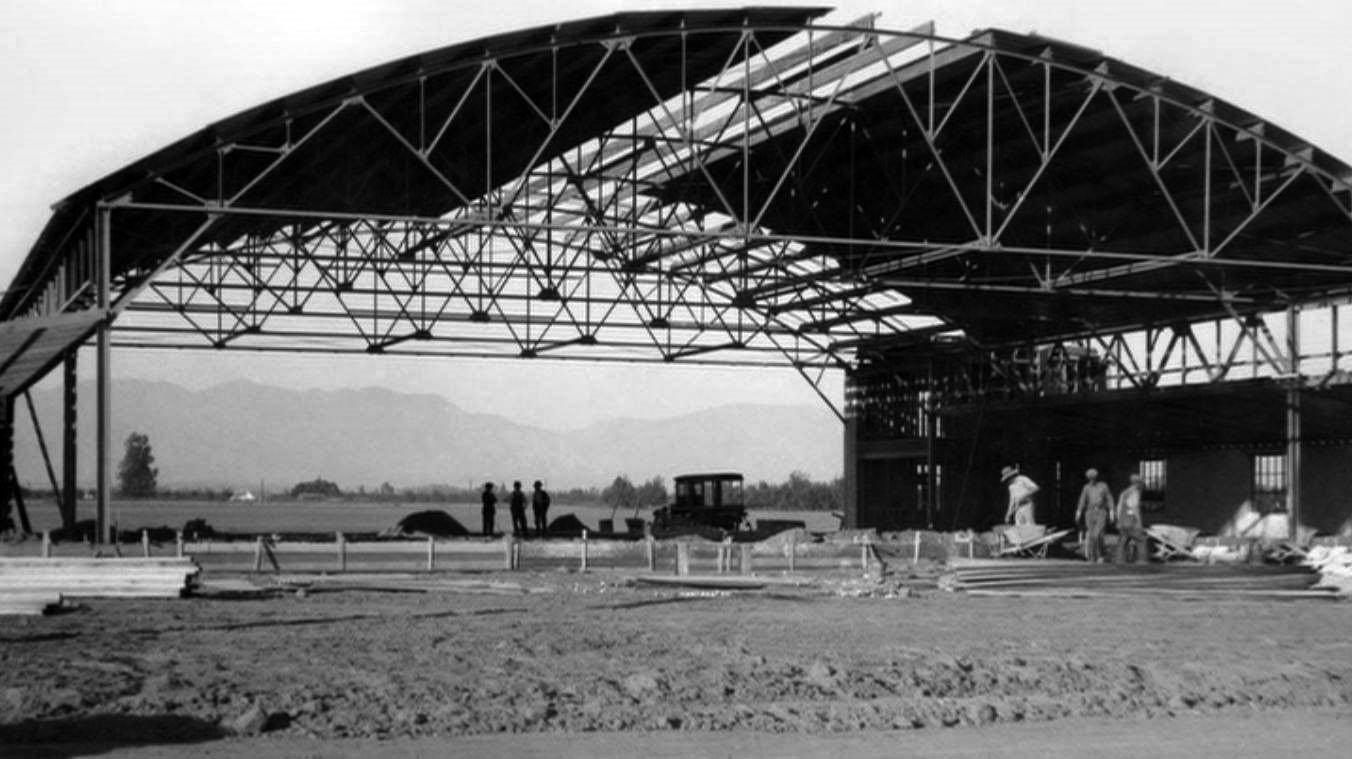 |
|
| (1929)^.^ – View showing the westernmost hangar (the one closest to the control tower) while it was under construction in the fall of 1929. At that time, it was the only hangar at the airport. When it was completed, "Los Angeles Metropolitan Airport" was painted in large letters on the roof. |
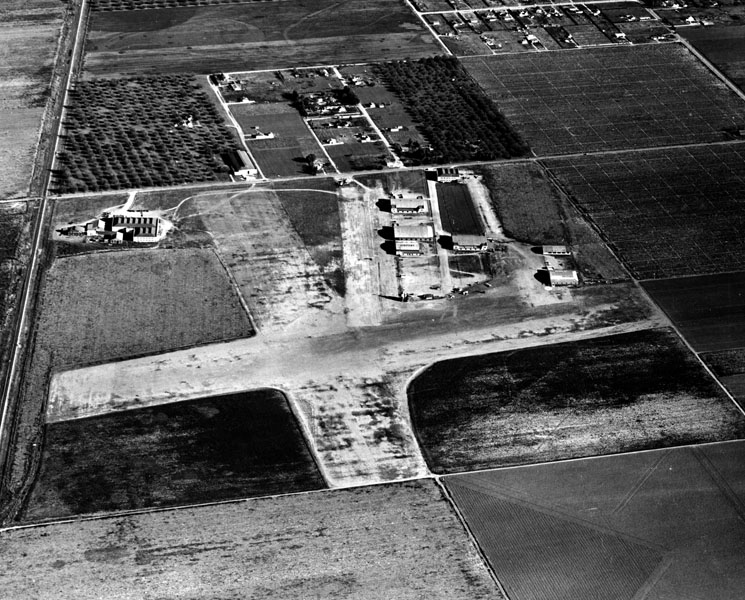 |
|
| (1940)* - Aerial view showing the Metropolitan Airport, later Van Nuys Airport, on April 15, 1940. |
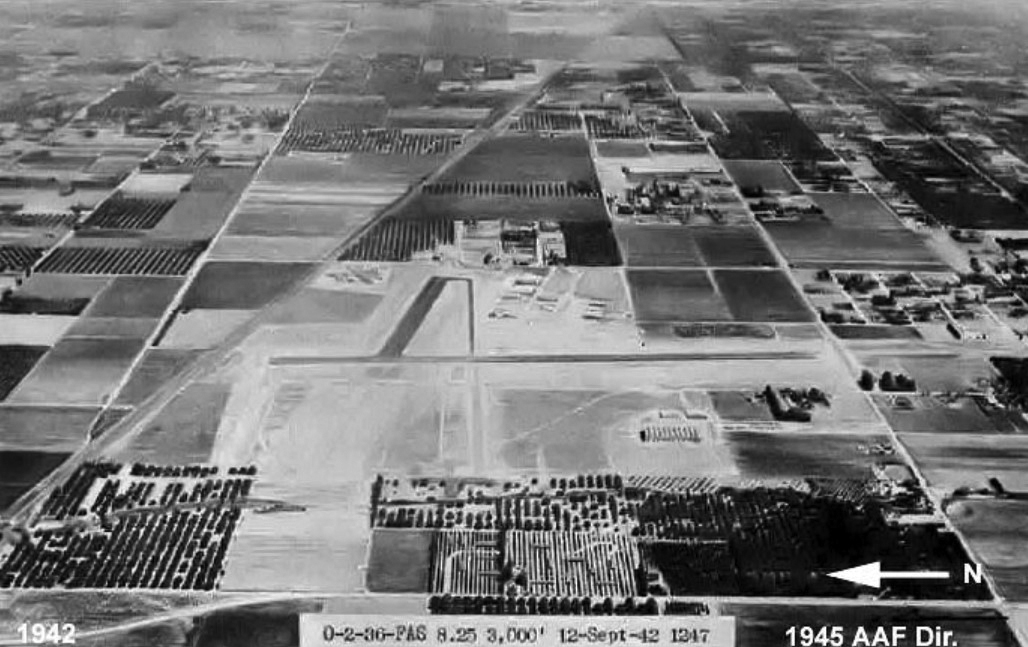 |
|
| (1942)*^ – Aerial view looking east showing the Van Nuys Army Airfield. Note the vast open land around the airport. |
Historical Notes In 1942, with the outbreak of World War II, the U.S. government purchased Metropolitan Airport and converted it into a military base to help protect the West Coast. The military also purchased an additional 163 acres of land for the construction of the Van Nuys Army Airfield, using new runways to train hundreds of P-38 Lightning pilots.*#^ |
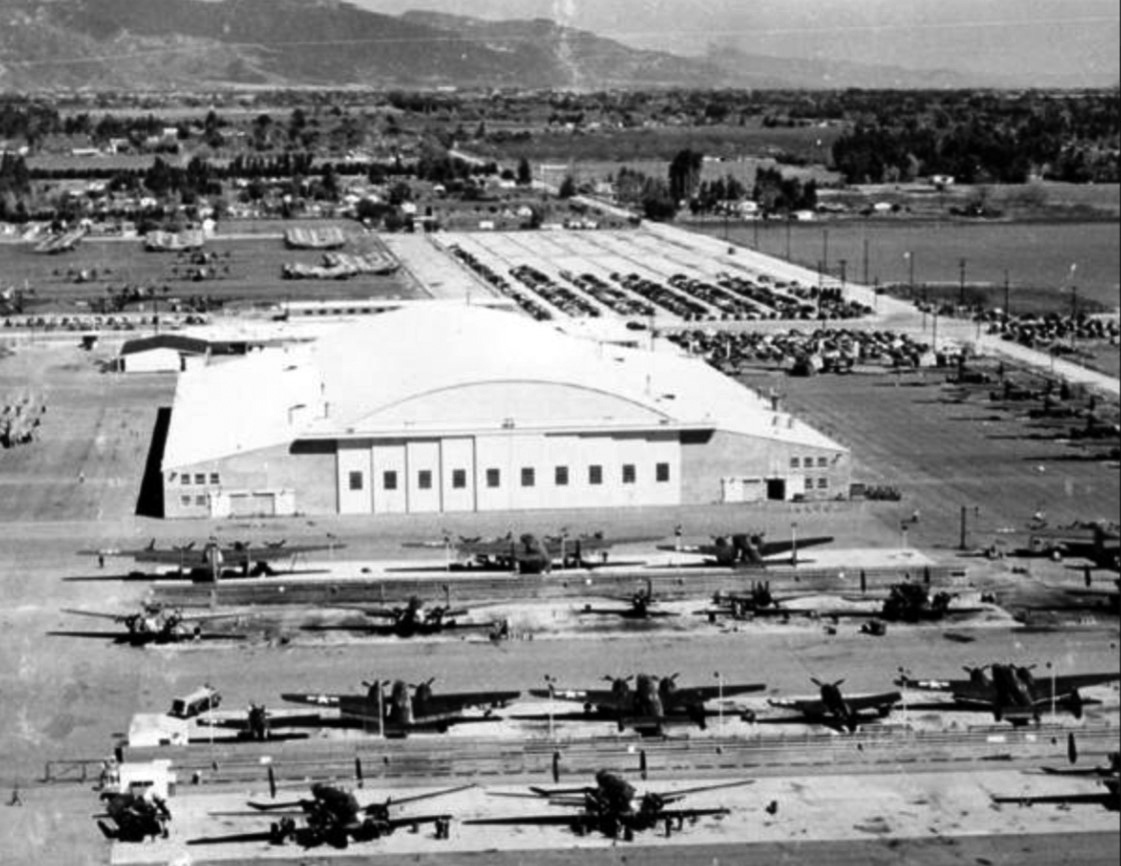 |
|
| (1940s)* - Fighter aircraft at Lockheed facility, Metroplitan Airport (later Van Nuys Airport). |
Historical Notes The airport became a vital defense-manufacturing center during the war. In 1944, a joint venture between the U.S. Navy and Lockheed Corporation created an aircraft modification facility known as the Navy Lockheed Plant. |
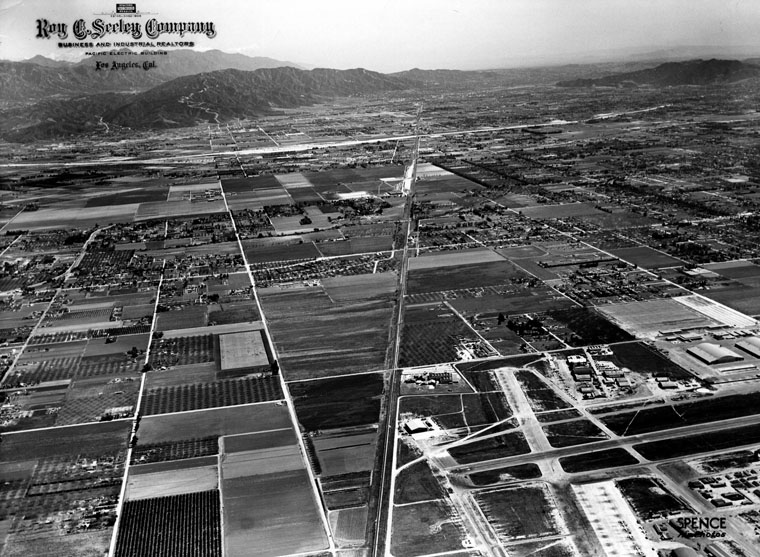 |
|
| (ca. 1944)* - Aerial view, looking east, of the San Fernando Valley. The Metropolitan Airport is seen at lower right after its expansion. |
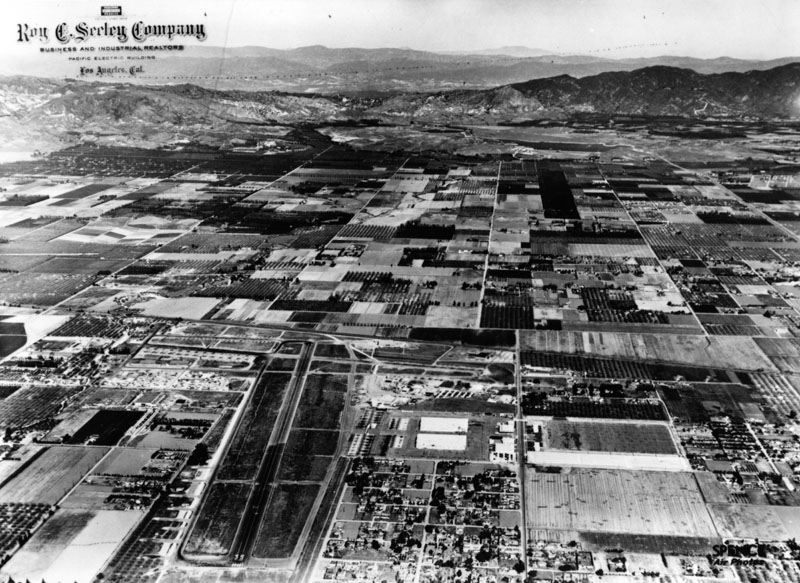 |
|
| (1946)* - Aerial view of San Fernando Valley, north of the Metropolitan Airport, now known as Van Nuys Airport. |
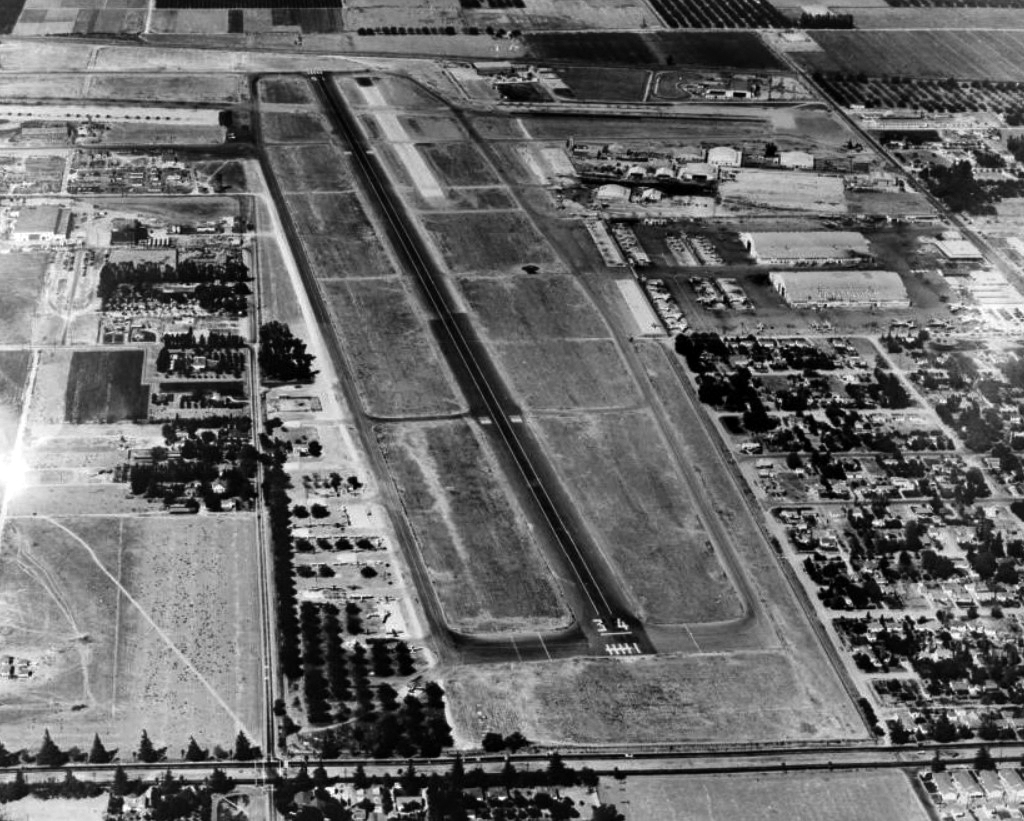 |
|
| (1950)#* - Aerial view looking down on the runway and buildings of the Metropolitan Airport in Van Nuys, bordered at the southern end by Sherman Way and by railroad tracks to the north. |
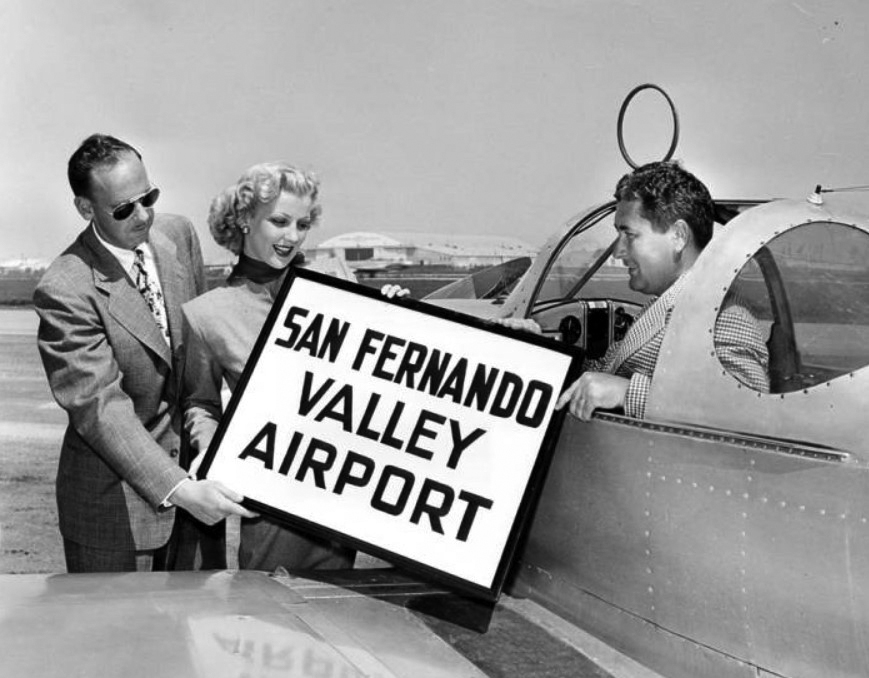 |
|
| (1950)^ - Metropolitan Airport is renamed San Fernando Valley Airport. |
Historical Notes In 1949, the city of Los Angeles purchased the airport from the War Assets Administration for a token payment of one dollar, with the condition that it remain the home of the California Air National Guard until 1985. One year later, the airport was renamed San Fernando Valley Airport.*# |
 |
|
| (1955)^ - Several F-86s from the Air National Guard's 146th Tactical Fighter Wing resting on the ramp at San Fernando Valley Airport in Van Nuys. |
Historical Notes Following World War II, previously splintered Army National Guard and Army Guard Air Corps units were reformed and restructured under the newly created Department of Defense. On September 16, 1946, the 62nd Fighter Wing, 146th Fighter Group and 115th Bombardment Squadron (the former 115th Observation Squadron) were given Federal recognition, and flew their first missions out of Van Nuys Air National Guard Base, later to become Van Nuys Municpal Airport in the San Fernando Valley north of Los Angeles. In 1948, several units of the new wing moved to Burbank Airport, only to return to Van Nuys a short time later, after too little ramp space at Burbank proved a hindrance to accomplishing the wing's missions.* |
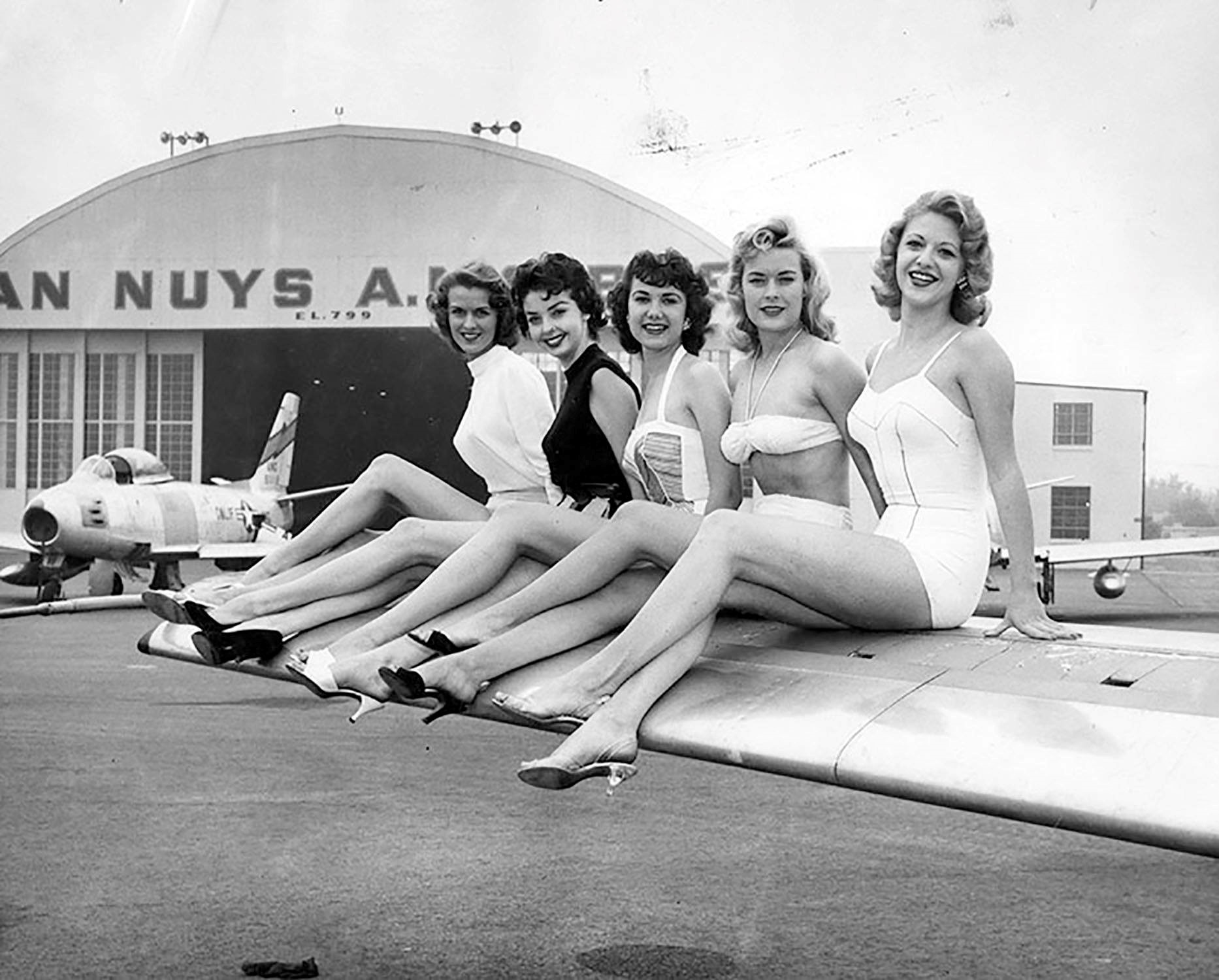 |
|
| (1956)* – View showing models posing for the camera while sitting on the wings of airplane. In the background stands an F-86 Sabre with leading edge slats and deployed air brake in front of a Van Nuys Air Force hangar. |
Historical Notes Valley Times Photograph caption dated April 26, 1956 reads "Beauties above will assist during open house program May 19-20 at San Fernando Valley Airport by posing for amateur photographers and serving as models for a fashion show. From left they are Gloria Robertson, Camille Williams, Babs Manausa, Barbara Thompson and Ree Regul. Open house will tie in with Armed Forces Day." The Metropolitan Airport opened on December 17, 1928. In 1950 it was renamed San Fernando Valley Airport and in 1957 the name changed to Van Nuys Airport. The airport is located at 16461 Sherman Way, Van Nuys.* |
 |
|
| (1950)^ – Postcard aerial view of the runway at Van Nuys Airport. |
Historical Notes The above photo is mislabeled. In 1950 the airport was still known as the San Fernando Valley Airport. It would be renamed Van Nuys Airport in 1957.*^# |
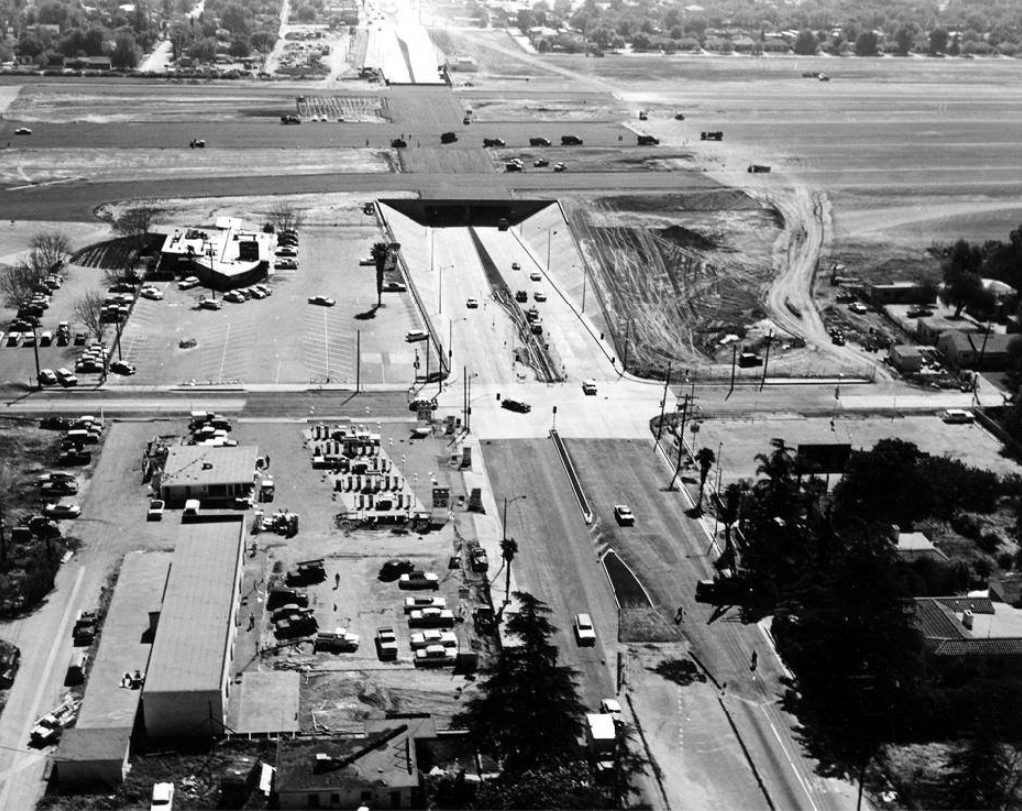 |
|
| (1958)#^^* – Aerial view showing the construction of the Van Nuys Airport runway extension and Sherman Way Tunnel. |
Historical Notes At one point the Van Nuys Airport was envisioned as a base for Air Force fighter/interceptor planes to defend against a feared attack by Soviet-piloted bombers from Siberia. To provide the space needed for early jet fighters, a runway was extended an additional 2,000 feet south from Saticoy Street to Vanowen Street. To avoid blocking busy Sherman Way, the street was routed into a tunnel under the runway, which is still in use today. But, by the time hundreds of homes had been razed and the expansion completed, the defense role was taken over by Nike anti-aircraft missiles, leaving the airport with an extraordinarily long (8,000 feet!) runway for a general aviation field, an unintended legacy of the Cold War.*^# |
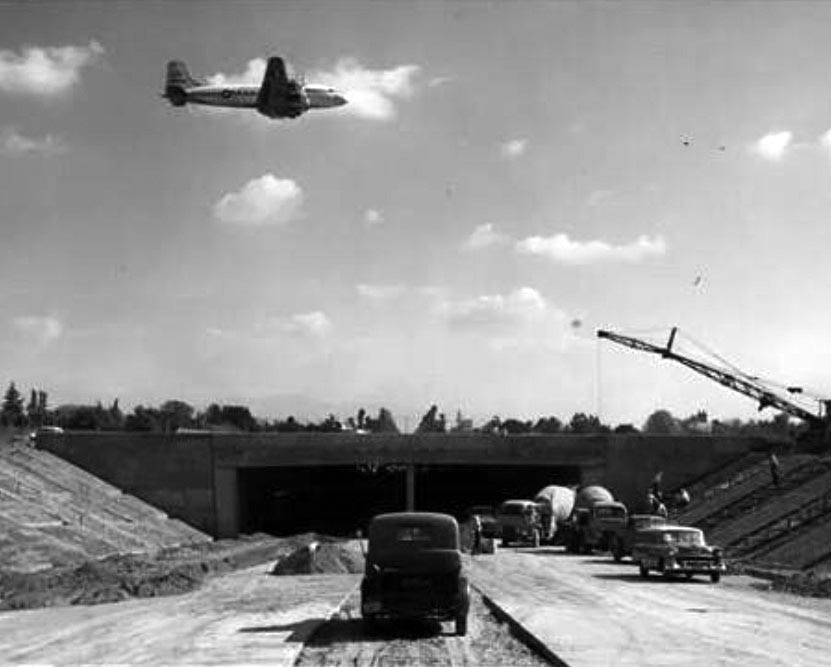 |
|
| (1958)*^## - View of the Van Nuys Airport runway extension and building of the Sherman Way tunnel with a DC-4 flying overhead. |
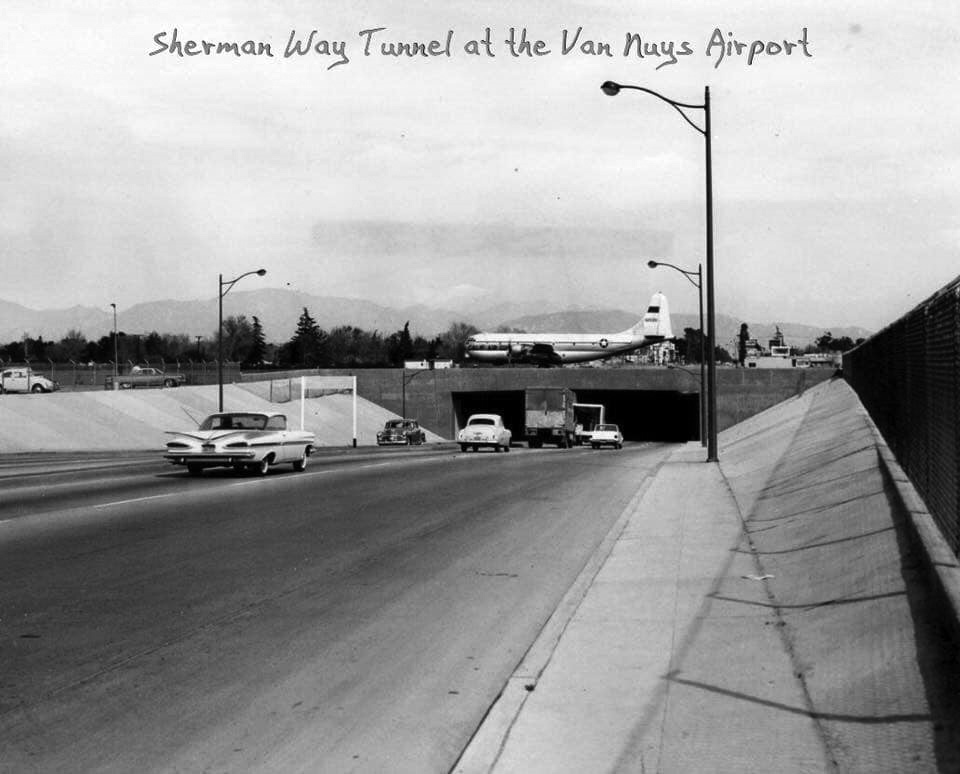 |
|
| (1959)^.^ - A C-97 taxis over the Sherman Way tunnel at the Van Nuys Airport. At left, a 1959 Chevrolet Coupe with its large tailfins is seen heading toward the tunnel. |
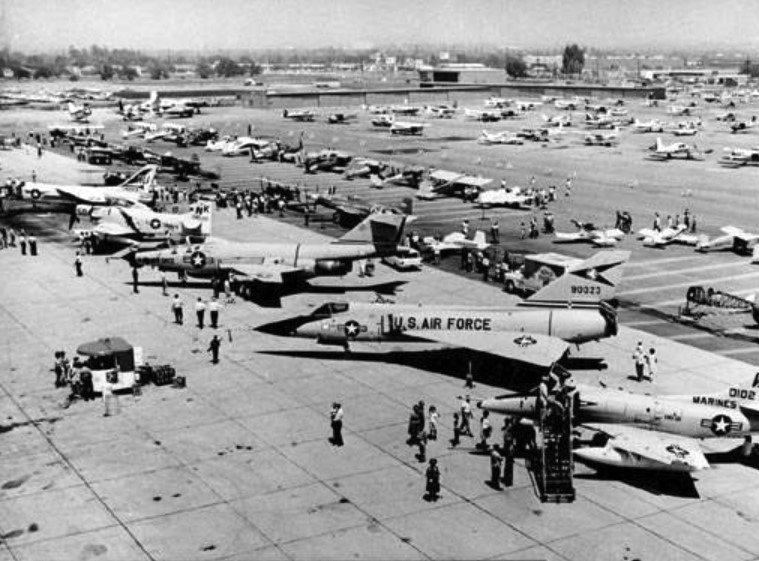 |
|
| (1965)#^** – View showing the Van Nuys Airport Air Show displaying the latest military aircraft including the: A-4, F-102, and F-1-1. Note the lack of high priced "millionaire" hangers that are in dominance today! |
Historical Notes The annual Van Nuys Airport Air Shows lasted nearly four decades until the Air Force stopped them mainly due to low turnouts and security problems. |
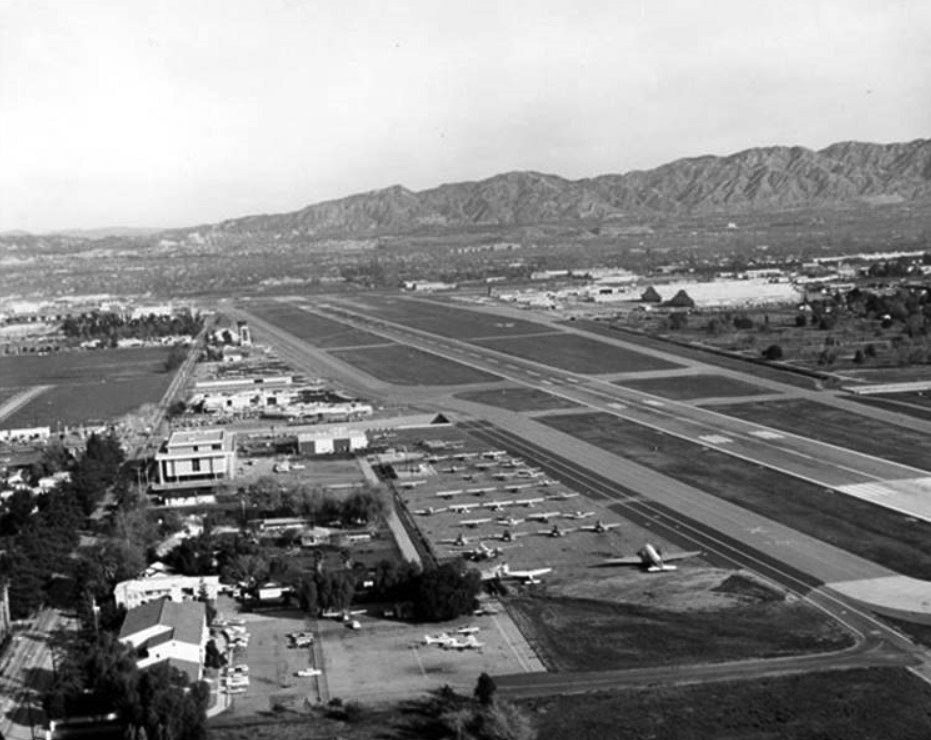 |
|
| (1966)^ – Aerial view looking north showing the Van Nuys Airport and the north end of the San Fernando Valley on a clear day. |
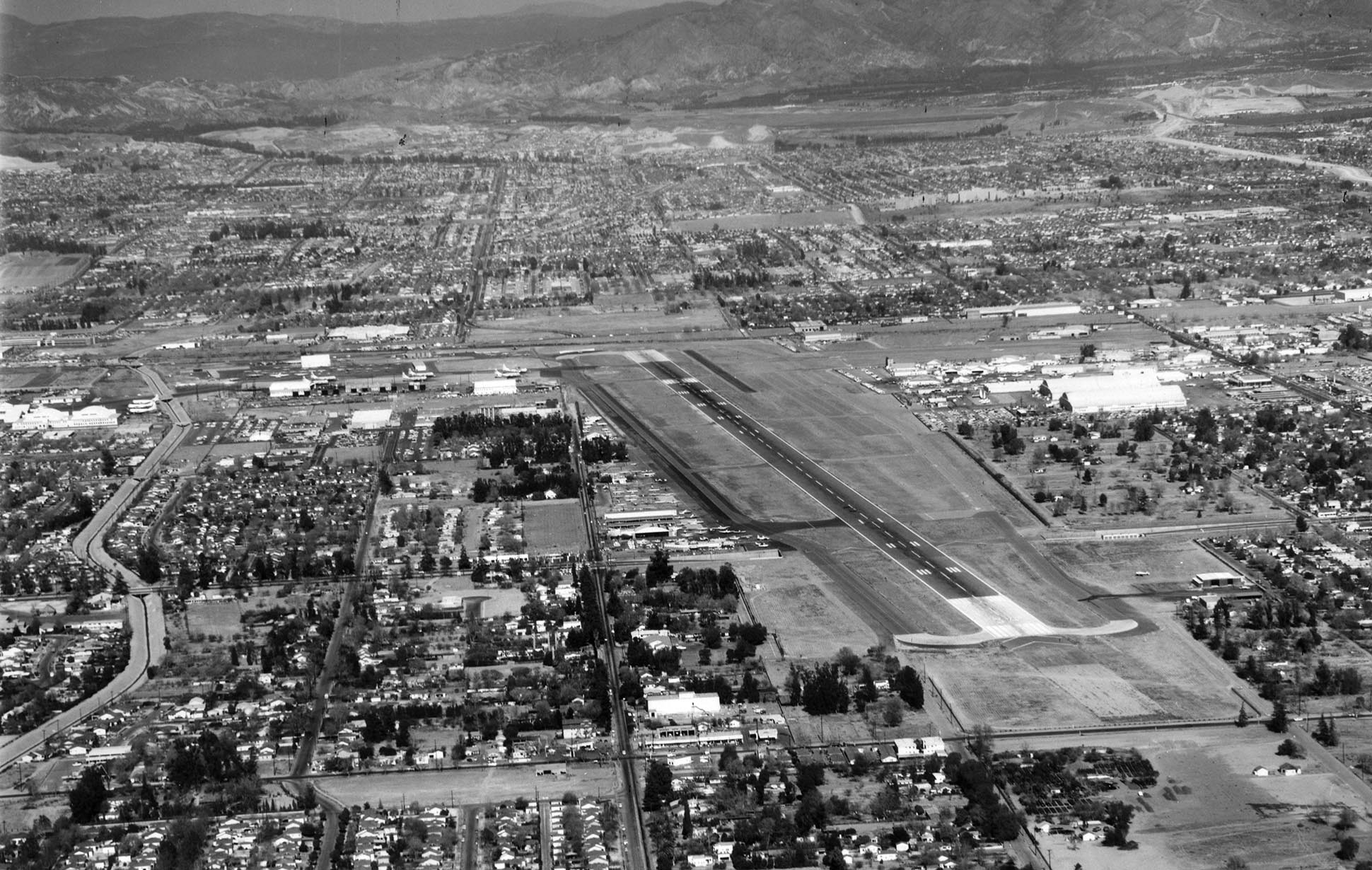 |
|
| (1968)^^# – Aerial view looking north showing Van Nuys Airport and surrounding area. |
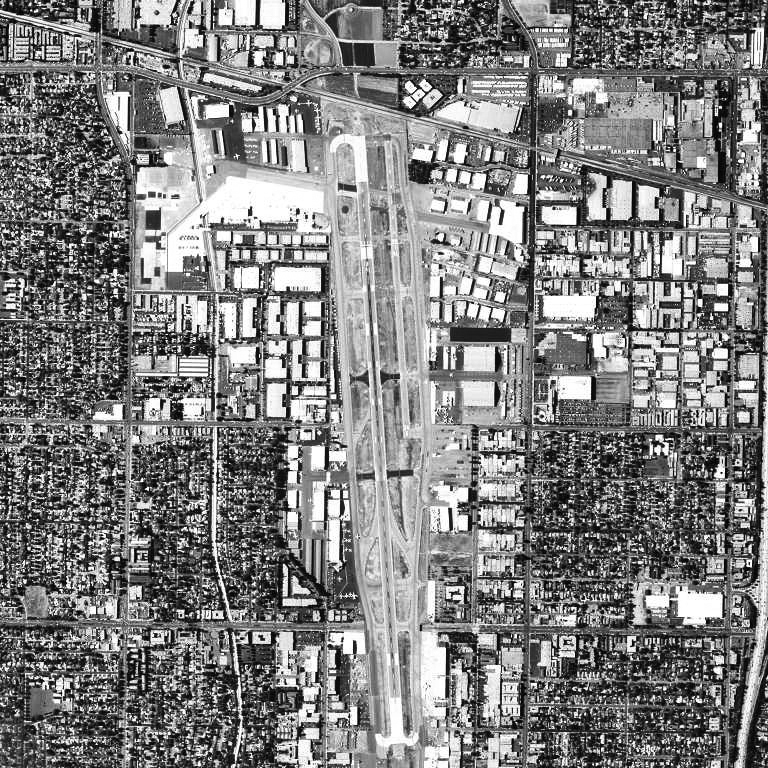 |
|
| (2006)*^ - Aerial view of Van Nuys airport as it appeared in 2006. |
Historical Notes Van Nuys Airport is owned and operated by Los Angeles World Airports. Through 2005, it was the busiest general aviation airport in the world (the second busiest being Phoenix Deer Valley Airport). In terms of takeoffs and landings, it was also the 25th busiest airport in the world. With two parallel runways, Van Nuys Airport handled 448,681 aircraft movements in 2005, averaging over 1,200 operations/day; in 2006 it handled 394,915 movements, nearly 1,100 per day. That’s amazing considering no major airlines fly into this airport. Los Angeles International Airport (with 4 runways and many airline flights) has roughly 1,700 operations a day.*^ |
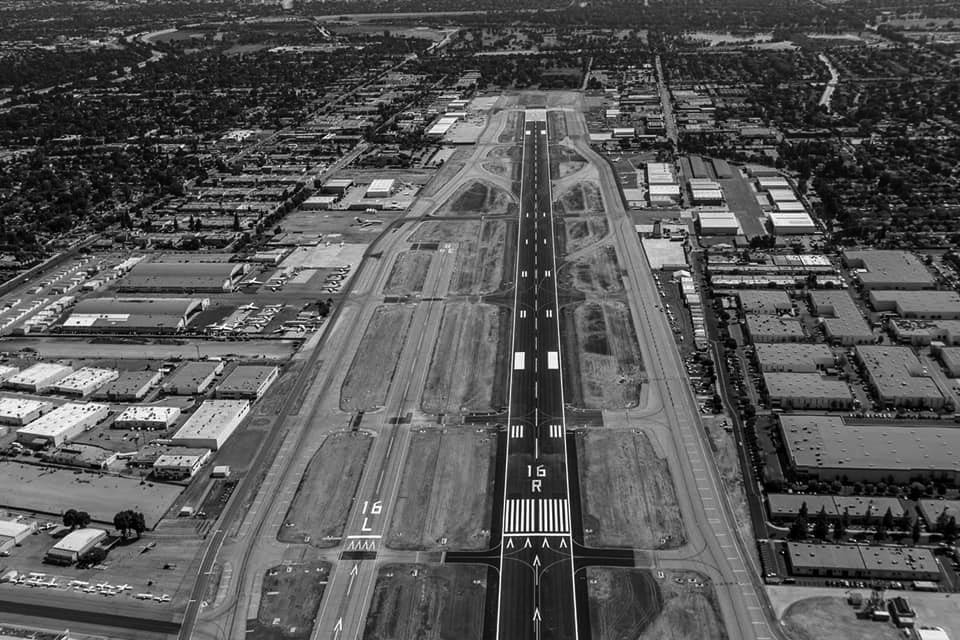 |
|
| (2017)* - Aerial view of Van Nuys Airport. Photo Van Nuys Airport |
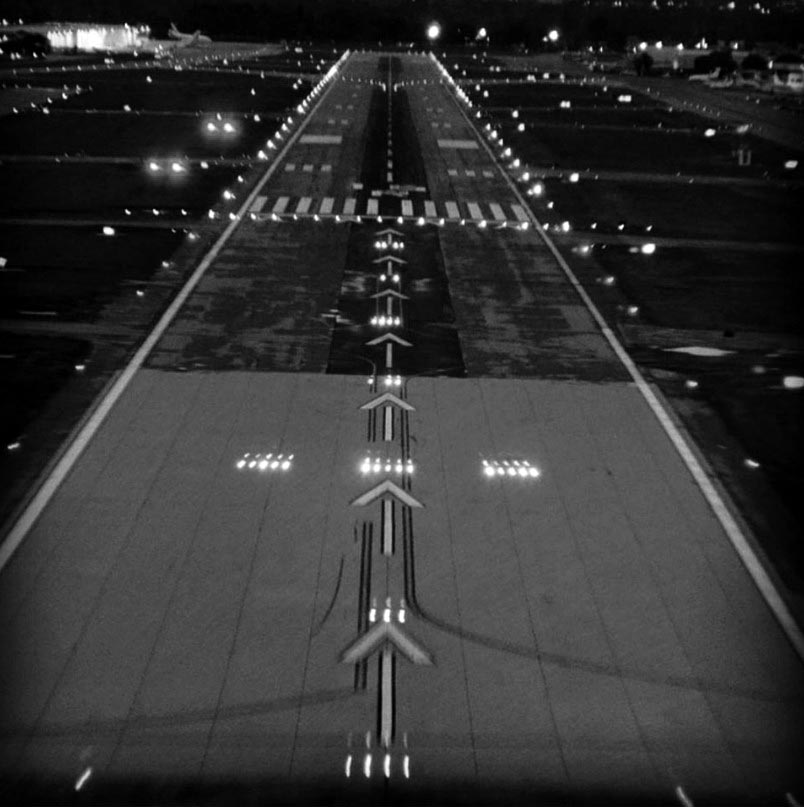 |
|
| (2014)* – The Pilot View - Night landing at Van Nuys Airport. |
* * * * * |
Whiteman Airport (aka Whiteman Air Park, Pacoima)
 |
|
| (1960)* - View showing an airplane coming in for a landing at Whiteman Air Park located at San Fernando Road and Pierce Street in Pacoima. |
Historical Notes Whiteman Airport was founded as "Whiteman Air Park" in 1946 on a farm by pilot Marvin Whiteman Sr. as a non-tower controlled, private airport. Later Whiteman Manufacturing Co. was built on the airport's west side. In 1970 the airport was purchased by the County of Los Angeles. During the 1980s the name was changed to "Whiteman Airport", but it is still commonly referred to as "Whiteman Airpark" by old-time local pilots to this day. |
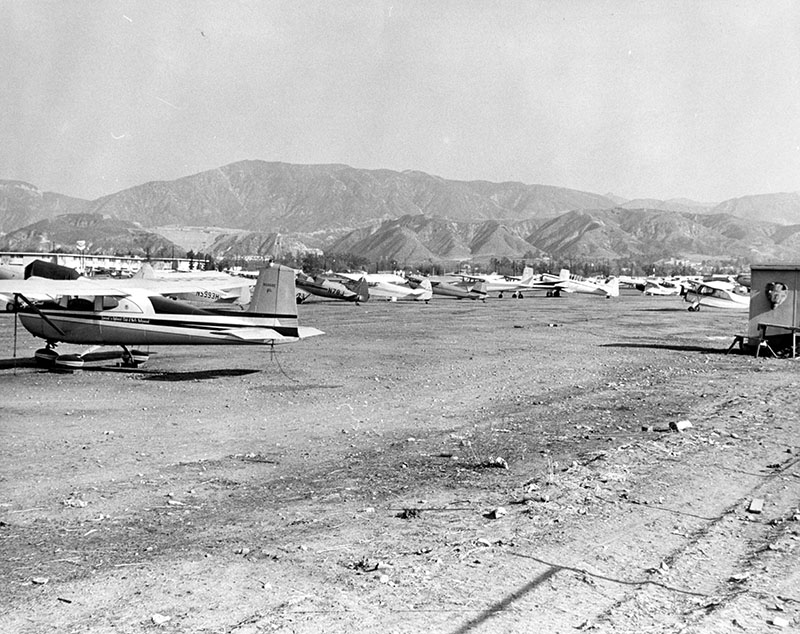 |
|
| (1963)* - Ground view showing Whiteman Air Park in Pacoima. The 'Air Park' did not have a control tower at the time. |
Historical Notes In 1988, an FAA-approved and funded control tower was installed in Whiteman Airport. |
* * * * * |
From Clover Field to Santa Monica Airport
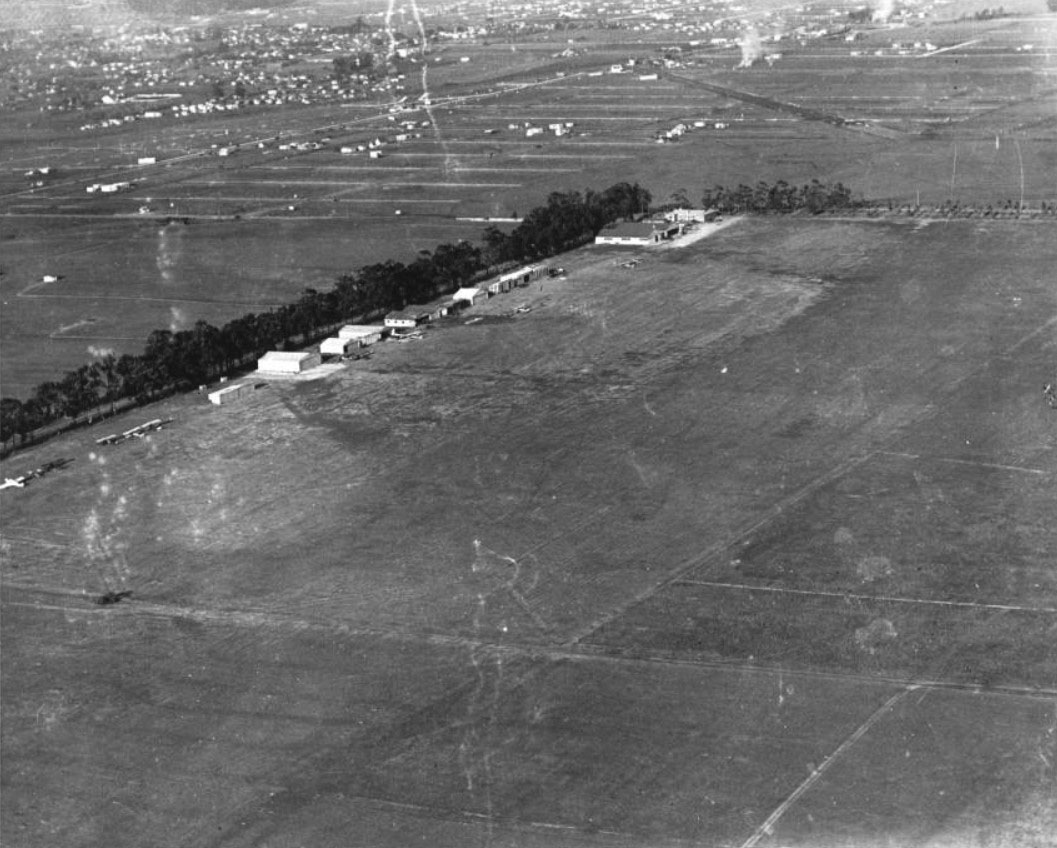 |
|
| (ca. 1924)* - Aerial view of Clover Field Airport in Santa Monica, showing residences in the distance. Hangars and other buildings are seen at center, amidst large expanses of open land. Several airplanes sit in the grass in front of and to the left of the buildings. A row of trees sits behind the building, running diagonally across the upper left corner of the image. |
Historical Notes As early as 1917, aviators were landing on this grassy runway perched atop a mesa just southeast of Santa Monica. It was surrounded by stalks of barley. Soon the landing strip became a military airfield, and in 1922 the U.S. Army named it Clover Field in honor of Greayer Clover, a fighter pilot killed in France during the First World War. Since then the site has served many purposes. First it was the western headquarters of the Army’s reserve air corps, and later Douglas Aircraft produced its line of DC planes there. |
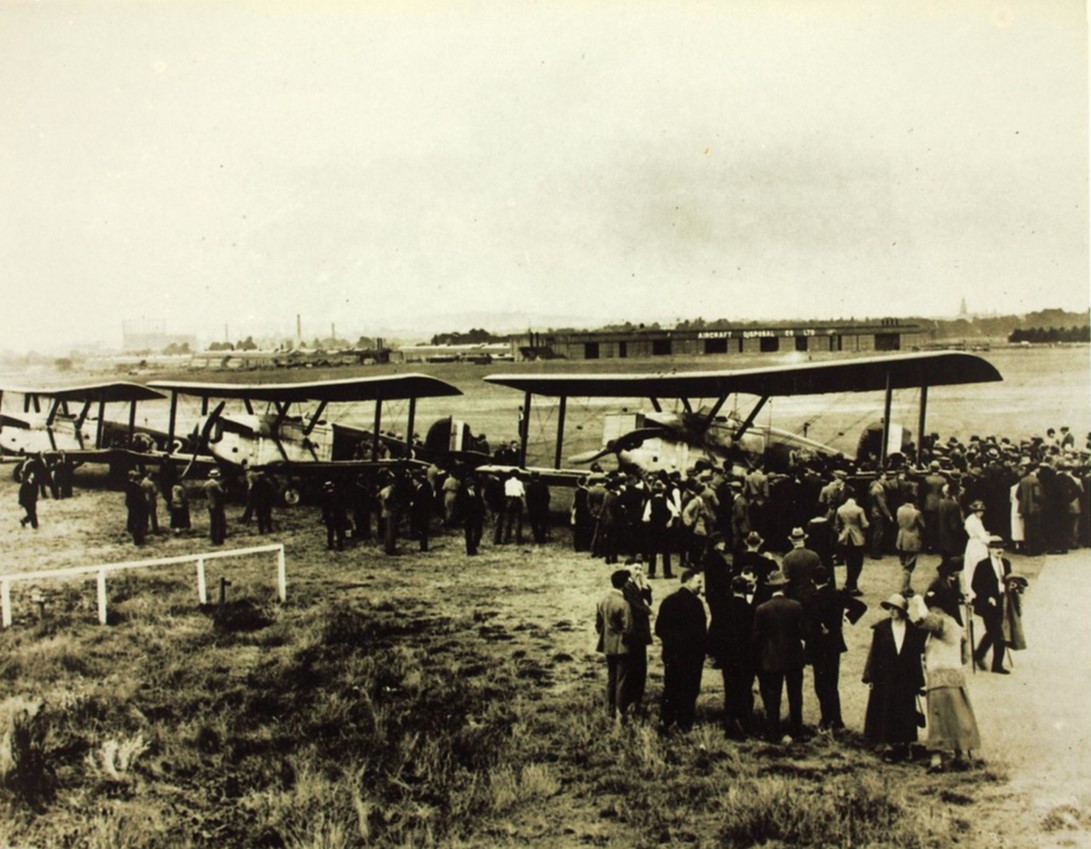 |
|
| (1924)* - A growing crowd of spectators at Clover Field inspect the World Cruisers before their epic flight. |
Historical Notes Clover Field, now known as Santa Monica Airport, played a pivotal role in the first aerial circumnavigation of the world in 1924. As the home base of the Douglas Aircraft Company, it was where the four Douglas World Cruisers—Seattle, Chicago, Boston, and New Orleans—were built and prepared for their historic journey. On March 17, 1924, these aircraft took off from Clover Field for a preliminary flight, marking the unofficial start of their global expedition. Although the official circumnavigation began on April 6 from Seattle, Clover Field's contribution was significant enough to warrant a historical marker commemorating it as the "Site of the first round the world flight." This event not only solidified Clover Field's place in aviation history but also contributed to its reputation as a hub for pioneering developments in flight. The airport's involvement in this milestone is memorialized in Santa Monica's urban landscape through Cloverfield Boulevard, serving as a lasting reminder of the area's crucial role in this groundbreaking achievement in aviation history. |
_Filtered2.jpeg) |
|
| (1924)* - On This Day: September 23, 1924 Douglas Aircraft's World Cruiser airplanes return to Clover Field following the first around the world flight. |
Historical Notes Two planes made it back, after having covered 27,553 miles in 175 days, and were greeted on their return September 23, 1924 by a crowd of 175,000 (likely an overestimate). Clover Field played a pivotal role in the return of the Douglas World Cruiser aircraft during their historic global circumnavigation. On September 23, 1924, the surviving aircraft, Chicago and New Orleans, landed at the Santa Monica airfield to a hero's welcome, with an estimated 175,000 people gathering to celebrate their achievement. As the original home of the Douglas Aircraft Company where the planes were designed and built, Clover Field was more than just a refueling stop—it was a symbolic homecoming. The crowds were so enthusiastic that they surrounded the aircraft, making immediate refueling impossible. Donald Douglas himself wanted to celebrate the achievement in Santa Monica before the final leg to Seattle, underscoring the field's importance in this historic moment. This triumphant return to Clover Field not only marked a significant milestone in aviation history but also highlighted the crucial role of Santa Monica and the Douglas Aircraft Company in pushing the boundaries of long-distance flight in the early 20th century. |
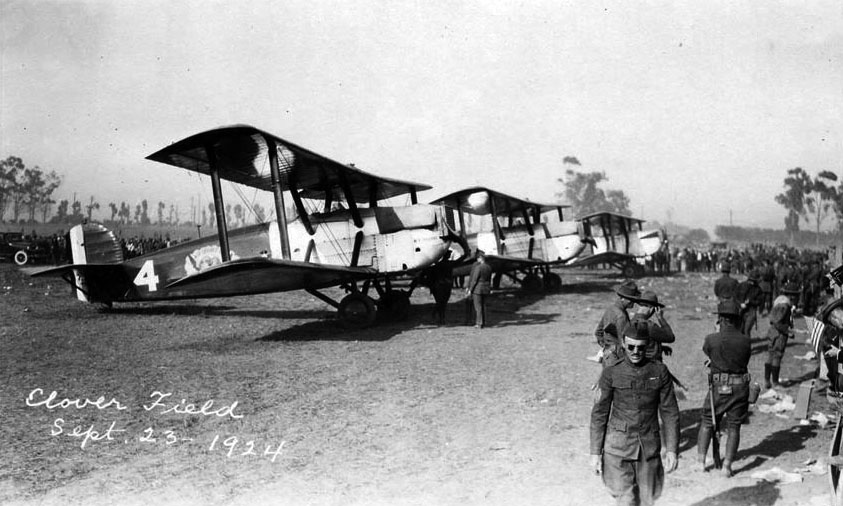 |
|
| (1924)* - Douglas World Cruisers return to Clover Field, Santa Monica, CA on September 23rd, 1924. |
Historical Notes On Sept. 23, two of the pioneering planes returned, completing the first aerial circumnavigation of the world. Of the four planes that began the journey, only two completed it, covering 27,553 miles in 175 days. The planes were piloted by a team from the United States Army Air Service, the precursor to the United States Air Force. |
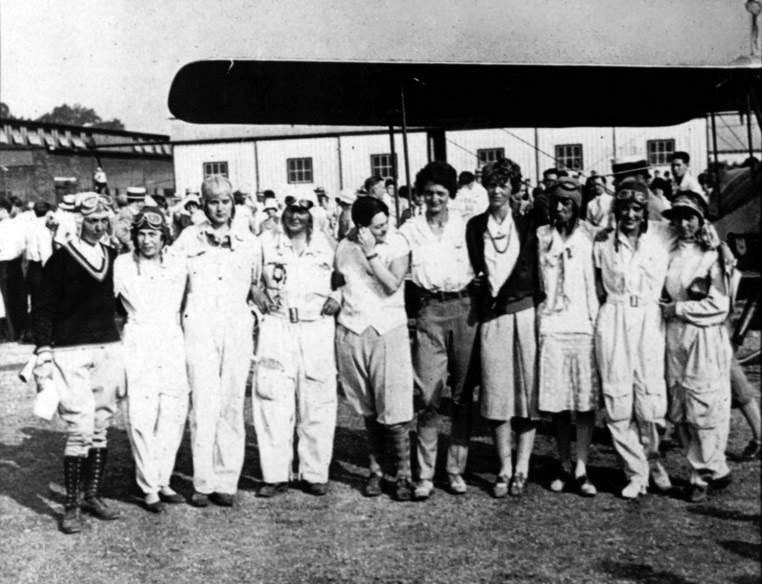 |
|
| (1929)* – View showing some of the female aviators who competed in the first women’s transcontinental air derby which began in Santa Monica on August 18, 1929. Amelia Earhart is fourth from the right. Louise Thaden, who won the 2700-mile race, is fifth from the right. |
Historical Notes In August 1929, seventy women held a United States pilot’s license. Of those, twenty young female aviators assembled at Clover Field on the afternoon of August 18 to take part in the groundbreaking competition. Navigating the 2700-mile course with only road maps on their laps, the women flew from Santa Monica to Cleveland via stops in Arizona, New Mexico, Texas, Oklahoma, Kansas, Missouri, Illinois and Indiana. Along the way, there were continuous mishaps and a constant need for maintenance. Some competitors were forced to drop out of the race. Florence “Pancho” Barnes and Ruth Nichols crashed their aircraft. Margaret Perry contracted typhoid fever. Claire Fahy’s plane was found to have suspicious mechanical damage. Sadly, pilot Marvel Crosson, who had just set an altitude record at 23,996 feet the previous May, perished in a tragic crash. The race continued despite these perils, malfunctions and calamities. And at every stop, enthusiastic crowds gathered to meet the female flyers they had read about in the press. At the Cleveland Municipal Airport, a throng estimated at 18,000 people greeted the pilots as they finished the race. Louise Thaden came in first, and she was followed by fourteen others: Amelia Earhart, Ruth Elder, Edith Foltz, Mary Hazlip, Jessie Keith-Miller, Opal Kunz, Blanche Noyes, Gladys O’Donnell, Phoebe Omlie, Neva Paris, Thea Rasche, Bobbi Trout (finished untimed because of two forced landings), Mary von Mach, and Vera Dawn Walker. The Air Derby set the stage for other major air race competitions for women and supported the notion, highly suspect at the time, that women could be accomplished pilots. The race also strengthened the bonds between the participants and inspired them to organize. A few months later in 1929, most of these female aviators became founding members of The Ninety-Nines, an organization of licensed women pilots founded to promote and support women in aviation. |
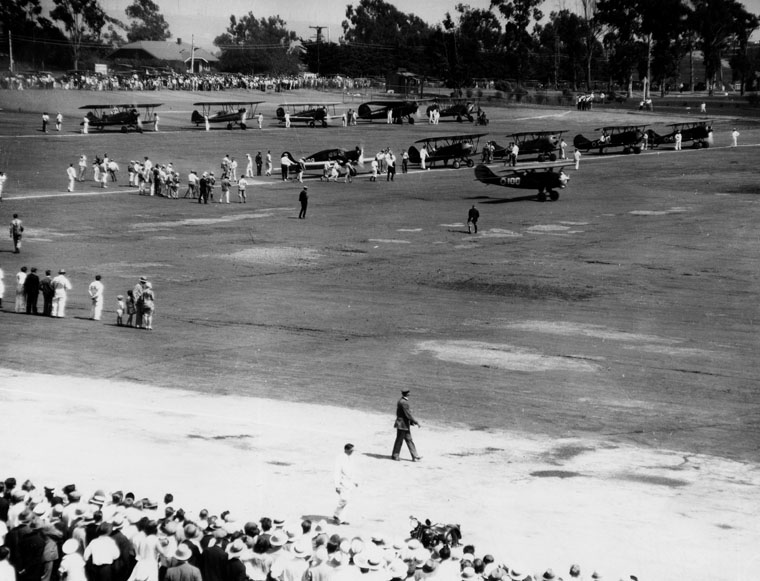 |
|
| (1929)* - Crowds gathered on the sides of Clover Field (Santa Monica Airport) to watch the air show. Several planes are parked on the field, waiting their turns to takeoff. |
Historical Notes On June 15, 1927 Santa Monica City Council changed the name of Clover Field to Santa Monica Airport (SMO). In 1928, the City acquired an additional 60 acres to expand the Airport and to accommodate an expanding Douglas plant. |
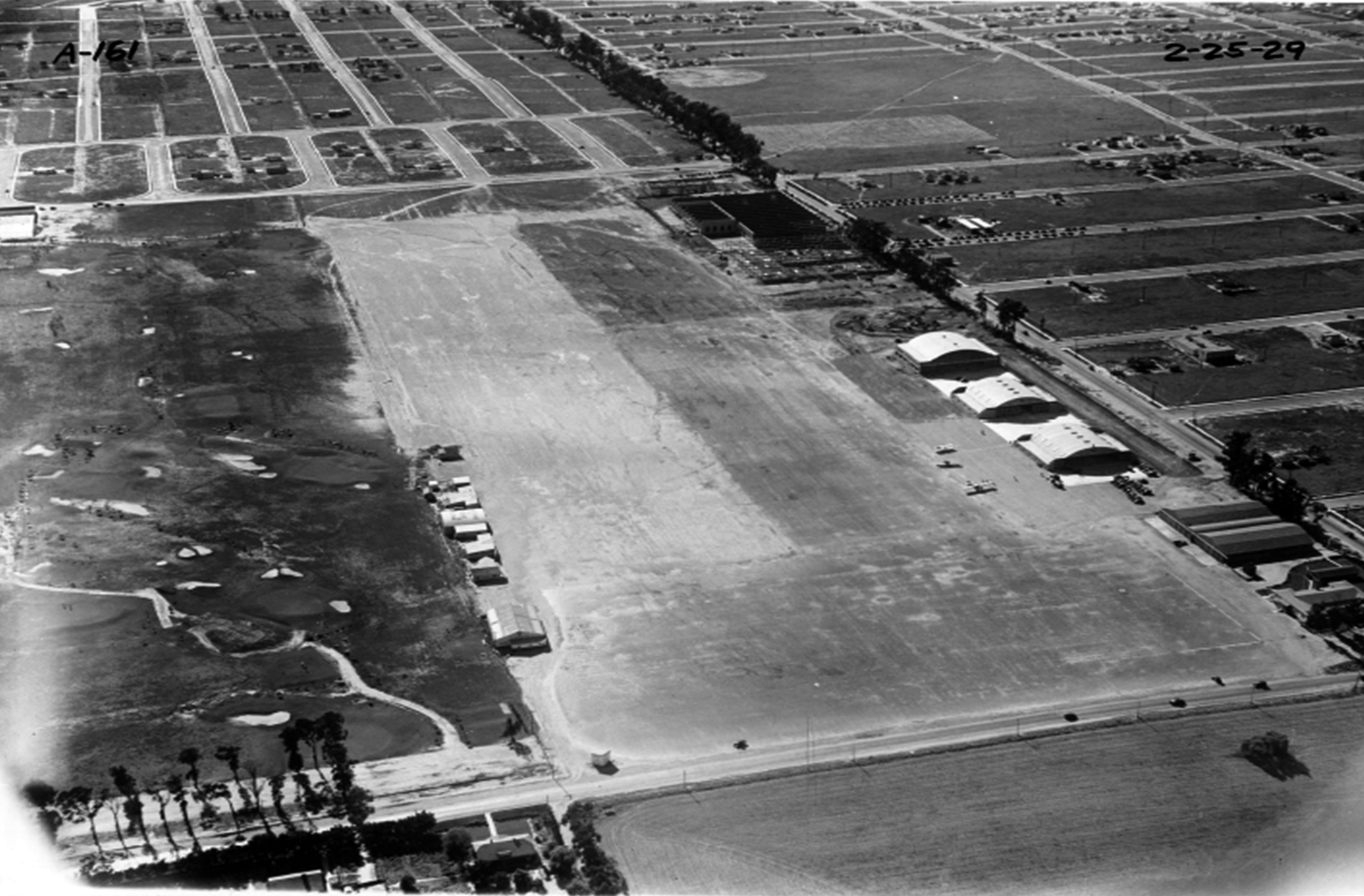 |
|
| (1929)* - View showing the Santa Monica Airport (previously named Clover Field). The Douglas Aircraft plant can be seen on the right. |
Historical Notes Donald Wills Douglas, Sr. founded the Douglas Aircraft Company in 1921 with his first plant on Wilshire Boulevard. He built a plant in 1922 at Clover Field (Santa Monica Airport), which was in use for 46 years. In 1924, four Douglas-built planes took off from Clover Field to attempt the first aerial circumnavigation of the world. Two planes made it back, after having covered 27,553 miles in 175 days, and were greeted on their return September 23, 1924 by a crowd of 200,000 (generously estimated). In 1929, Douglas enlarged its Santa Monica Airport operations, closed other facilities, and began to develop its early DC-2 and DC-3 airliners as well as other projects. |
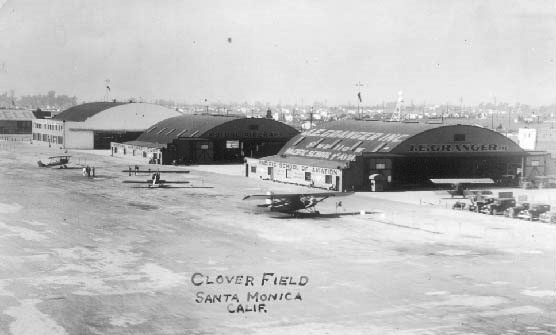 |
|
| (1930s)* – Close-up view of the original three big hangars on the north side of Clover Field. The large hangar at the back is the first Douglas Aviation hangar on the field, circa early 30's. |
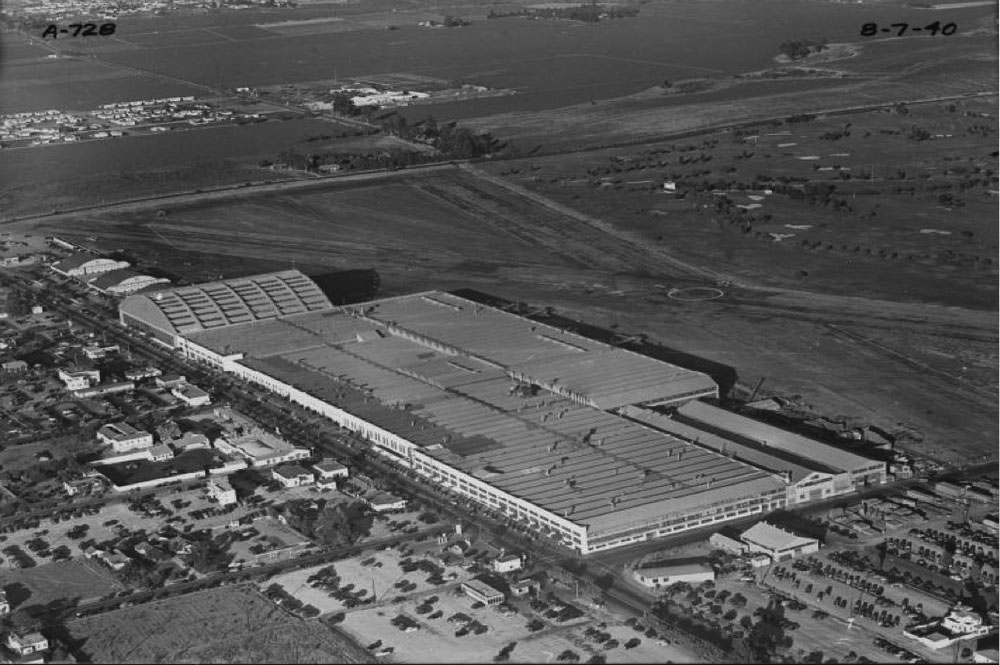 |
|
| (1940)* – Aerial view of the Santa Monica Airport looking towards the southeast with the Douglas plant filling the bottom half of the photo. Photo Date: August 7, 1940 |
Historical Notes Between 1941 and 1944 (During World War II), Douglas Aircraft becomes a major defense contractor, employing up to 44,000 workers who work three shifts, seven days a week. This economic engine transforms the city as thousands of new homes are built for the Douglas workers, creating Sunset Park and other neighborhoods. |
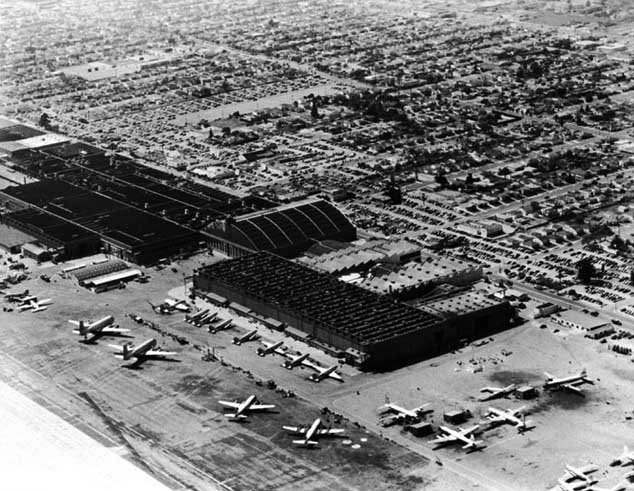 |
|
| (1940s)* - View of Douglas Aircraft with numerous planes positioned all around its plant. The surrounding neighborhood has been built up when compared to previous photo. |
Historical Notes Douglas Aircraft Co. was a major player in the aircraft industry during World War II. Local historians note that World War II affected Santa Monica more than most places, as the Federal Government (for national security reasons) leased the Airport from the City to provide protection for Douglas Aircraft – then a major defense contractor located in Sunset Park. The government also participated in the expansion of the facility to accommodate the ever-growing production of military aircraft by Douglas Aircraft. |
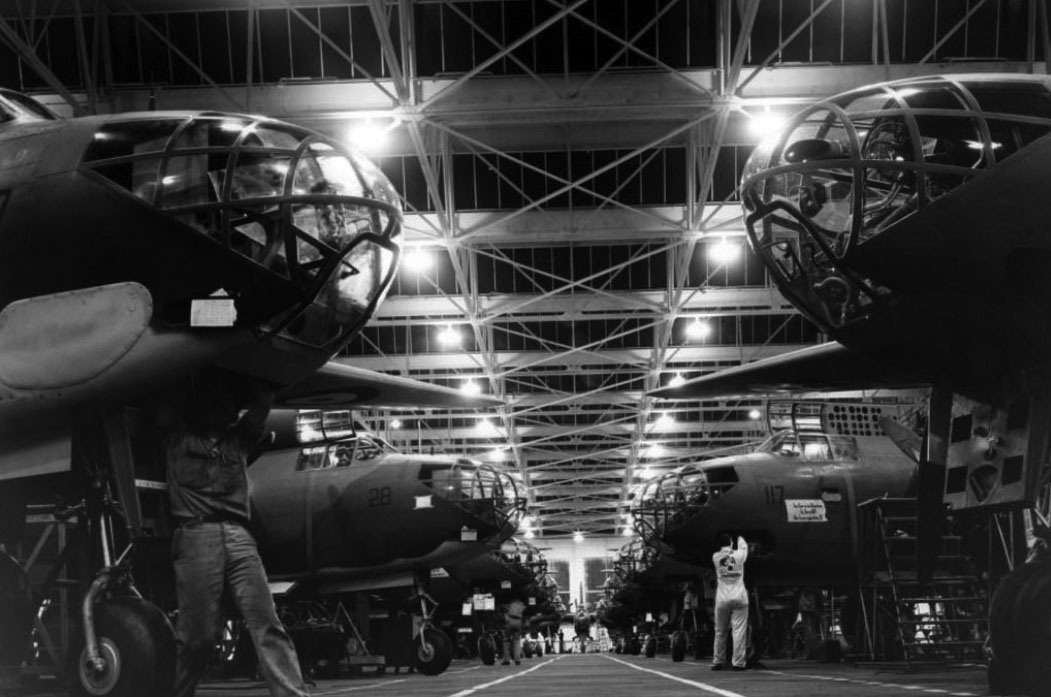 |
|
| (1940s)* – View showing night production of fighters at Douglas Aircraft Company's assembly plant in Santa Monica. |
Historical Notes Santa Monica CA- Along brilliantly lit assembly lines of Douglas Aircraft Company’s plant here, night crews are rushing production of DB-7B attackers bombers, recently acclaimed as night fighters in the defense of blacked out Britain. Equipped with heavy armament self-sealing fuel tanks and armor plating, these ships are proving swift and deadly in interception and downing Nazi raiders. R.A.F. early designated the DB-7 type the Boston and more recent the Havoc. Under a backlog in excess of $400,000,000 nearly 28,000 Douglas employees are working around the clock on attack ships, dive bombers and military transports for Americans and Britain. |
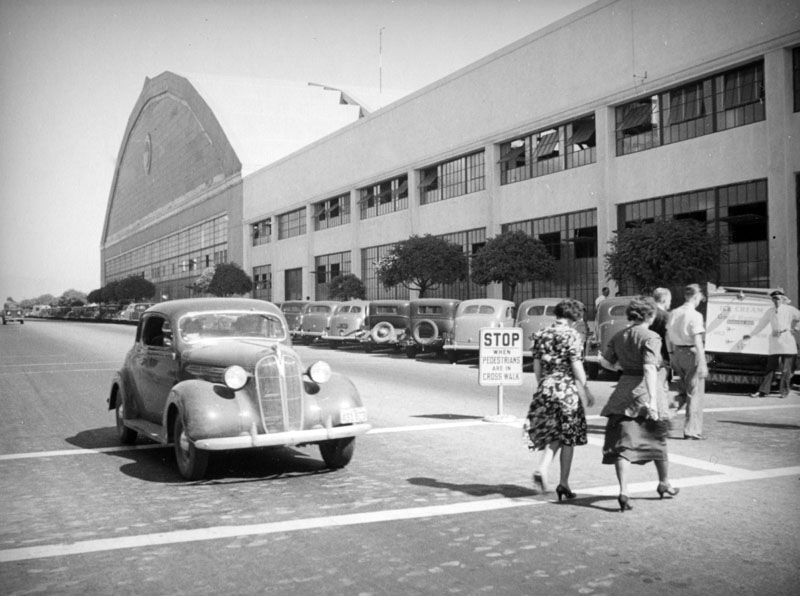 |
|
| (ca. 1940)* - An impatient car starts across the crosswalk while men and women are still crossing towards the Douglas Aircraft Company factory, located at 2700 Ocean Park Boulevard, Santa Monica. An ice cream truck is parked and the attendant is ready to catch workers as they return to work. |
Historical Notes At its peak, Douglas Aircraft, and Santa Monica Airport grew in size to its present 227 acres, employing 40,000 individuals. |
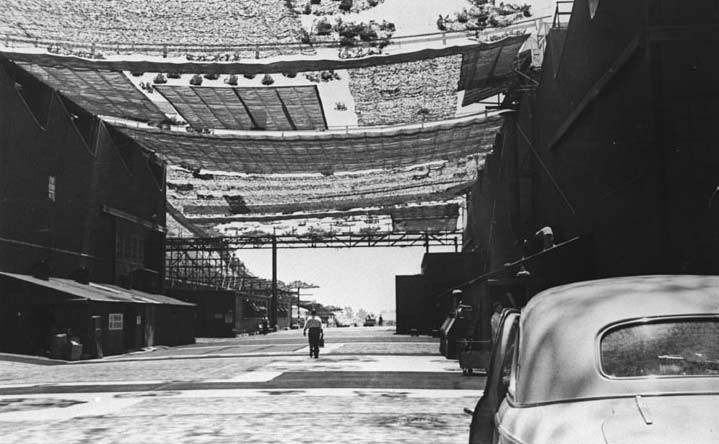 |
|
| (ca. 1945)* - Playing such a vital role in military aircraft production during World War II, camouflage was used to make the plant and airstrip disappear - at least from the air. |
Historical Notes During the war the airport area was cleverly disguised from the air with the construction of a false "town" (built with the help of Hollywood craftsman) suspended atop it. |
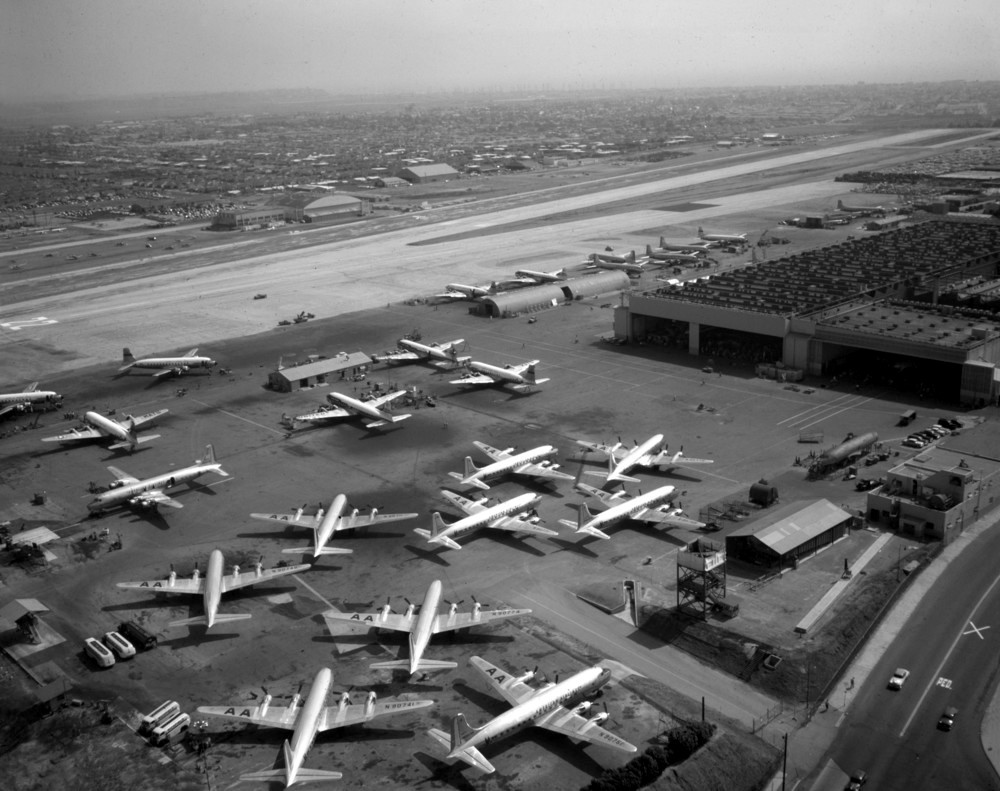 |
|
| (ca. 1950)* – Santa Monica Airport with the Douglas Aircraft plant seen at right. |
Historical Notes Clover Field (Santa Monica Airport) was once the site of the Army’s 40th Division Aviation, 115th Observation Squadron and became a Distribution Center after World War II. After World War II, Douglas Aircraft at Santa Monica Airport experienced a dramatic transformation. Having been a critical wartime manufacturer that produced nearly 30,000 aircraft and employed 160,000 workers, the company sought to pivot back to commercial aviation in the late 1940s and early 1950s. However, a pivotal moment came in 1958 when the city of Santa Monica refused Douglas's request to extend the airport runway for producing and testing the DC-8 jetliner. This decision prompted Douglas to close its Santa Monica plant, which had been a cornerstone of local industry, and relocate airliner production to Long Beach Airport. The departure marked the end of an era for Santa Monica Airport, which transitioned from a major aircraft manufacturing center to a general aviation facility serving business, training, and personal aircraft. In 1968, the Federal Aviation Administration formalized the airport's new role through a contract that committed the land to aviation services until 1988. This shift represented a significant change from the airport's previous status, where it had been responsible for manufacturing 90% of commercial air travel aircraft during the 1930s and 1940s, to a more localized aviation support role in the Greater Los Angeles area. |
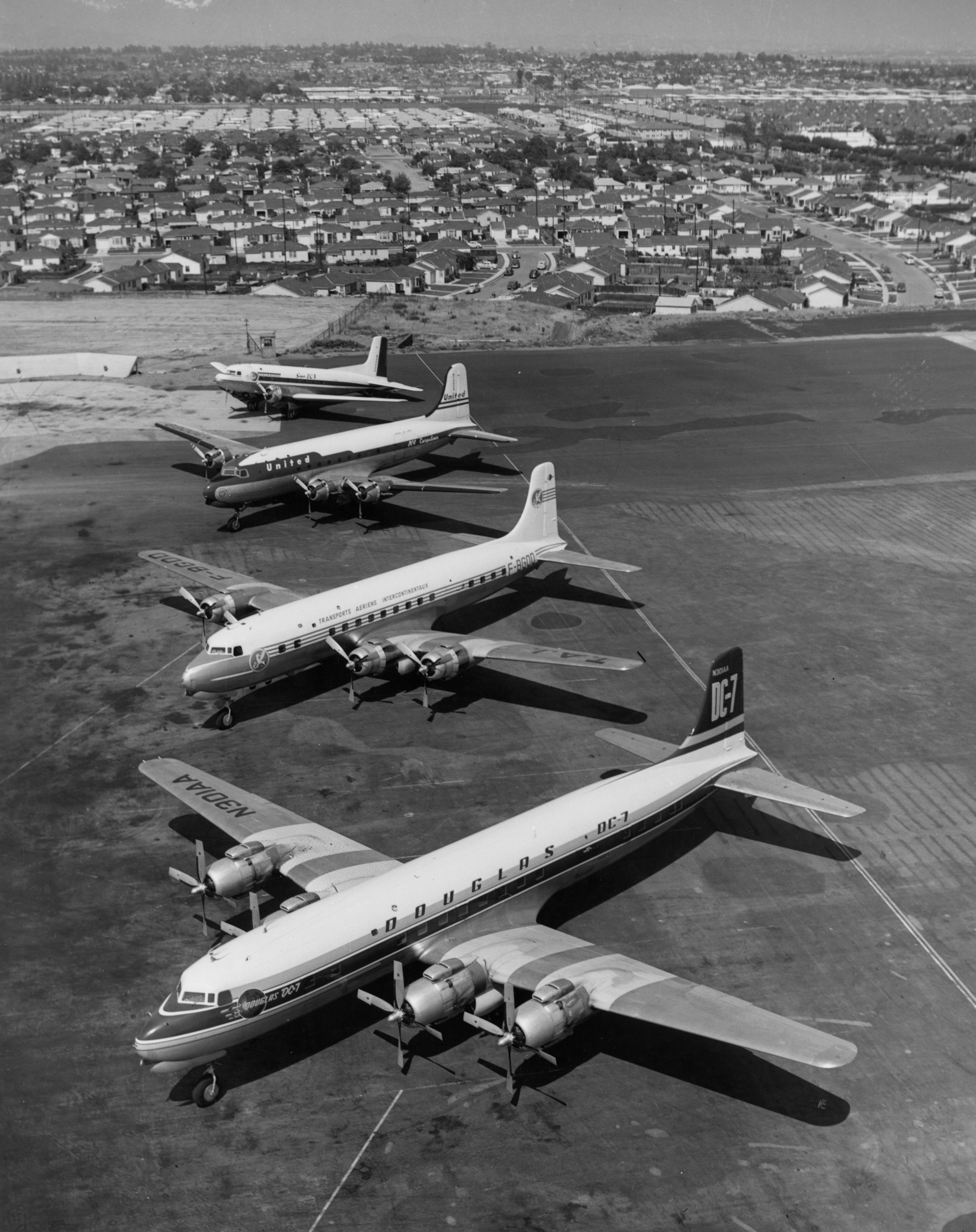 |
|
| (1953)*- Douglas DC-3, DC-4, DC-6, DC-7 lined up on the NE end of the Santa Monica Airport. The view is looking towards the east. |
Historical Notes In the 1950s, Santa Monica Airport underwent a significant transformation as it transitioned from a major aircraft manufacturing hub to a general aviation facility. The decade was marked by the departure of Douglas Aircraft, which closed its Santa Monica plant in 1958 after the city refused to lengthen the runway for the production of the DC-8, despite the company's historical significance at the airport. Douglas had previously employed tens of thousands of workers during World War II and dominated commercial aviation during the 1930s and 1940s. Following Douglas's exit, Santa Monica Airport shifted its focus to general aviation, accommodating business and personal aircraft, as well as flight training operations. In 1968, the Federal Aviation Administration (FAA) entered into a contract with the city, stipulating that airport land be used exclusively for aviation services until 1988, which included fuel services and aircraft maintenance. This period marked a notable shift in the airport's role within the Greater Los Angeles area, moving away from large-scale aircraft production to serving local aviation needs. |
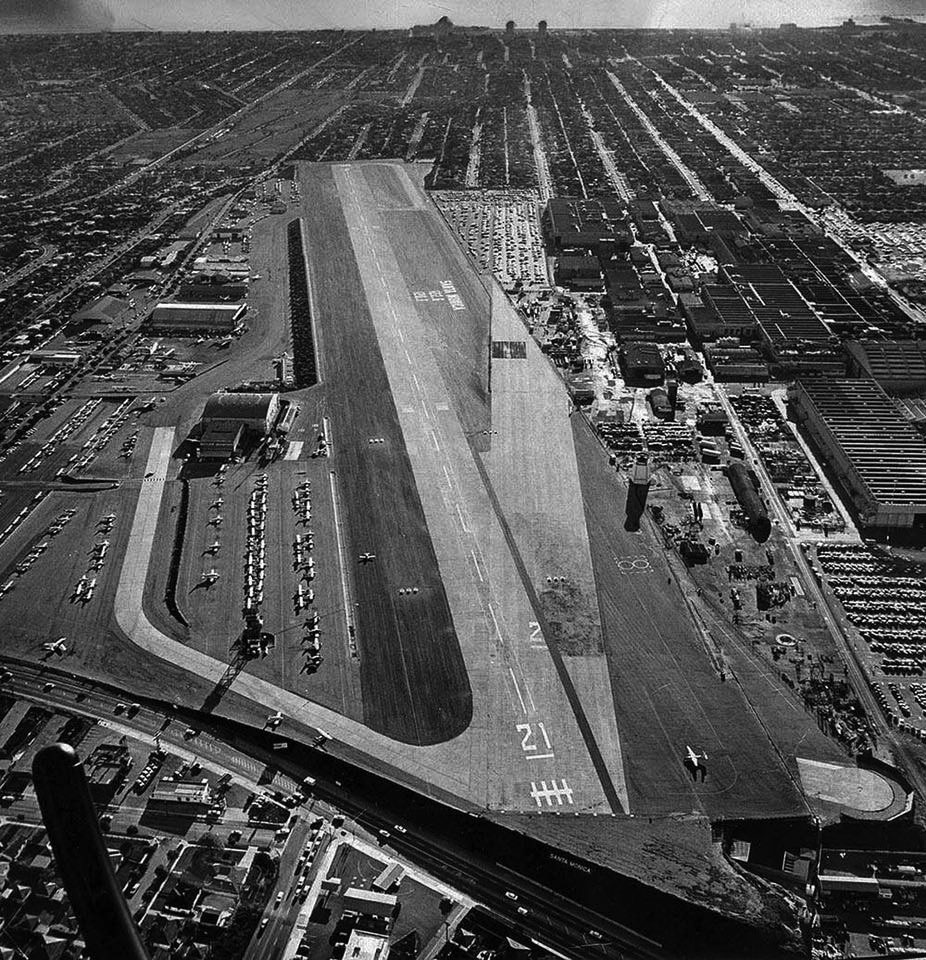 |
|
| (1967)* – Aerial view looking west toward the Pacific Ocean showing Santa Monica Airport. The Douglas Aircraft plant is on the right. |
Historical Notes In later years, Douglas Aircraft merged with a rival to become McDonnell-Douglas Corporation (1967) and moved to Long Beach (1976). The 5,000-foot runway at what was by then known as Santa Monica Airport was too short for the firm's growing jet production. Two decades later, McDonnell-Douglas would be absorbed by yet another rival, Boeing Company. When the corporation left town, Douglas' son, Donald Wills Douglas Jr, set up the Donald Douglas Museum and Library to commemorate his father's legacy. Douglas Sr. died in 1981. Nine years later, the nonprofit Museum of Flying, founded by golf course and real estate developer David Price, superseded the old museum as part of a $20-million airport overhaul. Exhibits included vintage planes and an immense photo of when the airport and plant operated under cover of camouflage. |
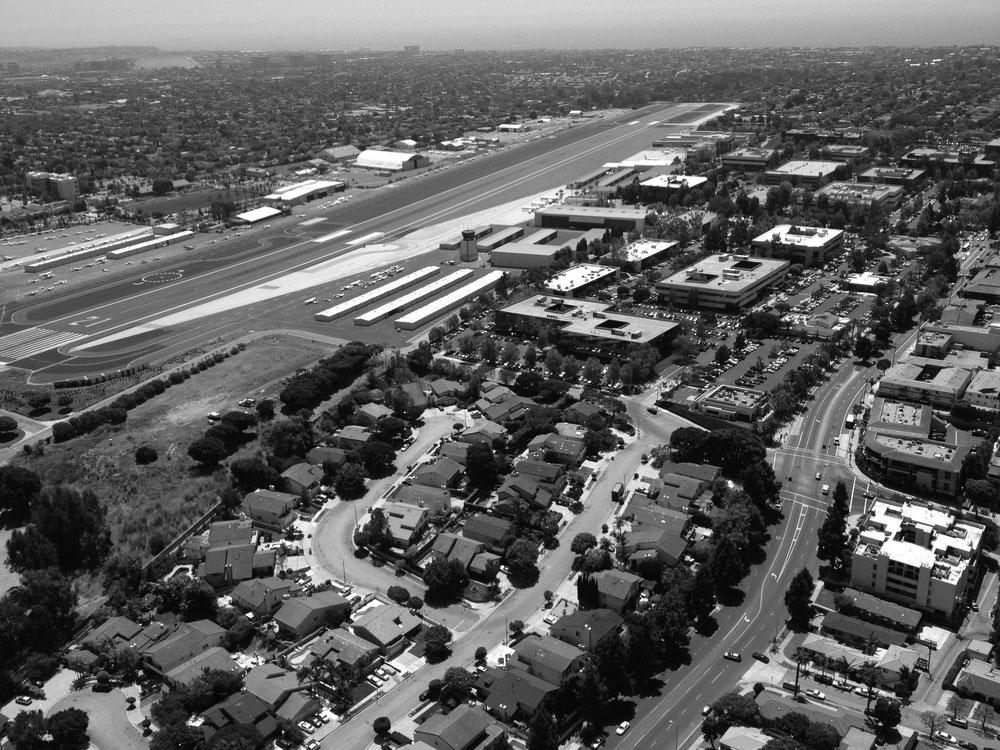 |
|
| (2014)* - Santa Monica Airport (SMO) as it appears today. |
Historical Notes On January 28, 2017, it was announced that Santa Monica City officials and the Federal Aviation Administration had reached an agreement to close the Santa Monica Airport on December 31, 2028 and return 227 acres of aviation land to the city for eventual redevelopment. It is anticipated that the airport land will be redeveloped into areas for parks, open space, recreation, education and/or cultural use. In an attempt to reduce jet traffic, the city planned to shorten the runway from 4,973 feet to 3500 feet by repainting the runway and moving some navigational aids. The shortening has been formally completed as of 2017 December 23. |
* * * * * |
Hughes Airport (Culver City / Playa Vista)
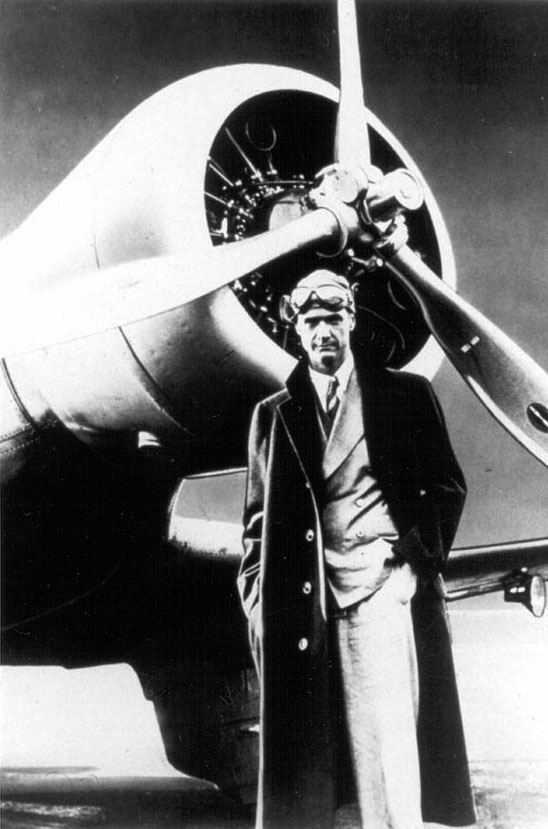 |
(1934)**^# - Howard Hughes at Playa Vista.
|
Historical Notes Howard Hughes was a lifelong aircraft enthusiast and pilot. At Rogers Airport in Los Angeles, he learned to fly from pioneer aviators, including Moye Stephens. He set many world records and commissioned the construction of custom aircraft for himself while heading Hughes Aircraft at the airport in Glendale. Operating from there, the most technologically important aircraft he commissioned was the Hughes H-1 Racer.*^ |
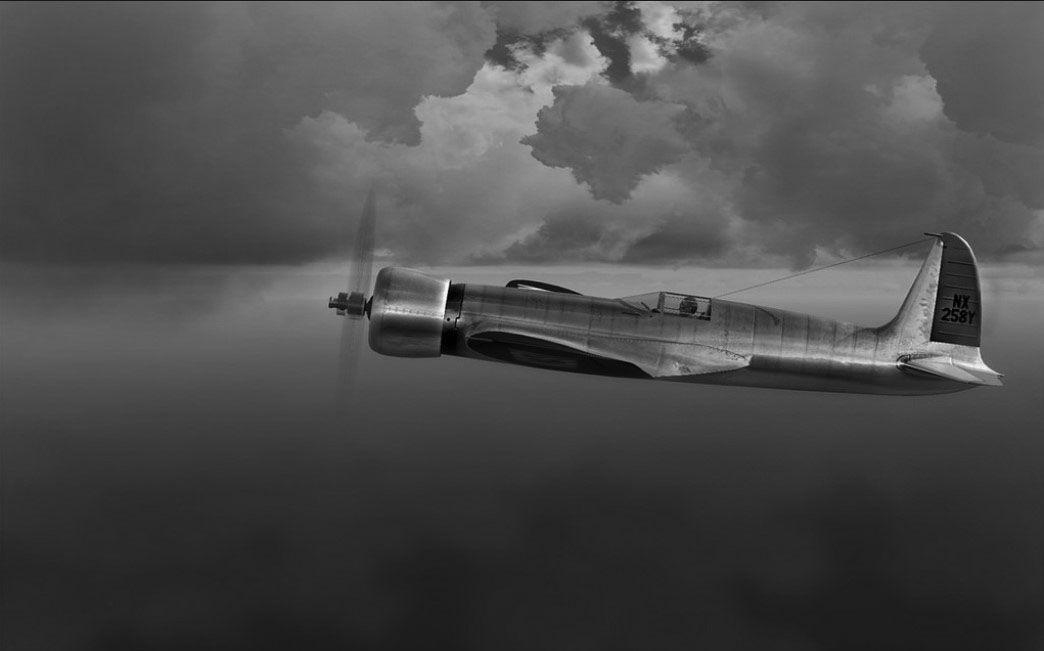 |
|
| (1935)#^ – View showing the Hughes H-1 Racer in flight. It set a world airspeed record and a transcontinental speed record across the United States. |
Historical Notes During his work on his movie Hell's Angels, Howard Hughes employed Glenn Odekirk to maintain the fleet of over 100 aircraft used in the production. The two men shared a common interest in aviation and hatched a plan to build a record-beating aircraft. The aircraft was given many names, but is commonly known as the H-1. It was the first aircraft model produced by the Hughes Aircraft company.*^ The original H-1 Racer was donated to the Smithsonian in 1975 and is on display at the National Air and Space Museum. |
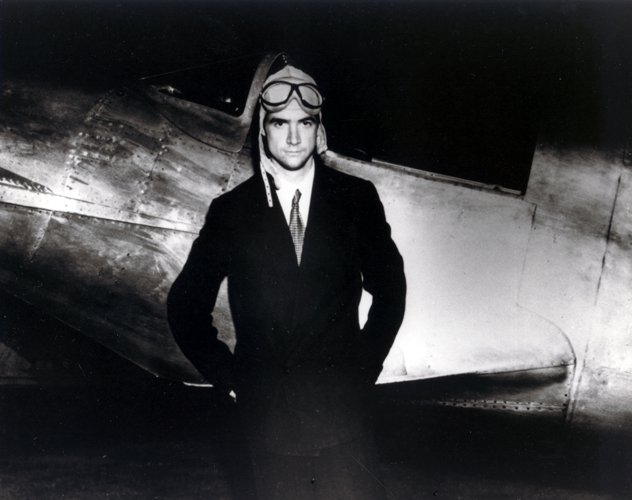 |
|
| (ca. 1935)* - Early photo of Howard Hughes standing in front of his H-1 Racer. |
Historical Notes On September 13, 1935, Hughes, flying the H-1, set the landplane airspeed record of 352 mph over his test course near Santa Ana, California. A year and a half later, on January 19, 1937, flying the same H-1 Racer fitted with longer wings, Hughes set a new transcontinental airspeed record by flying non-stop from Los Angeles to Newark in 7 hours, 28 minutes and 25 seconds (beating his own previous record of 9 hours, 27 minutes). His average ground speed over the flight was 322 mph. The H-1 Racer was the last aircraft built by a private individual to set the world speed record; every aircraft to hold the honor since has been a military design.*^ |
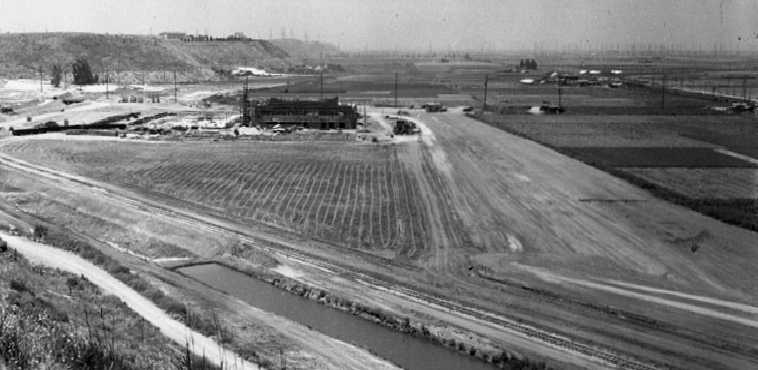 |
|
| (1941)*# - Aerial view looking west showing he Hughes plant under construction and the runway on the right side. |
Historical Notes By 1939 the Hughes Tool Company was engaged in a full-scale program to develop a high speed fighter bomber using Duramold plywood, a plastic-bonded plywood molded under heat & high pressure. This became the DX-2, later known simply as the D-2. To build the D-2, the Burbank facility would be insufficient, and Hughes sought a much larger facility than what at the time he was renting from the Lockheed Company in Burbank. In 1940 Hughes purchased 380 acres (although other sources put the initial purchase as over 1,000 acres) of the Ballona Wetlands just west of Culver City for $500,000. Hughes recognized the area as one of the few large tracts of remaining undeveloped land in Los Angeles. The high water table made it necessary to sink 50' pilings into the wetlands to support Hughes’ buildings & reroute the course of the Centinela River, which flowed through the site every spring & flooded it. On his new land Hughes constructed a 60,000 square foot air conditioned, humidity-controlled aircraft plant with an adjacent grass runway.*# Little known fact: The Los Angeles River was originally alluvial, meaning its banks and bed were formed from loose sediments and rock that allowed it to change its path depending on water flow and season. Up until the early 1800's, the river actually flowed into the Pacific near Marina Del Ray (Ballona Wetlands), but a particularly severe flash flood in 1825 diverted the river all the way to Long Beach, where it has remained since.**^ |
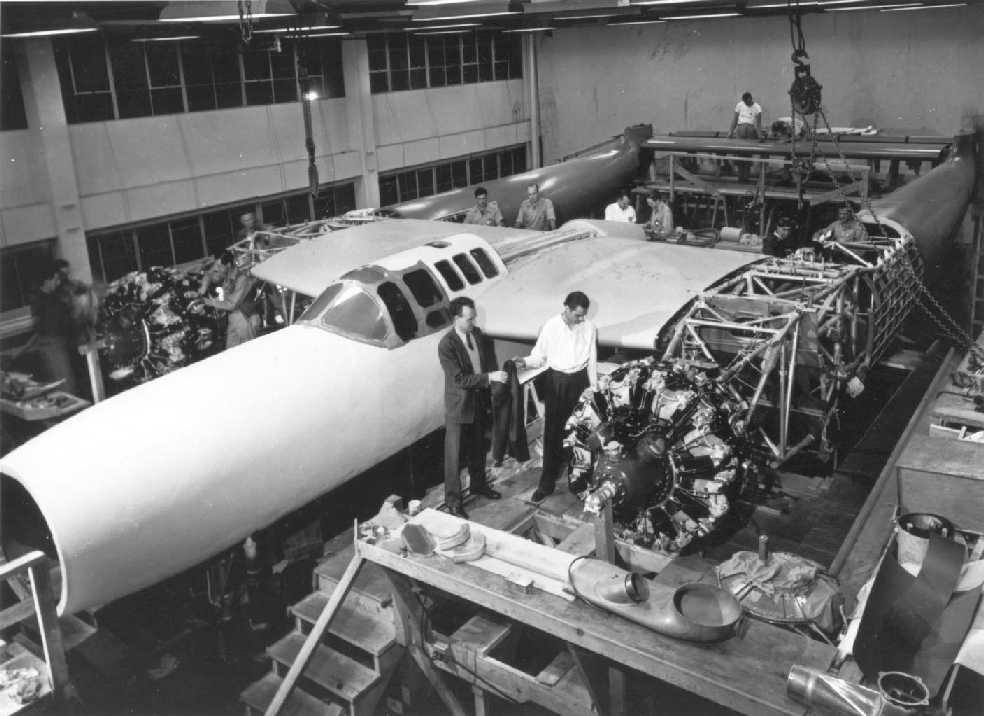 |
|
| (ca. 1942)*# - Photo of Howard Hughes inspecting the prototype of the Hughes D-2 in the Hughes Culver City factory. |
Historical Notes The D-2 was built in secret at the Hughes Culver City factory with longtime Hughes associate, Glenn Odekirk, providing engineering inputs. The fighter that emerged from the Hughes experimental shop looked like a scaled-up P-38 Lightning and, on paper, sported similar performance potential. The D-2 had a twin-boom configuration, powered by a pair of 2,000 hp Pratt & Whitney R-2800s.*# |
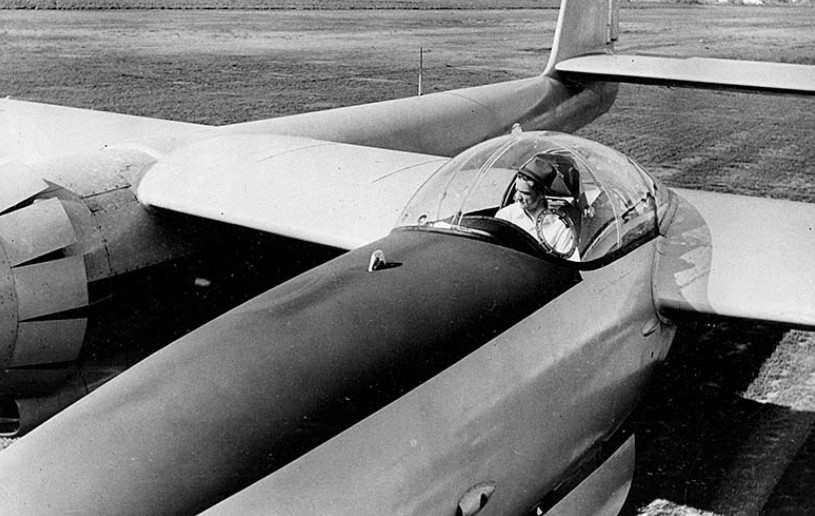 |
|
| (1946)#^ - American industrialist and aviator Howard Hughes sits in the cockpit of his new XF-11. The plane was built in conjunction with the U.S. Army Air Force and designed especially for photo reconnaissance work. |
Historical Notes Shortly after Howard Hughes took off in the first XF-11 prototype from the Culver City runway on July 7, 1946, one of the propellers inadvertently went into reverse thrust, sending the craft out of control. The XF-11 crashed into a house in Beverly Hills, severely injuring Howard Hughes.*# |
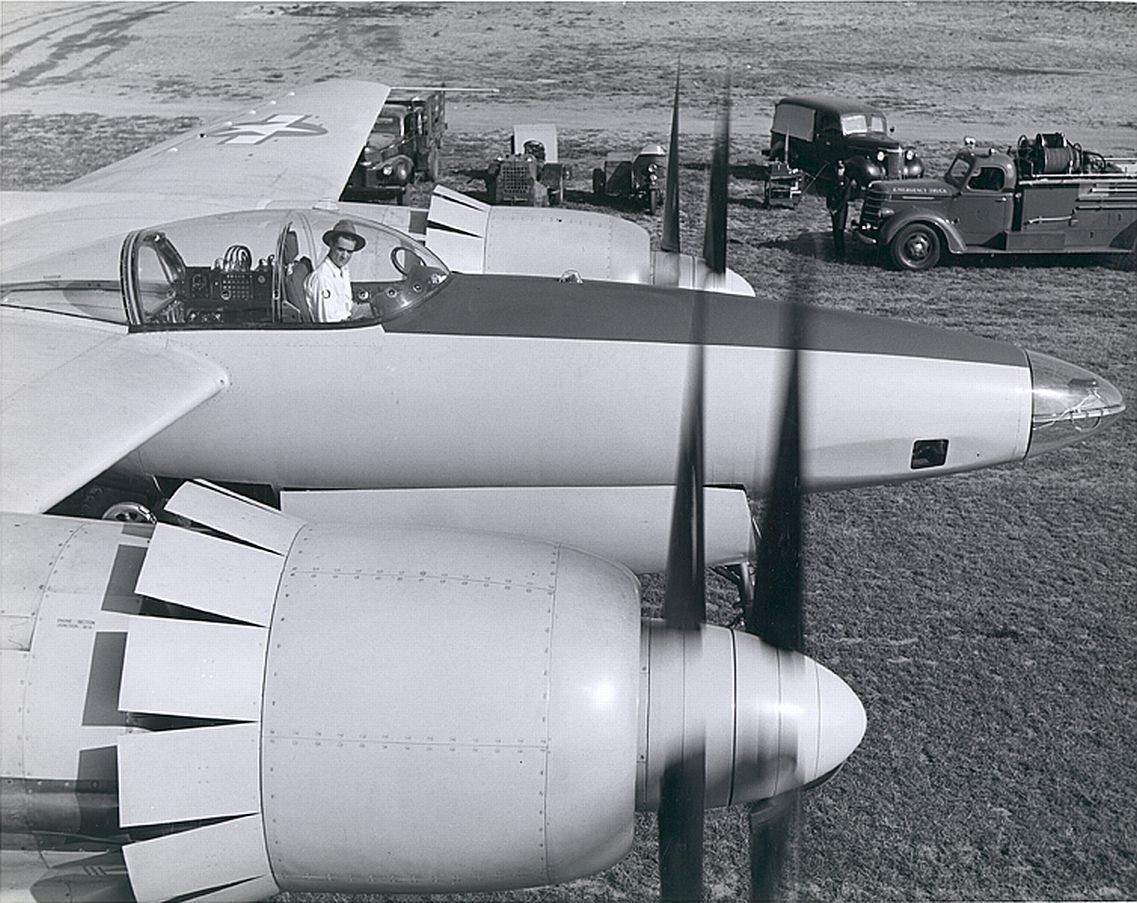 |
|
| (1946)^ - View showing Howard Hughes in his XF-11 reconance plane. |
Historical Notes This expirmental plane crashed in Beverly Hills nearly killing Howard. One of the counter rotating props gearbox kept looking oil during taxi testing but Howard decided to fly it anyway. Suddenly the prop reverse pitched causing huge drag. Had Howard shut off that engine he could have landed. He also kept the plane up flying much longer than planned. He was never supposed to retract the landing gear or fly for the length he did. Ground crew told him to bring it in but he was Howard Hughes. He lived how he wanted. Plane was the XF11 reconance plane. The rebuild did not have the same counter rotating props. It had two of the 28 cylinder corn cob engines like the Hurculese Flying Boat and the Spruce Goose. |
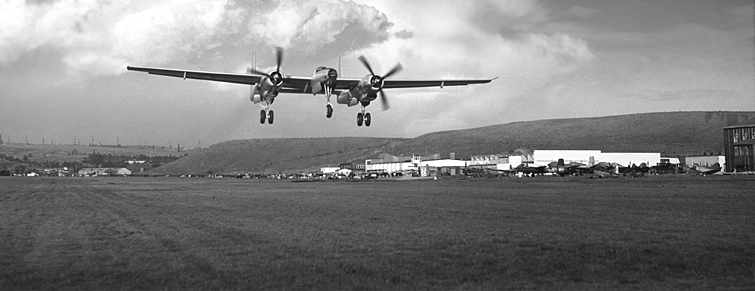 |
|
| (1947)*# - The 2nd prototype of the Hughes XF-11 takes off from Culver City on April 4, 1947. It had been fitted with conventional 4-bladed propellers, addressing the 1st prototype's fatal flaw. |
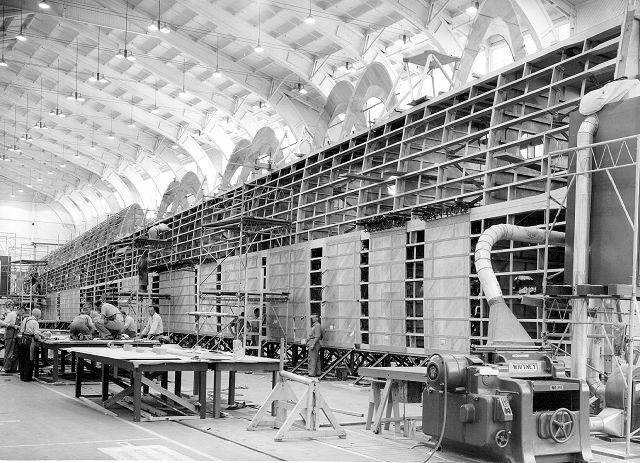 |
|
| (ca. 1940s)*# - View showing a wing of the Hughes HK-1 Hercules ('Spruce Goose') flying boat under construction within the Culver City assembly building. |
Historical Notes The 'Spruce Goose,' officially known as the Hughes HK-1 Hercules, was built and stored here. A full-time crew of 300 workers, all sworn to secrecy, maintained the plane in flying condition in a climate-controlled hangar at Hughes Airport. The crew was reduced to 50 workers in 1962, and then disbanded after Hughes' death in 1976. By the mid-1990s, the former Hughes Aircraft hangars here, including the one that held the Hercules, were converted into sound stages. Scenes from movies such as Titanic, What Women Want, and End of Days have been filmed in the 315,000-square-foot aircraft hangar where Hughes created the flying boat. It also features in the computer Game "Crimson Skies". The hangar will be preserved as a structure eligible for listing in the National Register of Historic Buildings.*^ |
Spruce Goose
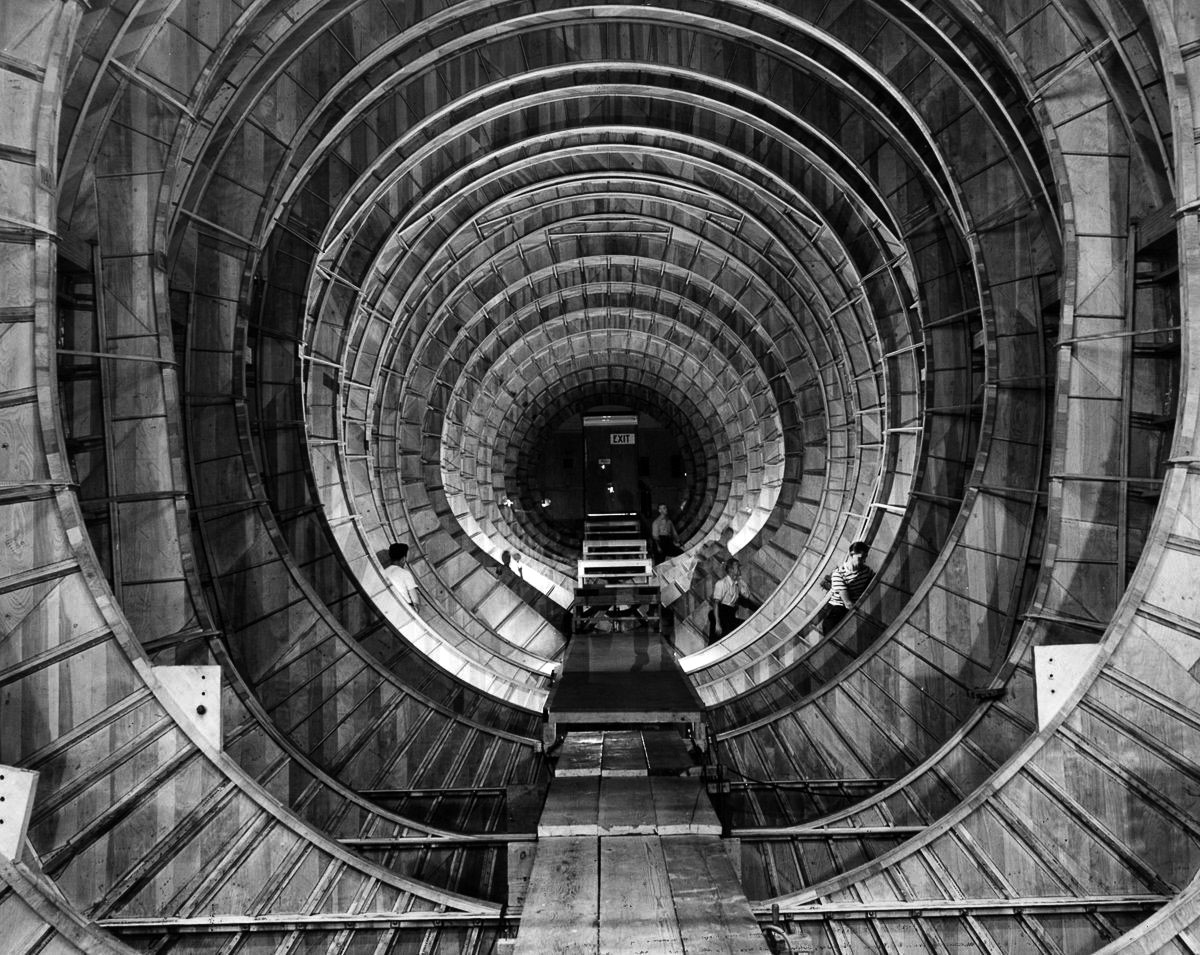 |
|
| (1940s)++# - Interior view of the 'Spruce Goose' fuselage. |
Historical Notes The 'Spruce Goose' was the brainchild of Henry J. Kaiser, a leading Liberty ship builder. He teamed with aircraft designer Howard Hughes to create what would become the largest aircraft built at that time. It was designed to be capable of carrying 750 fully equipped troops or one M4 Sherman tank. The original designation "HK-1" reflected the Hughes and Kaiser collaboration.*^ |
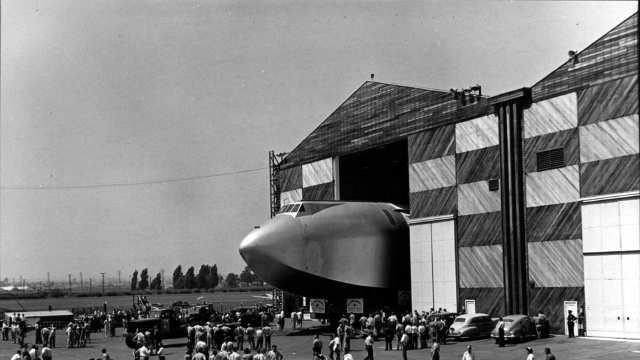 |
|
| (1944)^*# - Fuselage of H-4 (‘Spruce Goose’) peeking out of the west door on the north side of building 15. |
 |
|
| (1944)**^# – View showing the 'Spruce Goose' shortly after exiting its hangar at Playa Vista. |
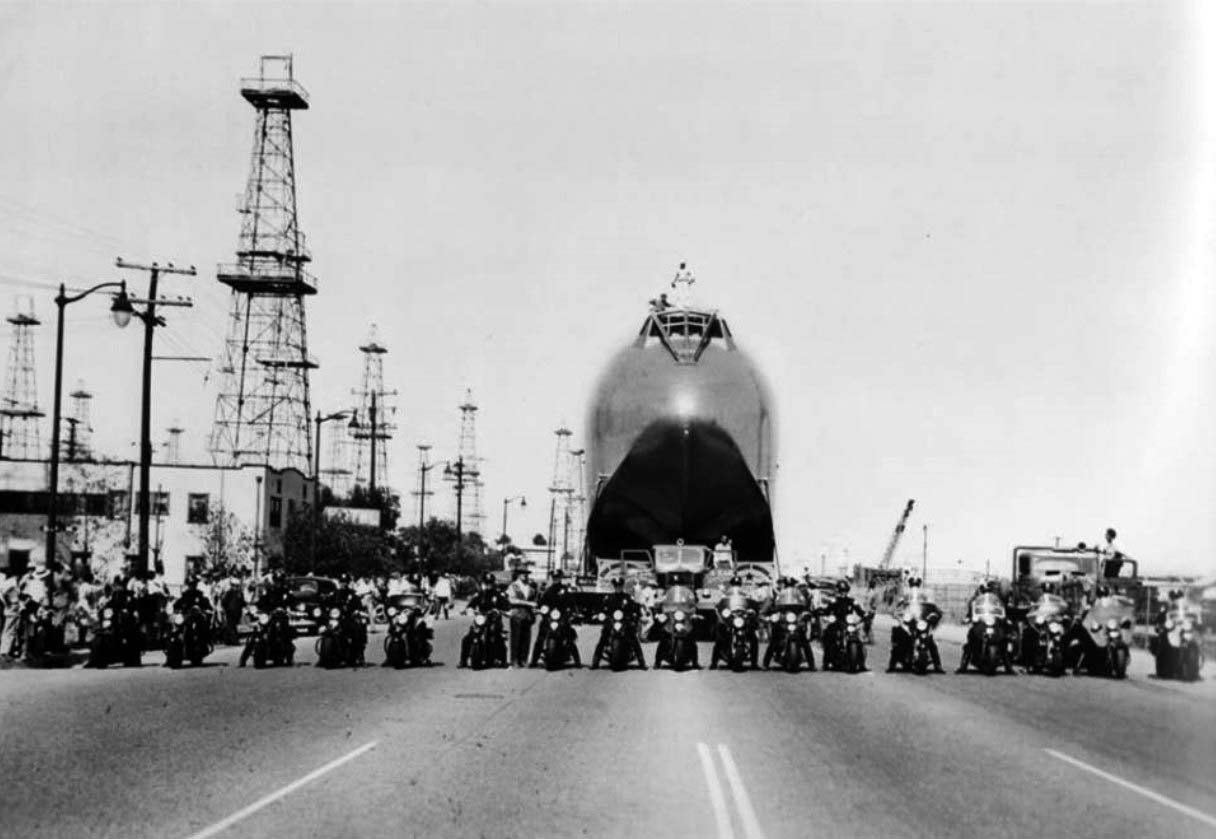 |
|
| (1947)^^## - View showing a police escort for the 'Spruce Goose' to the Harbor. |
Historical Notes The Hughes H-4 Hercules was originally contracted by the U.S. government for use during World War II to transport troops and equipment across the Atlantic as an alternative to sea-going troop transport ships that were vulnerable to German U-boats. However the aircraft was not completed until after the end of World War II. The concept for the Hercules was originally conceived by industrialist Henry J. Kaiser, who teamed with Hughes to build the aircraft.*^ |
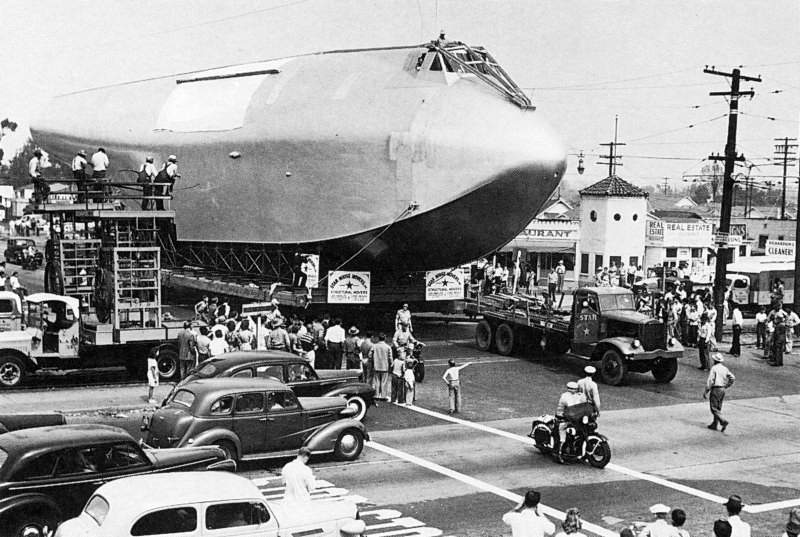 |
|
| (1947)##* – View showing the 'Spruce Goose' being towed through an intersection on its way to the Harbor. Several men are seen standing on a platform rigged-up on the back of a flatbed truck (left) assisting with the overhead lines clearance. |
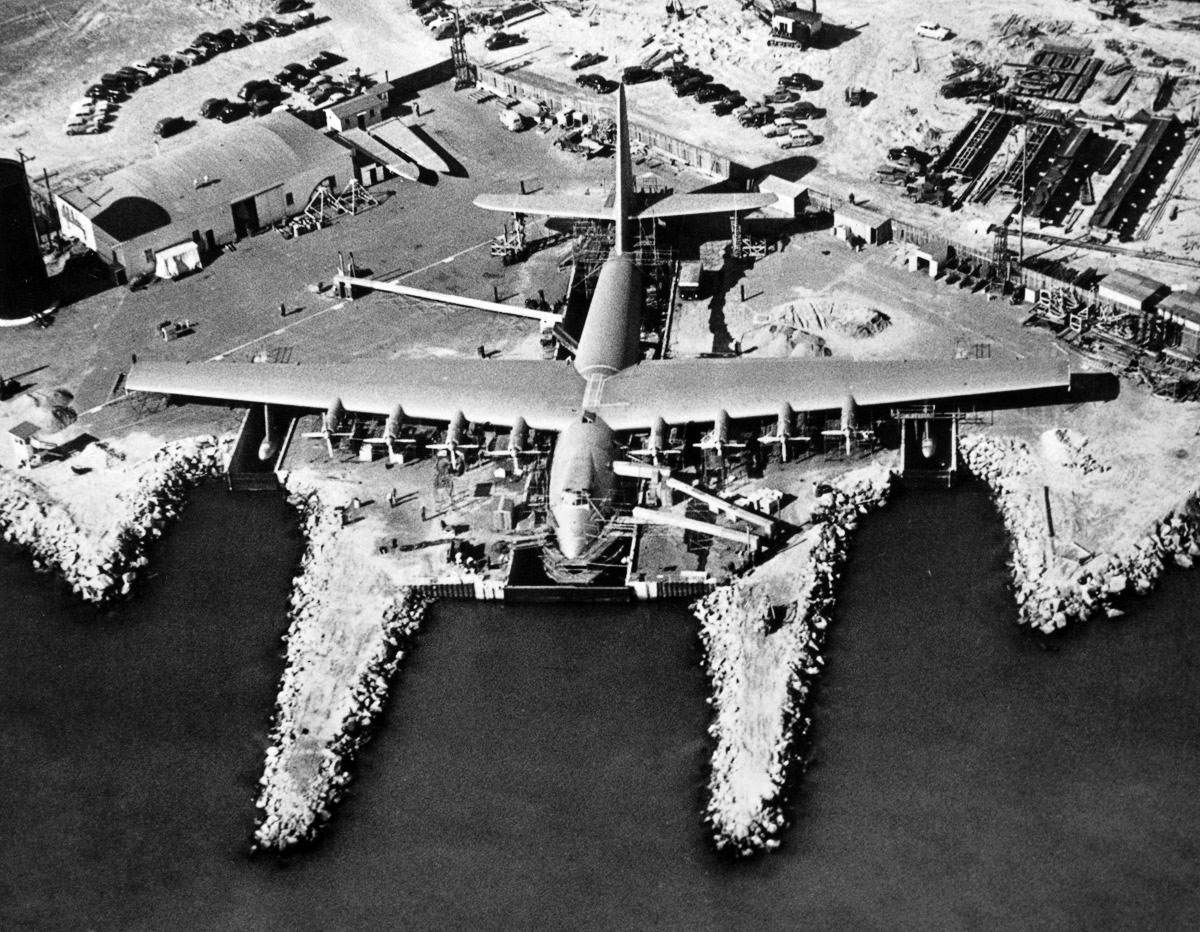 |
|
| (1947)++# – The 'Spruce Goose' undergoes final assembly at the docks of Long Beach–Los Angeles Harbor. |
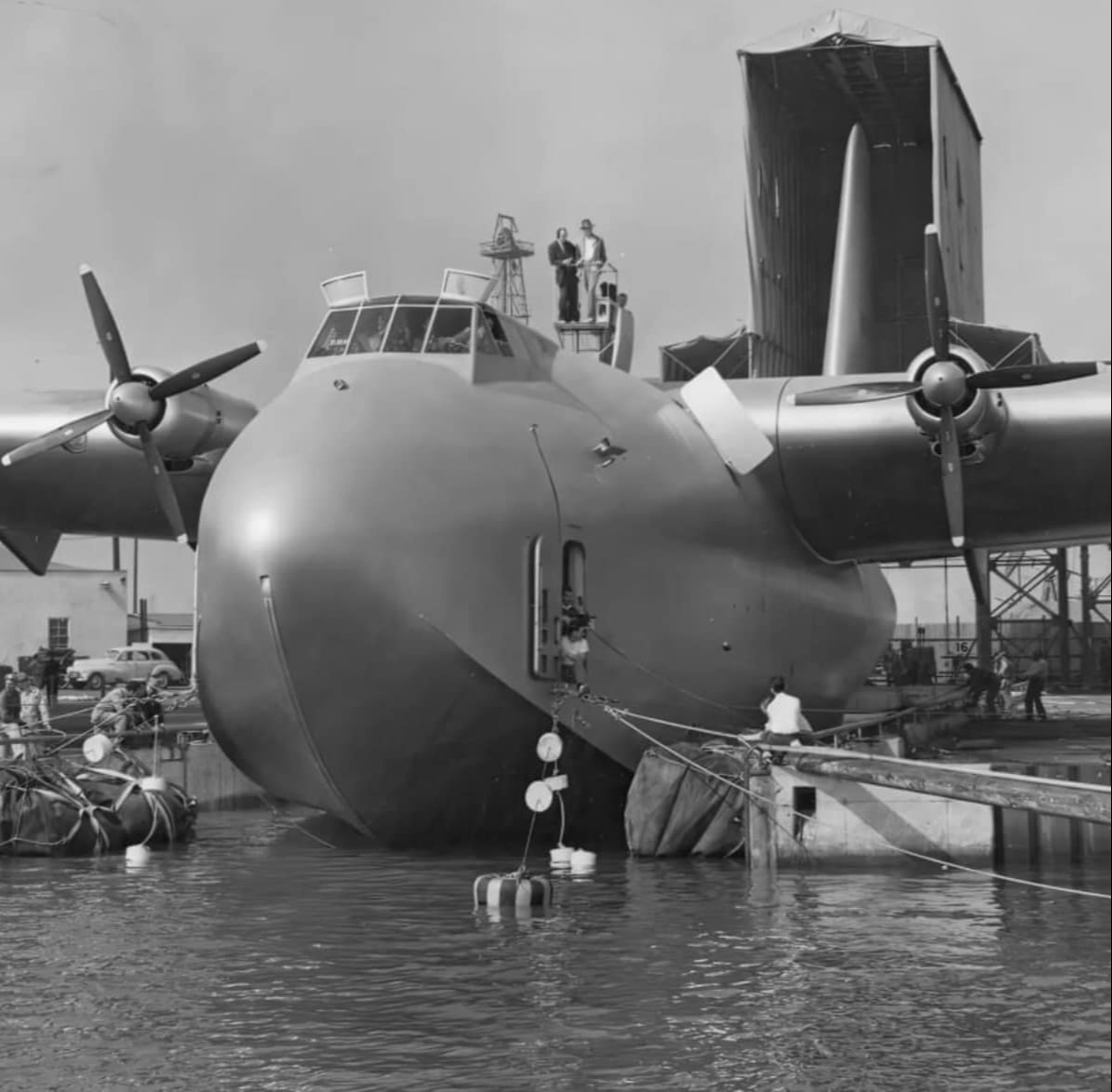 |
|
| (1947)* - The Hughes Aircraft H-4 Hercules 'Spruce Goose' with Howard Hughes standing on the platform. |
 |
|
| (1947)^*# - The Hughes Aircraft H-4 Hercules 'Spruce Goose' is being positioned in the Long Beach-Los Angeles Harbor for its first (and last) taxi tests on November 2, 1947. |
Historical Notes An estimated 15,000 persons jammed beaches and piers along the course to watch the boat’s trials. Hundreds of small boats ranging from fishing craft to row-boats swarmed waters adjacent to the taxing lane. A Coast Guard cutter stood by to warn spectators clear of the plane.** |
 |
|
| (1947)++# – With Howard Hughes at the controls, the 'Spruce Goose' begins its first series of taxi tests. The Long Beach skyline is seen in the background. |
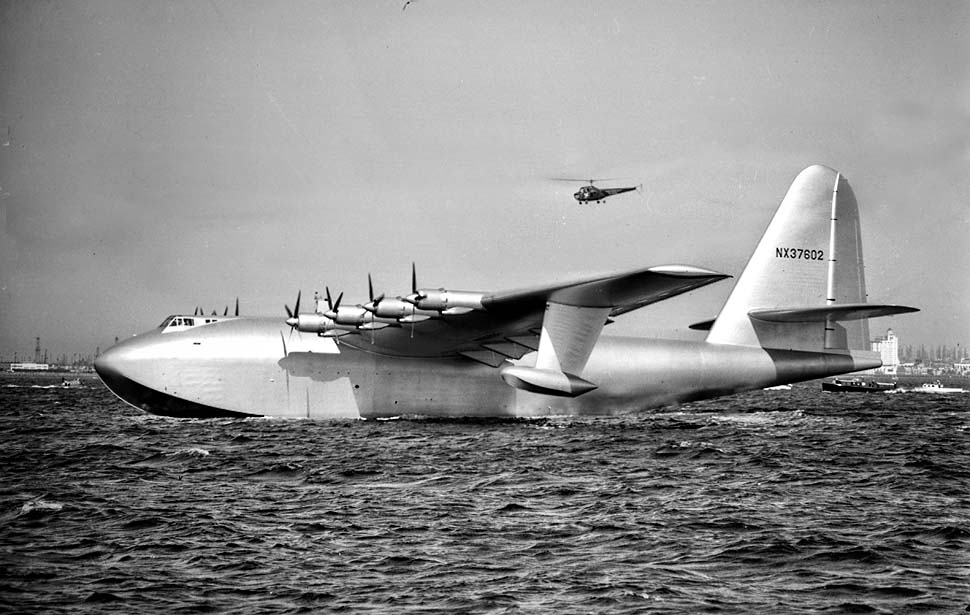 |
|
| (1947)** - The 'Spruce Goose' during taxi tests in the Long Beach-Los Angeles Harbor with Howard Hughes at the controls. |
Historical Notes Hughes piloted the boat on a course roughly paralleling the shoreline from Terminal Island Navy Base to offshore from Pier A in Long Beach. |
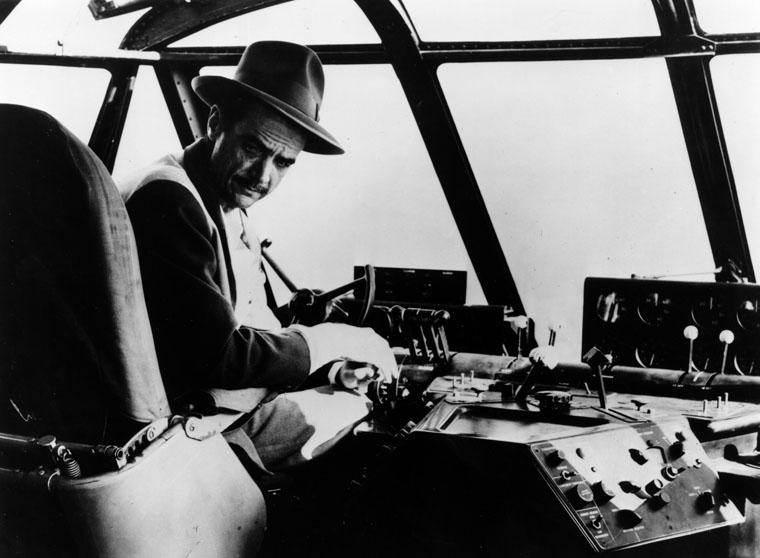 |
|
| (ca. 1947)* - Howard Hughes getting the feel of the cockpit in his famous 'Spruce Goose' seaplane. |
Historical Notes Howard Robard Hughes, Jr. (December 24, 1905 – April 5, 1976) was a business magnate, investor, aviator, aerospace engineer, film maker and philanthropist. He was one of the wealthiest people in the world. As a maverick film producer, Hughes gained prominence in Hollywood from the late 1920s, making big-budget and often controversial films like The Racket (1928), Hell's Angels (1930), Scarface (1932) and The Outlaw (1943). Hughes is also remembered for his eccentric behavior and reclusive lifestyle in later life, caused in part by a worsening obsessive–compulsive disorder and chronic pain. His legacy is maintained through the Howard Hughes Medical Institute.*^ |
 |
|
| (1947)*# - Hughes Hercules ('Spruce Goose') made its first and only flight in 1947 with Howard Hughes himself at the controls, November 2, 1947. |
Historical Notes In addition to the multimillionaire planemaker, 30 engineers, technicians and observers were aboard the plywood giant for its first movement under its own power.** |
.jpg) |
|
| (1947)** - The Hughes Aircraft H-4 Hercules 'Spruce Goose' during short flight in the Long Beach-Los Angeles Harbor. |
Historical Notes The Hercules flew only once for one mile, and 70 feet above the water, with Hughes at the controls.*^ |
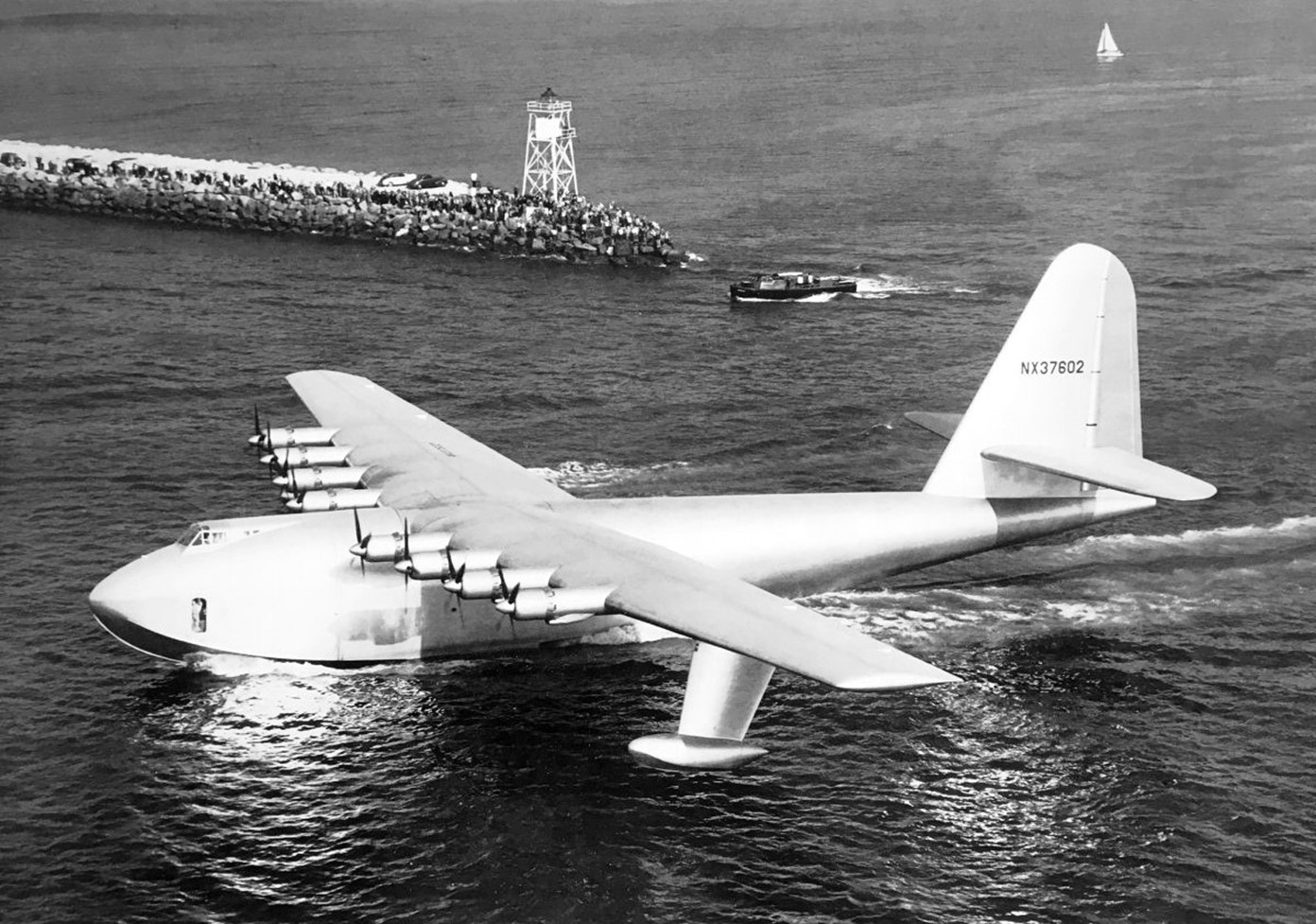 |
|
| (1947)* - The Spruce Goose landing on the water at the Long Beach Harbor. |
 |
|
| (1947)^#^# - Howard Hughes's H-4 Hercules - The 'Spruce Goose' - It flew only once on Nov. 2, 1947. The Hercules is the largest flying boat ever built and has the largest wingspan of any aircraft in history. They really weren't sure it would lift off - but it did. |
Historical Notes The aircraft made its first and only flight on November 2, 1947, and the project never advanced beyond the single example produced. Built from wood because of wartime restrictions on the use of aluminum and concerns about weight, its critics nicknamed it the 'Spruce Goose', despite its being made almost entirely of birch rather than spruce. The Hercules is the largest flying boat ever built and has the largest wingspan of any aircraft in history. It survives in good condition at the Evergreen Aviation Museum in McMinnville, Oregon.*^ |
 |
|
| (1947)^ - Howard Hughes' H-4 Hercules troop transport plane, the "Spruce Goose," Long Beach Harbor. Photo By J. R. Eyerman - The LIFE Picture Collection |
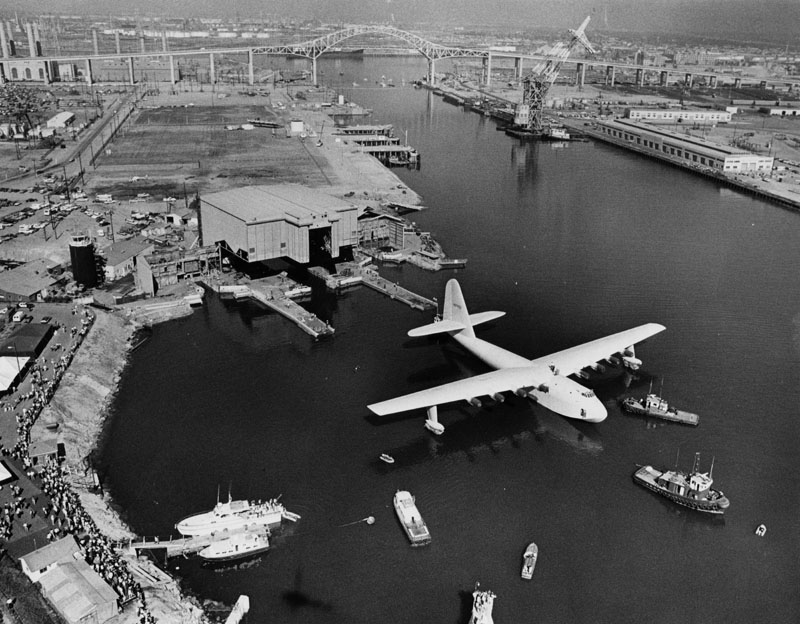 |
|
| (1980)* - Photograph caption dated October 30, 1980 reads, "Tugboats escort Spruce Goose from hangar where it's been housed for 33 years and head for a new berth near Queen Mary." |
Historical Notes In 1980, the Spruce Goose was acquired by the Aero Club of Southern California, which put the aircraft on display in a large dome adjacent to the Queen Mary exhibit in Long Beach.*^ |
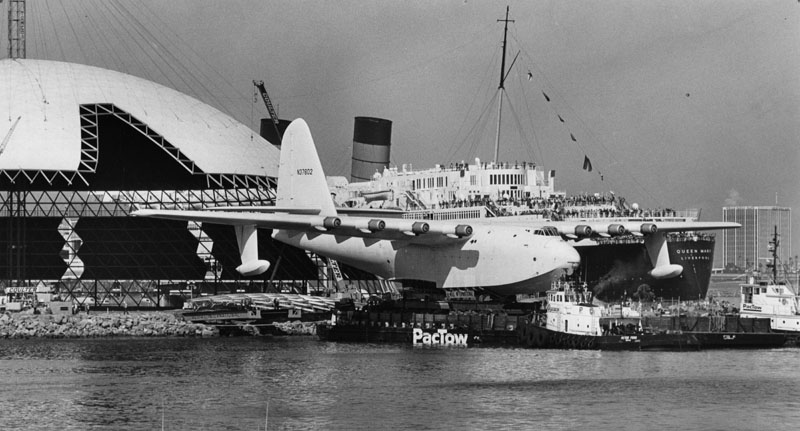 |
|
| (1982)* - Photograph caption dated February 11, 1982 reads, "Spruce Goose, Howard Hughes' 210-foot-long flying machine that flew only once, found a new home yesterday: a vast aluminum exhibition dome next to the Queen Mary's berth in Long Beach. As hundreds watched from the stern of the ocean liner, the $25 million plane was moved into the 130-foot-high dome, ending a 4 1/2-mile barge trip. Designed by Hughes to carry troops during World War II, the Goose flew one mile in 1947 and has been resting ever since. Now she'll star in a Wrather Corp. exhibit simulating her long-avoided flight." |
 |
|
| (1982)* - Photograph caption dated February 15, 1982 reads, "The dome housing the Spruce Goose is the world's largest clear-span aluminum dome, covering 135,000 square feet, with a diameter of 415 feet." |
Historical Notes In 1988, the Walt Disney Company acquired both attractions and the associated real estate. Disney informed the Aero Club of Southern California that it no longer wished to display the Hercules after its highly ambitious Port Disney was scrapped. In 1993, the Aero Club of Southern California sold the Hughes flying boat to Evergreen Aviation Museum. The aircraft was disassembled and transported by barge, train and truck to its current home in McMinnville, Oregon (about 40 miles southwest of Portland), where it was reassembled and is currently on display.*^ |
* * * * * |
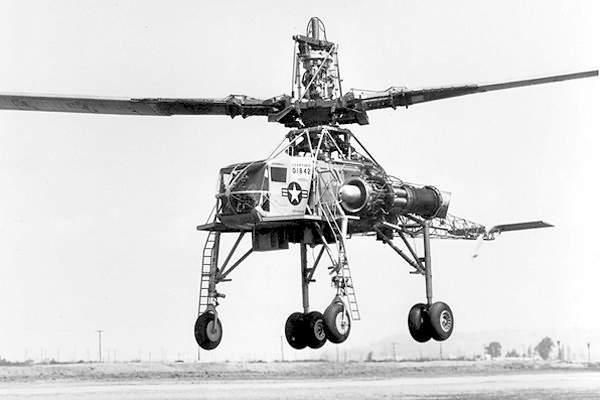 |
|
| (ca. 1952)*# - View of the first helicopter produced by Hughes, the giant XH-17 "Flying Crane", flying above the Culver City runway. |
Historical Notes In 1947, Howard Hughes redirected the Hughes Aircraft Company's efforts from airplanes to helicopters. The effort began in earnest in 1948, when helicopter manufacturer Kellett Autogiro Corporation sold their latest design to Hughes for production. The XH-17 "Sky Crane" first flew in October 1952, but was commercially unsuccessful.*^ |
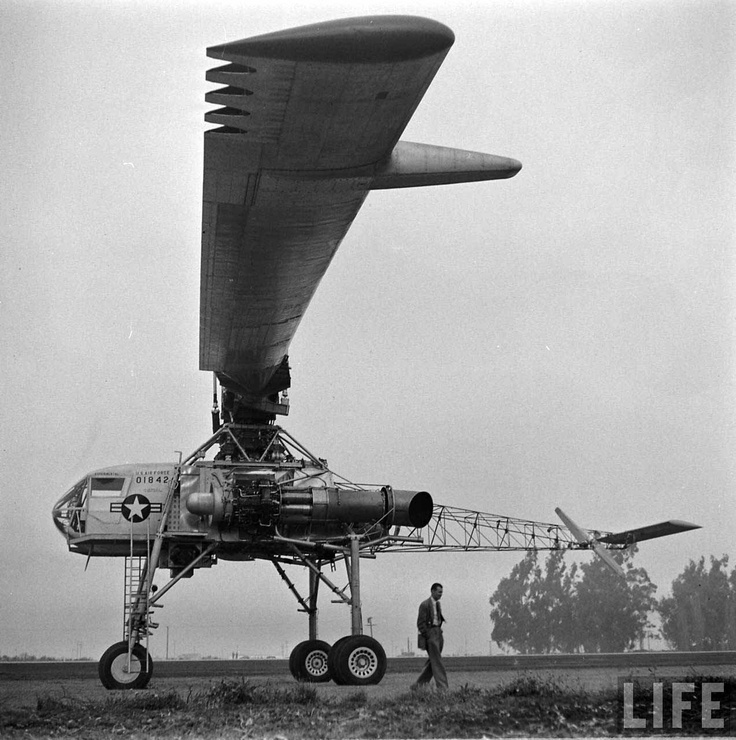 |
|
| (1952)*** - View of Howard Hughes walking away from the Hughes XH-17 “Flying Crane”. |
Historical Notes In 1955 the company began building light helicopters when Howard Hughes split the helicopter production unit from the Hughes Aircraft Co.*^ |
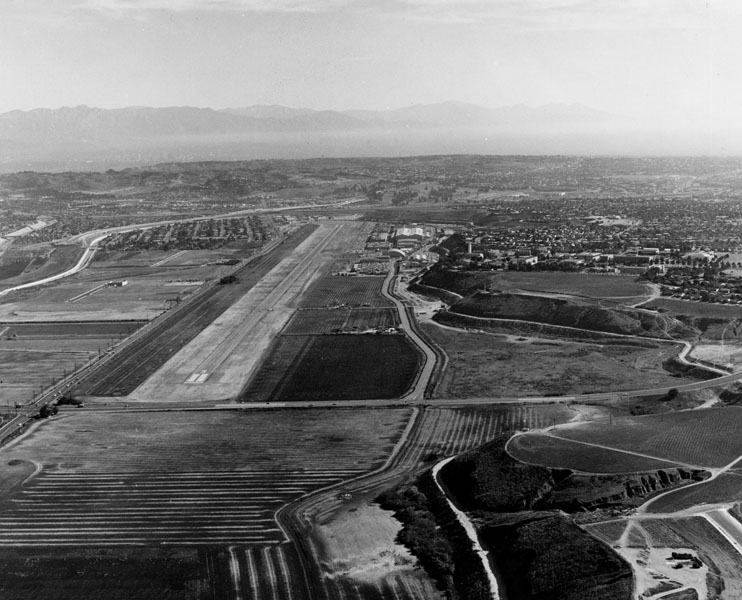 |
|
| (1968)* - Aerial view looking east along the runway of the Hughes Airport. Loyola University and Westchester can be seen on the right. |
Historical Notes In 1943, Hughes built the world’s longest private runway at the Hughes Airport. Runway 5/23 was 9,600' long - nearly 2 miles in length. It was not paved for its first few years, because Hughes believed that paved runways imparted unnecessary stress on an aircraft's landing gear. He reportedly had to add fill regularly to keep the ground solid.*# |
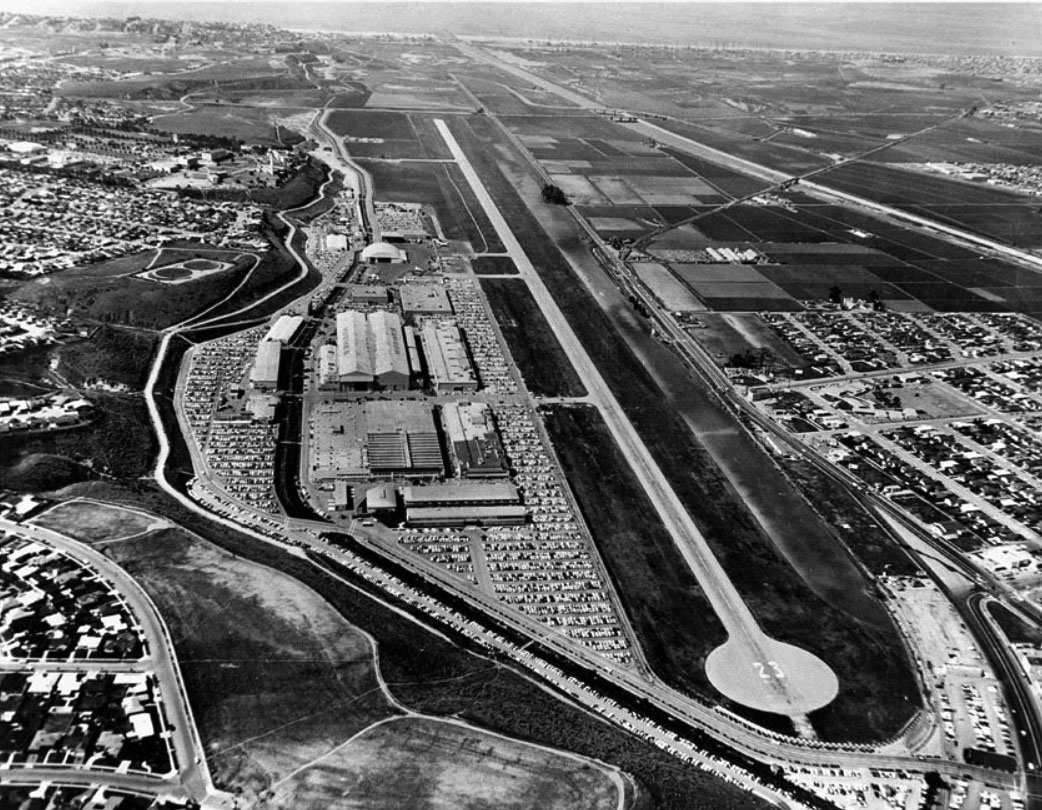 |
|
| (ca. 1960s)**^# – Aerial view showing the Howard Hughes runway and plant site at Playa Vista. |
Historical Notes In 1948 6,800 feet of the runway was paved with asphalt, extended by 1962 to 8,800 feet. Takeoffs to the west had to be coordinated with nearby Los Angeles International Airport. The field served a number of aircraft and helicopter development projects of the Hughes Aircraft Co. and Hughes Tool Company (Summa Corporation).*^ |
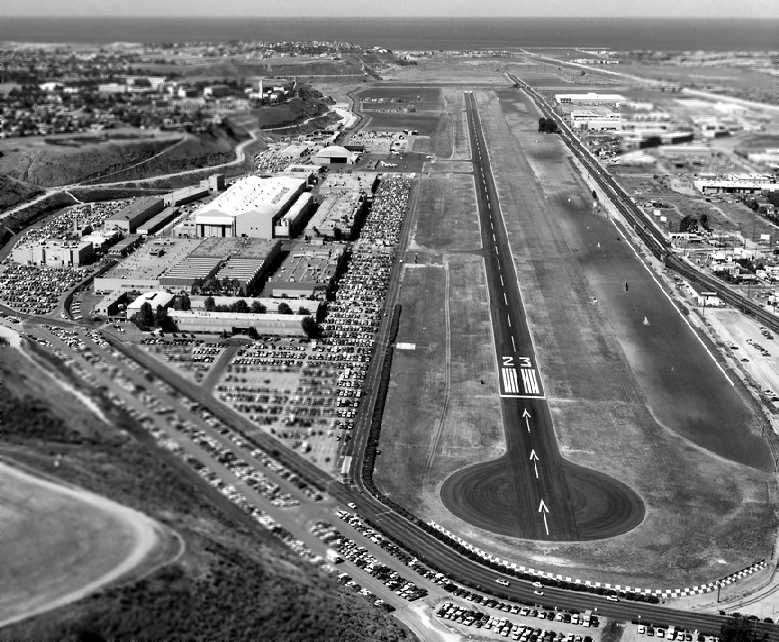 |
|
| (1972)*# - Aerial view looking west at the Hughes Airfield. |
Historical Notes After an often strange & reclusive life, Howard Hughes died in 1976. After the dust of Hughes’ estate had settled, the Culver City property was in the hands of Summa Corporation. Summa proposed a mega-development, with 29,000 people in 13,000 units, and an additional 20,000 employed by an on-site world-class motion picture studio. The project was called "Playa Vista." By the mid-1990s, the former Hughes Aircraft hangars here, including the one that held the Hercules, were converted into sound stages. Scenes from movies such as Titanic, What Women Want, and End of Days have been filmed in the 315,000-square-foot aircraft hangar where Hughes created the flying boat. It also features in the computer game Crimson Skies. The hangar will be preserved as a structure eligible for listing on the National Register of Historic Buildings. |
* * * * * |
United Airport to Hollywood Burbank Airport
The Hollywood Burbank Airport has undergone several name changes throughout its history, reflecting its evolving ownership and identity. Here's a chronological overview of the airport's names:
United Airport (1930-1934)
The airport was initially opened as United Airport on Memorial Day weekend in 1930. It was constructed by United Aircraft and Transport Corporation, a partnership between Boeing and United Airlines.
Union Air Terminal (1934-1940)
In 1934, the airport was renamed Union Air Terminal. This change occurred when the United Aircraft and Transport holding company dissolved due to federal antitrust actions.
Lockheed Air Terminal (1940-1967)
Lockheed purchased the airport in 1940 and renamed it Lockheed Air Terminal.
Hollywood-Burbank Airport (1967-1978)
In 1967, the airport underwent another name change to Hollywood-Burbank Airport.
Burbank-Glendale-Pasadena Airport (1978-2003)
When Lockheed sold the airport to the Burbank-Glendale-Pasadena Airport Authority in 1978, it was renamed Burbank-Glendale-Pasadena Airport to reflect the surrounding cities.
Bob Hope Airport (2003-2017)
In 2003, the airport was officially renamed Bob Hope Airport.
Hollywood Burbank Airport (2017-present)
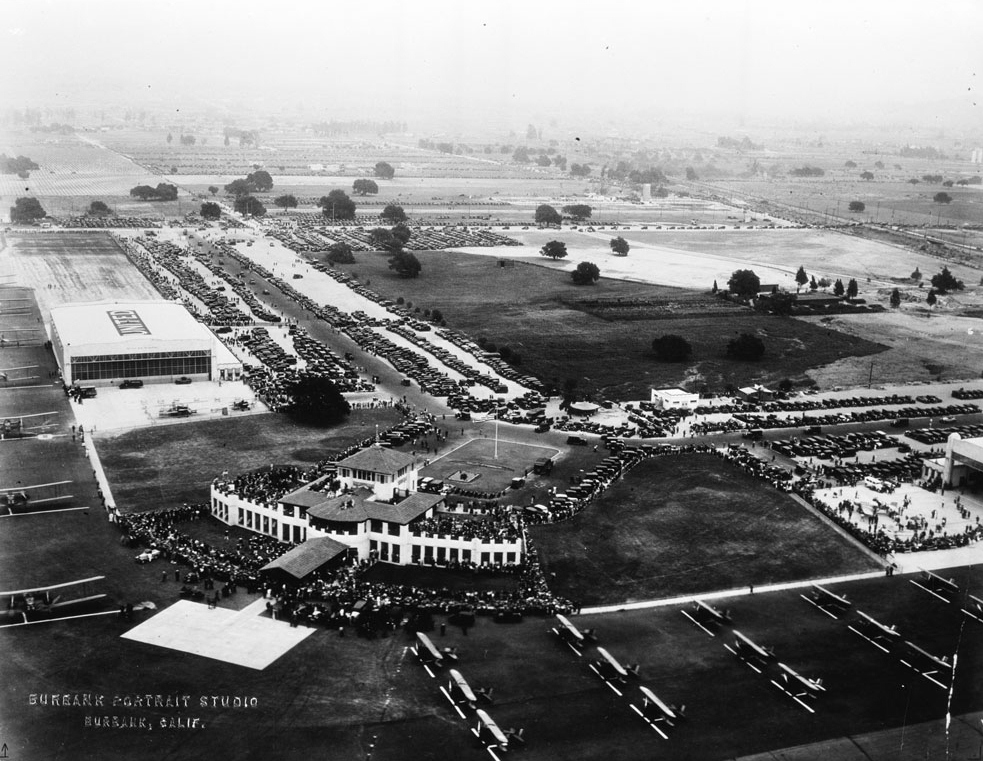 |
|
| (1930)^* - Birds eye view of the United Airport in Burbank at the Terminal's dedication. At center, a crowd of people has gathered around the main terminal bulding. Converting just before it, two lanes of airplanes can be seen in the foreground. To the left, a sign on a long, one-story building reads "United", while automobiles can be seen parked all around. |
Historical Notes United Airport was dedicated amid much festivity (including an air show) on Memorial Day Weekend (May 30 – June 1, 1930). The airport and its handsome Spanish revival terminal was a showy new competitor to the nearby Grand Central Airport in neighboring Glendale, which was then Los Angeles' main airline terminal. |
 |
|
| (1930)#* - Panoramic photo taken during the dedication and grand opening of the Burbank airport on May 30, 1930, back when it was called “United Airport.” |
 |
|
| (1930)#* - A slightly elevated panoramic view of a runway full of airplanes at United Airport in Burbank. There are at least eight rows of three airplanes parked on the runway in the foreground. These are US Army Bomber aircraft, including the Curtiss B-2 and the Keystone LB-6. Beyond these there are dozens more smaller planes, closely parked in rows of six to ten. |
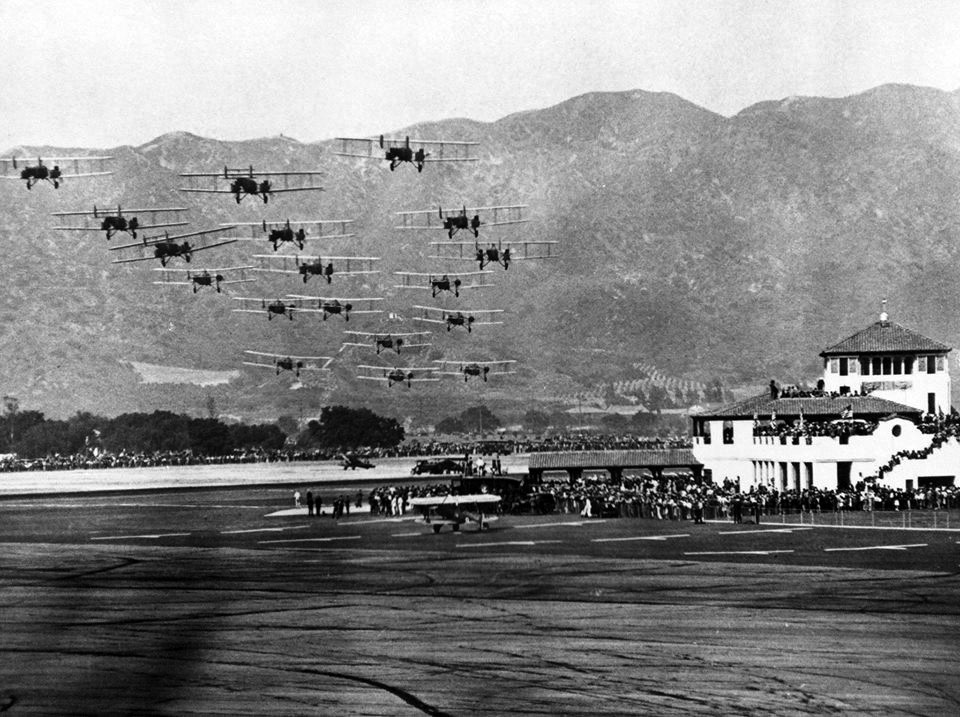 |
|
| (1930)^*^* - A squadron of planes takes-off and flys over the new Terminal building as spectators watch. |
Historical Notes The new Burbank facility became the largest commercial airport in the Los Angeles area until it was eclipsed in 1946 by the Los Angeles Airport in Westchester when that facility (formerly Mines Field, then Los Angeles Municipal Airport) commenced scheduled airline operations |
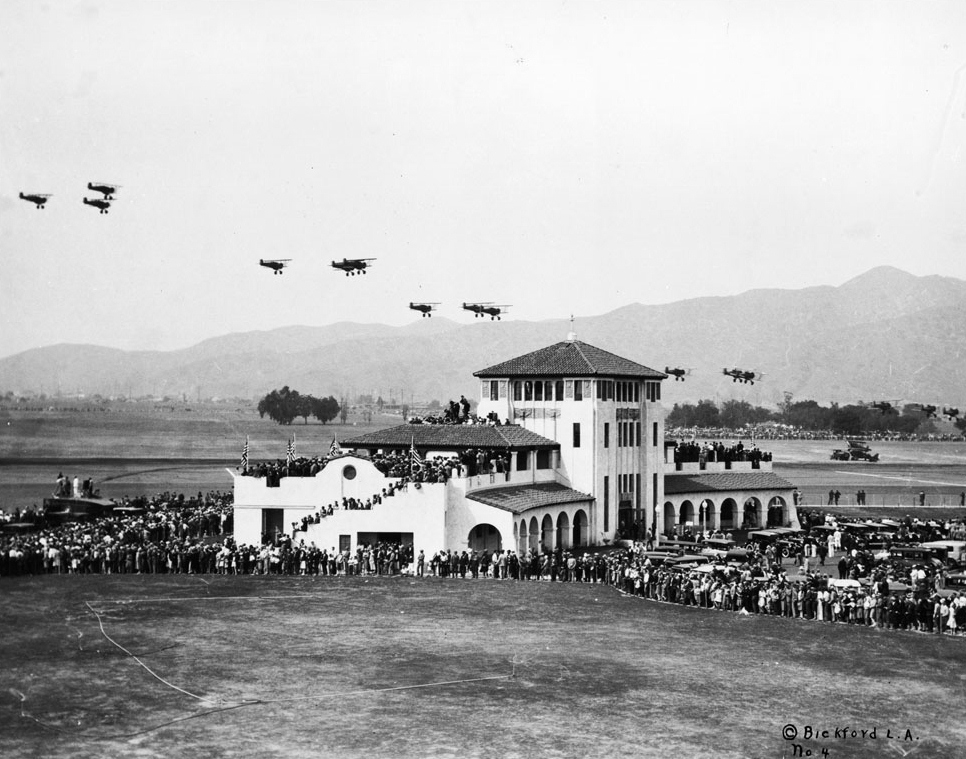 |
|
| (1930)^* - A fly-over of the United Air Terminal in Burbank at the terminal's dedication, May 30, 1930. The terminal is at center and is a light-colored structure with a tall rectangular tower at center that is flanked by two lower sections. The front of the building is marked by a series of archways, and the tops of the two lower wings are uncovered and crowded with people. There are also hundreds of people on the ground, and a parking lot is at right. Twelve biplanes are flying in formation over the terminal, and more planes are visible on the ground at right. A tall mountain range is visible in the distance. |
Historical Notes Over the years, the airport has been known as Angeles Mesa Drive Airport (1928–1930), United Airport (1930–1934), Union Air Terminal (1934–1940), Lockheed Air Terminal (1940–1967), Hollywood-Burbank Airport (1967–1978), Burbank-Glendale-Pasadena Airport (1978–2003) and most recently Bob Hope Airport (2003–present). |
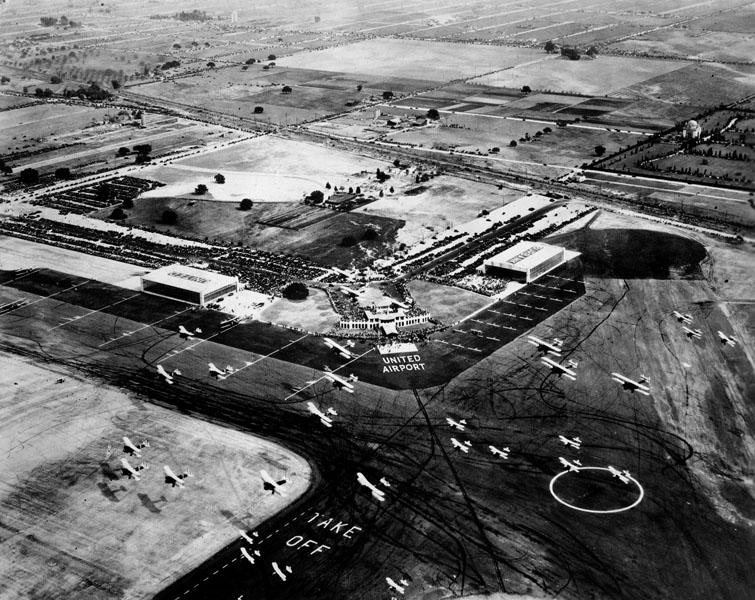 |
|
| (1930)* - Aerial view of United Airport in Burbank. Crowds of people can be seen on the ground, watching the air show taking place over the airport. |
Historical Notes Boeing Aircraft and Transport (BA&T) was a holding company created in 1928 that included Boeing Aircraft and United Air Lines, itself a holding company for a collection of small airlines that continued to operate under their own names. One of these airlines was Pacific Air Transport (PAT), which Boeing had acquired because of PAT's west coast mail contract in January 1928. BA&T then sought a suitable site for a new airport for PAT, and found one in Burbank. BA&T had the benefit of surveys that the Aeronautics Department of the Los Angeles Chamber of Commerce had conducted starting in 1926 to identify potential airport sites. |
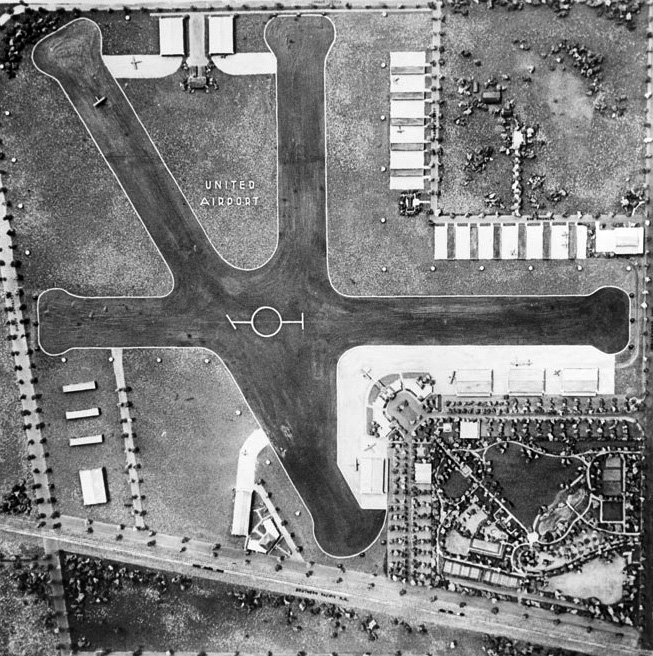 |
|
| (ca. 1930)^* - Aerial view of United Airport. The runway extends in four directions, toward the north, north-west, to the west and the east. Below the eastern part of the runway, the pavement connects to what appears to be a terminal at the airport proper. The roofs of three large structures can be seen, sandwiching a semicircular area that appears to be the airport. To the bottom right is an area lined with trees, houses, and perhaps a golf course. Below the airport runs the Southern Pacific Railroad, and to the right runs Hollywood Way. In the upper right corner lie several roofed structures that form an "L" shape around an arborous area. At the back to the left are two roofed structures with roads that connect to the runway, presumably hangars. |
Historical Notes It took Boeing Aircraft and Transport a year and the cooperation of the city to assemble the site. The 234-acre site was rife with vines and trees and the ground had to be filled and leveled, but it had good drainage, a firm landing surface, steady winds, and good access to ground transport. Construction was completed in just seven months. In an age when few aircraft had brakes and many had a tail skid instead of a wheel, runways were not usually paved; those at Burbank had a 5-inch-thick mixture of oil and sand. |
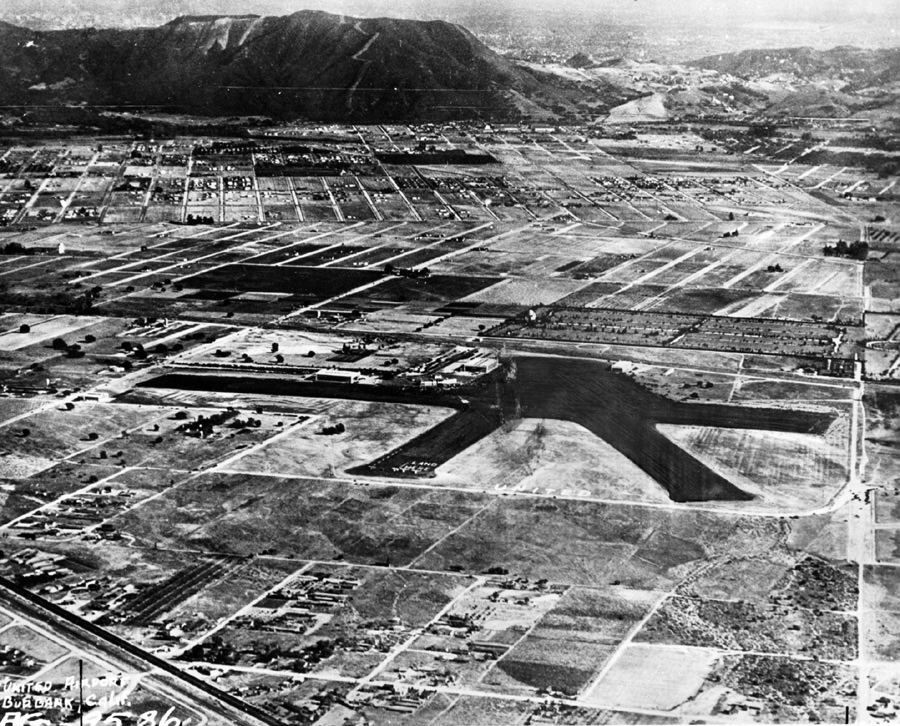 |
|
| (mid-1930s)#^*^ - Aerial panoramic showing United Airport, Burbank, and the Verdugo Hills in the background. |
Historical Notes United Airport had no taxi strips, but the designers left room for them. Two of the runways were over 3,600 feet long; a third was 2,900 feet; all were 300 feet wide. These were generous dimensions, and the site had room for expansion. |
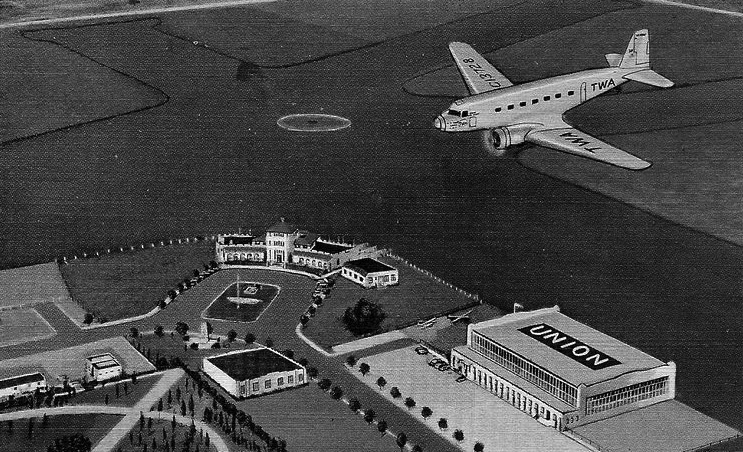 |
|
| (ca. 1934)#^*^ - Postcard showing a plane flying over the Union Air Terminal Building. |
Historical Notes The Burbank facility remained United Airport until 1934 when it was renamed Union Air Terminal. The name change came the same year that Federal anti-trust actions caused United Aircraft And Transport Corp. to dissolve, which took effect September 26, 1934. |
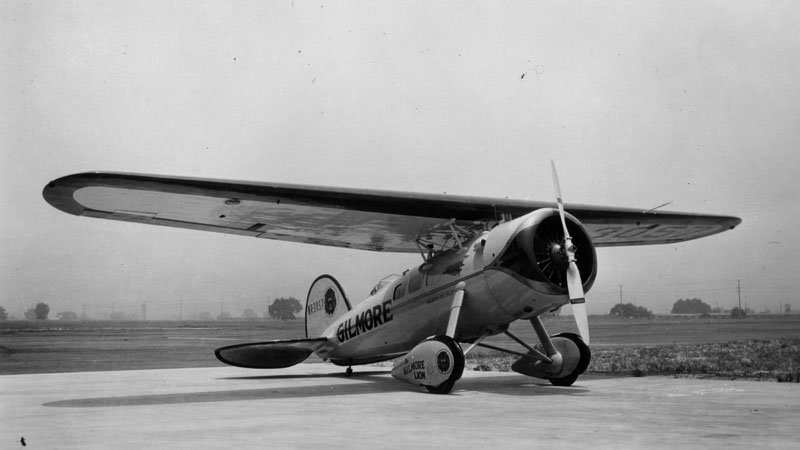 |
|
| (1930)* - A Lockheed Air Express at United Airport (Bob Hope Airport), owned by famous pilot Colonel Roscoe Turner. |
Historical Notes Roscoe Turner was known as a serious racing pilot, a Hollywood stunt pilot and showman. In 1930 he took on a new and unexpected flight partner--a lion. A year before, Turner had secured sponsorship by the Gilmore Oil Company, who had a lion as a corporate logo (see rear of plane), and realizing the potential publicity for both him and his sponsor, Turner acquired a lion cub and began flying with him. "Gilmore," the lion became a well-known national figure and, like Turner's uniform, one of the aviator's trademarks. Gilmore was on aboard when Turner set two transcontinental speed records in May 1930, one traveling eastward and the other westward. Turner flew from Los Angeles to New York in 15 hours, 37 minutes. The journey back to California took 18 hours, 42 minutes. To celebrate his achievements, Turner decided to set yet another record, this time across three countries. |
| (1932)^*# - Photograph showing Amelia Earhart standing between two men in front of single-prop plane. In the background is the Pacific Airmotive Corp. hangar in Burbank. |
Historical Notes Amelia Mary Earhart; July 24, 1897 – disappeared July 2, 1937) was an American aviation pioneer and author. Earhart was the first female pilot to fly solo across the Atlantic Ocean. She received the U.S. Distinguished Flying Cross for this record. She set many other records, wrote best-selling books about her flying experiences and was instrumental in the formation of The Ninety-Nines, an organization for female pilots. Earhart joined the faculty of the Purdue University aviation department in 1935 as a visiting faculty member to counsel women on careers and help inspire others with her love for aviation. She was also a member of the National Woman's Party, and an early supporter of the Equal Rights Amendment. |
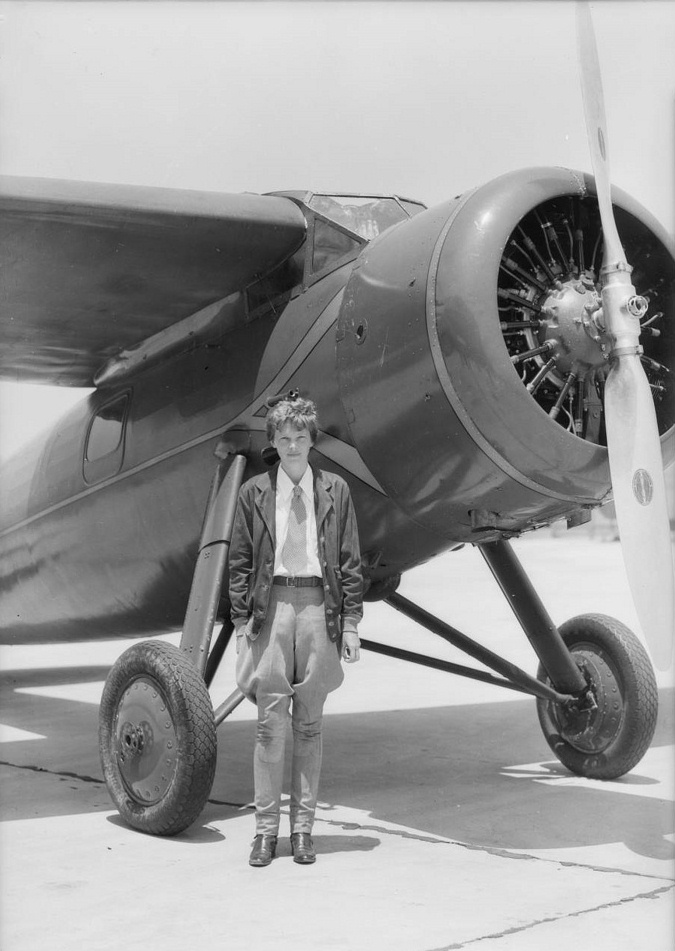 |
|
| (1932)^*# - Amelia Earhart standing in front of her single-prop plane in Burbank. |
Historical Notes During an attempt to make a circumnavigational flight of the globe in 1937 in a Purdue-funded Lockheed Model 10 Electra, Earhart disappeared over the central Pacific Ocean near Howland Island. Fascination with her life, career and disappearance continues to this day. |
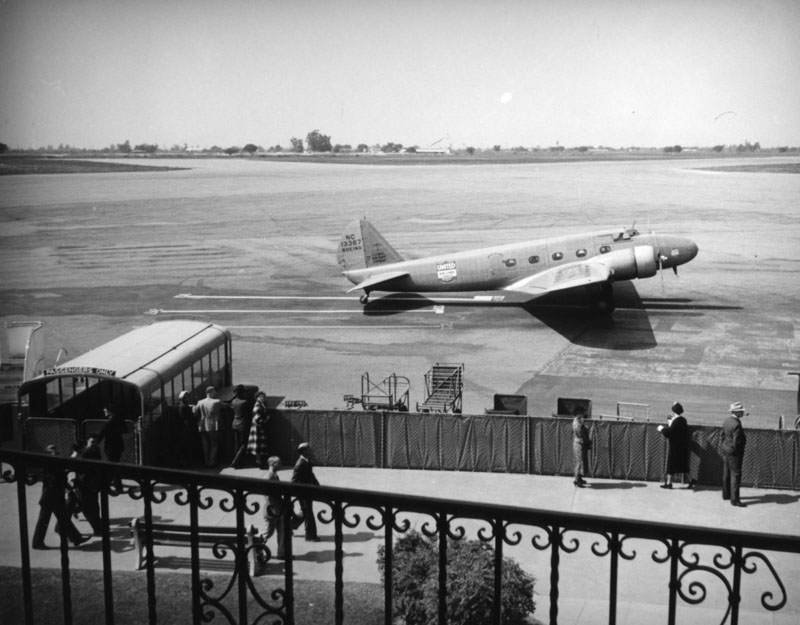 |
|
| (1930s)^*# - A Boeing Model 247 as it taxis off toward the runway at Union Air Terminal. The 247 was the first commercial plane capable of flying non-stop coast to coast. |
Historical Notes The Boeing Model 247 was considered the first aircraft to fully incorporate advances such as all-metal (anodized aluminum) semi-monocoque construction, a fully cantilevered wing and retractable landing gear. Other advanced features included control surface trim tabs, an autopilot and deicing boots for the wings and tailplane. The 247 was capable of crossing the United States from east to west eight hours faster than its predecessors, such as the Ford Trimotor and Curtiss Condor. Entering service on May 22, 1933, a Boeing Air Transport 247 set a cross-country record pace of 19½ hours on its San Francisco to New York inaugural flight. For the first time airline passengers could fly across the country without changing planes or stopping overnight. The 247 remained in airline service until World War II, when several were converted into C-73 transports and trainers. No. 121 Squadron, Royal Canadian Air Force (RCAF) operated seven Model 247Ds as medium transports during the early part of the war. Some 247s were still flying in the late 1960s, converted either into cargo transports or personal business aircraft. |
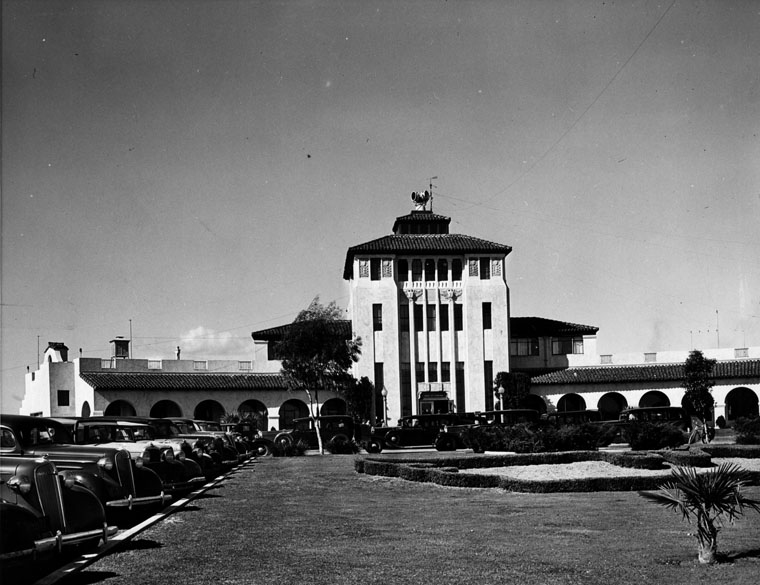 |
|
| (1930s)* - Exterior view of the Administration building of Union Air Terminal (later Bob Hope Airport) in Burbank. |
Historical Notes The Union Air Terminal moniker stuck until Lockheed bought the airport in 1940 and renamed it Lockheed Air Terminal. |
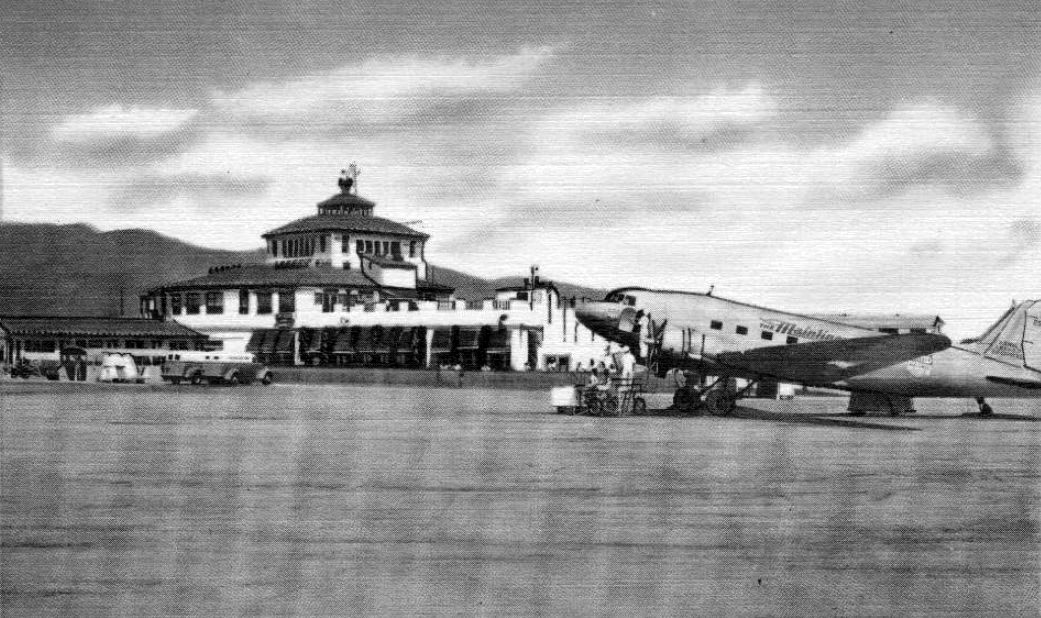 |
|
| (ca. 1939)#^^^ – Postcard view showing a plane, Douglas DC-3, being serviced at Union Air Terminal, Burbank. |
Historical Notes The Douglas DC-3’s speed and range revolutionized air transport in the 1930s and 1940s. Its lasting impact on the airline industry and World War II makes it one of the most significant transport aircraft ever made. The major military version was designated the C-47 Skytrain, of which more than 10,000 were produced. Many DC-3s and converted C-47s are still used in all parts of the world. |
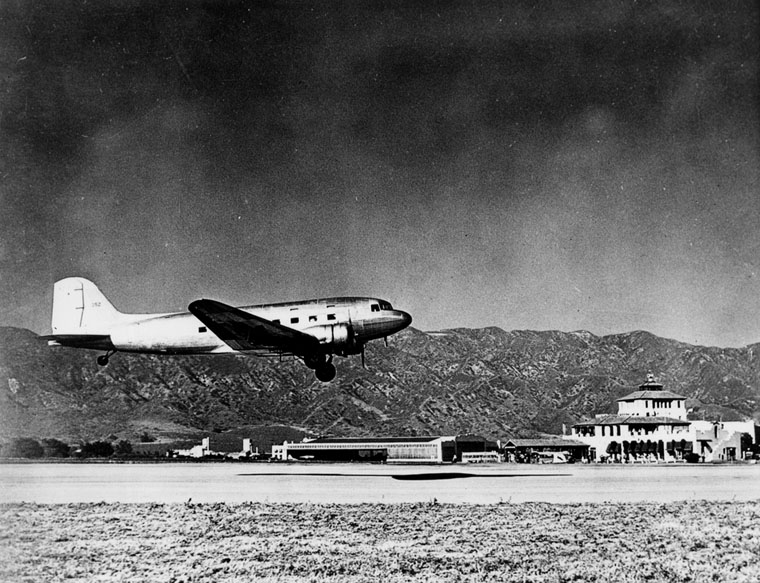 |
|
| (ca. 1939)* - View is looking south over the Burbank Airport showing a TWA airliner, Douglas DC-3, coming in for a landing. |
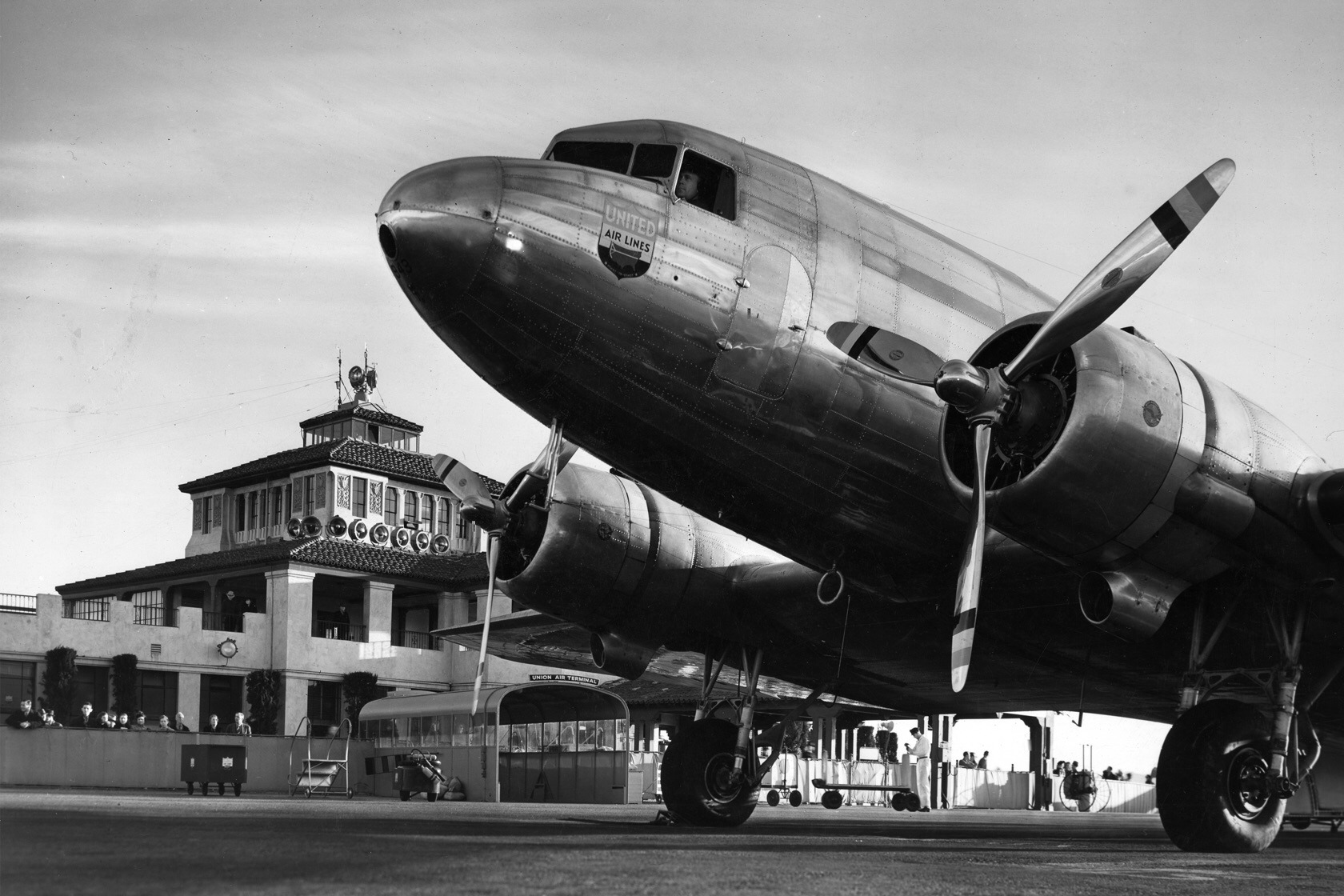 |
|
| (1940s)* – Close-up view of a Douglas DC-3 sitting in front of Lockheed Air Terminal (changed names in 1940). Photo courtesy of the Museum of Flight |
Historical Notes What was to become perhaps the most important airliner in history, quickly established its reputation with this and other operators, including the military. During World War II, the DC-3 (named Dakota by Britain) was mass produced as a utility transport in C-47, C-53, and other versions, known also as Skytrains and Skytroopers, and was license-built in large numbers in Russia as the Lisunou Li-2. Used in all imaginable roles, from freight and personnel transport to glider tug and ambulance, the type was active in all theaters of war, notably during the D-Day landings in Normandy, and subsequent assaults by Allied airborne forces. After the war, military flying continued and production of the civil version was restarted. DC-3s became the mainstay of worldwide passenger and freight services for many years. As larger capacity piston and jet airliners became available, DC-3s were gradually turned over to smaller operators.^ |
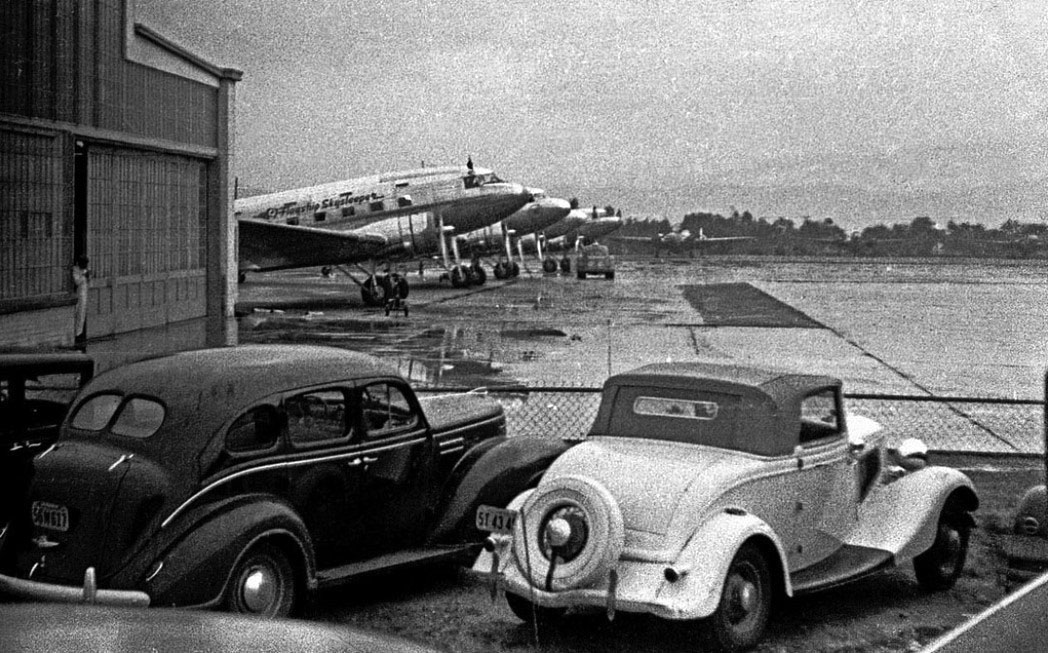 |
|
| (ca. 1939)#^ – View of Union Air Terminal on a rainy day with four DC3’s lined up near the terminal. Two cars are seen parked in the foreground. |
Historical Notes By 1934 the airport had become Los Angeles' primary airport known as Union Air Terminal. The DC-3 first in the line is an American Airlines Flagship Skysleeper which was equipped with individual berths. These aircraft would fly coast to coast in approximately 17 hours. |
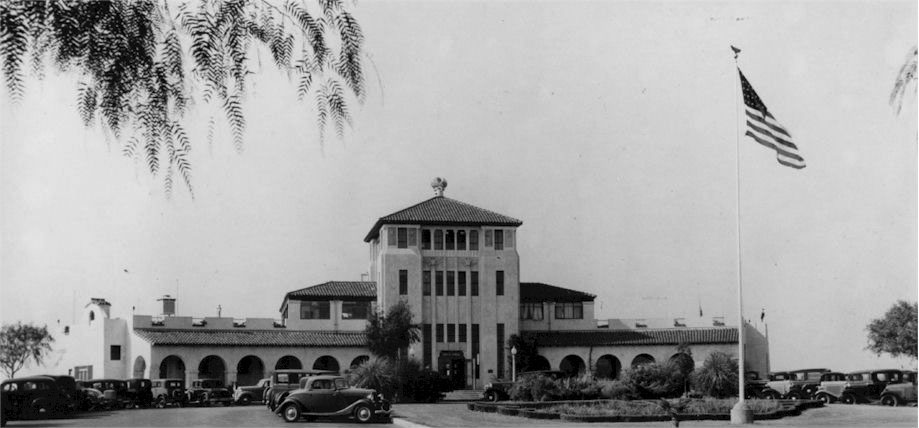 |
|
| (ca. 1939)#^*^ - Panoramic view showing the Union Air Terminal shortly before the name was changed to Lockheed Air Terminal. |
Historical Notes During the 1930's Lockheed Aircraft Company, adjacent to the field, evolved into one the nation's largest aircraft manufacturers, and in 1940 Lockheed purchased the airport. It was then renamed Lockheed Air Terminal and used to test and deliver Lockheed aircraft. It also remained Los Angeles' primary civil airport and remained the area's only civil airport throughout the war. |
.jpg) |
|
| (1940s)*^^ - View showing the Lockheed Air Terminal camouflaged and covered with tree-like netting during World War II. |
Historical Notes During the war Lockheed built P-38 fighters, Hudson and B-17 bombers. The Royal Air Force's Air Technical Services Command and US Army Air Forces Western Technical Training Command had operations at the field. The airport and the Lockheed plant were extensively camouflaged during the war. |
Before and After
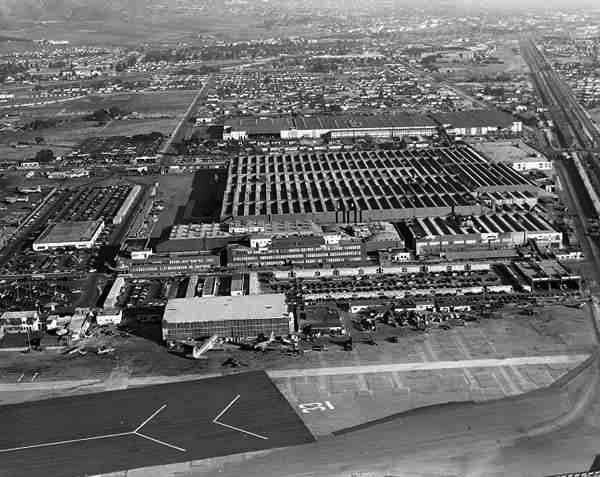 |
|
.jpg) |
|
| (1940s)*^^ - View showing the Lockheed plant before and after it was camouflaged. |
Historical Notes The main Lockheed plant and runways were made to appear as grain fields and houses, and the parking lot was covered over with netting to appear as alfalfa fields. In addition, an extensive smoke screen system was installed to hide the plant under smoke. |
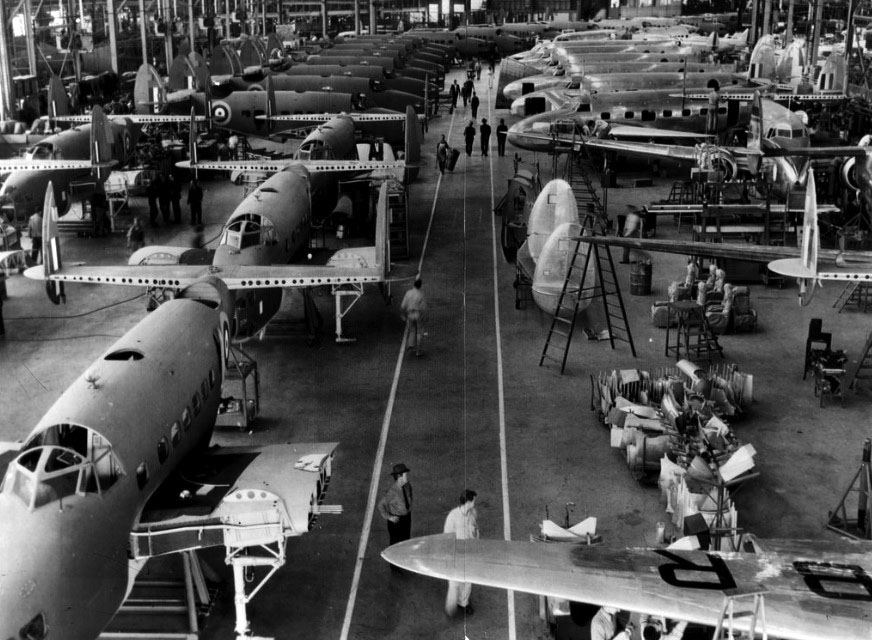 |
|
| (1941)#^ – Interior view of the sprawling Lockheed aircraft factory in Burbank showing one section of the assembly plant where a large order of Lockheed Hudson bombers for Britain is nearing completion. |
Historical Notes The Lockheed Hudson was a light bomber and coastal reconnaissance aircraft built initially for the Royal Air Force shortly before the outbreak of the Second World War and primarily operated by the RAF thereafter. The Hudson was a military conversion of the Lockheed Model 14 Super Electra airliner, and was the first significant aircraft construction contract for the Lockheed Aircraft Corporation—the initial RAF order for 200 Hudsons far surpassed any previous order the company had received. The Hudson served throughout the war, mainly with Coastal Command but also in transport and training roles as well as delivering agents into occupied France. They were also used extensively with the Royal Canadian Air Force's anti-submarine squadrons and by the Royal Australian Air Force.^ |
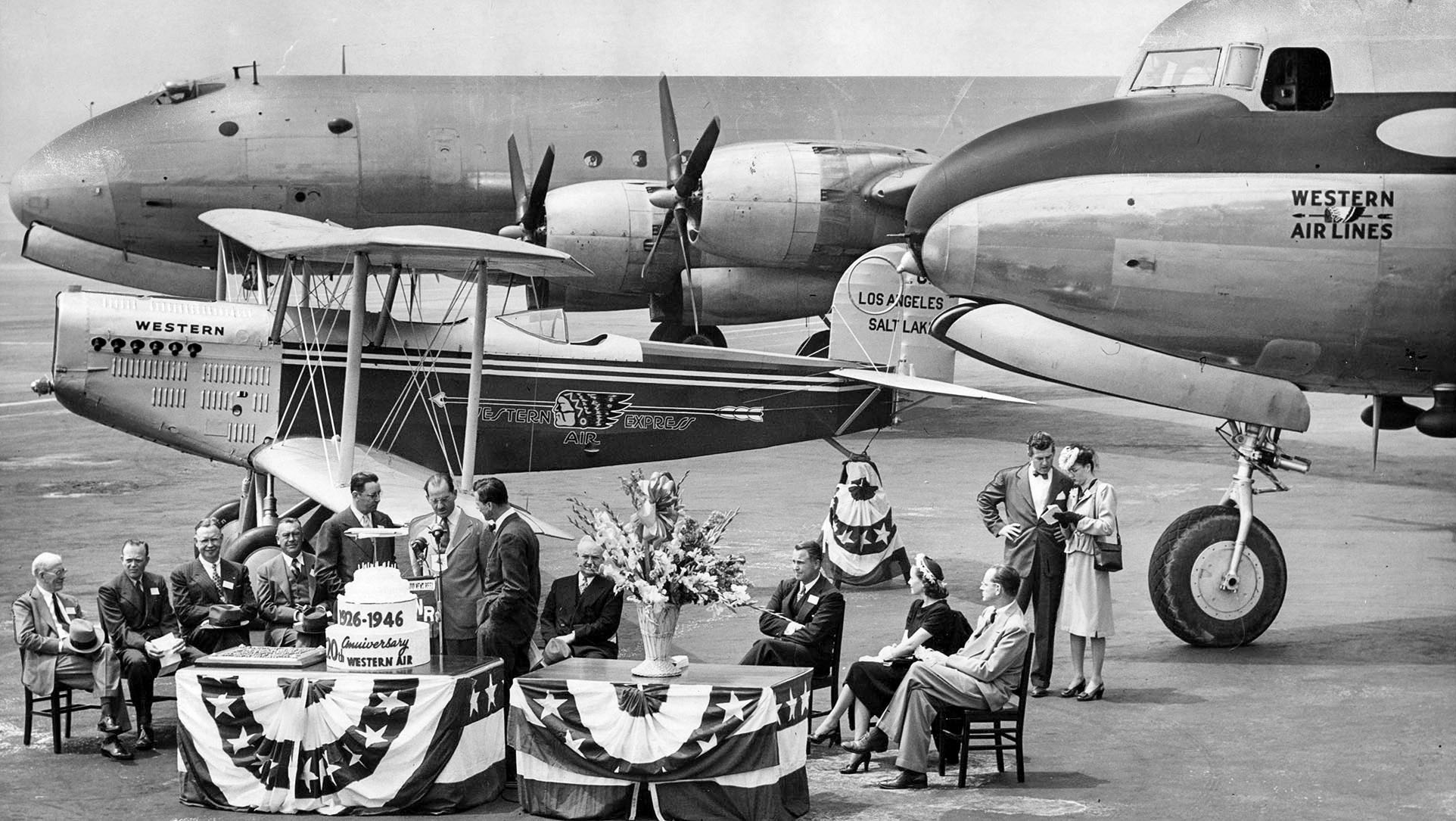 |
|
| (1946)** – View showing ceremonies celebrating Western Air Lines 20th anniversary at Lockheed Air Terminal. In back of cake-cutting is a Douglas M-2 biplane. On right is the front portion of a Douglas C-54 Skymaster. In background is Douglas C-74. L.A. Times Framework |
Historical Notes A story in the April 18, 1946, Los Angeles Times reported: Three planes told the story of transport aviation yesterday at Lockheed Air Terminal where Western Air Lines celebrated its 20th birthday — the beginning of its third decade — as the oldest air carrier in the nation. Representing the past was Western’s historic M-2 biplane, with criss-crossed wires, fabric fuselage and external control cables, a 100-m.p.h. two-place “speedster” that in 1926 inaugurated W.A.L.’s original mail service from Los Angeles to Salt Lake City. For the present was the airline’s 54-passenger Spymaster, a sleek, 36-ton luxury liner recently placed in operation on Western’s newest route linking Los Angeles and Denver. And in the future was the giant Douglas C-74, a bug-eyed monster weighing some 80 tons and destined to carry nearly 100 passengers nonstop over transcontinental ranges. In 1941, Western Air Express changed its name to Western Air Lines. Later the name was shortened to Western Airlines. In 1987, Western Airlines merged with Delta Air Lines. |
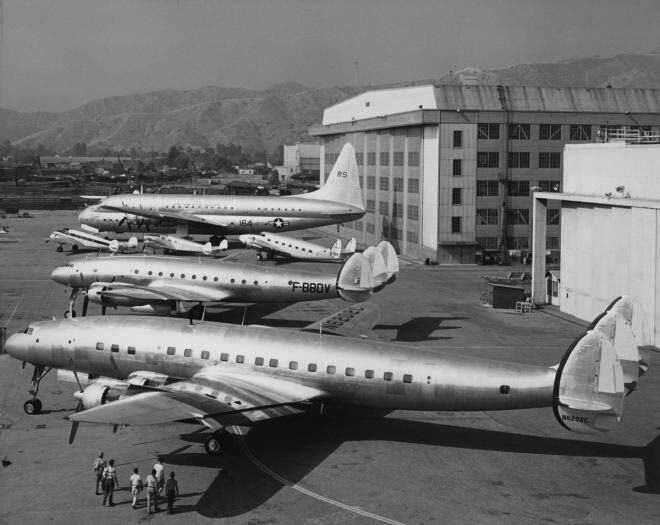 |
|
| (ca. 1948)* - View showing the Lockheed post-war production planes in front of their main plant. |
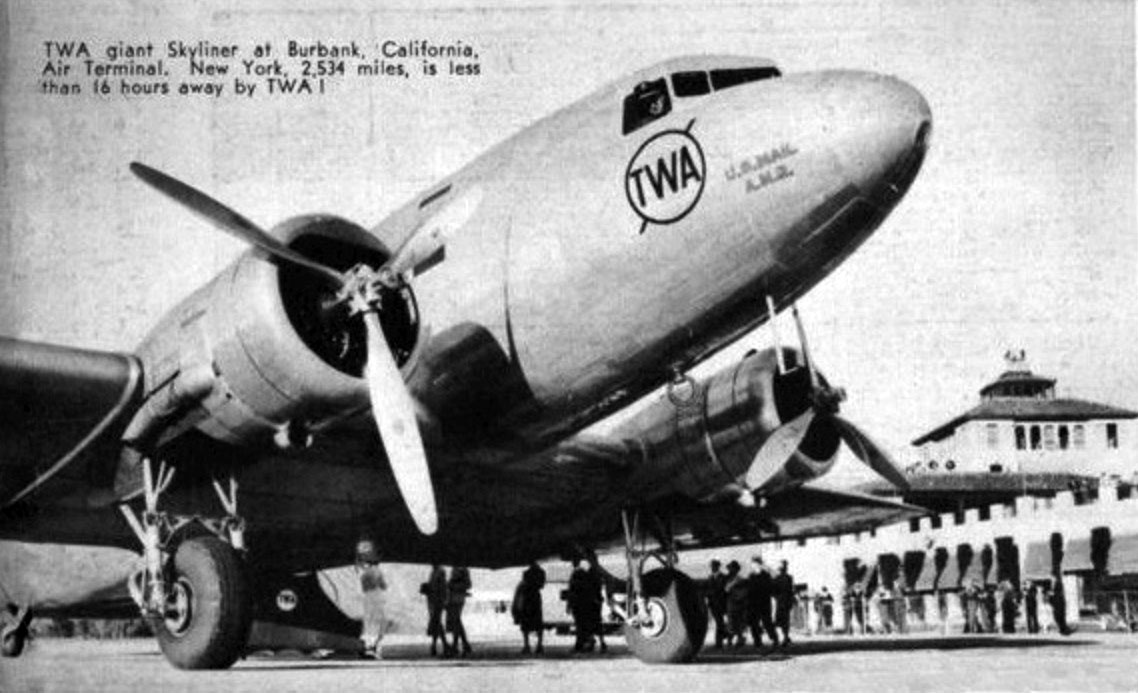 |
|
| (ca. 1940s)#^*^ – Postcard view showing the TWA Skyliner which operated day and night on a regular schedule between New York and California over the Lindbergh Line. The card reads: “TWA giant Skyliner at Burbank, California, Air Terminal. New York, 2,534 miles, is less than 16 hours by TWA!” |
Historical Notes The DC-3 and DST popularized air travel in the United States. Eastbound transcontinental flights could cross the U.S. in about 15 hours with three refueling stops; westbound trips against the wind took 171⁄2 hours. A few years earlier such a trip entailed short hops in slower and shorter-range aircraft during the day, coupled with train travel overnight. “DC” stands for Douglas Commercial and “DST” for Douglas Sleeper Transport. |
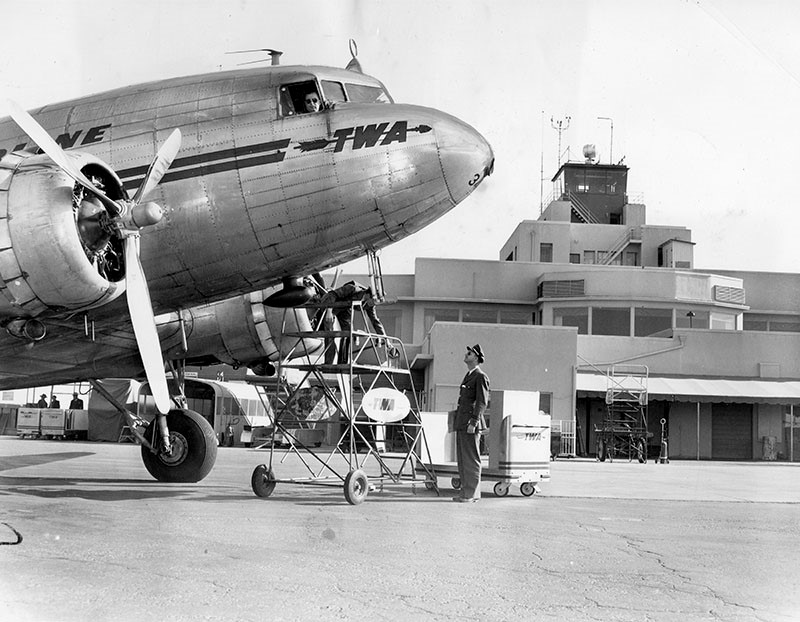 |
|
| (1948)* - Photograph caption dated March 4, 1948 reads, "Air transports of the TWA line pay frequent calls to the Lockheed Air Terminal located in the Valley at Burbank, the aerial city of California." |
Historical Notes In 1947, when Mines Field was expanded to become Los Angeles' primary airport, this facility became a secondary airport. In 1978 the cities of Burbank, Glendale and Pasadena bought the airport and renamed it Burbank Glendale-Pasadena Airport. Lockheed continued in operation at the field for many years. |
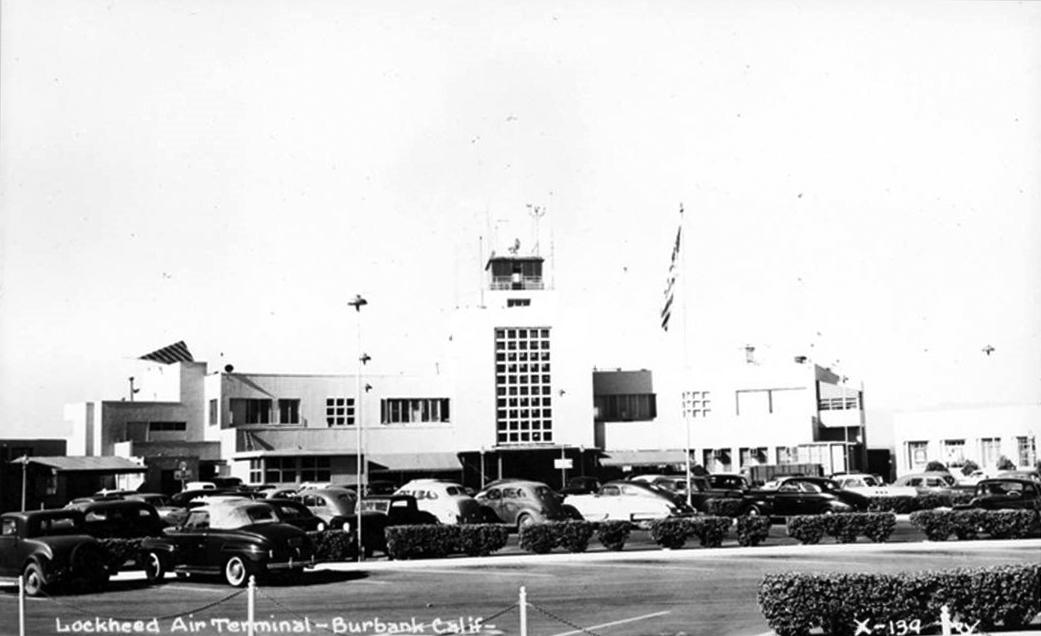 |
|
| (ca. 1940s)^ – Postcard view of the Lockheed Air Terminal in Burbank. |
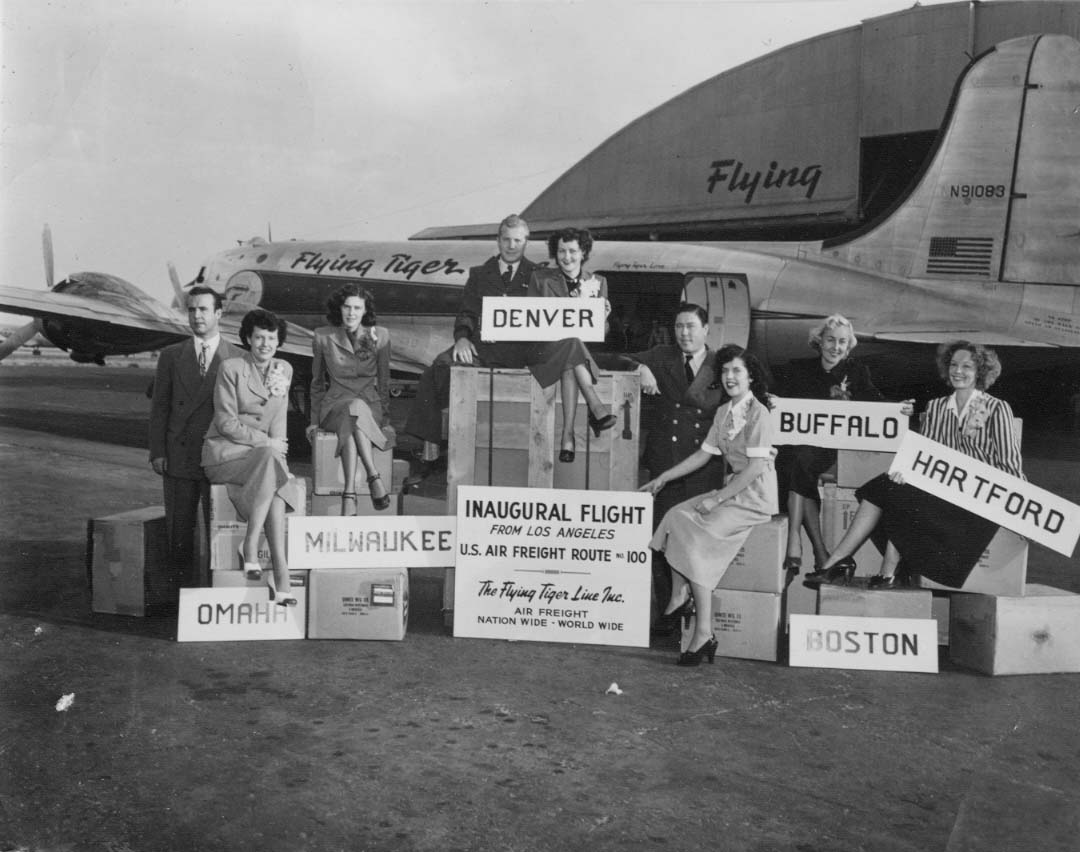 |
|
| (1949)^*^ - A publicity photo commemorating the Flying Tiger Line’s 1949 inaugural cargo flight out of Burbank. |
Historical Notes The Flying Tiger was an L.A. based company that ferried cargo by air from 1945 until 1989. FedEx purchased the operation in 1989. |
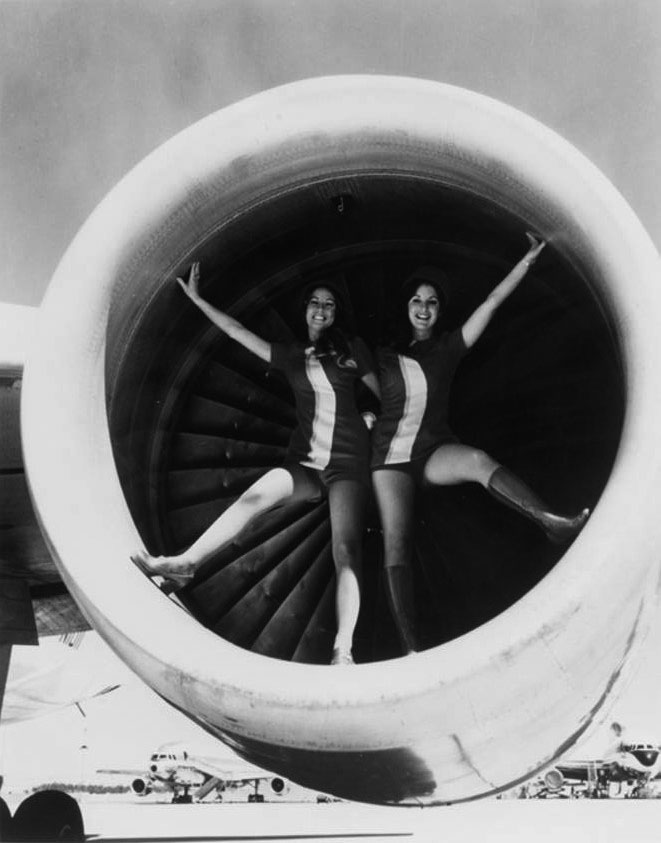 |
|
| (ca. 1960s)^ - Stewardesses from Pacific Southwest Airlines pose in front of an L-1011 TriStar engine to promote their new uniforms of cotton-candy pink, tangelo red, and pumpkin orange; designed to match the colored stripes of PSA's "Smiling Aircrafts". Taken at Hollywood-Burbank Airport. |
Historical Notes The first stewardesses were actually nurses hired to make passengers feel safer. Women who wanted to be “sky girls” had to meet strict requirements. In addition to being single, they had to be under 25 years of age, under 5-feet-5 and under 116 pounds. Not only did they tend to passengers, they were also expected to haul luggage, fuel the plane and help pilots push the plane into the hanger after flights. "Stewardess" was replaced with the term: "flight attendant" in the 70s. Between 1968 and 1984, Lockheed manufactured a total of 250 TriStars. The aircraft's sales were hampered by two years of delays due to developmental and financial problems at Rolls-Royce, the sole manufacturer of the TriStar's engines. After production ended, Lockheed withdrew from the commercial aircraft business due to its below-target sales. |
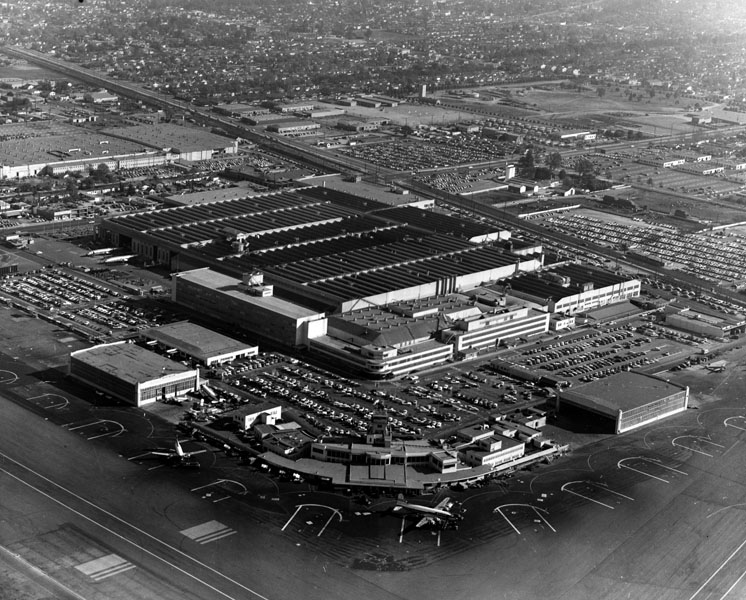 |
|
| (ca. 1960s)* - Aerial view of Lockheed Air Terminal in Burbank, Calif; Lockheed Air Terminal (1940-1967); Hollywood-Burbank Airport (1967-1978). |
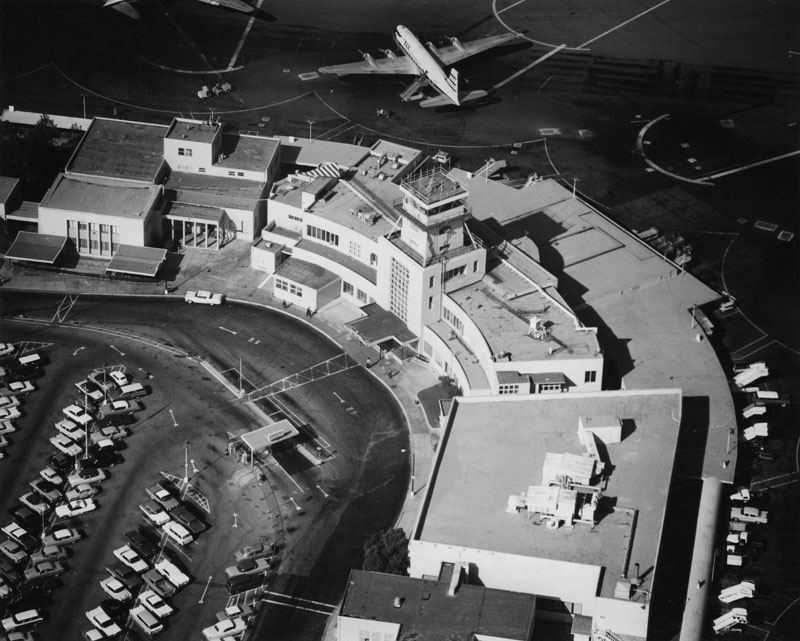 |
|
| (1961)* - Lockheed Air Terminal has had many names: United Airport (1930-1934); Union Air Terminal (1934-1940); Lockheed Air Terminal (1940-1967); Hollywood-Burbank Airport (1967-1978); Burbank-Glendale-Pasadena Airport (1978-2003) and Bob Hope Airport (2003-Present). |
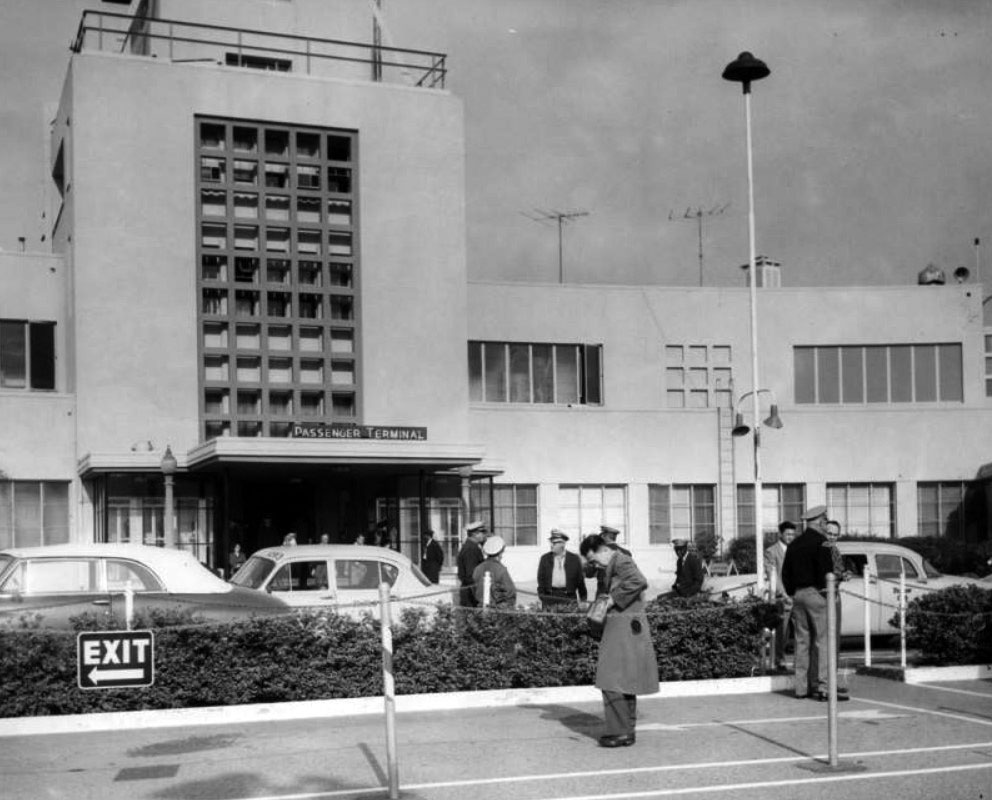 |
|
| (1958)* - Photograph caption reads, "Hub of Burbank Terminal. Largest of Valley's network of airports, Lockheed Air Terminal handles 1,000,000 passengers annually. Of those, 45,000 are military personnel. In addition, 22,500 tons of freight move through Lockheed every year. Standing behind operation is force of security police who enforce terminal rules." Valley Times Photo |
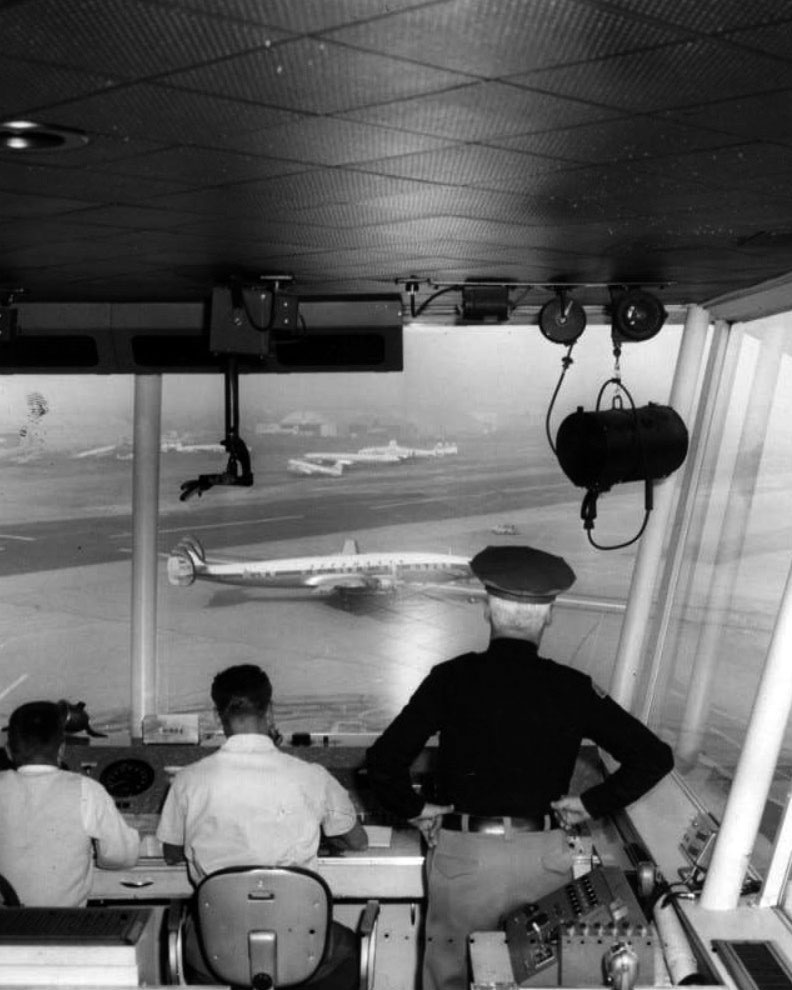 |
|
| (1958)* - Photograph caption reads, "Watch Airplane Operations. Security officer checks air liner from terminal control tower. Security force is in charge of field operations at Lockheed. It collects landing and departure fees from planes, directs airplane and automotive parking and guards airfield." Valley Times Photo |
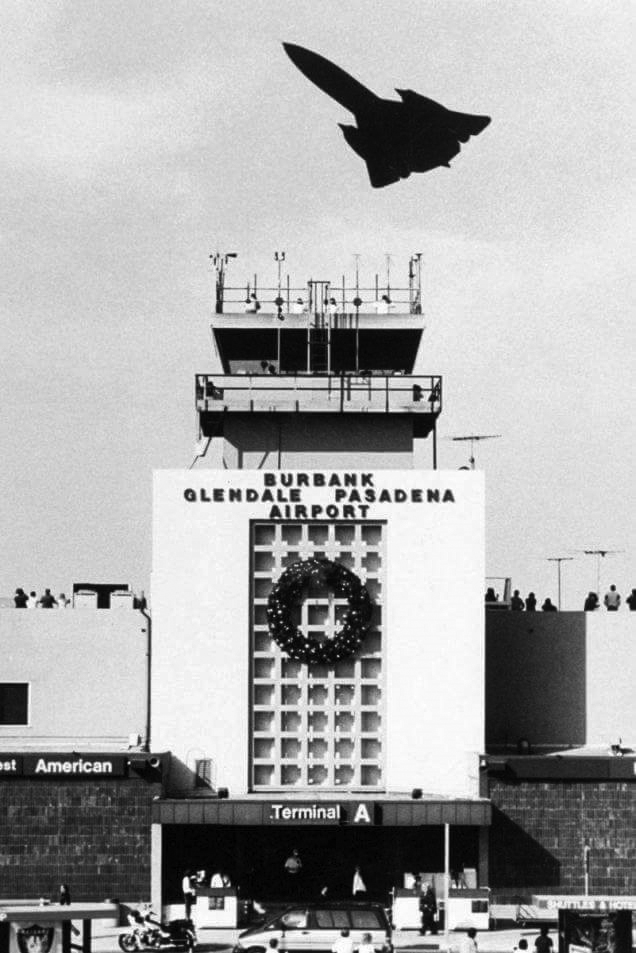 |
|
| (ca. 1990s)* – View showing a Lockheed SR-71 "Blackbird" flying over the Burbank – Glendale – Pasadena Airport as spectators watch from the roof. |
Historical Notes The SR-71 was designed for flight at over Mach 3 with a flight crew of two in tandem cockpits, with the pilot in the forward cockpit and the Reconnaissance Systems Officer (RSO) operating the surveillance systems and equipment from the rear cockpit, and directing navigation on the mission flight path. The SR-71 was designed to minimize its radar cross-section, an early attempt at stealth design. Finished aircraft were painted a dark blue, almost black, to increase the emission of internal heat and to act as camouflage against the night sky. The dark color led to the aircraft's nickname "Blackbird". On March 6, 1990; the SR-71 flew from Los Angeles to Washington D.C. in 1hour, 4 minutes, 20 seconds at average speed of 3,418kph (2,124 mph) setting a new record. The plane was handed over to the Smithsonian and is now on display. |
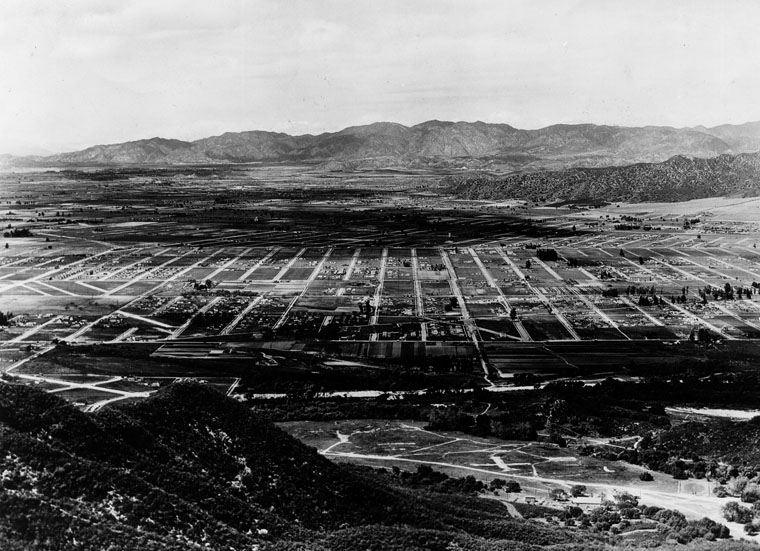 |
|
| (ca. 1967)* - View of the San Fernando Valley, overlooking Burbank from Griffith Park. The Hollywood-Burbank Airport can be seen at lower-center. |
Historical Notes In 1967 Lockheed rechristened the facility with the more glamorous-sounding name of Hollywood-Burbank Airport. The facility remained Hollywood-Burbank Airport for over a decade until 1978 when Lockheed sold the airport to the Burbank-Glendale-Pasadena Airport Authority. At that time the airport acquired its fifth name: Burbank-Glendale-Pasadena Airport (1978–2003). |
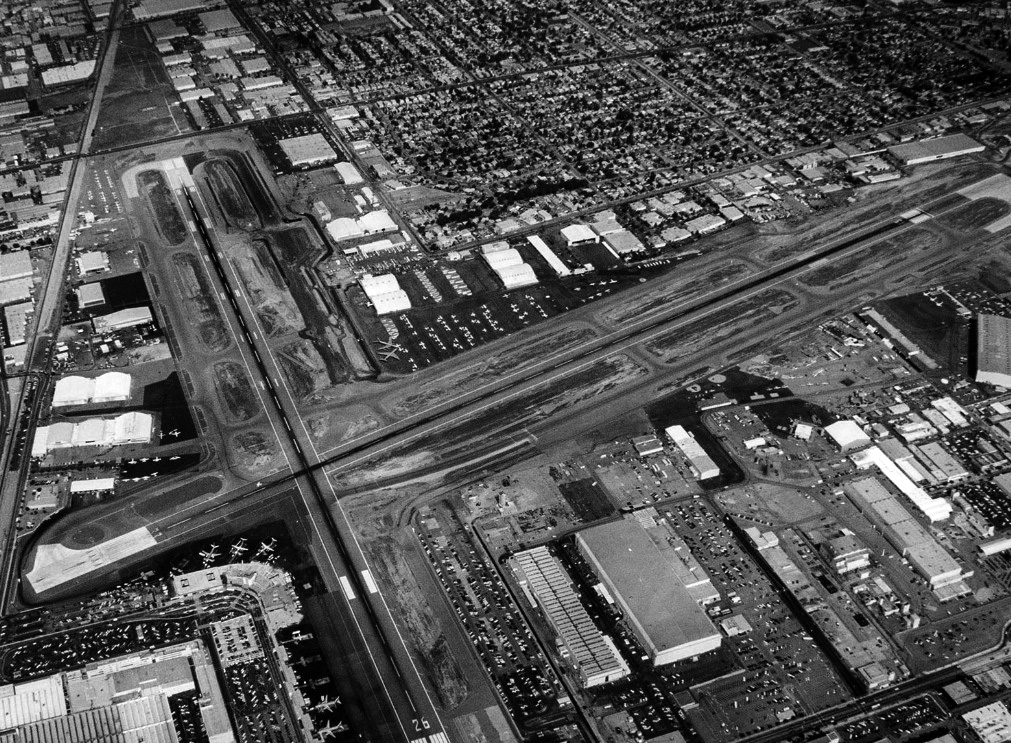 |
|
| (1990)** – Aerial view of the Burbank-Glendale-Pasadena Airport, it’s fifth name. The airport's name would change again in 2003. |
Historical Notes On November 11, 2003 the airport authority voted to change the airport's name to Bob Hope Airport in honor of comedian Bob Hope, a longtime resident of nearby Toluca Lake, who had died earlier in the year and who had kept his personal airplane at the airfield. The new name was unveiled on December 17, 2003, on the 100th anniversary of the Wright brothers' first flight in 1903, the year that Bob Hope was born. |
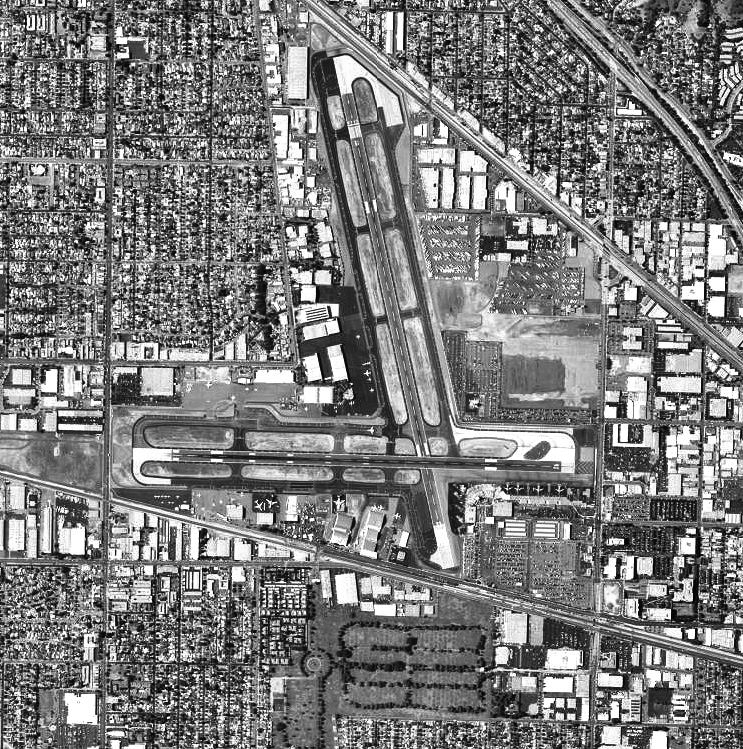 |
|
| (2006)*^ - Aerial view of Bob Hope Airport as it appeared in 2006. |
Historical Notes In 2005 the airport celebrated its 75th anniversary; in 2006 it served 5,689,291 travelers on seven major carriers, with more than 70 flights daily. |
Mines Field to LAX
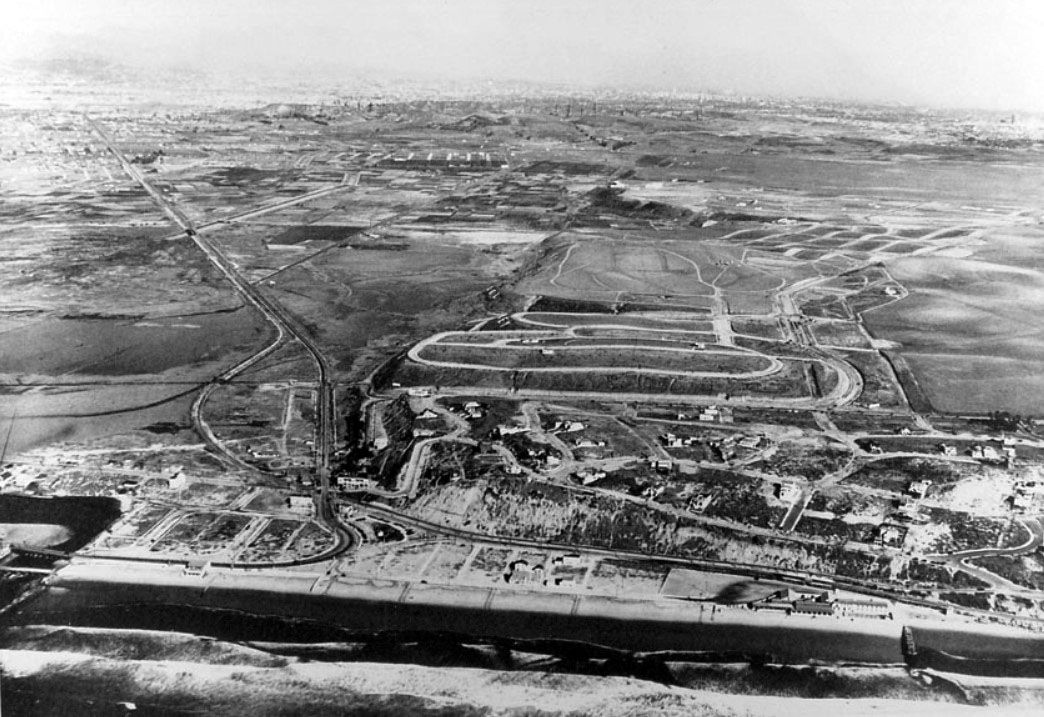 |
|
| (1921)**^# - Aerial view showing Playa del Rey, Bluffs and Playa Vista. Right side became Mines Field and later LAX. |
Historical Notes The name ‘Mines Field’ came from real estate agent William W. Mines who represented the ranching interests and he claimed his own bit of history when he clinched the deal. For years Angelinos refused to call their airport anything else. The city leased 640 acres for ten years and aviation got an immediate boost when America's National Air Races brought the crowds flocking to Mines Field to see pilots like the legendary Charles Lindbergh. ##** |
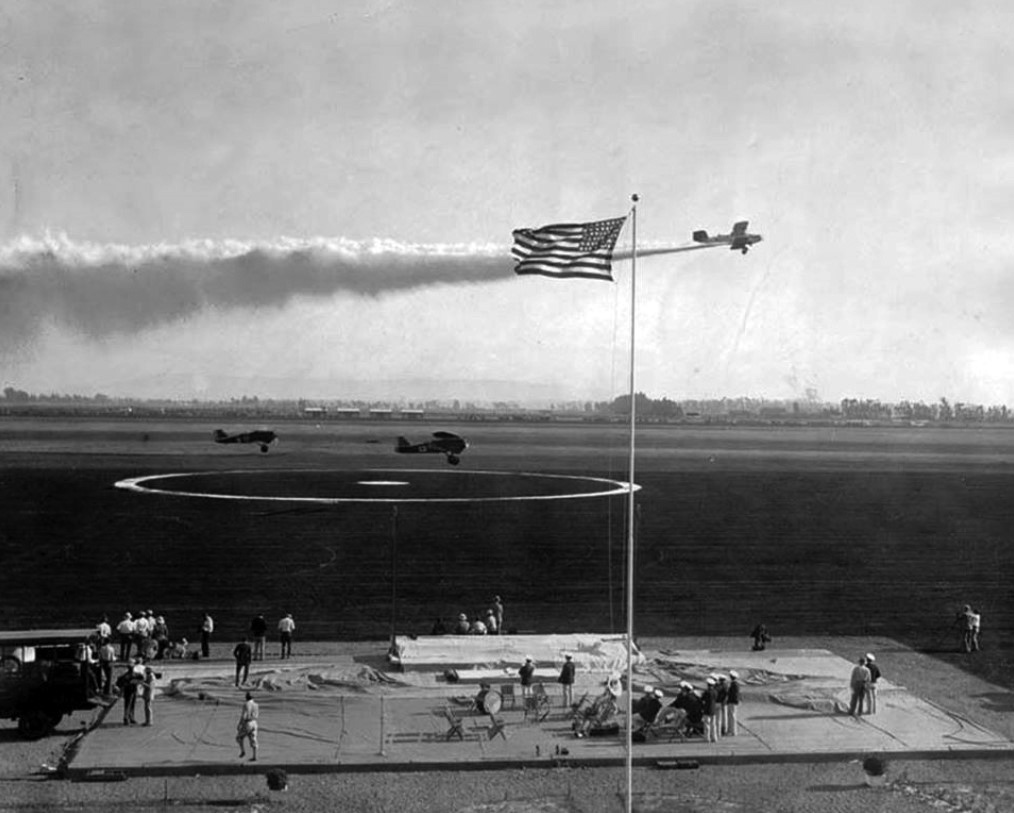 |
|
| (1928)^*^# - The opening day of the National Air Races at Mines Field (now LAX). September 8, 1928 |
Historical Notes The National Air Race was an air competition, comprised of a series of pylon and cross-country races, that took place annually from 1920 to 1949. Due to the rapid development of aviation science at that time, there was significant popular interest in this event.* |
 |
|
| (1928)^*^^ - Aerial view of the 1928 National Air Races. The packed parking lot can be seen on the right side of the photo, where passenger terminals now stand at LAX. The large crowds were partly due to the participation of Charles Lindbergh in the air races that year. |
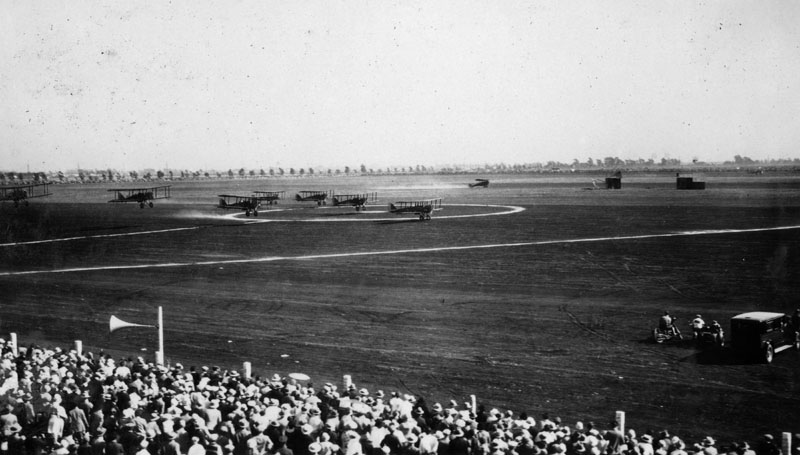 |
|
| (1928)* - Crowds watch as Army biplanes take off at Mines Field (Los Angeles International Airport) in Westchester during the 1928 National Air Races, which ran from September 8-17. |
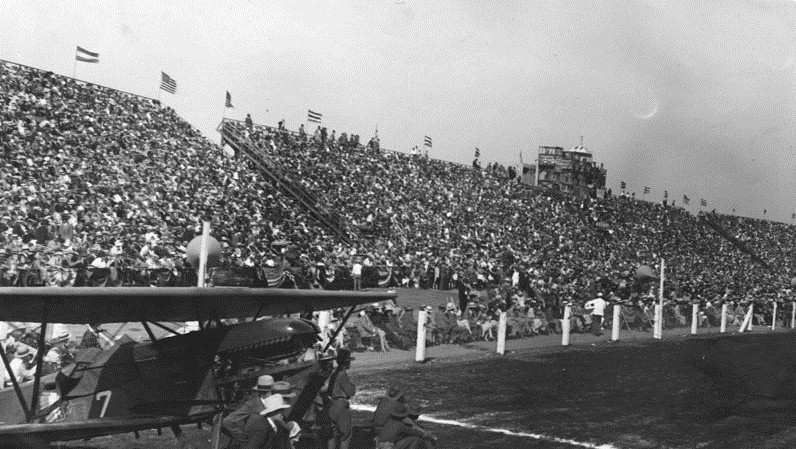 |
|
| (1928)* - View shows the crowds of people attending the National Air Races, Mines Field, September 17, 1928. |
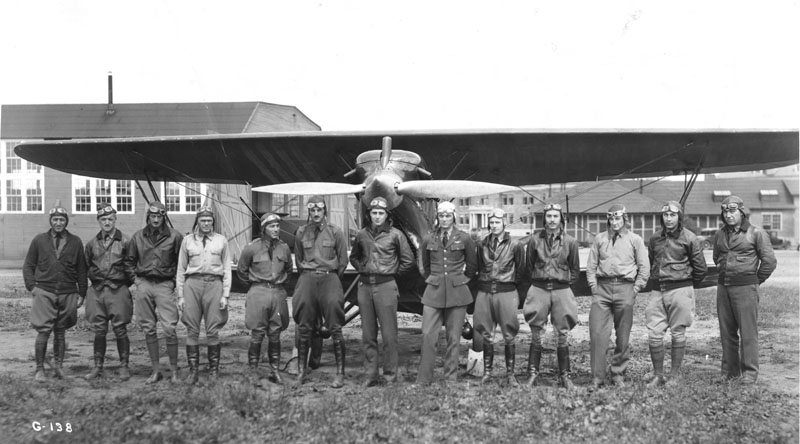 |
|
| (1928)* - For the glory of the American army and the John L. Mitchell trophy, these brave men drive their planes 160 miles per hour today in the National Air races at Mines field. This is the First Pursuit group from Selfridge field, Michigan. Left to right: Major Ralph Royce, Flight commander, Air Corps; Captain Victor H. Strahm, Air Corps.; 1st Lieut. Rex K. Stoner, Air Corps.; 1st Lieut. John K. Cannon , Air Corps.; 1st Lieut. Julian B. Haddon, Air Corps.; 2nd Lieut. Frank G. Irvin, Air Corps.; 2nd Lieut. Frank D. Klein, Air Corps.; 2nd Lieut. Ernest H. Lawson, Air Corps.; 2nd Lieut. William H. Doolittle, Air Corps.; 2nd Lieut. Burton M. Hovey, Air Corps.; 2nd Lieut. Frank H. Robinson, Air Corps.; 2nd Lieut. John F. Egan, Air Corps.; 2nd Lieut. Trevor Kenyon, Air Res.; and 2nd Lieut. Robert L. Schoenlein, Air Corps. |
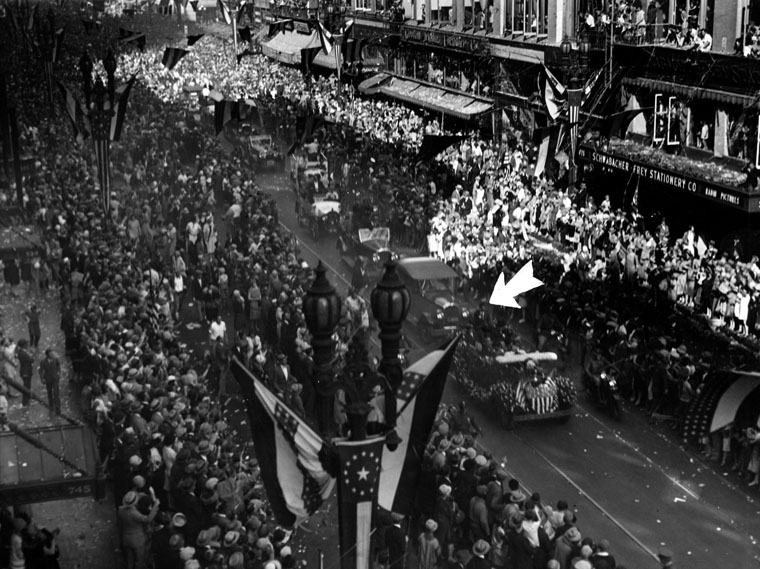 |
|
| (1927)* - Col. Charles A. Lindbergh rides down Broadway in Los Angeles in a ticker-tape parade, Sept. 21, 1927. (Arrow points out Lindbergh in his car) |
Historical Notes Charles Lindbergh's famous transatlantic flight in May 1927 convinced Los Angeles city leaders of the need for a permanent, municipal airport. With an improved runway and dedicated facilities, a city airport would encourage airmail and passenger traffic between Los Angeles and other aviation-friendly cities, while a permanent presence would allow airlines, maintenance companies, and other private enterprises to cluster around the site. In September 1927, Lindbergh himself, in Los Angeles on a nationwide victory lap, told a Coliseum crowd of roughly 60,000 that "airports are the most important factor in the development of aviation...I wish to say that if you expect to keep your city on the air map, it will be necessary to construct a municipal airport".**^ |
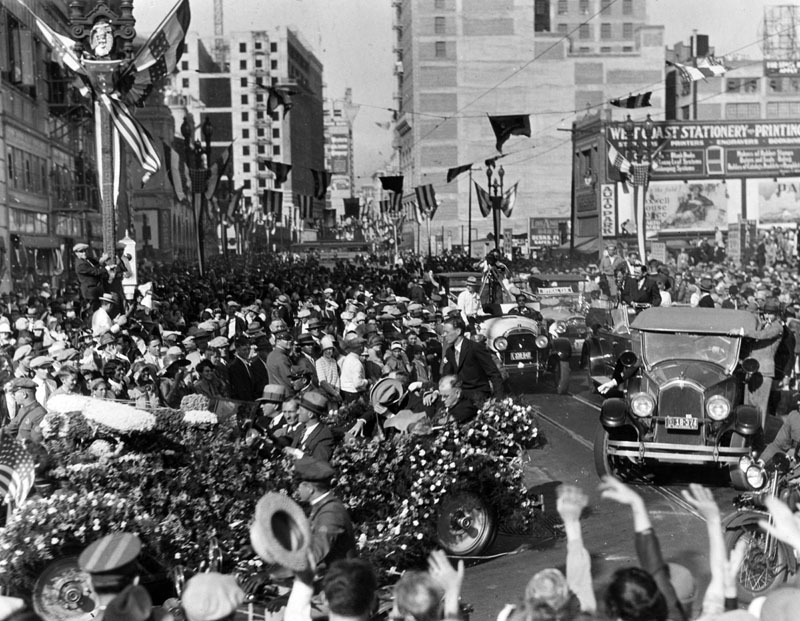 |
|
| (1927)* - View of a parade honoring Col. Charles A. Lindbergh, as it passes in front several large buildings along Broadway and 10th Street, in Downtown Los Angeles. Col. Lindbergh (wearing a dark suit) can be seen sitting atop the seat at the rear of the car decorated entirely with white roses; then-Mayor Porter sits next to him. The parade took place on September 21, 1927, four months to the day after Col. Lindbergh flew solo non-stop from Roosevelt Field to Paris aboard the "Spirit of St. Louis". |
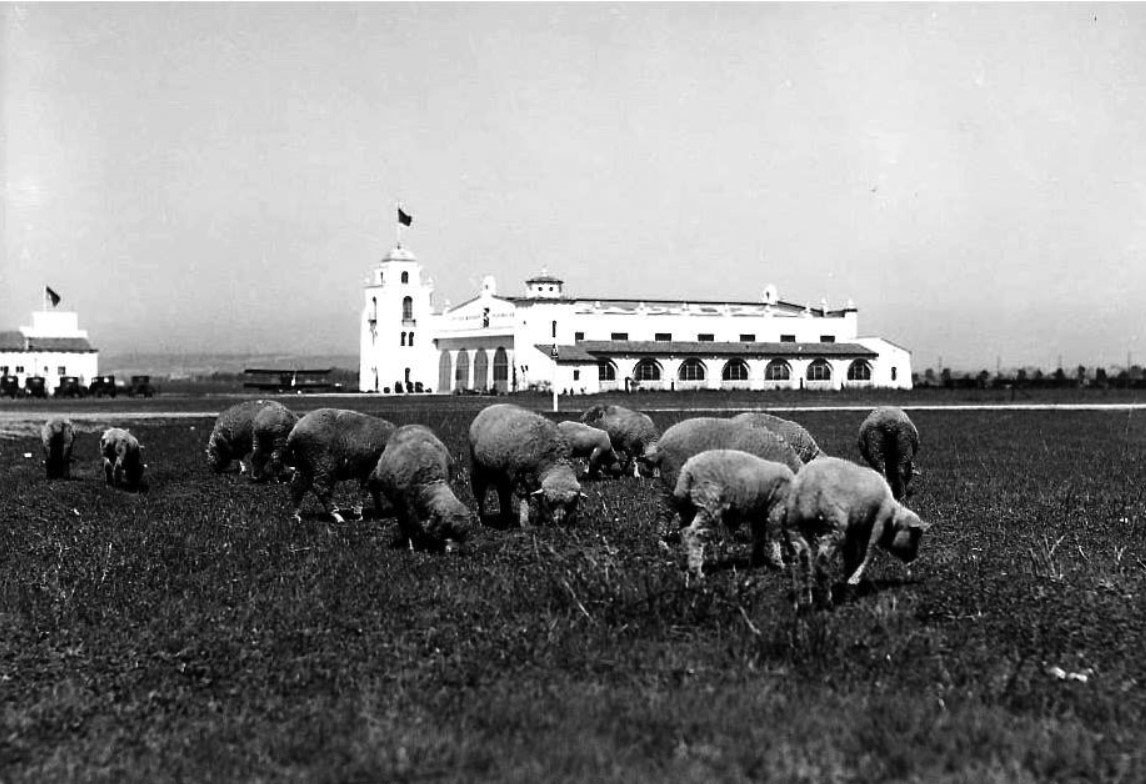 |
|
| (ca. 1928)*## – Sheep grazing near the runway at Mines Field. |
Historical Notes In 1928, the Los Angeles City Council selected 640 acres (1.00 sq. mile) in the southern part of Westchester as the site of a new airport for the city. The fields of wheat, barley and lima beans were converted into dirt landing strips without any terminal buildings. It was named Mines Field for William W. Mines, the real estate agent who arranged the deal. The City signed a 10-year lease* |
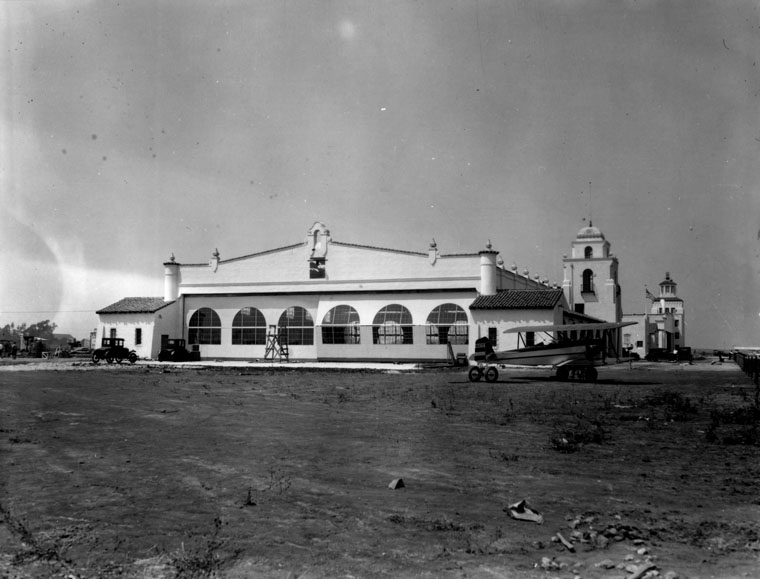 |
|
| (ca. 1928)* - View of the administration building at Mines Field (later to become the Los Angeles International Airport) |
 |
|
| (ca. 1928)* - Wide angle view of Mines Field (later known as Los Angeles International Airport) showing the more important buildings. |
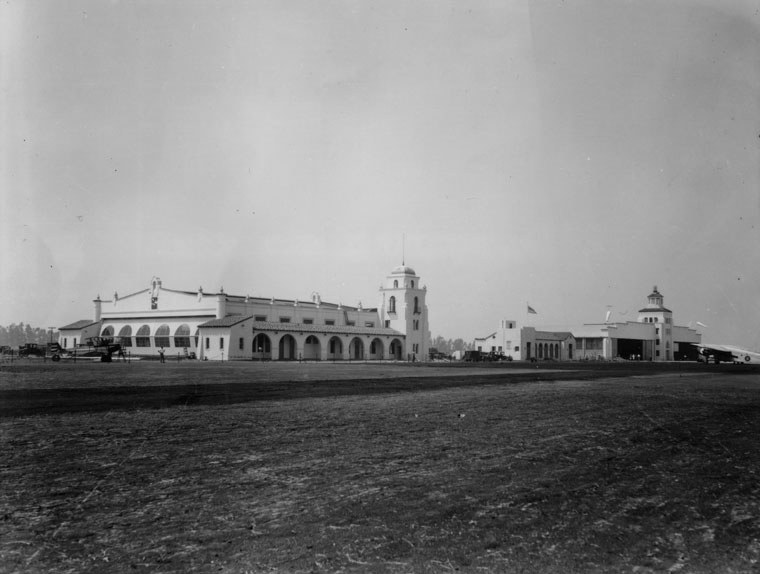 |
|
| (ca. 1928)* - Administration building in foreground and hangars in background at Mines Field (later to become the L.A. International Airport) |
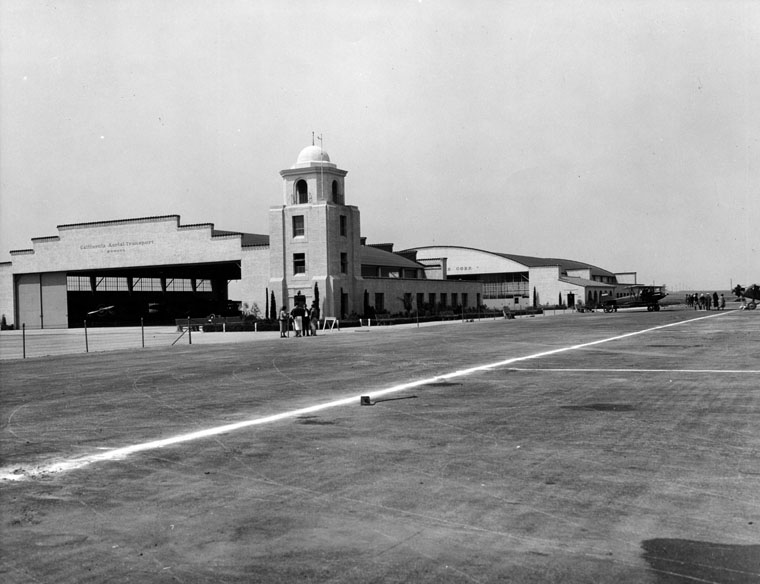 |
|
| (ca. 1928)* - California Aerial Transport School and other buildings at Mines Field (later to become the Los Angeles International Airport) |
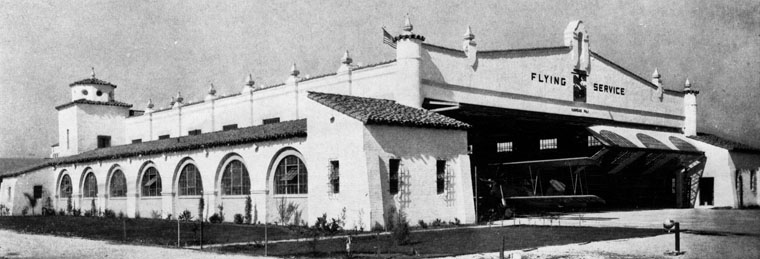 |
|
| (ca. 1928)* - Flying service building at Mines Field (later known as Los Angeles International Airport) |
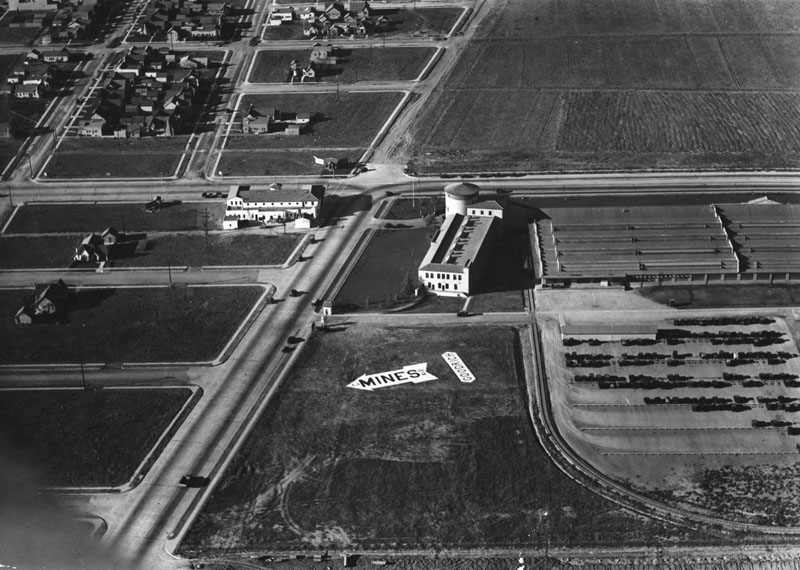 |
|
| (1928)* - Fliers seeking Mines Field, new municipal airport and site of the National Air Races, will hereafter find the way pointed out to them unmistakably by six huge aerial markers. |
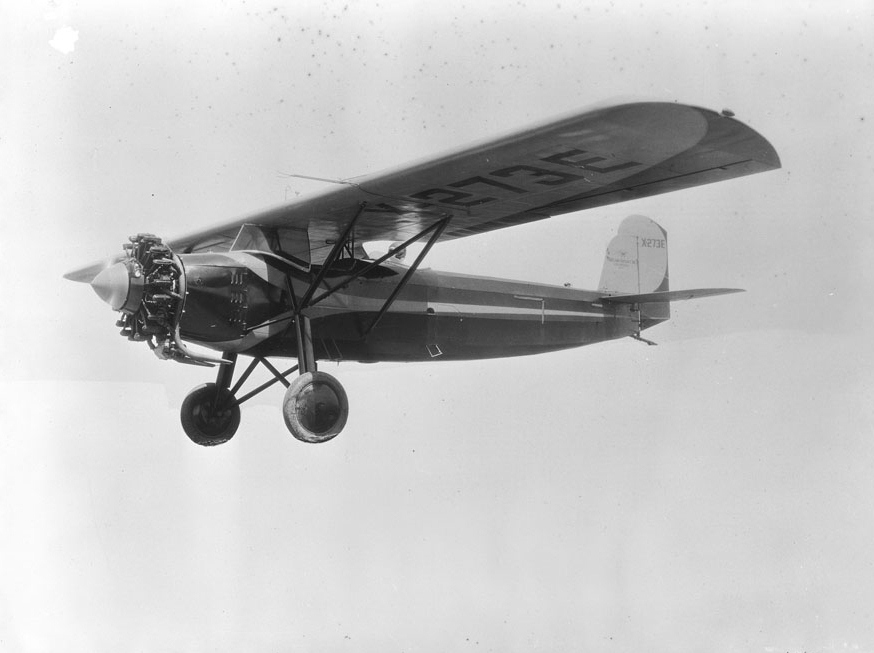 |
|
| (1929)^* - Photo of monoplane in flight near Mines Field factory, 1929. The plane was made by Moreland Aircraft Company which was located at Mines Field. |
 |
|
| (1929)^*# - View of the Maddux Air Lines fleet at Mines Field. |
Historical Notes In 1927 Jack L. Maddux, an owner of a Los Angeles Ford and Lincoln car dealership, founded Maddux Airlines. The airline’s inaugural flight was on September 22, 1927 when the airline’s Ford 4-AT Tri-motor carrying 12 passengers flew from San Diego to Los Angeles. This flight was to a small dirt landing strip that would later become Mines Field then Los Angeles International Airport, although the landing strip, called Inglewood Site, was not suitable for the airline, and Jack Maddux chose instead Rogers Airport, with improved facilities, and later Grand Central Air Terminal in Glendale. On August 26, 1929 a Maddux Tri-motor, along with other aircraft, escorted the famous LZ 127 Graf Zeppelin airship to Mines Field where it stopped during its around the world flight. Among the famous aviators who were involved with Maddux were Charles Lindbergh and Amelia Earhart. Maddux also had a publicity department that advertised the celebrities who flew with the airline. These included Will Rogers, who rode on the inaugural flight, and Hollywood actors Arthur Edmund Carewe and Dolores del Río.*^ Click HERE for more on Maddux Airlines. |
* * * * * |
Graf Zeppelin Comes to Los Angeles
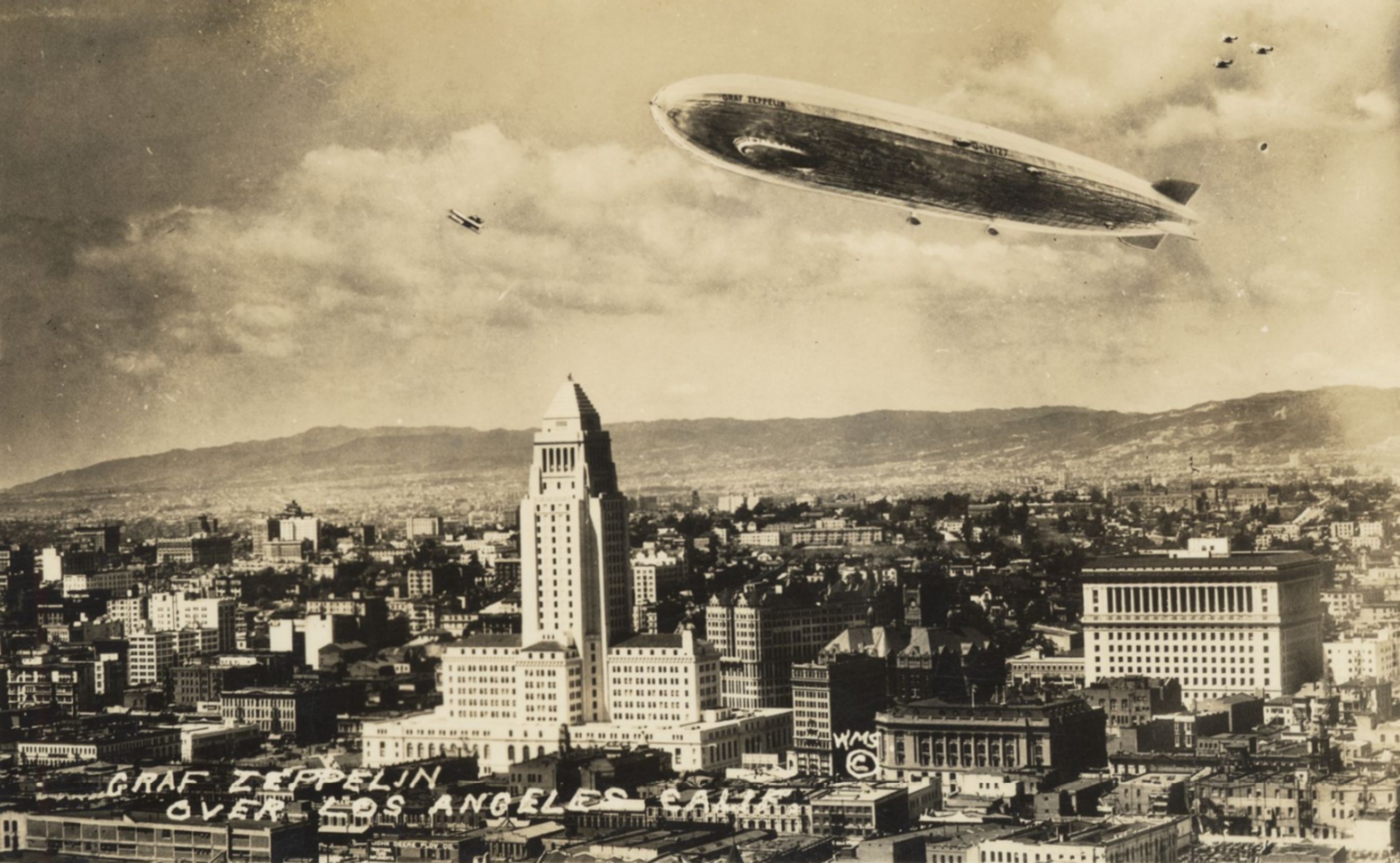 |
|
| (1929)* – A postcard view showing the Graf Zeppelin airship accompanied by a group of bi-planes flying over Los Angeles. |
Historical Notes In 1929, Graf Zeppelin made perhaps its most famous flight; a round-the-world voyage covering 21,2500 miles in five legs from Lakehurst to Friedrichshafen, Friedrichshafen to Tokyo, Tokyo to Los Angeles, Los Angeles to Lakehurst, and then Lakehurst to Friedrichshafen again. The round-the-world-trip was partly sponsored by American newspaper publisher William Randolph Hearst, who paid for about half the cost of the flight in return for exclusive media rights in the United States and Britain. |
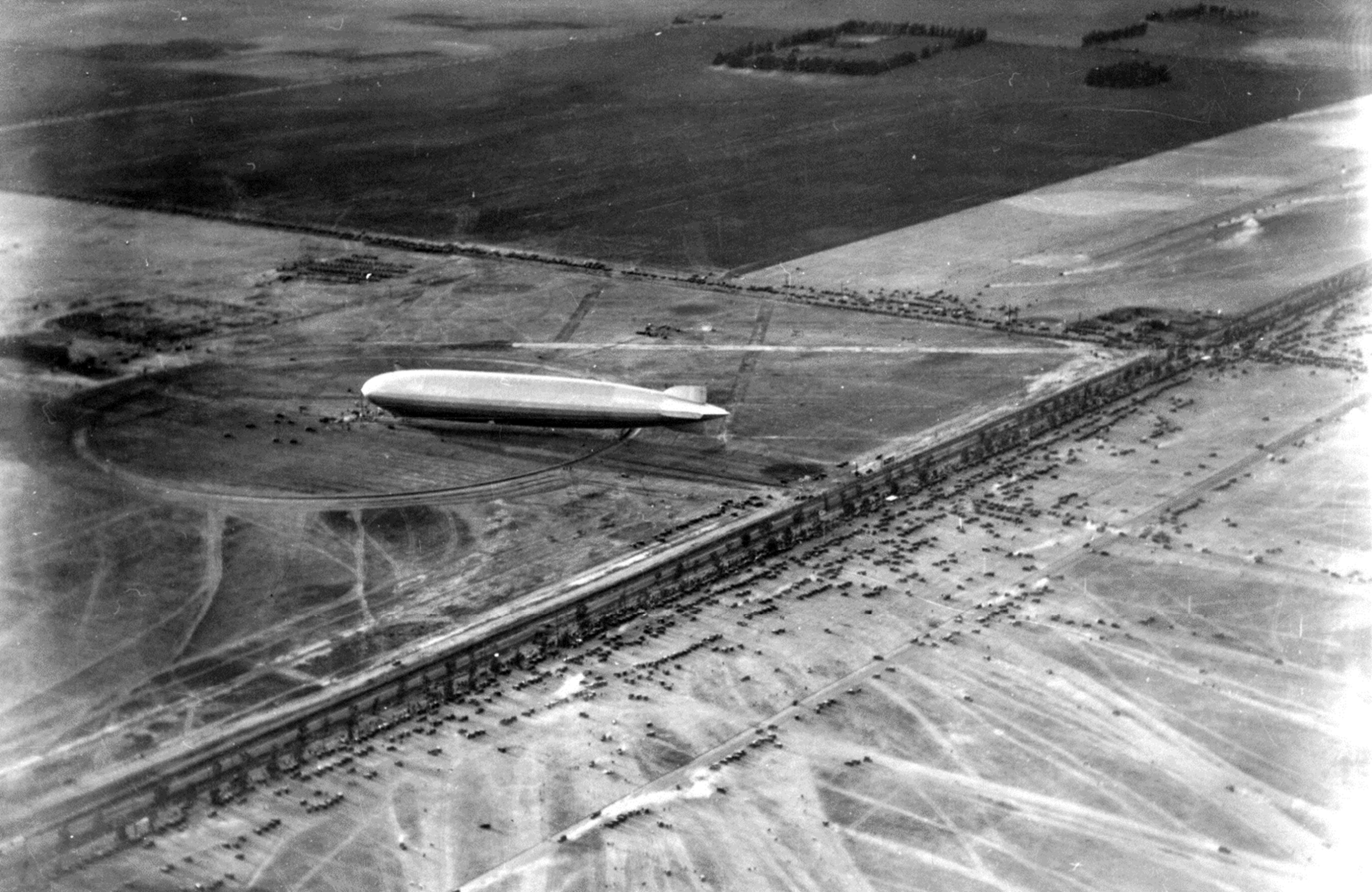 |
|
| (1929)* - The Graf Zeppelin landing at Mines Field, photographed from a Ford TriMotor plane. |
Historical Notes CThe Graf Zeppelin arrived at Mines Field in Los Angeles on August 26, 1929, after a 79-hour flight from Tokyo. This stop was part of the airship's famous Round-the-World flight in 1929. The massive dirigible measured 770 feet in length and 116 feet at its widest point. The airship landed at Mines Field, which is now the site of Los Angeles International Airport. The arrival was met with great excitement and anticipation, with an estimated 500,000 people gathering to witness the event. Many spectators camped overnight, equipped with tents and portable stoves, while vendors set up makeshift stands to sell food and drinks. |
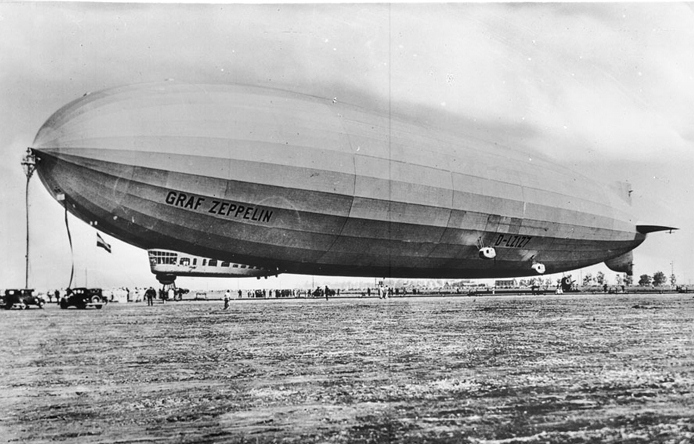 |
|
| (1929)^* - Closer view of the Graf Zeppelin from the side facing left, with people and automobiles visible beneath it. |
Historical Notes "Graf Zeppelin" means "Count Zeppelin," referring to Count Ferdinand von Zeppelin, the German aviation pioneer who founded the Zeppelin airship company. The word "Graf" is a German title of nobility that translates to "Count." |
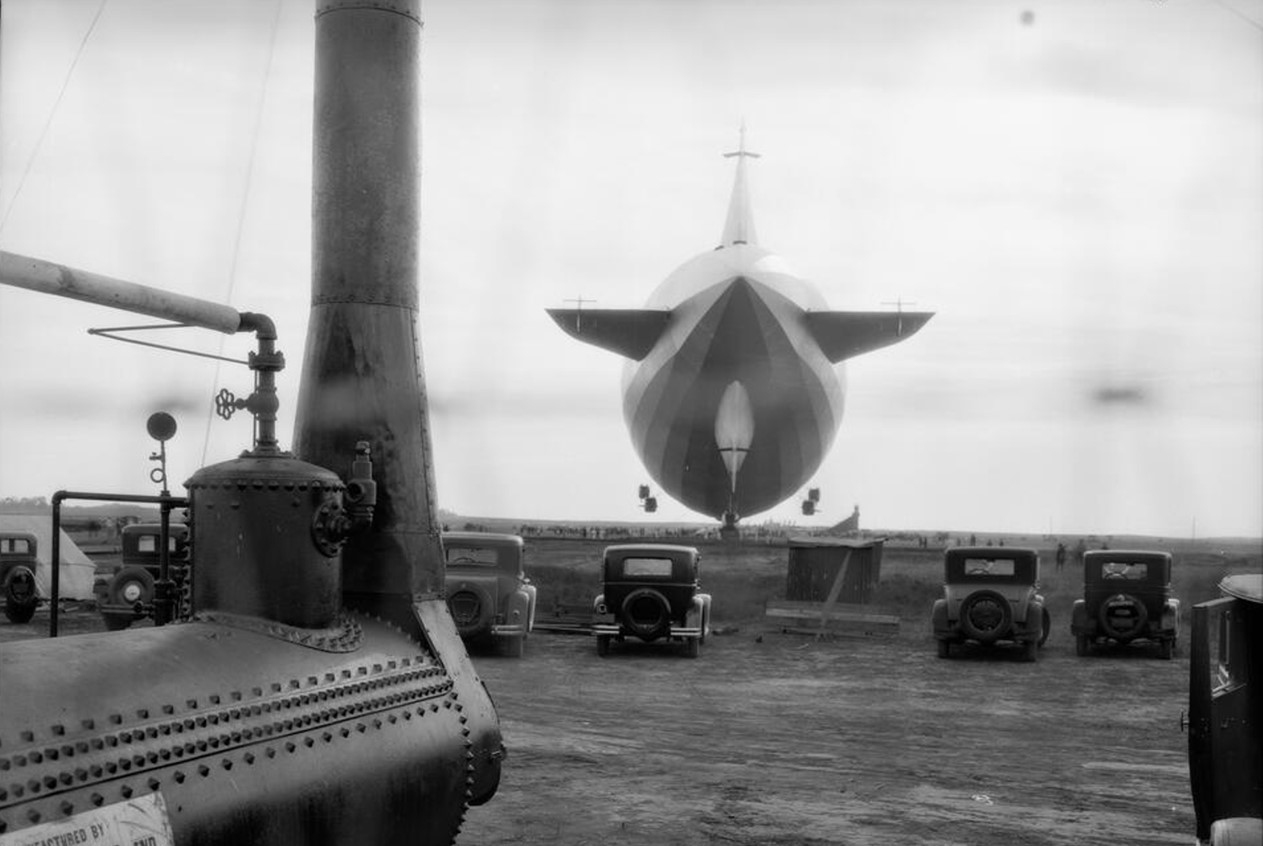 |
|
| (1929)* – View looking at the rear of the Graf Zeppelin from behind the gas equipment used for refueling the aircraft. |
Historical Notes The Graf Zeppelin employed a unique dual-fuel system combining Blau gas and gasoline. Blau gas, the primary fuel, had a density similar to air, which prevented significant changes in buoyancy as it was consumed, allowing stable flight without the need to vent hydrogen. The airship carried about 1,059,435 cubic feet of Blau gas, providing over 100 hours of flying time. Gasoline was also used, primarily to lighten the airship's load more effectively than Blau gas. This combination allowed the Graf Zeppelin to maximize its endurance, enabling up to 118 hours of cruising when both fuels were utilized. This innovative system addressed the challenge of maintaining aerostatic balance during long flights, contributing to the airship's operational success and extended range. |
_1929.jpg) |
|
| (1929)* - Postcard view of the Graf Zepelin at a stopever at Los Angeles' Mines Field on its "Around the World Trip". |
Historical Notes The Zeppelin was a type of rigid airship pioneered by the German Count Ferdinand von Zeppelin in the early 20th century. It was based on designs he had outlined in 1874 and detailed in 1893. His plans were reviewed by committee in 1894 and patented in the United States in 1899. Given the outstanding success of the Zeppelin design, the term zeppelin in casual use came to refer to all rigid airships. |
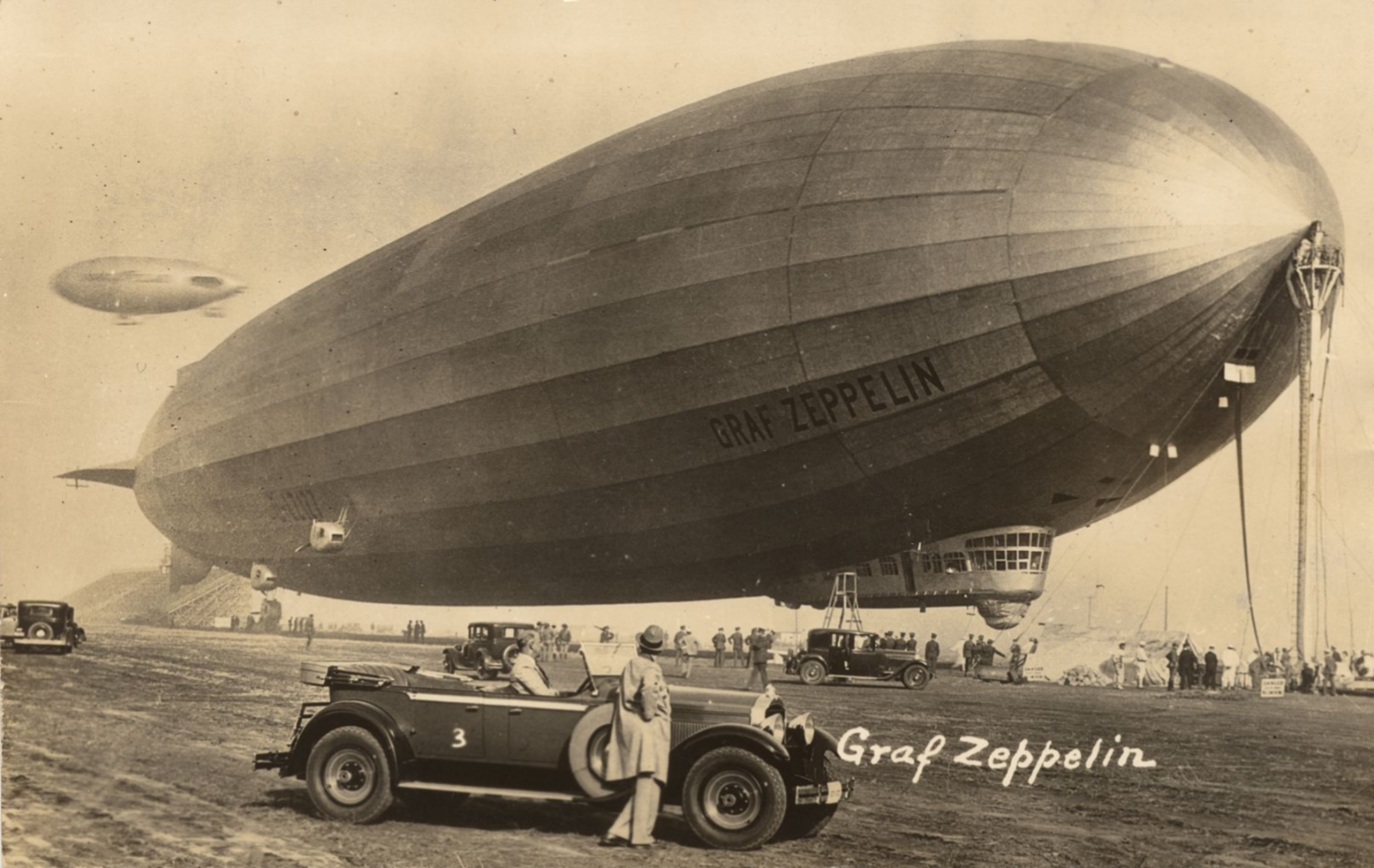 |
|
| (1929)* – View showing a 1929 Packard and the Graf Zeppelin at Mines Field, Los Angeles. In the distance can be seen the Goodyear Blimp. |
Historical Notes In 1930, the Graf Zeppelin began regular transatlantic commercial flights. It had 20 sleeping berths for passengers and a crew of 36. Its first flight was in 1928, its last in 1937, after 590 total flights. The Graf Zeppelin was retired one month after the Hindenberg disaster. |
.jpg) |
|
| (1929)* – View showing a 1929 Packard and the Graf Zeppelin at Mines Field, Los Angeles. In the distance can be seen the Goodyear Blimp. |
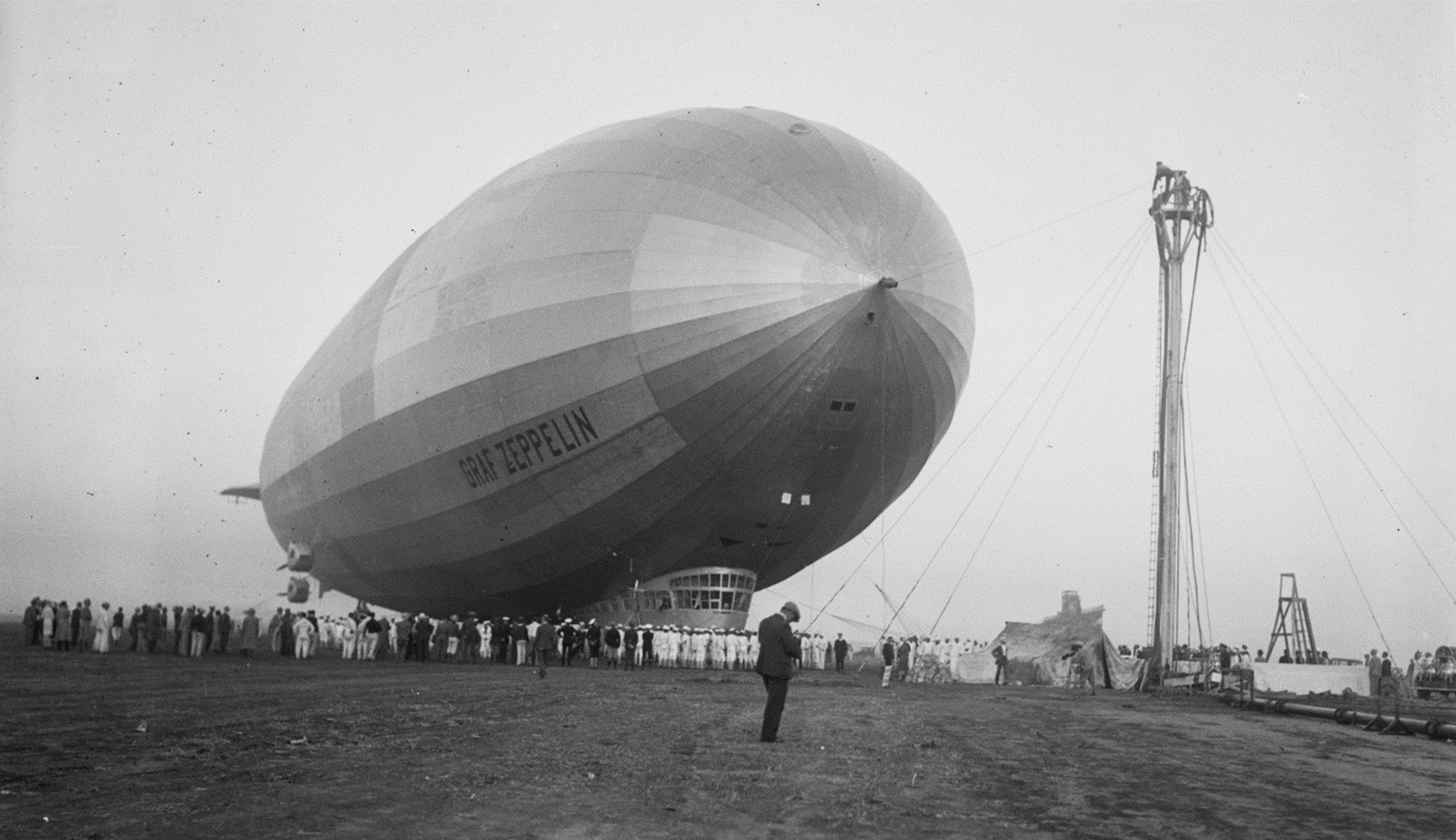 |
|
| (1929)* - Image of the Graf Zeppelin dirigible moored in a field at the Los Angeles Municipal Airport and surrounded by crowds, during a stop by the airship during its around-the-world flight. |
Historical Notes Zeppelins were first flown commercially in 1910 by Deutsche Luftschiffahrts-AG (DELAG), the world's first airline in revenue service. By mid-1914, DELAG had carried over 34,000 passengers on over 1,500 flights. After the outbreak of World War I, the German military made extensive use of Zeppelins as bombers and scouts. |
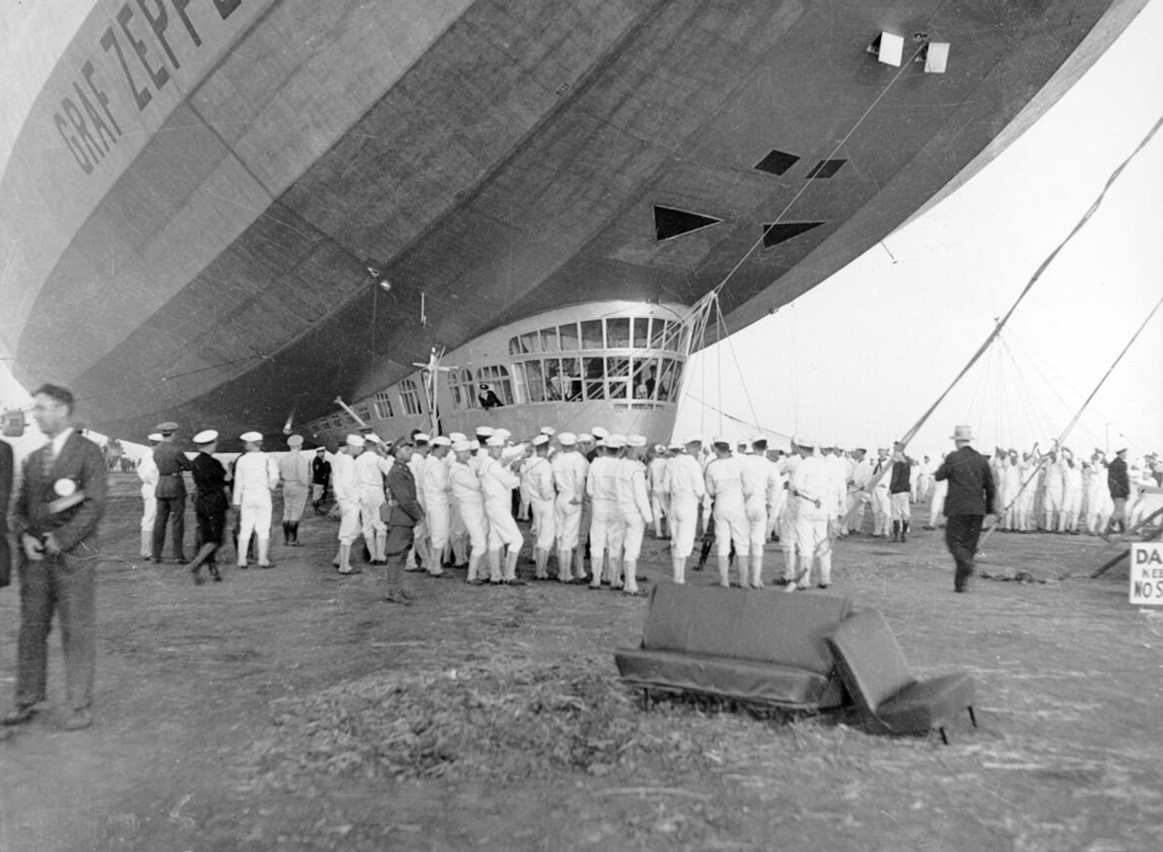 |
|
| (1929)* – Close-up view of the Graf Zeppelin at the Mines Field. A large group of uniformed men stands in the field below the zeppelin, along with two seats that sit in the foreground. Anchor ropes for the zeppelin diagonally cross the lower right corner of the image. |
Historical Notes CThe Graf Zeppelin maintained a flawless passenger safety record throughout its operational history from 1928 to 1937, never injuring a passenger or crew member. |
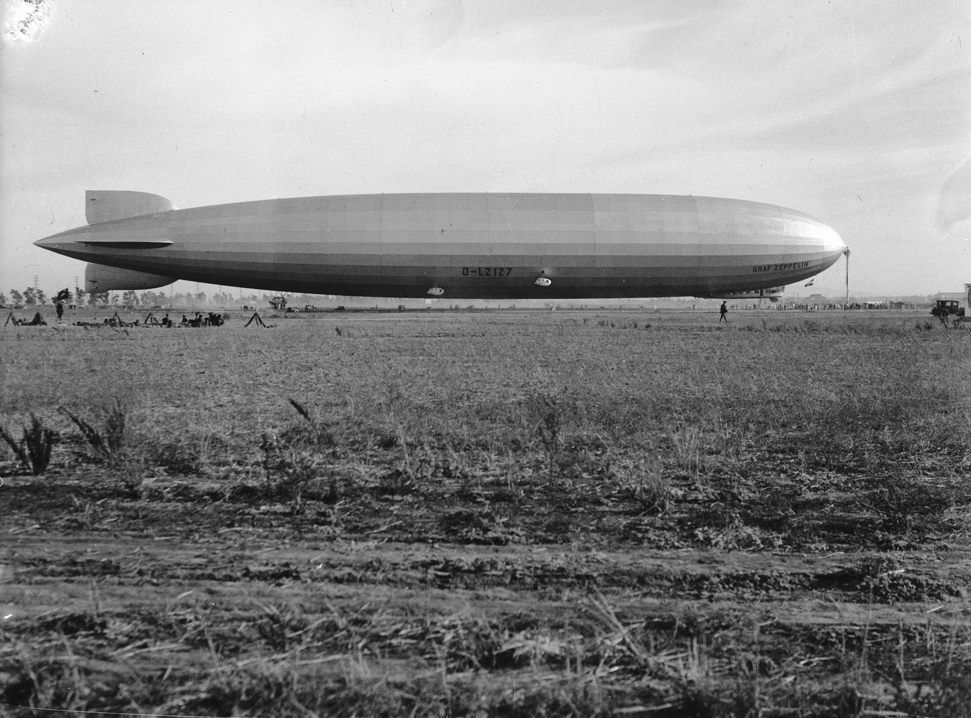 |
|
| (1929)^* - Photograph of Graf Zeppelin at Mines Field. The LZ-127 Graf Zeppelin was 776 feet long and 100 feet in diameter. |
Historical Notes The airship achieved several significant milestones during this period, including the first commercial passenger flight across the Atlantic in October 1928 and the first passenger-carrying flight around the world in 1929. In July 1931, it conducted a scientific mission over the North Pole, performing meteorological observations and mapping unmapped regions. |
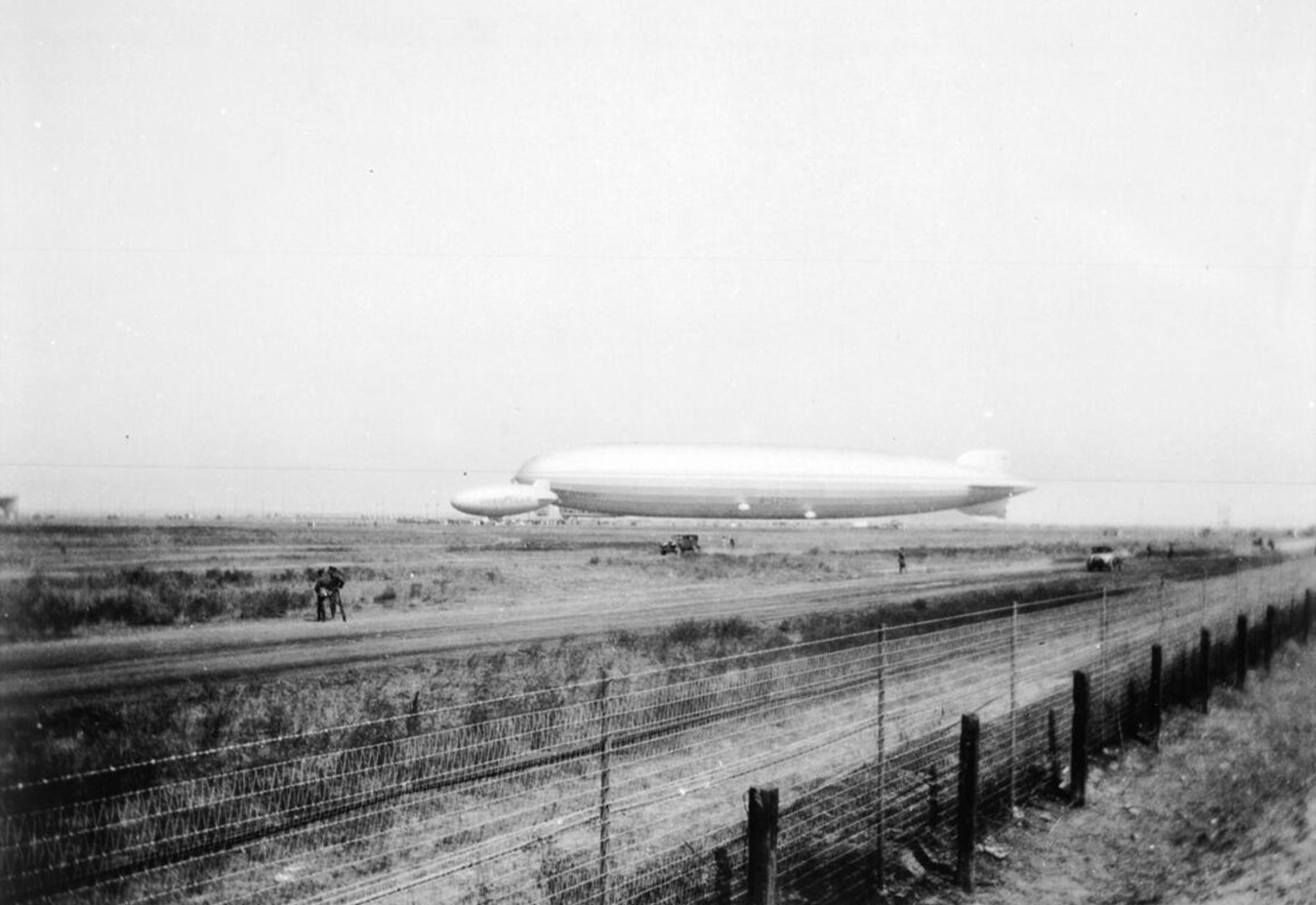 |
|
| (1929)* – View showing the Graff Zeppelin and the Goodyear Blimp in a field. The Graff Zeppelin sits in a field at the center of the image, with the Goodyear blimp in front of its left edge. A few automobiles and men are scattered throughout the field's thick vegetation. A wire fence borders the field in the foreground, running diagonally from the lower left corner to the center right. |
Historical Notes The Graf Zeppelin pioneered regularly scheduled, nonstop, intercontinental airline service and participated in notable events such as the 1933 Chicago World's Fair. Additionally, from 1931 to 1937, it established regular service to South America, particularly to Brazil and Argentina. |
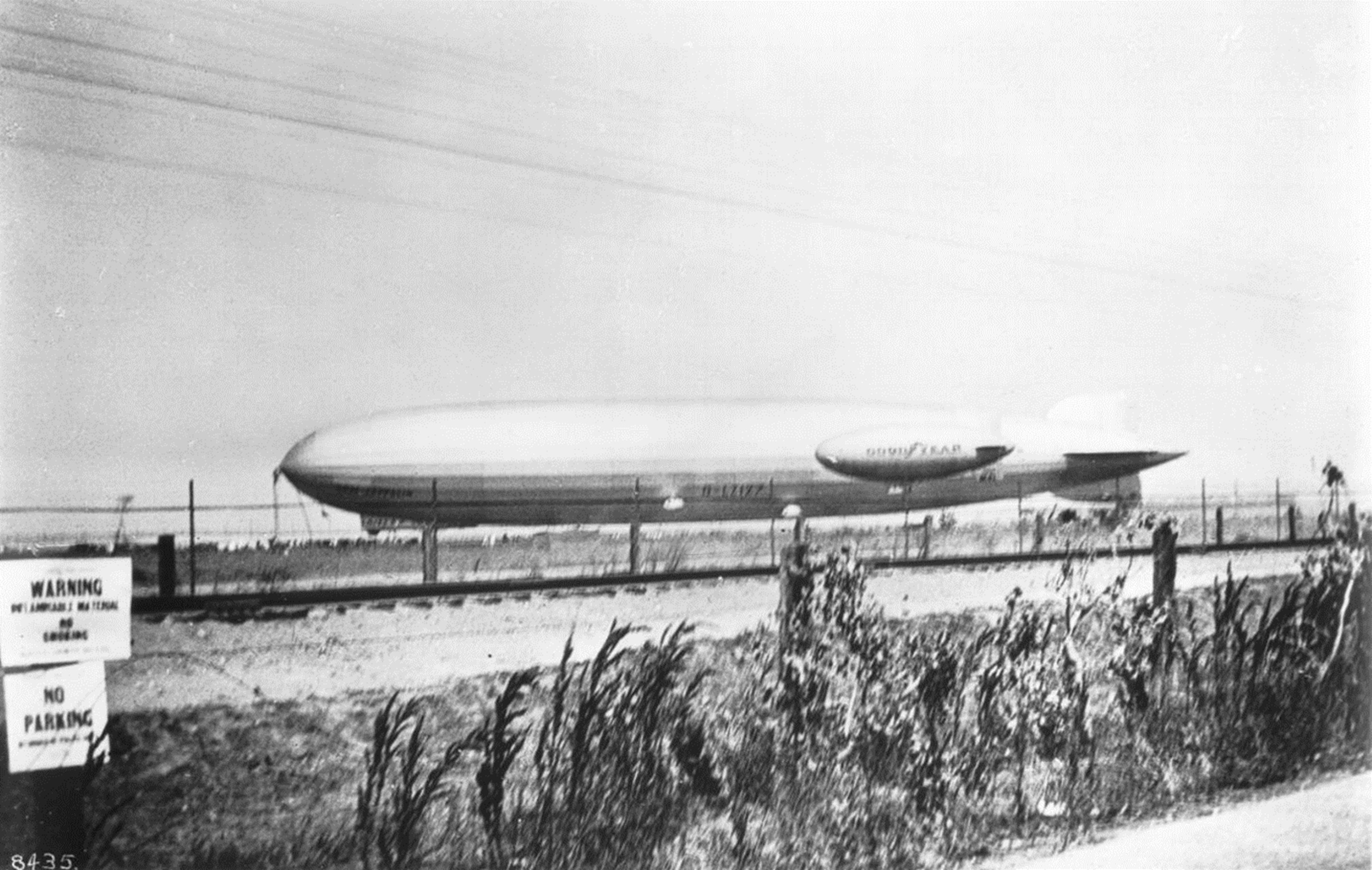 |
|
| (1929)* - Photograph of the Graf Zeppelin and the small Goodyear pony blimp floating (or parked?) next to each other, 1929. The Graf Zeppelin is about ten times the size of the Goodyear blimp. Both the blimps are on the other side of the fence in the foreground. Several warning signs are posted up including a no-parking sign. |
Historical Notes The LZ 127 Graf Zeppelin was in service for nearly nine years, from its first flight on September 18, 1928, to its last on June 18, 1937. During this period, it completed 590 flights, covering over 1.7 million kilometers (more than 1 million miles), and carried 13,110 passengers across 144 ocean crossings, all while maintaining a perfect passenger safety record. This made it the most successful rigid airship ever built. The Graf Zeppelin's retirement was directly linked to the Hindenburg disaster on May 6, 1937. After its final passenger flight from Brazil to Germany on May 8, 1937, it was grounded and officially withdrawn from service, eventually being scrapped in March 1940 by order of Hermann Goering's Luftwaffe. |
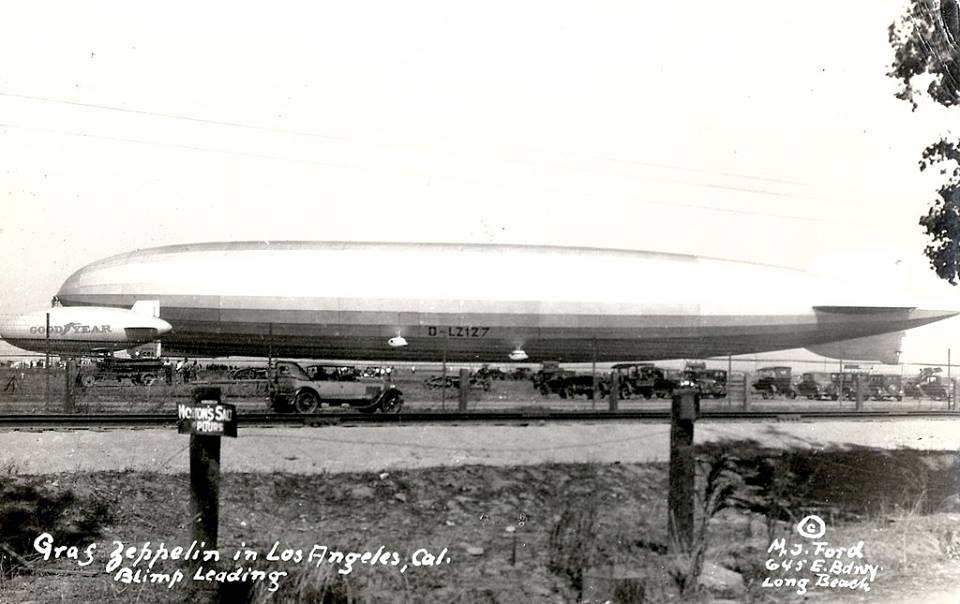 |
|
| (1929)* - Closer view of the Goodyear Blimp alongside the Graf Zeppelin showing the size disparity. |
Historical Notes Passengers were treated to high-quality meals served in a dedicated dining area, establishing the precedent for fine dining in the air. |
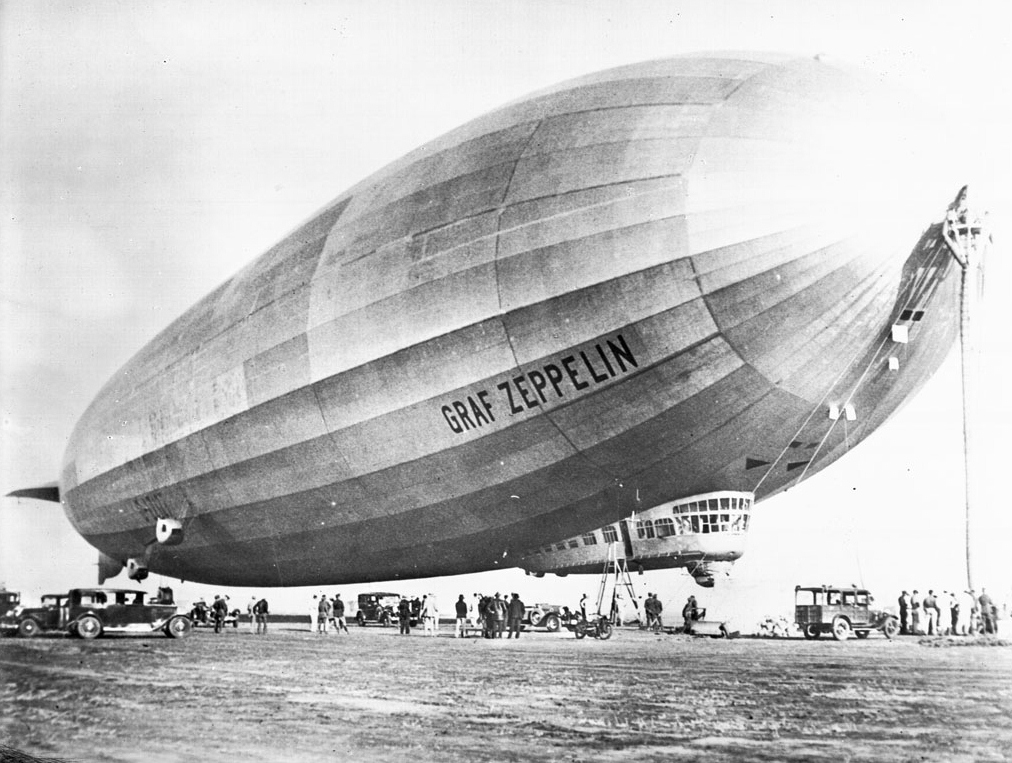 |
|
| (1933)* - The Graf Zeppelin airship is anchored to the ground as workmen and other officials ready her. A ladder extends to the doorway of the cabin. Several men gather around the hose that rises to the tip of the airship. Motorcycles and cars are parked haphazardly on the field. Photo dated: July 8, 1933. |
Historical Notes The Graf Zeppelin visited Los Angeles several times during its operational years. Its first visit was on August 26, 1929, during its Round-the-World flight. In 1933, it returned as part of a promotional tour that included a flight to the Chicago World's Fair. The airship made another notable visit in 1936 during a series of flights promoting the Olympics in Berlin and other international events. |
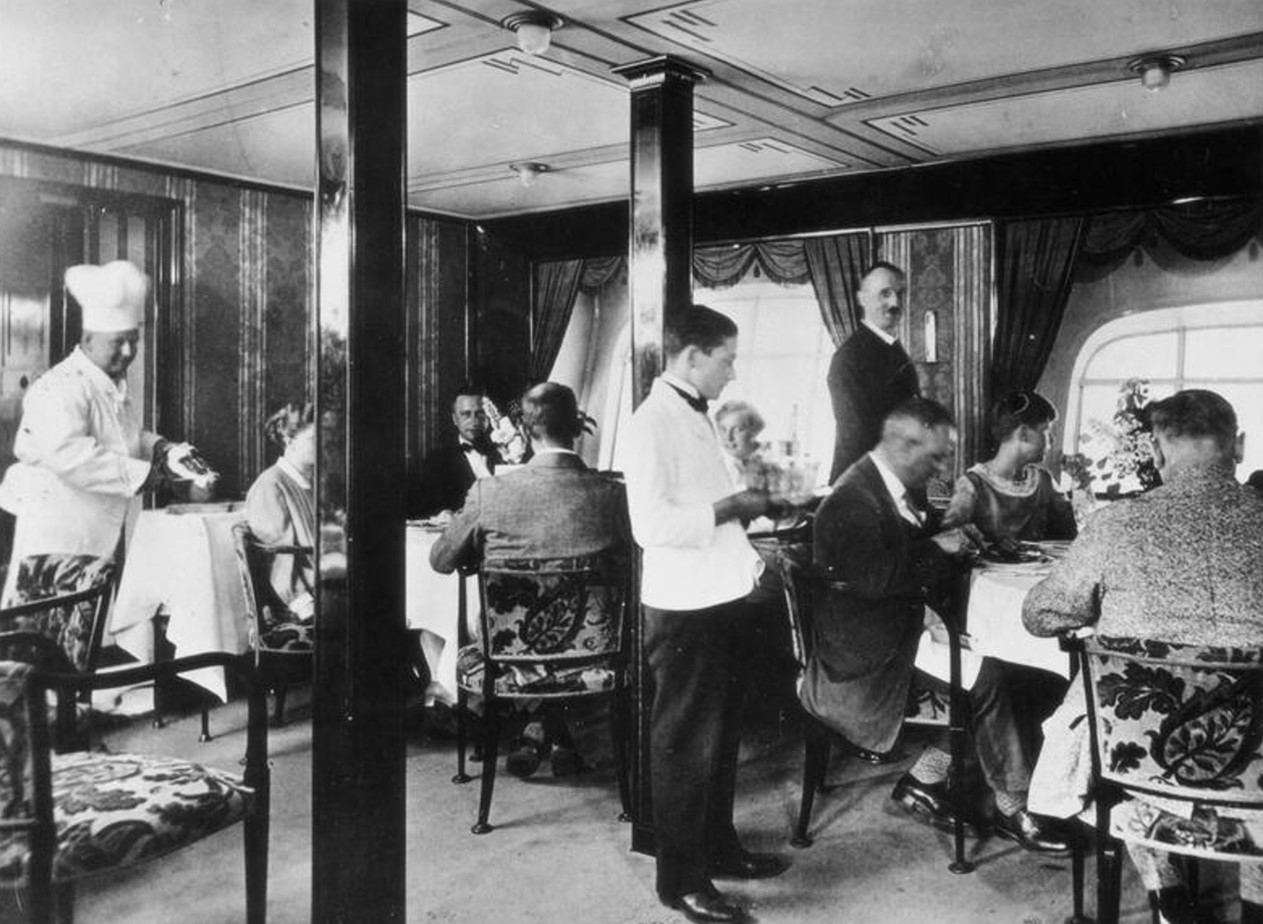 |
|
| (1929)* - Dining on the Graf Zeppelin. Passengers were treated to high-quality meals served in a dedicated dining area, establishing the precedent for fine dining in the air. |
Historical Notes The visit of the Graf Zeppelin left a lasting impression on Los Angeles. It inspired the creation of the Zep Diner, a temporary landmark near the intersection of W. Florence Avenue and S. Figueroa, which has since become a McDonald's parking lot. The event was extensively covered by the press, with numerous photographs and articles documenting the airship's presence in the city. Click HERE to see more of the Zep Diner. |
Good Year Blimp at Mines Field
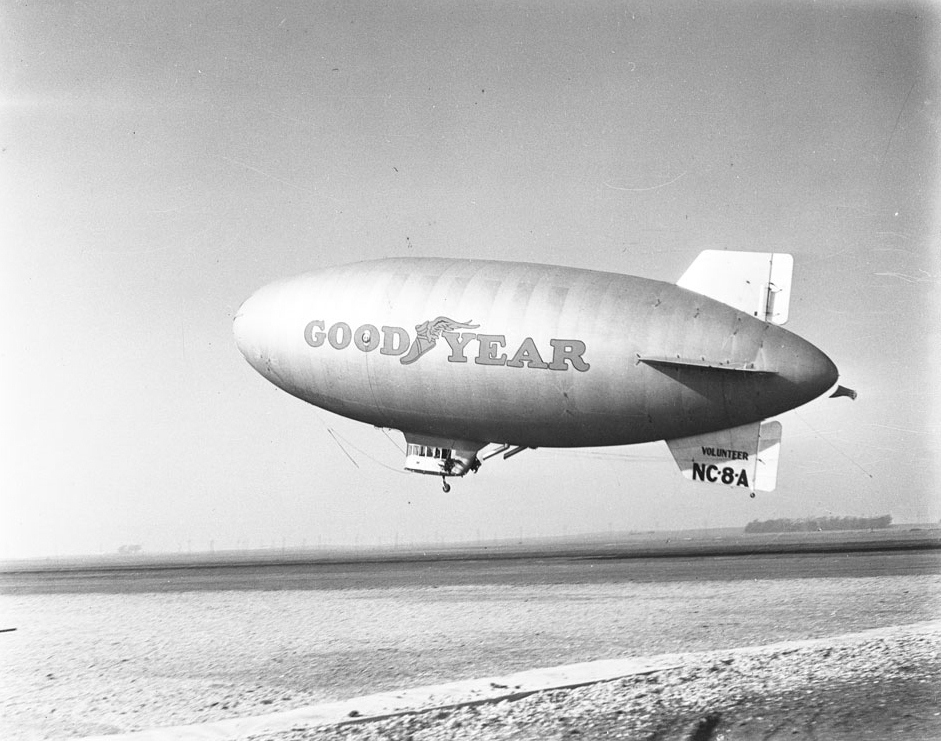 |
|
| (1930)* - Photograph of a Goodyear Blimp over Mines Field, February 7, 1930. The large blimp with the logo of "Goodyear" flies at center with "Volunteer NC-8-A" printed on one of its fin-like features at right. The empty, dirt field lies below. |
Historical Notes Goodyear began producing airship envelopes in 1911 and introduced its own blimp, Since 1928, Goodyear had named its blimps after the U.S. winners of the America's Cup yacht race. This naming method is attributed to then-Goodyear CEO Paul W. Litchfield, who viewed the airships as being like yachts in the sky. Although that practice deviated with the introduction of the Spirit of Akron in 1987, the Florida-based Stars & Stripes would be the last to carry this honor, ending in 2005. According to the Goodyear website, the three active GZ-20 blimps are 192 feet long, 59.5 feet tall, and 50 feet wide. For comparison, the largest airships ever built, the Zeppelin company's Hindenburg, LZ-129, and the Graf Zeppelin II, LZ-130, were 804 feet long and 135 feet in diameter. That is, over four times as long and over twice as wide as the current Goodyear blimps. |
Hangar No. 1
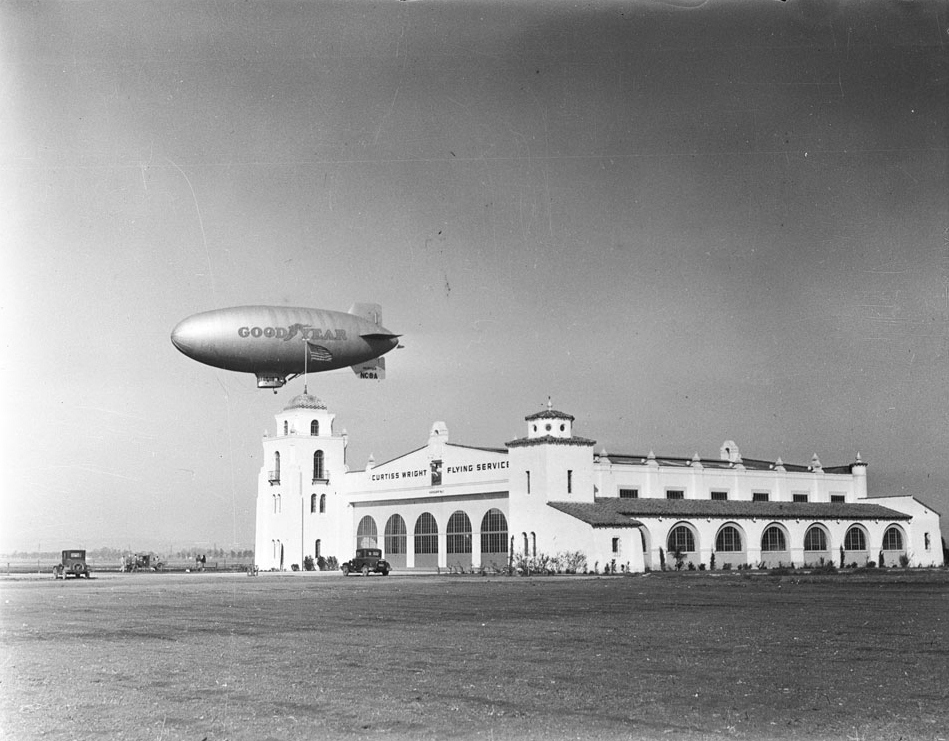 |
|
| (1930)* - Photograph of the Goodyear Blimp over Hangar No. 1 at Mines Field, February 7, 1930. The blimp with the logo of "Goodyear" flies above the large, lightly-colored "Curtiss Wright Flying Service" at left. The building has two towers, on its front wall, one which displays the American flag. The building has many tall, arched windows and doors. Automobiles sit parked in the empty, dirt field at left and in the foreground. |
Historical Notes Hangar No. 1 at Mines Field (today LAX) has a rich history as the first permanent structure built at the airport, predating even the control tower. It was constructed in 1929 at a cost of $65,000 (around $1 million today) in the Spanish Colonial Revival architectural style. It was designed by the architectural firm Gable and Wyatt. |
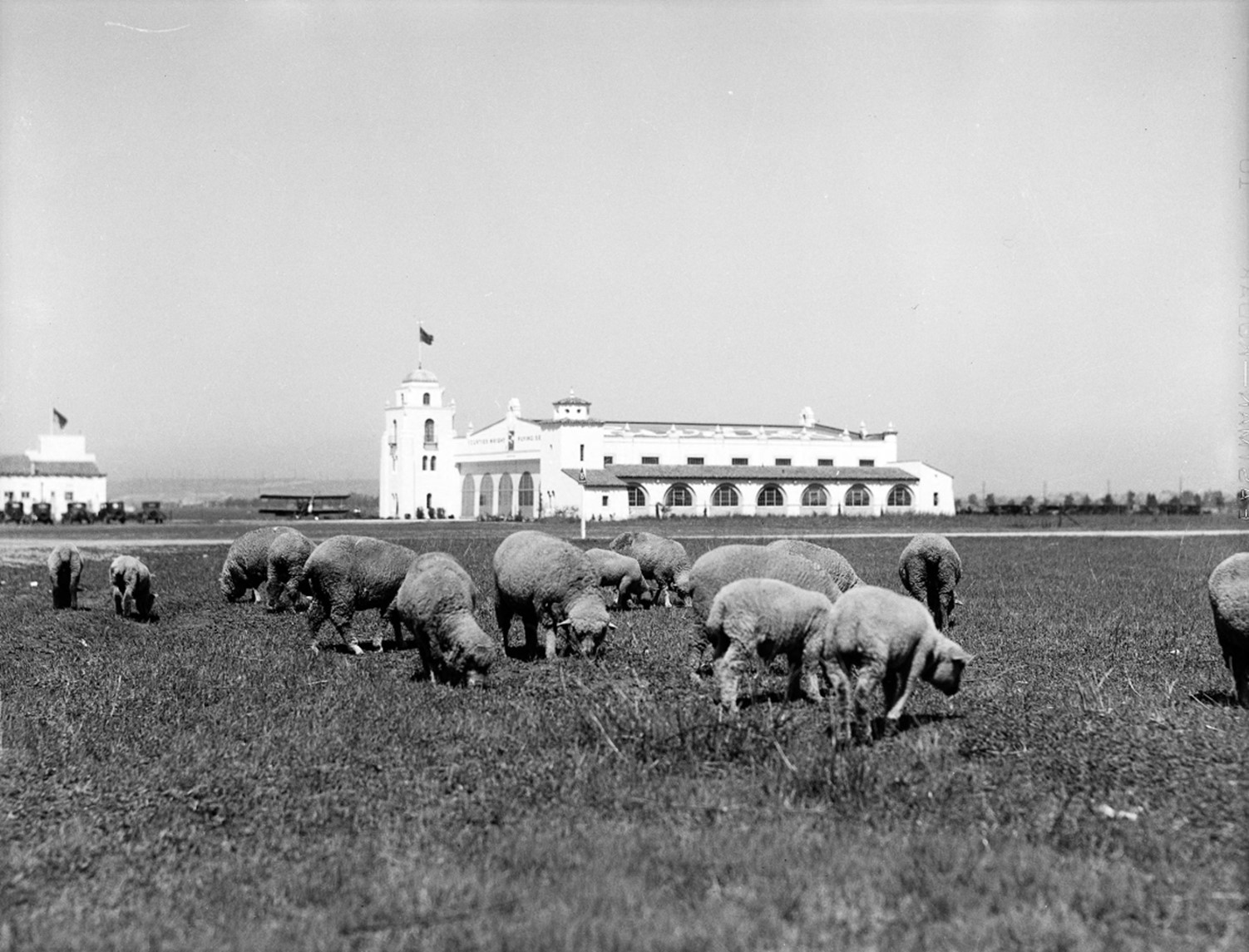 |
|
| (1930)* – Sheep grazing near the runway at Mines Field with Hangar No.1, the first structure built at the airport, in the background. Photo by Dick Whittington |
Historical Notes Hangar No. 1 was the first building erected at Mines Field, which later became LAX. At the time, the airport consisted of just a dirt landing strip surrounded by bean and barley fields. The hangar was built for and initially leased to the Curtiss Wright Flying Service, which based its civilian flight school and planes there. Hangar No. 1 predated the airport's first control tower, built in 1930, and was the only structure at the newly dedicated Los Angeles Municipal Airport in 1930. Historic events at the hangar include Charles Lindbergh visiting in 1927, the German airship Graf Zeppelin stopping there in 1929, and crowds gathering to watch the National Air Races in 1933 and 1936. Commercial passenger flights did not operate from LAX until 1946, after the airport was purchased by the city in 1937. |
 |
|
| (2019)* - Contemporary view of Hangar No. 1. This was the first building to go up at Mines Field (later LAX(. |
Historical Notes The hangar fell into disuse in the 1970s but was renovated in 1990 for $2 million to restore its 1930s appearance and meet modern codes. It was listed on the National Register of Historic Places in 1992. Today, Hangar No. 1 serves as a cargo facility but remains the last link to LAX's earliest days as a small airfield. |
Then and Now
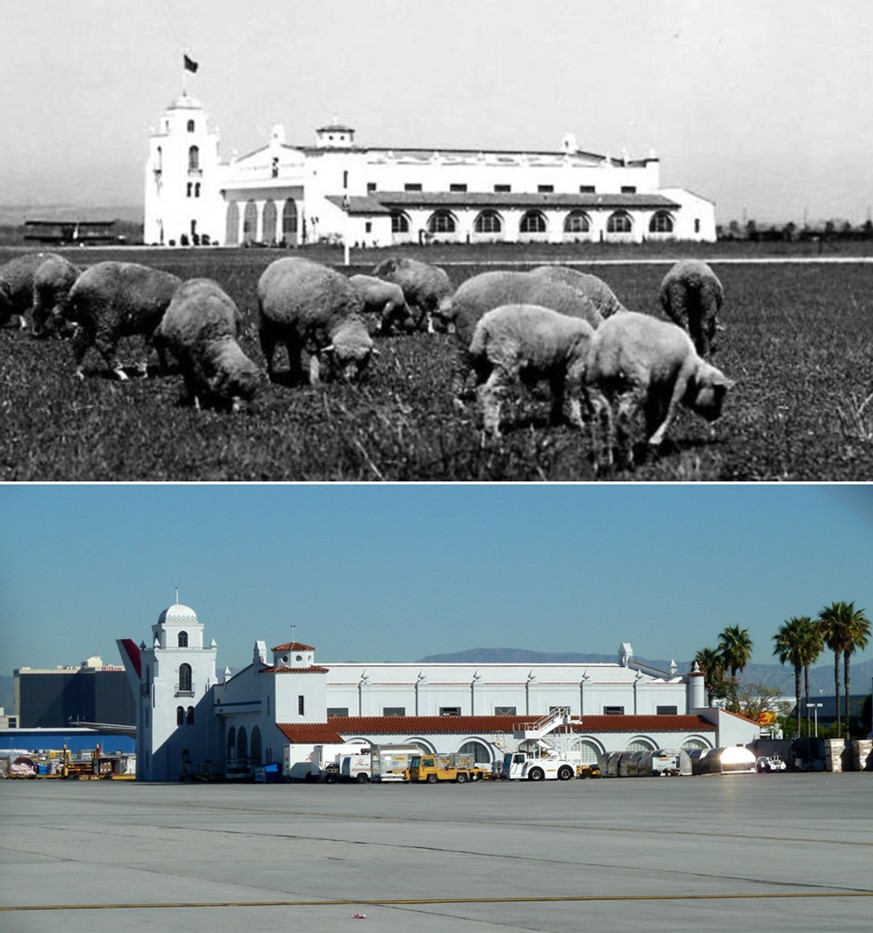 |
|
| (1930 vs. 2019)* - Hangar No. 1 at Mines Field, today LAX. |
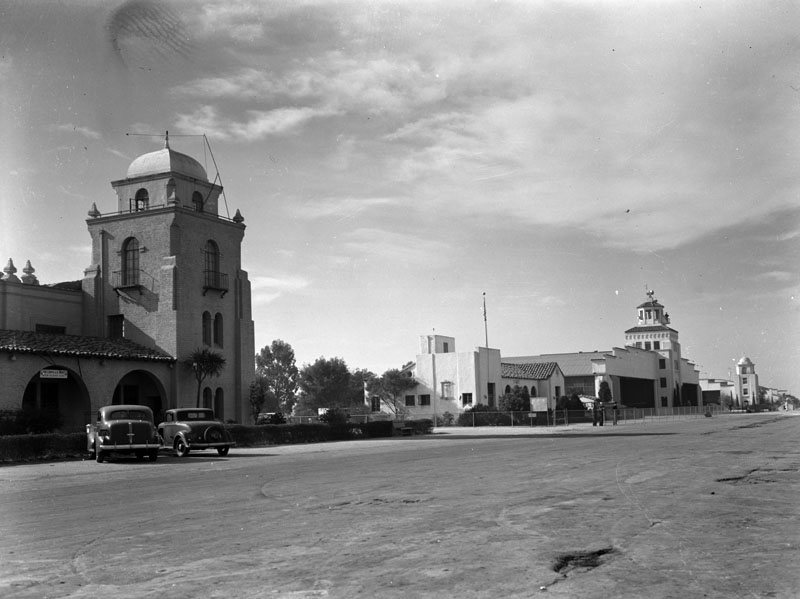 |
|
| (1937)* - View of Mines Field. Two cars are parked outside one of the buildings. |
Historical Notes In 1937, the City of Los Angeles purchased Mines Field outright. Four years later, it passed a $3.5 million bond issue for new construction, renamed the site Los Angeles Airport, and began converting the modest aviation facility into the major airport that would escort Los Angeles into the Jet Age. |
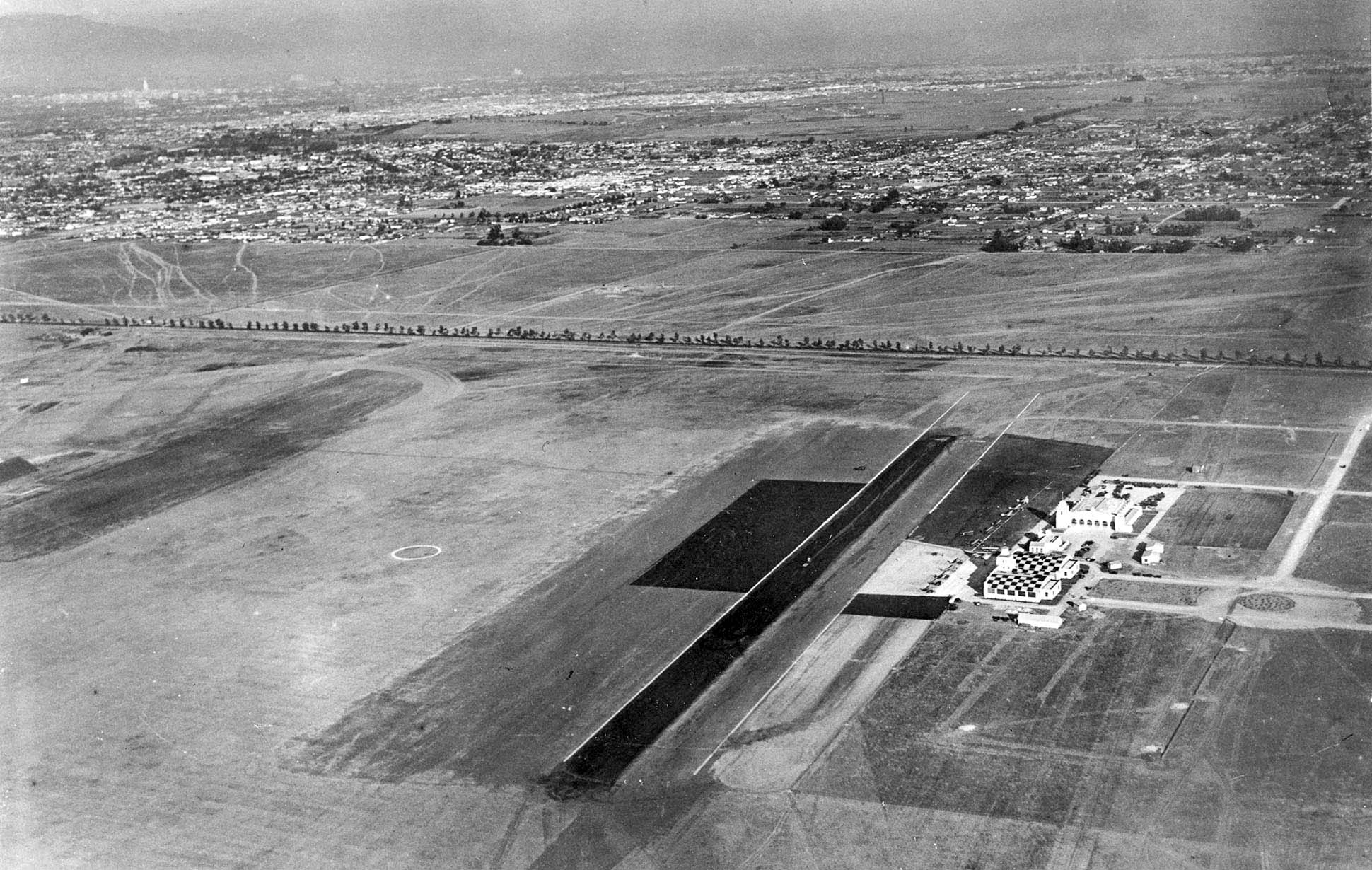 |
|
| (1929)*– Aerial view of Mines Field looking northeast showing empty fields surrounding the relatively small airport. |
Historical Notes Wheat, barley and lima beans once grew where the Mines Field was first developed. Back in the 1920s it was part of Southern California's prosperous ranching business. The city's energetic Chamber of Commerce promoted the idea of building a municipal airport on the land even though flying was still a wing and a prayer activity. There was no federal money for airport investment, but the city fathers decided it was a risk worth taking. In 1928 they chose Mines Field from a list of 27 possible sites. |
Los Angeles Municapl Airport
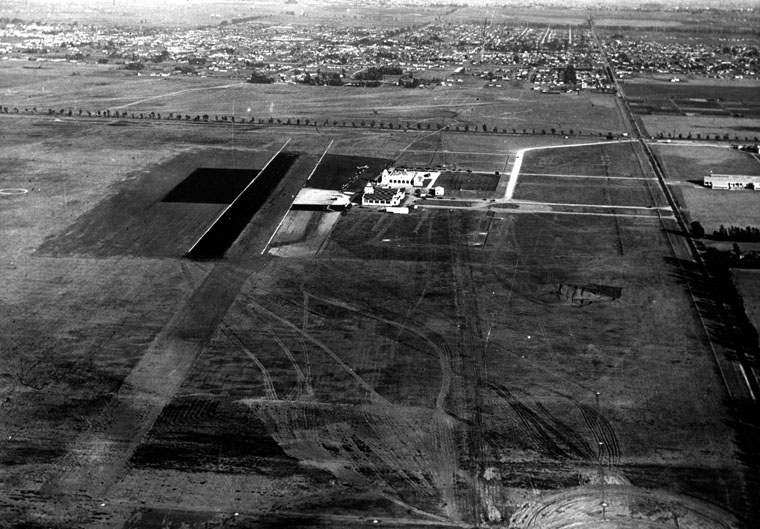 |
|
| (1930)* - Aerial view of Mines Field and surroundings; Mines Field later to become the Los Angeles International Airport. This photo was taken just before the airport was dedicated as the new official airport of Los Angeles and called LA Municipal Aiport but also known as Mines Field. |
Historical Notes In 1930 the airport was dedicated and renamed Los Angeles Municipal Airport. The dirt runway was replaced with an all-weather surface, and additional facilities like hangars, a restaurant, and a control tower were built. |
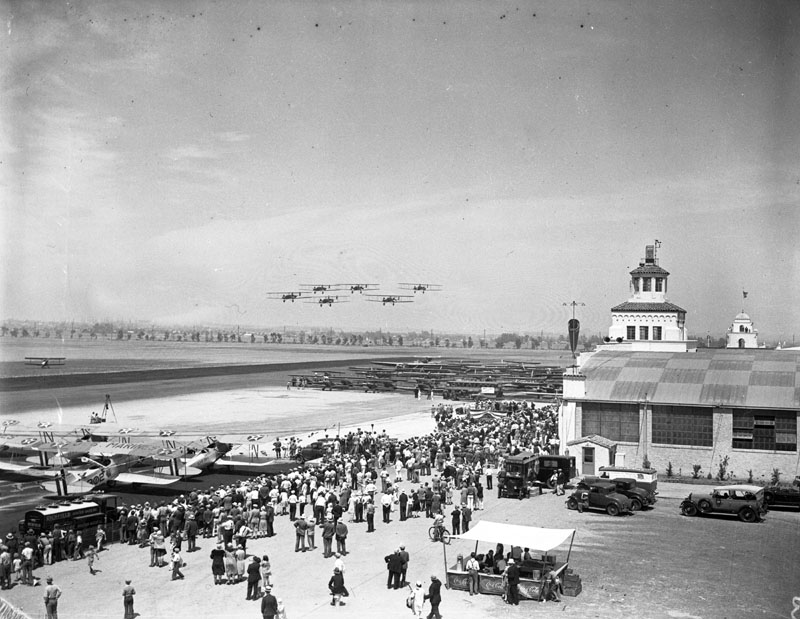 |
|
| (1930)* - Dedication of LA Municipal Airport (later L.A. International Airport) watched by large crowd and with lots of planes flying overhead. |
Historical Notes Mines Field was dedicated and opened as the official airport of Los Angeles in 1930, and the city purchased it to be a municipal airfield in 1937. The name was officially changed to Los Angeles Airport in 1941, and to Los Angeles International Airport in 1949. The main airline airports for Los Angeles had been Burbank Airport (then known as Union Air Terminal, and later Lockheed) and the Grand Central Airport in Glendale. By 1940 most airlines served Burbank only; in late 1946 most airline flights moved to LAX, but Burbank always retained a few. |
 |
|
| (1930)* - Crowds of people attended the dedication of the airport on June 7, 1930. Many planes can be seen parked on the runway. |
Historical Notes The Los Angeles Municipal Airport (later renamed LAX) was officially dedicated in a two-day gala event on June 7-8, 1930. Here are the key details about its dedication: The airport was originally known as Mines Field, named after the real estate agent who helped secure the site for the city. In the lead up to the dedication, the city held a weeklong National Air Races event at Mines Field from September 8-16, 1928 which drew an estimated 65,000 spectators and demonstrated it was a suitable airport location. |
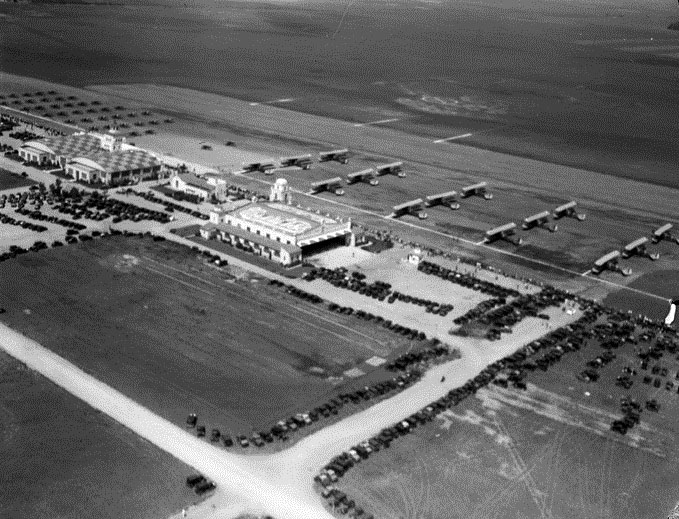 |
|
| (ca. 1931)** - Aerial view of Los Angeles Municipal Airport (now LAX) on Army Day. |
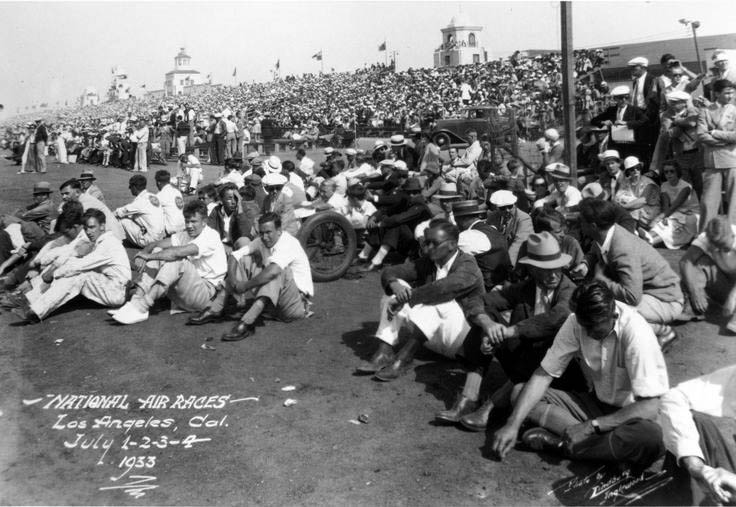 |
|
| (1933)* – View showing a huge crowd of spectators at Mines Field during the 1933 National Air Races. |
Historical Notes Several National Air Races were hosted at Mines Field. This 1933 race attracted even more spectators than the inaugural race in 1928, and really put Mines Field, aka LAX, on the map. |
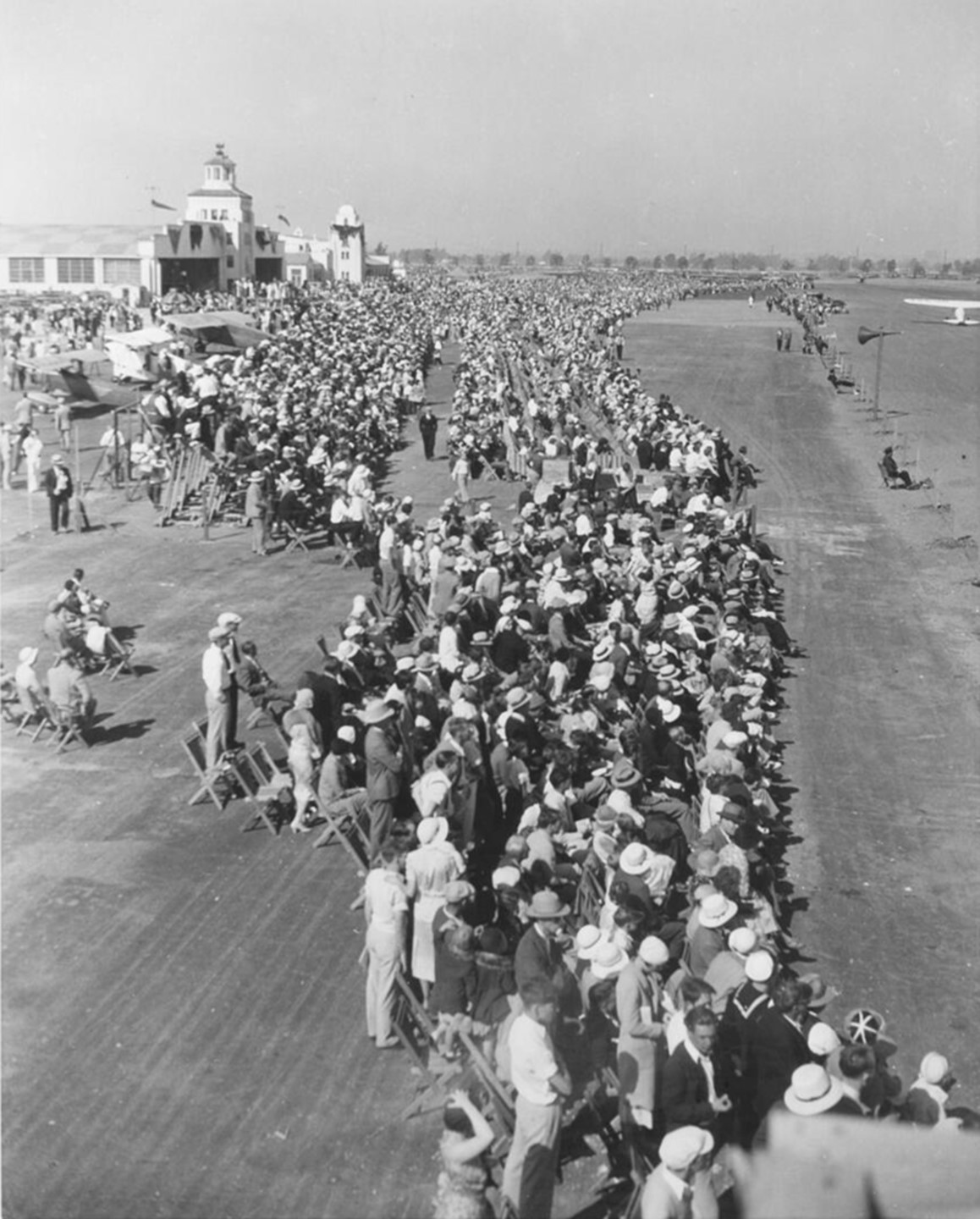 |
|
| (1930s)* - Crowd gathered for an air show at Mines Field. |
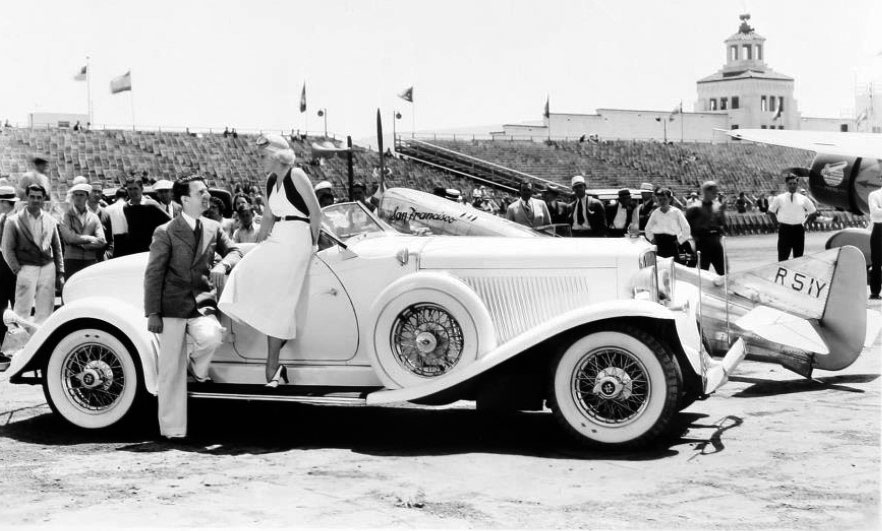 |
|
| (1933)* - Jean Harlow posed on a 1932 Auburn Boat-tailed Speedster along with race organizer Cliff Henderson. The photo was taken at the 1933 National Air Race held at Mines Field, now the site of LAX. |
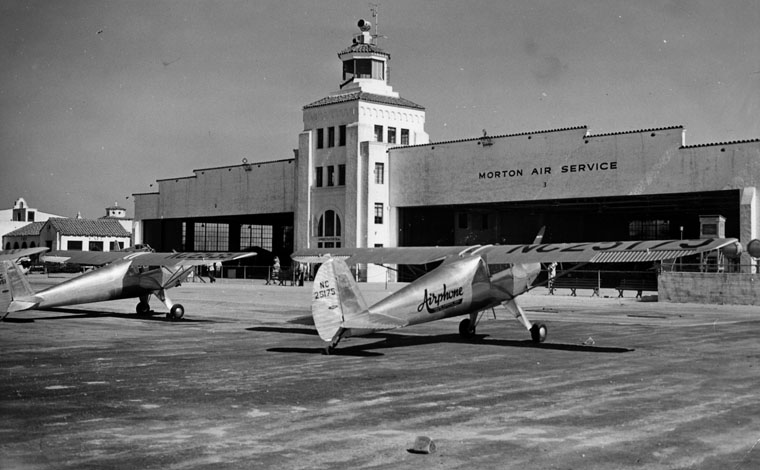 |
|
| (ca. 1930s)* - Two hangars, one with name Morton Air Service above it, at Mines Field. |
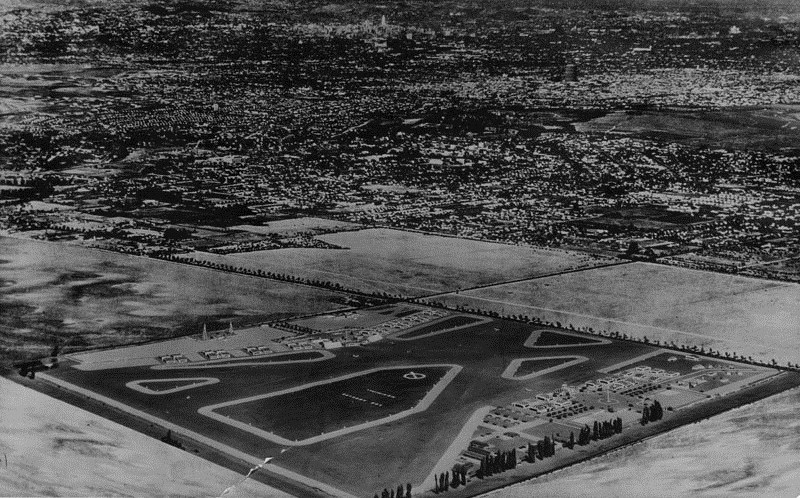 |
|
| (1939)* - Aerial view of Mines Field (Los Angeles Municpal Airport at time of photo). The field was sold to the City of Los Angeles by Wiliam W. Mines in 1937 upon which the name was changed to Los Angeles Municipal Airport |
Historical Notes Despite the city's support and investments, Mines Field, which featured a 2,000-foot runway and hangar space for 40 planes, would not become the region's principal aviation terminus until the 1940s. That distinction was held for nearly two decades by Burbank's Lockheed Field (today, Bob Hope Airport), through which most airlines routed their planes. Other important airports were located in Alhambra, Van Nuys (Metropolitan Airport), Glendale (Grand Central Air Terminal), and the present-day City of Commerce (Vail Field). |
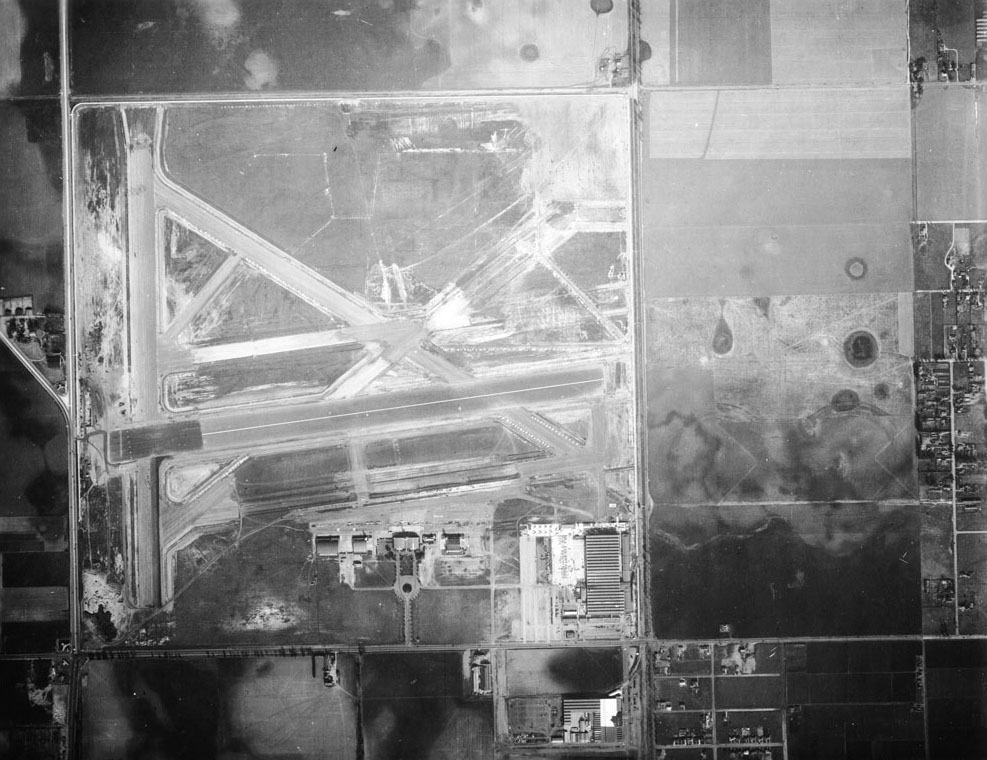 |
|
| (1939)^* - Aerial view of Los Angeles Municipal Airport after the City of Los Angeles purchased it outright. |
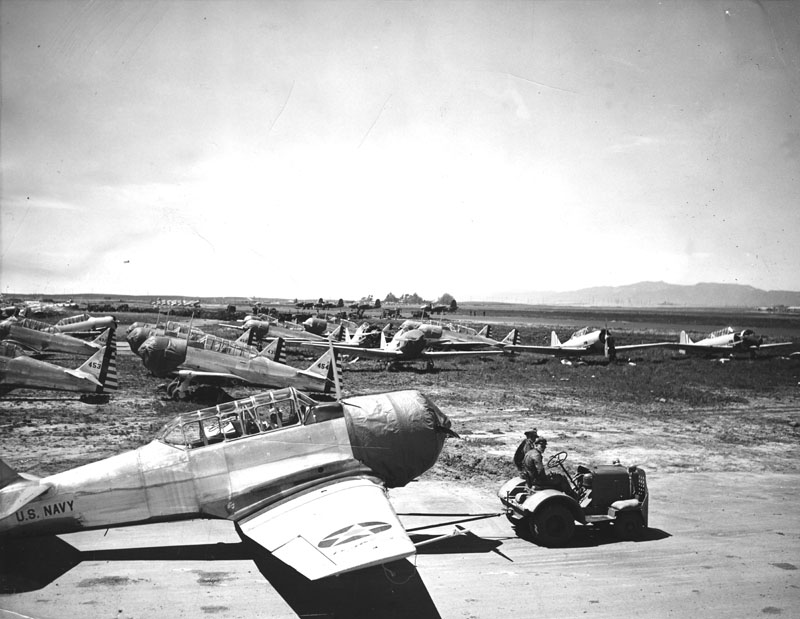 |
|
| (1941)* - This photo of the Municipal Airport, the first to be taken under special permission of the War Department illustrates the necessity of completing the airport project for national defense. The field is overcrowded with new planes. Most of these are United States Navy trainers ready for final tests. At extreme right are two trainers for the British awaiting delivery to Canada. An average of 30 test hops is made daily at the uncompleted airport. |
Historical Notes Los Angeles Municipal Airport (Mines Field), was used extensively during the war by the Army Air Forces, Navy and local aircraft manufacturers, and continued to function as a commercial airport. The Air Transport Command and Air Technical Service Command had operations here and there was also a large military air freight terminal. |
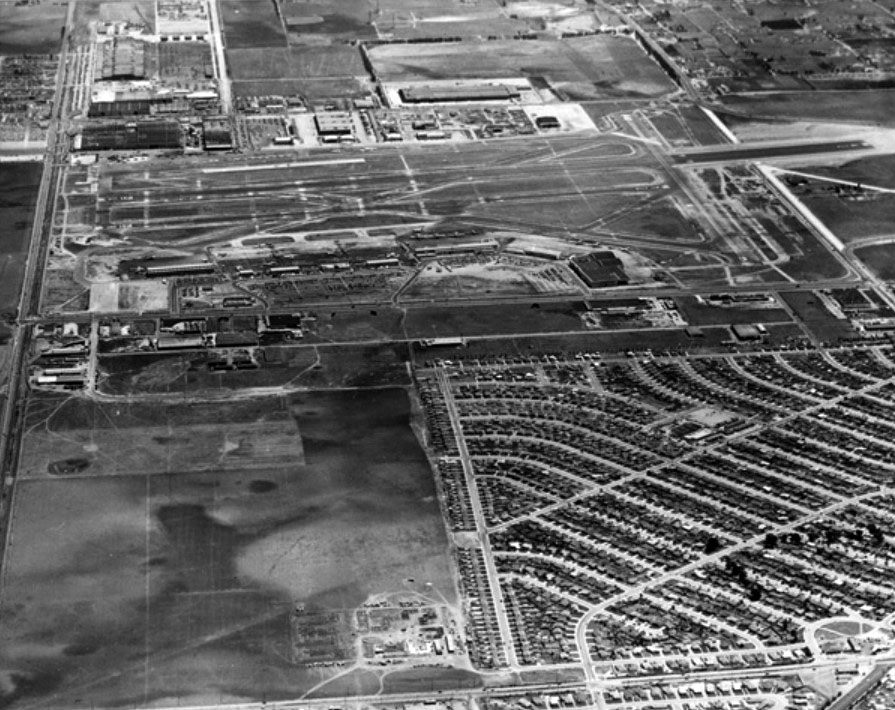 |
|
| (ca. 1946)^* - Aerial view of Los Angeles Municipal Airport shortly after its postwar renovations. |
 |
|
| (1946)*- Early morning panoramic view of scores of jackrabbits watching activities at Los Angeles Municipal Airport, slated to open to major airlines on December 9, 1946. Photo: LA Times Image Archive |
Historical Notes Commercial airline service started at Los Angeles Municipal Airport in December 1946 and on July 10, 1956 Boeing's 707 prototype (the 367-80) visited LAX. The Los Angeles Times said it was its first appearance at a "commercial airport" outside the Seattle area. |
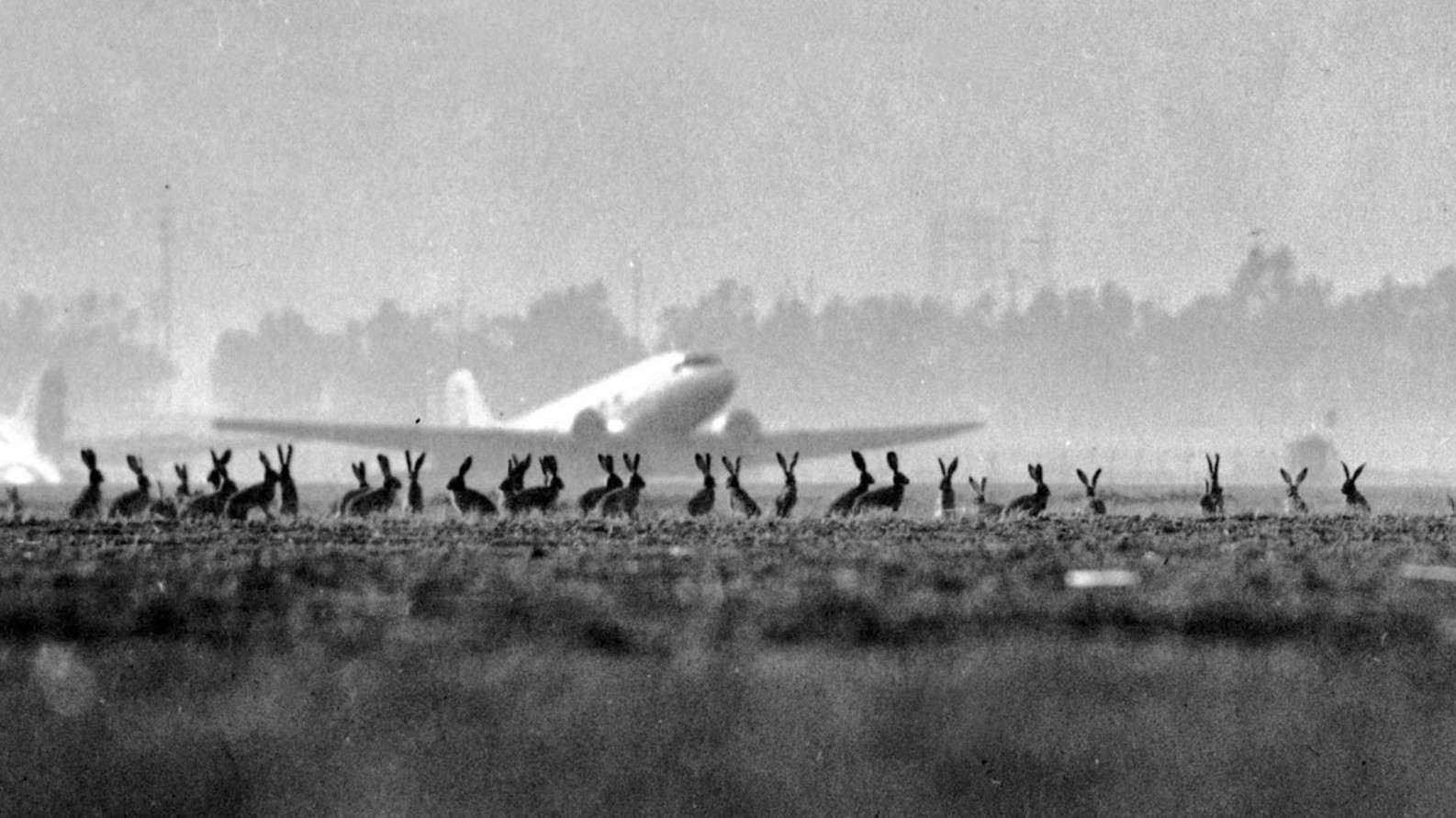 |
|
| (1946)*- Close-up view showing jackrabbits watching activities at Los Angeles Municipal Airport, slated to open to major airlines on December 9, 1946. Photo: LA Times Image Archive |
Historical Notes After the war, four temporary terminals were erected, and major airlines like American Airlines, TWA, United Airlines, and Western Airlines began passenger operations. The airport was renamed Los Angeles International Airport in 1949. |
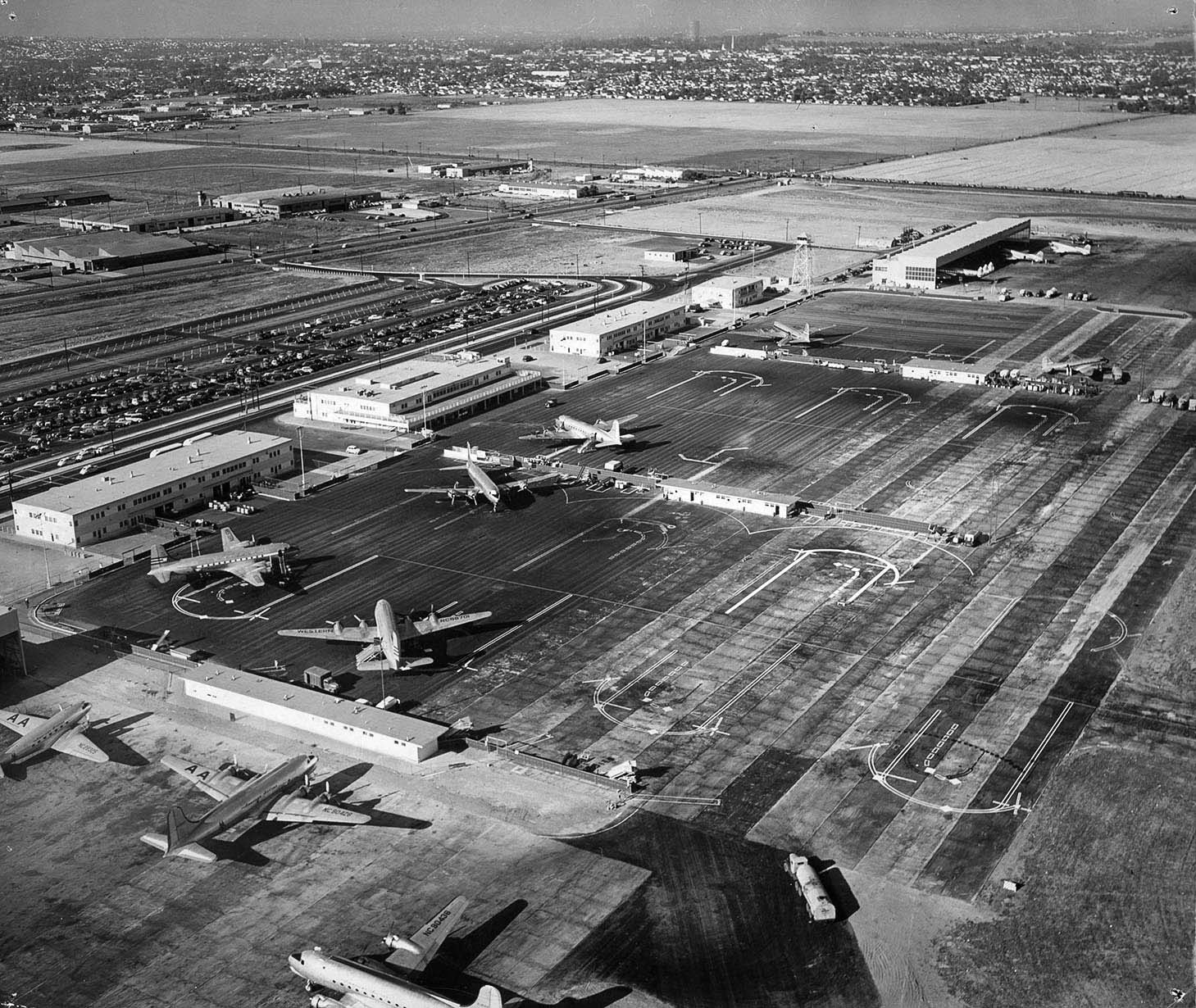 |
|
| (1947)* - Aerial view of Los Angeles Municipal Airport less than one year after commercial airline service began. |
Historical Notes Photo caption, dated Oct. 10, 1947, reads: The main passenger concourse is served by three modern terminal buildings. Six major airlines are operating at the airport, with passenger volume exceeding 100,000 a month. |
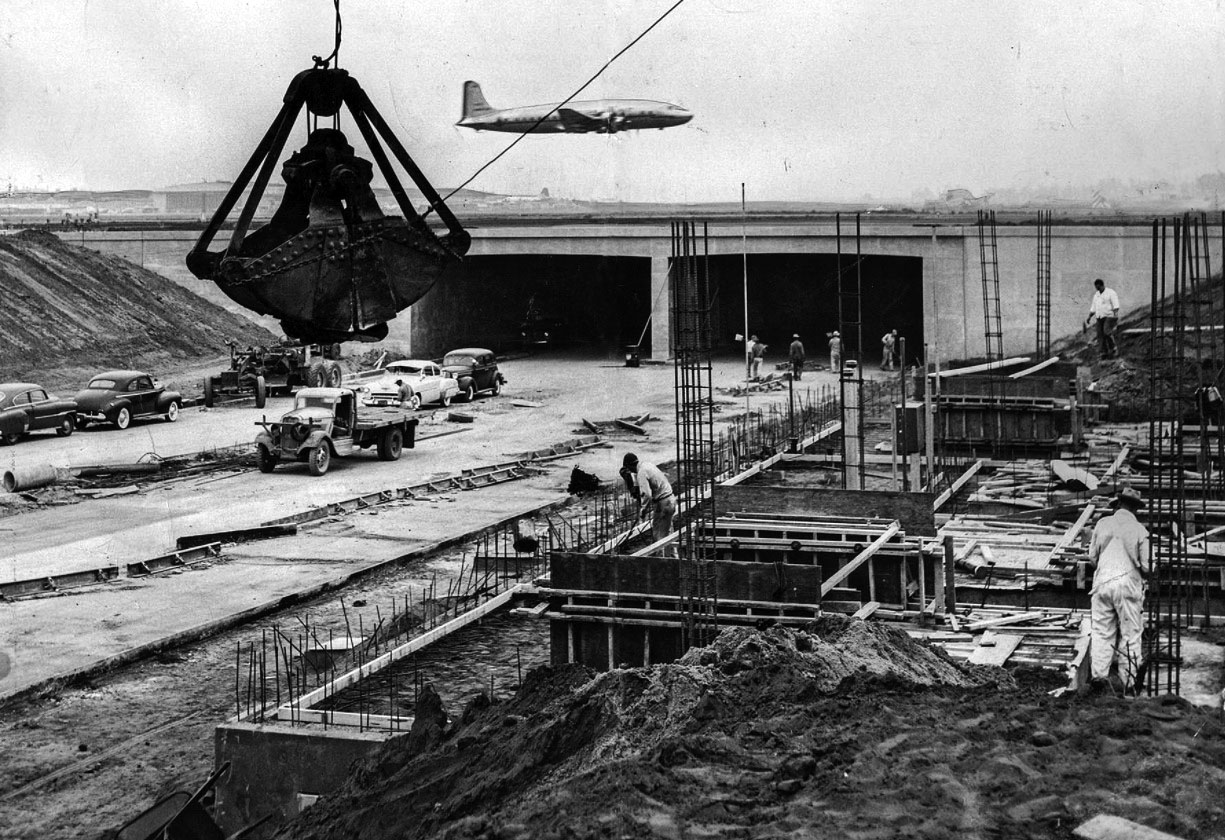 |
|
| (1952)* - Construction of the north portal of the Sepulveda Boulevard tunnel underneath Los Angeles International Airport. |
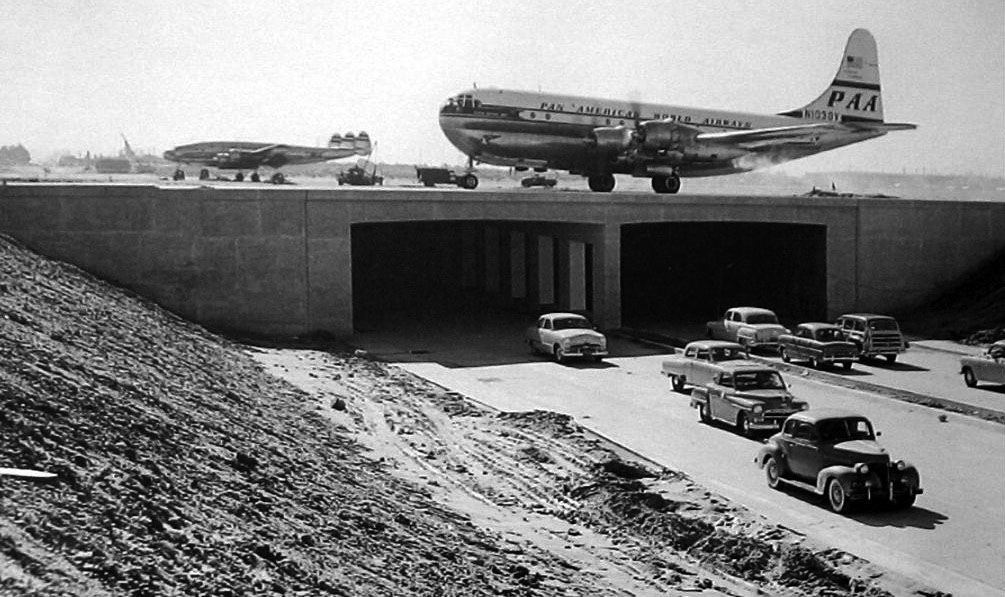 |
|
| (1953)* - A Pan American Airlines Stratocruiser maneuvering over the newly constructed Sepulveda Tunnel at LAX in 1953. To its left is the Lockheed Constellation, preferred by TWA at the time. |
Historical Notes Mines Field did not extend west of Sepulveda Boulevard. Sepulveda was rerouted circa 1950 to loop around the west ends of the extended east–west runways (now runways 25L and 25R), which by November 1950 were 6,000 feet long. A tunnel was completed in 1953 allowing Sepulveda Boulevard to revert to straight and pass beneath the two runways; it was the first tunnel of its kind. For the next few years the two runways were 8,500 feet long. |
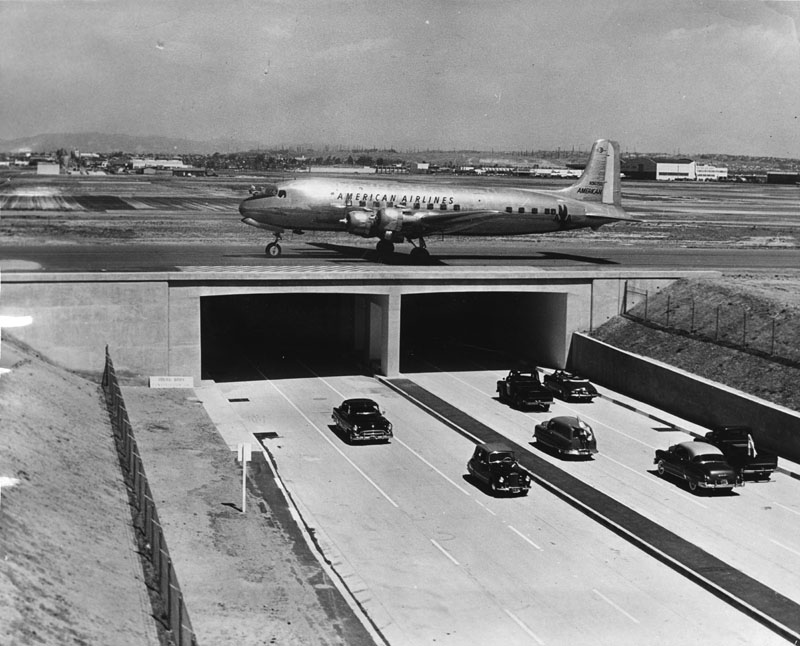 |
|
| (1953)* - Cars and trucks go through Sepulveda Airport Underpass in a final testing prior to the opening of the $3,500,000 tunnel. |
Historical Notes At the time of its completion in March 1953, the six-lane, 1909-foot-long divided tunnel was the only traffic tunnel under a large airport runway in the United States. The tunnel’s grand opening was held on April 21, 1953. L.A. Mayor Fletcher Bowron cut the ribbon (presumably with one of those giant pairs of scissors), and the LAPD band provided entertainment during the ceremony. After the first 100 cars traveled through the tunnel, their drivers received mementoes of the aviation industry from stewardesses (flight attendants) who were stationed at the intersections of Sepulveda with Imperial Highway and Century Boulevard. |
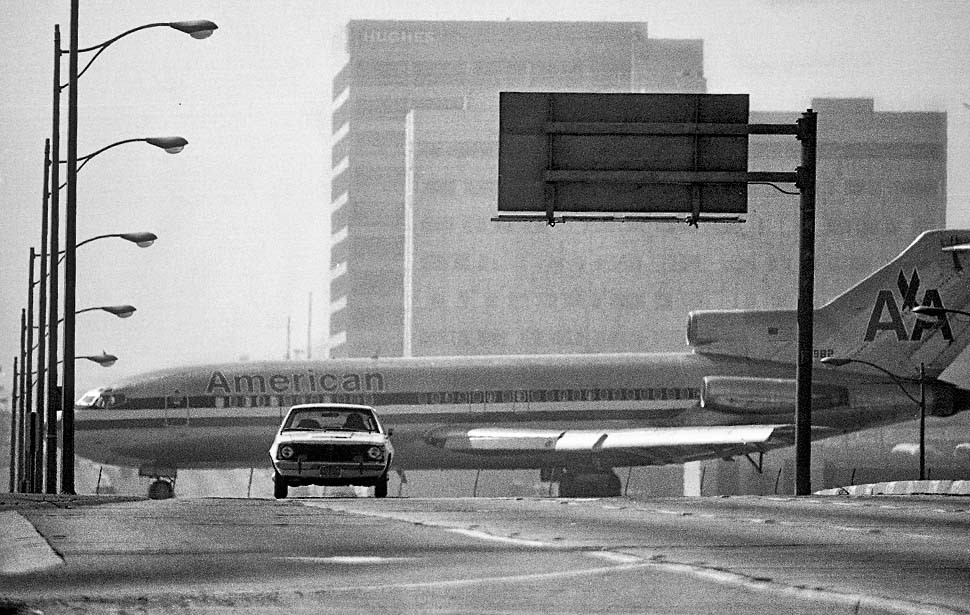 |
|
| (1976)* - View looking north on Sepulveda using a long telephoto lens showing an American Airlines jet crossing over the Sepulveda Tunnel - making for a good optical illusion. Photo by Rick Meyer |
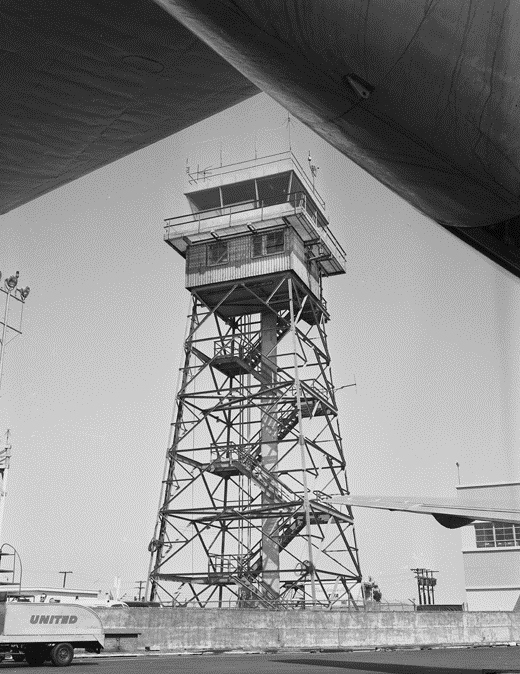 |
|
| (1956)* - View of the control tower at Los Angeles International Airport. |
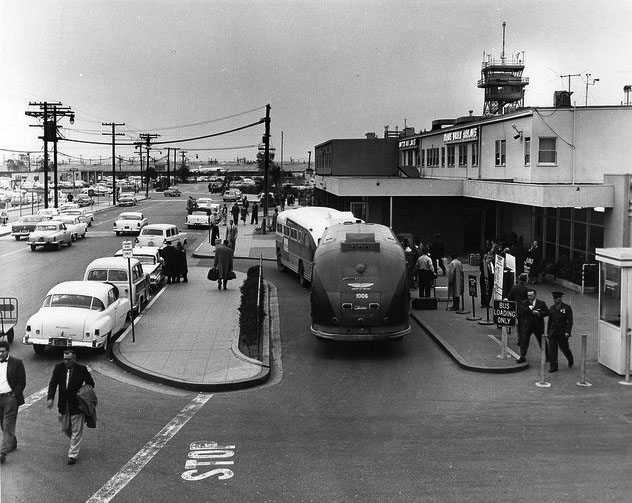 |
|
| (1950s)* - View showing the bus loading lane in front of the terminal at LAX with control tower in the background. |
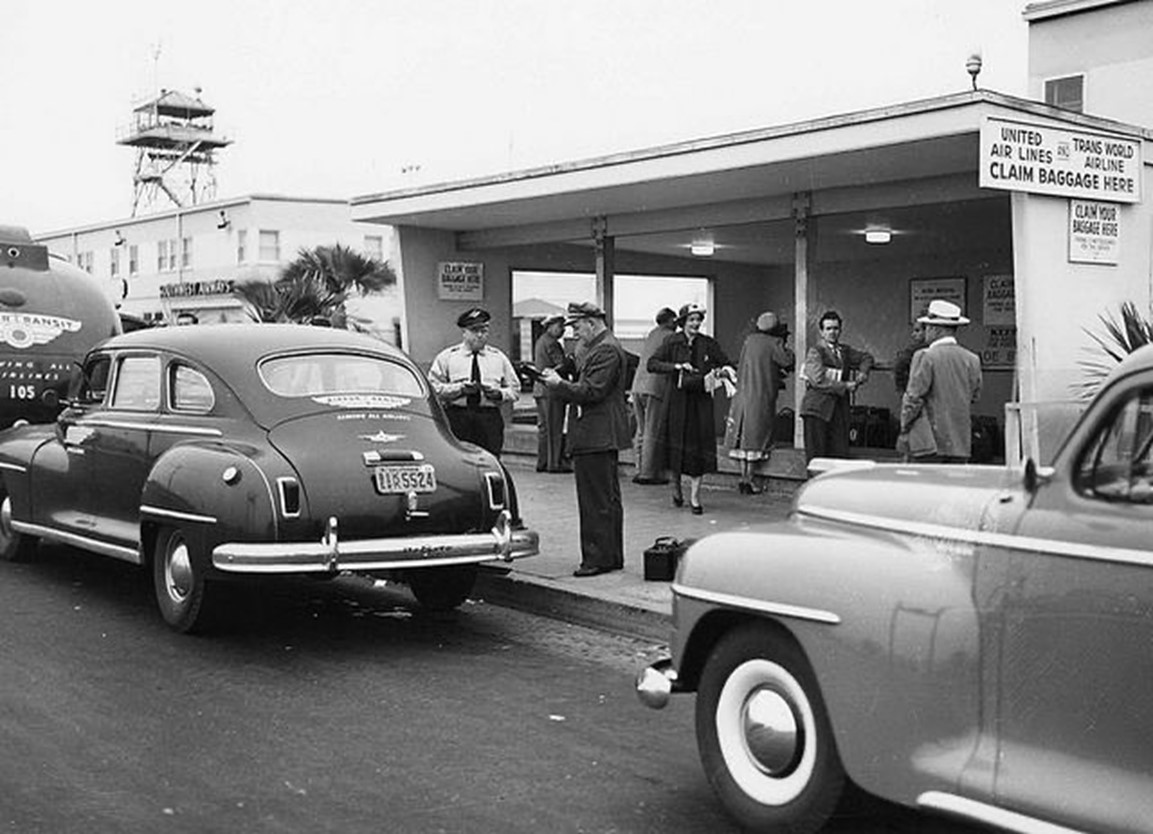 |
|
| (1950s)* – Baggage claim area for United Air Lines and Trans World Airlines at LAX with control tower seen in the backgrund. |
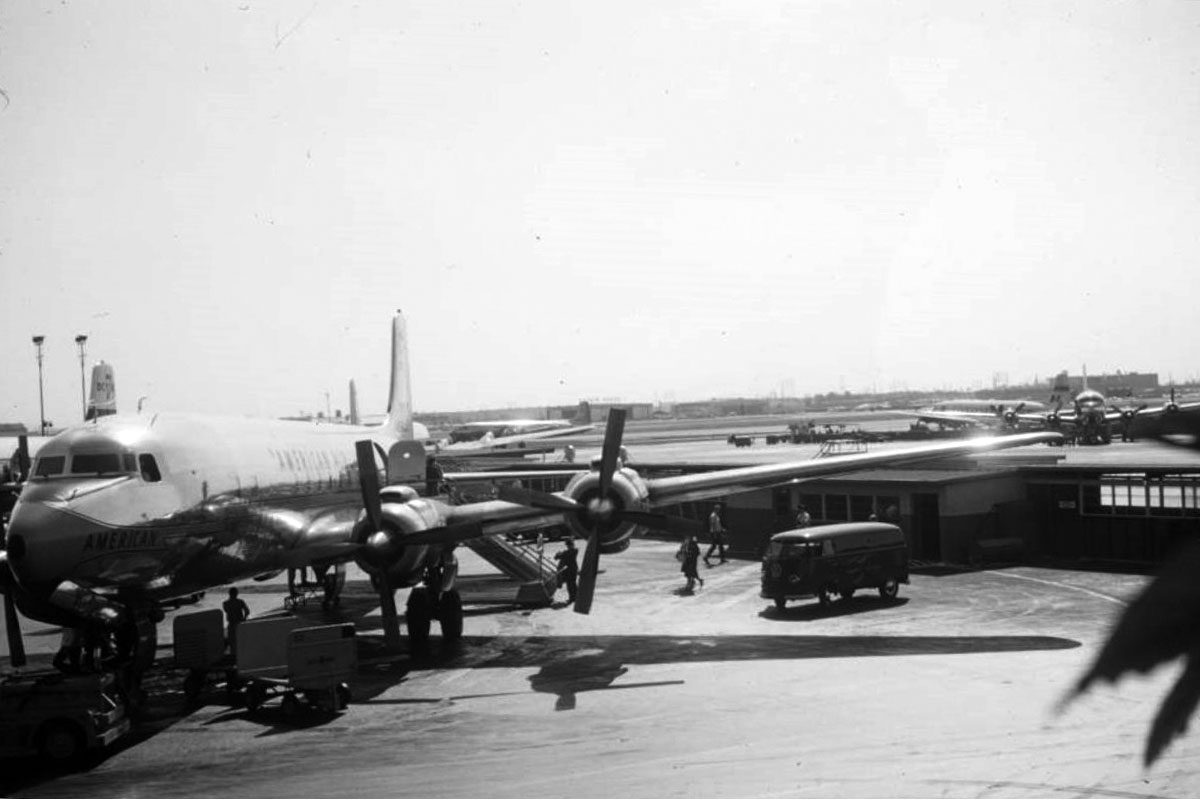 |
|
| (1957)* - View showing passengers boarding an American Airlines DC-7 aircraft at Los Angeles Airport. This is the Flagship Wisconsin, fleet number 323 on the nose landing gear door. A Volkwagen panel van is to the right. |
Historical Notes The Douglas DC-7 was built by the Douglas Aircraft Company from 1953 to 1958. It was the last major piston-engine powered transport made by Douglas, coming just a few years before the advent of jet aircraft such as the Boeing 707 and Douglas DC-8. |
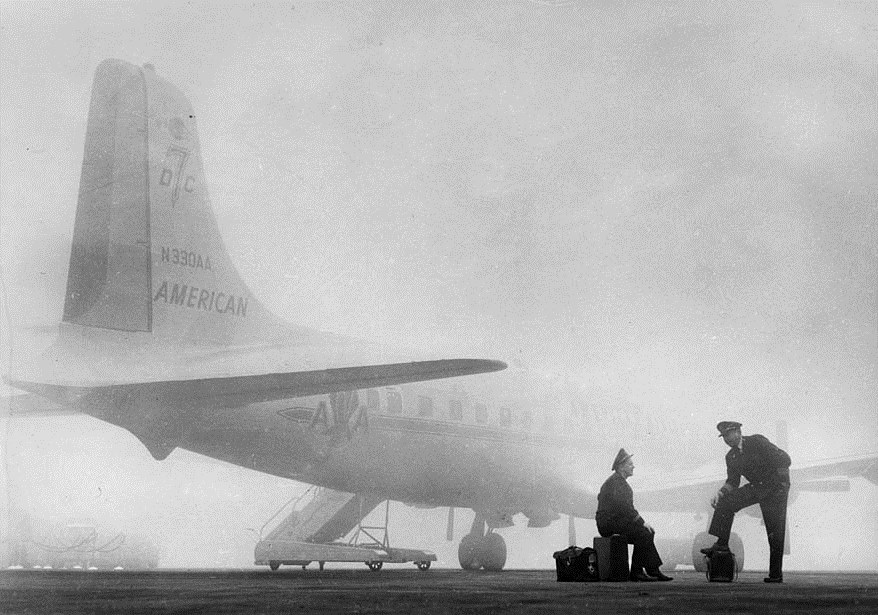 |
|
| (1958)* - LAX fogged in. American Airlines flight engineer Frank Nusser, left, and Capt. Don Young wait by their aircraft for fog to lift at Los Angeles International Airport. Photo by John Malmin; LA Times Image Archives |
Historical Notes In 1958 the architecture firm Pereira & Luckman was contracted to design a master plan for the complete re-design of the airport in anticipation of the "jet age." The plan, developed along with architects Welton Becket and Paul Williams, called for a massive series of terminals and parking structures to be built in the central portion of the property, with these buildings connected at the center by a huge steel-and-glass dome. The plan was never realized, and shortly thereafter the Theme Building was constructed on the site originally intended for the dome.*^ |
The New 'Jet Age' LAX
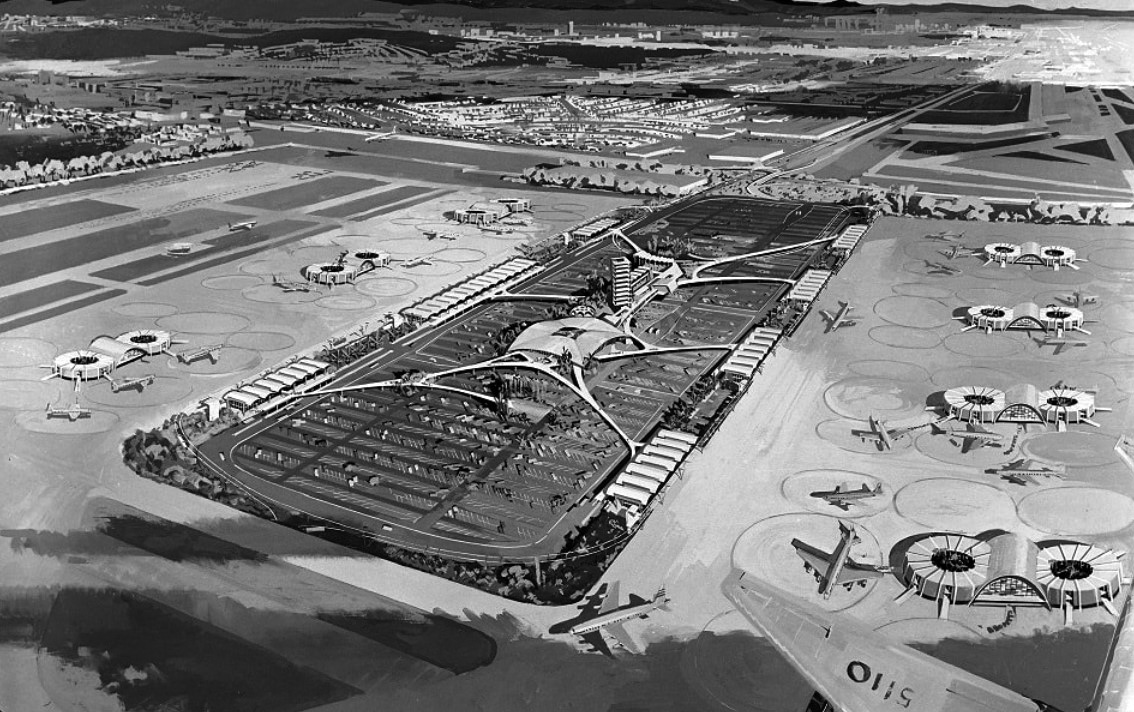 |
|
| (1958)* – Artist’s impression showing the future terminal area of LAX. Credit: LAX Photo Archives |
Historical Notes Designed by a joint venture of Pereira & Luckman, Welton Becket and Associates, and Paul R. Williams, the plan called for a series of terminals organized around a central parking area. Each terminal had a satellite building out in the middle of the ramp, reached by underground tunnels from the ticketing area. The original scheme depicted above featured a system of trains connecting the terminals, which was later scrapped. The complex was designed to handle 23 million passengers by 1970. The total development cost at the time was $70 million. |
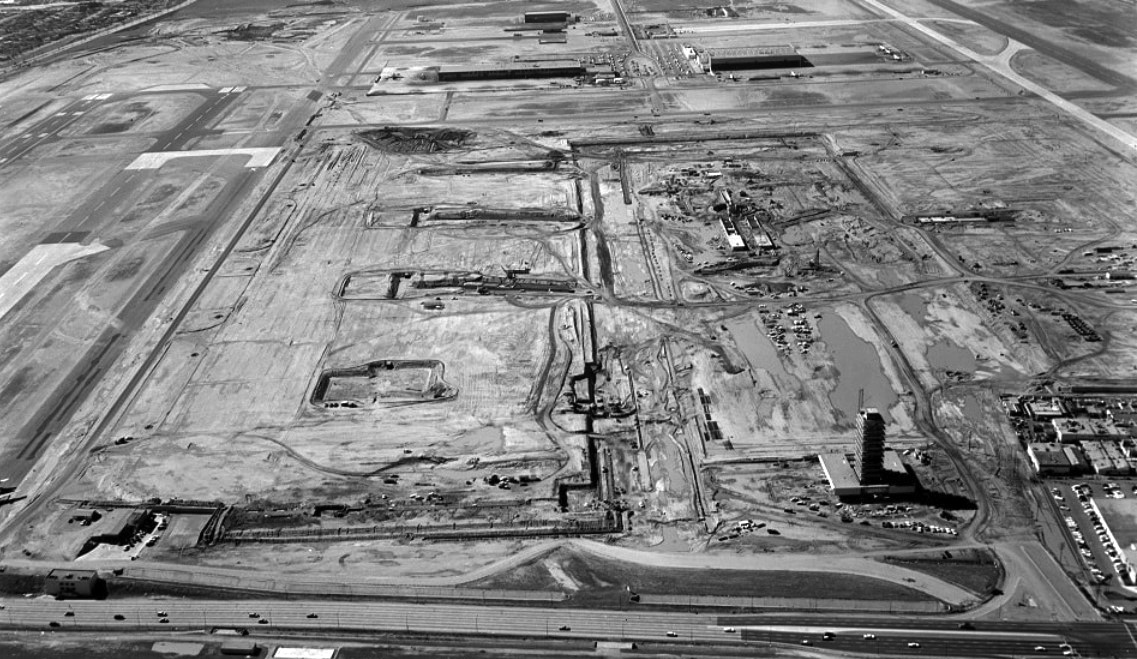 |
|
| (1960)^ – Aerial view looking west showing groundwork for the new passenger terminal area. The Control Tower (foreground) has already been completed. Sepulveda Boulevard runs horizontally at bottom of photo. Credit LAX Photo Archives via The Airport History.org Collection |
Historical Notes The trenches in the center of the image will eventually contain the tunnels that connect the ticketing buildings to the satellites. |
.jpg) |
|
| (1960)* - Control Tower (1) rises to its height of 172 feet as foundation of ticketing building (2) takes shape. Site preparation is 90 per cent complete two months ahead of schedule. Herald Examiner progress picture at L.A.'s air terminal site. |
Historical Notes The original plan called for a series of terminals and parking structures in the central portion of the property, with these buildings connected at the center by a huge steel-and-glass dome. The dome was never built, and the Theme Building was built on the site intended for the dome.^ |
.jpg) |
|
| (1960)^ - Aerial view looking east showing the construction of satellites #4, #5 and #7. Construction of the legendary Space Age Theme Building in the upper left is also progressing well. Photo Date: November, 1960. Credit LAX Photo Archives via The Airport History.org Collection |
Historical Notes In the new terminal area west of Sepulveda Blvd that started opening in 1961, each terminal had a satellite building out in the middle of the ramp, reached by underground tunnels from the ticketing area. United's satellites 7 and 8 were first to open, followed by TWA's terminal 3, American's terminal 4 and Western's terminal 5. Satellite 2 opened as the international terminal several months later, and satellite 6, a "consolidated" terminal for other domestic carriers, was to be the last to open. By 1964 the airport had international service by Aeronaves, Air France, JAL, TWA, UTA, Varig and Western in addition to Mexicana, Pan Am and SAS.^ |
Theme Building
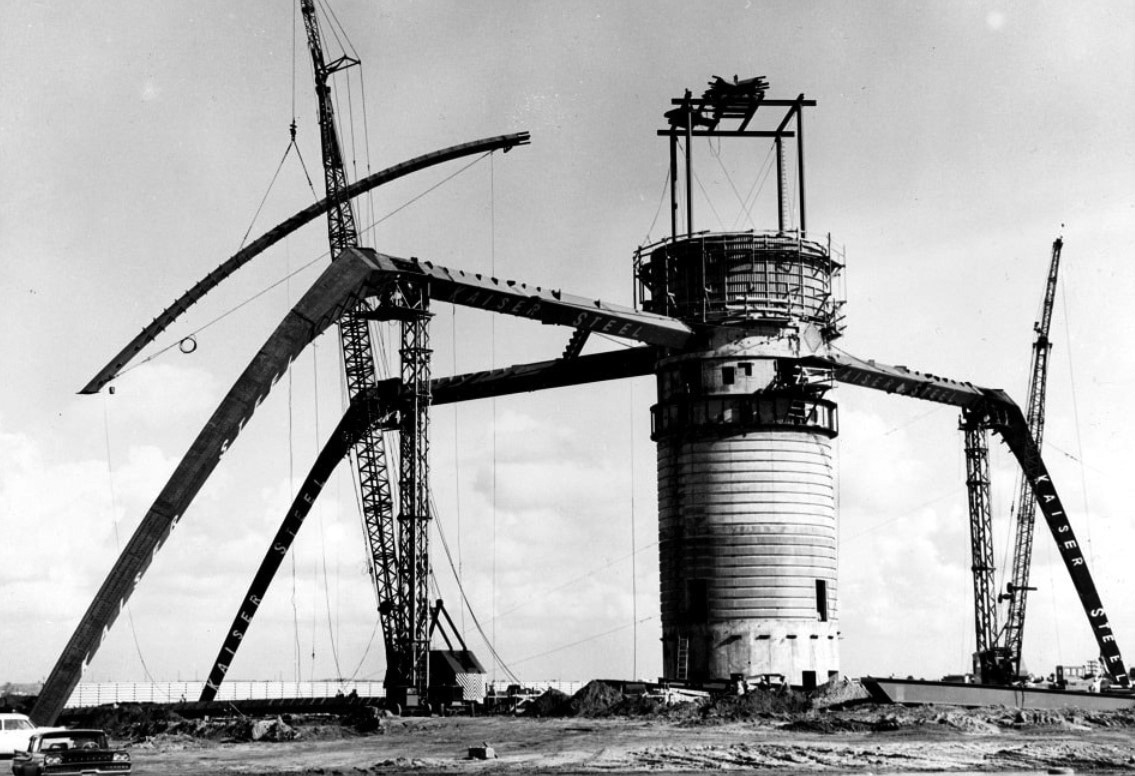 |
|
| (1960)^ - View showing the Theme Building under construction. Credit LAX Photo Archives via The Airport History.org Collection |
Historical Notes The modern parobolic arches of the Theme Building would dominate the center of the terminal area, with four “legs” rising 135 feet from the ground and 340 feet across the base. It would contain a restaurant and observation deck, with an employee cafeteria at ground level. |
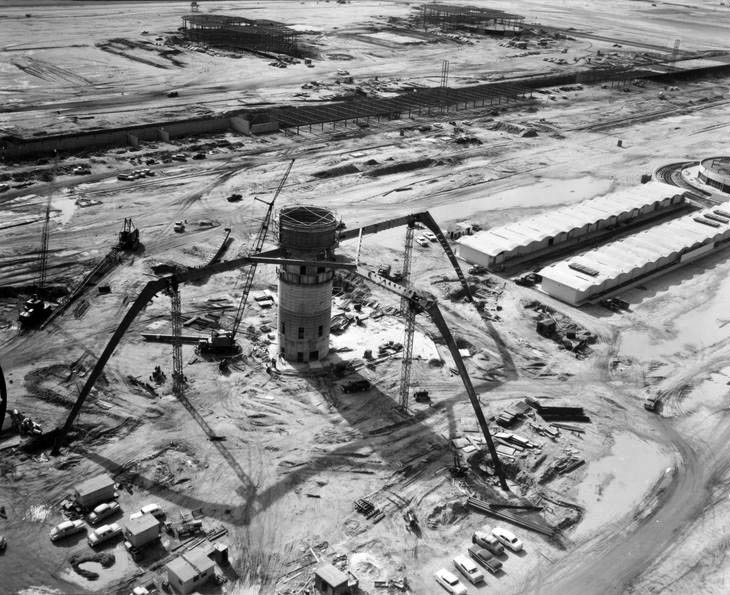 |
|
| (1960)*** – Aerial view showing LAX under construction with the Theme Building in the foreground and two terminal buildings in the distance. |
Historical Notes The distinctive white googie "Theme Building", designed by Pereira & Luckman architect Paul Williams and constructed in 1960/1961 by Robert E. McKee Construction Co., resembles a flying saucer that has landed on its four legs. |
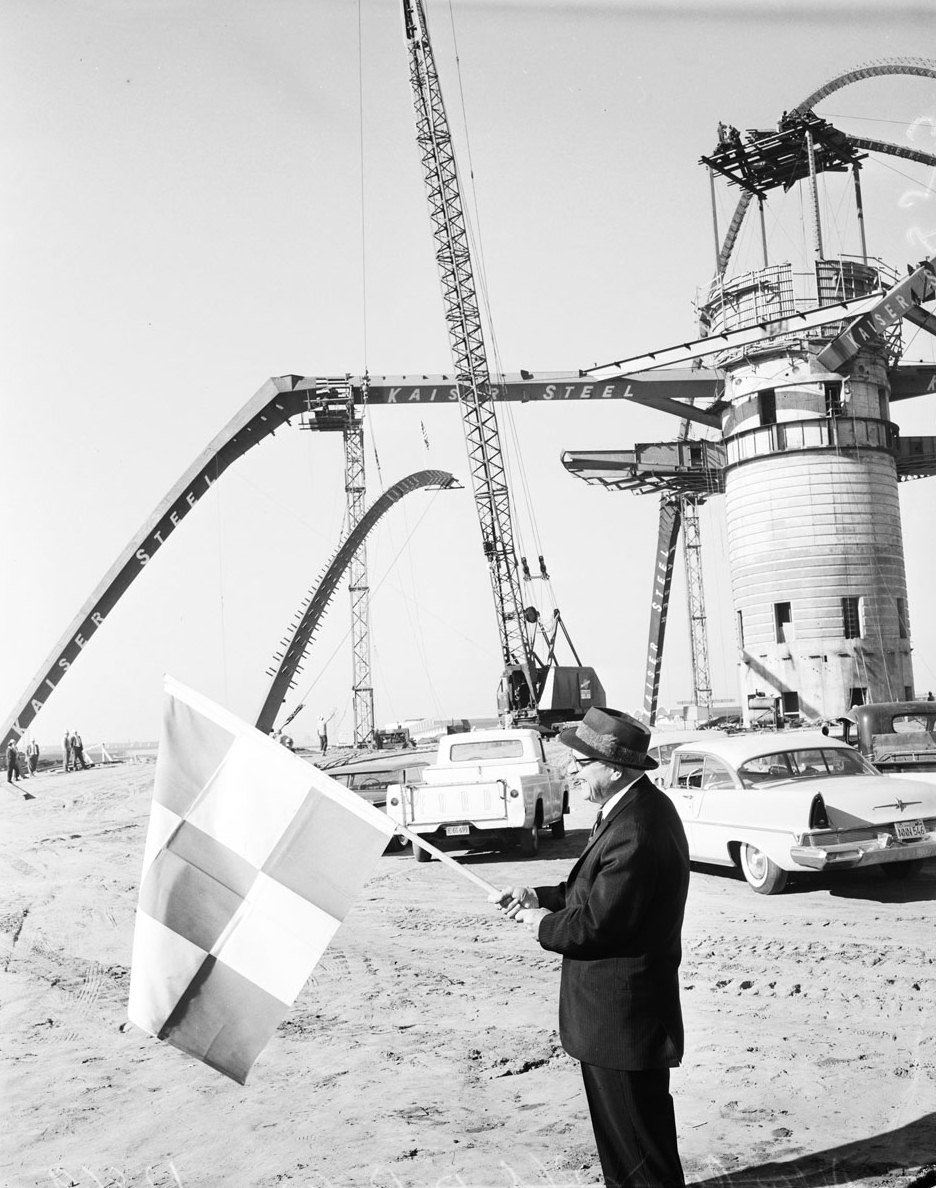 |
|
| (1960)* - Close-up view showing the Theme Building under construction in 1960. Airport Commission president Don Belding waves a flag in the foreground. |
Historical Notes The Theme Building became an iconic landmark structure at the LAX. It opened in 1961, and is an example of the Mid-Century modern influenced design school known as "Googie" or "Populuxe”. |
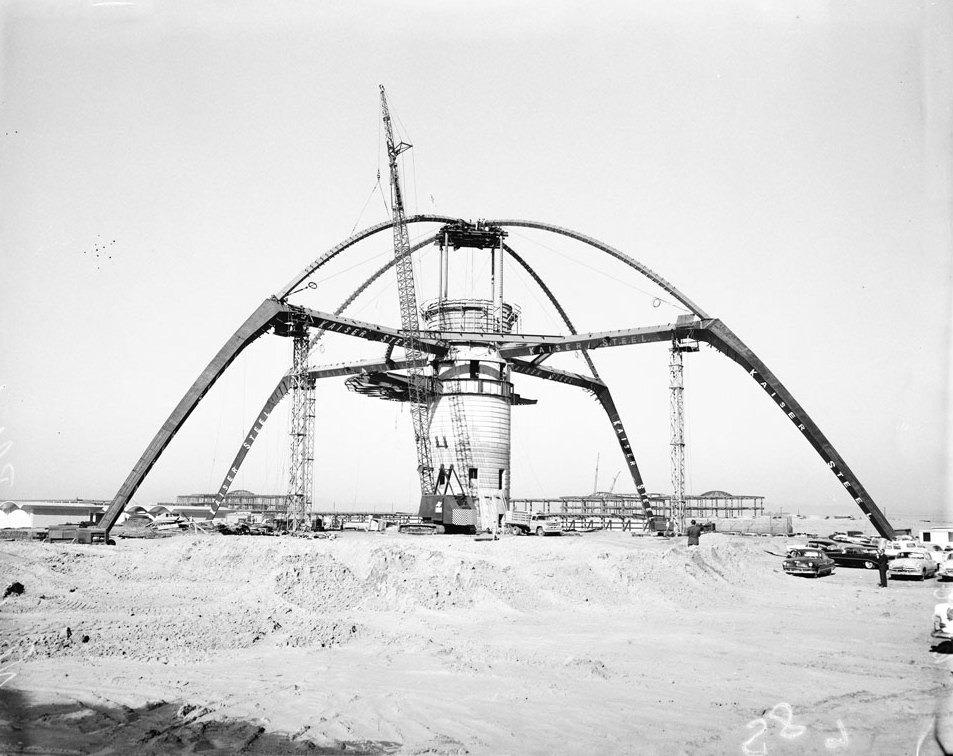 |
|
| (1960)* - View of the new 'Theme Building' as last steel girder is put in place. |
Historical Notes The original design for the airport created by Pereira & Luckman in 1959 had all the terminal buildings and parking structures connected to a huge glass dome, which would serve as a central hub for traffic circulation. The plan was eventually scaled down considerably and the terminals were constructed elsewhere on the property. The Theme Building was subsequently built to mark the spot intended for the dome structure, as a reminder of the original plan. |
 |
|
| (ca. 1961)*- Structural steel and scaffolding, Theme Building LAX. Courtesy of LAX Photo Archives, LAX Flight Path Museum |
Historical Notes The appearance of the building as a single homogenous structure is a cleverly constructed illusion. The building's two crossed arches actually consist of four steel-reinforced concrete legs that extend approximately 15' above the ground, and a hollow, stucco-covered steel truss constituting the remaining lower arches and entire upper arches. To avoid changing the appearance of the structure with overt reinforcement, the Theme Building was retrofitted with a tuned mass damper to counteract earthquake movements.*^ |
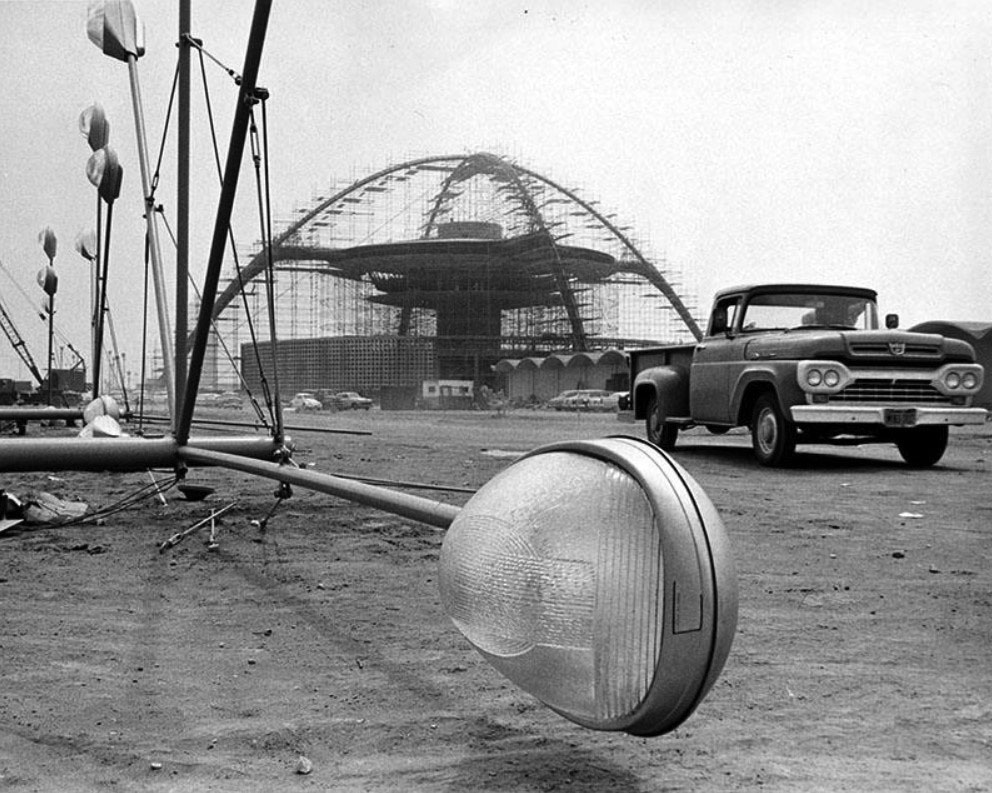 |
|
| (1961)* - New streetlights being assembled in the foreground as construction continues on the Theme Building. Click HERE to see more in Early Los Angeles Streetlights. Photo by John Woods - LAPL |
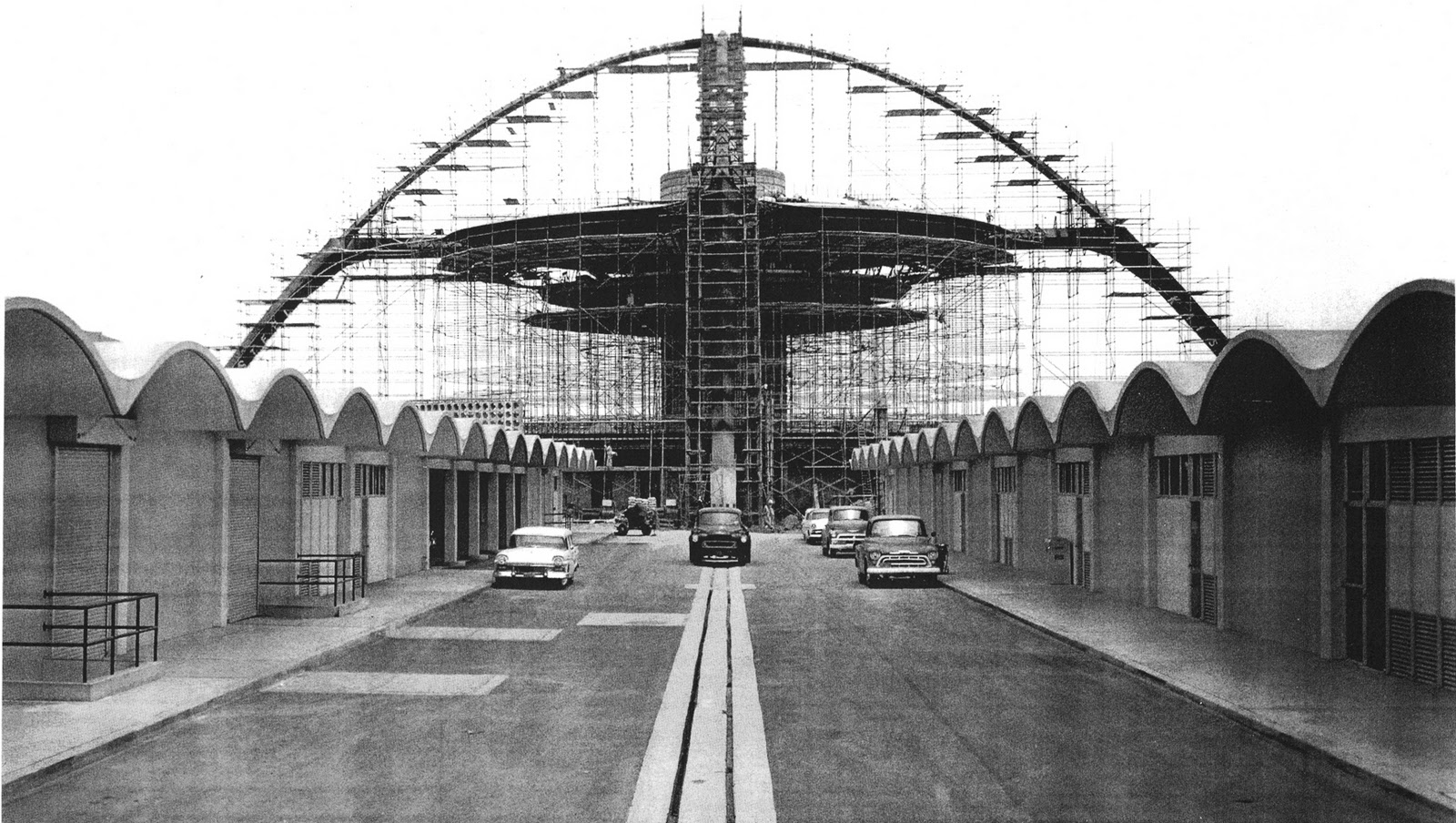 |
|
| (ca. 1961)*** - Maintenance garages and Theme Building LAX |
 |
|
| (ca. 1961)*** - LAX Theme Building. Photo: Julius Shulman / Getty Research Institute |
Hitorical Notes The distinctive white building resembles a flying saucer that has landed on its four legs. It was designed by a team of architects and engineers headed by William Pereira and Charles Luckman, that also included Paul Williams and Welton Becket. The initial design of the building was created by James Langenheim, of Pereira & Luckman. |
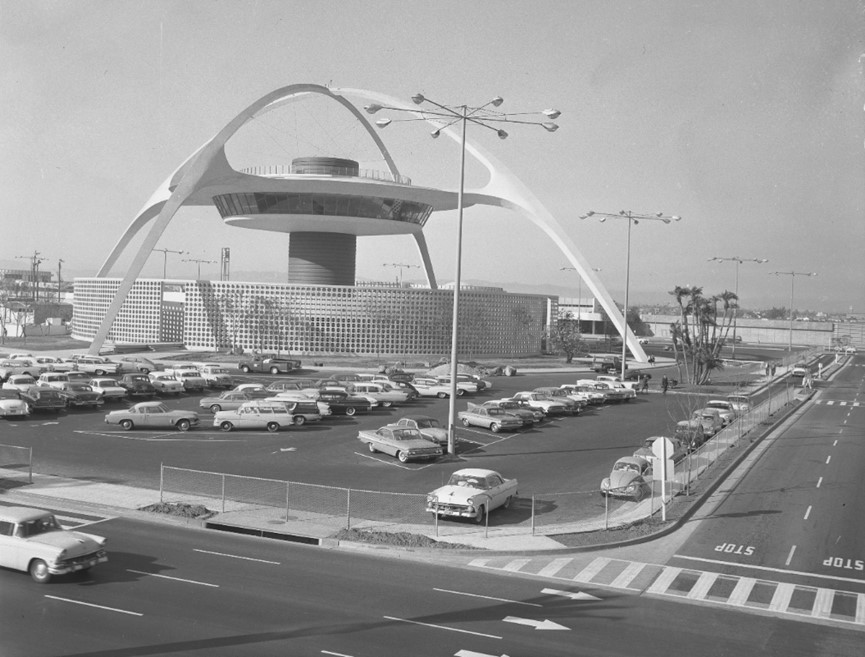 |
|
| (1962)* - View of the Theme Building and its parking lot. Note the stylish multi-head streetlights surrounding the building. Click HERE to see more in Early Los Angeles Streetlights. UCLA Library Digital Collections |
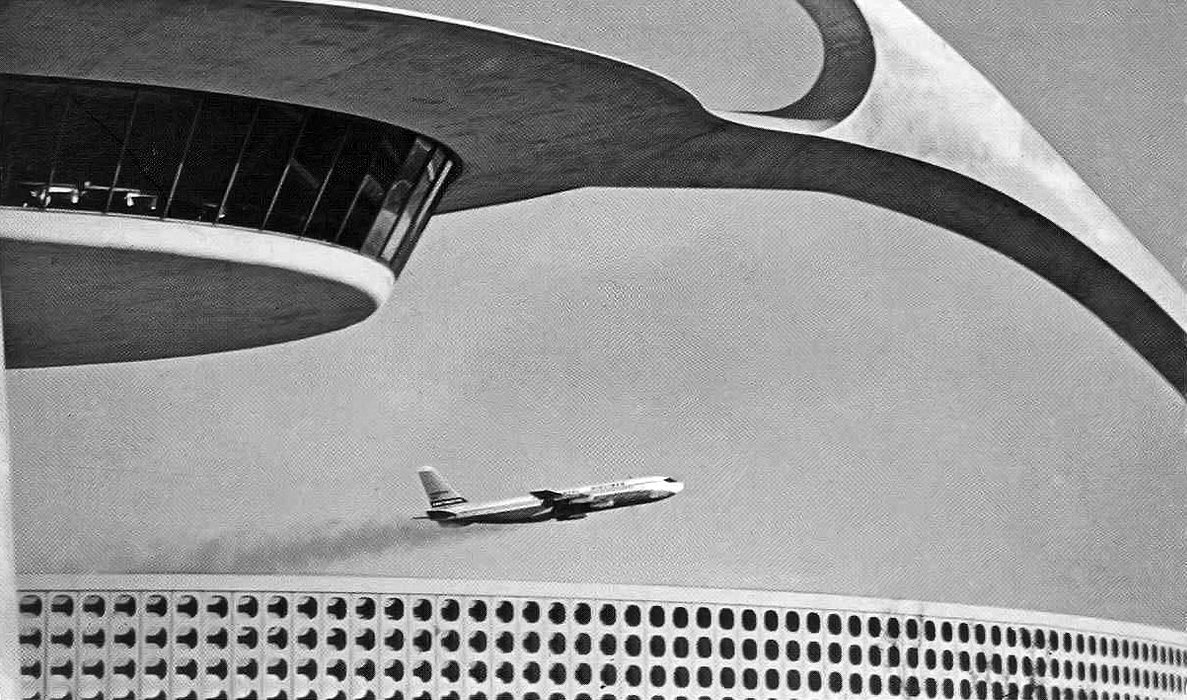 |
|
| (1960s)^ – Postcard view of the Theme Building with Continental 707 taking off in the background. Photo courtesy of Vintage Airlines |
* * * * * |
LAX Control Tower
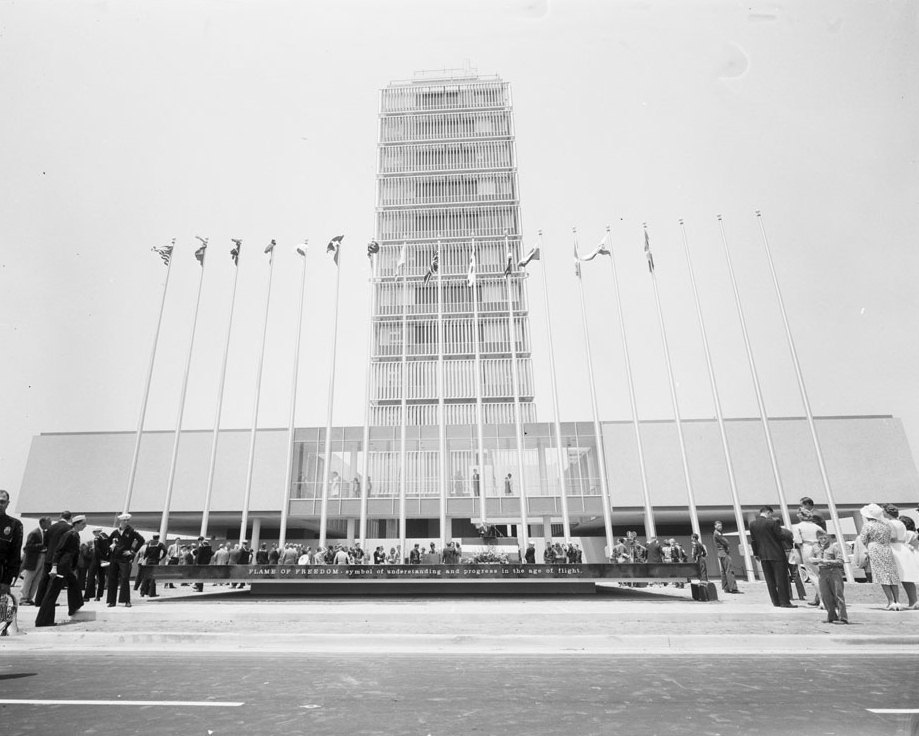 |
|
| (1961)^* - Dedication of new International Airport for jets, June 22, 1961. |
Historical Notes The control tower as seen above served as the Los Angeles Airport's main control tower until April 1996 when it was replaced by the new LAX Control Tower. The old tower is currently being used as LAX offices. |
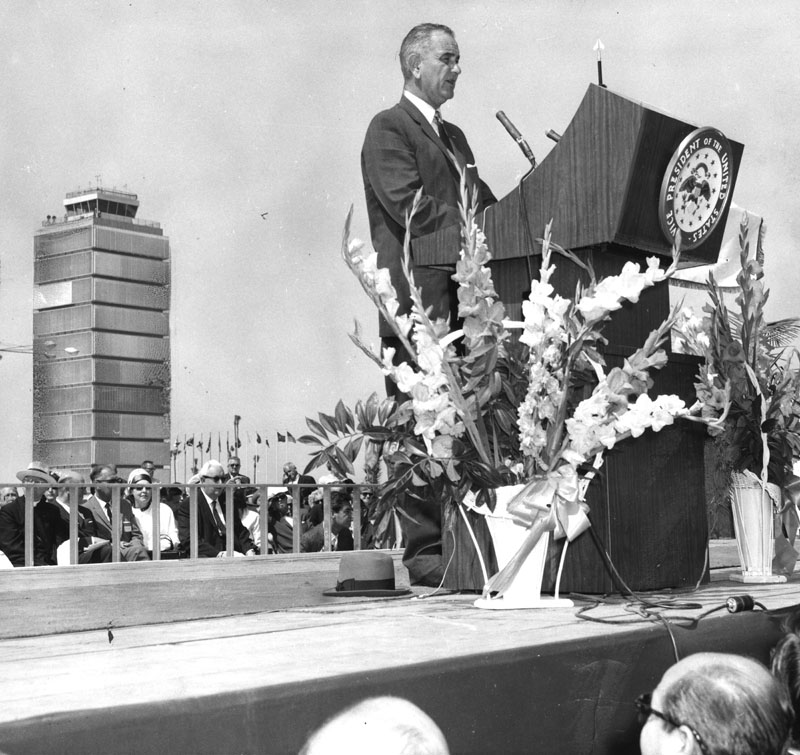 |
|
| (1961)* - Photo of then Vice President Lyndon B. Johnson speaking at the new jet age terminal dedicated June 25, 1961. Control tower rises in the background. |
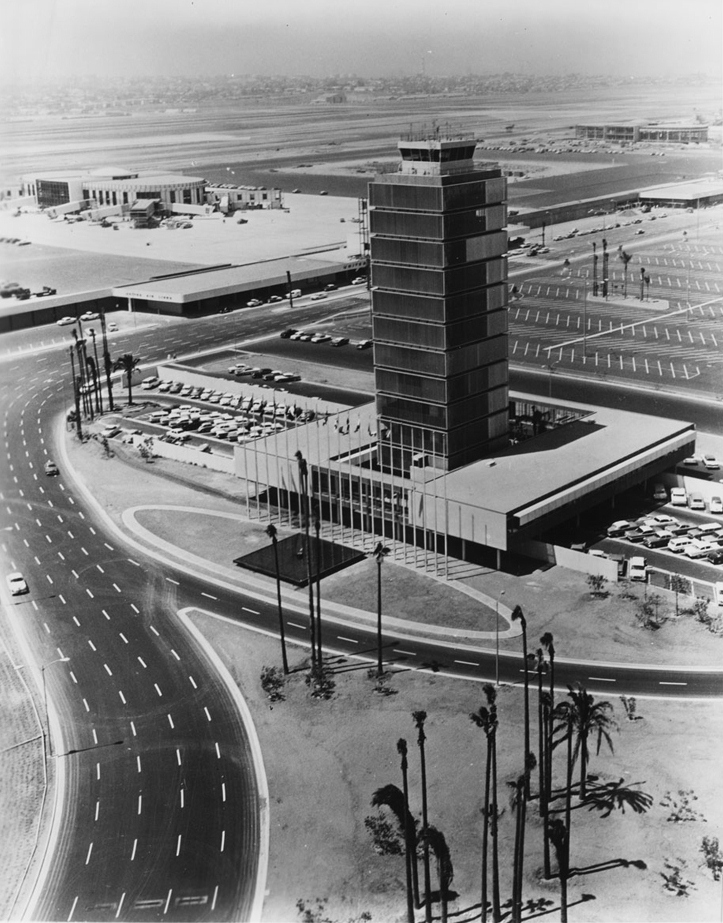 |
|
| (1961)* - Photograph of an aerial view of the control tower administration building at the new jet age terminal at Los Angeles International Airport, in September 1961. USC Digital Library |
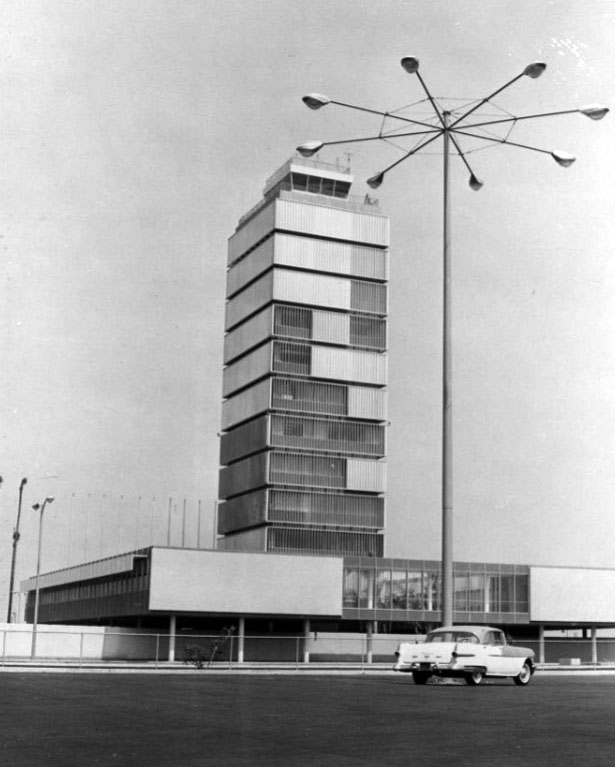 |
|
| (1961)* – View showing the control tower administration building at LAX. Also seen is a 57’ tall, 8-lamp, mercury-vapor streetlight in the parking lot. |
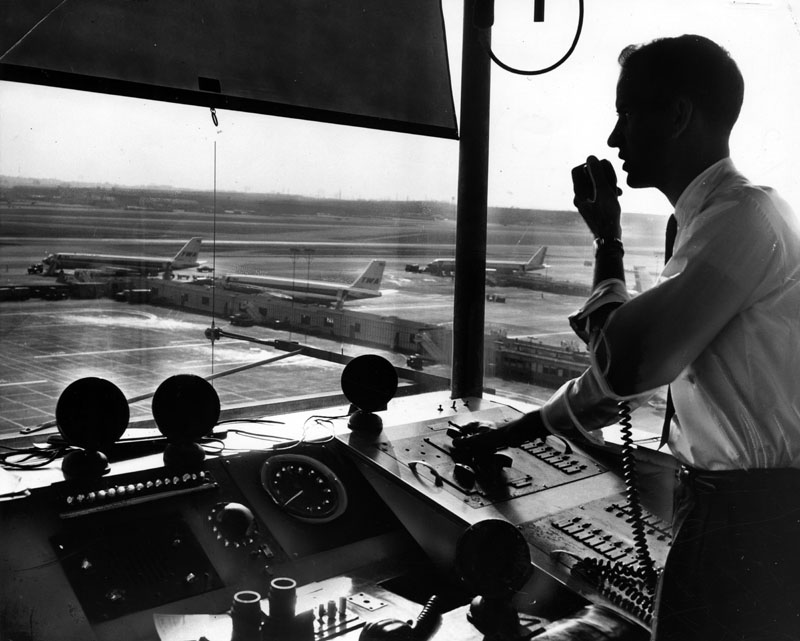 |
|
| (1961)* - An air traffic controller at work inside the control tower at Los Angeles international Airport. Two Trans World Airlines (TWA) planes can be seen in the background. Los Angeles Examiner Collection - LAPL |
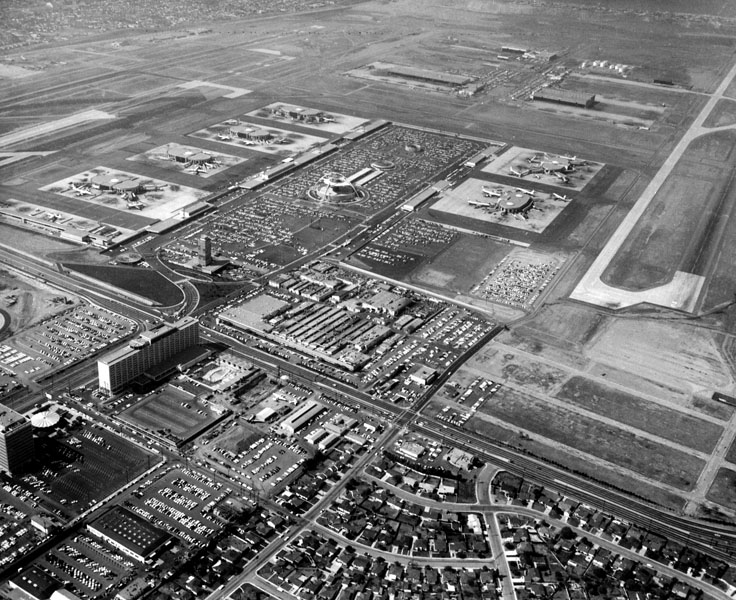 |
|
| (1962)* - Aerial view of the Los Angeles International Airport. |
Historical Notes The present terminal complex was constructed in 1961. In the early 1980s, LAX added domestic and international terminals and a second-level roadway. |
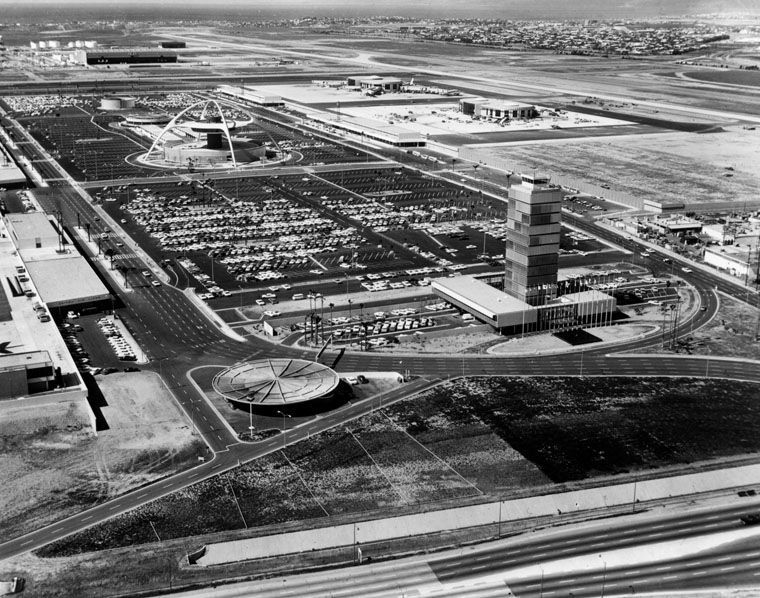 |
|
| (1962)* - Aerial view of Los Angeles International Airport. LAPL |
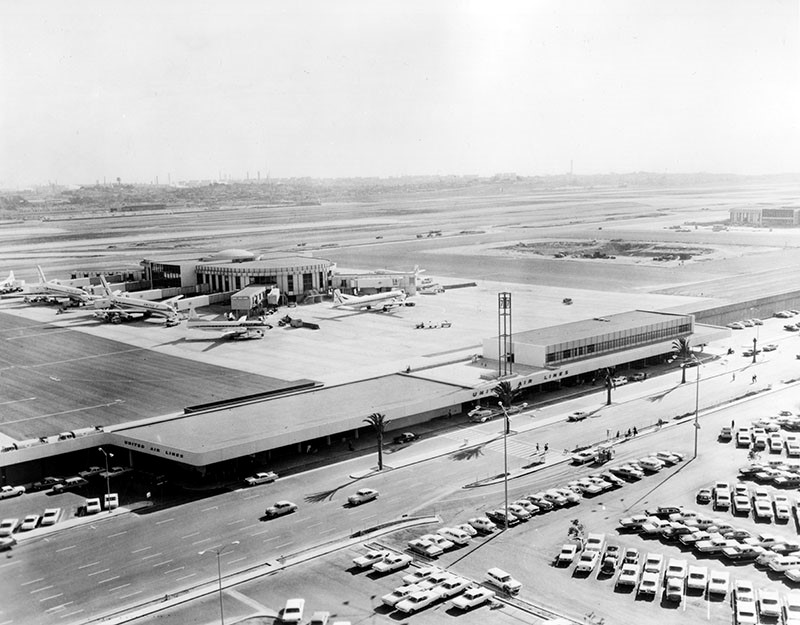 |
|
| (1963)* - Photograph caption dated January 29, 1963 reads, "Los Angeles jet age airport - Control tower and satellite terminal, left to be previewed." Photo by John Woods - Valley Times Photo Collection |
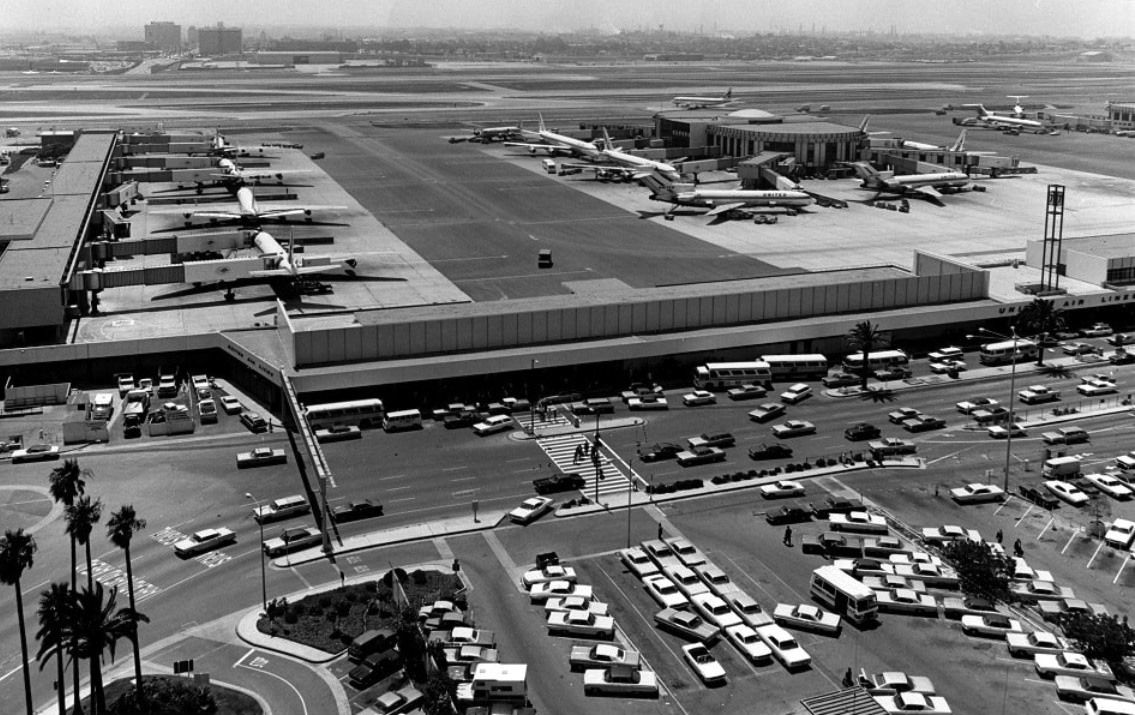 |
|
| (1968)^ – View looking down at Terminal 7 (upper-right) as seen from the air traffic control tower. By now Boeing 727s have entered the scene. This images also includes Building 8 to the left which was a conventional concourse and part of United’s complex. The curbside has become a lot busier than in previous years. Photo courtesy of AirportHistory.org |
 |
|
| (1963)* - Aerial view of International Airport's new terminal. Herald Examiner Collection / LAPL |
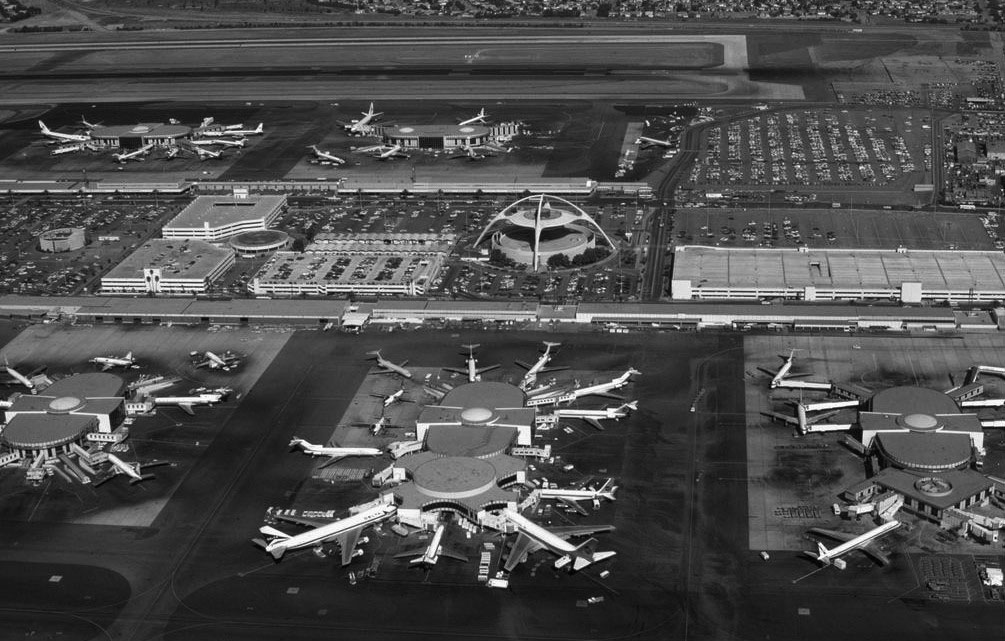 |
|
| (ca. 1971)^*# - Aerial view of LAX showing five terminals surrounding the Theme Building. The satellite terminals were connected via underground tunnels. |
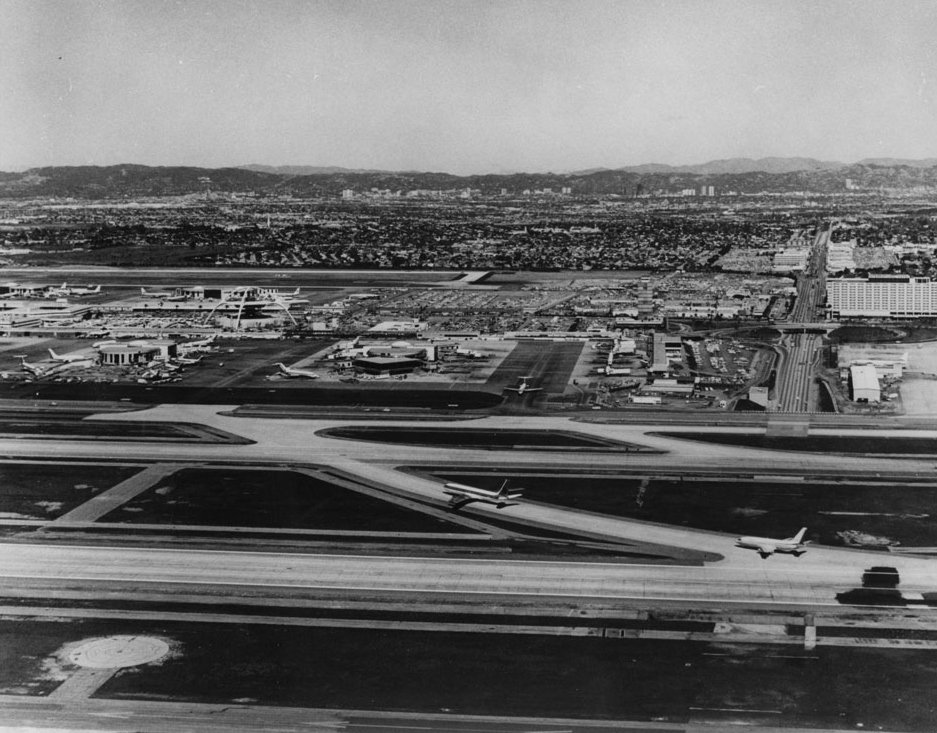 |
|
| (1971)^* - View of the runways and Theme Building at the Los Angeles International Airport, taken by James Caldwell, in February 1971. USC Digital Archives |
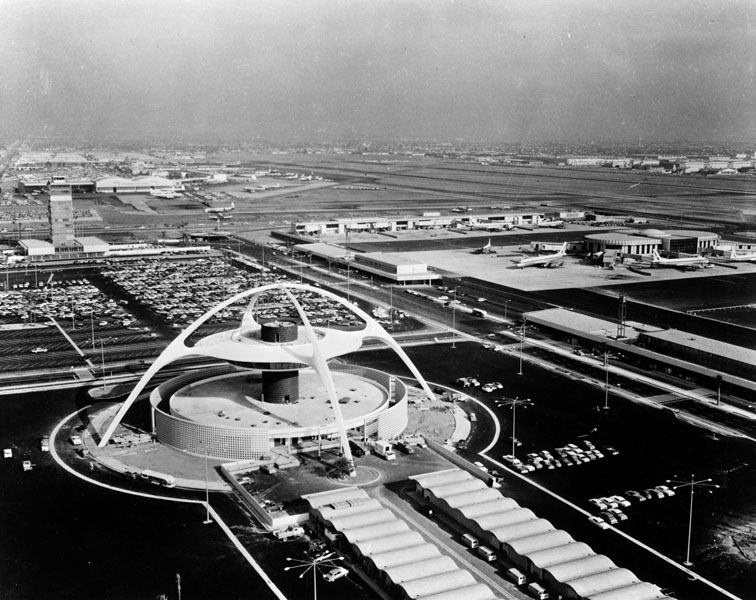 |
|
| (n.d.)* - Theme Building at the Los Angeles International Airport in the foreground with a sweeping view of the airport seen from the air. - LAPL |
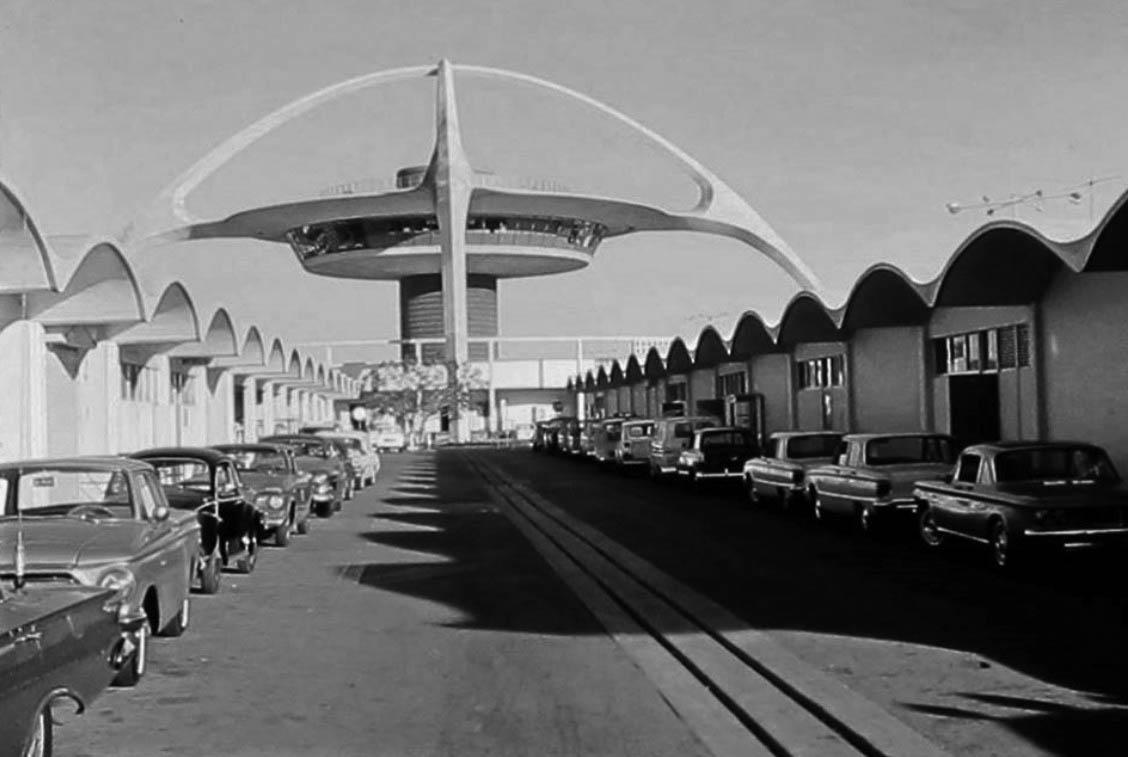 |
|
| (1960s)^ – View looking between maintenance buildings at LAX toward the Theme Building with cars parked on both sides of alleyway. Photo courtesy of Bizzare Los Angeles |
Historical Notes A $4 million renovation, with retro-futuristic interior and electric lighting designed by Walt Disney Imagineering, was completed before the "Encounter Restaurant" opened there in 1997. Visitors are able to take an elevator up to the Observation Level of the "Theme Building", located on the roof of the Encounter Restaurant. After the September 11 attacks, the Observation Level was closed for security reasons. Following a $12.3 million restoration of the building completed in 2010, the observation level re-opened to the public on weekends. On September 9th, 2003, a permanent memorial honoring those who perished in the attacks of September 11th was opened on the grounds of the Theme Building. |
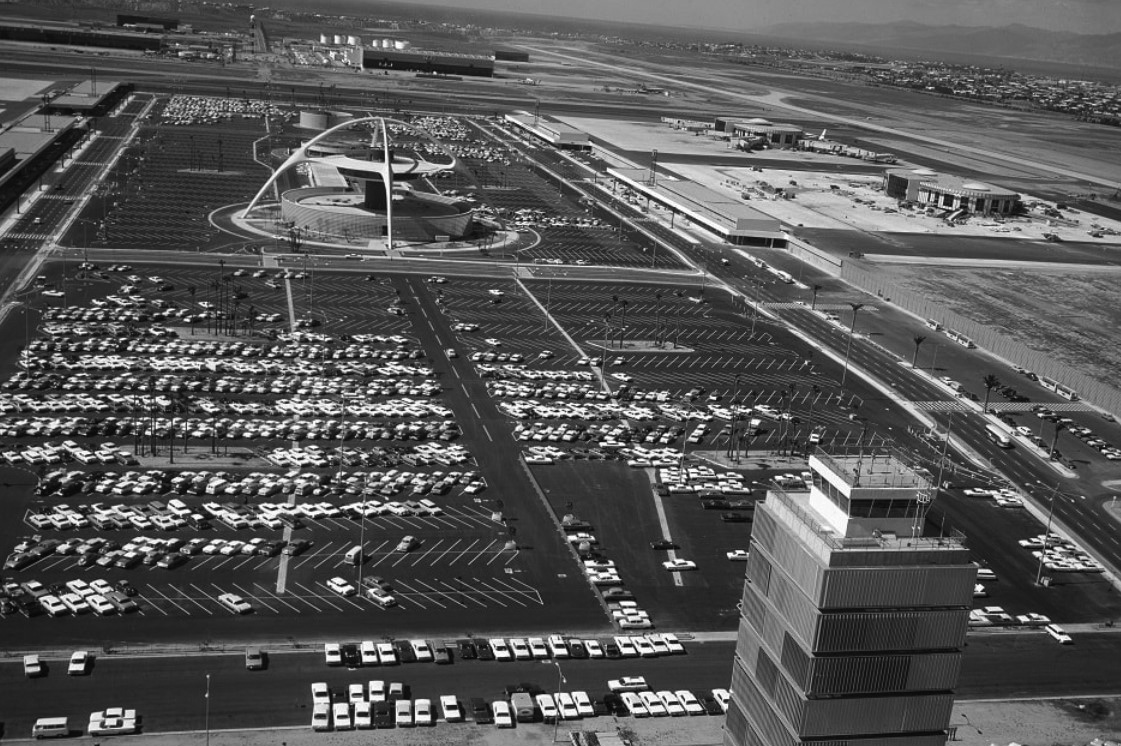 |
|
| (1960s)* - Aerial view showing the core area of the passenger terminal area looking west with the air traffic control tower in the foreground. The Theme Building is located in the middle of a 5,000-car parking area. To the right and left are the various ticketing facilities. The two large structures in the background are the American (L) and TWA (R) maintenance hangars. |
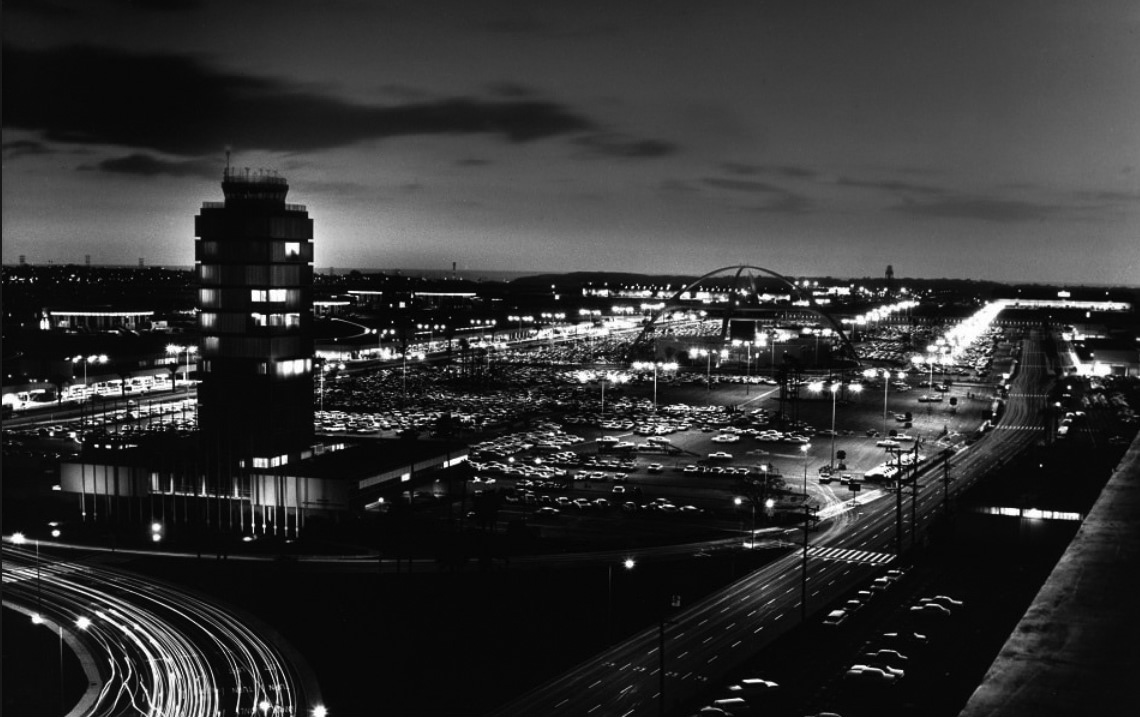 |
|
| (1960s)^ – Horizon view of LAX at dusk. Credit: LAX Photo Archives |
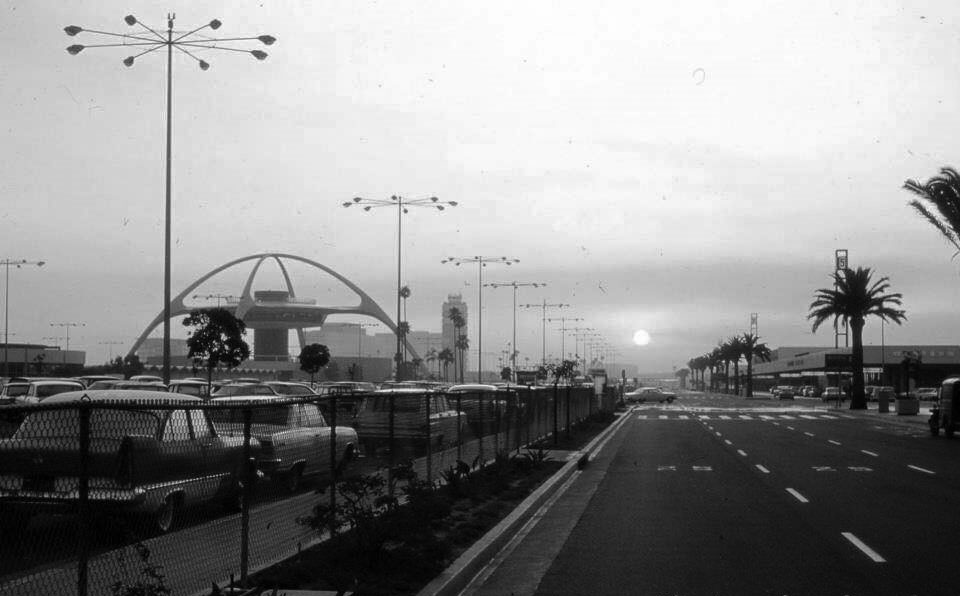 |
|
| (ca. 1964)* - An early morning sunrise at LAX Airport during the Atomic Age. Photo LA Times |
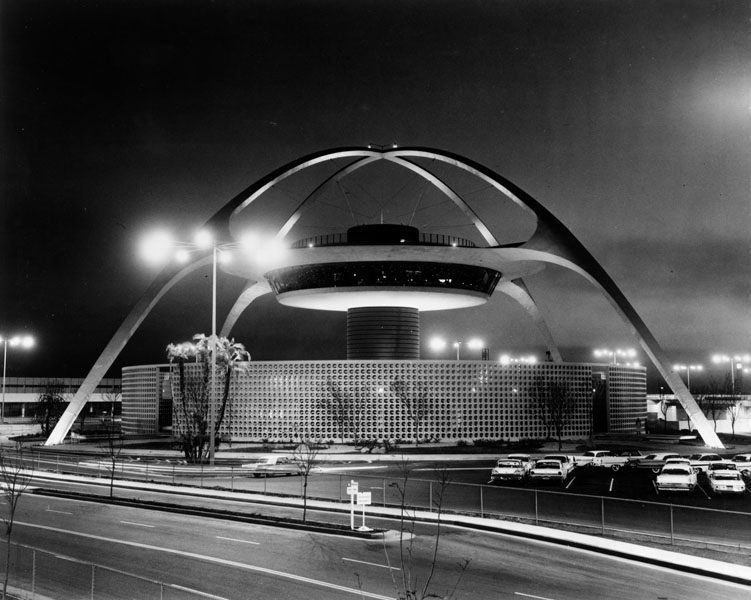 |
|
| (1960s)* - Theme Building at the Los Angeles International Airport illuminated at night. LAPL |
Historical Notes The Los Angeles City Council designated the Theme Building a cultural and historical monument (No. 570) in 1992. Click HERE to see the complete LA Historic Cultural Monument List. |
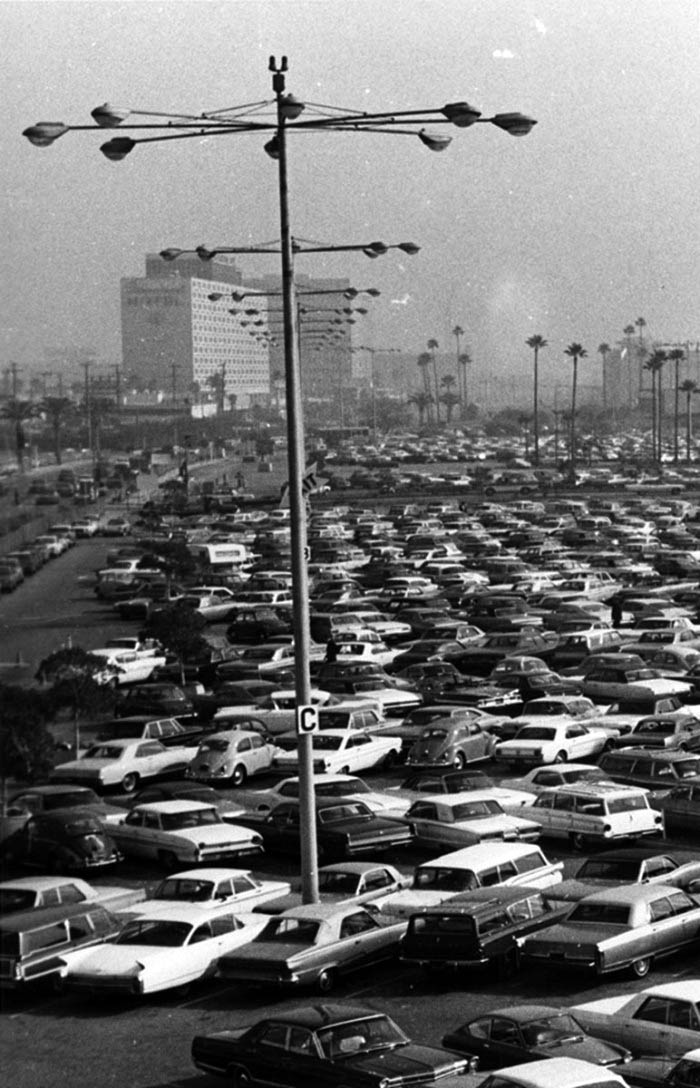 |
|
| (ca. 1974)* – A line of tall eight-headed lamps stand in the foreground, above row upon row of automobiles in a series of parking lots outside the airport. |
 |
|
| (1971)* – View showing a full parking lot at LAX with the Theme Building at right and the Control Tower in the distance. Mustangs and VW’s were popular. Photo by James Caldwell |
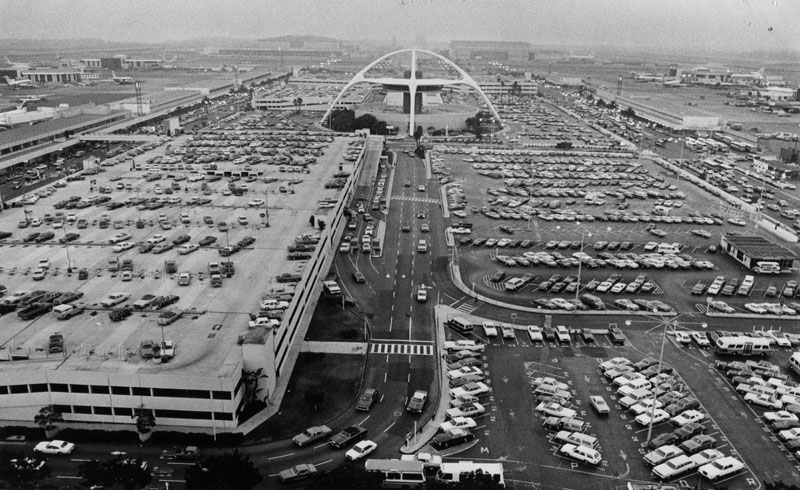 |
|
| (1978)* - Photograph caption dated August 27, 1978 reads, "Finding a place to park at Los Angeles International can be a traveler's major problem." Note the new multi-level parking structure at left. |
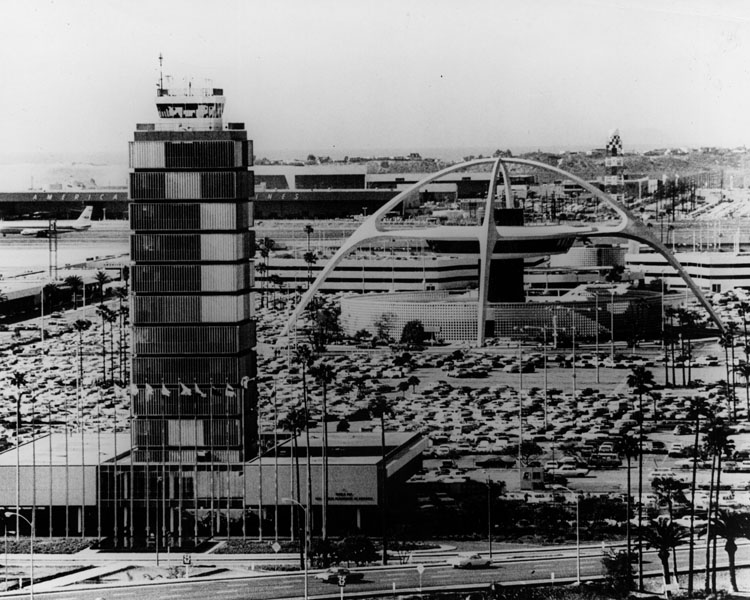 |
|
| (1973)* - Close-up view of Control Tower and Theme Building at Los Angeles International Airport. |
 |
|
| (n.d.)* - A 747 Jumbo Jet takes off from LAX. The Theme Building is seen in the background. |
Historical Notes The Boeing 747 is a large, long–range wide-body airliner and cargo aircraft manufactured by Boeing Commercial Airplanes in the United States. After introducing the 707 in October 1958, Pan Am wanted a jet 2½ times its size, to reduce its seat cost by 30% to democratize air travel. In 1965, Joe Sutter left the 737 development program to design the 747, the first twin aisle airliner. In April 1966, Pan Am ordered 25 747-100 aircraft and in late 1966, Pratt & Whitney agreed to develop its JT9D, a high-bypass turbofan. On September 30, 1968, the first 747 was rolled out of the custom-built Everett Plant, the largest building in the world by volume. The first flight took place on February 9, 1969 and the 747 was certified in December of that year. It entered service with Pan Am on January 22, 1970; it was the first airplane dubbed a "Jumbo Jet"."^ |
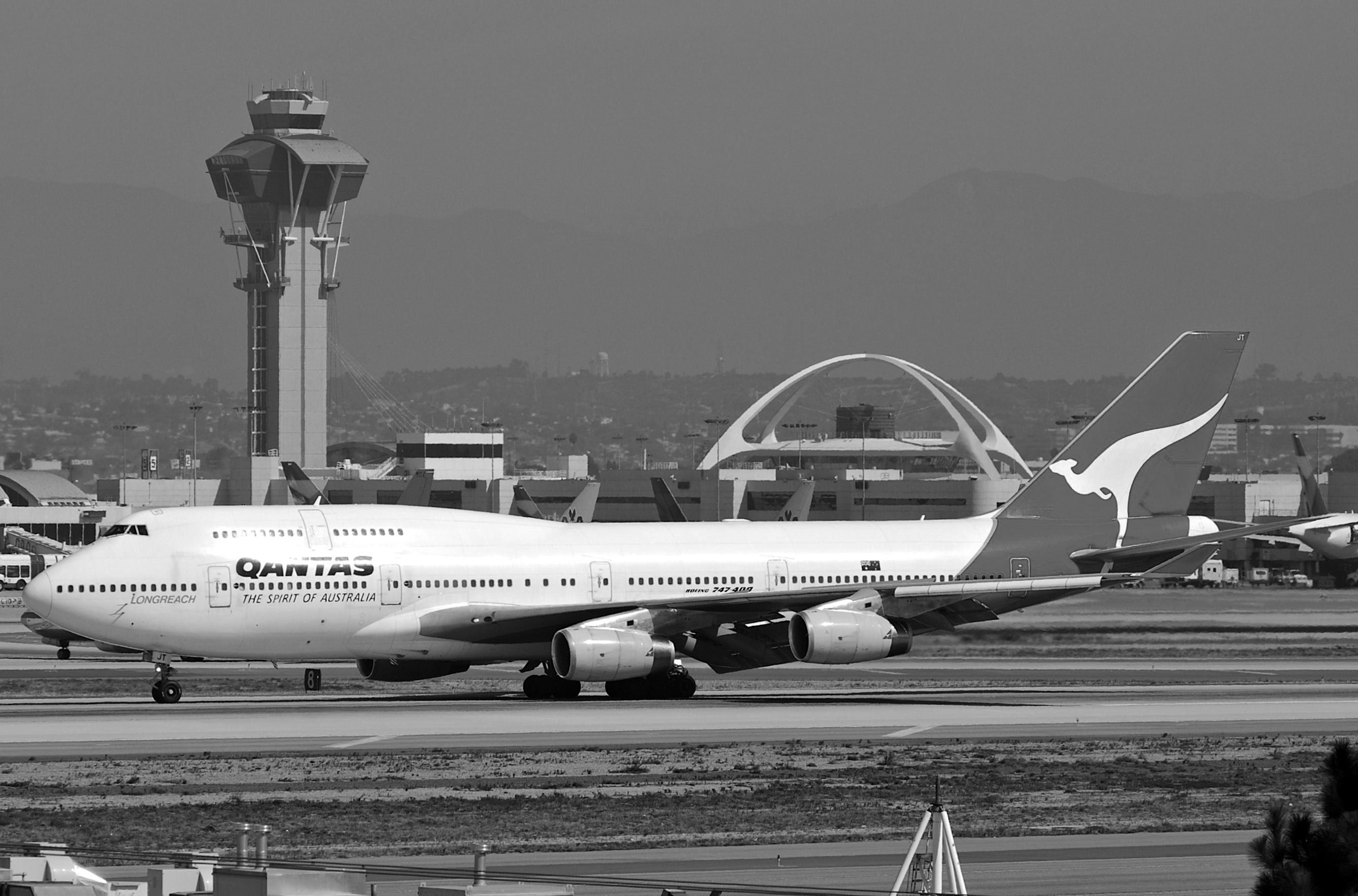 |
|
| (2020)^ – A Qantas Boeing 747-400 taxis on LAX runway after flying in from Sydney on its next to last flight. Final flight will be to the Mojave Desert for storage. Wikipedia |
Historical Notes Qantas has been an ardent supporter of the Boeing 747 and has purchased nearly every variant of the jet from the 747-100 to the 747-400. The Jumbo Jet was the aircraft of choice for its longest routes over the years and helped usher in a wave of nonstop connections between Australia and cities across the US including Los Angeles, Dallas, and San Francisco. Qantas 747s carried more than 250 million people in almost half a century of service. It was once the world's only airline with an all 747 fleet. The 747, which is still being produced, mainly as a freighter, was eventually outclassed for fuel economy by the newest generation of jetliners, such as the Airbus A350 and Boeing's own more recent models.* |
 |
|
| (1995)* – Construction of the 277-ft tall current control tower at LAX with the Theme Building in the foreground. |
Historical Notes The current control tower at Los Angeles International Airport (LAX) was built in 1995 and became operational in April 1996. Here are the key details about the construction of the LAX control tower: The previous control tower at LAX was built in 1961 and served the airport for 35 years until it was replaced. The new tower was designed to be 277 feet tall, over 100 feet taller than the previous one, with more than double the cab space at 625 square feet. The new tower, designed by architects Kate Diamond and Adrianna Levinescu, has architectural features resembling the letters L, A, and X. The 277-foot tall tower was dedicated on March 22, 1996 and went into full operation a week later in April 1996, replacing the 1961 tower. |
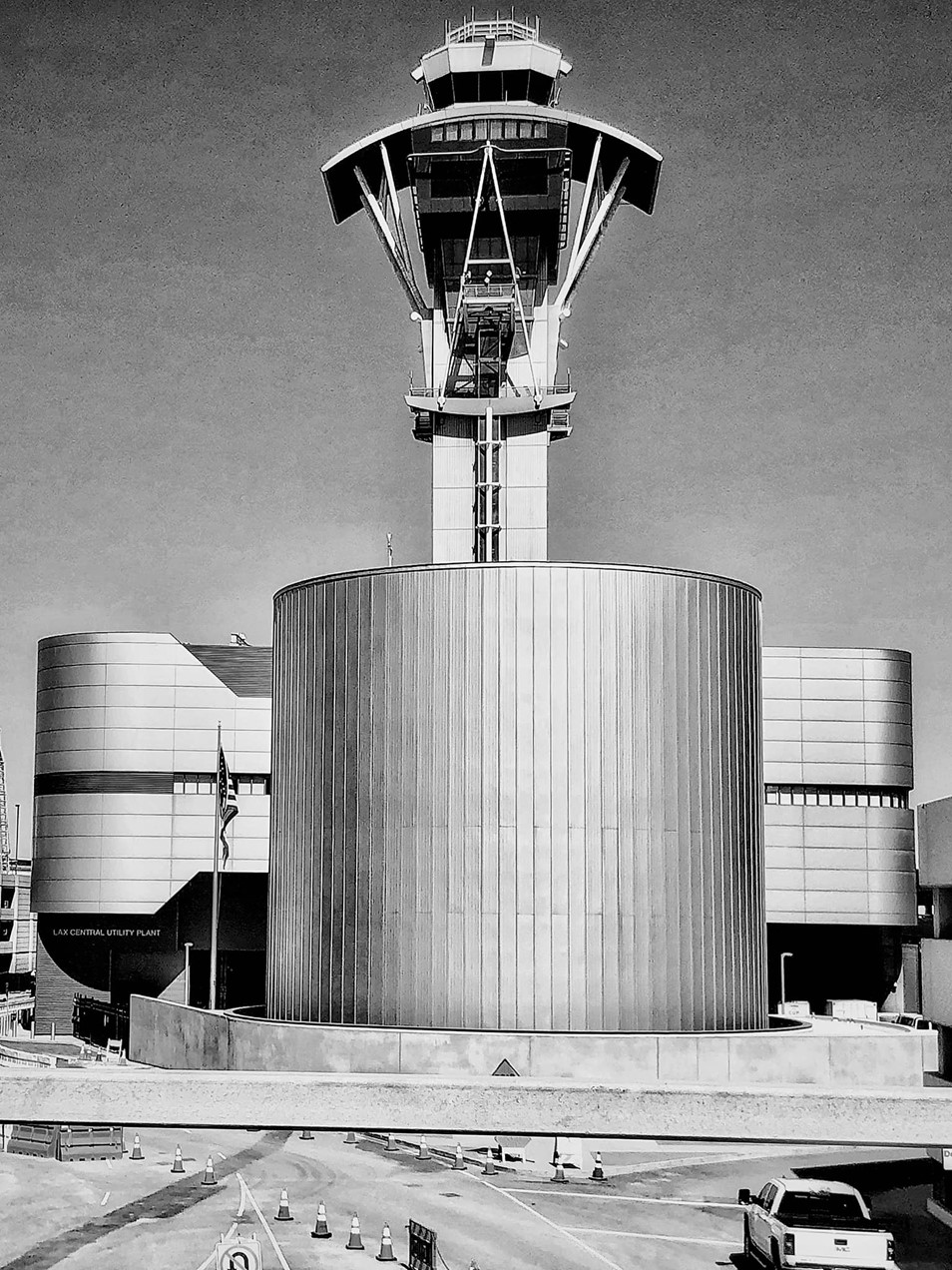 |
|
| (2023)* - LAX Control Tower Building. Photo by Carlos G. Lucero |
Historical Notes Completed in 1996, Los Angeles International Airport's air traffic control tower was designed by architect Kate Diamond of the architectural firm Siegel Diamond and Holmes Narver. It was meant to resemble a palm tree, with fronds dropping to its sides from the top. The 277-foot tower is 115 feet taller than its predecessor and cost $22 million to build. |
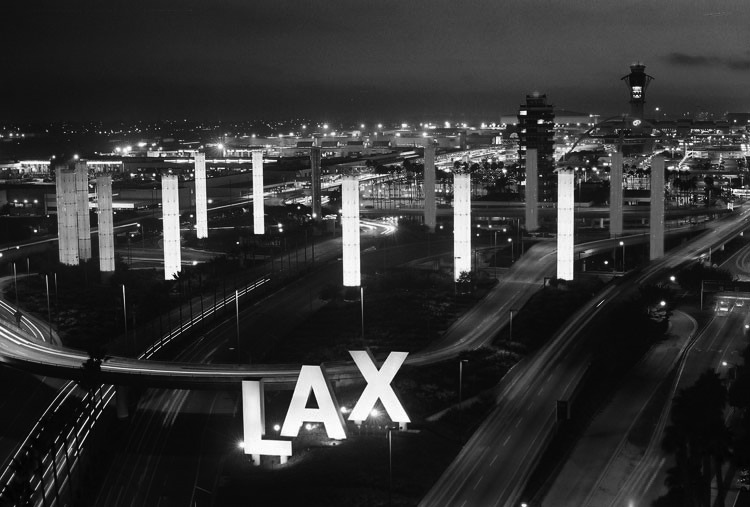 |
|
| (2018)^ - Los Angeles International Airport (LAX) is the fifth busiest airport in the world, accommodating more than 61 million travelers per year. The iconic pillars that form a gateway entrance to the airport are now known world wide and represent Los Angeles almost as much as the famed Hollywood sign. Photo courtesy of Foreman and Associates Lighting. |
Historical Notes The entrance to LAX is marked by the LAX Gateway pylons, which are 100-foot-tall columns that illuminate the area. These pylons are part of a larger installation that includes 11 translucent, tempered glass columns of varying heights along Century Boulevard, culminating in a ring of 15 100-foot-tall columns at the intersection of Century and Sepulveda boulevards. The pylons are designed to mimic an aircraft takeoff pattern and are visible to airline passengers from 3,000 feet. They are illuminated in a variety of colors, with 16 million color possibilities, and sequences designed and programmed by lighting artists and airport staff. The LAX Gateway pylons participate in environmental initiatives such as Earth Hour. During Earth Hour, the pylons are turned off to raise public awareness of climate change and the need for energy conservation. This event is part of a coordinated worldwide effort. |
* * * * * |
Please Support Our CauseWater and Power Associates, Inc. is a non-profit, public service organization dedicated to preserving historical records and photos. Your generosity allows us to continue to disseminate knowledge of the rich and diverse multicultural history of the greater Los Angeles area; to serve as a resource of historical information; and to assist in the preservation of the city's historic records.
|
More Historical Early Views
Newest Additions
Early LA Buildings and City Views
History of Water and Electricity in Los Angeles
* * * * * |
References and Credits
* LA Public Library Image Archive
^ Oviatt Library Digital Archives
**Los Angeles Times Photographic Archive: Municipal Airport; Spruce Goose; Alhambra Airport Dedication
^^Aerofiles - US Aviation Firsts
*#Abandoned & Little-Known Airfields – Paul Freeman
#*Huntington Digital Library Archive
**#UCLA Library Digital Collections
#**Theatlantic.com: Northrop XB-35
#*^This Day in Aviation: Lockheed Vega 1
#^*Vintage Photos of LA - Facebook.com: Theme Building
#^^Los Angeles Conservancy - DeMille Field No. 1
+##Airport Journals: Grand Central Aiport
+^#Aviation Pioneers: Blanche Scott
^*#Noirish Los Angeles - forum.skyscraperpage.com; Bob's Airmail Service Station; LAX Aerial; Rogers Airfield; Multiplane Crash; Alhambra Airport; Spruce Goose; Spruce Goose Hangar; 1932 Downtown Aerial, Corvette and Theme Building; Demille Field No. 2
**^KCET.org: From Mines Field to LAX: The Early History of L.A. International Airport; Welcome to L.A. River
***Pinterest: LAX Theme Building; Theme Building 2; Theme Building 3; Hughes XH-17 “Flying Crane”; Northrop YB-35; 1910 Dominguez Hills Dirigible; Theme Building Under Construction; Mines Field 1933 National Air Races
*^^California State Military Museum - Mines Field; Lockheed Air Terminal
^**Dmairfield.com: Mines Field
*#*San Diego Air & Space Museum Archive; Burdett Fuller Collection
^#*theautry.org - From the Ground Up: The Infrastructure of Flight in Southern California
^^^Airliners.net: The Wings of the Net: 1929 Fokker
^.^Facebook.com: Vintage Airlines
^^#LA Times: Arcadia Balloon School and Ross Field; LAX Fogged In
^^*Los Angeles World Airpots: LAX
*#^LA World Airports - History of Van Nuys Airport
^#^FriendsReunited.co.uk: Northrop YB-49 Bomber
*##Facebook.com: Garden of Allah Novels – Martin Turnbull
^## Facebook.com: Photos of Time Travelers; Bill Gabel's Photos of L.A./Zeppelin
##*Los Angeles Magazine: How a Hollywood Director Almost Launched L.A.’s First Commercial Airline
##^The Chronological, Pictorial History of Early Pusher and Pusher-Puller Aircraft by Terrence Murphy
#++LAist.com
#+#Facebook.com: Photos of Los Angeles
##+EdCoatesCollection.com: Sikorsky S-38
*^* Seaplanes of the Magic Isle
^*^ Nuestra Señora la Reina de los Ángeles: losangelespast.com
^v^ SMO's History - Santa Monica Airport Association
****Pasadena Museum of History
^*^^South Bay Daily Breeze: Seaplanes to Catalina; Mines Field; Sepulveda Tunnel
^^^^Pinterest/Santa Monica Past: Douglas Aircraft
^**^California State Library Image Archive
^***Earlyaviators.com: Roy Knabenshue
*^*#Santa Monica Municipal Airport
*^##Facebook.com: Classic Hollywood-Los Angeles-SFV
*^*^Pinterest: Appreciation of History - Reddit.com
^*^*San Fernando Valley Relics - Facebook.com: Burbank Airport; Angeles Mesa Drive Airport (Burbank Airport)
*#*#Los Angeles Then and Now: Douglas' Dream Took Wing in Santa Monica
^##^Pasadena PIO: Bob Hope Airport
^##*csudh.net: Dominguez Hills Air Meet
*#*^Airships.net: Graf Zeppelin
^^#^Facebook.com - Great Photos from Los Angeles' Past: Rogers Airfield
*#^#Flickr.com: Walking Over Santa Monica
^*^#Facebook.com - Bizarre Los Angeles
^#^#Pinterest: Bygone Los Angeles: Vintage L.A.: Spruce Goose
**##Alhambra Airport
##**Mines Field
#^^*Facebook.com: Van Nuys Airport
#^^^Calisphere Digital Archive
#^**Facebook.com: West San Fernando Valley Then And Now
#**^Pinterest: Hollwood Early Days
***# Flightpath.us
***^ Pomona Public Library Digital Archive: Bob's Airmail Service Station
*^ Wikipedia: Los Angeles International Airport; 1910 L.A. International Air Meet at Dominguez Hills; Bob Hope Airport; Grand Central Airport; Airship; Zeppelin; Theme Building; William Wrigley, Jr.; Spirit of St. Louis; Lockheed Hudson; Douglas DC-3; Amelia Earhart; Maddux Air Lines; Carthay Circle; Hughes Airport; Hughes H-4 Hercules; Howard Hughes; Hughes Helicopters; Playa Vista; Northrop YB-35; Jack Northrop; Norhtrop YB-49; History of Santa Monica; Boeing 247; Hughes H-1 Racer; Charles Lindbergh; L-1011 Tristar; Leslie Brand; Van Nuys Airport; Douglas DC-7; Douglas Aircraft Company; DC-9; Hughes Airport; Continental Airlines; Glenn Curtiss; Thomas Scott Baldwin; ‘Tiny’ Broadwick; Western Airlines; Lockheed SR-71 Blackbird
< Back
Menu
- Home
- Mission
- Museum
- Major Efforts
- Recent Newsletters
- Historical Op Ed Pieces
- Board Officers and Directors
- Mulholland/McCarthy Service Awards
- Positions on Owens Valley and the City of Los Angeles Issues
- Legislative Positions on
Water Issues
- Legislative Positions on
Energy Issues
- Membership
- Contact Us
- Search Index